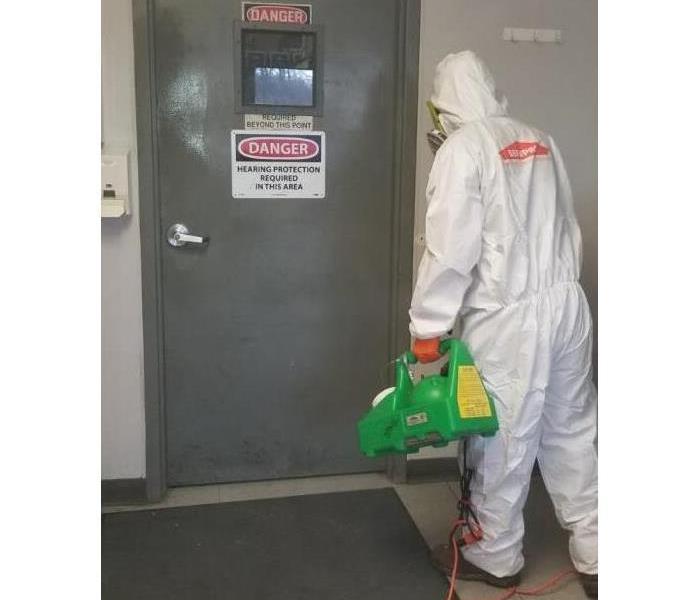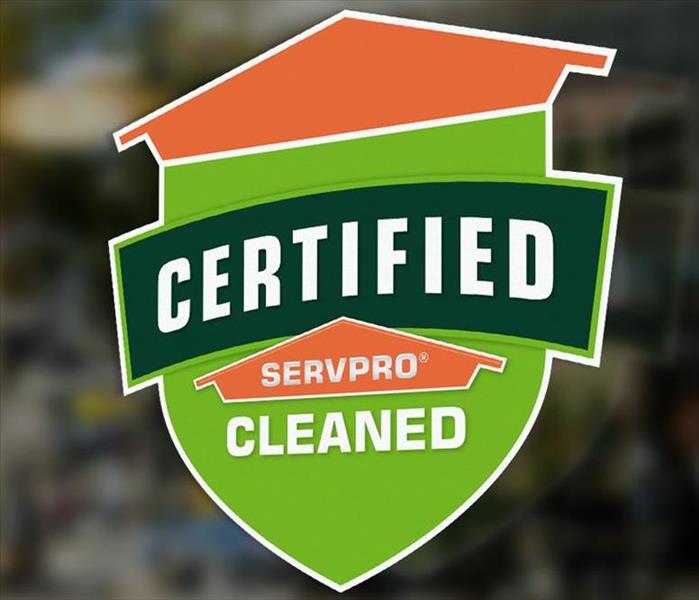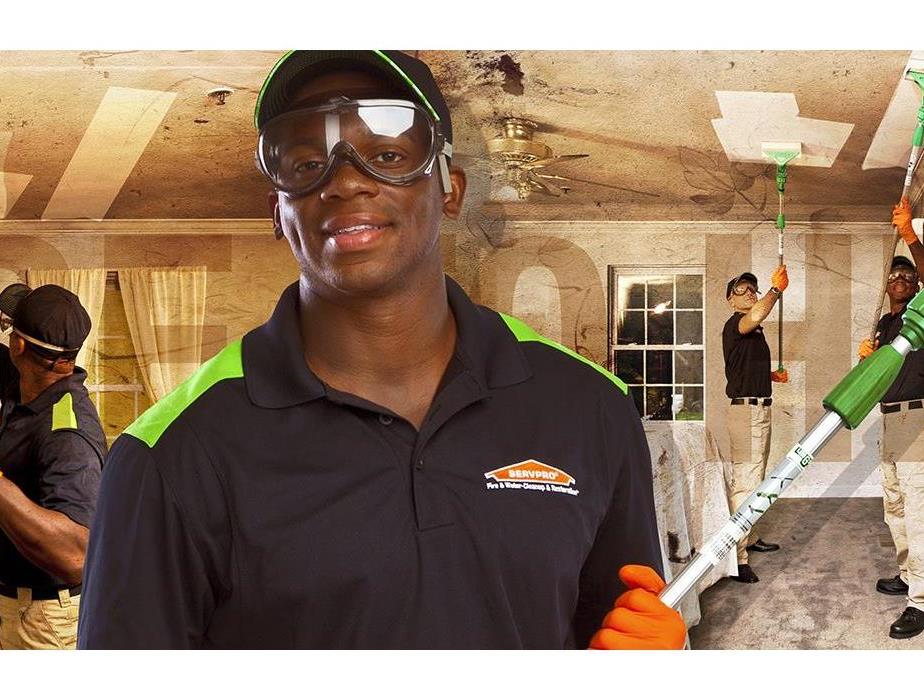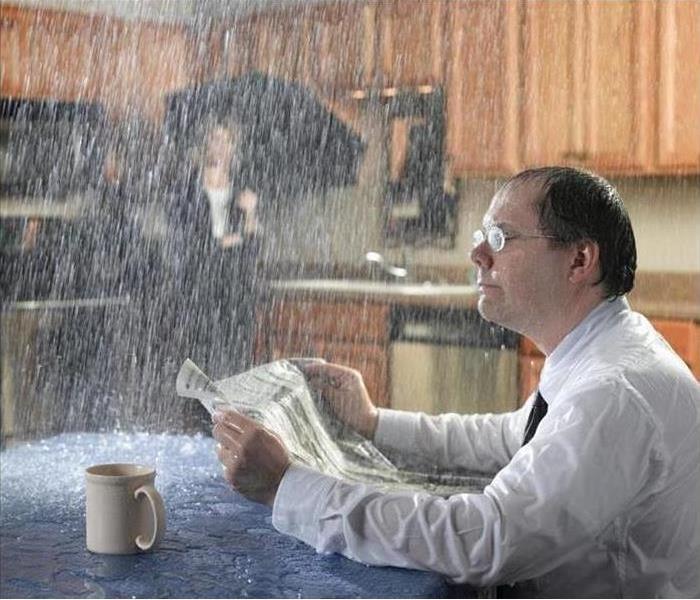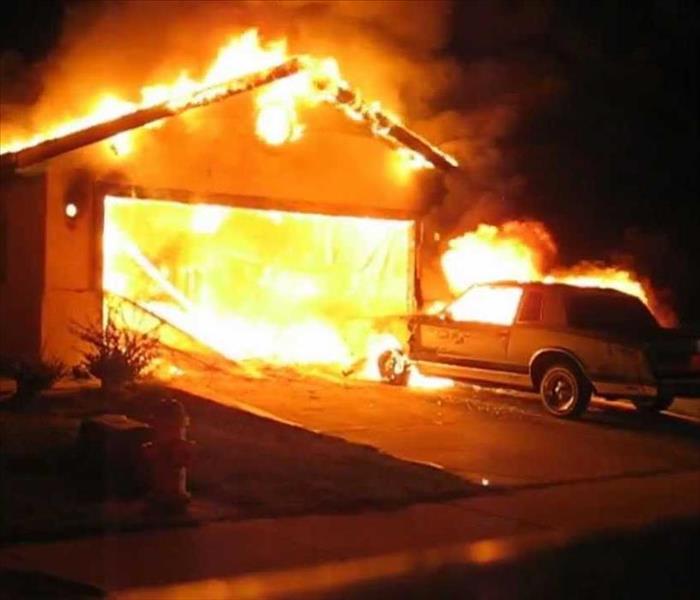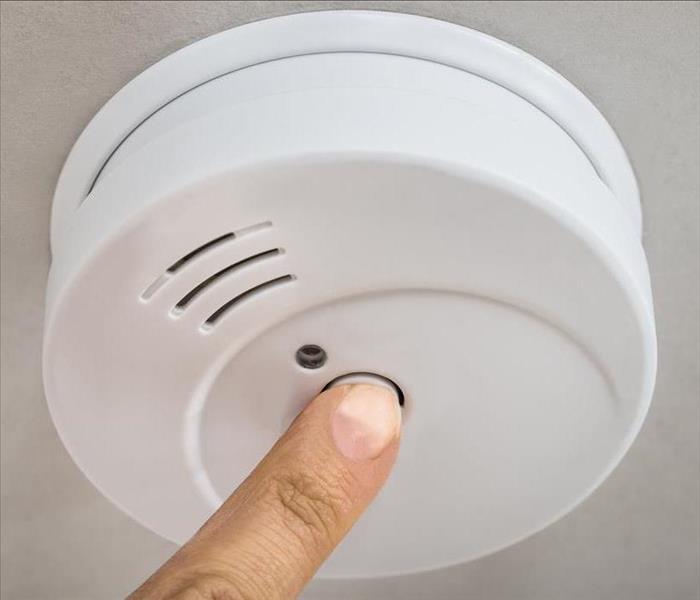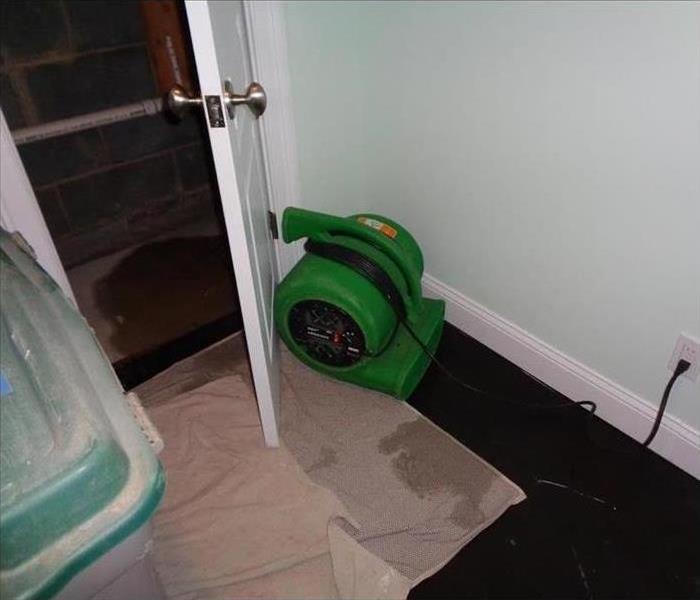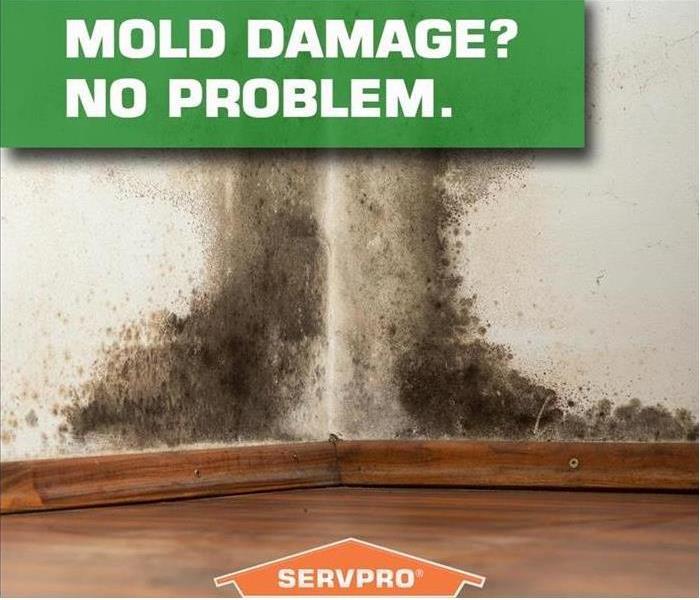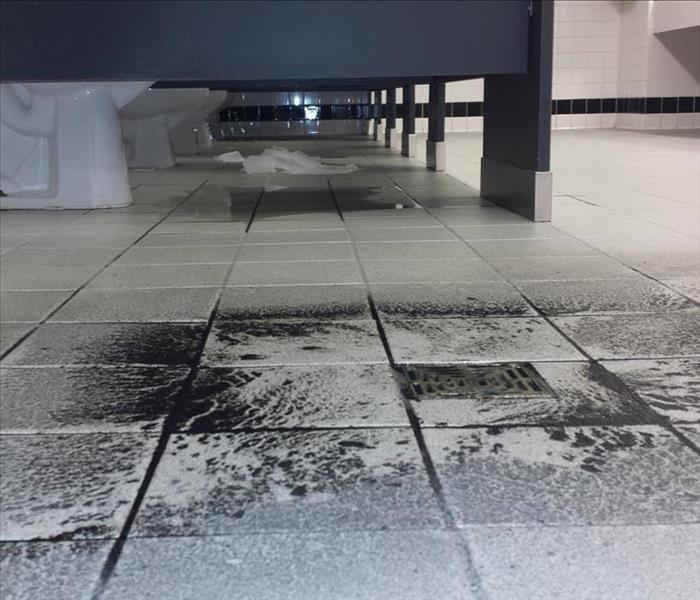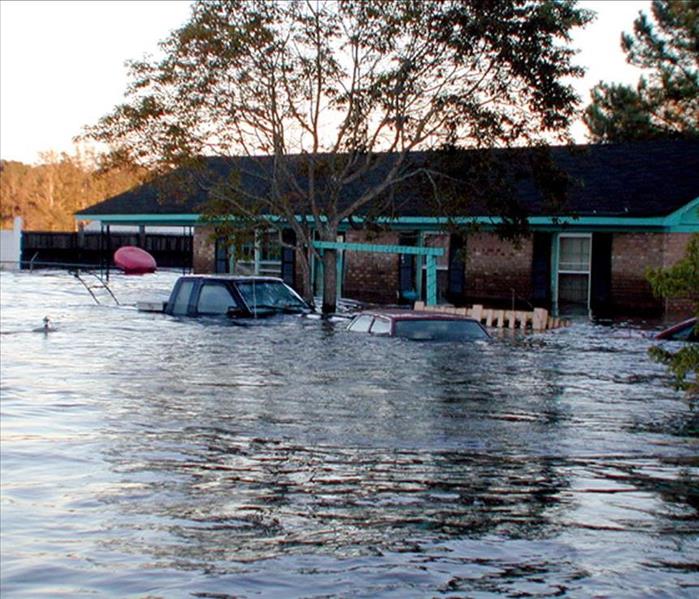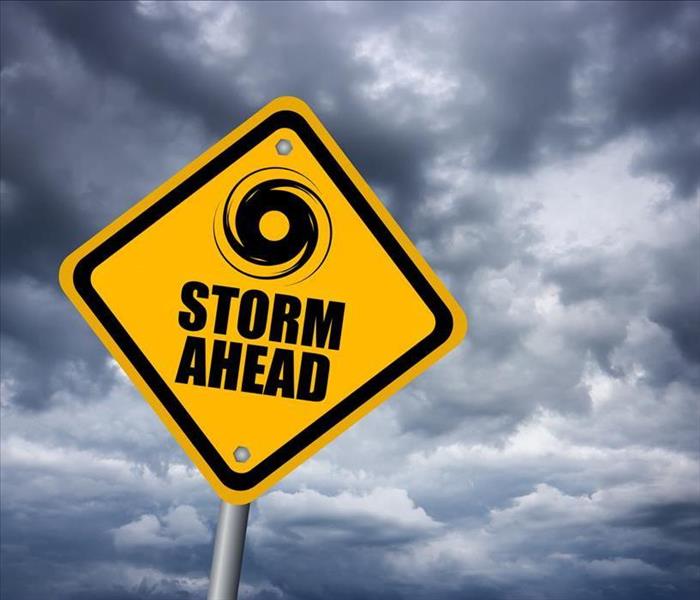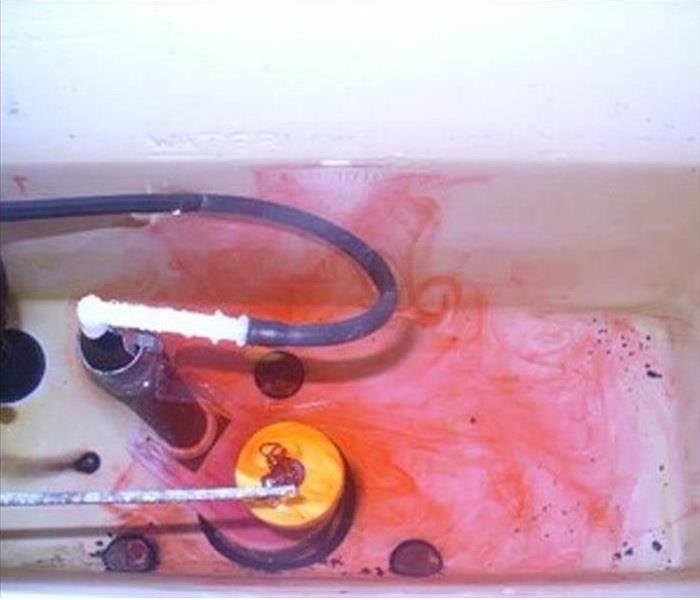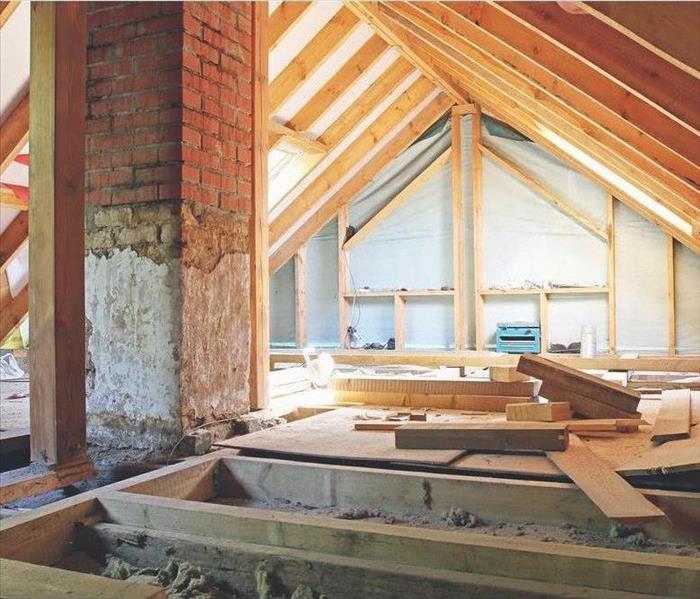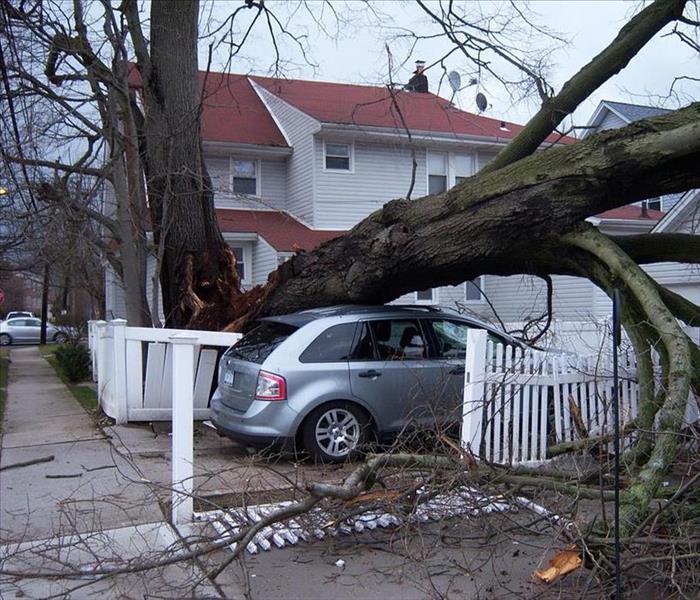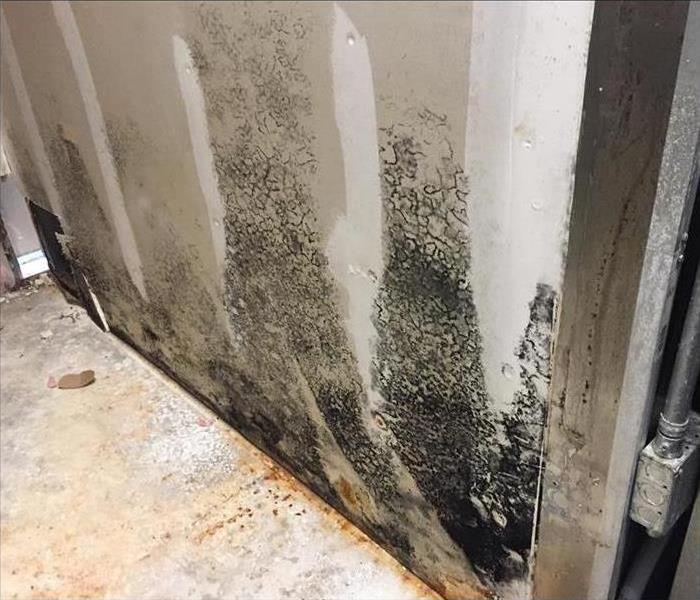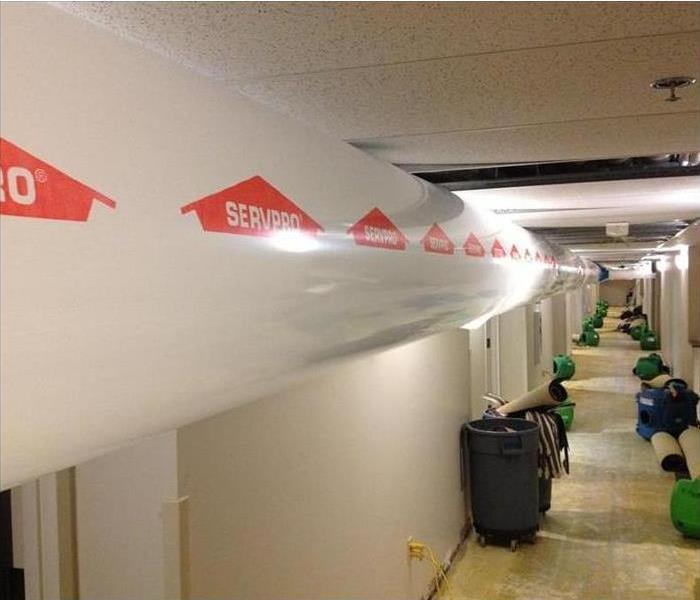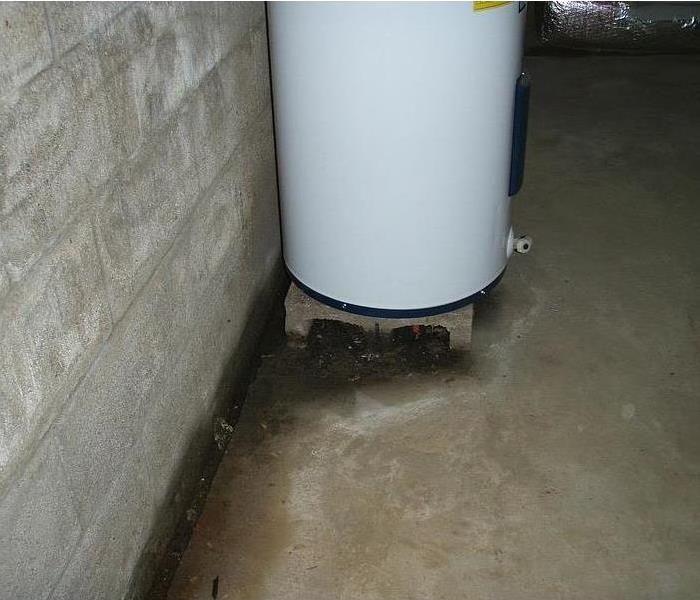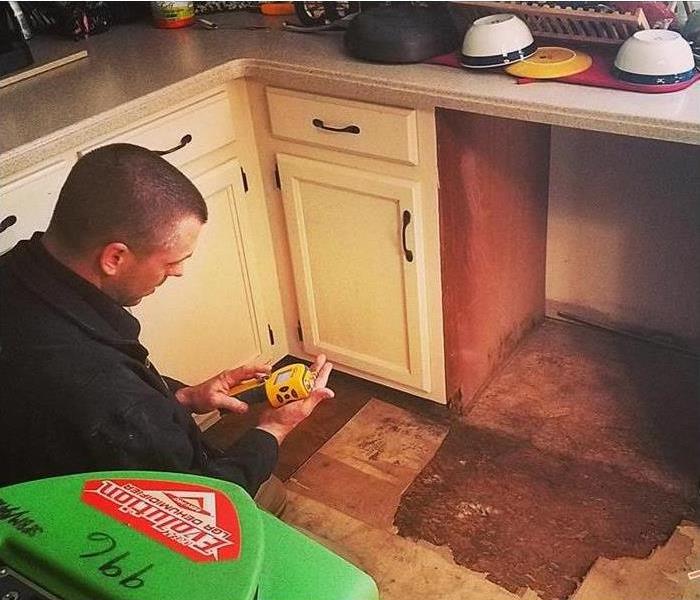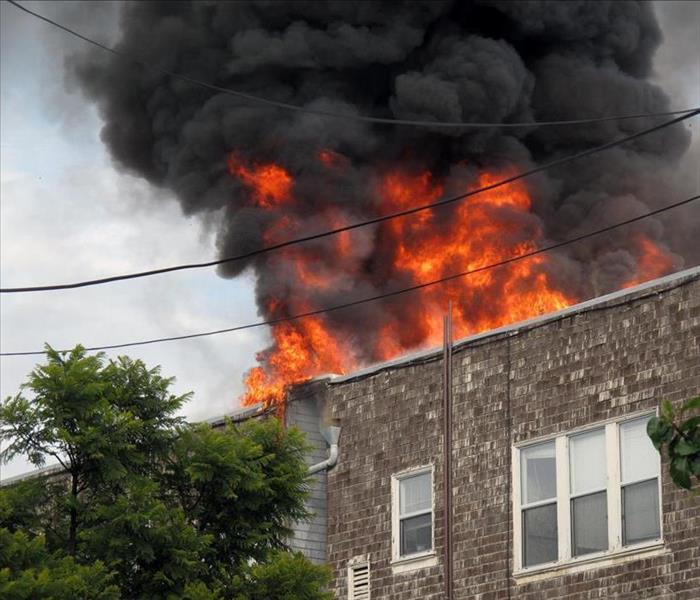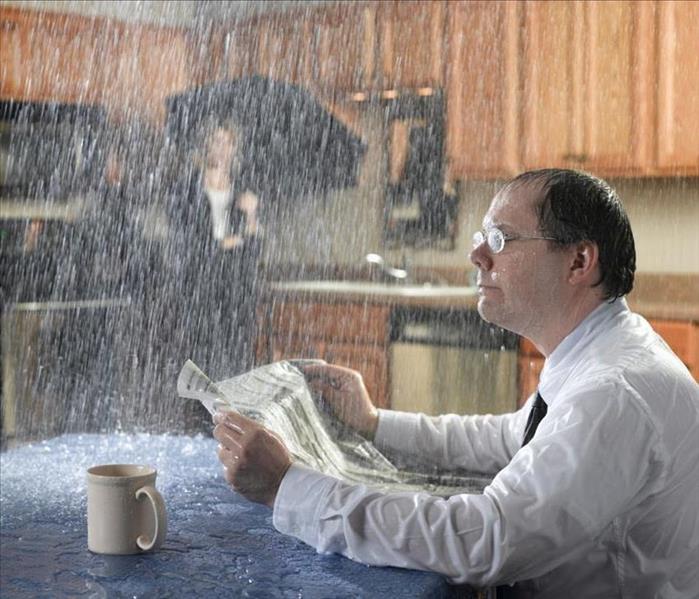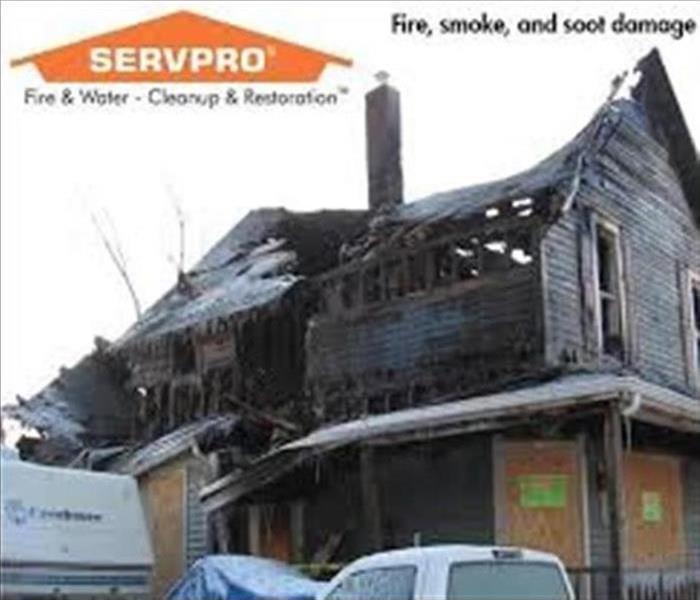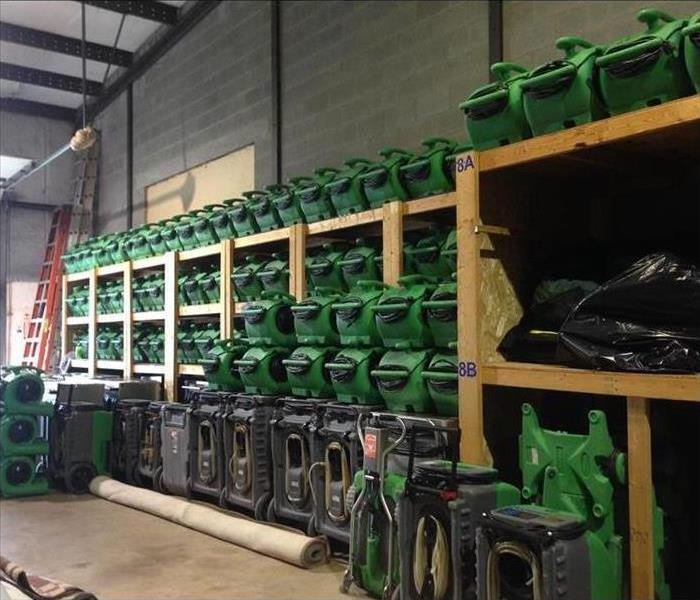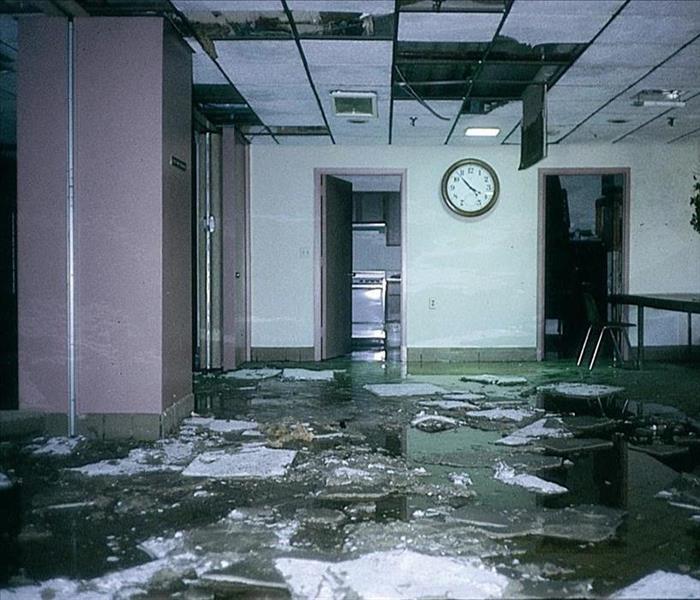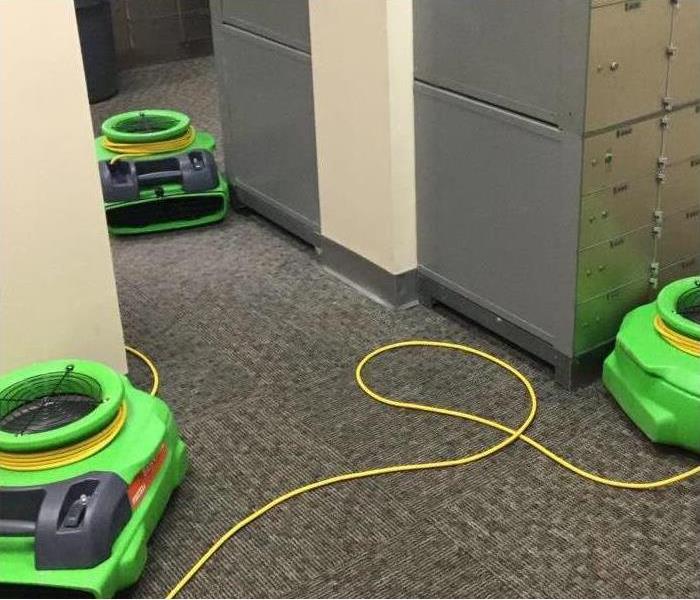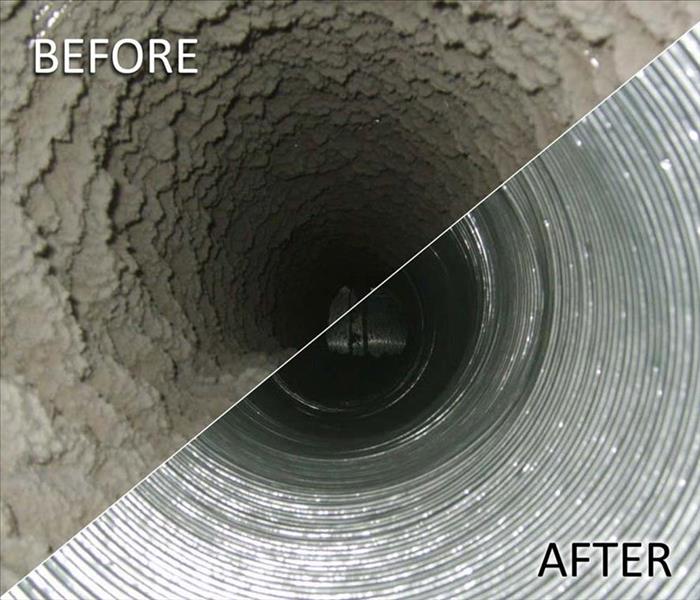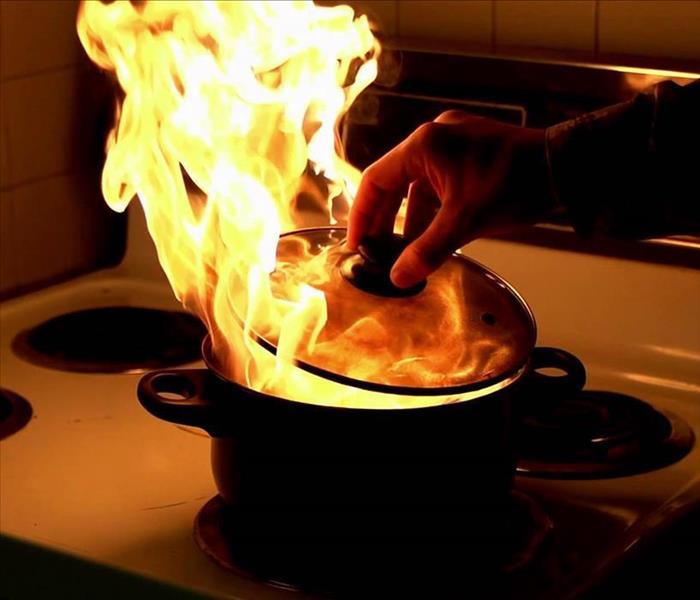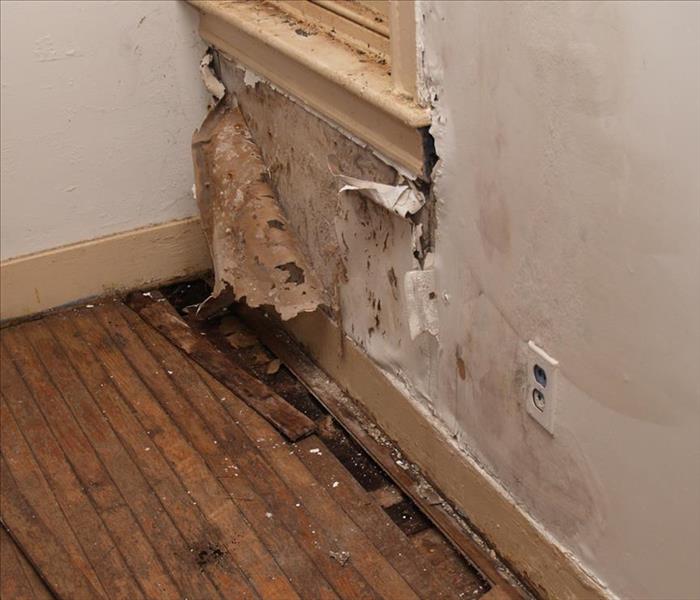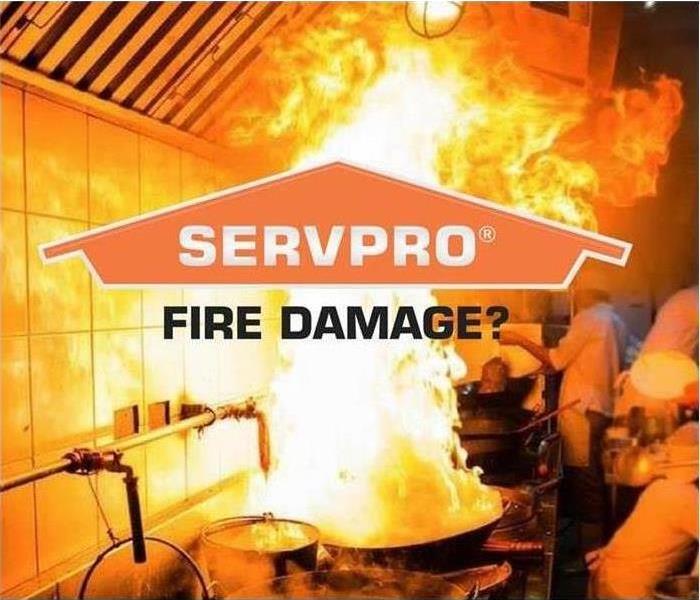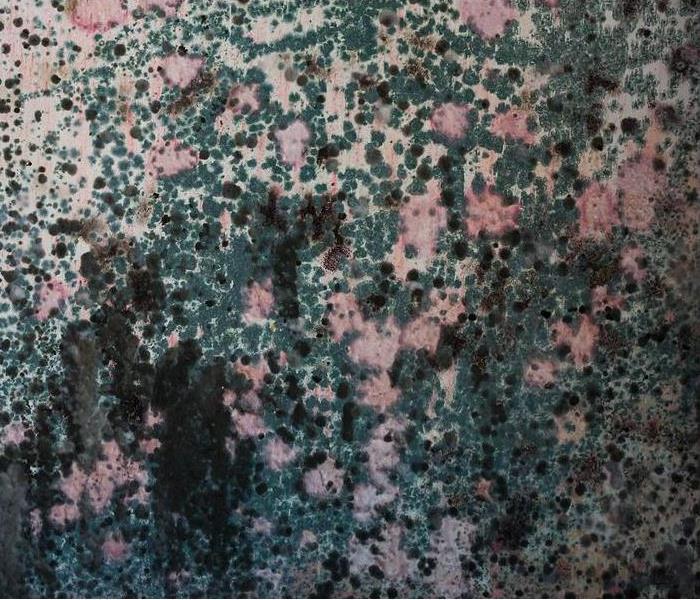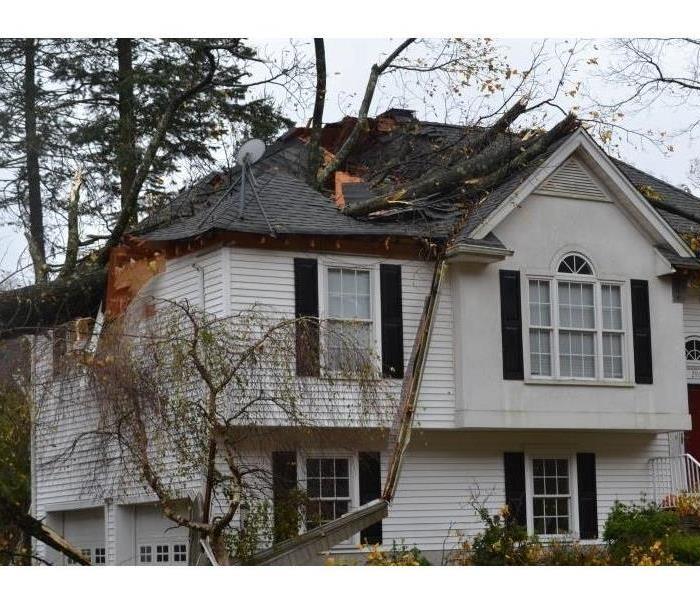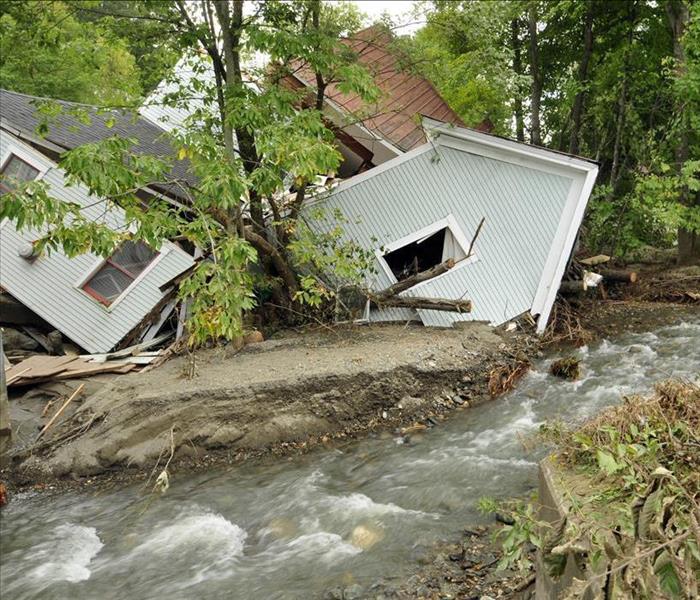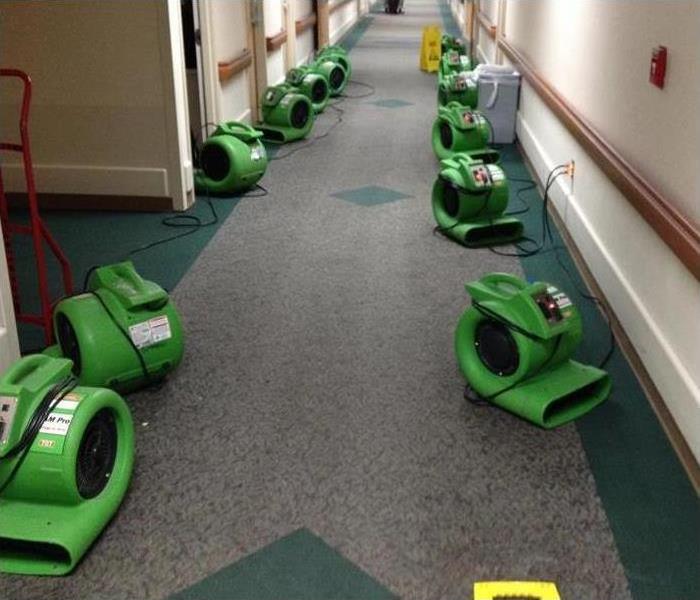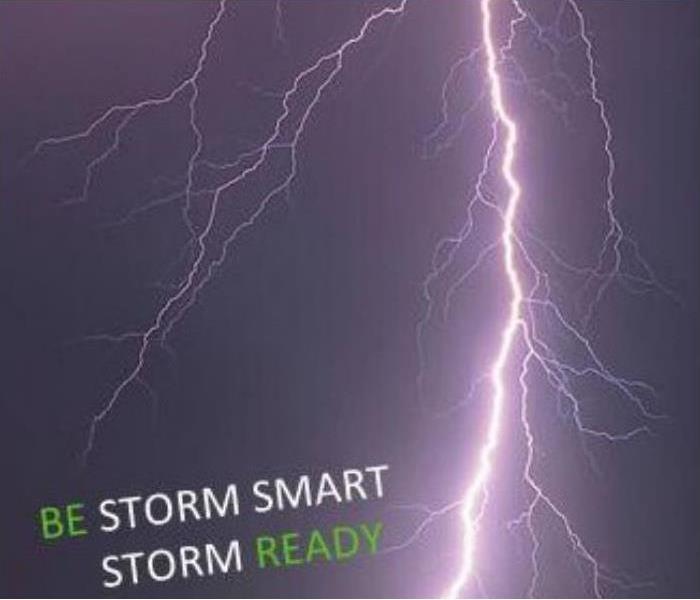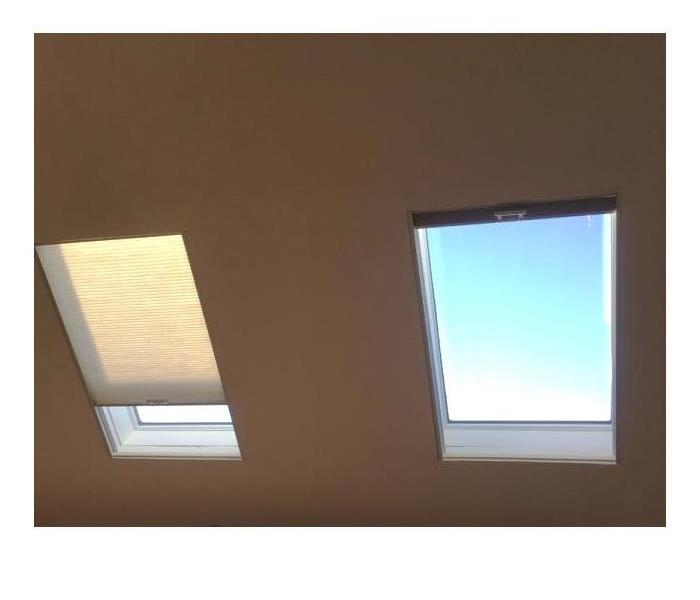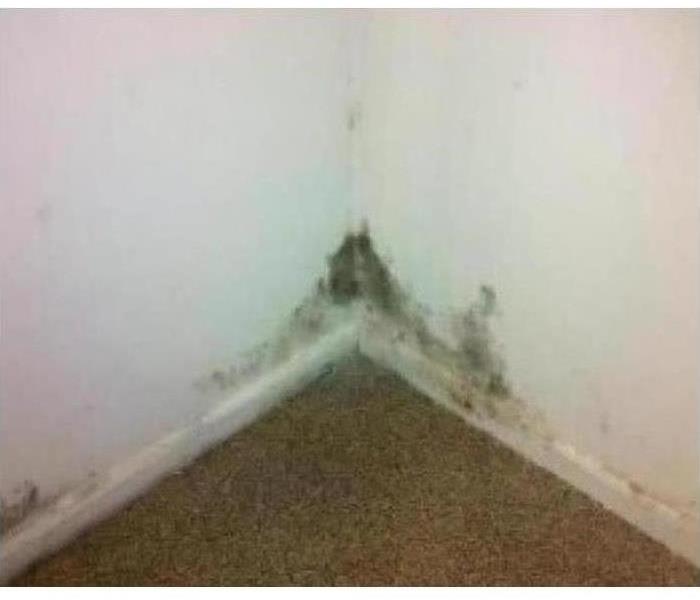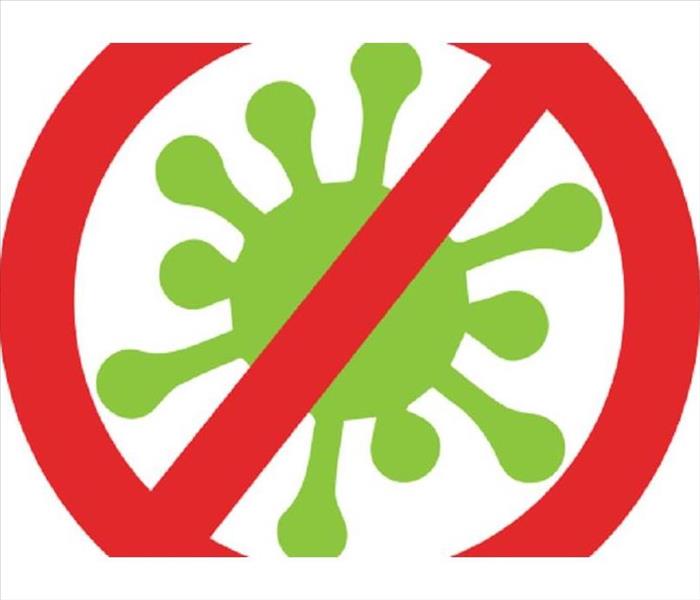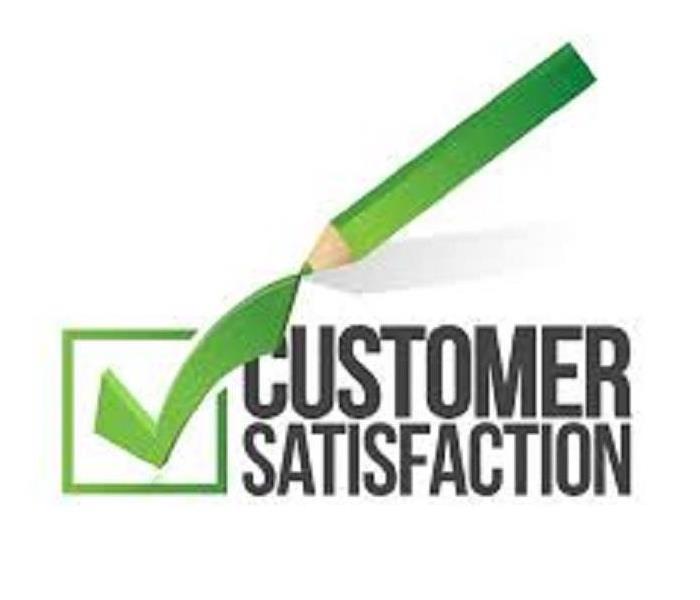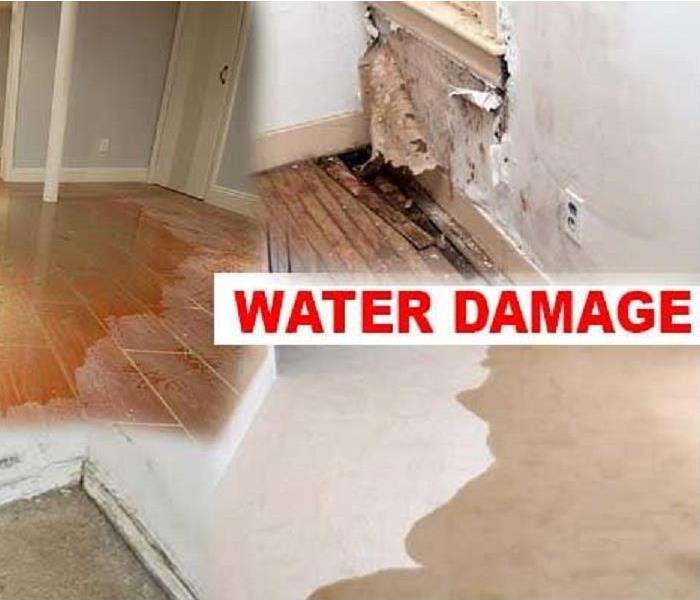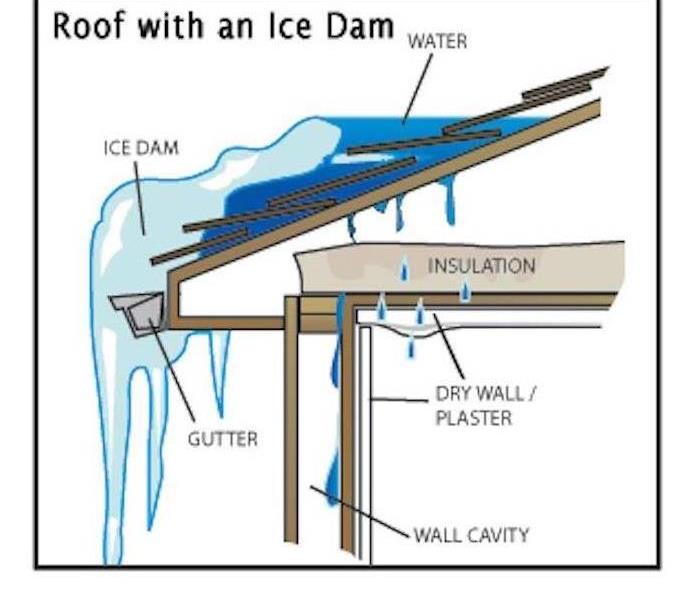Archived Blog Posts
What To Do And What Not To Do When Dealing With Fire Damage
8/2/2023 (Permalink)
Sometimes unforeseen circumstances can completely change our lives. A fire in your home or place of business is one of them. It can cause extensive damage that can take a while to recover from.
However, you need to start the fire restoration process as soon as possible so you can resume life. When it comes to fire damage and restoration here are some of the things you should do and some you should avoid.
What To Do When Dealing With Fire Damage
It is important to always have a plan when it comes to such damage. Your plan will allow you to take the necessary steps to deal with fire damage and restore everything as fast as possible. Here is everything you need to do:
- Never enter the property until a professional has told you it’s safe
- Take pictures so you can have evidence of the damage
- Call your insurance agent
- Call your local restoration company such as SERVPRO
- Limit your movement inside the area of fire
- If the weather is fine then open all the windows for proper ventilation
- Throw away drinks and foods that have been left after the fire
All of this will protect you from further damage and help you restore your property as soon as possible. The best thing you can do is call a professional for restoration so they can take care of everything.
What Not To Do When Dealing With Fire Damage
It is important to know what not to do as well so that you don’t end up causing further damage. Here is a list of things you shouldn’t do when dealing with fire damage on your property:
- Don’t start cleaning everything unless your insurer has assessed everything first
- Don’t use carpets or other furniture until they have been professionally cleaned after a fire
- Don’t eat or drink anything that has been exposed to the fire
- Don’t turn on water, gas, or electricity till everything has been professionally assessed
- Don’t turn on any electronics until it has been professionally assessed
You need to give time to the professionals to handle all these aspects. This is because the residue that stays after a fire can cause a variety of health problems if you start doing everything too soon.
So, till the professional sort everything out and restore the damage this is what you should and shouldn’t do. Just make sure that you are not using the property at all until it has been assessed by an insurer and a fire restoration professional.
Final Words
If you want to minimize the risk of fire on your property then you should always take preventative measures. However, if you still end up having a fire on your property then this was your complete guide to what you should and shouldn't do.
Follow these steps and you will be good to go. If you want a professional fire damage restoration company then no one does it better than SERVPRO. Feel free to get in touch with us now.
Tips to Making It through the Storm
9/21/2022 (Permalink)
Tips to Making It through the Storm
It is not surprising that the storms all around the world are getting stronger and deadlier. A lot of it has to do with climate change. No matter the level and strength of the storm it is bound to leave some level of destruction in its way. So it is very important to know how you can stay strong during the storm and prevent any damage to your house. Let’s take a look at a few tips.
Stay Calm
The first thing you should do is to try and stay as calm as possible. This will not only help you clear your mind, but also see things more clearly and focus on the task at hand. It will prevent any rash decisions and allows you to be much more effective.
Trim off branches
Branches can easily damage big parts of your roof. It’s much better to have them off as soon as possible. You can use a chain saw or electric chainsaw for this job. In case you don’t have one at hand, a strong bladed knife will do the trick too. Just make sure to take your time and be careful not to hurt yourself in the process.
Protect entrances
You should do your best to protect the entrances of your house. This is so that you don’t get any damage from flying objects or debris. You can use sand bags for this or if you have enough, simply move some heavy items in front of the doors and windows.
Stay away from windows
Staying away from windows is a very important thing to do. This way you’re not exposing yourself to possible debris, broken glass and other objects that could cause you severe injuries.
Cover up windows
This is especially important if you live in areas where the house is exposed to strong winds. You should make sure that all windows are covered as good as possible with cloth or thick plastic sheets. This way the house is a lot more resistant to breaking in wind and flying debris.
Protect yourself
You should further protect yourself by wearing gloves, goggles and a long sleeve shirt. By doing this you at least don’t expose your skin to possible damage from broken glass or other sharp objects. You can also use some kind of mask so that you don’t breath in the dust and particles in the air.
Be Aware Of the Weather Updates
You should always try to stay up to date with the weather updates. This way you will know what kind of disaster is going on and how long it is expected that it will still last. That way you can better prepare yourself and have a plan in place on what you should do when things get worse during the storm.
Move the Furniture Away From the Windows and Doors
You should do whatever you can to protect larger and heavier items in the house. Especially when it comes to things near the doors and windows. Things like sofas, chairs, tables or any other heavy object can easily get damaged if they are near the windows so try to move them away from the windows and doors.
Take Before and After Pictures
It’s always very important to take pictures or make some kind of inside map of your house before the storm hits. That way you can better assess what damage might have happened after everything calms down again. If there are any damages insurance companies will need this information in order to reimburse you.
Know the Instructions Given By the Relevant Authorities
It is always important to know what the authorities are saying in its instructions. Never ignore them, even if you don’t think they are serious. This way you can make sure that you don’t do anything wrong or dangerous and be able to assess the situation better.
Storm Damage Repair - The First 5 Things to Do
9/21/2022 (Permalink)
Storm Damage Repair - The First 5 Things to Do
Damage from a hurricane, tornado, or thunderstorm can happen any time of year. When these storms occur, it is important to know what steps you should take immediately after the storm has passed. The first 5 things to do after a storm may include some activities that you have been putting off until better weather conditions arrive, but this article will help guide you through the necessary preparation and activity in order to get your life back together following a storm.
Although surviving the period immediately following a bad storm may seem like an insurmountable task, there are many things that you can do right away that will make life much easier for you when the power does come back on and the sun begins shining again.
Turn Off Electric and Gas Lines
The first thing to do after a storm is to inspect your home for damage. A good place to start is by checking for overhead or underground power lines that may be close enough to your home that they could have fallen on it during the storm. The next step would be to inspect natural gas and water pipes leading into your house, making sure that nothing from the outside has been able to break them free from their attachments inside.
In addition, before you go onto inspecting your roof, make sure that all electrical appliances in the house are turned off in order to protect yourself from being electrocuted while searching for damages or needed repairs. Once these initial checks have been made and repaired if necessary, the process of going through a "storm checklist" can begin.
Contact Your Insurance Company
You should contact your insurance company as soon after the storm as possible in order to prevent any unnecessary activity from being carried out by yourself or an outside party. Keep calling back until you have been able to speak with a representative who has all of the necessary information about you and your policy. Your agent can provide you with advice on what steps need to be taken immediately following the event, some of which are outlined below.
Move the wet items to the garage to dry out
If you haven't already done so, begin removing all furniture and other items from both the inside and outside of your home. This will help to prevent mold growth between your walls if water damage has occurred.
Wipe the Water Out Of Your House
The next step is to remove as much water from the inside of the house as possible so that any lingering moisture cannot lead to mold growth. This may be a difficult task if you have not already removed your furniture and appliances, but with a wet/dry vacuum or shop vacuum it should be manageable.
After removing all standing water around your home, you should thoroughly clean out your gutters in order to prevent future damage from occurring. Once this is done, inspect for broken gutter sections that will need replacing. Make sure that downspouts are clear as well so that rainwater runs off properly away from the foundation of your house.
Call a Professional Storm Damage Restoration Company
After the storm has passed you need to hire a professional restoration company. Your insurance company should be able to recommend a specific storm restoration company that can help with any damages incurred as a result of the storm. If you have not already done so, now is the time to call them and schedule an appointment to begin work on fixing problems such as flooded basements and removal of insulation and soggy drywall from inside your home.
When Should You Contact a Water Damage Restoration Company?
9/21/2022 (Permalink)
When Should You Contact a Water Damage Restoration Company?
If you’ve experienced water damage in your home, it can be hard to know where to start. Should you try to clean up the mess yourself? Call a plumber? Contact an insurance company? Get estimates from several restoration companies? The answer is that first and foremost, if there is standing water or significant amounts of water coming out of your pipes, contact a professional 24-hour emergency service ASAP. Once the immediate danger has been taken care of, call one or two reputable restoration companies for estimates on how much it will cost to get your home back into shape.
When should you call a water damage restoration company? You might be asking yourself that question because your basement flooded and the carpet is soaked or your washing machine overflowed and leaked into the kitchen. Not sure if you need to call a water damage restoration company? We're here to help! In this blog post, we'll discuss when it's time to contact a professional for assistance with water damages in your home so that you can reduce any long-term effects of these types of disasters.
When the Damage Is Too Much For You to Handle On Your Own
Sometimes the damage can be too much to handle for you on your own and you know you need a professional to get rid of your water problem. If the damage is too much for you to handle on your own, call a water damage restoration company immediately.
When You Have Standing Water or Pipes That Are Leaking
If there's standing water in your home or if there are pipes that have been compromised and are leaking, it's important that you contact a 24-hour emergency service as soon as possible so they can get out to your location ASAP. The longer the water sits inside of your walls or carpeting, the more likely it will be that mold will begin to grow and/or cause structural problems within the building itself. If this occurs, not only do you run a higher risk of developing health issues due to exposure to growths caused by mold spores but also having all this water damage repaired will be a lot more expensive.
When You Need a Fast Turnaround Time for Repairs to Your Home or Business
Not only is it important that you contact a professional as soon as possible, but you also want to find one who can offer same-day service or at least 24 hours’ notice of when they plan on arriving for repairs. The faster the turnaround time from the moment your call has been made until help arrives, the better off your home and property will be in terms of minimizing any further long-term effects after water damage occurs. Also keep in mind that if there are outlets or appliances which have been destroyed due to this occurrence, not calling a restoration company quickly enough could mean being without these vital amenities for quite some time.
Ways to Secure Your Home during a Flood
9/21/2022 (Permalink)
Ways to Secure Your Home during a Flood
The last thing you want to worry about when there is a flood in your area is whether or not your home will be safe. Floods can happen anywhere and at any time, so it's important to take precautions beforehand to make sure that you are fully prepared for the worst. That being said, here are some ways you can secure your house during a flood:
Grade your lawn away from the house
If you have a slope in your lawn leading up to the house then this will make it easier for water to enter. Take some time before the flood season begins and grade your yard away from your home so that there is less chance of water collecting around your foundation.
Install window well covers
Floods tend to happen quickly, which means that if there's anything obstructing windows on lower levels (like window wells) - they could prevent people inside the home from getting out safely when needed. To avoid any potential risks or problems, install window well covers that can be removed easily by anyone who needs them during an emergency situation. This way everyone stays safe while waiting for rescue teams arrive!
Create sand bags
Sandbags are great because they can be taken down and put back up again as many times as you need them, which is perfect if there's a flood season that follows multiple storms. When first approaching your home during a flood it might look like the only thing left to do is abandon ship in favor of higher ground - but by creating sand bags around entry points (like doors) you'll greatly reduce the possibility of flooding in the home when things finally start to recede.
Leave space between siding & mulch
In severe cases, flooding can even cause mulch to start decomposing which is a major risk for mold as well as other health problems. In order to avoid these risks, leave about an inch of space around the base of your house so that water has room to flow away from it instead of collecting at its foundation. This will reduce chances of damage and ensure that everyone inside remains safe during a flood!
Block All Entrances and leave no space for the water to come in
Make sure there is no space for the water to collect around your home's foundation or windows and doors. Put anything you can find to block entrances in front of all doorways. It is important that you do not allow any gaps between items as this will encourage flooding into the house when it occurs again. This also includes allowing plenty of room around windows so that they are able to open safely during an emergency situation! If possible - leave at least a foot gap from siding on the side of your house nearest where flood waters are likely to enter (like near garage doors) so that everyone inside has enough time to escape if necessary before water rises too high within the home.
Blanket all windows with plastic sheeting so the water cannot sleep in.
Once you have blocked off entrances, it is important to protect any openings that are left vulnerable by covering them up as much as possible. If there are glass windows on your home - use plastic sheeting or tarps over top of these until the flood waters subside and remove once problem has been averted! High winds can cause this material to fly away during a storm making it even more vital that everyone inside knows how best to secure their house properly before things get out of hand! Make sure all roof vents are securely covered just like other unprotected areas around your home's exterior too if at all possible because anything not protected will be especially susceptible during floods.
Water Damage Restoration Companies like SERVPRO can save your property and its value
9/21/2022 (Permalink)
Water Damage Restoration Companies like SERVPRO can save your property and its value
It is important to know that there are water damage restoration companies out there who can help you if your property has been damaged. SERVPRO is one of the best restoration companies in the country, and they provide professional services for both residential and commercial properties. Their teams will come on site with all necessary equipment to begin their work as quickly as possible, so your property can be restored back to its original condition. Whether it's water damage or fire damage, SERVPRO professionals will help save your property!
How Can a Water Damage Restoration Company Boost the Value of Your Property?
Water damage restoration companies can help save your property, but it's also important to know that a water removal company can make sure you get the best price possible when selling. If your home or business has been damaged by flooding from severe weather conditions, SERVPRO professionals will take care of everything for you. They'll extract all standing water and restore your property back to its original state. If you're selling, having a professional water damage restoration company come in and make your home look good as new will give the buyer peace of mind that everything is up to par. They'll be more confident buying from you, resulting in better offers!
Restoration companies not only dry up your house, they also remove mold and the results are usually long lasting when there is a professional company involved. This can also increase the resale value of your house. Clean sewerage system and up to date and well maintained plumbing all add up to the overall value of the property.
If You Are Looking For a Water Damage Restoration Company In Your Area Then What Should You Do
Water damage restoration companies are available all over America, so don't hesitate to contact one if your property has been damaged by any kind of water or flooding event. Not only can they help save your home or business with their services but they can also increase the value when it comes time for resale. Searching online is easy too; if you are in Woodbury, then you can get in touch with professional at SERVPRO. You can contact us anytime of the day or night, and we'll come onsite right away. We work around the clock to make sure your property is drying up as quickly as possible!
Without proper restoration after water damage, you will never be able to get the right price for your house. SERVPRO is one of the best water damage restoration companies in America and they will make sure you get maximum dollar for your home or business.
A Water Damage Restoration Company Like SERVPRO Can Be A Good Investment For Your Property!
Water damage can cause a lot of stress, but you don't have to go through it alone because there are many water removal services available to help save your property and increase its value when it comes time for resale. If you want peace of mind that everything will be alright after suffering from any flooded area, then we suggest getting in touch with SERVPRO today.
How Can SERVPRO Cleaning Services Help Your Business Become More Efficient
9/15/2022 (Permalink)
How Can SERVPRO Cleaning Services Help Your Business Become More Efficient
Every business is looking for ways to become more efficient. It's a good idea to take care of the little details so that you can spend your time on what matters most: running and growing your business! One way to help with this is by outsourcing certain services, such as cleaning - for example, SERVPRO Cleaning Services. We offer many different cleaning services tailored to meet the needs of any business, from janitorial services and carpet cleaners to upholstery cleaning or window washing. But can such services help your business become more efficient? Well, the answer is actually YES! They can.
A Cleaner Workplace Will Make Employees More Productive
A clean and well-maintained work environment is proven to boost morale and keep employees happy, which leads them to be more productive. Employees will feel better about coming into the office if their desks are tidy and they don't have to worry about clogged drains or dirty bathrooms!
A Cleaner Workplace Will Make Your Business Look More Professional
All of your customers meet you at your place of business - whether it's a restaurant, retail store, hotel, etc. You want those people who come in contact with your company every day (your customer service staff) as well as potential new customers (those visiting for the first time), to experience an inviting atmosphere that makes a good impression on them. From receptionists greeting guests with a smile and a 'how may we help you?' to having clean carpets, updated bathrooms and tidy work spaces.
It Will Increase the Retention Rate of the Employees
When employees have to work in a less-than-sanitary environment, they're more likely to get sick and take off from work. Compared with companies that invest in services such as janitorial or floor cleaning, the ones who don't are going to lose their best people much faster than those who do. Employees want to feel appreciated by employers! By offering them a clean workspace where they can focus on what's important without worrying about being distracted by dirty bathrooms or cluttered desks is one way of showing your appreciation for them.
Your Employees Will Stay Healthy So There Will Be Low Absentees
When employees stay healthy and come to work, they're more productive. By providing them with a clean workspace that is free of hazardous germs like viruses or bacteria found on dirty floors and doorknobs as well as unhygienic bathrooms where they can stop by after lunch without worrying about catching the stomach flu from their co-workers, you'll keep your best people happy and coming back day in and day out!
More Clients Will Be Attracted To Your Business
A professional-looking office that's free of clutter and is kept in good condition will make your business more pleasant for employees, which makes it a comfortable environment to work in. A clean workspace with updated fixtures helps customers feel welcome, so they'll be happier about coming back if they have had positive experiences previously. When you combine all these benefits together, what do you get? An efficient workplace that boosts morale throughout the company as well as being presentable to potential new clients!
How to Pick a Water Damage Restoration Company
9/14/2022 (Permalink)
How to Pick a Water Damage Restoration Company
Are you looking for a water damage restoration company? If so, then this blog post is for you! There are many factors to consider when hiring a water damage restoration company. Understanding these questions before making your decision will ensure that the right choice is made and all of your needs are met. Check out our helpful tips below to find out more about what questions to ask and how to make an informed decision on which company to hire.
See If the Company is certified
Get a quote from the company that you have chosen. Check their license number to ensure they have insurance coverage in case something goes wrong during restoration services. If you can’t get an estimate on site then ask for one over the phone or email before hiring them so that there will be no surprise fees at the end of it all! Be sure to do some research into every company by looking up their reviews (be wary of Yelp). Read consumer reports online where other people who were satisfied with these companies leave feedback about their experiences. The more information out there means better chances of finding someone reliable!
Check the online reviews
See what other people are saying about the company. If you’re not sure who to hire, check out the reviews and ratings of each company. This can help guide your decision when trying to find a water damage restoration company in your area! The more positive feedback that is found online about the business means it will be much easier for you to choose them. You should always try and set up an appointment with these companies so they can give you better estimates on how long it will take to get this task done as well as their rates. If possible try and do some research into what other people have said beforehand too because then there won't be any surprises at the end of this process!
Check Out Their Reputation
It is important that we know where our money goes after hiring someone. We can look up the company's license number to see if they are insured. If you aren't able to get an estimate on site, ask for one over email or phone before hiring them so that there will be no surprise fees at the end of it all! Do some research into every company by looking up their reviews (be wary of Yelp). You should also check out consumer reports online where other people who were satisfied with these companies leave feedback about their experiences. The more information out there means better chances of finding someone reliable!
Check if they have insurance coverage in case something goes wrong during restoration services
See if the company is insured so in case there is any problem during the restoration process the insurance can take care of it. This is why it is very important to always hire an insured damage restoration company.
Does Fire Restoration Actually Work?
9/14/2022 (Permalink)
Does Fire Restoration Actually Work?
It's a scary thought to have your home or office burn down. It is even scarier when you find out that the fire was caused by something as simple as an electrical wire being too close to combustible materials. The reality is, however, that it can be devastating for buildings and contents alike. But do not fear! There are ways to get things back up and running again after a fire has happened.
Can Fire Damage Restoration Companies Actually Restore Your Goods?
The reality is that there are many different degrees of fire damage. Everything from a scorch to an actual burn can make items unusable or even irreparable. The restoration company you work with should be able to give you an accurate estimate on the costs and time it will take for each individual piece after they have made their initial assessment. This way, if your things cannot be restored then at least you know up front rather than waiting weeks upon months only to find out that nothing can be done!
Does Restoration Work Change Depending On What Was Destroyed?
Yes, in fact it does change depending on what was destroyed by the fire. Different types of materials require different kinds of treatments because some elements may not react well together. For example, if your things are made of metal then you need to make sure that the restoration company has experience in dealing with this material. If they do not, then it can cause further damage and be more costly than it needs to be!
What to Do After a Fire?
If there is anything at all that was destroyed by fire or heat damages don't try cleaning up yourself no matter how much you may want too. You could actually end up doing worse harm when trying to clean something like a television screen because chemicals on your cloth might react even more aggressively than the flames did originally. This way you will know exactly what kind of treatment each individual damaged item requires which also means lower costs for every single one of them!
Is There Anything I Can Do To Help The Restoration Process?
No matter how much you may want to help in the restoration process, do not try and fix anything on your own. This is especially true when it comes to electrical wiring because this can be just as dangerous for someone attempting a repair than it was before the fire even happened! Let professionals handle all of that so that they know what needs done and also if there is any chance of danger involved with an item or room itself.
Can You Really Restore Things After A Fire Damage?
Yes, companies like ours specialize in making sure everything returns back to normal after such a disaster strikes. So whether you need new drywall put up or appliances restored we have got professional technicians who will take care of it all for you. All of our workers are fully insured and licensed so that we can ensure your safety as well as the quality of materials used in making sure everything looks just like new!
Tips for Repairing Storm Damage
9/14/2022 (Permalink)
Tips for Repairing Storm Damage
Storm damage can come in the form of fallen trees, roof damage, and interrupted electrical service. The good news is that most storm damage repair jobs are low-skill projects that do not require an extensive level of knowledge or experience to handle on your own.
Even a fairly small tree has the potential to cause substantial damage during a storm if it falls onto a home or other property. Fortunately, there are several steps you can take after a tree has fallen into your yard to help prevent further problems from developing.
Assess How Much Damage Has the Storm Caused
The first thing to do after a storm is to assess how much damage it has caused to your property. This will give you a good idea about how much money you might have to spend on the repairs and restoration. So it is always good to have insurance for such cases.
Contact Your Insurance Company
Check with your insurance agent before starting repairs. Insurance coverage is dependent upon the type of storm, its location and other factors. Some types of damage may not be insured.
Document all storm-related damages to your home or building using photographs or video before making any repairs. This will provide a full record of damage for future reference should it become necessary to file an insurance claim later.
Only Focus on the Things That Are Actually Damaged During the Storm
Repair only those areas that are immediately damaged; stop further damage by boarding up broken windows, covering exposed outdoor electrical wiring or gas lines, etc., as soon as possible after the event has passed. Dispose of debris promptly in order to avoid mosquito breeding sites. Keep children away from dangerous materials such as broken glass, tarp-covered tree branches and other hazards.
Seal Holes in Foundation, Roof and Siding to Stop Water from Going In
Make sure to properly repair all holes in the roof and walls due to fallen trees or wind gusts. These holes can not only let water seep in but they can create easy access points for wasps, bees and other insects that could be attracted to water inside your home's damaged walls or foundation.
Repair Tree Damage to Your Property As Soon As It's Safe to Do So
One of the best ways to prevent more damage is to get damaged trees off of your property as quickly as possible. If there is a lot of damage, it may be wise to contact an arborist for advice and assistance if needed.
Hire a Professional to help you with the restoration
Storm damage is not always an easy task to take on yourself. Hire a professional if you feel intimidated or do not have the time to deal with the cleanup and repairs your property may require after a storm. SERVPRO can help you with the restoration of your property after a storm has caused its destruction.
6 Simple Ways to Assess Total Damage after a Storm
9/14/2022 (Permalink)
6 Simple Ways to Assess Total Damage after a Storm
When a storm hits your property, it can be difficult to assess the total damage. You want to know what needs repairing and how much it will cost you. The following is a list of 6 simple ways that you can assess the damage from a storm:
1) Check for structural integrity
Does your building have any cracks in the foundation or leaking pipes? If so, then there may be more extensive repairs needed. It is very important to check the damage to the structure for timely repairs and restoration. If you don’t check the building for any damages then it can create a very dangerous living environment.
2) Check for water damage
Look around your house at all of the wet surfaces and make sure that no mold has grown anywhere yet. If you see any signs of mold growth, then this could lead to further complications down the road with respiratory illnesses and allergies.
3) Take pictures
One of the most important steps in assessing a storm's damage is to take pictures. It will help with getting insurance claims and also reminds you of what needs repairing or replaced.
4) Check for Damages to the Doors and Windows
Are your windows loose or cracked? How about your doors, are they damaged too? Take a special look at the glass windows. Sometimes even the protective wooden panels aren’t enough to save the windows from breaking.
5) Check the Utilities, Gas lines and Electricity Lines
If you smell gas, turn off your appliances and open doors and windows. Get outside immediately! If there is a power outage or the electricity lines have been damaged then this will need to be addressed as soon as possible so that they do not catch fire. It can also cause serious damage to any electronic devices in your home which you may want to address quickly before more problems arise down the road.
6) Take an Inspection Round outside Your House
Inspect things outside the house including your car, trees, lawn and most importantly your house's roof. Roof of a house is the most vulnerable thing during a storm. Strong storms can break off shingles and expose your roof to a lot of serious damage. You may need to replace your roof if it is very damaged. If you find any tree that is in a bad condition and may fall down any minute then you need to get away from the house and call a tree maintenance company as soon as possible.
It is very important to assess the total damage after a storm. There are many things that you can do at home before calling in an expert. By taking pictures, checking for water damage and structural integrity, as well as assessing the damages to doors and windows you will be able to figure out what needs repaired quickly. Then call up someone with experience when it comes time for more extensive repairs!
How Can SERVPRO Cleaning Services Help Your Business Become More Efficient
9/14/2022 (Permalink)
How Can SERVPRO Cleaning Services Help Your Business Become More Efficient
Every business is looking for ways to become more efficient. It's a good idea to take care of the little details so that you can spend your time on what matters most: running and growing your business! One way to help with this is by outsourcing certain services, such as cleaning - for example, SERVPRO Cleaning Services. We offer many different cleaning services tailored to meet the needs of any business, from janitorial services and carpet cleaners to upholstery cleaning or window washing. But can such services help your business become more efficient? Well, the answer is actually YES! They can.
A Cleaner Workplace Will Make Employees More Productive
A clean and well-maintained work environment is proven to boost morale and keep employees happy, which leads them to be more productive. Employees will feel better about coming into the office if their desks are tidy and they don't have to worry about clogged drains or dirty bathrooms!
A Cleaner Workplace Will Make Your Business Look More Professional
All of your customers meet you at your place of business - whether it's a restaurant, retail store, hotel, etc. You want those people who come in contact with your company every day (your customer service staff) as well as potential new customers (those visiting for the first time), to experience an inviting atmosphere that makes a good impression on them. From receptionists greeting guests with a smile and a 'how may we help you?' to having clean carpets, updated bathrooms and tidy work spaces.
It Will Increase the Retention Rate of the Employees
When employees have to work in a less-than-sanitary environment, they're more likely to get sick and take off from work. Compared with companies that invest in services such as janitorial or floor cleaning, the ones who don't are going to lose their best people much faster than those who do. Employees want to feel appreciated by employers! By offering them a clean workspace where they can focus on what's important without worrying about being distracted by dirty bathrooms or cluttered desks is one way of showing your appreciation for them.
Your Employees Will Stay Healthy So There Will Be Low Absentees
When employees stay healthy and come to work, they're more productive. By providing them with a clean workspace that is free of hazardous germs like viruses or bacteria found on dirty floors and doorknobs as well as unhygienic bathrooms where they can stop by after lunch without worrying about catching the stomach flu from their co-workers, you'll keep your best people happy and coming back day in and day out!
More Clients Will Be Attracted To Your Business
A professional-looking office that's free of clutter and is kept in good condition will make your business more pleasant for employees, which makes it a comfortable environment to work in. A clean workspace with updated fixtures helps customers feel welcome, so they'll be happier about coming back if they have had positive experiences previously. When you combine all these benefits together, what do you get? An efficient workplace that boosts morale throughout the company as well as being presentable to potential new clients!
SERVPRO Offers Disaster Prevention and Restoration for Commercial Buildings
9/8/2022 (Permalink)
SERVPRO Offers Disaster Prevention and Restoration for Commercial Buildings
SERVPRO is a disaster restoration company that offers extensive services to commercial buildings. They provide emergency response and disaster prevention, as well as water and fire damage restoration for your property. Have you ever had the unfortunate experience of being without power because of an outage? SERVPRO understands how frustrating this can be, so they offer preventative measures such as backup generators to keep offices up and running during emergencies. If your commercial property has experienced a flood, fire or storm damage in the past, SERVPRO is prepared to work with you to restore it.
Consult Regarding Your Cleaning Needs
If you are looking for a cleaning company to maintain your office space, contact SERVPRO. They offer commercial carpet and upholstery cleaning as well as floor stripping and waxing services that can keep your work environment clean year round. Consult SERVPRO over the phone or through our website and communicate your needs. We would be more than happy to design a cleaning plan for your commercial building that is specifically designed for you. Once you consult us we would tell you how we are going to go about the process and we will also share the quote. Once you accept we would then move on to the next step of cleaning.
Get the Cleaning Process Done
We will then start the cleaning process. Once we are done with the cleaning process you would see all of your carpets, rugs and floors look very clean. We make sure that our clients are 100% satisfied for their satisfaction is what matters to us most. You can contact SERVPRO over the phone or through our website if you have any questions about how we work or anything else in general.
Boast Our Logo on Your Front Door to Show That You Are SERVPRO CERTIFIED CLEAN
Once we are done cleaning your commercial building we would provide you with certificates and stickers that you can boast on your front door and even mention on your website that your place is SERVPRO certified clean. This will not only attract more hardworking employees but it will also showcase a good image for your company. This will show that you care about the health and wellbeing of your staff and your customers.
SERVPROs team of restoration experts provides fire damage restoration, water damage restoration and mold remediation services to both commercial businesses and homeowners. If you own a business establishment such as an office building or shopping mall then it's important that rely on experienced professionals when disaster strikes so give SERVPRO a call. We are available 24/7 so you don’t have to worry about your work getting disturbed during the day. We can perform all the cleaning after the office hours so the workers don’t get disturbed and so your business productivity isn’t effected.
Fire Restoration: It's More than Just an Appearance Thing
9/8/2022 (Permalink)
Fire Restoration: It's More than Just an Appearance Thing
Fire is one of the most devastating things that can happen to a business. When fire strikes, it doesn't just destroy the building; it destroys everything in its path. Once your merchandise and inventory are gone, you'll need to decide whether or not you want to rebuild. For many people, rebuilding isn't an option because they lack the capital needed for such a project. If this sounds like your situation, we have some great news: there is help available! Fire restoration companies will work with you on finding new locations and getting your business back up and running as quickly as possible following any type of disaster including fire damage!
One thing to keep in mind is that fire restoration isn’t just about making your place look better once again. It is much more than that. Let’s take a look at what other benefits fire restoration offers.
It Helps You Get Rid Of the Odor
When fire strikes, it takes with it not only the physical aspects of your business but also odors. The smoke and soot that is left behind will permeate the walls, floors, and ceilings of your business. You may think that you can just paint over it or lay down new flooring to cover up the smell but you would be wrong! That odor has become a part of everything within those four walls; no matter how much scrubbing we do with bleach, there's still going to be an odors present for quite some time.
That's where fire restoration comes in: they will come onsite and perform what is called deodorization services which will remove not only the visible marks from smoke damage but also any bad smells as well. This process cleans all surfaces affected by fire including carpets, drapes, furniture (upholstery), and countertops.
It Makes the Air Breathable Again
Not only will fire restoration clean the impacted surfaces, but they also take care of cleaning the air inside your building. The process that is used for this step is called ventilation services and it actually cleans out all of those areas where odors are most likely to accumulate including cabinets, drawers, closets, cupboards, even stoves! Believe me when I say that there's nothing worse than being stuck in a space with bad smells filling up your nose. Your customers won't stick around after smelling something so awful which means you'll be losing business left and right!
It Gives You Peace of Mind
Fire restoration companies are not just about removing odors and smoke stains. They also offer peace of mind, which is probably the biggest benefit that you'll get from this process! You see, fire damage can be absolutely devastating especially if it strikes when your business is closed for the day. That leaves all of the work to be done overnight by firefighters and other personnel who may or may not understand what they're doing (or know how to remove certain types of materials). This means that there's nothing protecting you or your family members while sleeping because everything in your place could potentially go up in flames at any moment! With a team dedicated solely to fire restoration services, we will ensure that everything within those four walls stays protected.
It Bumps Up Your Property's Value
One of the last things that I want to talk about is how fire restoration increases your property's value. Now, you may be thinking this doesn't really matter because it all comes down to what type of insurance policy you have and if or not they will pay for any repairs and normally that would be true! However, there are still some instances where even with a high quality insurance policy we can help bump up those values on your behalf. This means more money in your pocket when it comes time to sell (or refinance) your place!
Fire restoration services offer so much more than just cleaning services; these companies are experts at restoring places back to their original condition after being affected by smoke damage or an actual fire. These services include everything from deodorization to ventilation and much more, making them the go to professionals when you need help with restoration!
Why Hire SERVPRO for Storm Damage Restoration?
8/17/2022 (Permalink)
Why Hire SERVPRO for Storm Damage Restoration?
SERVPRO of Woodbury has the expertise and training to mitigate storm damage to your residential or commercial property. Our Storm Damage Restoration Technicians are highly trained in water removal, structural drying, mold remediation, odor control, and more. We also have equipment that can help us work much faster than traditional restoration crews so we can minimize disruption to you and your family.
SERVPRO Can Better Assess the Damage
When a storm rolls through, you may not know if your property sustained any damage. If debris is blocking roads or knocking out power in the area, it can be difficult to get someone over right away for an assessment.
With SERVPRO on the job however, we have equipment that allows us to pinpoint exactly where water and moisture are coming from so they can begin drying the structure faster. This helps minimize potential mold growth as well as structural issues which could become worse if left untreated too long.
Fast Emergency Response and 24/365 Services with Years of Success
SERVPRO of Woodbury has been helping its clients with their restoration needs for many years now! We're locally owned and operated so our customers always come first. We also understand that when disaster strikes, you need someone to act fast and restore your home or business as quickly as possible. We're available 24 hours a day, 365 days a year so we can be there for whatever restoration needs arise!
We Have a Highly Trained Staff of Technicians
Our Storm Damage Restoration Technicians are highly trained in water removal, structural drying, mold remediation, odor control and more. We continue our education with regular seminars on the latest techniques and equipment involved in storm damage restoration work so we stay current on industry best practices.
Our company is fully insured which means you don't have to worry about us leaving any gaps in coverage if an unexpected event occurs during the course of our services - like fire from damaged electrical wiring or injuries sustained while working on the property. Our technicians are certified which ensures that our company is meeting diversity hiring goals and providing equal opportunities to all their employees.
SERVPRO Can Also Help You with Preventing All Types of Damages during Future Storms
We know what areas are most vulnerable during a storm and what part of your property can get hit by the most damage. That's why we can work with your insurance company to better prepare you for the next storm that comes through.
Our technicians will visit your property during a calm time before any bad weather hits and assess what needs to be done in order to ensure minimal damage if another large storm should come along. We'll make sure gutters are clear, rain plans are working properly, sump pumps are free of debris or blocked by soil so they can do their job as intended when it counts most!
Why Hire SERVPRO for Water Damage Restoration
8/17/2022 (Permalink)
Why Hire SERVPRO for Water Damage Restoration
Water damage can strike anywhere and at any time. It's a good idea to be prepared for the worst by hiring SERVPRO, the top water damage restoration company in your area. We specialize in helping homeowners get back to normal after they've been struck by this unfortunate event.
Water Damage Inspection
The first thing SERVPRO will do is send a professional to inspect your property. The inspector will carefully assess the damage, taking note of how it occurred and where in your home or business you can find signs that may indicate future problems with water intrusion.
Water damage cleanup when an emergency strikes, time really matters when dealing with water removal from your home or business. We understand this which is why we offer 24/hour services so no matter what time you are faced with this unfortunate event, our team of technicians will be there quickly to restore things back to normal for you as soon as possible.
Get help recovering from water damage as soon as the initial inspection by one of our professionals has taken place they'll immediately get started on removing the water from your home or business. SERVPRO of Northwest Bergen County uses a multi-step process for this part of the restoration effort, removing not only excess moisture but also cleaning and disinfecting every surface in order to prevent any mold growth.
Advanced Water Extraction Equipment
We'll be sure to use the right tools and equipment for getting rid of water from your home or business as quickly as possible. Our team has access to powerful, professional grade dehumidifiers and air movers that can effectively dry out even the deepest areas in a quick amount of time before moving on to cleaning everything using specialized solutions made specifically for restoring homes and businesses after they've been damaged by water.
SERVPRO's technicians are well-trained when it comes to dealing with such situations so you don't have to worry about doing anything yourself because we will take care of absolutely every aspect involved with helping restore things back to normal for you as efficiently as possible. We know how much an unexpected situation like this can disrupt your life so let us work hard at putting everything back in order while you go ahead and take care of the rest, knowing that we'll have everything handled for you once our team has finished working.
SERVPRO Can Help You with the Drying Process
Your property has sustained water damage and you're wondering what the next step is. The answer, if it's a home or business that SERVPRO deals with regularly, will be to get in touch with our team of professionals so we can provide you with help recovering from this unfortunate event as soon as possible. We'll send someone out there right away to inspect your property and talk about how we can best approach things for getting rid of all excess moisture while also taking care of any other concerns such as mold growth etcetera before moving on to drying everything using industrial strength equipment capable of handling even the largest spaces without issue.
The Water Damage Restoration Process
We'll get started by extracting standing water with powerful equipment before moving on to drying everything out using industrial fans and dehumidifiers. We continue our work with an extensive cleanup that includes sanitizing both surfaces and furnishings as well as restoring items such as drywall, flooring and upholstery back to their original condition so you can rest easy knowing we did everything we could while working hard at bringing things back to normal for you after the damage had occurred.
The Dangers of Water Damage to Your Commercial Building
8/16/2022 (Permalink)
The Dangers of Water Damage to Your Commercial Building
Have you ever had a roof leak and cause water damage to your commercial building? If so, then you know how expensive it can be. It's important that all business owners understand the dangers of water damage and what they should do if they experience this type of event. In this blog post, we'll go over some facts about water damage and why it's so dangerous to your commercial building!
Commercial buildings can be damaged by water in many different ways. For example, if the roof of your building gets a hole it will lead to leaks and eventually cause serious damage inside your commercial property. This is just one example of how you could experience water damage on your business!
Water damages are not something that should be taken lightly. Even minor amounts of leakage over time can do significant damage to the structure of your commercial building which results in high repair costs. It's important to take care of any leaks before they become larger problems! - When dealing with water damage there are several key steps that everyone should follow depending on their current situation: first off make sure all electrical items have been turned off, call for professional help as soon as possible, and document everything!
It's also important to know that there are many different types of water damage. For example, flooding is when an area has been completely submerged in water for too long which can lead to serious problems including mold growth inside your commercial building.
If you experience any type of leaking or major flood then call a professional immediately as they will be able to deal with the situation properly without causing more damage on your property. However, if you have noticed minor leaks over time then it might just require some smaller repair work done by one of our professionals at SERVPRO! - At SERVPRO we provide full repairs and restoration service.
Invest in Regular Maintenance of Your Commercial Building to Avoid Water Damage
We recommend investing in regular maintenance on your property to avoid experiencing any type of water damage. It's important that all business owners understand the importance of this as it can save you thousands of dollars!
Also, by performing routine checks and repairs on your commercial building before anything starts leaking inside we will be able to address small problems at an earlier stage which results in less repair costs overall - SERVPRO provides additional services for our clients such as mold removal and dehumidification service: if there is ever a presence of excess moisture or humidity then contact us immediately so we can take care of these issues properly without causing more severe damages within your commercial structure.
By following these simple steps after dealing with any form of water damage you will be able to protect the structural integrity of your building and avoid having high repair costs.
How to Save Your Belongings from Water Damage
8/16/2022 (Permalink)
How to Save Your Belongings from Water Damage
Water damage can be a really scary thing to experience. What do you do if your belongings get wet and moldy? The answer is simple: don't panic! We have put together this blog post to help give you some tips and tricks for saving your possessions from water damage. Read on for more information about what to do in the event of a flood, how to prevent water damage, and more.
Keep Your Valuable at a High Point during a Flood
During a flood, the first thing you are likely to think about is what valuables can be saved. If there isn't an immediate threat of your home being flooded, try moving them to higher points in order to keep them safe from water damage. The main things that should be moved would be anything digital or electronic-based because these could easily become destroyed by moisture in the air. You also want to make sure any important documents and photos are kept out of harm's way since they contain sensitive information which needs protecting! Keeping items at high points will help ensure they stay dry during a flood so don't forget this step if one becomes imminent!
Seal Your Belongings in Zip lock Bags before Putting Them Away
If you feel like there's a chance of your belongings getting wet, it is important to seal them up in zip lock bags before putting them away. This will help ensure they stay dry during the flood and any furniture or other items won't get damaged by moisture either! If something does happen, at least you can be more confident that your valuables are safe inside their packaging.
Remove All Your Belongings from the Basement
If you have a basement, it is best to remove all your belongings from that area. This might seem like an extreme way of preventing water damage, but basements are known for being susceptible to flooding so there's no point in taking any risks! If you don't want anything getting wet or damaged because of the flood, this is one simple step which will go a long way toward keeping everything nice and dry during the event.
Avoid Keeping Anything outside the House during Flood Warning
If you live in a flood-prone area, it is best to avoid keeping anything outside the house during a flood warning. This means that if you have something like an outdoor fridge or freezer, leave them where they are because there's no point putting your belongings at risk of being damaged by water. If the items do get wet and moldy, you will still be able to use them but discarding them might not even be necessary!
Don’t Put Your Furniture near Pipes or Drainage Systems
If you have a lot of furniture in the house, it is best to put them away from pipes or drainage systems. If they get wet, these items can cause water damage and moldy smells within your home which no one wants! Try placing all heavy pieces further back against walls where they won't be near anything that will cause problems when there's a flood. This simple step could save several possessions from being damaged by moisture during floods so make sure any big pieces are kept well clear of problem areas!
Can You Do DIY Home Restoration after a Storm?
8/16/2022 (Permalink)
Can You Do DIY Home Restoration after a Storm?
If you are living in a house that gets damaged because of a storm, or something similar to it, do not be alarmed. Whether someone else is doing the repairs for you or you are doing them yourself, there are things to keep in mind. The tips will help make your home restoration go smoother and more quickly.
Steps for DIY Home Restoration:
1.) Consider an insurance policy if one has not been obtained already. If there is damage, this should help out with costs involved with the restoration process.
2.) Before beginning any kind of repair work always wear protective gear including safety goggles and gloves so that no dust particles get into your eyes or worse enter your body through open cuts on hands etc. If possible wear breathing masks as well.
3.) Start by removing furniture if it had not already been done. If there is damage on the floor remove it before putting the furniture back in its place.
4.) Next, cover all windows and exterior doors with plastic sheeting. This will keep any moisture from entering your home which could cause mold or mildew to begin growing in places that were not damaged such as under carpets and sinks.
5.) After everything has been covered then use a vacuum cleaner to clean up any debris left behind after cleaning up water stains etc...The next step would be to remove any wet items such as clothes, bedding and blankets and run them through a washing machine several times so that no mold grows on them while they are stored away.
6.) You should look to see if the roof has been damaged and determine whether or not you want to fix it yourself or have someone who knows more about roofs do the work for you. It is possible to patch up a roof, but this does depend on where the damage is and how big it is because sometimes roofs will need to be replaced all together due to too much damage.
7.) If everything has dried out enough so that mold will not begin growing, take out all floor boards in affected areas so that they can be sanded down and treated with fungicide before replacing them back into place. Then cover area around walls with plastic sheeting again to keep dust from entering other areas of the house while new boards are being put back into place.
8.) Now that everything has been repaired it is time to start cleaning again and get rid of any lingering moisture in carpets and under sinks by using a dehumidifier.
So all of this can be done by you however if you want an ideal restoration process then it is better to hire a storm damage restoration service. A professional storm damage restoration service can do wonders for you and make your house look as good as new.
Confused About Whether To Hire A Fire Damage Restoration Company Or Not?
8/16/2022 (Permalink)
Confused About Whether To Hire A Fire Damage Restoration Company Or Not? Well We Have the Answer
In case of a fire at your home or business, call an emergency service to move you and your family from the dangerous place. But what should you do next? You can opt for a restoration company that will restore your property back to its original position. There shouldn’t be any question about this. People who have to think twice about hiring a fire damage restoration company will only create problems for themselves because if they don’t hire a fire restoration company today they will have to do it later on when the odor starts to get bad. But choosing one out of so many fire restoration companies is going to be a problem for you.
Fire Damage Restoration Companies Can Prevent a Cancerous Environment
Soot and smoke can cause cancer; it gets settled in lungs and affects our health badly. You should always carry out water damage restoration as soon as possible to avoid such diseases. Direct exposure to smoke may prove fatal as well as you would require cleaning up as quickly as possible.
Fire Damage Restoration Companies Offer a Range Of Benefits
Fire damage restoration companies offer a lot of benefits to the property owner and the residents. We all want to get our house back as soon as possible and if you hire a fire damage restoration company it will just take one or two days to restore your property.
Fire restoration companies offer services that aren't available to general homeowners, including structural drying, dehumidification of air-ducts, walls and crawlspaces; anti-mold treatments; insulation replacement (for soundproofing); removal of hazardous material (i.e., asbestos removal); contents cleaning; board-up; tarping; draping for security precautions.
You Can Stop Small Fires At Home
If the fire is confined only to some part of the house like kitchen then you can start with cleaning yourself by using some existing household items like baking soda solution which absorbs foul odors and smoke from the kitchen.
Most of the fire damage restoration companies use chemicals to clean your upholstery and curtains. So they will need more time then usual which you might not have a luxury of if a smell starts to spread in your house or business premises.
We all want our home back as soon as possible but it isn’t always possible to bring things back on track again if we have not taken care of them when required so hire a fire restoration company after you have made sure that nothing is left unattended in your place which will only add problems later on.
Hire a professional, experienced and affordable fire damage restoration company, if you want your house back to its original shape as soon as possible. SERVPRO can offer high quality and long lasting fire damage restoration services.
Steps to Take in Case of a Fire
8/16/2022 (Permalink)
Steps to Take in Case of a Fire
Fire safety is a very important topic, and one that many people tend to overlook. Fires can happen at any time, so it's always best to be prepared for the worst! In this blog post, we will go over the steps you should take if faced with a fire. Let's get started!
Many people don't know what to do in case of a fire. To help you out, we will go over some steps that may come in handy! The way that fires can start is very unpredictable and different from one another. For example, some fires begin as an accident where someone was using the stove or oven. Other times it's because of faulty wiring or electrical problems with appliances like TVs and lamps. Despite how they start, every fire requires immediate attention and proper safety procedures so nobody gets hurt.
Don't Throw Water at It
The most important thing to do in case of a fire is not trying to extinguish it with water or any other liquid. In fact, throwing water on the flames can make things worse by spreading the fire and making it harder for firefighters to put out.
Try Stay Calm and Get Everyone Outside
Stay calm so nobody panics! It's important that everybody stays aware of their surroundings even if they're frightened about being in this kind of situation. You should only take your important documents and pictures with you. Leave everything else behind. If there's a specific plan for your building or apartment that requires evacuation during an emergency then leave immediately and stay away from the area until help arrives
Use Fire Extinguisher
This is actually one of the first things you should do in case of a fire. Even if the fire doesn't seem like it's that big, using an extinguisher can stop small fires from getting bigger and more difficult to control later on. However, remember not to aim at the flames – instead we want to direct this toward any flammable materials near them so they don’t catch on fire too! Only use your bare hands or wear protective gloves when trying put out a real blazing inferno with water or an extinguisher. If somebody has already tried putting out their own personal little fire then there might be extreme heat coming off of it which could cause burns quickly if someone else tries touching it without protection!
Cut the path of the fire by removing objects that are cluttered together
This is very important because the less fuel there is for the flames to get big, fast and out of control; the better your chances are of extinguishing it. When you only leave objects like furniture or other loose materials around then this gives room for larger fires to develop without any boundaries! Be sure to check if anyone has been trapped in a backroom that's on fire before leaving them alone in case they have collapsed unconscious from smoke inhalation. Make sure everyone knows where exactly they're going so nobody gets lost in panic mode when trying to escape quickly, especially kids who may not be able to find their way outside by themselves easily!
Call the emergency service
This is the most important step of them all. Don't try to handle firefighting by yourself if you don't have any proper equipment or training because it could be life-threatening! The first thing firefighters will do when they arrive at your location is survey the scene and see what's going on. They'll then decide how best to go about putting out the flames based on their initial observations, so that they can put an end to this emergency situation as soon as possible. It’s good practice not just for homeowners but also business owners who might have employees working there, like restaurants with kitchens full of food supplies and flammable liquids!
Use a Cloth to operate door handles as they would be hot from the fire.
If you’re trapped inside the building and have to get out, remember not to use any of your own clothing or bedding items because they could catch on fire too! Use a cloth that's already been soaked in water so it won't burn up when making contact with metal door handles or other objects near heat sources. If there is no available liquid for this then just try banging loudly until somebody comes outside from another part of the house who can help open doors without getting burned themselves!
Why You Should Hire SERVPRO for Carpet and Upholstery Cleaning
8/15/2022 (Permalink)
Why You Should Hire SERVPRO for Carpet and Upholstery Cleaning
One of the most important things you can do to maintain a clean and safe environment for your family is to have professional carpet and upholstery cleaning done on a regular basis. The experts at SERVPRO know that these types of services can be expensive, which is why they offer affordable rates. In addition to having experienced professionals come out and do the work, they also take care of all the heavy lifting! Instead of hiring out this type of job yourself or paying someone else to do it, contact SERVPRO today for more information about their services.
Reasons You Should Hire SERVPRO for Carpet Cleaning
Let’s take a look at some of the reasons of why hiring a professional carpet cleaning company life SERVPRO can do wonders for you.
It Can Help You Remove Hidden Allergens and Bacteria from Your Carpet
One of the biggest reasons for having your carpet professionally cleaned is that it can help remove bacteria and allergens from deep within. Allergies are a common problem, especially during certain times of the year when pollen levels rise or in areas where there is an abundance of trees and plants to attract small insects. Bacteria typically thrives in damp environments such as carpets so by hiring SERVPRO they will use special equipment to extract all moisture which also kills any existing germs at their root source.
Your Carpet Will Be Smelling Fresh and Clean Longer
Over time dirt, dust, dander and other particles get trapped down into your pile - even if you vacuum regularly! So how often should you have this done? Usually every 12 to 18 months is the best time to have your carpets cleaned. SERVPRO will use a special type of cleaning solution so they can remove stubborn stains and deep down dirt, meaning it's more effective than using just water alone.
You Will Be Assured That the Job Is Being Done Professionally
There are many companies that offer carpet cleaning services out there but not all of them have had proper training or experience doing this work. This means some may even cause more harm than good if they aren't careful! By hiring SERVPRO you know their technicians undergo extensive training with an industry leader in order to make sure the job is done properly every single time -up to IICRC standards. They also take care of all heavy lifting for you which is another bonus!
Professional Carpet Cleaning Can Increase the Life of Your Carpet
By having SERVPRO come in and give your carpet a deep clean you will ensure that the fibers on your carpets are free of dirt and dust. This means they won't wear down as quickly over time, which is what causes them to look old or need replacing before their time. You can also reduce how frequently you need to replace them by having this done every 12-18 months!
When it comes to hiring someone for professional cleaning services in Woodbury there's only one company to choose- SERVPRO!
4 Signs that You Need to Call the Mold Removal Experts
8/11/2022 (Permalink)
4 Signs that You Need to Call the Mold Removal Experts
Many people are not aware of the early signs of mold in their commercial building, but it is important to know them because this could lead to a big problem. Mold can be dangerous for your health and if you let it go unchecked, then the consequences could be even worse! In this article we will discuss 4 signs that you need to call the mold removal experts right away.
1) If You See Water Damage In Your Building And/or If There Is An Increase Of Humidity Levels In Your Building, It May Be Time To Call The Professionals.
When there is an increase of humidity level in your building, this means that the air conditioner system has stopped working properly and needs to be checked. The same thing happens with water damage; if you see any form of leaks or flooding inside your commercial property, then it serves as a sign that something may not be right! It's time for mold removal services at this point.
Mold can start growing anywhere between 48 hours to 14 days after the conditions are favorable enough (humidity levels high enough) for it to do so. You need to keep track of these signs since they will help you find out what might have gone wrong with your ventilation system or AC unit before bigger problems arise on their. If you don't know what to look for, then it is time you call the mold removal experts in your area.
2) You Might Also Want To Contact A Company If You Notice Any Discoloration Or Growth On Surfaces Such As Wood, Drywall, and Ceiling Tiles Etc.
This is one of the early signs that you need to call a mold removal company in your area ASAP. If there are stains or discoloration on surfaces such as wood, drywall and ceiling tiles then it's time for some serious action! This does not mean mildew; this means there is actual black mold somewhere inside your building and you won't be able to find out where it might be if you don't hire professionals right away.
One thing we want to make clear here: Black Mold isn't always visible at first sight which makes our job even harder sometimes. However, if you can notice any growth such as spots (which could eventually become bigger), then get ready because these stains will start growing pretty fast especially when the weather gets warmer.
3) Another Sign Would Be When People Start Complaining About Health Issues Such As Allergies Or Headaches. Sometimes People Are Not Even Aware That They Are Sensitive To Molds Until It's Too Late.
If you notice someone in your building having allergy problems or headaches more often than usual, then this might be caused by some mold growth somewhere inside the property. Keep in mind that some individuals can have allergic reactions without actually being allergic to molds! This means that if there is any black mold on surfaces such as drywall, ceiling tiles and wood for example, then these contaminants could start spreading around the air which will eventually irritate anyone who breathes them.
4) If There Is Bad Smell Coming From Inside The Building Then It's Possible That Mold Has Been Growing For Some Time And Should Be Cleaned Up Immediately By A Professional Mold Removal Company.
There are some signs that you need to pay particular attention to when it comes to bad smell inside your commercial building, but if the smell is especially bothersome for anyone in the vicinity then there might be something wrong with your ventilation system or AC unit which needs immediate attention! This could mean big problems for someone who has asthma conditions and would cause them serious health issues down the road.
How Can SERVPRO Cleaning Services Help Your Business
8/11/2022 (Permalink)
How Can SERVPRO Cleaning Services Help Your Business Become More Efficient
Every business is looking for ways to become more efficient. It's a good idea to take care of the little details so that you can spend your time on what matters most: running and growing your business! One way to help with this is by outsourcing certain services, such as cleaning - for example, SERVPRO Cleaning Services. We offer many different cleaning services tailored to meet the needs of any business, from janitorial services and carpet cleaners to upholstery cleaning or window washing. But can such services help your business become more efficient? Well, the answer is actually YES! They can.
A Cleaner Workplace Will Make Employees More Productive
A clean and well-maintained work environment is proven to boost morale and keep employees happy, which leads them to be more productive. Employees will feel better about coming into the office if their desks are tidy and they don't have to worry about clogged drains or dirty bathrooms!
A Cleaner Workplace Will Make Your Business Look More Professional
All of your customers meet you at your place of business - whether it's a restaurant, retail store, hotel, etc. You want those people who come in contact with your company every day (your customer service staff) as well as potential new customers (those visiting for the first time), to experience an inviting atmosphere that makes a good impression on them. From receptionists greeting guests with a smile and a 'how may we help you?' to having clean carpets, updated bathrooms and tidy work spaces.
It Will Increase the Retention Rate of the Employees
When employees have to work in a less-than-sanitary environment, they're more likely to get sick and take off from work. Compared with companies that invest in services such as janitorial or floor cleaning, the ones who don't are going to lose their best people much faster than those who do. Employees want to feel appreciated by employers! By offering them a clean workspace where they can focus on what's important without worrying about being distracted by dirty bathrooms or cluttered desks is one way of showing your appreciation for them.
Your Employees Will Stay Healthy So There Will Be Low Absentees
When employees stay healthy and come to work, they're more productive. By providing them with a clean workspace that is free of hazardous germs like viruses or bacteria found on dirty floors and doorknobs as well as unhygienic bathrooms where they can stop by after lunch without worrying about catching the stomach flu from their co-workers, you'll keep your best people happy and coming back day in and day out!
More Clients Will Be Attracted To Your Business
A professional-looking office that's free of clutter and is kept in good condition will make your business more pleasant for employees, which makes it a comfortable environment to work in. A clean workspace with updated fixtures helps customers feel welcome, so they'll be happier about coming back if they have had positive experiences previously. When you combine all these benefits together, what do you get? An efficient workplace that boosts morale throughout the company as well as being presentable to potential new clients!
How to Protect Your Commercial Building from Fire Damage
8/11/2022 (Permalink)
How to Protect Your Commercial Building from Fire Damage
It's a sad fact, but fire is one of the most common causes for property damage. Whether you own a commercial building or are looking to purchase one, it's important to know how to protect your investment from this all-too-common risk! Here are some tips on how you can keep your commercial building safe and secure against fire damage.
1) Install smoke alarms in each room that has an exit door
Whether your commercial building has a history of fire damage or not, it is probably best to install smoke alarms throughout the entire structure. This will give everyone in the building time to evacuate safely before an inferno breaks out and reduces everything to ashes!
2) Use fire resistant materials for curtains and upholstery
Some materials are more flammable than others. Knowing which ones to use can be a lifesaver! For example, if you have heavy curtains or upholstery in your commercial building that catch fire easily, it would probably be best to replace them with something less combustible.
3) Keep cooking grease away from stove tops
This is especially important if you own a restaurant or cafe! Cooking grease, while it can be great for frying up all kinds of delicious foods, should never come into contact with open flames. This could lead to an explosion and extensive fire damage (and even the loss of lives!).
Be sure that your commercial stove tops are properly vented and that all of the grease traps are working properly. This will keep your commercial building safe from both fire and carbon monoxide poisoning.
4) Get an inspection done from relevant services to identify potential fire hazards and eliminate them
For example, there might be a faulty wire in your commercial building that is getting warmer and warmer until it finally sparks an electrical fire. Getting this fixed before the problem gets out of hand will keep you from losing everything to flames! An experienced inspector can also look at other potential sources for fires such as overloaded circuits or cluttered storage spaces with paper.
5) Keep the server room cool
If your commercial building is hosting a server room, it's important to keep the temperature of the room cool. Not only will this prevent damage from overheating and malfunctioning servers, but also fire! Servers can be damaged by heat as well as power surges. Keeping them in a comfortable temperature range helps ensure they operate properly and without issues for longer periods of time.
By following these simple tips, you can ensure that your commercial building is well protected against fire damage! These ideas are just the beginning too; there's always more to learn when it comes to restoration for your commercial building after a fire or any disaster for that matter. SERVPRO can help you with the restoration process after your commercial building has been struck with fire damage.
How to Respond To the Damage Caused By a Storm to Your Commercial Building
8/11/2022 (Permalink)
How to Respond To the Damage Caused By a Storm to Your Commercial Building
A storm can cause a lot of damage to your commercial building. It's important to take care of the problem quickly, before it becomes too big and expensive. The aftermath may seem very daunting. So it is important to understand how to respond when you have been hit by a storm and what steps you need to take in order to get back on your feet. If you're not sure where to start, we've got some tips that will help!
Contact Your Insurance Company
Call Your Insurance Company Immediately! You've probably heard this before, but it's the most important step to take when you have been struck by a storm. If your building is hit by an unexpected weather-related event such as hail or wind damage and there was no warning (such as a hurricane), then you may be able to file for damages with your insurance company. Be sure that any contractors who come out to look at the property will also contact the insurance company in order to make sure everything gets taken care of quickly.
Check For Leaks and Other Damage to the Roof before It Gets Worse
Many times roofing problems are not detected right away because they go unnoticed until further water leaks occur on different levels of the commercial building which can be very dangerous. So, if you notice that there is water leaking inside the building or it smells like mold, then you'll need to get up on your roof and check for damage right away! If necessary, call a contractor immediately in order to help take care of this problem before things get worse.
Inspect the Damage Done To the Building
Once you've inspected your roof to make sure that there was no damage done, then it's important to take a good look at the exterior of the commercial building. If any windows or walls were damaged by hail or wind and they will need repair, be sure to document this before fixing anything so that later on if something happens with an insurance claim you'll have some solid evidence about what happened during the storm! This is also very helpful because when you call out for scaffolding rental companies in order to get new glass installed (for example), having pictures will make finding one much easier after such a major event like a storm.
Hire a Storm Damage Restoration Service like SERVPRO
If you need help with the damage caused by water leaks, mold removal, or cleanup of your commercial building after something like a storm has hit it, then call in professional restoration services to take care of everything. They can also work alongside insurance companies which are always good for speedy repairs without having any issues!
Get Back To Business
Now that you know what to do in the aftermath of a storm, it's time to get back up on your feet and continue running your business.
SERVPRO Can Help You Around Your Property
7/19/2022 (Permalink)
SERVPRO Can Help You Build A Safer , Cleaner and Healtheir Environment Around Your Property
If you're looking for a company that can help you build a safer, cleaner and healthier environment around your property in Woodbury then SERVPRO is the answer. We are an industry leader in providing fire damage restoration services to homes and businesses throughout the country. Because of our extensive training and knowledge of water damage restoration techniques, we offer some of the best solutions available to homeowners today.
Make The Air Cleaner By Removing Mold
Mold can be poisonous and should not be taken lightly. It emits toxins that you do not want to breathe in, especially if it is left untreated. SERVPRO has the proper equipment needed for removing mold from your property with speed and efficiency. We also have a team of professionals who are highly trained at removing allergens such as dust mites which make their way into a home through air vents or other openings around the house.
Comfortable And Clean Floors Will Improve Your Quality Of Life
One of the most common complaints homeowners have is about dirty floors due to pets, children or even just general foot traffic throughout various rooms in their homes. When dirt gets ground into tile grout lines over time they start to lose color until one day they no longer look clean. SERVPRO offers the best tile and grout cleaning services available in Woodbury to restore your floors back to their original state, giving you a cleaner house for healthier living.
Sewerage Cleaning Makes The Environment Cleaner
Sewerage is a source of many health and cleanliness problems throughout homes. When it comes into contact with oxygen, sewage pipe pollutants can be released and contaminate the air you breathe around your house or business. SERVPRO has highly trained technicians who know how to remove these contaminants from properties quickly without causing any damage in the process. If you need fast sewer drain restoration services for your home or office, call us today!
SERVPRO Can Offer You Safety By Offering Preventive Maintenance Advice
Our company offers preventative maintenance plans to keep you home or office at its best all year round. We offer an annual plan that gives your house a step by-step inspection of all potential trouble spots including drains, roofs and heating systems. By focusing on these areas we are able to help homeowners avoid the most common causes for mold growth in their homes which can lead to extra expenses down the line if they're not dealt with quickly enough.
Hire SERVPRO Today
For more information about what SERVPRO can do for you, call us today! We are open 24 hours a day and seven days a week to handle any of your emergencies. Our company is available even during holidays so there's no time that we won't be here when you need help the most. Give us a call or visit our website to learn about all the ways in which we can help restore your house back into its preloss condition quickly and with efficiency.
SERVPRO Is the One Stop Shop for All Your Cleaning and Restoration Needs
7/19/2022 (Permalink)
SERVPRO Is the One Stop Shop for All Your Cleaning and Restoration Needs
If you are looking for a company that can help with everything from fire damage restoration to water damage, SERVPRO is the one stop shop for all of your needs. This trusted name in disaster response offers services like emergency cleaning and mold removal. No matter what kind of disaster strikes, we'll be there to help you get back on your feet quickly.
Let’s take a look at some of the major services offered by SERVPRO
Water Damage Restoration
If a pipe bursts or your roof starts leaking, you don't have time to waste. SERVPRO professionals know what it takes to get the job done right and get you back to normal as soon as possible. We will quickly dry your home and restore your belongings that were damaged by water.
Fire Damage Restoration
Whether it's the fire alarm going off or smoke filling the air, a house fire is a frightening experience. At SERVPRO we have highly trained professionals who know how to manage the damage from start to finish - minimizing additional loss and getting you back inside as soon as possible. We'll continue restoration work until every item has been cleaned, restored and repaired to pre-fire condition if not better!
Carpet Cleaning Services
Do some rooms in your house seem musty year after year? Do food spills on carpet leave an embarrassing stain? SERVPRO can make your carpets look like new again. We offer a number of different cleaning services for carpet, upholstery and more!
Commercial Cleaning Services
Your business is vital to the community - don't trust it with just anyone. As professional commercial cleaners we will help you maintain a clean workspace that helps set your business apart from competitors in the area.
Mold Removal
The damage left behind by flooding or water leaks may not always be immediately noticeable but what if there was mold growing within those damaged areas? SERVPRO professional teams remove all traces of mold no matter how large or small so you can rest easy knowing it’s gone once and for all.
Storm Damage Restoration
A strong storm can leave behind a lot of damage that needs to be addressed quickly. If your business or home has suffered roofing, siding, fencing or floor damage in the recent past you need someone who knows how to make things right again - SERVPRO can help you do just that!
Give Us a Call Today
If you've been looking for a company that can help with emergency cleaning and restoration for either your home or commercial building, look no further than SERVPRO of Woodbury and Deptford. Our highly trained professionals understand the stress and worry associated with property damage emergencies and we're here to make things right again as quickly as possible! Call us or contact us online through our website.
Importance of Hiring a Professional Fire Damage Restoration Company
12/1/2021 (Permalink)
Importance of Hiring a Professional Fire Damage Restoration Company
When you encounter a fire at your home, the last thing on your mind should be about making repairs. First and foremost, get out of the house and leave everything to the professionals. There are too many risks involved when it comes to dealing with water damage issues after a fire has occurred. The most important reason for leaving a recently burned home in a hurry is that all sorts of toxic smoke particles can linger around in the air for days if not weeks which potentially makes breathing inside very unsafe for people without proper protection.
When faced with such a horrible tragedy, many homeowners tend to underestimate the seriousness of the situation only because they do not have prior experience in handling such problems. In reality though, restoring your burnt back to its original state requires years of knowledge and technical expertise. This is why it is always better to leave your burnt home in the hands of fire damage restoration experts rather than trying to fix things up on your own.
1- Safety hazards:
The moment a fire breaks out, the first thing you should be concerned about is your family's safety. Before anything else, make sure that every member of the household leaves the premises as quickly as possible. The agency which has come to remove hazardous smoke particles from your house should provide each individual present at the site with full face masks and clothing that covers every inch of skin before allowing them back inside for cleanup.
Trying to clean up an aftermath yourself without proper protection can lead to consequences like mold poisoning which may even spread into the blood. So it is always advisable to look for professional help when restoring a fire damaged house since it can be quite risky otherwise.
2- Time constraint:
With every passing minute, you are allowing more time for mold spores and other hazardous particles to settle down in your house. This causes the overall air quality within the premises to deteriorate with each passing moment thus making it hard for people to live in such conditions for prolonged periods of time. The longer you wait before getting rid of these smoke particles, the harder it becomes to keep breathing inside your house safe and healthy which is why hiring experts immediately after a fire occurs is crucial.
3- Cost effective process:
If you are thinking that dealing with water damage issues after a fire is cheaper on your own, you are severely mistaken. It takes years of experience to learn the tricks of this trade which is why most insurance companies will know if you have tried to restore damage on your own without any prior knowledge of restoration work. This could lead to refused insurance claims in some cases thus proving financially burdensome for you in the long run.
4- Hurry up with clean up:
Another reason why one should prefer hiring water damage experts after a fire has occurred at home is that they understand the importance of time when it comes this kind of work. If not dealt with appropriate urgency, chances are your once healthy home may never be restored back again to its original state by any other company but fire and water damage experts. There are several methods of restoring a burnt home which is why hiring the right people for this job is crucial.
5- Extensive and deep clean up:
Burnt homes require an extensive cleaning process which involves removing things like rubble, clothing, carpeting and even furniture if it has not survived the fire. All these items must be disposed of properly in order to clean up your house properly. This is where water damage restoration experts come into play since they are well aware of the process that is needed to restore a burnt home back to its original state.
Steps to Take in Case of a Fire
11/29/2021 (Permalink)
Steps to Take in Case of a Fire
Fire safety is a very important topic, and one that many people tend to overlook. Fires can happen at any time, so it's always best to be prepared for the worst! In this blog post, we will go over the steps you should take if faced with a fire. Let's get started!
Many people don't know what to do in case of a fire. To help you out, we will go over some steps that may come in handy! The way that fires can start is very unpredictable and different from one another. For example, some fires begin as an accident where someone was using the stove or oven. Other times it's because of faulty wiring or electrical problems with appliances like TVs and lamps. Despite how they start, every fire requires immediate attention and proper safety procedures so nobody gets hurt.
Don't Throw Water at It
The most important thing to do in case of a fire is not trying to extinguish it with water or any other liquid. In fact, throwing water on the flames can make things worse by spreading the fire and making it harder for firefighters to put out.
Try Stay Calm and Get Everyone Outside
Stay calm so nobody panics! It's important that everybody stays aware of their surroundings even if they're frightened about being in this kind of situation. You should only take your important documents and pictures with you. Leave everything else behind. If there's a specific plan for your building or apartment that requires evacuation during an emergency then leave immediately and stay away from the area until help arrives
Use Fire Extinguisher
This is actually one of the first things you should do in case of a fire. Even if the fire doesn't seem like it's that big, using an extinguisher can stop small fires from getting bigger and more difficult to control later on. However, remember not to aim at the flames – instead we want to direct this toward any flammable materials near them so they don’t catch on fire too! Only use your bare hands or wear protective gloves when trying put out a real blazing inferno with water or an extinguisher. If somebody has already tried putting out their own personal little fire then there might be extreme heat coming off of it which could cause burns quickly if someone else tries touching it without protection!
Cut the path of the fire by removing objects that are cluttered together
This is very important because the less fuel there is for the flames to get big, fast and out of control; the better your chances are of extinguishing it. When you only leave objects like furniture or other loose materials around then this gives room for larger fires to develop without any boundaries! Be sure to check if anyone has been trapped in a backroom that's on fire before leaving them alone in case they have collapsed unconscious from smoke inhalation. Make sure everyone knows where exactly they're going so nobody gets lost in panic mode when trying to escape quickly, especially kids who may not be able to find their way outside by themselves easily!
Call the emergency service
This is the most important step of them all. Don't try to handle firefighting by yourself if you don't have any proper equipment or training because it could be life-threatening! The first thing firefighters will do when they arrive at your location is survey the scene and see what's going on. They'll then decide how best to go about putting out the flames based on their initial observations, so that they can put an end to this emergency situation as soon as possible. It’s good practice not just for homeowners but also business owners who might have employees working there, like restaurants with kitchens full of food supplies and flammable liquids!
Use a Cloth to operate door handles as they would be hot from the fire.
If you’re trapped inside the building and have to get out, remember not to use any of your own clothing or bedding items because they could catch on fire too! Use a cloth that's already been soaked in water so it won't burn up when making contact with metal door handles or other objects near heat sources. If there is no available liquid for this then just try banging loudly until somebody comes outside from another part of the house who can help open doors without getting burned themselves!
How To Keep Your Home Safe From Flooding
10/1/2021 (Permalink)
How To Keep Your Home Safe From Flooding
As the storm weather approaches, you want to ensure that your home is completely safe and flood-proof. Having to deal with flood damage, later on, can be quite taxing, both, mentally and physically. So, the best thing to do is assess what needs to be done beforehand so that you can keep yourself and your home safe from any kind of flooding. Let’s look at what you need to do to ensure this.
- Assess All The Possible Entryways For Water
The first thing that you will need to do before anything else is to assess whether there is any possibility of floodwater coming into your home. You will easily be able to tell this by taking a look at any gaps or slopes around your home.
Doing so is essential if you want to take the right steps to keep your home safe from flooding. Otherwise, at the last moment, you will be running around trying to stop water from coming into your home.
- Get The Relevant Renovations Made
If you have been through similar situations before as well, then you know how important it is to renovate your home. Once you have assessed the entryways of water, you will have to ensure that they are completely blocked so that you can keep floodwater out of your home. Don’t wait until the last moment, make sure that you get these done early so that you can be prepared.
- Clear Out Gutters
One of the main issues that come with flooding is the blockage of gutters. To keep flooding at bay, you will have to ensure that you clear out the gutters and the pipelines so that the water can run through them without any issues.
If you do not do this, then the possibility of your gutters overflowing and water coming inside becomes more likely. So, get your gutters cleaned out to lower the possibility of this happening to your home.
- Cover Any Gaps Around Your Home
One of the main reasons why water finds a way inside your home is because of the gaps all around. When you’re aware of an upcoming storm or the particular season approaching, then you should make sure to cover all these areas up.
If you’re looking for an effective way to do this, then try using sandbags to prevent water from coming in. It works great as the weight of the sand blocks the gaps and can easily be molded into the area you want to fit it in. So, try to do this as well to keep water out.
Who To Call In Case Of Flooding?
If you find yourself in a situation where you’re not able to keep the water out of your home, then you’re sure to find your home filled with water. In such a situation, you will need to reach out to professionals to help clear out all the damage from your home.
Why Your Home Needs A Professional Storm Cleanup Service
9/20/2021 (Permalink)
Why Your Home Needs A Professional Storm Cleanup Service
A storm causes a lot of destruction in its wake. The chaos it creates is too much to deal with. This is why residential owners need extra help to restore their homes after a storm.
For this, you will need the service of a professional company that deals in storm damage restoration and cleanup such as us. After all, your home is your sanctuary and it needs to be protected so you can be safe.
Here are the many reasons why your home will need a professional storm damage restoration service.
Quick Cleanup And Repair
The damage that storms can cause can be extensive. You and your family can't possibly repair it in time and you will need a few days or a week to restore it yourself. However, because of this, you may feel unsafe in your own home.
Hiring a professional storm cleanup service means that your house will be restored to its original form in no time. This is because we are experts at what we do and we can quickly and effectively repair any damage caused by the storm around the house.
Professional Evaluation
As a layman, you will not know where to look for damage. You might miss out on a few things that should be repaired so your house can function well and live a long life.
Hiring a professional service will mean that they will do a full evaluation of your house first. This means that the experts will search every corner of the house to see the extent of the damage.
Apart from that, they will figure out what needs to be fixed through a detailed inspection and evaluation of your property. They will then come up with a solution to fix all the damage.
Clean And Sanitized Home For Optimal Health
Storm damage can cause contamination, infections, parasites, and diseases. These are serious issues that need to be addressed as soon as possible. If these issues exist then they will come to light when the experts do the inspection and evaluation.
As a professional cleanup service, our main priority is your health and we will do everything to ensure that it is not harmed. This is why your home will be thoroughly cleaned and sanitized to get rid of any contamination and infection. You can then go back to enjoying a safe and healthy home.
Flooding Will Be Taken Care Of
Storms can cause flooding in basements and other areas. However, we will clean it up through the use of our flood pumps to get rid of all the water and to prevent it from seeping into your walls.
As a professional cleanup service, we have all the equipment and expertise to execute the restoration effectively.
Final Words
Please don’t attempt to restore the house yourself after storm damage. Instead call professionals and experts such as us to effectively clean and restore your house to its original form.
For more information, feel free to get in touch with us now.
Steps To Take After Storm Damage
9/20/2021 (Permalink)
Steps To Take After Storm Damage
A storm can be quite scary and having to deal with its after-effects is challenging. It can leave behind a lot of damage that you will have to take care of. For this reason, you need to have all the right steps in front of you so that you can restore your home as quickly as possible. Here are 5 steps that you will have to follow after suffering from storm weather damage.
Check How Much Damage Is Done
Before you go on to figuring out the solution for the damage, you will have to assess how much damage took place. It is best to take a look at every nook and corner of your home to know where all the damage is.
Don’t miss out on anything as you want to ensure that every bit of damage is repaired properly. Observe every inch of the exterior so that you can know exactly what went wrong. Also, if there is seepage or any other time of damage as well, then make sure to take note of this as well.
Keep Yourself Safe And Avoid Injury
As you go about assessing your home of damage, you want to make sure that you avoid injury throughout. To do this, you will have to keep away from all sorts of electrical equipment and risky areas around your home.
If you see cracks on the roofs, then it is best that you avoid standing under or close to that particular area. The best thing to do is to make sure that your electricity is shut off to avoid getting damage from wires running through your home.
Get Your Insurance Company On Board
Throughout the process, you want to make sure that you are collecting adequate proof to show your insurance company. They will probably also send someone for a physical examination to verify your case. Keep them in the loop so that you can claim insurance for the damages that you face from the storm damage.
Limit Further Damage To Home
Sometimes, if you do not act quickly, there is a possibility of more damage happening to your home. You want to avoid this as much as possible. If there is an excessive wind blowing or water coming in, you might want to board your windows.
If you’re not sure how to do this, then you must reach out to a professional service for help. And, that is our final step that will help with the damage.
Get The Right Professional Cleaning Service
You want to ensure that your home is not damaged beyond repair. This is when you need to get the right people on board to help you clean up the mess after the storm weather damage. You do not want to put the entire work on yourself as you might not have the right equipment to get this done properly.
You should reach out to professionals who can help you clean your home and minimize the damage done to your home.
How a Water Softener Can Prevent Water Damage
9/20/2021 (Permalink)
How a Water Softener Can Prevent Water Damage
Having hard water in your home can be a problem that becomes costly over time. Hard water is mainly groundwater that contains dissolved minerals. When this water is combined with heat as it flows through the piping system of your home, it can leave behind residue and buildup which can damage the pipes in the long run.
Hard water is simply water that has collected calcium and magnesium from the surface of the earth before it flows through your pipes. While it is not exactly harmful to your skin or health, it can be a contributing factor towards water damage in your home.
What is a Water Softener?
To find a solution to your hard water problems, it is recommended to invest in a water softener. This simple device processes the hard water and removes the void of minerals present in the water through an ion-exchange process. The ion-exchange process replaces the mineral ions in the water with sodium and potassium ions – thus converting the hard water into soft water.
A water softener can be especially useful for homeowners who have prominent water damage in their homes that is caused by hard water.
Signs That You Have Hard Water
Since a majority of the US has hard water flowing through the pipes, it is difficult to determine whether or not your home actually needs a water softener. Below are the few signs of water damage caused by hard water:
- Water marks on faucets despite cleaning them
- Lime and chalk buildup in the sinks and shower heads
- Smelly water
- Low water pressure caused by damaged pipes
- Damaged water appliances and fixtures
Benefits of a Home Water Softener System
- Saving Money
The biggest benefit of installing a water softener in your home is that it can prevent you from spending hundreds of dollars on water damage repair. Soft water will not allow for any mineral buildup in your pipes, resulting in a smooth flow of water with regular pump pressure. By replacing hard water with soft water, you can prevent havoc on your appliances such as dishwashers or laundry machines and save costs on frequent repairs or replacement.
- Less Cleaning Required
If you have hard water running through your home, you may constantly find yourself cleaning the sinks and showers because there is mineral buildup visible around the edges. The dishes and the laundry may never appear fully clean because of all the mineral ions present in the water. Installing a water softener system at home will allow you to prevent all of this problems since soft water will not allow for any mineral or soap buildup around your faucets and sinks. This means that you will spend less time cleaning and have a cleaner house as well.
- Preventing Water Damage
Water damage can be a huge problem in your house if the pipes start leaking internally or externally. Since the repair cost and time of water damage can be extensive, it is important to avoid the instance of any water-related damage in your home. By opting for a water softener system in your home, you can keep your pipes and fixtures working effectively without incurring a risk of water damage.
How To Keep Your Home Safe From Flooding
9/20/2021 (Permalink)
How To Keep Your Home Safe From Flooding
As the storm weather approaches, you want to ensure that your home is completely safe and flood-proof. Having to deal with flood damage, later on, can be quite taxing, both, mentally and physically. So, the best thing to do is assess what needs to be done beforehand so that you can keep yourself and your home safe from any kind of flooding. Let’s look at what you need to do to ensure this.
- Assess All The Possible Entryways For Water
The first thing that you will need to do before anything else is to assess whether there is any possibility of floodwater coming into your home. You will easily be able to tell this by taking a look at any gaps or slopes around your home.
Doing so is essential if you want to take the right steps to keep your home safe from flooding. Otherwise, at the last moment, you will be running around trying to stop water from coming into your home.
- Get The Relevant Renovations Made
If you have been through similar situations before as well, then you know how important it is to renovate your home. Once you have assessed the entryways of water, you will have to ensure that they are completely blocked so that you can keep floodwater out of your home. Don’t wait until the last moment, make sure that you get these done early so that you can be prepared.
- Clear Out Gutters
One of the main issues that come with flooding is the blockage of gutters. To keep flooding at bay, you will have to ensure that you clear out the gutters and the pipelines so that the water can run through them without any issues.
If you do not do this, then the possibility of your gutters overflowing and water coming inside becomes more likely. So, get your gutters cleaned out to lower the possibility of this happening to your home.
- Cover Any Gaps Around Your Home
One of the main reasons why water finds a way inside your home is because of the gaps all around. When you’re aware of an upcoming storm or the particular season approaching, then you should make sure to cover all these areas up.
If you’re looking for an effective way to do this, then try using sandbags to prevent water from coming in. It works great as the weight of the sand blocks the gaps and can easily be molded into the area you want to fit it in. So, try to do this as well to keep water out.
Who To Call In Case Of Flooding?
If you find yourself in a situation where you’re not able to keep the water out of your home, then you’re sure to find your home filled with water. In such a situation, you will need to reach out to professionals to help clear out all the damage from your home.
Impact of Water Damage On The Property Value
9/20/2021 (Permalink)
Impact of Water Damage On The Property Value
Have you ever confused the term "water damage" with life-threatening water associated natural catastrophes like flooding or hurricanes etc.? Well, this is very likely to happen, but the term water damage is not used in this context rather it is a term that describes multiple damages caused by water leakage on your property thus making it decrepit in many ways.
It is a very slow and profound kind of deterioration as water travels along parallel surfaces thus eliciting its effect bit by bit. The destruction takes place in places that you've never noticed before, usually occurring deep within the walls, floors and ceilings. Destruction due to water mainly happens due to faulty plumbing possibly due to corroded and dripping pipes and toilets in addition to this, it is visible and prominent in places like bathrooms, kitchen and even refrigerators thus opening doors for multiple issues like fractured and swollen walls, growth of moulds, nasty smell, bumping and inflated paint etc.
Water damage has for sure negative impacts on the resale of the property and realtors or even property owners often face difficulties in making a sale deal for an already run-down property. One might think that what relation does water have with the property's value? This query is reasoned by stating fact that sellers generally highlight the pros and cons of the property when it is being sold having no clue about the destabilized foundations of the property chiefly done by the excessive water leakage until the new owner conducts the inspection and finds out about the declining state of the building.
Following are some ways through which water damage succeeds in lowering your house value:
Deflation in the price:
Water damage lowers your property's capital value as the price estimated for the restoration of the house is more as compared to its actual value thus whether you purchase a dilapidated property which is completely void from inside or you buy it and then spend large amounts of money on its restoration, Whichever the way is, you surely will be losing quite an amount of money.
Nil Electrical System:
Apart from making the property tattered, water damage disrupts the electrical layout of the building and a damaged electrical system is not only a threat to an individual's life but it further lowers the market value of the site.
Higher Chances of Re-occurrence:
A place that has been under the spell of water damage, might fall in the same pit again. This also makes buyers cautious once they are familiar with the problematic situation and ultimately your expectations of asking price are usually not met.
Water damage is more destructive than one can imagine and is brought into notice when the situation has aggravated tremendously. The control of water damage is a very expensive process as numerous problems need to be fixed for instance mould remediation, repairing of foundational and structural damages hence a lot of money is required for restoring a water damaged tumbled down mess to uplift its value.
4 Immediate Steps to Handle a Water Damage Emergency
9/14/2021 (Permalink)
5 Immediate Steps to Handle a Water Damage Emergency
Water damage can be infuriating. It is classified as one of the most serious emergencies that your property could suffer from – one that could possibly have long-term implications as well.
There are many ways that your property could get damaged by water, such as a heavy storm, flash floods, extreme rainfall, damaged pipes, overflowing water appliances, or even a leaking roof. Regardless of where your water damage stems from, it is mandatory to address the problem immediately to prevent further damage and to allow for repair strategies to be helpful.
When you face a water damage emergency at home, you should already have a plan in place that tells you exactly how to handle the situation. Here are a few steps that should ideally be part of your contingency plan:
- Protecting Yourself
The reason why water damage is considered extremely serious is because not only will there be floating water around your home, but the water can also further create more emergencies around the house. If the water is contaminated, there can be serious health effects if you come into contact with it. If you let the water reach electrical appliances, there can be a short circuit in the house or lead to electrocuted water.
To protect yourself, the first step in a water damage emergency should be shut off all electricity in your home. In case the water damage is caused by flooding, it is important to evacuate the home and reach a safe destination ASAP. Remember to wear protective clothing such as gloves and boots when you come in contact with the water to avoid the risk of contaminated or electrocuted water. You should also protect important possessions first – including important documents and electronic devices.
- Stop the Damage
In order to prevent further damage to your property, it is important to identify the source of the water damage and stop it immediately. If you have a burst pipe, you can shut off the water supply. If there is a flood in the area, you can use sandbags to lessen the impact. If you are suffering a ceiling leak, you should identify the exact point of leakage and reach out to a roofing expert.
- Call the Insurance Company
Since most houses in the US are insured, it is important to call the insurance company as soon as you identify water damage on your property. They are likely to guide you regarding what to do next, including getting a claims adjuster and taking photographs of the property damaged. This step is important to save money on damage repair in the future since your insurance company is likely to have it covered.
- Dry Everything
If it is possible, you should begin drying your wet furniture and flooring as soon as possible. Leave your rugs out in the sun to dry and turn on the fans to help dry out the entire house. This step is essential to eliminate the possibility of mold growth on your property due to still water and moisture in the home.
5 Things To Do After A House Fire
9/14/2021 (Permalink)
5 Things To Do After A House Fire
A fire occurring in your house can be both surprising, overwhelming, and confusing. One can easily feel confused about what it is that they should do after going through such an experience. However, reading up and learning about what it is that you can do after a house fire can make you better equipped with dealing with such a situation. So, in order to help you protect yourself and your property, here are 5 things that you can do after a house fire.
Call An Emergency Helpline
Of course, the first step in any emergency situation is to call an emergency helpline. However, you must first ensure that everyone within your house is outside first. The first responders will arrive at your home and will focus their attention on the safety of you and others who live in your house. After all of the house occupants' are out of danger, they will then focus their energy on saving the structural integrity of your house.
Take Some Time
While the first respondents are working on dousing the flames, make sure to take time for yourself so that you are able to process the situation. Try to remind yourself and those who surround you that everything will be okay as spiraling will only make you feel more stressed and won't help the process go any faster. Be sure to take everything one step at a time so that you do not overwhelm yourself.
Contact Your Insurance Agency
After you have collected your thoughts, contact your insurance agency and ask for their timeline on securing your property, which includes the removal of any standing water as well as covering the doors and windows of your house. The entire process depends on the amount of damage your house has taken, both from the fire and the dousing. Your insurance will help in starting this process for you and will then authorize their company for restoration to secure your property.
Find A Safe Place
As your house, despite the ventilation holes, will now be filled with chemicals, which lowers the air quality drastically, to prevent any health effects, you must then find a safe place to stay for the time being. In fact, the restoration and recovery process can take several months to finish, which is why most people end up residing in a relative's house rather than a hotel. So, be sure to be monetarily prepared.
Secure Your House
If you are in a situation where the fire department tells you that your house is safe to live in, you will still have to take certain precautions, such as boarding up your house. This will prevent any outside impurities from entering your house.
All in all, knowing the steps that you have to take after a house fire will not only help you but will also make you feel more at peace. So, if you ever do go through something like this, we hope that you do not, you will not feel confused rather you will, by default, go into autopilot and start taking the required steps.
How To Protect Your Workplace From Natural Disasters
9/14/2021 (Permalink)
How To Protect Your Workplace From Natural Disasters
We never know when a disaster can strike. This is why it is extremely important to take the necessary steps to protect the property. Protecting your workplace from natural disasters is just as important as protecting your house. So, if your organization is not prepared for such emergencies and natural disasters, you need to take the necessary steps to protect it. Want to know how you can protect your workplace from natural disasters? Keep reading then.
Evaluate Your Area
If you want to be best prepared for natural disasters at the workplace, you need to evaluate and examine your office area and determine which natural disaster poses a possible threat to the area in which your office is located. You should not only evaluate the area in which your office is located, but you should also evaluate your office building as well. It will help you in determining the possible threats to which your office may be exposed and take necessary steps to secure the property.
Come Up With Emergency Plans
Once you have found out the possible threats to which your workplace is exposed, you need to create emergency plans to face these natural disasters. It will help you protect your organization and the workers of your organization as well. The plan should include what to do if the disaster hits your workplace and how to deal with the problem afterward. It should additionally include the ways to ensure the smooth flow of your business when your workplace is hit by an emergency.
Test The Plan
Once you have created the emergency plan that is needed to deal with the natural disasters, you need to make sure that the plan is effective as well. This is why you must test your emergency plan to make sure that it is effective and runs smoothly.
Prepare Emergency Kits
Even though all the companies have the necessary first aid kits to deal with emergencies, it is extremely important to have an emergency kit prepared to deal with natural disasters. For example, if your workplace is exposed to floods, and your workers are not able to travel in such a situation, you need to have the necessary supplies available to deal with such a situation. Some examples of these emergency kits include food and water, personal hygiene items, batteries, radio, etc.
Prepare Your Employees
Apart from preparing emergency kits for your workers, you need to prepare your employees to deal with the emergency as well. Preparing your employees will help them in dealing with natural disasters. Therefore, each of your employees should be trained and prepared for these natural disasters. For this, you need to equip and train your staff with the skills that are needed to deal with the situation such as CPR training and first aid courses.
Creating a solid emergency plan for your workplace to deal with natural disasters is extremely important. It will help you protect your workplace and your employees as well. For more details on how to create an effective emergency plan for your workplace, feel free to contact SERVPRO.
How to Prepare Your Home for Natural Disasters
9/14/2021 (Permalink)
How to Prepare Your Home for Natural Disasters
Your home is a central aspect of your life. It is your own personal space that you share with your loved ones, such as your parents, siblings, spouse, or children. Your home is where most of your dearest memories are made and you probably want to protect it forever.
However, natural disasters are common. They can wipe away all the memories you have made in your beautiful home in a split second if you are not adequately prepared for the disaster.
Preparing for a Hurricane
One natural disaster that combines many different disasters is a dangerous hurricane. It can bring heavy rainfall, winds that are faster than 150 MPH, extreme thunderstorms, and even flash floods in areas that are near the coastline.
In the US, hurricanes are especially common between June to November and it is important to prepare for them accordingly.
Hazards of a Hurricane
When a hurricane hits your area, there are many hazards that you need to look out and prepare for. These include
- Storms: A dangerous storm can affect both human life and property in just a few minutes. In the surge of a hurricane, ocean water is pushed towards the coast. When combined with the high, swirling winds, such storms can cause major damage to the structure of your home.
- 2. Winds: Hurricanes don’t have normal winds. Instead, the wind is as fast as 150 MPH and has a swirling direction. This can easily destroy entire buildings or cause irreparable damage to the foundational structure of the building.
- Heavy Rainfall and Floods: When a hurricane hits, it is accompanied by tropical storms that can bring rainfall of more than 6 inches. As the water builds, there can be flash flooding in low-lying coastal areas. This is extremely dangerous for people who live in the inlands, especially because they may not have sufficient time to evacuate in such situations.
Hurricane and Natural Disaster Preparation Guidelines
Here are a few things you can do beforehand in order to minimize the damage caused by hurricanes or other natural disasters in your area:
- Assess Your Home
Before you start taking any precautions to prepare for a hurricane, it is important to first analyze the risks of your own home. You can check with contractors or damage repair companies to ask whether the foundational structure and landscaping of your home will be able to survive heavy winds and storms. After the inspection, you may be required to have a few repairs made in your home to make the structure sturdier.
- Removal of Debris and Garbage
Since storms and hurricanes come with intense winds, it is important to remove any dead trees or garbage material such as logs of wood that could be blown into your house due to extreme wind pressure.
- Make an Evacuation Plan and Kit
If you live in a low-lying coastal area, it is important to have an evacuation plan in place that all of your family members are aware of. Apart from the plan, you also need to prepare a kit that must be equipped with food and water supplies, essential medication, a first-aid kit, and a battery-powered flashlight.
Top 5 Causes Of Commercial Water Damage
9/14/2021 (Permalink)
Top 5 Causes Of Commercial Water Damage
Commercial water damage in your business can cause extensive damage. It can cause you to close your business for a while to restore the damage and this can end up causing you a lot of revenue. This is why it is important to understand what causes commercial water damage in the first place.
Once you understand these causes you can take steps to ensure that it doesn’t happen on your property because of these reasons.
#1. Damaged Pipes
This is the biggest cause of commercial water damage. Many factors contribute to the damage of pipes over time. This can include regular changes in pressure and freezing temperatures.
However, you can tell if there is pipe damage as there are signs. If you see water stains on your floor or ceilings or notice a musty smell in an area then this may be a sign that the pipes in your property are damaged.
It is important to call a professional if you see these signs so they can assess and give you an expert opinion.
#2. Roof Damage
Maintaining your roof is an essential part of maintaining your property. Damage on the roof can be caused by many factors such as harsh weather, rain, snow, and destructive winds.
This can cause structural damage and result in leaking water. If this is not detected early on then it can even lead to mold damage and other consequences that come with water damage.
You must regularly keep a check on your roof so that you can maintain it easily.
#3. Fault In Sprinkler Systems
These sprinkler systems have pipes as well that can be damaged which can result in a leak. Extensive leaks can cause water damage to commercial property. Some signs of such water damage include:
- Musty smell
- Wet walls
- Wet carpets
- Standing water
- Mold
These signs indicate that you may have a damaged sprinkler system. Call a professional and address it right away.
#4. Damaged Windows
Regular window maintenance should also be part of your maintenance routine. If the windows don’t have a proper seal or are damaged then water can come inside the commercial property.
Long-term exposure to this can lead to problems such as mold in the building. You have to ensure that all the windows in the property are sealed properly.
#5. Damaged HVAC System
As a business, it is important to provide your employees with a safe and thriving work environment. Part of that responsibility is to maintain clean HVAC systems. If that is not done then they can become damaged which will lead to water damage on the premises.
Final Words
These are the top 5 causes of commercial water damage. Make sure to conduct regular maintenance so these problems can be prevented on your premises.
If there is any such damage then call SERVPRO now. Our experts will ensure professional and skilled restoration of your premises. For more information, feel free to get in touch with us now.
How To Choose The Best Insurance Company
9/14/2021 (Permalink)
How To Choose The Best Insurance Company
Deciding to purchase insurance can be a daunting and overwhelming experience. It would be best to consider many things, such as coverage, premiums, conditions, exclusions, and much more. The process can be confusing and tedious.
However, if you have the right insurance company, they will help you every step of the way. So, here are the top things you need to consider when choosing the best insurance company.
#1. The History And Reputation
Research is the most important thing when choosing the right insurance company. You need to learn their history and check their reputation in the market before deciding to go for them. Here are some things you need to be on the lookout for:
- How long they have been operating
- Their values, vision, and mission
- Their financial strength
- Online and first-hand reviews from peers
All of this will help you assess the company's reputation, and you can make an informed decision. Of course, you need to consider other factors too, which brings us to our next point.
#2. Ease Of Conducting Business
Technology rules the world. A great insurance company will easily conduct business with you, so the process can be much simpler for you. Here are some things that provide ease and accessibility to the customer:
- 24/7 customer service support
- Online claim reporting
- Online payment of bills
- Detailed information on their website
These features will help you find support when you have a query, and it will make your interactions with the company much easier. So, always be on the lookout for these features.
#3. Pricing
Of course, you need to have a budget for your insurance policies. Many people take out a few policies at once, such as life, car, home, etc., to reduce their cost. You can do that too.
However, you can compare prices of the same policies from different companies to check what will work better for you. The best policy for you will be in your budget while offering you a solid plan. So, don’t forget to compare pricing and premiums.
#4. Discounts
Many insurance companies offer discounts to their users. They can vary from policy to policy, and it depends on the company what kind of discounts they are offering on their policies.
Here are some common discounts you may find among various insurance companies:
- Financial stability
- New and updated homes
- Multi-car families
- Anti-lock brakes
- Great students
Of course, these are just a few things. Insurance companies can offer discounts on anything with any conditions. So, be sure to check out if they offer any discounts so you can benefit from the policy even further.
Final Words
That is all you need to know about choosing the right insurance company. If you are looking for a diverse insurance company offering various policies with the best rates, look no further. Allstate Insurance aims to provide the best to its users.
For more information, feel free to get in touch with us now, and we will be happy to assist you.
Candle Safety Tips
9/1/2021 (Permalink)
Although you probably know candles are a potential fire hazard, you may not be willing to stop using them in your home. There is something therapeutic and genuinely enjoyable about lighting a candle and breathing in that amazing scent of choice. The good news is that there are ways to use these products without causing a candle fire.
Consider following these three steps in your home.
- Don’t put your candle too close to the curtains.The worst decision to make when using candles of any size is to put them next to curtains in your home. Even if you think there is enough space between the two items, a quick draft of air could easily cause the flame to spread over to the curtain, causing a candle fire that could’ve been avoided.
- Don’t sleep without blowing them out.Even if you’re only planning to take a nap, make sure you blow the candle out and cover it with a lid if it came with one. You could end up sleeping for much longer than you anticipated, and something could happen during that time that ultimately leads to a serious candle fire.
- Keep your pets away from the candles.You may think you can trust your pets to steer clear from anything with a flame attached to it, but that isn’t always the case. A curious cat or dog could sneak over to the candle and end up knocking it over unintentionally. If that were to happen, you could end up dealing with the fire and smoke cleanup as well as the possibility of losing some of your valuable possessions.
Although candles are a bit of a fire hazard, you don’t necessarily have to stop using them. However, many people have made minor mistakes with candles in their homes that caused them to require the services of fire restoration experts. You can avoid those mistakes by following these important safety tips.
3 Reasons You Should Rely on SERVPRO For Large Loss Response
9/1/2021 (Permalink)
In the event of a major storm, fire or flood in Southern New Jersey commercial property owners may obtain a quicker and more professional response from a local franchise location of a national restoration company. Here are three reasons to choose SERVPRO to handle any catastrophic loss.
1. Several Franchise Locations
SERVPRO has over 1,700 franchise locations. This means that the closest professionals can arrive on site in four hours or less, which may be faster than other regional mitigation and restoration services. In the event of widespread damage from fires, flooding or storm damage, additional experts and equipment may report from nearby locations to assist in the cleanup and repairs.
- National Corporate Support
The support of one of the nation's leading mitigation and restoration companies allows the local franchises to be better trained and equipped than most independent companies. Insurance jobs are only offered to locations that satisfy all the requirements of a 21-point Participation Agreement. This oversight and company-wide services such as the Claims Information Center elevate the standard of service and make SERVPRO the perfect choice in the event of catastrophic loss.
3. Industry-Leading Standards
This national corporation is also a certified training school for the Institute of Inspection Cleaning and Restoration. Each franchise must employ at least one technician who specializes in a particular area such as storm or fire damage to maintain certification. The IICRC requires technicians to obtain continuing education credits to ensure that professionals keep up with current best practices in the mitigation and restoration field. This means that the work performed by these employees will be up to the highest standards in the industry. Allowing for our customers to have the best experience possible. All of these factors enable SERVPRO to respond to catastrophic loss caused by fires, flooding or storms faster and handle them more effectively than independent mitigation or restoration companies. Within one hour of contacting the national corporation, property owners can expect a response from a franchise in Southern New Jersey.
How to Ensure That Your Facility is Prepared for Disasters?
8/10/2021 (Permalink)
Natural disasters can hit anywhere without a warning. Even though some disasters come with a warning such as floods, others give you no time for preparation. They strike suddenly without any warning. This is why disaster preparedness is extremely important to keep your facility safe. Not only is it necessary to keep your property safe, but it is also important for your own safety as well. So, how to ensure that your facility is prepared to face natural disasters? You can make your place prepared for disasters by following some basic tips. Keep reading to find out more about them.
- Make Sure That Your Facility Is Insured
You may suffer huge financial losses when a disaster hits your property. This is why you need to get the insurance of your property done. Many insurance companies pay claim to their policyholders that are affected by these natural disasters. This allows communities to rebuild once things get back to normal. So, pick the right insurance plan for yourself and protect your property with it.
- Make Sure That You Have A Plan
It does not matter where you live. Natural disasters can occur anywhere. To save yourself and your facility from these natural disasters, you need to have a useful plan that you need to have a plan in action. The first step in creating a plan is to identify the types of disasters that your property is exposed to. When you conducted a thorough search on the natural hazards in your area, it will help you prepare a plan for each of these disasters separately.
- Do Not Forget To Prepare The Emergency Kit
No matter which area you live in. You need to be prepared for any natural disaster that you may come across. The best way to prepare yourself for these natural disasters is by preparing an emergency kit for yourself and the people around you. There are many things that you can put in your emergency kit. Some of the basic things are a flashlight, utensils, water, canned food, toiletries, and regional maps. Once you have prepared an emergency kit, make sure that you place it in a safe place where you can easily access it when the emergency strikes.
- Prepare A List Of Hazardous Objects
While some of the decoration items at your faculty may look good to you, they can trouble you when a disaster hits your place. This is why you need to create a list of all such hazardous objects present at your facility. Go through the list once you have created it. Repair all the hazardous items that can be repaired. Get rid of the items that cannot be repaired as they can prove to be dangerous during a natural disaster.
Preparing your facility for natural disasters is just as important as preparing yourself. When your place is safe and secure, you will have peace of mind as well. so, follow the above-mentioned tips to ensure that your facility is prepared for disasters. If you want more details on making your facility disaster-proof, you can contact SERVPRO of Cherry Hill / Haddonfield and we will guide you with everything.
Stop the Fire Before it Ignites
8/10/2021 (Permalink)
No one likes the idea of a fire spreading throughout their property, damaging, and destroying everything in sight. But these things can and will happen, the question is will you be prepared? Fire mitigation and restoration specialists in Croydon Heights, PA, provide all the services you need to ensure your property is safe after these types of occurrences.
Security and Surveillance
Fencing
Board-up and tarp services
Security and Surveillance
A sense of security is vital for every facility owner. Many mitigation companies will provide just that by setting up surveillance in your facility. Feel free to take advantage of these services!
Fencing
After a disaster, your property may look vulnerable to thieves and looters. One of the easiest ways to protect your facility from this is to install fencing. Temporary fencing is a practical, cheap, and easy way to keep vagrants and wildlife out of your property while it is being restored. We want to help you in providing the safest, most attainable form of fencing to fit your needs.
Board-up and tarp services
It is far too common that fire damage compromises windows, walls, and roofs. To protect against these vulnerabilities and prevent further damage we will cover these spaces for you. Our crew will use plywood to cover any damage to windows and doors. And will use tarps to cover any holes in the facility’s roof.
Although no property owner wants to think about fire damage, it is important to prepare for the worst to protect yourself, and your brand. If your company has experienced the disaster of a fire, or simply needs to prepare for one, contact your local SERVPRO today!
The Benefits of Commercial Sewage Cleaning
8/10/2021 (Permalink)
You may think that your office building is clean and spotless, and that it does not need any commercial cleaning services. However, you are wrong. Large buildings are exposed to many chemicals and bacteria on a regular basis, which can result in the buildup of residue in your sewage system. If the sewage system of the building is not kept clean, it can lead to contaminated water running through the pipes of your building which is a serious health hazard for all your employees.
In order to avoid such an emergency, it is important to invest in commercial sewage cleaning on a regular basis. By outsourcing the work to professionals, you can easily ensure that your drains and pipes are cleaned thoroughly with no grease or waste buildup. A clean office is likely to result in a motivated, healthy, and productive workforce. Apart from this, here are a few benefits of commercial sewage cleaning:
- Preventing Blockage in Drains
In case you have a large building where many people use the washroom and kitchen on a daily basis, you probably have a large production of organic waste. This waste can eventually build up in the pipes and drainage system – resulting in blockages of water supply. To ensure that the water runs smoothly through your building and nobody faces any problems, it is important to contact a professional cleaning company who can thoroughly service your sewer and drain system.
- Keeping the Pipes in Good Condition
Like all other parts of your building, the pipes and fixtures need to remain clean and kept in a good condition to ensure that they do not leak or cause other problems. If there is too much stress and pressure on your drainage and sewer pipes, it can lead to breakdowns in the sewer system, requiring you to replace the entire plumbing system of the building. This type of repair can cost a lot of time and resources for a commercial building. In order to extend the lifetime of your pipes, you should invest in regular cleaning in order to avoid any long-term implications.
- Prevent Clogged Drains
When your drainage system has buildup of waste and grease, it can result in cogged drains that could have a backflow of dirty water into the main pipes of the building. Such a situation can expose everybody in the building to contaminated water – thus resulting in a biohazard situation. Exposure to contaminated water can cause many illnesses in the workplace and even cause a bad reputation for your business amongst the clients.
- Eliminating Huge Costs
In case your plumbing system malfunctions, you will be forced to pay a huge amount of money in repairs and new fixtures. You can easily avoid the occurrence of this cost by taking precautionary measures beforehand, such as having a professional company clean up your sewage and drains on a regular basis.
- Complying to Local Rules
All governments impose strict rules for hygiene and cleanliness for all office buildings. To ensure that you remain in compliance with all the rules and regulations, it is necessary to invest in thorough cleaning services that ensure that there is no underlying sewage problem in your building.
How to Prepare Your Home for Natural Disasters
8/10/2021 (Permalink)
Your home is a central aspect of your life. It is your own personal space that you share with your loved ones, such as your parents, siblings, spouse, or children. Your home is where most of your dearest memories are made and you probably want to protect it forever.
However, natural disasters are common. They can wipe away all the memories you have made in your beautiful home in a split second if you are not adequately prepared for the disaster.
Preparing for a Hurricane
One natural disaster that combines many different disasters is a dangerous hurricane. It can bring heavy rainfall, winds that are faster than 150 MPH, extreme thunderstorms, and even flash floods in areas that are near the coastline.
In the US, hurricanes are especially common between June to November and it is important to prepare for them accordingly.
Hazards of a Hurricane
When a hurricane hits your area, there are many hazards that you need to look out and prepare for. These include
- Storms: A dangerous storm can affect both human life and property in just a few minutes. In the surge of a hurricane, ocean water is pushed towards the coast. When combined with the high, swirling winds, such storms can cause major damage to the structure of your home.
- 2. Winds: Hurricanes don’t have normal winds. Instead, the wind is as fast as 150 MPH and has a swirling direction. This can easily destroy entire buildings or cause irreparable damage to the foundational structure of the building.
- Heavy Rainfall and Floods: When a hurricane hits, it is accompanied by tropical storms that can bring rainfall of more than 6 inches. As the water builds, there can be flash flooding in low-lying coastal areas. This is extremely dangerous for people who live in the inlands, especially because they may not have sufficient time to evacuate in such situations.
Hurricane and Natural Disaster Preparation Guidelines
Here are a few things you can do beforehand in order to minimize the damage caused by hurricanes or other natural disasters in your area:
- Assess Your Home
Before you start taking any precautions to prepare for a hurricane, it is important to first analyze the risks of your own home. You can check with contractors or damage repair companies to ask whether the foundational structure and landscaping of your home will be able to survive heavy winds and storms. After the inspection, you may be required to have a few repairs made in your home to make the structure sturdier.
- Removal of Debris and Garbage
Since storms and hurricanes come with intense winds, it is important to remove any dead trees or garbage material such as logs of wood that could be blown into your house due to extreme wind pressure.
- Make an Evacuation Plan and Kit
If you live in a low-lying coastal area, it is important to have an evacuation plan in place that all of your family members are aware of. Apart from the plan, you also need to prepare a kit that must be equipped with food and water supplies, essential medication, a first-aid kit, and a battery-powered flashlight.
5 Immediate Steps to Handle a Water Damage Emergency
8/10/2021 (Permalink)
Water damage can be infuriating. It is classified as one of the most serious emergencies that your property could suffer from – one that could possibly have long-term implications as well.
There are many ways that your property could get damaged by water, such as a heavy storm, flash floods, extreme rainfall, damaged pipes, overflowing water appliances, or even a leaking roof. Regardless of where your water damage stems from, it is mandatory to address the problem immediately to prevent further damage and to allow for repair strategies to be helpful.
When you face a water damage emergency at home, you should already have a plan in place that tells you exactly how to handle the situation. Here are a few steps that should ideally be part of your contingency plan:
- Protecting Yourself
The reason why water damage is considered extremely serious is because not only will there be floating water around your home, but the water can also further create more emergencies around the house. If the water is contaminated, there can be serious health effects if you come into contact with it. If you let the water reach electrical appliances, there can be a short circuit in the house or lead to electrocuted water.
To protect yourself, the first step in a water damage emergency should be shut off all electricity in your home. In case the water damage is caused by flooding, it is important to evacuate the home and reach a safe destination ASAP. Remember to wear protective clothing such as gloves and boots when you come in contact with the water to avoid the risk of contaminated or electrocuted water. You should also protect important possessions first – including important documents and electronic devices.
- Stop the Damage
In order to prevent further damage to your property, it is important to identify the source of the water damage and stop it immediately. If you have a burst pipe, you can shut off the water supply. If there is a flood in the area, you can use sandbags to lessen the impact. If you are suffering a ceiling leak, you should identify the exact point of leakage and reach out to a roofing expert.
- Call the Insurance Company
Since most houses in the US are insured, it is important to call the insurance company as soon as you identify water damage on your property. They are likely to guide you regarding what to do next, including getting a claims adjuster and taking photographs of the property damaged. This step is important to save money on damage repair in the future since your insurance company is likely to have it covered.
- Dry Everything
If it is possible, you should begin drying your wet furniture and flooring as soon as possible. Leave your rugs out in the sun to dry and turn on the fans to help dry out the entire house. This step is essential to eliminate the possibility of mold growth on your property due to still water and moisture in the home.
Why Commercial Cleaning is Important for Your Business
8/10/2021 (Permalink)
Commercial cleaning services allow you to outsource all of your cleaning requirements and let the experts handle it. These services have trained, professional cleaners who are sure to leave your entire building looking spotless.
By hiring a cleaning service, you will not only be free of the worry of cleaning your office but will also be able to provide a pleasant and comfortable working environment to all the employees. A neat and clean office is likely to motivate employees into working better.
In contrast, if a workplace has not been cleaned thoroughly, there can be a huge spread of bacteria in the building. This is harmful because it can spread illnesses, thus creating a negative impression about the hygiene and cleanliness of the office.
If you are still unsure about hiring a commercial cleaning service for your office, here are 5 reasons why it is absolutely essential to hire one:
- Make a Good First Impression
First impressions can go a long way. When a client enters your building with a business proposal, it is important to welcome them into a clean and safe environment. The first thing that a client will judge your company on is the state of the building. If the floors are dirty and the walls are full of debris, the client is likely to become demotivated about working with you. Contrastingly, if the entire building looks clean and smells good, the client will automatically know that you are serious in your business ethic.
- Outsourcing is Cost Effective
Instead of hiring a cleaning professional in-house, you can gain access to more cleaning services if you choose to outsource the job. You can simply search for a cleaning company that fits your schedule and requirements and hire them accordingly. This allows you to focus on more important things instead of always being worried about having the office cleaned.
- Boost Office Morale
When you run a business, it is important to keep your employees motivated. Employees are unlikely to be productive when they enter a dirty workplace that has stains on the floor and mold on the walls. If you provide a clean and hygienic work environment instead, employees are likely to be motivated enough to be more productive in their work practices.
- Prevent Sick Leaves
If you hire a professional cleaning service to thoroughly disinfect your building regularly, there will be no germs passed around the office. This means that your employees are unlikely to fall sick and take any sick leaves. By reducing the number of days that your subordinates do not come to work, you can ensure that they are able to complete more tasks efficiently and on-time.
- Access to Different Cleaning Services
Outsourcing your cleaning requirements to a professional company means that they will be able to provide more services than an in-house cleaner. This means that apart from regular day-to-day cleaning, you can further contract the company for any repair or remediation services that you may require. This helps you avoid any major damage to the office building.
What to do when Your House Floods
8/10/2021 (Permalink)
Imagine coming home from a long day at work, and rain is pouring down from the skies. You open the door but to your surprise something is amiss. You check the basement to see if everything is alright, when you notice your house has been flooded. Instead of scrambling for help, simply call SERVPRO of Cherry Hill / Haddonfield. If you or a loved one encounters this unfortunate situation there are steps you can follow until SERVPRO promptly arrives at your door.
What YOU can do in the meantime
After a flood it is important to remove excess water by mopping and blotting what you can. Wipe any excess water from wood and retrieve tabletop items such as lamps. Remove upholstery and cushions from any chairs, couches, and beds that are accesible in the flooded area. Remove any colored rugs from wet carpets and surfaces. Remove any valuable pieces of art and store in a dry safe place. Gather attainable loose items from your floor.
SERVPRO saves the day
Once you’ve done what you can, this is where SERVPRO steps in. We operate a 24-hour emergency contact number so you can get in touch with us any time disaster strikes. Remember to call SERVPRO of Cherry Hill / Haddonfield When you call this number, we will ask you several questions related to the emergency at hand. This helps determine what equipment to bring and how many employees to send. From here, highly trained water damage specialists will be sent to the place of emergency for inspection and damage assessment. An intensive inspection of the property will take place to determine the scope of the damage. Several things are taken into consideration such as amount of water, contamination of the water, etc. Once this assessment is complete, the water will be swiftly and efficiently extracted. Our company will also help move any valuable furniture and items out of the house to prevent stains and rust. The carpet and carpet pad will also be inspected and removed at this time if need be. State of the art water removal equipment is used in this process. This includes tools such as: moisture detectors, hygrometers, infrared cameras to find water behind walls, submersible and gas-powered pumps to expel high-level water, and truck-mounted and portable water extraction units. Next, our team will begin the drying process. This is a necessary step in the water restoration process as most building materials are porous, meaning they retain water. This retained water can cause materials to decompose, warp or mold. Our professionals will use dehumidification equipment based on the area’s measurements, temperature, and humidity of the flooded area. Industrial-grade dehumidifiers will be applied to prevent secondary water damage such as warping floors and swelling. High-speed air movers will also be introduced to the space to create airflow across walls, carpets, and furniture to accelerate the evaporation of moisture. SERVPRO will always provide validation and documentation once the property is dry. This brings us to the sixth and final step, Restoration. After a flood, your property may be in shambles. Leave it to SERVPRO to fix this. Various services are offered such as: board-up, roof tarping, temporary fencing, move-out assistance, and temporary warehouse space. However, that’s not all we can provide. We can also provide repair services such as drywall removal, hardwood floor repair, tile floor repair, painting, and carpet repair/installation. We can simplify the whole process for you by dealing with both the initial water damage and rebuilding of the affected areas. Having one extraordinary and qualified company throughout this entire process can save you both money and time.
Why Disaster Planning is Important for Commercial Buildings
8/10/2021 (Permalink)
Do you know why most businesses shut down when hit by a disaster? It is because they do not have an emergency plan to deal with these disasters. Among the businesses that survive, almost all of them have a working and effective emergency plan. This is why planning for a disaster is extremely important for commercial buildings.
Importance Of Disaster Planning For Commercial Buildings
Protecting a commercial building from natural disasters is just as important as protecting the place that you live in. If the building is not prepared to face these disasters, its whole operation will shut down. As a result, the business will face huge losses as well. According to an estimate, 50% of the businesses shut down when a natural disaster hits them because they do not have an effective plan to deal with these disasters. Not investing in an emergency plan is one of the huge mistakes that businesses make. It can cost you a lot more than you ever imagined.
So, if you do not want your business to be among the 50% that shuts down, you need to make sure that the commercial building where the operations of your business are taking place has an effective emergency plan.
What Will Happen To Your Commercial Building If You Do Not Secure It?
When your office is building is secured against disasters, it will ensure the smooth operation of your business. Want to know what will happen to your business if you do not take the necessary steps to secure it against disasters? Keep reading then.
- Your Building’s Exterior Will Get Damaged
The exterior of the building will be the first thing that will get damaged when hit by a storm. Therefore, it is extremely important that the roof, doors, and windows of your commercial building are prepared to face any unsuitable weather. If you have not reinforced the doors and the windows with any sturdy form of protection, make sure that you invest in it.
- The Inventory And The Equipment Will Get Flooded
In areas where flooding is common, you must take the necessary steps to keep the office warehouse secure and dry. If you have not taken any preventive measures for it, it can cost you greatly as many important inventories are kept in the warehouse. When the level of the water will rise, the entire inventory will get damaged. Additionally, the equipment placed on the ground level will get damaged as well. This is why you need to keep the place secure and dry.
How To Ensure That Your Commercial Building Is Safe From Disasters?
To make sure that your commercial building is ready to face any unpleasant circumstances, you need to keep it maintained. Evaluate all the systems of the building on regular basis. Make sure that the heating, conditioning, and ventilation systems are working effectively.
You can also partner with an expert company that will help you ensure that all the features of the building are in working condition and the safety equipment is installed correctly or not. So, if you need expert advice, feel free to contact SERVPRO of Cherry Hill / Haddonfield.
Who Should Be Included In A Disaster Recovery Team?
8/5/2021 (Permalink)
Disasters can impact your workplace in a number of ways. This is why it is extremely important that you come up with a plan to deal with the situation. Apart from making an effective plan to deal with natural disasters, you need to build a disaster recovery team as well. This team will ensure that everything is going according to the plan and the business runs smoothly even after it has been affected. As the disaster recovery team ensures the smooth flow of business, the team members should be taken from all levels of the organization as well.
So, if you want to know who should be included in your organization’s disaster recovery team, then keep reading. You will find everything that you need to know below.
Executive Leaders
Although the organization’s executive leaders do not need to be involved in all the aspects of disaster recovery, but they do need to be involved in the team for making important decisions. Without the participation of the executive leaders, it is impossible to make important decisions that would protect the organization from these natural disasters. Their role in the team is also important because the budget cannot be approved without them. This is why you need to involve them in the team.
IT Team
Many technical aspects of the disaster recovery plan are carried out by members of the IT team. They understand all the infrastructure requirements, and also know how to ensure system availability to the organization in case of disasters. They know about all the storage and database systems and how to protect them as well. This is why their involvement in the team is extremely important.
Unit Advisors
Even though the IT team knows everything about the company’s system and data and how best to protect the data, the advisors from other units of business should also be included in the disaster recovery team. IT personnel do not have the knowledge about how important the company’s system and data is to the other departments and units. This can only be evaluated by the unit advisors more correctly. This is why you need to involve them in the team as well.
Compliance Management
An effective disaster management team is one in which the security and compliance management team is included as well. A natural disaster may expose the organization to some heavy legal liabilities. The organization will need advice from the compliance team if it wants to deal with the liabilities incurred as these requirements can be quite complex. So, if you want to make sure that all the compliance requirements are met with the standards prescribed, you need to involve the members from compliance management in your disaster recovery team.
A disaster recovery team is just as important as a disaster recovery plan for the organization. This team ensures that the plan runs smoothly when the organization is hit by a natural disaster. But, you also need the services of a professional company that will deal with the damage caused by natural disasters. Looking for the best company in town? Contact SERVPRO of Cherry Hill / Haddonfield now to avail the expert services.
Why You Need The Services Of A Professional Restoration Company After A Disaster
8/5/2021 (Permalink)
A disaster brings chaos in its wake be it of any kind. The after-effects can be devastating and it can take a while before your home fully starts recovering from it. This is why it is important to hire a professional restoration company.
They will assess the damage from the disaster and take all the necessary steps that are required to bring your property back to its original shape. Here are three reasons why you should hire a professional restoration company after a disaster.
#1. Safety
This should always be your number one priority. You need to feel safe in your home or business and others should feel that too. If the damage on your property is not professionally assessed then there may be underlying problems you have no idea about.
After a while, these problems can intensify and cause even further damage. For example, flood and fire damage can damage your structure and your walls. If not taken care of properly they can collapse anytime.
Apart from that, flood damage can cause mold, and fire damage can cause smoke exposure. So, you need someone to make your property safe for you.
Of course, the right professionals will ensure that your property is cleaned and restored so that it is safe to use.
#2. Fire Damage
Fire damage needs to be dealt with by a professional. It may not seem that bad to you but there are many dangers of smoke inside the home. The particles from smoke can be a cause of lung irritation and respiratory issues.
If you don’t have any knowledge then you can’t assess the areas in your property that have been damaged by smoke and fire. On the other hand, a professional restoration company will figure these spots out and then clean them properly so that you don’t develop any health effects later on.
#3. Flood Damage
Even a small flooding incident can cause damage to your home. This is because it has the power to saturate your home and cause problems such as mold. Even if you have soaked up the water it is not enough to just mop and dry your home.
You will have to get a professional inspection done so that the damage can be accurately assessed. This way you can come up with a plan to recover from this damage and prevent it from happening in the future.
A professional restoration company will assess the damage and then come up with a cost-effective solution to reverse the damage. By doing this, your home will look and function as well as if it was new.
Final Words
Never underestimate the power of a professional restoration company when it comes to dealing with disaster damage. If you incur any sort of fire, flood, or natural disaster damage then it is time to call SERVPRO of Cherry Hill/ Haddonfield now.
We will assess your property and make sure everything is up and running in no time. For more information, feel free to get in touch with us now.
Importance Of Having A Disaster Response Program For Your Workplace
8/5/2021 (Permalink)
Natural disasters don’t let anything come in their way. They destroy homes, buildings, offices, and anything else that comes in its way. This is why as a business you should always have a disaster response program in place for quick recovery.
Importance Of A Disaster Response Program
Here are the many reasons why such a plan is important to have for your business:
- Ensures the safety of employees
- Provides quick recovery
- Better communication during emergency time
- A better settlement from your insurer
Having such a strategy in place is important to recovering fast from any natural disaster. However, many businesses don’t know how to prepare such a plan.
What To Include In Your Disaster Response Plan
Here is everything you should include in your program:
#1. Identify Risk Of Disaster
Identify the kind of disasters that take place mostly in your area. Are you more prone to flooding, earthquakes, hurricanes, etc? This will help you in putting the rest of the plan together.
#2. Preventative Measures
Once you have identified the risks, your second step should be to prevent your place of business from being extensively damaged because of these disasters. Maintain your systems and appliance regularly and provide your staff training on evacuation in case of an emergency.
#3. Make A Comprehensive Plan
There should always be one person appointed who should carry out the plan. This person should be responsible for making a plan that ensures:
- Safety of employees
- Securing hazardous chemicals or objects on the premises
- Keeping the business operational
Apart from that, you should develop a detailed evacuation plan with exit routes, a list of employees, an emergency contact list, and a team that will be responsible for any duty that is related to first aid.
#4. Prepare An Emergency Kit
It is always good to be prepared, especially if you are responsible for the lives of many people. You should always keep a spare emergency kit in the workplace in case of disasters. This kit should include:
- Extra batteries
- Flashlight
- First aid
- Nonperishable food
- Water
- Radio
These are all essential items that people will need in case there is a disaster and they have to stay in the office or need supplies to make their way out.
#5. Insurance
Identifying the risks will let you know the kind of insurance policies you can opt for. This way you can go for a policy that provides adequate coverage for the kind of disasters your business may be prone to. So, choosing a suitable policy for such an event is also an important part of the disaster response plan.
Final Words
Prevention is better than damage. As a business, you should always be prepared so that your employees can be safe during such a time. You can also consult a professional to develop a comprehensive disaster response plan.
If you go through any sort of disaster or damage, then SERVPRO of Cherry Hill / Haddonfield can help with the restoration of your property. For more information, feel free to get in touch with us now.
5 Things To Do After A House Fire
8/5/2021 (Permalink)
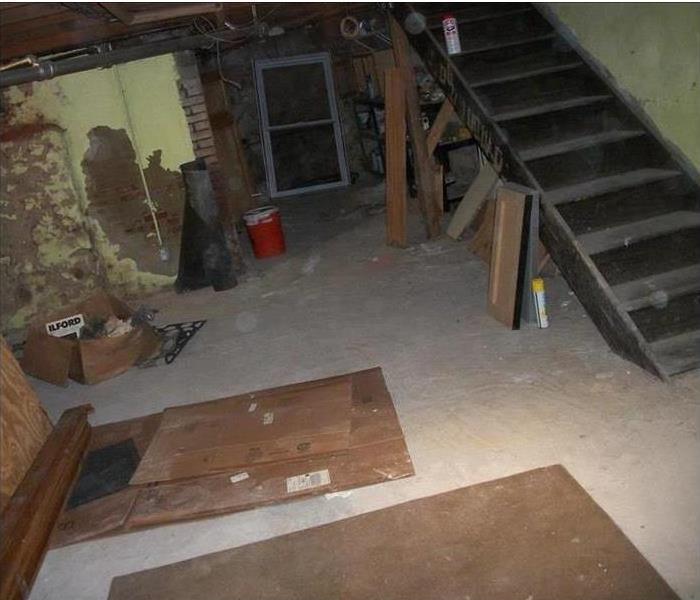 Dust and smoke damage in a home from a neighboring house fire.
Dust and smoke damage in a home from a neighboring house fire.
A fire occurring in your house can be both surprising, overwhelming, and confusing. One can easily feel confused about what it is that they should do after going through such an experience. However, reading up and learning about what it is that you can do after a house fire can make you better equipped with dealing with such a situation. So, in order to help you protect yourself and your property, here are 5 things that you can do after a house fire.
Call An Emergency Helpline
Of course, the first step in any emergency situation is to call an emergency helpline. However, you must first ensure that everyone within your house is outside first. The first responders will arrive at your home and will focus their attention on the safety of you and others who live in your house. After all of the house occupants' are out of danger, they will then focus their energy on saving the structural integrity of your house.
Take Some Time
While the first respondents are working on dousing the flames, make sure to take time for yourself so that you are able to process the situation. Try to remind yourself and those who surround you that everything will be okay as spiraling will only make you feel more stressed and won't help the process go any faster. Be sure to take everything one step at a time so that you do not overwhelm yourself.
Contact Your Insurance Agency
After you have collected your thoughts, contact your insurance agency and ask for their timeline on securing your property, which includes the removal of any standing water as well as covering the doors and windows of your house. The entire process depends on the amount of damage your house has taken, both from the fire and the dousing. Your insurance will help in starting this process for you and will then authorize their company for restoration to secure your property.
Find A Safe Place
As your house, despite the ventilation holes, will now be filled with chemicals, which lowers the air quality drastically, to prevent any health effects, you must then find a safe place to stay for the time being. In fact, the restoration and recovery process can take several months to finish, which is why most people end up residing in a relative's house rather than a hotel. So, be sure to be monetarily prepared.
Secure Your House
If you are in a situation where the fire department tells you that your house is safe to live in, you will still have to take certain precautions, such as boarding up your house. This will prevent any outside impurities from entering your house.
All in all, knowing the steps that you have to take after a house fire will not only help you but will also make you feel more at peace. So, if you ever do go through something like this, we hope that you do not, you will not feel confused rather you will, by default, go into autopilot and start taking the required steps.
SERVPRO of Cherry Hill/Haddonfield, NJ is the Premier Cleaning and Restoration Company
7/13/2021 (Permalink)
The Importance of Fast Response Time
SERVPRO of Cherry Hill/Haddonfield understands the importance of quick response time when disaster strikes. Water damage occurs upon entrance into the home/commercial property. In order to mitigate damage to your property, it is imperative to call the pros at SERVPRO of Cherry Hill/Haddonfield, who are trained, experienced, and equipped to arrive and prevent further destruction. Water contamination spreads faster than one may think. Within minutes your claim cost can increase as water quickly spreads throughout the home or residential property.
SERVPRO Handles the Insurance Companies
In time of tragedy, the last concern a customer wants to face is the burden of dealing with their insurance company. SERVPRO of Cherry Hill/Haddonfield communicates directly with your insurance company to secure the proper funding for your fire, wind, water, and hail damages. The franchise professionals at SERVPRO of Cherry Hill/Haddonfield understand the costs associated with restoration and have the experience to assure you get the most out of your homeowner’s insurance.
SERVPRO is a Trusted Leader in the Cleaning and Restoration Industry
SERVPRO of Cherry Hill/Haddonfield is a local franchise with the power of over 1,700 national franchise. Our team has the training, certifications, and experience that enables them to handle a diverse set of restoration and cleaning inquiries. As a preferred vendor for many national and local insurance companies, it is no wonder why customers often come to SERVPRO of Cherry Hill/Haddonfield for their cleaning and restoration demand.
Cleaning Beyond COVID Chaos - 7 Steps for Small Businesses
7/12/2021 (Permalink)
In recent months, the world has changed beyond recognition. Business of all sizes have had to pivot and adjust at breakneck speed in response to the pandemic breakout of the coronavirus. Whether you’re a shop-fronted business, an office-based organization, or a startup working from a co-working space, no one has been left unaffected.
In the coming months, each country will gradually go at their own pace to start lifting restrictions. Communities will slowly start to come back together. Store entrances will tentatively reopen their doors. Staff will eventually return to their desks, and meetings will resume their place in time.
But what will the future hold, beyond this?
In order to overcome this crisis, it’s vital to hold on to the facts. We need to gather together to implement strong, clear hygiene practices in our workplaces going forwards. We must embrace the relevant information provided and turn it into positive practices for a clean, safe working environment.
Our staff teams are relying on us to keep them safe.
At SERVPRO, we work with a wide range of customers in need of specialist support services from domestic disasters. Fire restoration, specialized cleaning and water damage are just some of the services we provide. With the arrival of COVID-19, we are working harder than ever to keep our customers and staff safe!
Here are our 7 effective steps that we recommend for your business through the coronavirus chaos and beyond:
- Remain informed. At the moment, the updates are changing hourly, yet alone daily. It can seem overwhelming, but staying informed about the latest advice is crucial. Gather information from trusted sources, such as the World Health Organization rather than hearsay from colleagues or newsfeeds. By doing so, you will be empowering your business team rather than scare mongering them.
- Educate your staff. Are your managers fully clear on how social distancing should operate? Do your office team understand the government precautions and what they implicate? Use simple, positive language to deliver training on hand washing practices, cleaning scheduling, and personal hygiene. By doing so, you will be creating a safer workspace for everyone.
- Reassure your team. Your staff groups are likely going to be hyper vigilant when they return to work, as they have been impacted by the scarier news stories they have seen on their screens during lockdown. They may be more anxious than usual, and concerned about how they can do their jobs safely while still achieving their goals. Use positive, straightforward language in all communications to reassure each person that their safety is in good hands. They will appreciate your constructive approach and be much more likely to adhere to safety practices.
- Provide appropriate products. Hand sanitizer should be a standard product you supply for those working within your small business. Make sure you have plenty stocked up. Depending on the type of business you have, you might also want to purchase specialist cleaning products and equipment. If your staff needs training to use them, head back to step 2 of this guide.
- Use floor markings. We are all doing our best to stick to the distancing rules, but it can be easy to forget them when we become engaged in a conversation. To help your staff and clients stay safe, mark out 6 feet gaps between workstations and places where people might be likely to gather. This will also provide a handy frame for someone to refer to if they need to politely remind a colleague who is overstepping boundaries accidentally.
- Utilize effective signage. While your staff team adjust to new practices of health and safety, help them by placing guidance signage in easy to see places. This will help to normalize the changes whilst also providing additional educational opportunities. Remember, knowledge is power. Equip your staff with the right information and you will be avoiding further issues down the line.
- Consider shift cycles. Depending on the type of business you have, consider creating shift patterns for safety purposes. Even an office-based business can benefit from doing this in helping to lessen the numbers of groups of people in the space at the same time. Try out various pattern styles to see how it could work for your business. You can also continue implementing remote work for those staff members who don’t necessarily need to be physically present.
During these challenging times, it can be easy to feel overwhelmed. With so much noise coming from news desks and newsfeeds, it’s difficult to navigate forward. However, it’s important to stay focused on the facts of this situation rather than the fearful guessing games that are so common at the moment.
This is not a time to panic - it is a time to plan.
We all want to be back in business as soon as possible. We want to overcome these unprecedented times. Not only that, we want to return to a clean environment that our staff can feel safe within. This, above all, is vital practice for an organization of any size going forwards.
If any of your staff team show any of the key symptoms of the virus, then take immediate action to gain medical support for them. Remove them from your workplace as soon as possible, in order to keep your staff team safe. Wellbeing practices such as this will become the norm for some time, and we must accept this in order to keep our businesses and our staff safe.
This too, shall pass. Despite how it might feel right now, we will survive this chaos, and move on from its clutches. We will overcome this, ultimately. Perhaps as we emerge from lockdown, we will move into our collective futures with an even greater sense of value for the teams who work with us and the customers who facilitate our successes.
Stay safe, stay well, and stay positive. We are in this together!
What To Do And What Not To Do When Dealing With Fire Damage
12/1/2020 (Permalink)
Sometimes unforeseen circumstances can completely change our lives. A fire in your home or place of business is one of them. It can cause extensive damage that can take a while to recover from.
However, you need to start the fire restoration process as soon as possible so you can resume life. When it comes to fire damage and restoration here are some of the things you should do and some you should avoid.
What To Do When Dealing With Fire Damage
It is important to always have a plan when it comes to such damage. Your plan will allow you to take the necessary steps to deal with fire damage and restore everything as fast as possible. Here is everything you need to do:
- Never enter the property until a professional has told you it’s safe
- Take pictures so you can have evidence of the damage
- Call your insurance agent
- Call your local restoration company such as SERVPRO
- Limit your movement inside the area of fire
- If the weather is fine then open all the windows for proper ventilation
- Throw away drinks and foods that have been left after the fire
All of this will protect you from further damage and help you restore your property as soon as possible. The best thing you can do is call a professional for restoration so they can take care of everything.
What Not To Do When Dealing With Fire Damage
It is important to know what not to do as well so that you don’t end up causing further damage. Here is a list of things you shouldn’t do when dealing with fire damage on your property:
- Don’t start cleaning everything unless your insurer has assessed everything first
- Don’t use carpets or other furniture until they have been professionally cleaned after a fire
- Don’t eat or drink anything that has been exposed to the fire
- Don’t turn on water, gas, or electricity till everything has been professionally assessed
- Don’t turn on any electronics until it has been professionally assessed
You need to give time to the professionals to handle all these aspects. This is because the residue that stays after a fire can cause a variety of health problems if you start doing everything too soon.
So, till the professional sort everything out and restore the damage this is what you should and shouldn’t do. Just make sure that you are not using the property at all until it has been assessed by an insurer and a fire restoration professional.
If you want to minimize the risk of fire on your property then you should always take preventative measures. However, if you still end up having a fire on your property then this was your complete guide to what you should and shouldn't do.
Follow these steps and you will be good to go. If you want a professional fire damage restoration company then no one does it better than SERVPRO. Feel free to get in touch with us now.
Tips On Fire Damage Cleanup
11/20/2020 (Permalink)
We might view fires as something abstract, but they are very real. Fires happen every single day, to others due to a variety of reasons. So, one does not usually imagine the scenario in which they, themselves, would have to go through such an experience. This is why most of us, seldom read about what it is that we can do to help ourselves after. However, we are going to change that today. If a fire does happen to occur on your property, then fire damage cleanup tips are something that you should know as they will, undoubtedly, come in handy.
1.0 What Exactly Is Involved In The Fire Damage Cleanup Process
First thing's first, to understand the tips that we provide for the fire damage cleanup process, you must first know exactly what it is that the process entails. The process involves the removal of any debris caused by the fire, resolution of any sort of water damage, and removal of standing water within your property. That is not all, to ensure that the air quality in your home is as good as it was before the fire, you must start by eradicating the smell caused by the smoke and removing any soot accumulation in your house and places, such as vents.
2.0 Tips
Now that we know exactly what we have to do during the fire damage cleanup process, here are some tips that will make the entire process much more easy and efficient.
2.1 Safety
Before you start the cleanup process, it is vital for you to ensure that you are safe and using protective gear at all times. So, our first tip is for you to wear protective clothing, such as shoes with heavy soles and work gloves. Next, to make it easier for you to breathe through the dust particles, make sure that before you begin the cleanup process, you water the debris to minimize them.
2.2 Efficiency
To make the cleanup process more efficient, there are certain ways in which you can make the products you are using work for you. Firstly, to reduce odors set in your clothes after the fire, you can use cleanup products that contain TSP, that is, tri-sodium phosphate. However, make sure to wear rubber gloves when using such products. On the other hand, when cleaning the walls of your property, make sure that you work on one small area of the wall at a time. You can easily use a mild detergent or soap to clean soot from your walls. In fact, you can even mix it with TSP for extra ease and efficiency. Work your way up as this will ensure that your walls don't have any streaking. Then, immediately rinse with clear water. Make sure that you wash your ceiling after you have cleaned all of the walls.
When dealing with a situation such as fire damage cleanup, things can start to become quite overbearing and emotionally overwhelming. This is why you should take each task one step at a time and remember these tips and all will be well.
Water Damage Timeline
9/22/2020 (Permalink)
Here are the reasons you should mitigate your water damage sooner than later.
Water Damage Timeline
Within Minutes
- Water quickly spreads throughout your property, saturating everything in its path
- Water is absorbed into walls, floors, upholstery, and belongings
- Furniture finishes may bleed, causing permanent staining on carpet
- Photographs, books, and other paper goods start to swell and warp
Hours 1-24:
- Drywall begins to swell and break down
- Metal surfaces begin to tarnish
- Furniture begins to swell and crack
- Dyes and inks from cloth and paper goods spread and stain
- A musty odor appears
48 Hours to 1 Week
- Mold and mildew may grow and spread
- Doors, windows, and studs swell and warp
- Metal begins to rust and corrode
- Furniture warps and shows signs of mold
- Paint begins to blister
- Wood flooring swells and warps
- Serious biohazard contamination is possible
After 1 week
- Restoration time and cost increase dramatically; replacing contaminated materials and structural rebuilding may be extensive
- Structural safety, mold growth, and biohazard contaminants pose serious risk to occupants
SERVPRO of Cherry Hill/Haddonfield specializes in the cleanup and restoration of residential and commercial property after a fire, smoke, or water damage event. We respond promptly, and dry your home quickly, minimizing the damage that your home sustains.
Water Damage Cleanup FAQ
9/18/2020 (Permalink)
- How long will it take my property to dry?
Drying time is determined by a combination of factors including the location, duration and source of water, the types of building materials, the weather conditions and how quickly emergency services begin. Through consistent monitoring and evaluation of the drying process, we can determine when the drying is complete. Your carpet may feel dry to the touch, but padding and sub-floors may still be wet underneath. While there are no rules to determine how long your property will take to dry, we can tell you it may take between three to five days or more, depending on the conditions.
- How do I know when my property is completely dry?
Proper testing with our specialized equipment is the correct way to determine if things are completely dry. Touch alone may be a false indicator.
- Will turning up the heat help dry things out?
Not necessarily. We will adjust the temperature to its optimum setting for the proper drying conditions. Please do not change the setting or shut off the system; doing so may prolong the drying process.
- My wood floors are wet and buckling. Will they have to be replaced?
Wood flooring must be evaluated during the drying process. We employ specialized drying systems and dehumidifiers which enable us to create an environment where wood floors can dry more efficiently and resume their original shape. Due to the density of hardwood flooring and urethane finishes, drying may take up to three weeks or longer. If you filed a claim, your insurance adjuster will work with you to make the final decision as to whether floors will need to be refinished or replaced. - What about my wet furniture?
The extent of damage and the construction of the furniture will determine if your furniture can be restored. Your furniture must be dried before damage can be adequately assessed. Non-salvageable furniture will be documented for you and if any items need to be discarded, a customer release form will need to be signed.
- Do I need to move out of my property during the water damage restoration process?
If you file an insurance claim, you may receive guidance from your insurance representative. However, this is a decision you must reach on your own. Here are several things to consider. Safety is paramount. Our equipment is as childproof as possible, but we require your supervision for making sure no children play with it. Air movers and dehumidifiers will create some noise and make your property drafty for a few days. It is important that the equipment remains on, so if the noise is disruptive to you, you might want to consider an alternate place to stay.
- What is that smell?
It is not unusual to smell odors during the drying process. Increased heat and humidity can also lead to increased odors that may be coming from the drying building materials, or dormant spill and accident areas. Do not confuse these normal odors for the odor of mold.As the drying process continues and humidity levels drop, you will notice these odors disappearing on their own. Deodorizers are often used to minimize these effects as well.
- Does everything need to be moved out during restoration?
Not usually. If items need to be moved out, we will let you know in advance.
- My ceilings are wet. What needs to be done?
Our technicians will evaluate moisture content, determine the severity of the damage and may have to remove some of your ceiling for ventilation. Wet insulation can also be a hazard and may need to be removed.
- Should I open the windows to help the drying process?
Opening your windows to assist the drying process is not always recommended. Outside weather conditions may vary, so the technicians will determine when and if the outside air is appropriate.
- Can I walk on the area during the drying process?
It is strongly suggested that you keep the traffic to a minimum. Wearing shoes is recommended for your safety.
A few reasons your carpet may not be salvageable:
– Delamination (occurs when the backing separates from the carpet fiber)
– Loss of adhesion (may be caused my prolonged exposure to water or age of the carpet)
– Permanent Stains
– Carpet covers wood flooring (to salvage the wood flooring)
– Sewage contamination
- Why does my specialty floor need to be removed?
Non-porous flooring can trap water and prevent it from drying properly.
- Why did the technician leave wet carpet on my stairs?
Carpet on the stairs is generally not removed for safety reasons. Exposed tack strip or staples, especially on steps is dangerous. However, there are situations where removing carpet from steps is necessary to prevent damage to hardwood steps or in the case of sewage contamination. Removing tack strip is not advised, as this may damage the hardwood or the sub-floor. Extreme caution must be when ever tack strip is exposed or when the carpeted stairs are damp. If carpet left on the stairs is unsalvageable, it will be removed when new carpet is installed.
- How will you match my carpet pad?
A sample of your pad is brought to the office for a match. When available, an identical pad will be used. When your original pad is not available, we will provide a pad of the same quality, thickness and density. Similar pad may differ in color based upon the time it was manufactured.
- What will you do with my area rugs?
Rugs are taken to our warehouse for special care. They need to be dried carefully to minimize bleeding and colors and discoloration. Your rugs will be dried, cleaned and returned.
- Why are air movers and dehumidifiers used?
When water damage has occurred, water can be absorbed into the drywall (sheetrock), baseboards, sub-flooring, etc. Drying these surfaces requires high velocity air movers to accelerate the release of absorbed water into the air. Dehumidifiers are necessary for removing this excess moisture to help protect property and create conditions for efficient drying. Please do not turn off or move drying equipment without first calling ServiceMaster Clean.
- Who is responsible for monitoring the drying equipment?
Our water damage mitigation specialists will place and monitor equipment to achieve optimal results in the shortest amount of time. Please make sure no one turns the equipment off or moves it. Please notify our office immediately if the power goes off or if the equipment turns off.
- What will it cost to run the equipment?
Based on average electrical rates, it may cost about one dollar per day to operate the drying equipment.
- What about sewage contamination?
Hard surfaces can be cleaned and sanitized. Affected items that cannot be sanitized require disposal. Porous materials such as drywall, ceiling tiles, insulation, particleboard, paneling, etc. that have been directly affected should be removed during the emergency service visit.
Pros and Cons of Flat Roofs
9/18/2020 (Permalink)
Home and business owners throughout Southern New Jersey are considering upgrading their roofing may want to consider the advantages as well as disadvantages of installing a flat roof rather than one featuring sloped construction. SERVPRO of Cherry Hill/Haddonfield understands that flat roofs are becoming increasingly popular because of their affordability, but they must be properly sealed in order to maintain their structural integrity as well as properly maintained in order to prevent roof leaks.
There are several important advantages of selecting a flat roof over one that is sloped. Flat roofs are easier to access and stand on for the purposes of roof inspection. Their horizontal surface offers more stability than a sloped roof. They are much more affordable to install as well as re-coat than other styles of roofing. A flat roof is also viewed as more aesthetically appealing for use in warmer climates.
One major disadvantage that flat roofing has over a sloped roof is that its stability decreases as its size increases. A very large flat roof usually cannot avoid flooding after a period of heavy rains, and there is an increased risk of collapse from the weight of this water. In order to avoid flooding problems, the synthetic rubber coating that has been applied to the surface of the roof must be checked on a regular basis. Proper maintenance is also essential to avoiding roof leaks.
Home and business owners whose buildings currently have a flat roof that has not been checked or undergone regular maintenance should contact a licensed roofer for an inspection. If you do have a leak-- contact SERVPRO of Cherry Hill/Haddonfield immediately 24 hours a day, 7 days a week. Our professional team will ensure that water damage is repaired and get you back into your home or business in no time!
Mold Remediation and Restoring
9/18/2020 (Permalink)
Any home or business can quickly become infested with mold with the introduction of a water source, like a roof or plumbing leak. Mold can spread throughout a property in as little as 48-72 hours, and can produce allergens and irritants that have the potential to cause other health effects.
If you suspect that your home or business has a mold problem, SERVPRO of Cherry Hill/Haddonfield Restoration Franchise Professionals can inspect and assess your property. If mold is found, they have the training, equipment, and expertise to handle the situation.
SERVPRO of Cherry Hill/Haddonfield Restoration Franchise Professionals
- Provide 24/7 Emergency Service
- Highly Trained Water Restoration Specialists
- Faster to Any Size Disaster
- A Trusted Leader in the Restoration Industry with over 1,650 Franchises
If You See Signs of Mold, Call 856-662-2772
Understanding Mold
Microscopic mold spores exist almost everywhere, outdoors and indoors, making it impossible to remove all mold from a home or business. Some restoration businesses advertise “mold removal” and even guarantee to remove all mold, which is a fallacy. Consider the following mold facts:
- Mold is present almost everywhere, indoors and outdoors.
- Mold spores are microscopic and float along in the air, and may enter your home through windows, doors, or AC/heating systems or even hitch a ride indoors on your clothing or on a pet.
- Mold spores thrive on moisture. Mold spores can quickly grow into colonies when exposed to water.
- Before mold remediation can begin, any sources of water or moisture must be addressed. Otherwise, the mold may return.
- Mold often produces a strong, musty odor and can lead you to possible mold problem areas.
- Even higher-than-normal indoor humidity can support mold growth. Keep indoor humidity below 45 percent.
Common Mold Misconceptions
With sensational news stories and misleading advertising, you can easily understand why so many people are misinformed about indoor mold. Learn the facts about mold and the mold remediation process.
Why Choose a SERVPRO of Cherry Hill/Haddonfield Restoration Franchise Professional?
They’re Faster to Any Size Disaster
SERVPRO of Cherry Hill/Haddonfield Franchise Professionals are dedicated to responding immediately when you contact them. A fast response lessens the damage, limits further damage, and reduces cost.
They’re Highly Trained Mold Remediation Specialists
They specialize in water and mold damage restoration, the cornerstone of our business. SERVPRO of Cherry Hill/Haddonfield Franchise Professionals have the training and expertise to safely handle any mold situation.
- Applied Microbial Remediation Specialist
- Water Damage Restoration Technician
- Applied Structural Drying Technician
They Use Advanced Mold Remediation Techniques and Equipment
SERVPRO of Cherry Hill/Haddonfield Restoration Franchise Professionals use advanced equipment to detect the source of water feeding the mold. Next, they isolate the affected area using a negative air pressure chamber.
Commercial Water - 3 Signs of Irrigation System Problems
9/16/2020 (Permalink)
Three Signs You May Have Water Trouble Your Way
Curb appeal isn’t just for homes. Ensuring your property is appealing and welcoming makes a big impression on customers and employees. To ensure a luscious green lawn and decorative plants looking their best, and irrigation system is a great solution. Most systems are easy to use and reliable, but not properly maintaining them or ignoring issues can lead to flooding that makes its way into the property, potentially creating the need for a water damage and restoration professional to clean up the mess. Below are three signs that there may be water trouble headed your way.
Malfunctioning Sprinkler Head
At some point, an irrigation system will have a sprinkler head that gets damaged. This can happen from mowing, vehicles or improper pressure settings. Signs of a broken one include:
- Plastic casing is damaged
- Unit doesn’t come up
- Sprinkler head is missing
- Sprinklers with heads that are completely broken off
Low Water Pressure
A sure sign of irrigation problems is low water pressure. If the head isn’t popping up but not damaged or a minimal amount of water is coming out, there is an underlying issue. Potential culprits could be a misfiring back flow device or a leak. If there is a soggy area, it may mean the latter. If there is no obvious leak, compressed soil or tree roots could be causing the problem.
Inactive Zone
If one zone is not working, blocked electrical signals are often the cause. There could be insufficient voltage, which requires a new controller, or there could be damaged wires. The valve’s solenoid may also need to be replaced. If multiple zones aren’t working, it could again be related to power properly getting to the controller, which may mean replacing the transformer.
While an irrigation system can do wonders for a property, being diligent regarding maintenance and regularly checking this it is working properly are necessary to avoid added water issues.
Tips To Prevent Basement Flooding
9/15/2020 (Permalink)
Flooding damage is expensive to repair. To save yourself from this cost you must take preventative measures so you don’t end up putting a dent in your pocket.
The main causes of flooding are overflowing gutters, cracks in the foundation, leaky windows, and water seeping into the walls. To make sure that all of this doesn't happen to your home, here are a few measures you can take.
Clean Your Gutters
An inefficient drainage system is the biggest cause of flooding. This is why you must clean your gutters and drainage system and get rid of any debris that may cause a blockage.
This will ensure the water to flow freely and drain efficiently without causing any damage to your home.
Maintain Proper Landscaping
You may be wondering what landscaping has got to do with basement flooding. However, if your hard grades towards your house then you are at a higher risk of basement flooding.
Your home grade needs to be directed away from the house. This is why your lawn should be properly sloped. To fix this problem you can opt for many landscaping solutions that can direct the water away if need be.
Inspect And Repair Any Cracks In Foundation
A small crack in the foundation or a window can cause the entire basement to flood. This is why you must have a routine foundation inspection so that such cracks can be filled and taken care of.
You can inspect it yourself and fill the crack with epoxy. However, if there is still leaking from somewhere then you should call a professional as soon as possible.
Get Window Well Covers Installed
If your basement has windows and they are protected by a well cover then they should be. This is a great way of letting some light into your basement while protecting it from water.
You can get a clear acrylic window well cover to get the most out of them. They will keep any water and pests out from your basement ensuring cleanliness.
Maintain Your Sump Pump
Failure of sump pump maintenance is also one of the major causes of flooding. This is because a sump pump defends your home against many things such as flooding, mold, other water damage, etc.
However, for it to fulfill all these functions you need to maintain it too. Before any harsh weather conditions or storms, you should always get your sump pump checked.
If there are any problems then they should be quickly fixed so that your home can be prevented from flooding damage.
Your home is your investment and your safe place. This is why maintaining it should be your topmost priority. However, if for any reason there is basement flooding or other water damage then you should immediately call a professional.
We offer all kinds of cleaning services and our expertise in this industry is unparalleled. For more information on what we offer, feel free to get in touch with us now!
Steps To Take After Storm Damage
9/15/2020 (Permalink)
A storm can be quite scary and having to deal with its after-effects is challenging. It can leave behind a lot of damage that you will have to take care of. For this reason, you need to have all the right steps in front of you so that you can restore your home as quickly as possible. Here are 5 steps that you will have to follow after suffering from storm weather damage.
Check How Much Damage Is Done
Before you go on to figuring out the solution for the damage, you will have to assess how much damage took place. It is best to take a look at every nook and corner of your home to know where all the damage is.
Don’t miss out on anything as you want to ensure that every bit of damage is repaired properly. Observe every inch of the exterior so that you can know exactly what went wrong. Also, if there is seepage or any other time of damage as well, then make sure to take note of this as well.
Keep Yourself Safe And Avoid Injury
As you go about assessing your home of damage, you want to make sure that you avoid injury throughout. To do this, you will have to keep away from all sorts of electrical equipment and risky areas around your home.
If you see cracks on the roofs, then it is best that you avoid standing under or close to that particular area. The best thing to do is to make sure that your electricity is shut off to avoid getting damage from wires running through your home.
Get Your Insurance Company On Board
Throughout the process, you want to make sure that you are collecting adequate proof to show your insurance company. They will probably also send someone for a physical examination to verify your case. Keep them in the loop so that you can claim insurance for the damages that you face from the storm damage.
Limit Further Damage To Home
Sometimes, if you do not act quickly, there is a possibility of more damage happening to your home. You want to avoid this as much as possible. If there is an excessive wind blowing or water coming in, you might want to board your windows.
If you’re not sure how to do this, then you must reach out to a professional service for help. And, that is our final step that will help with the damage.
Get The Right Professional Cleaning Service
You want to ensure that your home is not damaged beyond repair. This is when you need to get the right people on board to help you clean up the mess after the storm weather damage. You do not want to put the entire work on yourself as you might not have the right equipment to get this done properly.
You should reach out to professionals who can help you clean your home and minimize the damage done to your home. Connect to https://www.SERVPROcherryhillhaddonfield.com/ and get your home cleaned up in no time.
Important Reminder in Responding to Water Damage
9/14/2020 (Permalink)
Although it may seem easier and relatively harmless to let water dry on its own, property owners need to understand the dangers of failing to properly respond to water damage. Despite the extra expense associated with hiring professional technicians, the cost and level of stress will be magnified exponentially when the problem is left untreated, as secondary damage is likely to result.
Reasons to Avoid Delay
When the water removal and cleanup process is not initiated immediately, you may see the following:
- Warped wood framing
- Weakened subflooring
- Broken or bulging ceiling tiles
- Rusted metal fasteners or supports
- Deteriorating drywall
- Peeling paint or wallpaper
SERVPRO’s 24/7 Response
Because we know how important it is to quickly respond to a water damage emergency, SERVPRO of Cherry Hill/Haddonfield prides itself on its 24-hour service. Our crew is ready for your call any time of the day or night, weekdays and weekends.
SERVPRO’s Customized Response
SERVPRO professionals perform in-depth assessments to ascertain the ideal action plan in restoring your property in a timely manner. Additionally, our technicians use the latest methods and top-of-the-line equipment to deliver the best results.
For an immediate and personalized response from our team at SERVPRO of Cherry Hill/Haddonfield, call us at (856) 662-2772.
Is Your Dryer Safe and Working Properly?
9/9/2020 (Permalink)
Regular maintenance can save time and prevent lint fires?
Here Are Three Signs That Tell You It May Not Be:
- Vent trap doesn't open correctly
- Clothes take longer to dry
- Burning Smell
1. The Vent Trap Doesn't Open Properly
A stuck vent trap is also another sign of lint build-up. It could be the result of overdue maintenance and will eventually affect your appliance. You should frequently check for debris or lint around the dryer hose to catch this problem before it causes a nasty clog or lint fire.
2. Clothes Take Longer to Dry
When your dryer vent is clogged, clothes take to dryer as hot humid air cannot leave the dryer.This translates into more dry time and wear and tear on your dryer. This may also add unnecessary humidity into your structure which could cause secondary damages.
3. A Burning Smell
If you detect a burning smell from your dryer, please turn it off immediately. This could be caused by your drum or lint trap being clogged. The smell could be coming from hot clothes and longer drying times. Check your dryer's vents and traps immediately, or call in a professional appliance company.
Dryers are a luxury for most homeowners, don't wait until a malfunction to start your troubleshooting. Regular maintenance will save you money and prevent a possible lint fire in the future.
Fire in Your Business
9/9/2020 (Permalink)
SERVPRO of Cherry Hill/Haddonfield Professionals can help provide a solution to your property's fire damage needs.
- Structural Cleaning - After a smoke or fire damage, ceilings, walls, woodwork, carpeting and floors will often need a thorough cleaning. Our trained technician will pretest to determine the extent of damage, and then use specific equipment and cleaning solutions required to clean and protect the different types of surfaces found in your facility. Depending on the amount of soot, we may even be able to reduce the cost of recovery by cleaning the surfaces. This could eliminate the need for repainting or refinishing.
- Contents Cleaning - We will professionally clean and deodorize all of the restorable contents in affected areas. This may include area rugs, furniture, draperies and upholstery. We begin by carefully inspecting and testing all fabrics and contents to determine which cleaning method to provide. Additionally, we will provide an inventory list and pictures of all "to be claimed" items if requested.
- Deodorization - We also provide specialized services to rid your home or business of offensive odors left by fire or smoke damage. We do not merely cover up lingering odors with a fragrance, we will seek out the source of the odor and remove it.
Remember, no job is too large or small, with over 1700 locations SERVPRO has the ability to pool resources to make it "Like it never even happened."
CALL US FOR YOUR NEEDS: (856) 662-2772.
How to Mitigate Water Loss and Closures for Commercial Sites
9/9/2020 (Permalink)
Tips for Business Owners to Avoid Commercial Water Cleanup Situations
Commercial water damage hit a business in multiple ways. The company usually needs to close for repairs, lack of revenue, and the loss from items directly damaged by the water.
There are actions business owners can take to protect their property from commercial water damage. It is far easier to dedicate a small amount of time towards proactive measures that assist in avoiding a loss to the property and contents. SERVPRO recommends doing the following:
Regular Inspections
Here in Minnesota, snowmelt and flash floods, as well as plumbing issues, are the reasons for water loss in commercial properties. Make a list of areas to check and look over those places once a month. In this way, small leaks, damage to the roofing, or pooling water from poor drainage does not have a chance to become a problem.
Winterize
The winters in the state are brutal, and a little winterization goes a long way. Drafts can freeze pipes with poor insulation, which in turn causes the pipes to burst. Overnight and on weekends, make sure the heat in the building runs at sufficient temperatures, never lower than 50-degrees Fahrenheit, to prevent freezing pipes. If the thermostat has a battery backup, make sure to replace the batteries regularly.
Talk to Your Security Company About Environmental Monitoring
Environmental monitors can send out an alert when there is an elevation in temperature or moisture. Many different monitoring agencies offer this type of service. Having an early warning system in place has the potential to save your property from damage from both fire and water.
Establish an Emergency Plan
If water damage happened on-site, what should you do? Establish a list of where the water shut-off valve location and numbers to contact, such as SERVPRO for quick cleanup of the property. The technicians can remove water, restore furnishings, and handle proactive treatments against mold and odors.
We suggest contacting our office regarding a pro-active program we offer called the ERP--Emergency READY Profile Program. A Sales and Marketing Rep SMR can schedule a visit to your company and demonstrate the advantages of this effective measure to keep your business viable. No cost to you, and it can save your business from closure.
SERVPRO of Cherry Hill/Haddonfield at (856) 662-2772 is ready to assist local businesses with commercial water cleanup of any size. They arrive quickly and restore the property to its preloss condition, "Like it never even happened."
Why Your Home Needs A Professional Storm Cleanup Service
9/8/2020 (Permalink)
A storm causes a lot of destruction in its wake. The chaos it creates is too much to deal with. This is why residential owners need extra help to restore their homes after a storm.
For this, you will need the service of a professional company that deals in storm damage restoration and cleanup such as us. After all, your home is your sanctuary and it needs to be protected so you can be safe.
Here are the many reasons why your home will need a professional storm damage restoration service.
Quick Cleanup And Repair
The damage that storms can cause can be extensive. You and your family can't possibly repair it in time and you will need a few days or a week to restore it yourself. However, because of this, you may feel unsafe in your own home.
Hiring a professional storm cleanup service means that your house will be restored to its original form in no time. This is because we are experts at what we do and we can quickly and effectively repair any damage caused by the storm around the house.
Professional Evaluation
As a layman, you will not know where to look for damage. You might miss out on a few things that should be repaired so your house can function well and live a long life.
Hiring a professional service will mean that they will do a full evaluation of your house first. This means that the experts will search every corner of the house to see the extent of the damage.
Apart from that, they will figure out what needs to be fixed through a detailed inspection and evaluation of your property. They will then come up with a solution to fix all the damage.
Clean And Sanitized Home For Optimal Health
Storm damage can cause contamination, infections, parasites, and diseases. These are serious issues that need to be addressed as soon as possible. If these issues exist then they will come to light when the experts do the inspection and evaluation.
As a professional cleanup service, our main priority is your health and we will do everything to ensure that it is not harmed. This is why your home will be thoroughly cleaned and sanitized to get rid of any contamination and infection. You can then go back to enjoying a safe and healthy home.
Flooding Will Be Taken Care Of
Storms can cause flooding in basements and other areas. However, we will clean it up through the use of our flood pumps to get rid of all the water and to prevent it from seeping into your walls.
As a professional cleanup service, we have all the equipment and expertise to execute the restoration effectively.
Please don’t attempt to restore the house yourself after storm damage. Instead call professionals and experts such as us to effectively clean and restore your house to its original form.
For more information, feel free to get in touch with us now.
How To Prepare For A Storm
9/8/2020 (Permalink)
It is better to be safe than sorry. Preventative measures are key to saving yourself and your home from the damage that comes with a storm. Storms bring heavy rain, winds, and lighting.
They can cause flooding, power outage, and a lot of destruction. This is why you must have a plan to deal with all these problems that may come with a storm.
However, if there is still damage caused to your property because of the storm then hire a professional storm cleanup service for your home restoration.
Here are the many safety tips you can follow to prepare yourself for a storm.
Ensure That The Exterior Of Your House Is Safe
You must take care of the outdoors to reduce safety hazards. For example, you need to trim down large trees and shrubs so that they don’t fall on something else or get tangled with wires.
Apart from that any plants, furniture, or other objects that are placed outside need to be brought indoors so they can be saved be from damage.
Keep Everything Powered Up
Make sure that the gas tank of your car is full. Charge any appliances that need charging such as your cell phone, laptop, etc. Apart from that, you need to test your generator beforehand so that it works properly in case of a power outage during the storm.
Also, keep extra fuel for the generator in case of extensive power outages. This way you will always have backup power.
Make An Emergency Plan
Nature is unpredictable and you never know how bad a storm is going to be. This is why you must have a contingency plan in case of extreme circumstances.
Come up with a plan of how you are going to get in touch with all the family members and where you will meet up to stay safe. This is because storms can happen anytime and not everyone will be home.
Clean Gutters
The main reason why urban flooding takes place because of a storm is due to the overflowing of gutters. With too much water coming in the water overflows and causes the area to flood.
This is why it is important to routinely get your gutters cleaned once in a while. This will allow the water to flow freely and prevent any blockages. It will also prevent the flooding of your basement and roof damage.
Create An Emergency Kit
This is only for a worst-case scenario. If you have to leave home because of some damage or in case of a power outage you will need an emergency kit.
Be sure to have essential medicines, first aid, batteries, important documents, non-perishable food, water, clothing, cash, and all other essential items that you may require.
It is always good to be prepared for an unprecedented situation that may arise due to a storm. Follow these tips to prepare before a storm and you will be good to go.
However, if there is any damage to your home due to the storm then give us a call (856) 662-2772!
A Professional Response to Smoke and Fire Damage
8/28/2020 (Permalink)
Fire has a tremendous capacity for destruction and is one of the most widespread and common risks when it comes to commercial properties. As a result, most businesses have insurance coverage that includes protection against fire losses. When flames do break out, business owners contact professionals to respond to the fire and smoke damage. With the right equipment, these professionals help business owners get their properties back into working condition.
The Scope of Destruction
Experienced fire and smoke cleaning technicians understand that fire damage goes beyond the direct destruction. They take quick action to respond to several fire-related issues:
- Stains left behind by soot resting on porous surfaces
- Mold and mildew growth after the use of water to put out flames
- Corrosion on metal surfaces exposed to water and oxygen
- Poor air quality as smoke and mold particles hang in the air
The longer commercial properties sit after smoke damage occurs, the more likely it is that the extent and scope of the destruction will increase. The best response to fire and soot damage is to act as soon as possible.
Assessment of the Damage
As professionals arrive at a commercial property to respond, they'll assess the amount of fire, smoke, and water damage. As they begin their inspections, technicians also focused on safety. There are several safety risks inherent in the destruction left after a fire. Experienced fire damage cleanup and remediation professionals are certified and licensed to enter the property. In addition to training and authorization, they have the proper protective equipment to enter weakened structures.
The Cleanup Process
With safety procedures underway, cleanup and restoration professionals are ready to secure entry points and property breaches (such as broken windows and holes in the roof), establish security against further destruction, and begin removing debris. Technicians also remove as much equipment and inventory as possible. At this point, water removal and deep cleaning can begin.
The end goal of the cleanup work is to remove all evidence that a fire took place. When properties are affected by the fire and smoke damage, the work of professionals begins with safety and results in pristine buildings.
Safe Ways to Restore my Home and Contents after Flood Damage?
8/26/2020 (Permalink)
SERVPRO Offers Nationally Certified Restoration Experts to New Jersey Residents with Flood Damage.
What qualifications are needed to restore property flooding in Southern New Jersey?
Certifications can help you identify expert local restorers when you do not have time to do thorough research. Our technicians complete their training by receiving nationally recognized qualifications from the Institute of Inspection, Cleaning, and Restoration Certifications (IICRC) body. Flooding can present considerable challenges to even the most experienced practitioners, which is why certifiable quality is essential to sourcing a good restorer. Our roster of technicians for flood damage in your New Haven home include water restorers (WRT,) Applied Structural Drying (ASD) experts, odor control (OCT) and applied microbial remediation (AMRT.) We can also provide specialist stone, masonry and ceramic tile cleaning technicians (SMT) and carpet cleaning technicians (CCT.)
What are the immediate concerns with a flooded property?
- Standing water can exert significant pressure on a structure and need to reduce immediately.
- Stemming water migration can lessen potential damages.
- Securing a property from unlawful entry and theft
- Waterproofing your home using tarpaulins to prevent further water intrusion
- Bringing down relative humidity to avoid microbial growth issues
- Removing possessions from the reach of floodwaters and placing them in a designated dry room for specific restoration detail
- Acting quickly to control water migration and protecting wall cavities or subfloor from water exposure
How does controlling humidity prevent mold growth?
Micro-organisms like mold need three conditions to grow: food supply, temperature, and moisture. A home is full of potential food for microbes, especially wet fabrics, insulation, or drywall. The relative humidity typically rises in a property with large amounts of water in it due to evaporation. To dry a property, we need to encourage evaporation by increasing the temperature, allowing air to hold more moisture than in cooler conditions. The combination of drying efficiently and preventing microbial growth is a fine balance. SERVPRO technicians take regular measurements of indoor humidity using hygrometers to ensure that mold reproduces slowly during the restoration. Slowing mold growth allows us to focus on drying efficiently without risking an uncontrolled microbial outbreak.
What steps can you take to control mold growth during flood restoration?
- Dehumidification to maintain indoor humidity below 60 grains (of moisture) per pound (GPP) keeps microbial growth under control.
- Using biocides or antimicrobial chemicals on high-risk areas to prevent mold from moving through growth stages during the cleanup
- Paying close attention to water migration, dripping or leaking which could cause damp spots and attract mold spores
- Thorough cavity inspection and drying to avoid mold buildup behind walls, floors or ceilings
How can I speed up evaporation in a room without natural ventilation or light?
Water evaporates quicker when there is plenty of dry air in the room. A general rule of thumb for encouraging evaporation is that wet always move to dry. However, the more water that evaporates, the more saturated the surrounding air becomes, reducing drying times. When dealing with a room with lots of residual moisture, evaporation can create a vapor barrier between dry air and the surface, which leads to slow drying. SERVPRO technicians use air-moving equipment to maintain constant air motion through a flooded property. Moving air allows wet surfaces to evaporate into dry air. Combining a heating element increases overall air temperature, which allows it to absorb more evaporated moisture speeding up the drying process.
When can you start structural or contents restoration for a flooded property?
Once damage mitigation is complete with the property is clean and dry, we can begin to perform a restoration. Restoring a property can involve replacing any building materials that were non-salvageable and as buffering carpets or repainting walls. Our technicians combine the restoration phase with preventive measures that can protect your home against secondary damages. These procedures include using antimicrobial or odor sealing primers on walls and carpets to ensure that you do not incur further costs in the future.
Taking a property through restoration from start to finish requires organization and qualified restoration professionals. Contact SERVPRO of Cherry Hill/Haddonfield at (856) 662-2772.
Staying Safe during a Flood
8/25/2020 (Permalink)
Springtime can bring severe rain showers which can lead to flooding in our area. According to Ready.gov floods are the most common natural disaster in the United States. Here are few things to know about floods:
Floods may:
- Result from heavy rain, storm surges and overflows of dams and other water systems.
- Develop slowly or quickly. Flash floods can come with no warning.
- Cause outages, disrupt transportation, damage buildings and create landslides.
IF YOU ARE UNDER A FLOOD WARNING, FIND SAFE SHELTER RIGHT AWAY
- Do not walk, swim or drive through flood waters. Turn Around, Don’t Drown!
- Just six inches of moving water can knock you down, and one foot of moving water can sweep your vehicle away.
- Stay off of bridges over fast-moving water.
- Depending on the type of flooding:
- Evacuate if told to do so.
- Move to higher ground or a higher floor.
- Stay where you are.
SERVPRO of Cherry Hill/Haddonfield can respond immediately to storm and flooding conditions. We are available 24 hours a day – Call us today at (856) 662-2772.
SERVPRO - 24 Hour Emergency Service
8/25/2020 (Permalink)
SERVPRO of Cherry Hill/Haddonfield is available 24 hours a day for water emergencies, large or small. When you are dealing with water damage, immediate action is crucial. A delay of just a few hours can greatly increase the severity of the water damage.
We Answer the Phone Ready to Help
Call Today – (856) 662-2772
We understand that when you call us, you may be feeling confused, stressed, and vulnerable. You need an expert to guide you through this crisis. SERVPRO of Cherry Hill/Haddonfield has the specific water damage training and experience to help you through this tough time.
What to Expect
When you call, we will ask several questions regarding your water damage emergency. These questions will help us determine what equipment and resources to bring, including how many trained SERVPRO Professionals may be needed.
Our SERVPRO Representative will ask several questions:
- Your name and contact information
- Your insurance information (if applicable)
- The street address of the water-damaged home or business
- When did the flooding or water damage occur?
- What caused the water damage (if known)?
- Is there electricity available (on-site)?
If you experience Water Damage – Call SERVPRO of Cherry Hill/Haddonfield
If Disaster Threatens the Hospitality Industry SERVPRO can Help
8/25/2020 (Permalink)
AT SERVPRO of Cherry Hill/Haddonfield we understand that keeping your guests satisfied is your top priority, and you can rest assured that you are ours. When disaster strikes at a hospitality facility, the help of a specialized team is critical in assuring that normal operations resume as quickly and safely as possible.
Whether the cause is a coat hanger on a sprinkler head or a natural disaster, we work to efficiently isolate the damaged area so that basic functions can continue normally, and guests can enjoy your services with minimal impact. Our professionals are trained to work with your management and maintenance teams to prioritize spaces and make sure that all areas are restored to your complete satisfaction. Our experience in the hospitality industry has given us the ability to provide a variety of detailed services for the following hospitality facilities:
- Hotels
- Convention Centers
- Casinos
- Resorts
- Entertainment Venues
- Banquet Halls
If your business experiences any type of a disaster, SERVPRO of Cherry Hill/Haddonfield will be there to help! Please contact us at (856) 662-2772.
Why Commercial Buildings should use professional cleaners to battle COVID-19
8/24/2020 (Permalink)
As we continue to battle through the COVID-19 pandemic. Commercial buildings have been doing a great job of continuing to implement different measures for keeping the people in those facilities safe. Here are the reasons why a commercial building may consider or need to bring in a professional cleaning staff to battle against COVID-19
Having an Emergency Response Plan.
As COVID-19 continues to spread throughout our community, more people are going to be exposed and test positive for the disease. What will your workplace do when that happens? If there is a massive outbreak of COVID-19 in your workplace, a response needs to be in place so that 1) employees can be safe and 2) work can resume without a fear of infection from the work environment.
A proactive plan should be developed that includes preventative measures to reduce potential exposure and also reactive measures for when exposure happens, and a COVID-19 positive person enters the workspace. This second situation, one where a person has potentially left the virus in the workplace, is one where a professional cleaning staff should be considered.
While normal custodial staff are equipped to handle regular cleaning operations, COVID-19 is different. This highly infectious disease could be transmitted to an unprepared custodial staff if they are not trained in wearing proper protective equipment (PPE) and if they are exposed, it opens a legal gray area in which they can claim they were knowingly exposed to biological contamination without the right equipment.
At SERVPRO of Cherry Hill/Haddonfield we equip all our technicians with the right PPE, which includes gloves, respirators, and full suits for protection. Additionally, we have high-grade that have been recommended for CDC use against COVID-19. This combined with full coverage insurance for our technicians allows us to confidently send them into a biologically contaminated space.
Give us a call today (856) 662.2772, to talk about setting up an emergency COVID-19 response plan. This will allow you to have a response plan in place to battle the spread of COVID-19 if it should enter your workplace
Odd Places You Find Mold Growth in Your Home
8/24/2020 (Permalink)
Mold can be found in many unusual spots in your home. If left to grow, mold can become a dangerous problem for your home’s value, your health, and as a cosmetic eye sore. Here are some places to check and clean to avoid these problems.
Your Toothbrush Holder
While your toothbrush gets replaced every few months (hopefully), your toothbrush holder is in an ideal location for mold growth. The moist environment of the bathroom combined with the wide array of germs from your mouth create the perfect location for mold growth. A few times a year, you should clean and disinfect your entire toothbrush holder.
Your Appliances
Specifically, your dishwasher and clothes washer are susceptible to mold growth. Check behind and underneath them to see if the darkness and moisture has caused growth. You can then clean the area before it grow into the walls and flooring, which is more costly to remove and repair. Also check INSIDE your appliances. Look under coverings and around rubber moisture seals to expose mold which has developed inside the machine where the cleaning process does not reach.
Potted Plants
If you overwater your plants there is a tendency for mold growth underneath where the sunlight does not reach. While this may actually be good for your plant, it is not worth the risk. Be careful not to overdue the watering and if you notice mold, try repotting the plants and putting it in direct sunlight for a few days
Outdoor Rugs and Floor mats
Floor mats invite mold buildup underneath as the organic material from the rug, when wet, creates a dark, moist environment with enough air flow to sustain mold growth but not enough to dry it out. By regularly cleaning your rugs or simply flipping them over and leaving them in the sun for a day, you can prevent mold buildup which can spread throughout your entry ways, steps, and porches.
Candle Safety Tips
8/21/2020 (Permalink)
Although you probably know candles are a potential fire hazard, you may not be willing to stop using them in your home. There is something therapeutic and genuinely enjoyable about lighting a candle and breathing in that amazing scent of choice. The good news is that there are ways to use these products without causing a candle fire.
Consider following these three steps in your home.
- Don’t put your candle too close to the curtains. The worst decision to make when using candles of any size is to put them next to curtains in your home. Even if you think there is enough space between the two items, a quick draft of air could easily cause the flame to spread over to the curtain, causing a candle fire that could’ve been avoided.
- Don’t sleep without blowing them out. Even if you’re only planning to take a nap, make sure you blow the candle out and cover it with a lid if it came with one. You could end up sleeping for much longer than you anticipated, and something could happen during that time that ultimately leads to a serious candle fire.
- Keep your pets away from the candles. You may think you can trust your pets to steer clear from anything with a flame attached to it, but that isn’t always the case. A curious cat or dog could sneak over to the candle and end up knocking it over unintentionally. If that were to happen, you could end up dealing with the fire and smoke cleanup as well as the possibility of losing some of your valuable possessions.
Although candles are a bit of a fire hazard, you don’t necessarily have to stop using them. However, many people have made minor mistakes with candles in their homes that caused them to require the services of fire restoration experts. You can avoid those mistakes by following these important safety tips.
Fighting Smoke and Odor Damage After a Commercial Fire
8/21/2020 (Permalink)
Three Methods to Combat Smoke and Odor Damage After a Fire
After a fire at your commercial building there is often a long list of tasks you must take care of before you can reopen your business and get your company back in operation. If there was no structural damage to your building, removing the water may be foremost on your mind, but once the water is gone, what about the smoke cleaning and terrible odors that penetrated everything during the fire? Contact a professional team of fire remediation and restoration specialists to quickly remove the smoke damage and stains. Here are three of the methods they may use to combat the odoriferous problem.
Air Filtration
With the use of specialize screens, an air filtration system can actually scrub the air and remove lingering odors. The unit works by pulling the dirty, smoke filled air into the machine with a powerful fan. The air is then passed through a filter that removes the smoke odor and cleans the air. Once the offensive particles are removed, the clean air is returned into the room. To make sure the filters are especially effective, they are often filled with specially treated charcoal.
Ozone Treatment
Ozone treatments do smoke cleaning by using a machine that sends a thick layer of ozone into the room to cover everything the huge oxygen molecules can reach. As the odors and ozone meet, oxidation occurs that chemically alters the problem smoke. This process can also disinfect problematic areas.
Thermal Foggers
Thermal foggers can send cleaning vapors into tiny crack and crevices where smoke can hide. By sending heated deodorizer out into the room as a foggy vapor, the large cleaning particles can chemically attach themselves to the molecules of the smoke and soot that filled the room in hidden or hard to reach areas. The fog can also permeate many solid items that may have absorbed the fire’s smoke.
By using one of the above three methods, a professional team can quickly remove persistent odors after a fire in your commercial building. Once the smoke cleaning is done, you can then get your building open and your company back in business.
Commercial Cleaning Services
8/14/2020 (Permalink)
As a property owner, you don't have time to worry about common wear and tear that casts itself over your office, home, or business. There could just simply be not enough time to clean up grime, odor and challenges caused from moisture when you have other things that take precedence.
That's why you should consider calling in your local SERVPRO franchise to tackle these issues — regardless if it's removing an odor or giving a deep cleaning to your flooring or carpets.
We offer cleaning services pertaining to:
- Air Ducts and HVAC
- Biohazard
- Ceilings, Floors, and Walls
- Sewage
- Trauma and Crime Scene
- Vandalism
When any of these problems seem to be a problem in your life, let us give you a solution!
Call us today 856-662-2772 for all of your restoration needs!
Top Cleaning Tips To Disinfecting Your Workplace
7/15/2020 (Permalink)
COVID-19 has brought many changes with it and the most important one is that of cleaning and disinfecting. This has become a part of our daily lives as many of us are now using disinfectants in our homes and carrying sanitizers with us 24/7.
However, as an employer, you have to keep your employees safe. This is why you should disinfect surfaces regularly and keep strict cleaning guidelines in the workplace to keep it germ-free.
You need to boost your efforts so the work environment can be healthy. Here are a few tips that will keep your workplace clean.
Get Regular Cleaning Done By A Professional
The pandemic is a serious problem and should be treated as such too. This is why you should get a deep cleaning done every week or every two weeks so that your workplace can remain bacteria-free.
A professional cleaning service will ensure that everything is disinfected and even systems such as air ducts and vents are cleaned. This will regularly ensure that everything is in top condition with no germs around.
Even though this is the first step, you need to maintain this cleanliness. This is why following the tips below with regular professional cleaning will maintain the best level of hygiene.
Wipe Everything In One Direction
If you are cleaning a surface with a disinfectant then wipe it once and don’t go back in the opposite direction. This is because it will make your wipe redundant as you will carry the germs you just cleaned back up again.
This is why all surfaces in the workplace such as desks, doorknobs, laptops, and everything else should be cleaning with a one-way wipe method.
Remind Employees To Wash And Sanitize Their Hands
These signs should be spread all around the workplace so employees can wash their hands regularly. Firstly, this will ensure that there are minimum germs around the office and secondly it will stop the spreading of germs as well.
Hands should be washed for more than 20 seconds and this is a reminder that needs to be put everywhere so workers can keep staying clean.
Don’t Mix Cleaning Cloths
Have a different cloth for every surface that you are cleaning. This means that a separate cloth for every surface. These should be marked or color-coded so the cleaning staff can remember this and clean accordingly.
Using one cloth for a variety of surfaces will contaminate all these surfaces and your cleaning efforts will remain ineffective. It is also important you wash or disinfect the cloth as well after use, or you can discard it completely.
Final Words
Take care of your employees and your office through these methods and most of all make your office safe with professional cleaning services to disinfect everything 100%.
If you are opening your business again and looking for professional cleaning services then hire our services now. We have years of experience and we leave no stone unturned when it comes to disinfecting and cleaning.
For more information visit our website and contact us now!
Candle Safety
7/15/2020 (Permalink)
Us here at SERVPRO of Cherry Hill/Haddonfield have complied a list of important tips to help you understand how dangerous candles can be and how to use the safely.
Quick tips-
- 38% of home candle fires start in bedrooms and cause 35% of associated deaths.
- More than 50% of all candle home fires start because the candle was too close to a a flammable item (I.E. mattresses, bedding, curtains, cabinetry, or furniture are ignited).
- In 12% of home candle fires and in 25% of associated deaths and injuries, the household occupants were asleep when the fire occurred.
- Unsupervised children are involved in 20% of home candle fires.
- Having a working smoke alarm reduces one’s chances of dying in a fire by nearly 50%.
- 11% of home fires are caused by falling asleep while a candle is lit
- 58% of home fires started when something flammable was too close to the lit candle
- 36% of home fires start in the bedroom
Preparedness Tips:
- Remember that lit candles are fire. Keep them at least 12 inches from anything that can burn, such as curtains, bedding, mattresses, paper, books, flammable decorations, clothing, and upholstered furniture.
- Never leave a room or go to sleep before blowing out all lit candles.
- Use candle holders that are sturdy and won’t tip over easily. Candle holders that are made from a material that cannot burn, and are large enough to collect dripping wax would also be a good idea.
- Place candles where they cannot be reached or knocked over by pets or children.
- During an emergency, always use flashlights instead of candles as light sources.
- Never leave a child unattended in a room with a candle. Additionally, keep all matches and lighters out of reach of children.
- Keep all lit candles and any other open flames away from flammable liquids.
In the worse case scenario of a home fire, SERVPRO of Cherry Hill/Haddonfield is here to help. We can clean your content and home, demo effected areas and eliminate smoke odor from your home. Feel free to call us at 856-662-2772 for more information!
Impact Of COVID-19 On Businesses And The Importance Of Cleaning
7/15/2020 (Permalink)
This year has been a complete shock. However, if there is one thing it has taught us then that is the importance of cleaning. Cleanliness leads to good hygiene, sanitation, and discourages any disease being born.
COVID-19 has had a major impact on the way people conduct business. In the beginning, everything shifted to remote work. However, slowly and steadily work is opening back up with the proper precautions of course.
This is why if you are an employer or you own a business then it is important you get it cleaned regularly. This should be done by a professional and here are a few reasons why.
Guidelines Set By CDC Followed
To make public spaces more clean and safe, the CDC has issued cleaning guidelines. They are extensive and some are technical as well. A layman can't possibly get the job done especially in a place of business.
A professional cleaning service will ensure that all the guidelines are followed so you can have an office that is thoroughly cleaned. It will mitigate all risks and maximize the safety of you and your employees.
Cleaning Equipment
Trained professionals are experts in disinfection and removing any sort of hazard. This is because they have the right equipment and tools to carry out this process.
Such equipment ensures that every surface area is cleaned including the air ducts, vents, and other systems that may be hard to reach. This way every nook and corner will be cleaned thoroughly with the right tools and equipment.
Safety Of Staff
In times of COVID-19, the priority of all businesses and employers is to keep their staff safe. People are risking coming to work and this is why they deserve to work in an environment that is safe and clean.
Hiring a professional to do a deep cleaning of your premises will ensure the safety of your staff. This way there will be no harmful bacteria or anything else looming in the workplace.
Apart from the cleaning, proper precautions should also be taken to ensure the maximum safety of employees. Professional cleaning regularly will keep your workplace risk-free.
Trained Professionals
You can get your business back up and running in no time by hiring professional cleaning services. This is because they have professionals that are specially trained in cleaning during such times.
Their expertise will ensure your office is sparkling like a diamond with no contaminants whatsoever. Everything will also be done in no time and so you can easily have your office running while keeping everything safe for yourself and your employees.
Proper cleaning during COVID-19 is more important than ever. It has become the basis of everything and now people don’t go to places that they feel aren’t cleaned properly.
This is why if you are tired of the impact this year has had on your business and you want to be up and running again then you must get professional cleaning services that provide you with everything stated above and much more.
If you are looking for a service then browse our website for more information or contact us now!
Making Washing Hands Fun
7/7/2020 (Permalink)
It is always important to regularly wash your hands. Now more than ever washing your hands is so very important. While it is easy for older kids and adults to remember to wash their hands properly, it may be harder for little kids to understand the importance of thorough hand washing. The Center for Disease Control and Prevention has put together a list of steps and tips to help kids wash their hands.
- The five essentials of hand washing:
- wet
- lather
- scrub
- rinse
- dry
- Key times to wash hands:
- After eating
- before bed
- after working out
- There are many short songs to sing that are not only fun but helpful in timing out the recommend time to hand-wash of 20 seconds.
For more information on hand washing tips visit www.CDC.gov
3 Reasons You Should Rely On SERVPRO For Large Loss Response
7/7/2020 (Permalink)
In the event of a major storm, fire or flood in Southern New Jersey commercial property owners may obtain a quicker and more professional response from a local franchise location of a national restoration company. Here are three reasons to choose SERVPRO to handle any catastrophic loss.
1. Several Franchise Locations
SERVPRO has over 1,700 franchise locations. This means that the closest professionals can arrive on site in four hours or less, which may be faster than other regional mitigation and restoration services. In the event of widespread damage from fires, flooding or storm damage, additional experts and equipment may report from nearby locations to assist in the cleanup and repairs.
2. National Corporate Support
The support of one of the nation's leading mitigation and restoration companies allows the local franchises to be better trained and equipped than most independent companies. Insurance jobs are only offered to locations that satisfy all the requirements of a 21-point Participation Agreement. This oversight and company-wide services such as the Claims Information Center elevate the standard of service and make SERVPRO the perfect choice in the event of catastrophic loss.
3. Industry-Leading Standards
This national corporation is also a certified training school for the Institute of Inspection Cleaning and Restoration. Each franchise must employ at least one technician who specializes in a particular area such as storm or fire damage to maintain certification. The IICRC requires technicians to obtain continuing education credits to ensure that professionals keep up with current best practices in the mitigation and restoration field. This means that the work performed by these employees will be up to the highest standards in the industry. Allowing for our customers to have the best experience possible. All of these factors enable SERVPRO to respond to catastrophic loss caused by fires, flooding or storms faster and handle them more effectively than independent mitigation or restoration companies. Within one hour of contacting the national corporation, property owners can expect a response from a franchise in Southern New Jersey.
Here to keep you and your business clean and safe
6/26/2020 (Permalink)
Even during a global pandemic your business may be considered essential to the infrastructure like SERVPRO of Cherry Hill/Haddonfield. that being said no one wants to get sick so this helpful list of strategies may help you stay safe and healthy.
Workplace Specific Health Strategies
What can employers do to promote a healthy work environment during the COVID-19 pandemic?
A simple and efficient path to promote workplace health includes the following items:
- Encourage hand washing with real soap for at least 20 seconds.
- Put hand sanitizer in numerous stations around the office or facility.
- Provide disinfectant wipes for employees to wipe down surfaces such as keyboards, mouse, desk, chair, pens, stylus, pencils, touch screens, etc.
- Allow employees to wear disposable gloves.
- Remind employees of the company's sick policy. Sharing COVID-19 or Influenza with workspace mates or the production crew could be very costly to all involved parties.
- Coordinate with the facility cleaning team regarding special measures to be taken during flu season or during periods of significant employee sickness.
These measures are very basic, yet they make a huge difference in order to keep the workplace healthy and safe.
When is the right time to call in a professional cleaning service to clean, disinfect, and sanitize the workplace?
Seeking consultation and assistance from a highly trained, well-informed, and experienced cleaning professional to address workplace health and hygiene is both proactive and pre-emptive. Losing multiple teams or crew members to an outbreak of an infectious disease for a week or two could crush production. An office or sales force outbreak could slow or halt sales generation and depress a revenue cycle. The cost of an absentee employee is so much more than paid sick leave.
Qualified cleaning professionals like SERVPRO of Cherry Hill/Haddonfield can provide prevention strategies for a business as well as for a school, daycare or church. People recognize SERVPRO as the industry leader for water and fire damage restoration and disaster recovery. SERVPRO of Cherry Hill/Haddonfield team also specializes in commercial cleaning. Using advanced restoration and cleaning equipment, SERVPRO experts clean to the deepest level.
For a deep clean that can address germs and infection in an office workspace or industrial environment, the team at SERVPRO of Cherry Hill/Haddonfield offers a comprehensive solution that includes disinfecting all floors and flat surfaces. They can also address the more heavy-duty situations if needed.
SERVPRO of Cherry Hill/Haddonfield can make any business look, smell, and feel clean while simultaneously making it a sanitary and safe environment. Most people only think of a flooded house, a sewage spill, fire damage, or disaster recovery when they think of SERVPRO. But the professionals at SERVPRO of Cherry Hill/Haddonfield have been providing deep cleans and restoration services for over 10 years now.
Call SERVPRO of Cherry Hill/Haddonfield today to schedule your cleaning at 856-662-2772
Some Techniques for Preventing Mold Spread in Your Building
6/26/2020 (Permalink)
The last thing you want to do when you discover a problem such as back mold is to make it worse. A good principle with mold is to keep it contained in one area as this will make mold removal faster and easier. To do this, it helps to understand a little bit about how mold spreads throughout a building. All types of mold are made up of microscopic scores that float on the tiniest of breezes. They also like warm, damp locations, such as moist attics and basements, bathrooms, and sometimes laundry areas. There are hundreds of different types of mold, and though they might require slightly different cleaning approaches, most types spread in a similar manner.
The Importance of Air Ducts
One avenue of spreading for black mold is your HVAC system. Once the mold spores are in the furnace ducts, they can easily spread throughout the building. Every time the heating or cooling is turned on, more spores are carried to all corners of the building. The drifting spores will likely only take hold in those areas that have high humidity. One of the first actions a qualified mold remediation company will take is to turn off the furnace. The following measures should be taken to facilitate mold containment:
- Physical barriers
- Negative air pressure chambers
- Air filtration
- HEPA vacuums
Steps to clean ducts will also be taken by technicians. Once the mold is contained, the process can move onto mold removal and restoration.
The Value of Professional Testing
Testing for mold can tell you the extent of your mold problem, as well as if you have black mold or a different strain of fungus. It could be necessary to test after the restoration process is complete, to determine if mold is still present or if it has returned. Store-bought mold kits sometimes show confusing positives, since most buildings are likely to have some mold present. A certified mold tester is better able to decipher the results of a test.
Cleaning Beyond COVID Chaos - 7 Steps for Small Businesses
5/13/2020 (Permalink)
In recent months, the world has changed beyond recognition. Business of all sizes have had to pivot and adjust at breakneck speed in response to the pandemic breakout of the coronavirus. Whether you’re a shop-fronted business, an office-based organization, or a startup working from a co-working space, no one has been left unaffected.
In the coming months, each country will gradually go at their own pace to start lifting restrictions. Communities will slowly start to come back together. Store entrances will tentatively reopen their doors. Staff will eventually return to their desks, and meetings will resume their place in time.
But what will the future hold, beyond this?
In order to overcome this crisis, it’s vital to hold on to the facts. We need to gather together to implement strong, clear hygiene practices in our workplaces going forwards. We must embrace the relevant information provided and turn it into positive practices for a clean, safe working environment.
Our staff teams are relying on us to keep them safe.
At SERVPRO of Cherry Hill/Haddonfield, we work with a wide range of customers in need of specialist support services from domestic disasters. Fire restoration, specialized cleaning and water damage are just some of the services we provide. With the arrival of COVID-19, we are working harder than ever to keep our customers and staff safe!
Here are our 7 effective steps that we recommend for your business through the coronavirus chaos and beyond:
- Remain informed. At the moment, the updates are changing hourly, yet alone daily. It can seem overwhelming, but staying informed about the latest advice is crucial. Gather information from trusted sources, such as the World Health Organization rather than hearsay from colleagues or newsfeeds. By doing so, you will be empowering your business team rather than scare mongering them.
- Educate your staff. Are your managers fully clear on how social distancing should operate? Do your office team understand the government precautions and what they implicate? Use simple, positive language to deliver training on hand washing practices, cleaning scheduling, and personal hygiene. By doing so, you will be creating a safer workspace for everyone.
- Reassure your team. Your staff groups are likely going to be hyper vigilant when they return to work, as they have been impacted by the scarier news stories they have seen on their screens during lockdown. They may be more anxious than usual, and concerned about how they can do their jobs safely while still achieving their goals. Use positive, straightforward language in all communications to reassure each person that their safety is in good hands. They will appreciate your constructive approach and be much more likely to adhere to safety practices.
- Provide appropriate products. Hand sanitizer should be a standard product you supply for those working within your small business. Make sure you have plenty stocked up. Depending on the type of business you have, you might also want to purchase specialist cleaning products and equipment. If your staff needs training to use them, head back to step 2 of this guide.
- Use floor markings. We are all doing our best to stick to the distancing rules, but it can be easy to forget them when we become engaged in a conversation. To help your staff and clients stay safe, mark out 6 feet gaps between workstations and places where people might be likely to gather. This will also provide a handy frame for someone to refer to if they need to politely remind a colleague who is overstepping boundaries accidentally.
- Utilize effective signage. While your staff team adjust to new practices of health and safety, help them by placing guidance signage in easy to see places. This will help to normalize the changes whilst also providing additional educational opportunities. Remember, knowledge is power. Equip your staff with the right information and you will be avoiding further issues down the line.
- Consider shift cycles. Depending on the type of business you have, consider creating shift patterns for safety purposes. Even an office-based business can benefit from doing this in helping to lessen the numbers of groups of people in the space at the same time. Try out various pattern styles to see how it could work for your business. You can also continue implementing remote work for those staff members who don’t necessarily need to be physically present.
During these challenging times, it can be easy to feel overwhelmed. With so much noise coming from news desks and newsfeeds, it’s difficult to navigate forward. However, it’s important to stay focused on the facts of this situation rather than the fearful guessing games that are so common at the moment.
This is not a time to panic - it is a time to plan.
We all want to be back in business as soon as possible. We want to overcome these unprecedented times. Not only that, we want to return to a clean environment that our staff can feel safe within. This, above all, is vital practice for an organization of any size going forwards.
If any of your staff team show any of the key symptoms of the virus, then take immediate action to gain medical support for them. Remove them from your workplace as soon as possible, in order to keep your staff team safe. Wellbeing practices such as this will become the norm for some time, and we must accept this in order to keep our businesses and our staff safe.
This too, shall pass. Despite how it might feel right now, we will survive this chaos, and move on from its clutches. We will overcome this, ultimately. Perhaps as we emerge from lockdown, we will move into our collective futures with an even greater sense of value for the teams who work with us and the customers who facilitate our successes.
Stay safe, stay well, and stay positive. We are in this together!
Grease Fires
12/2/2019 (Permalink)
Grease fires happen when collections of oil or grease on a stove, oven or fryer get hot enough to ignite. It's easy to lose track of a pot of oil on the stove until it ignites.
Grease fires are extremely dangerous because the fuel source (the grease) is a liquid, and easily splashes If you try to spray water on it. Grease fires burn very hot and can quickly spread to cabinets or other flammable areas of the kitchen.
The most important thing you can do to prevent a fire in the kitchen is to stay put. The NFPA reports that unattended cooking is the leading cause of home cooking fires.
If your faced with grease fire aftermath contact SERVPRO of Cherry Hill/Haddonfield to restore your home "Like it never even happened."
Plugging a space heater into a power strip can be disastrous here's why
11/18/2019 (Permalink)
As temperatures begin to dip across the country, millions of people are pulling space heaters out of storage to help warm their homes.
You should never plug a heater into a power strip.
These units are not designed to handle the high current flow needed for a space heater and can overheat or even catch fire due to the added energy flow.
Most people do not realize that power strips are not the same thing as surge protectors.
You should definitely not use an extension cord or power strip, which could easily overheat. And you really shouldn't plug any other electrical devices into the same outlet as the heater for safety reasons.
The U.S. Consumer Product Safety Commission warns against using extension cords or power strips with space heaters to reduce fire risks. The agency says that portable electric heaters cause 1,100 fires per year, resulting in about 50 deaths, dozens of injuries and millions of dollars in property loss.
According to the National Fire Protection Association, 32 percent of home-heating fires involve space heaters, resulting in 79 percent of home-heating fire deaths in the United States.
Using Food Coloring to Diagnose a Leaking Toilet
9/20/2019 (Permalink)
If you have a heavy leak in your toilet, it's easy to diagnose - the faint sound of the toilet tank constantly replenishing is a dead give away. What about a slow leak? Diagnose it with food coloring.
If you have a slow leak in your toilet tank, hundreds of gallons are just slowly and silently cascading down the side of your toilet bowl every month. Fortunately you can easily detect if the uptick in you water bill is from a slow leak or not.
A simple test for toilet water leaks, place a half a dozen or so drops of food coloring into the toilet tank. Leave the toilet alone for a half hour or more. Come back and check to see if the water in the bowl of the toilet has become tinted with the food-coloring dye from the tank. If it has, you've got a leak between the tank and the bowl.
Water Forming in Your Central Air Conditioner
9/19/2019 (Permalink)
Water has started to pool around your central air conditioner’s inside unit and you have no idea why.
First, you should turn off your air conditioner because this water could harm the electronic parts of your AC and cause water damage to your home. Then you should contact a professional AC repair person for help.
If you want to understand the cause of this problem before calling a professional, read this article.
We’ll talk about:
- Why water forms in the inside AC unit
- Why there’s water all over the floor
- What needs to be done to fix it
Why water forms in a central air conditioner indoor unit
Part of your air conditioner’s job is to pull humidity from the air. The inside unit’s blower pulls in hot, humid air through the return grille and over the inside unit’s cold evaporator coil to cool the air down.
When that happens, condensation/droplets form on the evaporator coil. It’s just like when water droplets bead up on a glass of ice cold water on a hot summer day in Georgia.
That water on the evaporator coil falls into a sloped drain pan and down a condensate drain line like a slip n’ slide. That drain line (usually a PVC pipe) either exits out the home (usually near the outside unit) or into your plumbing.
OK, so now you have a general idea of how the water forms and the parts involved. If there’s an issue with any of these parts, that’s why the water is forming around the inside unit.
Here are a few common problems that are causing the issue you’re having.
Clogged condensate drain line or rusted condensate drain pan
If the drain line gets clogged by dirt, insects, mold, or anything else, the water has nowhere to go but back into the home. (Some home’s have a secondary drain line but that may also be become clogged.)
Use wet-dry vacuum to suck out the obstruction from the outdoor PVC condensate pipe.
Also the root of the problem may be a dirty evaporator coil. The dirt will mix with the water and fall down into the pan, clogging the drain. Have a professional clean this coil annually as part of an annual AC maintenance visit.
Also, the drain pan may be rusted through and is falling onto the floor and causing damage to your home. So you’ll need to replace that.
Note: Your air conditioner may have a secondary drain pan to catch the water. This pan has a float switch that turns off your air conditioner to prevent water damage.
Installation issues
If you have a newer air conditioner, the problem may be installation related. An improperly designed condensate trap will stop the condensate from draining. So all that water builds up in the drain pan and overflows into your home, causing water damage.
You’ll need a professional to examine the condensate trap to see if it has been designed properly and fix it if necessary.
Frozen evaporator coil
Open the blower door of your inside AC unit. Is the evaporator coil covered in ice? When that frozen evaporator coil melts there may be so much water that it flows over the drain pan and then onto the floor.
There are 2 common causes of a frozen evaporator coil:
- Dirty air filter—A dirty air filter blocks airflow over the evaporator coil, causing the temperature to drop below freezing and ice up. Check the air filter and change it if it’s dirty.
- Low refrigerant— Low refrigerant causes the evaporator coil to become much colder than normal, causing it to freeze up.
To defrost the evaporator coil, turn the air conditioner off. Then turn the blower from “auto” to “on.” The fan should melt the ice slowly enough for the drain pan to handle all the water.
In the meantime, you should call a professional AC repairman to check your air conditioner to make sure it’s is working properly and ensure nothing was damaged.
Just a few of many issues…
There are other causes of water pooling around an inside air conditioning unit, but these are some of the most common.
Roof Leaks & Homeowner's Insurance
9/19/2019 (Permalink)
Get help in claiming your homeowner's insurance caused by roof leaks.
Many homeowners find out that the damage-causing roof leaks are not covered by their homeowner’s insurance. This is often the case unless the roof has been damaged by the wind that caused it to leak.
Does Homeowners Insurance Cover Roof Leaks?
What determines whether or not your homeowner's insurance covers leaks in your roof, and any resulting damage is dependent upon what caused the leak. If, for instance, a windstorm, tornado or hail damaged your roof, your homeowner's insurance would most likely cover repairs or replacement. But if a maintenance issue like wear and tear is the reason, then you would in most instances be responsible for the costs.
Homeowners need to keep up with their home’s maintenance and day to day repairs. This is especially true when it comes to your home’s first line of defense– the roof. If a tree falls in a brutal storm and careens through your shingles, it’s good to know someone’s got your back to help cover leaks and arising repairs. That’s why it’s important to read over your homeowner's policy and seek advice from your insurer so that you know what’s covered by your homeowner's insurance.
How to Spot Roof Leaks
Spotting a roof leak early on could prevent more extensive repairs like water damage to your ceiling and mold growth in your insulation. However, finding the roof leak’s point of origin may prove difficult — sometimes even more so than fixing the leak itself. That’s because water will often infiltrate the roof in one location but trickle down to another location, where it starts to dampen the ceiling and walls.
If you find yourself in this position, please call SERVPRO of Cherry Hill/ Haddonfield today for help.
Choose a Highly Trained SERVPRO Professionals to Clean Your Water Damaged Property
9/18/2019 (Permalink)
Why Choose a SERVPRO Franchise Professional?
- They're Faster to Any Size Disaster
SERVPRO Franchise Professionals are dedicated to responding immediately to water and storm damage emergency.
- They're Highly Trained Water Damage Specialists
They specialize in water and storm damage restoration, the cornerstone of our business.
- They have the Resources to Handle Storm and Disasters
SERVPRO Franchise Professionals have a national network of over 1,700 Franchises across the country and elite Disaster Recovery Team strategically located throughout the country.
Regardless of the Storm Damage, They Can Help
Storms occurs with little warning and can be especially devastating, so you'll need the company that you can trust to rise to the occasion. Regardless of the type of storm. SERVPRO Franchise Professionals can handle any size disaster. During catastrophic storms and major events, our Disaster Recovery Team can respond quickly with additional resources.
- Flooding caused by heavy rains
- Hurricanes and tidal surges
- Tornadoes and wind damage
- Ice and snowstorms
- Wild fires
Possible Losses Caused by Water
9/17/2019 (Permalink)
Water damage describes a large number of possible losses caused by water intruding where it will enable attack of a material or system by destructive processes such as rotting of wood, growth, rusting of steel, de-laminating of materials such as plywood, and many others.
The damage may be imperceptibly slow and minor such as water spots that could eventually mar a surface, or it may be instantaneous and catastrophic such as flooding. However fast it occurs, water damage is a major contributor to loss of property.
An insurance policy may or may not cover the costs associated with water damage and the process of water damage restoration. While a common cause of residential water damage is often the failure of a sump pump, many homeowner's insurance policies do not cover the associated costs without an addendum which adds to the monthly premium of the policy. Often the verbiage of this addendum is similar to "Sewer and Drain Coverage".
Those individuals who are affected by wide scale flooding may have the ability to apply for government and FEMA grants through the Individual Assistance program. On a larger level, businesses, cities, and communities can apply to the FEMA Public Assistance program for funds to assist after a large flood. For example, the city of Fond du Lac Wisconsin received $1.2 million FEMA grant after flooding in June 2008. The program allows the city to purchase the water damaged properties, demolish the structures, and turn the properties into public green space.
Causes
Water damage can originate by different sources such as a broken dishwasher hose, a washing machine overflow, a dishwasher leakage, broken/leaking pipes, and clogged toilets. According to the Environmental Protection Agency, 13.7% of all water used in the home today can be attributed to plumbing leaks.[3] On average that is approximately 10,000 gallons of water per year wasted by leaks for each US home. A tiny, 1/8-inch crack in a pipe can release up to 250 gallons of water a day.[4]According to Claims Magazine in August 2000, broken water pipes ranked second to hurricanes in terms of both the number of homes damaged and the amount of claims (on average $50,000 per insurance claim costs in the US. Experts suggest that homeowners inspect and replace worn pipe fittings and hose connections to all household appliances that use water at least once a year. This includes washing machines, dishwashers, kitchen sinks and bathroom lavatories, refrigerator ice makers, water softeners and humidifiers. A few US companies offer whole-house leak protection systems utilizing flow-based technologies. A number of insurance companies offer policy holders reduced rates for installing a whole-house leak protection system.
As far as insurance coverage is concerned, most damage caused by bad weather is considered flood damage and normally is not covered under homeowners insurance. Coverage for bad weather would usually require flood insurance.
Categories
Category 1 Water - Refers to a source of water that does not pose substantial threat to humans and classified as "clean water". Examples are broken water supply lines, tub or sink overflows or appliance malfunctions that involves water supply lines.
Category 2 Water - Refers to a source of water that contains a significant degree of chemical, biological or physical contaminants and causes discomfort or sickness when consumed or even exposed to. Known as "grey water". This type carries micro organisms and nutrients of micro organisms. Examples are toilet bowls with urine (no feces), sump pump failures, seepage due to hydrostatic failure and water discharge from dishwashers or washing machines.
Category 3 Water - Known as "black water" and is grossly unsanitary. This water contains unsanitary agents, harmful bacteria and fungi, causing severe discomfort or sickness. Type 3 category are contaminated water sources that affects the indoor environment. This category includes water sources from sewage, seawater, rising water from rivers or streams, ground surface water or standing water. Category 2 Water or Grey Water that is not promptly removed from the structure and or have remained stagnant may be re classified as Category 3 Water. Toilet back flows that originates from beyond the toilet trap is considered black water contamination regardless of visible content or color.
Classes
Class of water damage is determined by the probable rate of evaporation based on the type of materials affected, or wet, in the room or space that was flooded. Determining the class of water damage is an important first step, and will determine the amount and type of equipment utilized to dry-down the structure.[7]
Class 1 - Slow Rate of Evaporation. Affects only a portion of a room. Materials have a low permeance/porosity. Minimum moisture is absorbed by the materials.
Class 2 - Fast Rate of Evaporation. Water affects the entire room of carpet and cushion. May have wicked up the walls, but not more than 24 inches.
Class 3 - Fastest Rate of Evaporation. Water generally comes from overhead, affecting the entire area; walls, ceilings, insulation, carpet, cushion, etc.
Class 4 - Specialty Drying Situations. Involves materials with a very low permeance/porosity, such as hardwood floors, concrete, crawlspaces, plaster, etc. Drying generally requires very low specific humidity to accomplish drying.
Restoration
See also: Convectant drying
Different removal methods and measures are used depending on the category of water. Due to the destructive nature of water, chosen restoration methods also depend heavily on the amount of water, and on the amount of time the water has remained stagnant. For example, as long as carpet has not been wet for longer than 48 hours, and the water involved was not sewage based, a carpet can usually be saved; however, if the water has soaked for longer, then the carpet is probably irreparable and will have to be replaced.[8] Water damage restoration can be performed by property management teams, building maintenance personnel, or by the homeowners themselves; however, contacting a certified professional water damage restoration specialist is often regarded as the safest way to restore water damaged property.
Standards and regulation
While there are currently no government regulations in the United States dictating procedures, two certifying bodies, the Institute of Inspection Cleaning and Restoration Certification (IICRC) and the RIA, do recommend standards of care. The IICRC-recommended standard is IICRC S500.
Fire and Water Restoration companies are regulated by the appropriate state's Department of Consumer Affairs - usually the state contractors license board. In California, all Fire and Water Restoration companies must register with the California Contractors State License Board.[10] Presently, the California Contractors State License Board has no specific classification for "water and fire damage restoration."
Procedures
Water damage restoration is often prefaced by a loss assessment and evaluation of affected materials. The damaged area is inspected with water sensing equipment such as probes and other infrared tools in order to determine the source of the damage and possible extent of area affected. Restoration services would then be rendered to the residence in order to dry the structure, sanitize any affected or cross contaminated areas, and deodorize all affected areas and materials. After the labor is completed, water damage equipment including air movers, air scrubbers, dehumidifiers, wood floor drying systems, and sub floor drying equipment is left in the residence. Industry standards state that drying vendors should return at regular time intervals, preferably every twenty-four hours, to monitor the equipment, temperature, humidity, and moisture content of the affected walls and contents.
Storm Damage, Property Insurance Tips, Prevention, and Costs
9/16/2019 (Permalink)
When buying homeowners insurance there are several factors to consider. In areas where severe storms are common, it is especially important to understand the type of insurance policy you have, the limitations of your policy, what it covers and the types of storms for which you may not be covered.
Storm Damage Insurance Overview
Many homeowners have already experienced a severe hailstorm and witnessed the damage hail can cause to homes, automobiles, businesses and other property. When a hailstorm hits, it does the greatest amount of damage to the exterior of your home or property. Common types of damage caused by hail are: roof damage, siding damage, shingle damage, window damage and automobile damage.
Thunderstorms
Most standard homeowners policies, also known as HO-3 policies, cover both your home and its contents. Typically, you are covered against storm damage, theft, pet damage and some major disasters, such as tornadoes, hurricanes and hail.
Earthquakes and floods are usually not covered under most standard insurance policies and require a separate policy. Remember, home insurance policies do not cover poor maintenance or normal wear and tear, so it is a good idea to make sure your home is always properly maintained.
What to Do Before You Talk to an Insurance Agent
Before buying homeowners insurance, the first thing you need to determine is the replacement cost of your home. The replacement cost reflects the total cost to replace the structures on your property. This is typically different than the market value, or sales price of your home, which takes into account other factors including the value of your lot.
An easy way to figure out your replacement cost is to multiply the building cost per square foot of your home, with the number of total square feet. If you don't have a good sense of building costs for your area, any local contractor should be able to give you a good idea of average building costs in your area.
Once you know your replacement cost, you'll have a good idea of what your insured liability limit should be. Liability limit is the amount of coverage you have if something, such as a tornado or other serious storm, destroys your home. Most experts recommend liability limits equal to the replacement cost, so if your home is totally destroyed your insurance will cover the costs to restore or rebuild your home, including living expenses if you are unable to inhabit your home.
If you live in an area prone to flooding, make sure you obtain flood insurance, which is typically a separate policy. If you have questions about your coverage, check with your insurance agent and make sure you have a solid understanding of your coverage, especially as it relates to serious storm damage or other catastrophic losses.
In states where a severe tornado not only threatens your home and its contents, it is important to understand the difference between actual cash value insurance and replacement value insurance. Actual cash value insurance compensates you for the actual, depreciated value of the items in your home. So, if you have a TV that originally cost $500, but is now worth $100, your insurance will pay you $100 if it is destroyed.
For homeowners with expensive electronics, art, and other furnishings, replacement value insurance is a smart way to go. Replacement value pays you the full amount it would cost to replace a broken, damaged or missing item. So, if a storm destroys a $4,000 plasma TV inside your home, your insurance will cover the full $4,000 replacement value of your TV, and whatever else is damaged inside your home, minus the cost of your deductible, up to the limits of your policy. If you own very expensive individual items, such as original art, or valuable jewelry, you might consider insuring those items individually, under a separate policy.
Whatever type of insurance you choose, it's always wise to take an inventory of the items in your home. If your home is completely destroyed, you will not be able to remember all of the items you own, unless you have a detailed inventory and pictures of what is inside. It is always a good idea to store your inventory list and pictures in a separate, secure location, such as a bank safety deposit box. If you have a digital camera, take pictures and email them to yourself, along with your inventory list.
A deductible is the amount you are required to pay out of pocket before your insurance kicks in. Typically homeowners insurance deductibles range from $250 to over $1,000. So, if your home is damaged by a hailstorm and incurs $10,000 in damages and you have a $500 deductible, the insurance company will pay $9,500 towards your repairs. The higher your deductible, the lower your premium will be.
When deciding on a deductible, make sure it's an amount you can come up with easily, that won't create a financial strain or hardship. Some companies are now offering policies with high deductibles, including deductibles that are calculated as a percentage of your home's value. For example, if your home is worth $200,000 and you have a 2% deductible, you will have to come up with $4,000 before your insurance pays anything. While these types of policies can offer a lower premium, make sure you are able to cover the cost of the deductible, in case a severe storm or disaster hits your area.
Shopping for Homeowners Insurance
When shopping for a homeowners policy, it is smart to check out several different insurance companies. Different insurance companies offer a wide range of coverage levels, discounts and prices. Don't just shop the companies you know best, but search for the policy that works best for your situation. If you come across a policy that looks good, but is offered by a company you haven't heard of, it's easy to check out their background. Here are three websites you can use to investigate the financial strength of an insurance company:
When selecting a policy, start by researching your area. You'll want to have a firm understanding of the storm damage history of your neighborhood related to:
- Hailstorms
- Tornadoes
- Wind Storms
- Flooding
- Earthquakes
- Natural Disasters
Make sure the insurance policy you select adequately covers storms and natural disasters in your area. Watch out for insurance companies known for unfairly denying claims. Every year, the American Justice Association publishes a list of the 10 Worst Insurance Companies. If your insurance company is on the list and your insurance claim has been denied, make sure you connect with a reputable contractor with the experience to fight for your rights.
Saving Money on Homeowners Insurance
There are many factors insurance companies take into account when determining the price of your insurance premium. Some factors that affect the cost of your premium may include:
- History of a severe storm or disaster in your area
- Neighborhood crime levels
- Quality of building materials in your home
- Building costs in your area
- Size and overall condition of your home
- Distance from a fire station
You may be eligible for a discount on your insurance premium by making certain improvements to your home, which can add up to significant savings. The following list of improvements will not just result in savings, but will make your home safer as well.
- Impact resistant roofing shingles
- Shatterproof windows
- Storm shutters
- Reinforced tile or slate roof
Most states prohibit insurance companies from canceling your insurance policy or singling you out for a rate increase for filing a storm damage claim. If you live in an area with a high propensity for severe storms or other natural disasters, you should expect premiums to be higher.
Insurance companies can raise rates for everyone living in a storm prone area. If this is the case, your rate will increase whether or not you file an insurance damage claim. So, if your home has been damaged by a tornado, hailstorm, severe wind, or other type of natural disaster, it is in your best interest to file an insurance claim to pay for the damage. If you fail to file a claim, your increase in premium will pay for everyone's repairs except for yours.
If you have storm damage to your home or commercial building, then you may need to file an insurance claim.
Who can buy flood insurance?
9/16/2019 (Permalink)
The National Flood Insurance Program aims to reduce the impact of flooding on private and public structures. It does so by providing affordable insurance to property owners and by encouraging communities to adopt and enforce floodplain management regulations. These efforts help mitigate the effects of flooding on new and improved structures. Overall, the program reduces the socio-economic impact of disasters by promoting the purchase and retention of general risk insurance, but also of flood insurance, specifically. Signup to receive email updates.
I don't have flood insurance--Why do I need it?
FACT: Floods are the nation’s most common and costly natural disaster and cause millions of dollars in damage every year.
FACT: Homeowners and renters insurance does not typically cover flood damage.
FACT: Floods can happen anywhere--More than 20 percent of flood claims come from properties outside the high risk flood zone.
FACT: Flood insurance can pay regardless of whether or not there is a Presidential Disaster Declaration.
FACT: Most federal disaster assistance comes in the form of low-interest disaster loans from U.S. Small Business Administration (SBA) and you have to pay them back. FEMA offers disaster grants that don't need to be paid back, but this amount is often much less than what is needed to recover. A claim against your flood insurance policy could and often does, provide more funds for recovery than those you could qualify for from FEMA or the SBA--and you don't have to pay it back.
FACT: You may be required to have flood insurance. Congress has mandated federally regulated or insured lenders to require flood insurance on mortgaged properties that are located in areas at high risk of flooding. But even if your property is not in a high risk flood area, your mortgage lender may still require you to have flood insurance.
Flood insurance helps more: Check out your state's flood history with FEMA's interactive data visualization tool. Roll your cursor over each county to see how many flooding events have happened. The tool allows you to compare how much FEMA and the U.S. Small Business Administration have provided in terms of federal disaster aid after Presidential Disaster Declarations to the amount the National Flood Insurance program has paid to its policyholders. It's easy to see that having flood insurance provides a lot more help for recovery.
If you are a renter or homeowner (residential policy); or business owner (non-residential policy) and your property is located in a NFIP-participating community, you can purchase a policy. Contact your insurance agent to find out if your community participates in the National Flood Insurance Program.
Flood insurance from the NFIP is only available in participating communities. Ask your agent if your state and community participate, or look it up online
Did you know? An elevated home, with a first floor elevated 3 feet above the base flood elevation, can expect to save 60 percent or more on annual flood insurance premiums.
Did you know? Elevating just one foot above the Base Flood Elevation often results in a 30% reduction in annual premiums.
Why is My Air Conditioner Leaking Water Inside my Home?
9/10/2019 (Permalink)
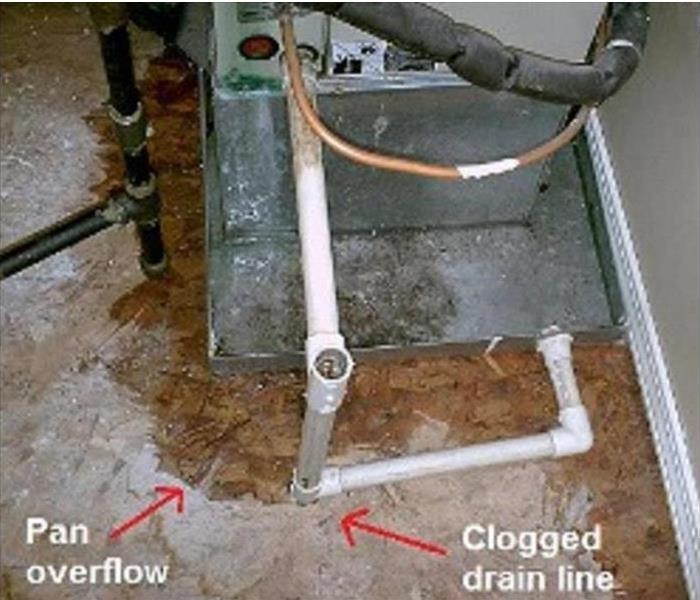 Water damage from an AC pan overflow and a clogged drain line
Water damage from an AC pan overflow and a clogged drain line
First, turn off your AC to prevent serious water damage and hazardous electrical issues. Next, we highly recommend calling a HVAC company for help.
Why water forms in an AC’s indoor unit
Condensation is a natural reaction that occurs inside all AC units.
You see, your AC’s job is to pull heat and humidity from the air inside your home. To do that, your system pulls in warm air through an indoor vent (called a return grille) and moves it across your inside unit’s cold evaporator coil to cool the air down.
When this happens, moisture forms on the evaporator coil. Just like the condensation that forms on a glass of ice cold water on a hot summer day.
Normally, the condensation on the coil drips into a drain pan and down a condensate drain pipe that leads it outside of your home (or into your plumbing system).
Now that you know why the condensation happens and the parts involved, here are a few common problems that can cause water to leak inside your house.
Clogged condensate drain line or rusted pan
If your drain line is clogged–commonly by dirt, algae, insects or a dirty evaporator coil–water drainage is limited; causing a buildup of water with nowhere to go other than your home.
And because it is so hot and humid, your AC runs more often so it doesn’t take long for large amounts of water to build up.
Also, the drain pan may be rusted through, allowing the water to fall through the pan and cause disastrous leaks and dangerous electrical issues inside your home. So, you’ll definitely need to replace the pan.
Improperly installed condensate trap
If your AC is fairly new, the problem could be with the way your system’s condensate trap was installed. An improperly designed condensate trap can block drainage and cause the drain pan to overflow with water.
What to do: You’ll need a professional to know what to look for in a condensate trap design and to see if it needs to be reinstalled.
Frozen evaporator coil
Condensation on your cold evaporator coil can also freeze. If it does, there’s a clear problem with your AC. It can even freeze all the way down the refrigerant lines to the outside unit.
And when it melts, there can be a lot of unwanted water in unwanted places throughout your home.
Common causes of a frozen coil include:
- Dirty air filter
- Low refrigerant
- An airflow problem
Other issues...
There are a number of problems that cause water leakage from your AC but these are a few of the most common. We understand this stuff can get pretty complicated.
Note: Depending on where the inside unit is and what specifically is causing water to leak inside your home, the damage could be pretty significant and extremely dangerous. Many, if not all, of these problems require a professional to ensure safety and proper resolution.
Contact a Certified Water Damage and Mold remediation company, to resolve any Microbial issues,
Indoor Relative Humidity and Moisture Issues Inside Your Cherry Hill Home
9/7/2019 (Permalink)
When indoor humidity levels are too high, condensation on windows and walls starts to cause structural damage. Damage to the house manifests in wood rot, molds, damp spots, and corroding furniture.
Costly damage caused by moisture that builds up can occur between the walls and ceilings, paint may start to peel as well as permanent wood warping/damage.Every time we cook, bathe, shower or breathe, we increase the amount of moisture in the air; when these activities occur indoors, we raise the humidity level inside our home. Humidity is the amount of water vapor in the air; it makes the air feel wet and clammy or smell musty. During a hot summer day, humidity makes the air feel even warmer, since it prevents sweat from evaporating from the skin, undermining the body's way of staying cool.
Relative humidity is the amount of water the air contains compared to the amount it could contain at a specific temperature. When the relative humidity is 100 percent, the air is retaining the most moisture possible at that temperature without precipitation. Most of us feel comfortable inside our home when the relative humidity remains between 30 and 60 percent. When the indoor humidity level is below 30 percent, the air is too dry, which can harm both a home's structural integrity and the homeowners' health. Conversely, when the level is above 60 percent, the air is too wet, which is also harmful to both the home and the homeowners. Excess humidity is a breeding ground for mold, pests and rot in homes and is more likely to cause heatstroke, heat exhaustion, headaches and dehydration than a less humid atmosphere.
To combat a high humidity level inside the home, many homeowners run the air conditioning unit. While air conditioning can reduce the humidity level, the result is high energy bills and a cold and uncomfortable living space. Rather than using air conditioning, homeowners and builders can have a whole-house dedicated dehumidification system installed. This type of system operates using the home's central air distribution system. A dehumidification system can be programmed to maintain specific humidity levels, giving homeowners the ability to customize the comfort level of their home.
Whole-house dehumidification systems can be installed in both new and existing homes. Here are a few points to keep in mind when considering installing dedicated dehumidification systems:
- Choose a dehumidification system that has built-in fan cycling. This feature will keep the humidity and temperature balance steady throughout the home instead of in just one room. It will also minimize hot and cold spots and improve the overall air quality.
- Look for a dehumidification system that has the capacity to remove up to 90 pints of moisture per day from the air. For builders, a high-capacity system will provide for the flexibility of using the system in a wide variety of homes.
Water Damage can be Deceptive
9/6/2019 (Permalink)
Water Damage in Cherry Hill NJ, Water damage can be deceptive, Flood Damage in Cherry Hill NJ,
Water damage can be deceptive. Water penetrates into structural cavities creating trapped pockets of saturation. The detection of water in these areas can often only be discovered with sophisticated moisture detection meters.
Undetected moisture will continue to cause damage. This damage, at a minimum, will cause odors. Greater damage will surface when materials delaminate, shrink, split and further deteriorate to where costly repairs are required.
More than just removing excess water, IICRC-certified restorers have the knowledge and equipment to further dry a home or facility (including substructure materials) completely back to preloss conditions. Through timely response and the careful monitoring of water damage, mold and other health issues can be prevented. If water damage has been present too long, mold will occur.
All IICRC-certified professionals have the training and experience to identify moisture sources, evaluate mold growth (visible or suspected), contain damage, remove contamination and dry materials to ensure that mold will not return.
While there are many methods for drying structural components and contents, the “in-place” drying system has been taught in the industry and used by drying contractors since the early ’80s. In those days, this method of drying components, without significant removal of furnishings or fixtures, was somewhat restricted, due to limitations imposed by extraction, evaporation and dehumidification equipment. In recent years, however, drying technology (extraction, evaporation, dehumidification), along with better understanding of psychometric, has advanced in major ways so that in-place drying has, in some cases, become far more safe and practical.
Sump Pump Failure
9/5/2019 (Permalink)
Sump Pump Failure in Cherry Hill NJ, Flood Damage in Cherry Hill NJ, 7 Causes of Sump Pump Failure and What to Do
The problem is that Sump Pumps fail all the time. While it’s not to say that we have a fool-proof method for preventing 100% of failures, there are certainly some tips you can follow to better your chances of a properly working sump pump.
For years, sump pumps have been a pretty common fixture in homes, especially in lower-level areas of the country or in places where the rapid melting of heavy snow can cause flooded basements. The popularity of sump pumps have grown exponentially in the past couple decades, largely in part to a legal amendment to the US Federal Clean Water Act in 1987 that requires certain homes to have a sump pump, even if they are not necessarily high-risk for floods.
The American Society of Home Inspectors actually did a study that showed more than 60% of American homes suffer from underground wetness or water damage. And there’s a likelihood that an ever large percentage will deal with a flooded basement at some point. Something we often talk about with roofing in terms of moisture also applies here. It doesn’t always take a large amount of water to create a large amount of issues. In roofing, we talk about roof leaks going into the home which aren’t uncommon for a faulty roof after a big rain storm. But just as problematic – or sometimes even worse – are the small leaks that get into the attic and aren’t noticed until well after a huge mold problem has been created. Same goes for moisture in the lower levels of your home. It doesn’t take a huge flood to cause thousands of dollars in damage. It takes very little standing water and very little time for mold and mildew to take over and create problems.
There is no definitive “lifetime” of a sump pump. Most sump pump last between 3 to 20 years. That’s a pretty big window. The US Department of Housing and Development estimates the average life expectancy at 10 years. In my opinion, 10-15 years is pretty reasonable for a pump that goes through regular maintenance.
7 Things that Cause Sump Pump Failure
- Power Failure
The most common cause for sump pump failure is an electrical power outage. To prevent this, have a backup generator that can be manually activated. In the case that your primary pump mechanically fails, though, a generator cannot help in this situation. But in the event of a storm where the power is knocked out for any length of time, a backup generator can be a lifesaver.
On the same topic of power, some components of the sump pump may be vulnerable to damage from power surges. To prevent this, protect the entire electrical system from power surges with a service entrance surge protection device.
- The Sump Pump is the Wrong Size
If you have an incorrectly sized pump, or if the pump is not installed properly, there will most likely be a problem. A small sump pump is often just as effective as a big one. When a sump pump is too big, the pump is forced to work harder, resulting in a shorter product lifespan. But if it’s too small, it may not be able to adequately pump out the water – again resulting in a shorter lifespan.
- Improper Installation
Installing a sump pump must be done exactly right. Manufacturer’s instructions must be followed carefully for the installation in order to avoid severe water damage down the road. Most manufacturers recommend or require a check valve to be installed on the discharge line. If not installed, the back-flow of water can cause the pump impeller to rotate backwards and unscrew off the motor shaft. In this scenario, you will still hear the pump motor running, but it would not be pumping any water.
Most manufacturers require the drilling of a small air relief hole in the discharge line between the pump and the check valve which is intended to prevent the pump from having to overcome the air pressure in the discharge pipe. The discharge pipe must be of the required diameter.
Lastly, the sump pump pit should not be set in dirt or gravel. This causes debris to enter into your pump and can result in interference with the pumps on/off switch or float arm.
- Switch Problems
The leading mechanical cause of sump pump problems is a switch problem. This occurs when the pump shifts from its position inside the basin, rendering the float ineffective. Float is responsible for the smooth operation of the on/off switch. Your sump pump relies on both the switch and the float arm mechanisms to operate effectively.
- Lack of Maintenance
Some pump manufacturers recommend the pump to be run every 2-3 months. Some recommend a yearly program completed just before the rainy season hits.
Here are some additional manufacturer recommendations:
- If there is a back-up pump, unplug the primary pump and run the back-up pump to make sure it works properly
- When testing your sump pump, go outside to make sure it is discharging water
- Sometimes the pump can run but not pump any water. This means the impeller has disengaged from the pump shaft or the check valve is installed backwards.
- Check the operation of the float to make sure it is not restricted
- Clean out the air hole in the discharge line
- Listen for any unusual noises when the motor is running
- Replace the battery on the back-up sump pump every 2 or 3 years
- Frozen or Clogged Discharge Lines
If water cannot exit your home through the discharge line, your system will not work. It is important to keep the discharge pipe protected from freezing and free of sticks, dirt, rocks and other debris. Protecting the water’s exit point of the discharge pipe will keep debris and animals out of the system, making it optimal for your sump pump.
Grated covering will not stop the lines from freezing or becoming blocked by ice and snow. A special grated discharge line attachment should help; it is placed near your home on the discharge line. It includes openings that give water a way to flow out of the pipe if the line is blocked further down.
- Product Defect
Though rare, product defect is always a possibility and does happen. It is wise to test the pump when it is initially installed to make sure the pump operates properly.
Lightning
9/4/2019 (Permalink)
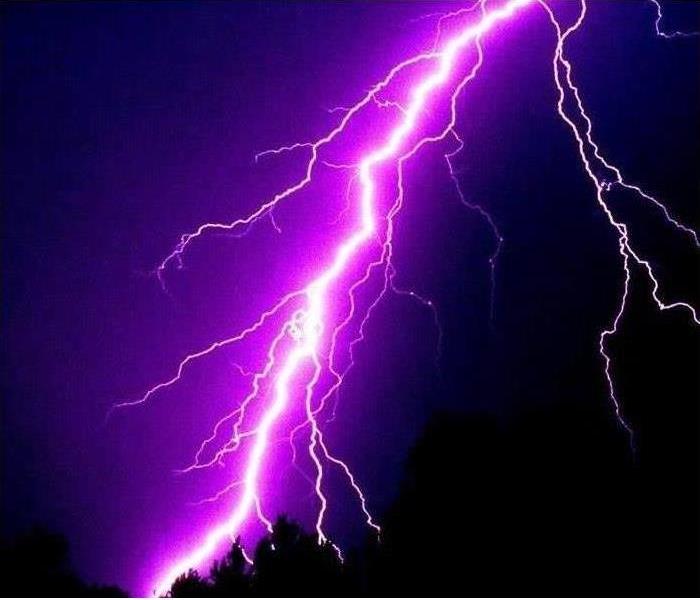 Lightning and it's dangers
Lightning and it's dangers
One of my favorite things about hot summer days is an afternoon thunderstorm to cool things down. It starts with the darkening of the sky as cumulus clouds block out the sun. Then the wind picks up and the air takes on the scent of wet grass. Finally, the skies open up and drop their deluge of rain on the dry earth below.
Thunderstorms are most likely in the spring and summer months and during the afternoon and evening hours, but they can occur year-round and at all hours. Many hazardous weather events are associated with thunderstorms. Under the right conditions, rainfall from thunderstorms causes flash flooding, killing more people each year than hurricanes, tornadoes or lightning. Lightning is responsible for many fires around the world each year, and causes fatalities. Hail up to the size of softballs damages cars and windows, and kills livestock caught out in the open. Strong (up to more than 120 mph) straight-line winds associated with thunderstorms knock down trees, power lines and mobile homes. Tornadoes (with winds up to about 300 mph) can destroy all but the best-built man-made structures. As a child, we were usually permitted to play outside in a thunderstorm until we heard the rumbling sound of thunder. Then, with the threat of lightning close by, we were ushered inside by adults. We used to say that if you count how many seconds there were between the rumble of thunder and the flash of lightning (counting with “Mississippi” of course), you could tell how many miles away the storm was. If there were only a few seconds between thunder and lightning, it was time to get inside. It turns out that our game was partially true. You should count the seconds between the sound and the light and you should count using “One-Mississippi”, “Two-Mississippi”, etc. However, you should take this number and divide it by five. For every 5 seconds counted, the storm is 1 mile away.
What else should we know about lightning?
· Lying flat increases your chance of being affected by potentially deadly ground current. If you are caught outside in a thunderstorm, do NOT lay flat on the ground. Keep moving toward a safe shelter.
· Height, pointy shape, and isolation are the dominant factors controlling where a lightning bolt will strike. The presence of metal makes absolutely no difference on where lightning strikes. Mountains are made of stone but get struck by lightning many times a year. When lightning threatens, take proper protective action by seeking a safe shelter. While metal does not attract lightning, it does conduct it so stay away from metal fences, railings, bleachers, etc.
· Many lightning casualties occur because people do not seek shelter soon enough. If you consider my example above about playing outside, we never should have waited to count the seconds until the lightning flashed. Rather, we should have run for shelter at the first sound of thunder.
· Lightning often strikes the same place repeatedly, especially if it’s a tall, pointy, isolated object. The Empire State Building is hit nearly 100 times a year!
· Most cars are safe from lightning, but it is the metal roof and metal sides that protect you, NOT the rubber tires. Remember, convertibles, motorcycles, bicycles, open-shelled outdoor recreational vehicles and cars with fiberglass shells offer no protection from lightning. When lightning strikes a vehicle, it goes through the metal frame into the ground. Don’t lean on doors during a thunderstorm.
·The human body does not store electricity. It is perfectly safe to touch a lightning victim to give them first aid. This is the most chilling of lightning myths. Imagine if someone died because people were afraid to give CPR!
Commercial Fire Damage, and Restoration, and the Process of Fire Restoration
9/4/2019 (Permalink)
The process of fire restoration can be very involved. Private homeowners and companies can oftentimes be devastated by the damage caused by this kind of event. One aspect that gives peace of mind involves knowing when the right professional has been hired. That is one of the reasons why it is important to hire a firm that is associated with the Institute of Inspection Cleaning and Restoration Certification.
Homeowners and business owners may be in shock from the initial devastation. It is important to try and follow the proper steps to achieve a complete fire restoration. Service providers that are associated with the Institute will have the following distinctions: current training, safety and health certifications, vast amounts of experience in restoration projects and the proper licenses and insurance information. Customers should also check all references and obtain price quotes prior to hiring anyone. Any contracts that are presented should be reviewed closely.
The first step in the process is to clean up as much of the existing area as possible. If the area is not immediately cleaned, soot residue and permanent damage can be left behind. If the homeowner or business owner does the initial cleaning, it is important to follow these steps. When cleaning, always use dust masks and open the area for proper ventilation. Clean from the ceilings to the floors and vacuum all floors and upholstery. Wash any items that are able to be laundered. Clean the outside with a pressure washer if available.
If immediate clean up is not done, it can lead to devastating effects. Within minutes of fire and smoke damage, appliances and many items will discolor to a yellow hue. After a few hours, acid will stain bathrooms and many other areas of the home or business. Within days, walls will discolor permanently and items will begin to rust due to the acid residue. Finally, after weeks the cost of clean-up will become substantially more expensive. The building and furnishings can be permanently damaged by the acid left behind. Soot residue will be layered throughout the home or business. For these reasons, it is vital to contact a professional associated with the Institute of Inspection Cleaning and Restoration Certification to utilize fire restoration techniques in an effort to return the home or business to a preloss state. One company or service provider should be able to handle the damage. The seal of Certification by the Institute should be shown on any provider’s website. This shows the customer the reliability and the expertise of the service provider.
Residue and smoky odors need to be removed immediately. Professionals will use the process of fire restoration to achieve satisfactory results. These providers will remove the source of the odor, clean any items that can be salvaged, get rid of any lingering odor with an odor counteractant and deodorizing fog. Finally, the provider will seal salvageable items to encapsulate odor and prevent further recontamination.
Homeowners and businesses that are educated in the fire restoration process are able to minimize the cost of repair. Professionals can be contacted in a timely manner to return the area to a preloss state. By hiring the right professionals the victims can have some peace of mind during a very stressful time
Hidden Water Damage - Cherry Hill
9/3/2019 (Permalink)
Hidden water damage happens when an unfound leak damages wall, floors, or other things in your home. Water damage that is hidden are usual slower and harder to detect but these steps will help you spot water damage before it becomes a bigger issues but if it does make sure you call your local SERVPRO® to help fix any of your issues.
Check These Places for Hidden Water Damage
One of the most common places for hidden water damage is under the sink. If you are not sure if there is something occurring run the water and if you see a small leak then you are closing to confirming. And never wait because a small leak can become a larger leak and make it even more of a hassle to fix.
Another place to check to make sure you does not have water damages are walls. Walls start to give signs of water damage by discoloration and becoming a soft spot because there are pipes behind walls and the leaking of pipes just like under the sink even the smallest of leaks can cause the biggest of problems.
Water Damage Restoration in Cherry Hill
SERVPRO® will come in and take care of your water damage need in the Cherry Hill/Haddonfield area. Whether it a small leak that causes big water damage or a water damage emergency you can trust you’re professional restoration team for quick and efficient work day or night. Call SERVPRO® of Cherry Hill/Haddonfield.
Creating a Fire Safety Plan
9/3/2019 (Permalink)
SERVPRO® wants to make sure you and your family is covered in case a fire breaks out, by giving helpful tips to use before, during, and after a fire. Because you’re primary focus should be safety first and the first step of making sure you are safe is having a plan.
Before a Fire
- Create and practice a fire escape safety plan; make sure to practice at least twice a year.
- Make sure to check your fire alarms regularly.
- Make sure to create a safe meeting place
- Teach stop, drop, and roll
During a Fire
- Make sure to crawl under the smoke
- Before opening a door, make sure to feel the doorknob with the back of your hands.
- Once you made it out safely make sure to call 9-1-1; do a head count and make sure everyone is there. If not tell the fire department do not try and go back in yourself
After a Fire
- Ask and see if it’s safe to go back inside, make sure you take picture of things for records
- If the building is still standing make sure to call SERVPRO® of Cherry Hill/Haddonfield 856-662-2772
SERVPRO® of Cherry Hill/Haddonfield hopes you and your family never has to deal with a fire but, in the chance you do call the people who will make sure that you and your family are taken care of, we make it “Like it never even happened.”
Be Prepared its Storm Season
9/3/2019 (Permalink)
SERVPRO® of Cherry Hill/Haddonfield wants to make sure that all of our customers are safe. So we are providing safety tips to make sure our customers are safe during a flood/storm. By making sure that they are fully prepared before a flood.
Be Flood/Storm Ready
These tips are to be done before a flood/storm occurs. Making it easier for you to prepare for when a flood actually happens.
- Gather emergency supplies; make sure you have extra cases of water, batteries, flashlights, and snacks that don’t need to be in the fridge just in case your power goes out.
- Know where all the evacuation routes are beforehand in case you are advised to leave your house you are ready to go. Having a duffle bag full of clothes is always a smart route because being over prepared is better than under prepared.
- Watch the news. During this rainy season flash floods are very common. Watch the news, making sure you are on high alert as the storm approaches your area.
After the Flood/Storm
You are not going to be able to prepare for everything that happens, such as water leaking into your basement or even water getting into your home or business. But what you can prepare for is calling SERVPRO® of Cherry Hill/Haddonfield 856-662-2772 to get your house back to the way it was.
We will make it, “Like it never even happened.”
After flood waters subside, document, work with your insurer, and clean up safely!
8/30/2019 (Permalink)
After flood waters subside, document, work with your insurer, and clean up safely!
Whether a flood is caused by ground water, falling water, or home water system malfunction, there are some best practices you’ll need to employ within the first 24 hours after the flood to ensure the safety of your home and family and give you the best outcome possible with your insurance company.
If the flood was serious enough for you to leave your home, be sure you stay safe upon your return. The Federal Emergency Management Agency warns that you should check for any visible structural damage, such as warping, loosened or cracked foundation elements, cracks, and holes before entering the home and contact utility companies if you suspect damage to water, gas, electric, and sewer lines.
In addition, it’s important to have a working flashlight and turn off all water and electrical sources within the home, Even if the power isn’t operational, it’s a good idea to go to your fuse box and turn off the main, plus all of the individual fuse connections. That way, if the power is reactivated, you’re not at risk for mixing standing water and electricity.
Take Pictures: Before you remove any water or make any repairs, fully document the damage for your insurer by taking photos or video. Digital versions are best, says Ramirez, because they can be stored electronically and easily copied. If you start removing water or making repairs before you photograph the damage, you could potentially decrease the extent of your coverage, he says.
Even if the water in your home is clear, it could be contaminated by sewage or household chemicals. Be sure to throw out any food that may have come into contact with flood waters. FEMA recommends boiling water until authorities declare the water supply is safe.
Find Out if You're in a Disaster Area: Once a region has been officially declared a “disaster area” by government authorities, property owners have access to increased resources, including public services to protect and remediate the area. In addition, you may have access to financial assistance. Your insurance company will have additional information on this or you can contact FEMA directly.
Call Your Insurance Company: Since you should notify your insurer soon as possible after the flood, it’s a good idea to keep your insurance company and local agent’s phone number in your always-ready emergency bag. (Note that the NFIP works through private insurance companies, so you contact your insurer just as you would for any other type of claim). In cases where a flood has affected a region or community, your agent may be busy handling his or her own flood issues. In that case, contact the insurance company’s headquarters.
Since groundwater flood damage typically isn’t covered by conventional homeowners insurance policies, you’ll need to work with your insurer to determine the cause of the flood and the extent of your coverage.
Advise your insurance representative of the state of your home and any repairs you intend to do immediately. Be sure to follow the insurance company’s direction about whether or not to wait for an adjuster to inspect the property before making repairs. Document the damage and conversations at every stage of the process.
What can you expect in terms of time to get back to normal? It could be as little as one week if the claim and clean up is minimal to five to six months if you’re working with an insurance adjuster and contractor to complete extensive repairs.
Remove Water: Once you get the OK from your insurer to remove the water, use a sump pump, available from most hardware or home supply stores for $150 to $500, and a wet vac ($40 to $130) Be careful not to injure yourself, especially if you’re carrying buckets of water up and down stairs. Open doors and windows to allow fresh air to circulate so long as that won’t allow in more water.
Mitigate Mold Damage: Mold can develop within 24 to 48 hours of a flood, says Ashley Small of FEMA, so remove wet contents, including carpeting and bedding, as soon as possible. If an item has been wet for less than 48 hours, it may be salvageable. However, you’ll need to decide whether it holds enough monetary or sentimental value to try to do so. And notify your insurance company before removing items to ensure that you’re not affecting coverage. Always photograph the flood-soaked items.
Rugs, for example, may be dried and then cleaned professionally, which could cost $100 to $500 or more, depending on the size and number. Large pieces of furniture that are saturated will likely be difficult to dry effectively, and should often be discarded.
You may also wish to hire a flood restoration service—Look for those with Institute of Inspection, Cleaning, and Restoration Certification.
Secure the Property: As the homeowner, it’s your responsibility to secure the property so that no additional damage occurs. Put boards over broken windows and secure a tarp as protection if the roof has been damaged. Again, take photographs to prove to the insurance company that you have done everything possible to protect your home against further damage.
If the home is habitable, take precautions to keep yourself and your family safe from injury. Use flashlights to move around dark rooms, for example. If the home isn’t habitable, don’t try to stay there. Move to a shelter or alternate location. Consult your insurer to find out what provisions the company will make for temporary housing while your home is being repaired.
Tips to Prevent Water Damage from a Storm
8/28/2019 (Permalink)
The problem is that Sump Pumps fail all the time. While it’s not to say that we have a fool-proof method for preventing 100% of failures, there are certainly some tips you can follow to better your chances of a properly working sump pump.
For years, sump pumps have been a pretty common fixture in homes, especially in lower-level areas of the country or in places where the rapid melting of heavy snow can cause flooded basements. The popularity of sump pumps have grown exponentially in the past couple decades, largely in part to a legal amendment to the US Federal Clean Water Act in 1987 that requires certain homes to have a sump pump, even if they are not necessarily high-risk for floods.
The American Society of Home Inspectors actually did a study that showed more than 60% of American homes suffer from underground wetness or water damage. And there’s a likelihood that an ever large percentage will deal with a flooded basement at some point. Something we often talk about with roofing in terms of moisture also applies here. It doesn’t always take a large amount of water to create a large amount of issues. In roofing, we talk about roof leaks going into the home which aren’t uncommon for a faulty roof after a big rain storm. But just as problematic – or sometimes even worse – are the small leaks that get into the attic and aren’t noticed until well after a huge mold problem has been created. Same goes for moisture in the lower levels of your home. It doesn’t take a huge flood to cause thousands of dollars in damage. It takes very little standing water and very little time for mold and mildew to take over and create problems.
Proper maintenance is the key. Ugh, more maintenance! Here we are telling you to maintenance your roof, now we’re telling you about your sump pump. Really, though, maintenance is a great thing. It’s much cheaper than a huge repair and it drastically increases the life of your equipment.
There is no definitive “lifetime” of a sump pump. Most last anywhere from 3-20 years. That’s a pretty big window. The US Department of Housing and Development estimates the average life expectancy at 10 years. In my opinion, 10-15 years is pretty reasonable for a pump that goes through regular maintenance.
First, let’s talk about how a sump pump works.
The basics are pretty simple. A hole is dug in the lowest part of your basement or crawlspace where a sump pump sits and filters out water. As the pit fills up, the pump turns on and moves the liquid out of the pit through pipes that run away from the foundation of your home into an area where it can drain, such as a municipal storm drain or a dry well. A one-way valve (check valve) keeps water from entering back into the home.
The pump is generally powered with no special wiring; just your main household current. But being near water, or in water (in case of a failure), it’s a good idea to have some type of circuit interrupter to prevent electrocution.
The majority of residential sump pumps will turn on automatically from a pressure sensor or float activator. The pressure sensor activates as water builds up and creates more pressure than air which prompts the pump to turn on. The float activator has a ball that floats on top of the water, moving the arm as the water level rises – similar to the one in your toilet tank.
When the motor activates, the impeller (a fan-like device) will turn. Using centrifugal force, the spinning impeller will force the water towards the sides of the pipe, creating a low-pressure center where water from the pit rushes to while the spinning action pushes it through the pipe.
All of these things work together to keep your home dry. And for the most part, everything tends to go smoothly. But there’s a lot of parts working together and if one thing quits working, or some type of outside force comes in and causes disruption, things can get back quickly.
7 Things that Cause Sump Pump Failure
- Power Failure
The most common cause for sump pump failure is an electrical power outage. To prevent this, have a backup generator that can be manually activated. In the case that your primary pump mechanically fails, though, a generator cannot help in this situation. But in the event of a storm where the power is knocked out for any length of time, a backup generator can be a lifesaver.
On the same topic of power, some components of the sump pump may be vulnerable to damage from power surges. To prevent this, protect the entire electrical system from power surges with a service entrance surge protection device.
- The Sump Pump is the Wrong Size
If you have an incorrectly sized pump, or if the pump is not installed properly, there will most likely be a problem. A small sump pump is often just as effective as a big one. When a sump pump is too big, the pump is forced to work harder, resulting in a shorter product lifespan. But if it’s too small, it may not be able to adequately pump out the water – again resulting in a shorter lifespan.
- Improper Installation
Installing a sump pump must be done exactly right. Manufacturer’s instructions must be followed carefully for the installation in order to avoid severe water damage down the road. Most manufacturers recommend or require a check valve to be installed on the discharge line. If not installed, the back-flow of water can cause the pump impeller to rotate backwards and unscrew off the motor shaft. In this scenario, you will still hear the pump motor running, but it would not be pumping any water.
Most manufacturers require the drilling of a small air relief hole in the discharge line between the pump and the check valve which is intended to prevent the pump from having to overcome the air pressure in the discharge pipe. The discharge pipe must be of the required diameter.
Lastly, the sump pump pit should not be set in dirt or gravel. This causes debris to enter into your pump and can result in interference with the pump’s on/off switch or float arm.
- Switch Problems
The leading mechanical cause of sump pump problems is a switch problem. This occurs when the pump shifts from its position inside the basin, rendering the float ineffective. Float is responsible for the smooth operation of the on/off switch. Your sump pump relies on both the switch and the float arm mechanisms to operate effectively.
- Lack of Maintenance
Some pump manufacturers recommend the pump to be run every 2-3 months. Some recommend a yearly program completed just before the rainy season hits.
Here are some additional manufacturer recommendations:
- If there is a back-up pump, unplug the primary pump and run the back-up pump to make sure it works properly
- When testing your sump pump, go outside to make sure it is discharging water
- Sometimes the pump can run but not pump any water. This means the impeller has disengaged from the pump shaft or the check valve is installed backwards.
- Check the operation of the float to make sure it is not restricted
- Clean out the air hole in the discharge line
- Listen for any unusual noises when the motor is running
- Replace the battery on the back-up sump pump every 2 or 3 years
- Frozen or Clogged Discharge Lines
If water cannot exit your home through the discharge line, your system will not work. It is important to keep the discharge pipe protected from freezing and free of sticks, dirt, rocks and other debris. Protecting the water’s exit point of the discharge pipe will keep debris and animals out of the system, making it optimal for your sump pump.
Grated covering will not stop the lines from freezing or becoming blocked by ice and snow. A special grated discharge line attachment should help; it is placed near your home on the discharge line. It includes openings that give water a way to flow out of the pipe if the line is blocked further down.
- Product Defect
Though rare, product defect is always a possibility and does happen. It is wise to test the pump when it is initially installed to make sure the pump operates properly.
It’s All About the Maintenance
Don’t get me wrong, you cannot avoid all of these problems with maintenance. Let’s be honest – it’s a mechanical piece of equipment and mechanical pieces of equipment fail. It happens. But there’s no doubt that you can avoid many of these issues, and give a longer lifespan to the equipment by performing regular maintenance.
At the very least, follow these maintenance tips once per year. Some experts will even recommend that you do this every 2 months. Quarterly maintenance is probably the norm. It takes just a few minutes and can avoid some serious pains in the future.
- A vinegar solution can be run through the sump pump in order to clean it
- The pump will become free from tiny particles and debris which will allow the pump to run much cleaner
- This can be done by the homeowner and unless there is a serious problem, then you may need to call a professional.
- Make sure the sump pump’s float switch is not restricted in any way. If it is, it will cause the sump pump to not automatically kick on in case of a flood
- Lastly, clean all vents and air holes for maximum effectiveness
That’s it. Maintenance is super easy and keeps your home protected from water damage. Make this a part of your regular home improvement plan and you’ll surely save some money in your pocket by either putting off the purchase of a replacement sump pump for several years, or by avoiding a costly water damage project.
Inspecting Water Removal
8/27/2019 (Permalink)
The water damage restoration process begins with a detailed inspection of your property, including a damage assessment. SERVPRO of Cherry Hill/Haddonfield, NJ is determining the scope of the damage so he or she can develop an appropriate plan of action. Being careful and cautious is also a Priority. Also, Making sure electrical items, Appliances, and Outlets are Not a Hazard.
They Identify and Stop the Water Source
They check for the source of water in your home and business and stop it. The water source must be stopped before the drying process can begin.
- Stop the Source
- Check for Contaminated Water
They Identify the Type of Water
SERVPRO of Cherry Hill/Haddonfield, NJ must identify the category and classification of water to restore your property safely to industry specifications. The type of water contamination will affect the specific restoration processes used to restore your property.
- White / Category 1 Water
- Gray / Category 2 Water
- Black / Category 3 Water
They Survey the Extent of the Water Damage and Inspect the Premises
They inspect and test your home to discover the extent of the damage. Additionally, they will look for safety concerns and explain them to you. If you are aware of any safety issues, such as asbestos or lead, please share them.
- Survey Damage
- Complete Safety Inspection
They Move or Block Furniture
They move furniture and property contents and block items to help prevent rust or furniture stains on wet carpet.
The water extraction step removes the majority of the water from your home or property. By performing a thorough water extraction, SERVPRO of Cherry Hill/Haddonfield, NJ helps reduce the drying time and help to prevent mold and secondary water damage. They use powerful pumps and truck-mounted vacuum units to quickly remove hundreds or thousands of gallons of water from your property.
Move-Out / Pack-Out
If your home requires extensive restoration or cleaning, SERVPRO of Cherry Hill/Haddonfield, NJ can conduct an organized, efficient move-out to protect your belongings from further damage.
Emergency Water Removal
Highly trained technicians will begin the water removal process almost immediately. Depending on the amount of water, they may use powerful submersible pumps in addition to industrial strength, wet/dry vacuums. This step helps to reduce drying time and helps to prevent mold and secondary water damage.
- Remove Excess Water
- Use Submersible Pumps and Industrial Wet/Dry Vacuums
Inspect the Carpet Pad and Carpet
SERVPRO of Cherry Hill/Haddonfield, NJ will inspect the carpet and pad and determine if it should be removed to protect the subfloor.
- Inspect Carpet Pad and Remove If Needed
- Inspect Carpet and Remove If Needed
Water Removal Equipment
- Moisture detectors, hygrometers, and other meters measure the extent of moisture saturation.
- Infrared cameras may be used to find “hidden” water behind walls and ceilings.
- Submersible and gas-powered pumps are used for continuous pumping of high-level water.
- Truck-mounted and portable extraction units perform efficient water removal.
Commercial Water loss in Cherry Hill, NJ
8/27/2019 (Permalink)
When plumbing leaks occur in a multi-story building such as office buildings or hotels, turning off the water supply at the main valve is vital to avoid additional damage. Identify where the broken pipe is located to determine if a water valve is near the source rather than on a lower floor or utility closet. Turning off water valves as quickly as possible prevents primary damage to surfaces in addition to secondary damage from mold and mildew. Business owners can prevent slow leaks in buildings by tracking water bills each month and maintaining safety protocols in boiler and water heater rooms.
Avoid Business Interruption to Prevent Financial Losses
Preventing extensive property damage also helps to avoid business interruption loss along with the possibility of creating liability claims from nearby property owners, tenants or guests. Maintenance personnel in businesses are responsible for turning off the main water valve during normal hours of operation before beginning Mitigation services. However, when leaks happen at unusual times such as during the night or on weekends, tenants, employees and managers do not know what to do.
Important Emergency Water Damage Guidelines
Having Emergency Water Damage guidelines in place at businesses can help to reduce losses. Begin by taking the following steps to assess a property to have procedures in place when water leaks occur.
Step One: Inspect Properties
At least once a month, assess various areas of a building to look for signs of moisture from leaking pipes and fixtures. Check water distribution systems, including bathroom fixtures, kitchen plumbing and drinking fountains, especially devices that are old and degraded. Keep a record of plumbing fixtures that are prone to having frequent failures such as galvanized or steel pipes and connectors. Inspect decorative water fountains, swimming pools and hot tubs at the same time. Understand the particular areas of a property that do not have drainage systems such as parking garages. In a water leak emergency, lower levels of a building without drains require portable or fixed sump pumps.
Step Two: Mitigation Plans
Create and implement a loss mitigation plan for employees to follow when finding a leak in a multi-story building. A basic emergency plan should contain written guidelines that include conducting initial and annual training for staff and tenants concerning procedures to follow after finding a water leak. The plan should also include a map or diagram showing the location of water shutoff valves and exactly how to close the devices. If a building has a sprinkler system for fires, then it is often necessary to turn off these devices to avoid damage from water or chemicals. For confidential or sensitive areas of a building, make a list of the designated employees who can enter the space.
Step Three: Emergency Contact List
Maintain an up-to-date 24-hour emergency contact list with names and telephone numbers for:
- The business maintenance staff
- Plumbers
- Electricians
- Tenants
- Local water company after-hours number
- Water mitigation service vendors such as SERVPRO of Cherry Hill, NJ
- Building agent or broker
Step Four: Additional Plans
When a major water disaster happens in a multi-story business, owners need to know where all records are kept along with essential services and key operating systems. Business owners should always have duplicate records in a safe place off-site in addition to having online records. Understand the procedures for relocation or movement of goods, records or tenants to a safe area. A written plan for evacuation of employees, guests and tenants along with equipment shutdown and closing a facility is essential to save property and people from danger.
Commercial Fire Loss in Cherry Hill, NJ
8/26/2019 (Permalink)
Commercial Fire Damage, and Restoration, and the Process of Fire Restoration, Fire Damage in Cherry Hill, NJ. The process of fire restoration can be very involved. Private homeowners and companies can oftentimes be devastated by the damage caused by this kind of event. One aspect that gives peace of mind involves knowing when the right professional has been hired. That is one of the reasons why it is important to hire a firm that is associated with the Institute of Inspection Cleaning and Restoration Certification (IICRC).
Homeowners and business owners may be in shock from the initial devastation. It is important to try and follow the proper steps to achieve a complete fire restoration. Service providers that are associated with the Institute will have the following distinctions: current training, safety and health certifications, vast amounts of experience in restoration projects and the proper licenses and insurance information. Customers should also check all references and obtain price quotes prior to hiring anyone. Any contracts that are presented should be reviewed closely.
The first step in the process is to clean up as much of the existing area as possible. If the area is not immediately cleaned, soot residue and permanent damage can be left behind. If the homeowner or business owner does the initial cleaning, it is important to follow these steps. When cleaning, always use dust masks and open the area for proper ventilation. Clean from the ceilings to the floors and vacuum all floors and upholstery. Wash any items that are able to be laundered. Clean the outside with a pressure washer if available.
If immediate clean up is not done, it can lead to devastating effects. Within minutes of fire and smoke damage, appliances and many items will discolor to a yellow hue. After a few hours, acid will stain bathrooms and many other areas of the home or business. Within days, walls will discolor permanently and items will begin to rust due to the acid residue. Finally, after weeks the cost of clean-up will become substantially more expensive. The building and furnishings can be permanently damaged by the acid left behind. Soot residue will be layered throughout the home or business. For these reasons, it is vital to contact a professional associated with the Institute of Inspection Cleaning and Restoration Certification to utilize fire restoration techniques in an effort to return the home or business to a preloss state. One company or service provider should be able to handle the damage. The seal of Certification by the Institute should be shown on any provider’s website. This shows the customer the reliability and the expertise of the service provider.
Residue and smoky odors need to be removed immediately. Professionals will use the process of fire restoration to achieve satisfactory results. These providers will remove the source of the odor, clean any items that can be salvaged, get rid of any lingering odor with an odor counteractant and deodorizing fog. Finally, the provider will seal salvageable items to encapsulate odor and prevent further recontamination.
Homeowners and businesses that are educated in the fire restoration process are able to minimize the cost of repair. Professionals can be contacted in a timely manner to return the area to a preloss state. By hiring the right professionals the victims can have some peace of mind during a very stressful time.
Fire Restoration
8/26/2019 (Permalink)
Fire can cause large amounts of damage on your property. However, there are other damages that can seriously affect the building as well. Smoke odor invades building materials and personal belongings of every kind. Smoke soot damages walls that have not been burned by flames. Experiencing a fire can be devastating, and SERVPRO understands that your cherished possessions and memories are at stake. As fire restoration experts, we specialize in soot and smoke damage as well.
If your home is damaged by fire, it is critical to contact a company that specializes in the fire and smoke restoration process as soon as possible to prevent additional damage. Your local SERVPRO is available 24/7 to help minimize the cost of fire and smoke damage to your home.
Our fire restoration process includes:
- 24/7 emergency services – onsite and assisting you within hours
- Prompt damage assessment, pretesting and estimates
- Emergency board-up and structural stabilization
- Environmentally friendly methods for cleaning soot and other residue from fire damage
- Smoke odor removal, sanitation and air purification
- Careful removal and securing of damaged household goods, personal possessions and other contents for cleaning and restoration
- Industrial grade water extractors, dehumidifiers, air movers and other equipment used to efficiently remove water resulting from fire extinguishing efforts
- Reconstruction of the affected areas
- Disinfectants and antimicrobials used to prevent mold and mildew
Why SERVPRO?
We will get your property back to normal faster. Our specialized training, cleaning methods and equipment combined with our experience means quicker clean up and lower smoke damage restoration costs. We can save your personal possessions using specialized equipment and cleaning methods, often being able to restore the contents of your home to their prior condition. We will assist with the insurance claims process to make it as painless as possible for you.
What Causes Hail, and How It Forms
8/26/2019 (Permalink)
Here are some hail facts, according to the National Weather Service:
HOW IT FORMS
Inside thunderstorms are warm updrafts and cold downdrafts. When a water drop is lifted, it can carry to temperatures below 32 degrees, freeze and then fall. As it falls it can thaw as it moves into warmer air, where it can get picked up again by another updraft, returning it to cold air where it refreezes. With each trip above and below freezing, it adds a layer of ice before it ultimately falls to earth as hail.
HAIL SIZES (diameter)
Pea: 1/4 inch
Marble: 1/2 inch
Penny: 3/4 inch
Nickel: 7/8 inch
Quarter: 1 inch (hail at least quarter size is considered severe)
Ping pong ball: 11/2 inch
Golf ball: 13/4 inch
Tennis ball: 21/2 inches
Baseball: 23/4 inches
Grapefruit: 4 inches
Softball: 41/2 inches
BIGGEST EVER
The largest recorded hailstone in the U.S. was nearly as big as a volleyball and fell on July 23, 2010, in Vivian, South Dakota. It was 8 inches in diameter and weighed almost 2 pounds.
DAMAGE DONE
Hail causes about $1 billion damage to crops and property annually. A hailstorm that hit Kansas City on April 10, 2001, was the costliest ever in the U.S., causing about $2 billion damage.
If a strong storm roars through, you may find your siding damaged by hail and shingles that the wind ripped off the roof. Homeowners insurance typically covers wind damage. Coverage also usually includes damage from hail, wind-driven rain or snow that gets inside the home when a roof or wall is damaged due to wind. Most policies also offer some coverage for fallen trees that damage your home, provided the tree broke because of a storm or wind.
Can a Electric Dryer Have a Lint Fire?
8/23/2019 (Permalink)
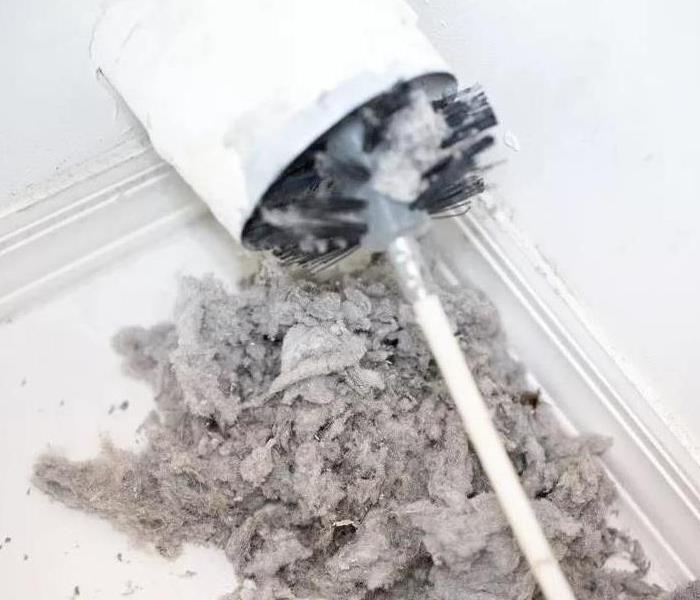 Clothes Dryer Lint Is a Fire Hazard
Clothes Dryer Lint Is a Fire Hazard
A clothes dryer doesn't look scary or dangerous. Unfortunately, it is the cause of more than 20,000 house fires every year totaling millions of dollars in damage. Regular cleaning and maintenance can protect your family and your home investment.
Get Rid of Dangerous Lint in the Dryer
Whether you use an electric or gas clothes dryer, you will have lint. Lint builds up in the lint trap, as well as inside the dryer vent and ductwork, reducing air flow and drying efficiency. Lint can cause humidity levels to rise around vents causing mildew and mold to develop in walls and insulation. But most importantly: Lint is combustible. Lint causes fires.
The first area to clean after every load is the dryer lint trap by removing the lint from the screen and wiping clean the edges. If the screen seems clogged, that is dryer sheet residue. Submerge the lint screen in a sink of hot water and scrub with a soft-bristled brush to remove all the built-up fabric softener.
Use a long-handled flexible brush to help you reach areas that you cannot get to by hand. Remove the dryer lint filter and use the brush in the opening to gently loosen the built-up lint. Don't force the brush if you meet resistance but be sure to clean every surface as much as possible.
Remove the big chunks of lint that come out with the brush. Don't worry about the smaller pieces. Replace the cleaned lint filter. Turn the dryer setting to air only and run for a cycle. This will pull any remaining lint into the filter or blow the loose particles out the outside vent.
How to Clean Dryer Vents
At least once per year, unplug the dryer and check the area where the exhaust vent connects to the dryer. The hose or pipe is held in place by a clip or a steel clamp that can be loosened with pliers or a screwdriver. After removing the pipe, reach inside the dryer opening or use a vent brush to remove as much lint as possible. Use a damp cloth to wipe away remaining lint around the connection. Then look inside the hose or pipe and clean it as well.
If you still have a white or silver vinyl duct hose, it should be replaced immediately. The material is flammable and if lint is ignited by the dryer the hose will burn and cause a house fire. All national and local building codes now require metal ductwork for clothes dryers. Ideally, you should use rigid aluminum tubing pieces between the dryer and the outside vent. This type of tubing resists the collection of lint in the duct and cannot be easily crushed. Flexible aluminum ducting is available; however, it is more prone to collecting lint inside.
One last step is to clean the exterior vent. Again remove as much lint as possible using your hand or a brush. You may need a screwdriver or another tool to hold the vent flap open for easier cleaning. If you live in a high humidity area or use your dryer more than twice weekly, you should clean this vent several times per year.
Reduce Fire Hazards by Installing the Dryer Correctly
A clothes dryer should not vent inside your home or attic. The exhaust contains too much humid air and can cause problems with mold and mildew. A ventless dryer should be used if outside venting is not possible.
The maximum length of a clothes dryer exhaust duct should not exceed 25 feet from the dryer location to the wall or roof termination. The maximum length of the duct should be reduced two and one-half feet for each 45-degree bend, and five feet for each 90-degree bend. The maximum length of the exhaust duct does not include the transition duct.
Be certain that you have a 220v grounded electrical outlet available for an electric dryer. A professional should always be hired to connect or install gas lines for gas dryers.
Dryer Safety
- Clothing that has been soiled by volatile chemicals like gasoline, cleaning agents or even large amounts of cooking oil should not be dried in a clothes dryer. If they must be dried in the machine, wash the clothing more than once to minimize the risk of fire. Use the lowest heat setting and shortest drying cycle possible. Use a cycle with a cool-down period at the end of the cycle to prevent ignition.
- Never leave a dryer running when no one is at home.
- Never store volatile chemicals or rags near a dryer. Some liquids emit vapors than ignite. The area around the dryer should be kept free of lint, papers, and stacks of clothing.
- If you suspect a fire, get everyone outside and call 911. Disconnect the power immediately or turn off the breakers if you can do so safely. Keep a fully-charged fire extinguisher in the laundry room.
Fire in Haddonfield, NJ
8/22/2019 (Permalink)
The process of fire restoration can be very involved. Private homeowners and companies can oftentimes be devastated by the damage caused by this kind of event. One aspect that gives peace of mind involves knowing when the right professional has been hired. That is one of the reasons why it is important to hire a firm that is associated with the Institute of Inspection Cleaning and Restoration Certification.
Homeowners and business owners may be in shock from the initial devastation. It is important to try and follow the proper steps to achieve a complete fire restoration. Service providers that are associated with the Institute will have the following distinctions: current training, safety and health certifications, vast amounts of experience in restoration projects and the proper licenses and insurance information. Customers should also check all references and obtain price quotes prior to hiring anyone. Any contracts that are presented should be reviewed closely.
The first step in the process is to clean up as much of the existing area as possible. If the area is not immediately cleaned, soot residue and permanent damage can be left behind. If the homeowner or business owner does the initial cleaning, it is important to follow these steps. When cleaning, always use dust masks and open the area for proper ventilation. Clean from the ceilings to the floors and vacuum all floors and upholstery. Wash any items that are able to be laundered. Clean the outside with a pressure washer if available.
If immediate clean up is not done, it can lead to devastating effects. Within minutes of fire and smoke damage, appliances and many items will discolor to a yellow hue. After a few hours, acid will stain bathrooms and many other areas of the home or business. Within days, walls will discolor permanently and items will begin to rust due to the acid residue. Finally, after weeks the cost of clean-up will become substantially more expensive. The building and furnishings can be permanently damaged by the acid left behind. Soot residue will be layered throughout the home or business. For these reasons, it is vital to contact a professional associated with the Institute of Inspection Cleaning and Restoration Certification to utilize fire restoration techniques in an effort to return the home or business to a preloss state. One company or service provider should be able to handle the damage. The seal of Certification by the Institute should be shown on any provider’s website. This shows the customer the reliability and the expertise of the service provider.
Residue and smoky odors need to be removed immediately. Professionals will use the process of fire restoration to achieve satisfactory results. These providers will remove the source of the odor, clean any items that can be salvaged, get rid of any lingering odor with an odor counteractant and deodorizing fog. Finally, the provider will seal salvageable items to encapsulate odor and prevent further recontamination.
Homeowners and businesses that are educated in the fire restoration process are able to minimize the cost of repair. Professionals can be contacted in a timely manner to return the area to a preloss state. By hiring the right professionals the victims can have some peace of mind during a very stressful time.
Tips to protect your business from vandalism
8/16/2019 (Permalink)
While most people vandalize public building and structures, private buildings can be targeted as well. While no one plans for someone to vandalize their business it does happen. Vandalism can range from graffiti on walls to destruction of property. SERVPRO of Cherry Hill/Haddonfield wants to give you tips to help try and prevent your business from being targeted for being tagged next.
TIPS:
- Having your business in an area that allows for increased visibility of intruders, plays an important role. Making sure there aren’t many places to hide can create fewer opportunities for vandalism.
- Having physical barriers, such as fences. Can limit the access that someone can have to your building.
- If you store objects outside in your yard area, having a fence around them can also make it harder for vandals to make their way onto your products and/or equipment.
These tips can’t always protect you from being targeted, and in the case that your company is vandalized. Call SERVPRO of Cherry Hill/Haddonfield. We can remove graffiti form most surfaces such as:
We can take care of everything from debris to board-up service to water damage restoration. Make sure if your business is a victim call SERVPRO of Cherry Hill/Haddonfield 856-662-2772, We make it, “Like it never even happened.”
Humidity and water damage
7/18/2019 (Permalink)
Moisture rides on air currents, and warm air carries more moisture than cool air
An air barrier helps control airflow both through and within the building enclosure. By controlling airflow, you also control moisture.
If moist indoor air contacts a cold surface — for example, exterior sheathing in cold weather — condensation can result. An air barrier prevents those cold surfaces from being connected with humid indoor air.
Air has a maximum storage capacity for water vapor which depends on temperature. Warm air can store lots of moisture, while cold air can store very little.
As the temperature falls from 90°F down to 20°F, the amount of moisture that can be stored in the air changes by a factor of ten.
Leaky homes didn’t have condensation problems
Older buildings rarely had condensation problems in cold weather because they were so well ventilated — meaning leaky. The relative humidity in an old home would rarely rise above 25%. As we have built tighter houses (and in some cases failed to provide mechanical ventilation), the indoor relative humidity has gone up.
In a heated, tight, unventilated house, the amount of moisture in the air and the amount of condensation that can occur are dramatically different than in an old leaky house. Condensation can occur wherever water vapor can find a cold spot — on roof or wall sheathing, on the inside faces of the windows, and inside the walls.
Let's say it’s 40°F outside and the outdoor relative humidity is 50%. If you allow that outdoor air to enter a building and heat it up to 70°F, the amount of moisture in the air stays exactly the same, but the “tank” gets bigger because the storage capacity of the air increases with the temperature. As a result, the relative humidity initially drops. Then, as moisture is added to the air, the relative humidity rises, and the absolute moisture content rises as well. How do you add moisture to the air? You breathe, sweat, boil water for spaghetti, take hot showers, grow houseplants — and all of those activities generate moisture.
When does indoor humidity become a problem?
Let’s say that air leaks out of a house through holes in the enclosure. As it reaches surfaces colder than 52°F or 53°F, the air will cool. Once it reaches its full capacity to store moisture, condensation occurs.
If the temperature of the outdoor air is around 30°F, the indoor air will drop all of the moisture that it gained on the way out, dumping it on the cold sheathing surface. That’s a typical example of the air leakage condensation cycle. Since condensation in walls can cause puddles — and in extreme cases, rot the framing — condensation is something you want to avoid. Installing an air barrier is one way to help prevent condensation.
Air conditioning can also create condensing surfaces
The same phenomenon can happen in reverse in the summertime. Let’s say the outdoor air is 85°F and the relative humidity is 75%. When outdoor air leaking inward contacts a surface below about 76°F, the moisture in the air will condense. So if you have an exhaust fan in your home, the air leaking in may cause condensation on the air-conditioned surfaces.
If moist air leaks into a house through gaps in the wall or roof, you can have problems. But in a tight house with a good air barrier and a supply-only ventilation system, most of the air that’s drawn inside is drawn in through the air conditioner, so the first cold surfaces it sees are the cooling coils.
If you find you have signs of moisture in your home or business, call SERVPRO of Cherry Hill/Haddonfield to make sure you don't have puddles forming that could lead to something worse.
Commercial and Residential Fire Loss
7/17/2019 (Permalink)
The process of fire restoration can be very involved. Homeowners and companies can oftentimes be devastated by the damage caused by this kind of event. One aspect that gives peace of mind involves knowing when the right professional has been hired. That is one of the reasons why it is important to hire a firm that is associated with the Institute of Inspection Cleaning and Restoration Certification.
The first step in the process is to clean up as much of the existing area as possible. If the area is not immediately cleaned, soot residue and permanent damage can be left behind. If the homeowner or business owner does the initial cleaning, it is important to follow these steps. When cleaning, always use dust masks and open the area for proper ventilation.
Clean from the ceilings to the floors and vacuum all floors and upholstery. Wash any items that are able to be laundered. Clean the outside with a pressure washer if available.
If immediate clean up is not done, it can lead to devastating effects. Within minutes of fire and smoke damage, appliances and many items will discolor to a yellow hue. After a few hours, acid will stain bathrooms and many other areas of the home or business. Within days, walls will discolor permanently and items will begin to rust due to the acid residue. Finally, after weeks the cost of clean-up will become substantially more expensive.
Residue and smoky odors need to be removed immediately. SERVPRO of Cherry Hill/Haddonfield will use the process of fire restoration to achieve satisfactory results. These providers will remove the source of the odor, clean any items that can be salvaged, get rid of any lingering odor with an odor counteractant and deodorizing fog. Finally, the provider will seal salvageable items to encapsulate odor and prevent further recontamination.
How to Define an Electrical Fire
7/17/2019 (Permalink)
The most inclusive and direct interpretation of “electrical fire” is a fire involving some type of electrical failure or malfunction. Any equipment powered by electricity can have such a failure.
In 2011, an estimated 47,700 home structure fires reported to U.S. fire departments involved some type of electrical failure or malfunction as a factor contributing to ignition. These fires resulted in 418 civilian deaths, 1,570 civilian injuries, and $1.4 billion in direct property damage. In 2007-2011, home electrical fires represented 13% of total home structure fires, 18% of associated civilian deaths, 11% of associated civilian injuries, and 20% of associated direct property damage.
In 2011, an estimated 16,400 non-home structure fires reported to U.S. fire departments involved some type of electrical failure or malfunction as a factor contributing to ignition. These fires resulted in 13 civilian deaths, 243 civilian injuries, and $501 million in direct property damage. In 2007-2011, non-home electrical fires represented 13% of total non-home structure fires, 5% of associated civilian deaths, 13% of associated civilian injuries, and 21% of associated direct property damage.
The national estimates in this report are derived from data reported to the U.S. Fire Administration’s National Fire Incident Reporting System (NFIRS). These statistics include fires reported as “confined fires,” for which detailed reporting is not required. Estimates of detailed characteristics for confined fires require statistical allocation of a large share of unknowns and so involve less confidence.
Half (48%) of 2007-2011 reported non-confined U.S. home structure fires involving electrical failure or malfunction had some type of electrical distribution or lighting equipment as equipment involved in ignition. The leading other types of equipment involved in ignition were fan (6%), washer or dryer (6%), space heater (4%), air conditioning equipment (4%), water heater (3%), and range (3%).
SERVPRO of Cherry Hill/Haddonfield offers numerous services
7/8/2019 (Permalink)
DID YOU KNOW? SERVPRO of Cherry Hill/ Haddonfield provides 24 hour emergency response and additional services to help customers with Fire & Water - Cleanup & restoration and Mold Remediation
Board-ups/Roof Tarping/Property Securing - In some cases it may be important to secure openings to your home or structure using sturdy, durable materials designed to protect it from both weather intrusion and intrusion by outsiders. SERVPRO of Cherry Hill/Haddonfield Professionals may perform the board-up and tarping themselves, or outside subcontractors may be utilized.
Move-Outs - If prolonged exposure to the loss event could cause additional damage to your contents, your contractor requests relocation of the contents, or the safety of your contents is a concern, a move-out may be recommended. In these situations, SERVPRO of Cherry Hill/Haddonfield are trained to properly inventory, move out and control the contents from the structure during the cleaning, restoration and deodorization process.
Reconstruction Services - Once the damaged materials are removed from your home or business other construction may be needed to restore your property to preloss condition. Your local SERVPRO of Cherry Hill/Haddonfield Professional is trained with the proper equipment to replace flooring, carpet, tile, hardwood floors, and doors. We can paint many surfaces, work on ceilings, trim, bathroom/kitchen remodels and home/office renovations.
Inventory - Utilizing Contents Claim Inventory Service technology, SERVPRO of Cherry Hill/Haddonfield can generate comprehensive room-by-room inventories. Contents are categorized as salvageable, non-salvageable and questionable - allowing for easier contents settlement.
Electronics Cleaning and Restoration - Smoke residues can contain acids that corrode metal surfaces when moisture is also present. If the residues are not removed, corrosion can eat away at the metal casing and can ultimately cause electronic failure in the device. SERVPRO of Cherry Hill/Haddonfield can clean the outside casing correctly, as well as refer your equipment to a qualified electronics vendor.
We also provide the following services:
- Temporary Power Rental
- Temporary Fencing
- Storage Services
- Packing Supplies
- Furniture & Fine Art Restoration
For all of your restoration needs, contact the Franchise Professionals at SERVPRO of Cherry Hill/ Haddonfield today! Call 856-662-2772 . We make it, "Like it never even happened."
Are you going on vacation?
7/8/2019 (Permalink)
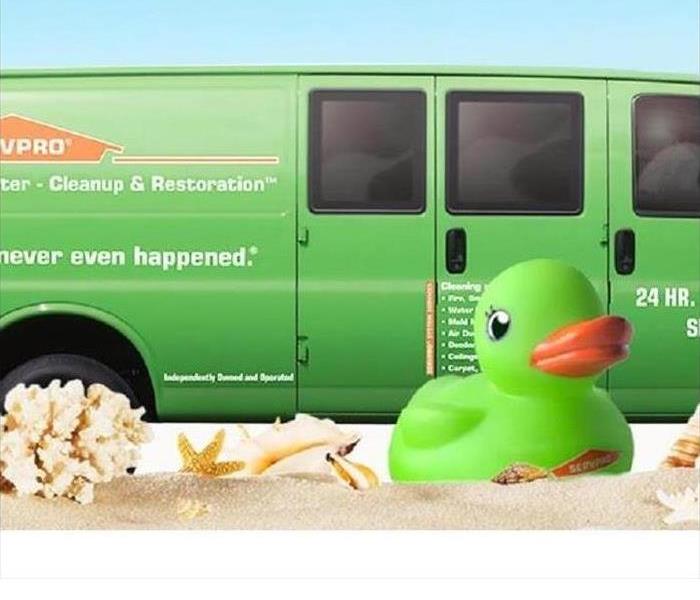 Relax and have a worry free vacation
Relax and have a worry free vacation
Going on vacation should be relaxing and worry-free which is why it is important to make sure your house is secure before you leave for your trip. Be SERVPRO ready so you don’t come back to damages in your home. Here are some tips for preparing your home provided by SERVPRO of Cherry Hill/Haddonfield.
Make Arrangements with an Emergency Contact
- Choose a close friend or neighbor you trust as your emergency contact and provide them with all of your itinerary information in case they need to contact you.
- A timer on lights will give the impression someone is home.
- Leave written directions for alarm codes, doors, or other information needed to properly care for your home.
- Make sure your mail is collected; burglars often look for homes with overflowing mail.
- The Post office can suspend your mail and deliver the day you get back.
Take plumbing and electric precautions
- Prevent leaks and floods from damaging your home by shutting off gas and water at the meter, supply tank or appliances.
- Turn off the water valves to washing machines, sinks, and the dishwasher.
- Unplug electronics to cut down on any possible shortages which could potentially cause a disastrous fire.
- Check your smoke detectors to ensure they are working properly.
- Adjust your thermostat for the season in the winter 55-60 in the summer 75-80 should help control usage.
Right before you leave
- Notify your security company that you are leaving town.
- Take out the kitchen trash and other trash that could get smelly.
- Go on one last walk through of your home to secure windows, blinds, fences, doors, and plugs. This will ensure all entries are safe from hazardous obstructions.
If you come back from vacation and encounter damage within your home, call SERVPRO of Cherry Hill/Haddonfield 856.662.2772.
Mold and it's growth
6/28/2019 (Permalink)
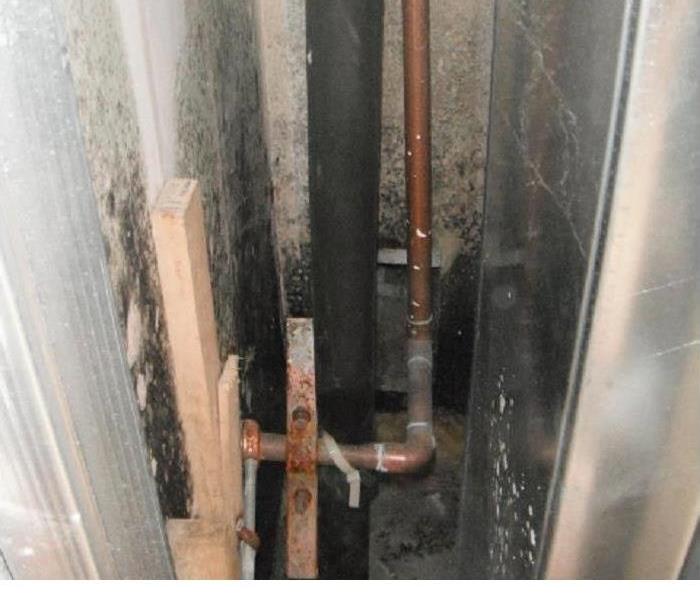 Mold was caused by a leak in the walls
Mold was caused by a leak in the walls
Molds are part of the natural environment. Outdoors, molds play a part in nature by breaking down dead organic matter such as fallen leaves and dead trees, but indoors, mold growth should be avoided. Molds reproduce by means of tiny spores; the spores are invisible to the naked eye and float through outdoor and indoor air. Mold may begin growing indoors when mold spores land on surfaces that are wet. There are many types of mold, and none of them will grow without water or moisture.
The key to mold control is moisture control. If mold is a problem in your home, you should call SERVPRO to clean up the mold promptly and dry the water-damaged areas .
It is important to dry water-damaged areas and items within 24-48 hours to prevent mold growth.
Molds gradually destroy the things they grow on. You can prevent damage to your home and furnishings, save money, and avoid potential health problems by controlling moisture and eliminating mold growth.
Flooding and what to do
6/28/2019 (Permalink)
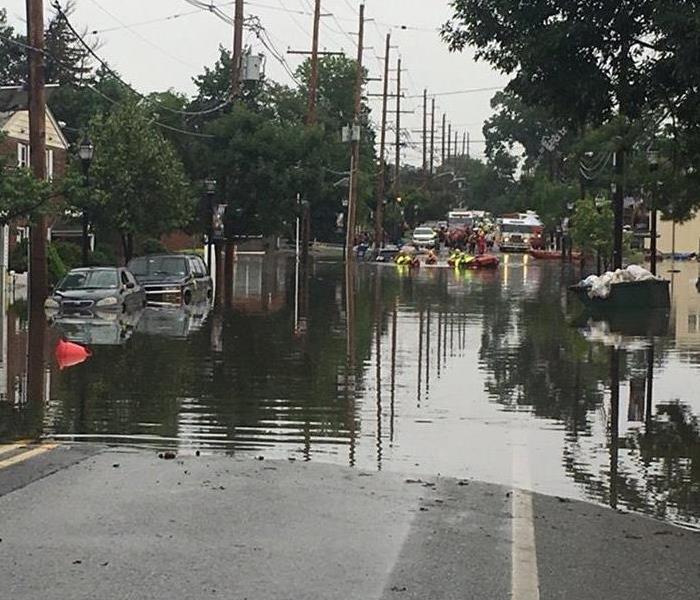 Flood water in a small town
Flood water in a small town
Whether a flood is caused by ground water, falling water, or home water system malfunction, there are some best practices you’ll need to employ within the first 24 hours after the flood to ensure the safety of your home and family and give you the best outcome possible with your insurance company.
If the flood was serious enough for you to leave your home, be sure you stay safe upon your return. The Federal Emergency Management Agency warns that you should check for any visible structural damage, such as warping, loosened or cracked foundation elements, cracks, and holes before entering the home and contact utility companies if you suspect damage to water, gas, electric, and sewer lines.
In addition, it’s important to have a working flashlight and turn off all water and electrical sources within the home, Even if the power isn’t operational, it’s a good idea to go to your fuse box and turn off the main, plus all of the individual fuse connections. That way, if the power is reactivated, you’re not at risk for mixing standing water and electricity.
Take Pictures: Before you remove any water or make any repairs, fully document the damage for your insurer by taking photos or video. If you start removing water or making repairs before you photograph the damage, you could potentially decrease the extent of your coverage.
Even if the water in your home is clear, it could be contaminated by sewage or household chemicals. Be sure to throw out any food that may have come into contact with flood waters. FEMA recommends boiling water until authorities declare the water supply is safe.
Find Out if You're in a Disaster Area: Once a region has been officially declared a “disaster area” by government authorities, property owners have access to increased resources, including public services to protect and remediate the area. In addition, you may have access to financial assistance. Your insurance company will have additional information on this or you can contact FEMA directly.
Since groundwater flood damage typically isn’t covered by conventional homeowners insurance policies, you’ll need to work with your insurer to determine the cause of the flood and the extent of your coverage.
Advise your insurance representative of the state of your home and any repairs you intend to do immediately. Be sure to follow the insurance company’s direction about whether or not to wait for an adjuster to inspect the property before making repairs. Document the damage and conversations at every stage of the process.
What can you expect in terms of time to get back to normal? It could be as little as one week if the claim and clean up is minimal to five to six months if you’re working with an insurance adjuster and contractor to complete extensive repairs.
Mitigate Mold Damage: Mold can develop within 24 to 48 hours of a flood, says Ashley Small of FEMA, so remove wet contents, including carpeting and bedding, as soon as possible. If an item has been wet for less than 48 hours, it may be salvageable. However, you’ll need to decide whether it holds enough monetary or sentimental value to try to do so. And notify your insurance company before removing items to ensure that you’re not affecting coverage. Always photograph the flood-soaked items.
You may also wish to hire SERVPRO to help in the dry out and mold process
Secure the Property: As the homeowner, it’s your responsibility to secure the property so that no additional damage occurs. Put boards over broken windows and secure a tarp as protection if the roof has been damaged. Again, take photographs to prove to the insurance company that you have done everything possible to protect your home against further damage.
If the home is habitable, take precautions to keep yourself and your family safe from injury. Use flashlights to move around dark rooms, for example. If the home isn’t habitable, don’t try to stay there. Move to a shelter or alternate location. Consult your insurer to find out what provisions the company will make for temporary housing while your home is being repaired.
The Process of Fire Restoration
12/3/2018 (Permalink)
Fire Damage in Cherry Hill NJ, Smoke Damage in Haddonfield NJ, and Restoration, and the Process of Fire Restoration,
The process of fire restoration can be very involved. Private homeowners and companies can oftentimes be devastated by the damage caused by this kind of event. One aspect that gives peace of mind involves knowing when the right professional has been hired. That is one of the reasons why it is important to hire a firm that is associated with the Institute of Inspection Cleaning and Restoration Certification.
Homeowners and business owners may be in shock from the initial devastation. It is important to try and follow the proper steps to achieve a complete fire restoration. Service providers that are associated with the Institute will have the following distinctions: current training, safety and health certifications, vast amounts of experience in restoration projects and the proper licenses and insurance information. Customers should also check all references and obtain price quotes prior to hiring anyone. Any contracts that are presented should be reviewed closely.
The first step in the process is to clean up as much of the existing area as possible. If the area is not immediately cleaned, soot residue and permanent damage can be left behind. If the homeowner or business owner does the initial cleaning, it is important to follow these steps. When cleaning, always use dust masks and open the area for proper ventilation. Clean from the ceilings to the floors and vacuum all floors and upholstery. Wash any items that are able to be laundered. Clean the outside with a pressure washer if available.
If immediate clean up is not done, it can lead to devastating effects. Within minutes of fire and smoke damage, appliances and many items will discolor to a yellow hue. After a few hours, acid will stain bathrooms and many other areas of the home or business. Within days, walls will discolor permanently and items will begin to rust due to the acid residue. Finally, after weeks the cost of clean-up will become substantially more expensive. The building and furnishings can be permanently damaged by the acid left behind. Soot residue will be layered throughout the home or business. For these reasons, it is vital to contact a professional associated with the Institute of Inspection Cleaning and Restoration Certification to utilize fire restoration techniques in an effort to return the home or business to a preloss state. One company or service provider should be able to handle the damage. The seal of Certification by the Institute should be shown on any provider’s website. This shows the customer the reliability and the expertise of the service provider.
Residue and smoky odors need to be removed immediately. Professionals will use the process of fire restoration to achieve satisfactory results. These providers will remove the source of the odor, clean any items that can be salvaged, get rid of any lingering odor with an odor counteractant and deodorizing fog. Finally, the provider will seal salvageable items to encapsulate odor and prevent further recontamination.
Homeowners and businesses that are educated in the fire restoration process are able to minimize the cost of repair. Professionals can be contacted in a timely manner to return the area to a preloss state. By hiring the right professionals the victims can have some peace of mind during a very stressful time.
Garage Fire Safety Tips
11/28/2018 (Permalink)
According to the U.S. Fire Administration, residential garage fires tend to spread faster than fires which start in another area of a home. Check out these tips to learn how to prevent tires in your garage:
- Store flammable substances, such as paints, gasoline, oil or varnish outside the garage an home, preferably in a shed.
- Always keep items which can catch fire on high shelves and away from appliances that produce heat.
- Use electrical appliance or tools carefully.
- Install a heat alarm that will sound when it detects dangerously high temperatures.
- Don't fill portable gasoline containers inside.
However, if a fire happens in your garage contact SERVPRO of Cherry Hill/Haddonfield to make your garage look "Like it never even happened."
How to Test Your Smoke Alarms and When to Replace Them
11/17/2018 (Permalink)
Smoke alarms are crucial to preventing fire deaths and injuries during a home fire. However, you need to maintain and test them regularly to ensure they're working properly at any given moment. Here are the steps involved in testing a smoke alarm in your home.
First, make sure everyone in your household test.
Have someone stand in the room farthest way form the alarm you are testing to ensure that the alarm is heard in all rooms of your home.
When everyone is ready, use a sturdy chair or ladder to reach the alarm. Locate the test button, then push and hold it for a few seconds to trigger the alarm.
In addition to testing your alarm manually, you should also check that the sensors are working. Use an aerosol smoke detector tester and spray it towards the alarm; it should go off after a few seconds.
The National Fire Protection Association (NFPA) recommends that you should test your smoke alarms monthly and replace them every 10 years. Batteries should also be replace at least once a year.
Is Water Damage Hiding from you?
9/21/2018 (Permalink)
Signs of Water Damage
No one ever truly understands the power of rain or water and the damage it can do to your home or business. Once water has found its way inside your house, it can travel anywhere, creating hidden problems. So, even after that big puddle recedes, there may be some underlying problems lurking behind the scenes. here with some helpful tips on how to identify water damage, SERVPRO of Cherry Hill/Haddonfield urges you to pay attention,
- Smell the air!
- Spot the stains!
- Peeling pain.
- Sagging spaces and finicky floors.
If you notice any of these signs, call the professionals at SERVPRO of Cherry Hill/Haddonfield to investigate and avoid further damage. SERVPRO is here 24/7 to help you breath a little easier.
Mold Removal vs. Mold Remediation
9/20/2018 (Permalink)
Since microscopic mold spores exist naturally almost everywhere, indoor and outdoor, removing all mold from a home or business is impossible. Many restoration business advertise "mold removal" and even guarantee to remove all the mold. This is a fallacy. We understand that mold and mold growth. SERVPRO of Cherry Hill/Haddonfield has the training and expertise to remediate the mold in your home or business.
Understanding Mold
When water intrudes into your property, mold growth can start in as little as 48 hours.
The Mold Remediation Process
Every mold damage scenario is different and requires a unique solution, but the general mold remediation process stays the same.
- Contact SERVPRO of Cherry Hill/Haddonfield
- Inspection and Mold Damage Assessment
- Mold Containment
- Air Filtration
- Removing Mold and Mold-Infested Materials
- Cleaning Content and Belongings
Sewage Cleanup and Restoration
9/19/2018 (Permalink)
Water from the sewer system backups should be considered very dangerous. This water is grossly unsanitary and may contain bacteria and viruses that could cause serious illness. Special training and equipment is necessary to safely clean this type of contamination.
Three types of contaminated water:
Category 1 "Clean Water"
This is water from a clean water source, such as a broken clean water supply line or faucet. If left untreated, category 1 water can quickly degrade into category 2 or 3 water depending upon such factors as time, temperature, and contact with contaminations.
Category 2 "Gray Water"
This waster has a significant level of contamination that could cause discomfort or illness if ingested. Source for category 2 water may include washing machine overflow; toilet overflow with some urine, but no feces; or dishwasher overflow.
Category 3 "Black Water"
This water is grossly unsanitary and could cause sever illness or death if ingested, and any contact should be avoided. Sources for category 3 water could include flooding from rivers or streams, water from beyond the toilet trap, water from the toilet bowl with feces, or standing water that has begun to support microbial growth.
Contact SERVPRO of Cherry Hill/Haddonfield to make your sewage damage look "Like it never even happened."
Floods - The Most Common Natural Disaster
9/18/2018 (Permalink)
Floods are the most common natural disaster in the United States. Whether you live near a coastline, near a river or eve in the desert, there is a potential for suffering flood damage. Unlike any other natural disaster such as hurricanes that have typical peak season, floods can occur anywhere and anytime.
Therese are some of the flood terms used to identify a flood hazard.
A flood watch indicates that conditions are favorable for flooding to developed. Be prepared to move to higher ground.
A flood warning means that flooding is occurring or will occur soon. If advised to evacuate, do so immediately.
A flash flood warning means that flash flooding is occurring or imminent. Move to higher grounds immediately.
Different Types of Storm Damage
9/15/2018 (Permalink)
There are several types of storm damage including wind, flooding, or even fire. Flooding can cause extensive amounts of damage to your home, and lightning can create fires while high winds can cause many issues to the structure of your home.
Wind
The damage which results from extremely high winds is quite easy to see most of the time. Nowadays, roof shingles are designed better than their predecessors regarding their resistance to wind and the ever-increasing knowledge and standards. There is many times little can be done to prevent damage by wind in conditions that are very extreme. Roofs that are wind-damaged usually appear to be affected only in certain spots. The edges or perimeter of the room are affected by high winds easily, since the edge of a roof is quite prone to lifting.
Hail
Round dings in metal are clear signs of hail damage. Determining whether your roof has suffered damage from a hail storm, however, could be a bit more challenging. After hail hits the roof, it knocks off the protective granules where the hail has hit, and these areas of damage are the sources of leaks in the roof in the future if it is not fixed within a few years’ time.
Snow
Snow causes most of its damage from the weight of it, which immensely increases when ice, rain and sleet are added to it. On an average-sized roof, two feet of snow can weigh the equivalent of thirty-eight thousand pounds or nineteen tons. The obvious sign many times that a roof is about to fail is if it is sagging.
Ice
The functionality of a lot of gutter and roof systems are affected by the temperatures that fluctuate, making the snow melt then refreeze on the edge of the roof. This makes a dam which the water cannot pass through, meaning that as more snow melts off the roof and trickles down, it gets blocked by an ice dam and makes a puddle. Since roofs were not made to handle standing water, especially as the water line and growing puddle move up the roof, the water can seep through small openings in the roof into your home or attic.
Rain and Flood Damage
Water running out of a typical water drainage basin due to overflowing from a storm can wreak havoc on your property. Streams, creeks, rivers or lakes which overflow, flash floods, a storm surge or a tsunami are all examples of flood damage that are possible.
Flooding can cause damage to your property including your foundation and drywall damage. Most of the time the drywall will need to be removed and replaced. The flooding can also cause mold to grow on the property due to standing or hidden water, such as inside the walls. This should be taken care of as soon as possible, usually by a professional storm damage remediation company, as mold can cause a serious health risk to you and your family.
Call an Expert
At the first sign of damage contact a professional storm damage restoration company. They use specialized equipment and technology to tackle any storm damage to your property. They will be able to restore your property back to normal.
Contact SERVPRO of Cherry Hill/Haddonfield to restore your commercial or residential storm damage "Like it never eve happened."
Use Food Coloring to Diagnose a Leaking Toilet
9/13/2018 (Permalink)
If you have a heavy leak in your toilet, it's easy to diagnose - the faint sound of the toilet tank constantly replenishing is a dead give away. What about a slow leak? Diagnose it with food coloring.
If you have a slow leak in your toilet tank, hundreds of gallons are just slowly and silently cascading down the side of your toilet bowl every month. Fortunately you can easily detect if the uptick in you water bill is from a slow leak or not.
A simple test for toilet water leaks, place a half a dozen or so drops of food coloring into the toilet tank. Leave the toilet alone for a half hour or more. Come back and check to see if the water in the bowl of the toilet has become tinted with the food-coloring dye from the tank. If it has, you've got a leak between the tank and the bowl.
How to Prevent Water Damage in Your Attic
9/7/2018 (Permalink)
Water and moisture in your attic can cause you headaches and costly repairs. Mold can grow and compromise your indoor air quality, and water can weaken the structural integrity of your home. To stop water damage in your attic, you need to know what causes moisture in your attic - roof leaks, improper attic ventilation and insulation and appliance failures.
- Look for Roof Leaks in Your Attic
Check the insulation and wood for signs of water damage, such as discoloration and mold growth.
Make sure your attic vents - soffit, ridge, and gable-mounted vents - openings are not blocked by something like insulation.
- Insulate Your Attic
- Vent Appliances to the Outside
- Maintain Attic Appliances
Contact your local SERVPRO of Cherry Hill/Haddonfield for all of your water damage needs.
Do you need flood insurance?
9/7/2018 (Permalink)
The National Flood Insurance Program aims to reduce the impact of flooding on private and public structures. It does so by providing affordable insurance to property owners and by encouraging communities to adopt and enforce floodplain management regulations. These efforts help mitigate the effects of flooding on new and improved structures. Overall, the program reduces the socio-economic impact of disasters by promoting the purchase and retention of general risk insurance, but also of flood insurance, specifically. Signup to receive email updates.
I don't have flood insurance--Why do I need it?
FACT: Floods are the nation’s most common and costly natural disaster and cause millions of dollars in damage every year.
FACT: Homeowners and renters insurance does not typically cover flood damage.
FACT: Floods can happen anywhere--More than 20 percent of flood claims come from properties outside the high risk flood zone.
FACT: Flood insurance can pay regardless of whether or not there is a Presidential Disaster Declaration.
FACT: Most federal disaster assistance comes in the form of low-interest disaster loans from U.S. Small Business Administration (SBA) and you have to pay them back. FEMA offers disaster grants that don't need to be paid back, but this amount is often much less than what is needed to recover. A claim against your flood insurance policy could and often does, provide more funds for recovery than those you could qualify for from FEMA or the SBA--and you don't have to pay it back.
FACT: You may be required to have flood insurance. Congress has mandated federally regulated or insured lenders to require flood insurance on mortgaged properties that are located in areas at high risk of flooding. But even if your property is not in a high risk flood area, your mortgage lender may still require you to have flood insurance.
Flood insurance helps more: Check out your state's flood history with FEMA's interactive data visualization tool. Roll your cursor over each county to see how many flooding events have happened. The tool allows you to compare how much FEMA and the U.S. Small Business Administration have provided in terms of federal disaster aid after Presidential Disaster Declarations to the amount the National Flood Insurance program has paid to its policyholders. It's easy to see that having flood insurance provides a lot more help for recovery.
If you are a renter or homeowner (residential policy); or business owner (non-residential policy) and your property is located in a NFIP-participating community, you can purchase a policy. Contact your insurance agent to find out if your community participates in the National Flood Insurance Program.
Flood insurance from the NFIP is only available in participating communities. Ask your agent if your state and community participate, or look it up online
Did you know? An elevated home, with a first floor elevated 3 feet above the base flood elevation, can expect to save 60 percent or more on annual flood insurance premiums.
Did you know? Elevating just one foot above the Base Flood Elevation often results in a 30% reduction in annual premiums.
Storm Damage Cleanup and Restoration
9/6/2018 (Permalink)
Why Choose a SERVPRO Franchise Professional?
- They're Faster to Any Size Disaster
SERVPRO Franchise Professionals are dedicated to responding immediately to water and storm damage emergency.
- They're Highly Trained Water Damage Specialists
They specialize in water and storm damage restoration, the cornerstone of our business.
- They have the Resources to Handle Storm and Disasters
SERVPRO Franchise Professionals have a national network of over 1,700 Franchises across the country and elite Disaster Recovery Team strategically located throughout the country.
Regardless of the Storm Damage, They Can Help
Storms occurs with little warning and can be especially devastating, so you'll need the company that you can trust to rise to the occasion. Regardless of the type of storm. SERVPRO Franchise Professionals can handle any size disaster. During catastrophic storms and major events, our Disaster Recovery Team can respond quickly with additional resources.
- Flooding caused by heavy rains
- Hurricanes and tidal surges
- Tornadoes and wind damage
- Ice and snowstorms
- Wild fires
Commercial Mold Remediation
8/30/2018 (Permalink)
Mold infestations can be caused by minor water intrusions, like a slow roof leak or loose plumbing fitting. Every hour spent cleaning up is an jour of lost revenue and productivity. If you suspect your property has a mold problem, call a SERVPRO of Cherry Hill/Haddonfield Professional, who will respond quickly and work fast to manage the situation.
- 24 Hour Emergency Service
- Faster to Any Size Disaster
- A Trusted Leader in the Mold and Water Restoration Industry
- Highly Trained Mold and Water Damage Restoration Specialists
Commercial Mold Remediation Presents Unique Challenges
Mold can spread quickly through a property left untreated. SERVPRO of Cherry Hill/Haddonfield Professionals can respond quickly, working to first contain the infestation to help prevent its spread to other parts of the building. Next, they will begin the remediation process, working safely, and effectively to manage the situation. They have the training, experience, and equipment to contain the mold and remediate it to preloss condition.
Have Storm or Flood Damage?
8/29/2018 (Permalink)
Have Water or Flood Damage? Contact SERVPRO of Cherry Hill/Haddonfield today.
We are proud to serve our local communities:
- Cherry Hill, NJ
- Collingswood, NJ
- Jordantown, NJ
- Woodcrest, NJ
- Delair, NJ
- Haddonfield, NJ
- Merchanville, NJ
- Ellisburg, NJ
- Greentree, NJ
- Cherry Hill Mall, NJ
We are water damage restoration specialists and are ready to restore your Cherry Hill home or business back to pre-water conditions. We quickly extract the water and then dry your property using state-of-the-art equipment. SERVPRO of Cherry Hill/Haddonfield uses moisture monitoring equipment to effectively measure and document the drying process to ensure your property is dry.
Move-Outs/Pack-Outs
If your home requires extensive restoration or cleaning, SERVPRO of Cherry Hill/Haddonfield can conduct an organized, efficient move-out of the affected area. When restoration is completed, they will work with you to coordinate the move-in according to your needs.
Water Heater Flood Remediation Services
8/28/2018 (Permalink)
A water heater flood can be one of the most sudden and damaging things that can occur to a home.
It does not take long for floors, walls, and personal belongings to be ruined. Of course, situations like these are the reason that we have flood insurance. The problem can be tough knowing where to begin repairing the damage. That's why you need a good emergency flood restoration on your contact list. If a situation like this comes up, you want to be prepared so that life can get back to normal as fast as possible.
A common problem is water heaters going bad due to temperature changes. Extreme climate changes can weaken the lines that bringing in cold water and sending out hot water.
Contact SERVPRO of Cherry Hill/Haddonfield for to restore your water heater flooded home "Like it never even happened."
Emergency Response Plan
8/25/2018 (Permalink)
Did you know as many as 50% of businesses close down following a disaster, according to the latest research? Of the businesses that survive, the overwhelming majority of them had a preparedness plan in place. Pre-planning can serve as an insurance policy aimed at peace of mind. And knowing you are "Ready for whatever happens" speaks trust to your clients and employees that in the event your business is affected by a disaster, they don’t necessarily have to be.
I just want to introduce myself and let you know what SERVPRO Woodbury/Deptford can do for you and your business. My name is Kathy Attilio and we want to make sure that in the event of a disaster you are ready for whatever happens and ready to move forward in a positive way. That is why we offer our clients a free Emergency Ready Profile. By developing a SERVPRO Emergency READY Profile business interruption can be minimized by having an immediate plan of action. Knowing what to do and what to expect in advance is the key to timely mitigation and can help lowering effects of water and fire damage to your business.
The SERVPRO Emergency READY Profile Advantages:
- A no cost assessment of your facility.
- A concise Profile Document that contains only the critical information needed in the event of an emergency.
- A guide to help you get back into your building following a disaster.
- Establishes SERVPRO Woodbury/Deptford as your disaster mitigation and restoration provider.
- Identification of the line of command for authorizing work to begin.
- Provides facility details such as shut-off valve locations, priority areas and priority contact information.
No one plans for a disaster but you can be “Ready for whatever happens.”
Commercial Fire Damage
8/24/2018 (Permalink)
Commercial Fire Damage Restoration
Fire damage is especially devastating for a business or commercial property. In addition to the fire and smoke damage, significant water damage from firefighting efforts and fire suppression systems may occur. Every hour spent restoring your business back to pre-fire conditions is an hour of lost revenue and productivity. If your business experiences a fire loss, call the fire and water damage restoration experts and we'll respond immediately to get you back to business.
- 24 Hour Emergency Service
- Faster to Any Size Disaster
- A Trusted Leader in the Fire and Water Restoration with over 1,700 Franchises
- Highly Trained Fire and Water Damage Restoration Specialists
SERVPEO of Cherry Hill/Haddonfield's fire damage restoration process:
- Emergency Contact
- Inspection and Fire Damage Assessment
- Immediate Board-Up and Roof Tarp Service (if needed)
- Water Removal and Drying (if water damage is present)
- Removal of Smoke and Soot from All Surfaces
- Cleaning and Repair
- Restoration
Roof Leaks & Homeowner's Insurance
8/23/2018 (Permalink)
Get help in claiming your homeowner's insurance caused by roof leaks.
Many homeowners find out that the damage causing roof leaks is not covered by their homeowner’s insurance. This is often the case unless the roof has been damaged by wind that caused it to leak.
Does Homeowners Insurance Cover Roof Leaks?
What determines whether or not your homeowners insurance covers leaks in your roof, and any resulting damage, is dependent upon what caused the leak. If, for instance, a windstorm, tornado or hail damaged your roof, your homeowners insurance would most likely cover repairs or replacement. But if a maintenance issue like wear and tear is the reason, then you would in most instances be responsible for the costs.
Homeowners need to keep up with their home’s maintenance and day to day repairs. This is especially true when it comes to your home’s first line of defense– the roof. If a tree falls in a brutal storm and careens through your shingles, it’s good to know someone’s got your back to help cover leaks and arising repairs. That’s why it’s important to read over your homeowners policy and seek advice from your insurer so that you know what’s covered by your homeowners insurance.
How to Spot Roof Leaks
Spotting a roof leak early on could prevent more extensive repairs like water damage to your ceiling and mold growth in your insulation. However, finding the roof leak’s point of origin may prove difficult — sometimes even more so than fixing the leak itself. That’s because water will often infiltrate the roof in one location but trickle down to another location, where it starts to dampen the ceiling and walls.
If you find yourself in this position, please call SERVPRO of Cherry Hill/Haddonfield today for help.
Why Choose SERVPRO of Cherry Hill/Haddonfield?
8/22/2018 (Permalink)
We're Faster to Any Disaster
Immediate action is crucial when dealing with water and fire damage. We're dedicated to responding immediately when you need help. A fast response helps lessen the damage, limits secondary damage, and reduces costs.
We're Fire and Water Damage Specialists
As fire and water restoration specialists, we have the training, experience and specialized equipment necessary to restore your home or business. We are committed to providing superior service while restoring your property back to pre-fire conditions.
- Fire & Smoke Restoration Technician
- Odor Control Technician
- Upholstery & Fabric Cleaning Technician
- Water Damage Restoration Technician
Our Restore Vs. Replace Mentality
We focus on restoring versus replacing because restoring the affected areas of your property is substantially less costly than demolishing and replacing those areas.
Water Removal
8/21/2018 (Permalink)
Emergency Water Removal
Highly trained technicians at SERVPRO of Cherry Hill/Haddonfield will begin the water removal process almost immediately. Depending on the amount of water, they may use powerful submersible pumps in addition to industrial strength, wet/dry vacuums.
Inspect the Carpet Pad and Carpet
SERVPRO of Cherry Hill/Haddonfield inspect the carpet and pad and determine if it should be removed to protect the subfloor.
- Inspect carpet pads and remove if needed.
- Inspect carpet and remove if needed.
Water Removal Equipment
- Moisture detectors, hygrometers, and other meters measure the extent of moisture saturation.
- Infrared cameras may be used to find "hidden" water behind walls and ceilings.
- Submersible and gas-powered pumps are used for continuous pumping of high-level water.
- Truck-mounted and portable extraction units perform efficient water removal.
Commercial Water Damage
8/14/2018 (Permalink)
Every water damage event is a little different, and requires a unique solution, but the general process stays the same. You can click on any of the steps below to learn more about that process.
When you call, our representative will guide you through several questions that will help the SERVPRO Franchise Professional respond to your water emergency more quickly and efficiently. This initial contact is an important part of a fast, effective restoration.
They carefully inspect your property’s water damage, determining the type of water damage and the areas affected. This is a crucial step to creating an effective plan of action that will result in a successful restoration.
Typically, hundreds or thousands of gallons of water are removed using our powerful pumps and vacuums during the water removal process. The SERVPRO Franchise Professionals start this process as soon as possible to minimize further damage and to help prevent mold growth.
After the bulk of the water has been removed, SERVPRO Franchise Professionals use specialized equipment to target the water that’s harder to access. They use less intrusive, scientific drying methods to draw the remaining water and moisture from your property with air movers and dehumidifiers.
Water damage also affects your belongings, like furniture, clothing, and personal items. SERVPRO Franchise Professionals can clean restorable items using a number of specialized cleaning techniques. They also sanitize with antimicrobial treatments and remove odors using industrial air scrubbers and fogging equipment.
The last step is restoring your home or business back to its pre-water damage condition. The restoration step can be relatively minor, such as replacing a few drywall panels, or could include major reconstruction, such as rebuilding entire rooms of a home or business.
Cherry Hill/Haddonfield Water Cleanup and Remediation
8/11/2018 (Permalink)
Water damage in Cherry Hill/Haddonfield can occur in all kinds of ways - storm flooding, sewer pipe clogs, leaky water pipes and appliance and blocked drains, toilets and sinks. At SERVPRO of Cherry Hill/Haddonfield we can serve both residential homes and commercial buildings. From basements to attics and all spaces in between, we're here to serve you in your time of need.
At SERVPRO of Cherry Hill/Haddonfield we know emergencies can happen at any time and when they do, it's vital to have water cleanup and repairs preformed as soon as possible. We're available 24/7 for repairs and cleanup to prevent further water damage.
Contact SERVPRO of Cherry Hill/Haddonfield today for more information!
How To Remedy Heat Loss In Your Commercial Building
8/6/2018 (Permalink)
Sources of Heat Loss
- Heat transmission through walls, floors and ceilings
- Air leaks and heat loss through openings, cracks, holes and gaps
- Air and heat loss via exhaust fans, chimneys, and flues
Some of the more effective techniques of solving heat loss problems include:
- Having an energy audit performed
- Sealing the building envelope
- Insulating appropriately
- Taking care of the ductwork
- Installing door closers
If your HVAC has been operating for some time without attention, it could be the cause of your heat loss. SERVPRO of Cherry Hill/Haddonfield can inspect your heating, ventilation and air conditioning unit (HVAC). Keeping them clean can extend the life o the equipment. This can save you money and provide peace of mind on the health of your system.
For more information on duct cleaning contact your local SERVPRO of Cherry Hill/Haddonfield today.
Grease Fires
8/6/2018 (Permalink)
Grease fires happen when collections of oil or grease on a stove, oven or fryer get hot enough to ignite. It's easy to lose track of a pot of oil on the stove until it ignites.
Grease fires are extremely dangerous because the fuel source (the grease) is a liquid, and easily splashes If you try to spray water on it. Grease fires burn very hot and can quickly spread to cabinets or other flammable areas of the kitchen.
The most important thing you can do to prevent a fire in the kitchen is to stay put. The NFPA reports that unattended cooking is the leading cause of home cooking fires.
If your faced with grease fire aftermath contact SERVPRO of Cherry Hill/Haddonfield to restore your home "Like it never even happened."
Water Damage
8/6/2018 (Permalink)
Water damage is the No. 1 culprit that weakens your home's foundation, the very core that holds your house together.
Water damage hits at the core strength of your house, eventually causing serious structural damage. Damp woods invites termites and carpenter ants; plus, it causes mold and mildew.
Here's how to prevent water damage using three easy strategies that will give your peace of mind the next time heavy storms hit.
- Ensure Good Drainage
- Test Your Sump Pump
- Check your sump pump once a year.
- Fix Water Leaks
- Repair any noticeable dripping pipes.
- Check for dark spots under pipes & on ceilings.
Contact your local SERVPRO of Cherry Hill/Haddonfield to restore your water damaged home "Like it never even happened."
We're Here For You
8/2/2018 (Permalink)
The appearance of your commercial property speaks volumes to your clients. So when the need arises for emergency or commercial restoration services, you want trained and trustworthy professionals managing your loss. SERVPRO of Cherry Hill/Haddonfield can have your property restored quickly and professionally.
Minimizing your company's loss in sales, inventory, property damage, customer base, competitive position and even reputation is critical after a disaster occurs. By partnering with SERVPRO of Cherry Hill/Haddonfield, you can be confident that your operational concerns are top of mind with our team of commercial restoration service specilists.
SERVPRO of Cherry Hill/Haddonfield is dedicated to making your business"Like it never even happened." We will respond quickly to contain the damage and begin the restoration process.
With a commitment to customer satisfaction, our members will provide you with the expert advice you need to make informed decisions.
Being Proactive After A Fire
8/2/2018 (Permalink)
No matter the time of year the threat of fire is always near. A fire can break out at any time. It's important to be proactive and protect your family and home from a fire disaster. Remember to always contact a professional fire damage restoration team like SERVPRO of Cherry Hill/Haddonfield before you enter a home after a fire.
Everyone knows about the most common fire starters, but here are a few of the unexpected fire starters; laptops, heat pads & electric blankets, charcoal briquettes, the monster in the closet and dust bunnies.
It only takes a few minutes to check the closets and other unexpected fire hazards in your home.
If a fire strikes your home contact SERVPRO of Cherry Hill/Haddonfield and we'll make your home "Like it never even happened."
Frequently Asked Questions About Mold
8/2/2018 (Permalink)
Mold removal, also known as mold remediation, can be a complicated and confusing process for many people. You're already stressed that mold was found in your home or business and you just want it out, but the proper way to remove it may not be what you'd expected.
- What Does Mold Look Like?
- Mold has many different appearances from varying textures, colors, and sizes.
- What Causes Mold?
- Mold can be caused by many different things, but in most cases a warm, damp area with poor ventilation and some type of nutrient will cause mold.
- Can I Remove the Mold in My Home Myself?
- You Shouldn't remove mold yourself unless you can throughout the contaminants without any danger to health. Mold is difficult and tricky, and in some cases, you can actually make it worse.
Contact SERVPRO of Cherry Hill/Haddonfield for all of your mold needs!
Steps to Take Immediately After Storm Damage Occurs
8/2/2018 (Permalink)
Steps to Take Immediately After a Storm Damage
Storm damage can occur at any time and can cause an immense amount of harm to your home. Heavy rains can cause flooding and powerful winds can cause roof damage and downed trees on your property. Having a strategy to deal with damage will help you to be ready to take steps immediately after the storm.
- Keep Yourself and Your Family Safe
- Take Pictures of All Damage
- Call Your Insurance Company
- Look into Federal Disaster Assistance
- Review the Damage and Prepare for Repairs
- Remove Debris when It's Safe
- Contact a Reputable Contractor to Help Restore Your Life
SERVPRO of Cherry Hill/Haddonfield is here 24/7 to help with your storm damage needs and make your home or business "Like it never even happened."
Flood Damage
8/1/2018 (Permalink)
Putting the Pieces Back Together after a Flood
Of all the possible disasters that can damage a home, floods are the least predictable in terms of the damage that they may cause. Some homeowners are able to salvage their homes even if they have to dispose of some furniture, appliances, and items such as carpeting and curtains. Other homeowners find themselves faced with tens and even hundreds of thousands of dollars in repairs. Even then, mold may still develop behind wall and in other places where water damage cannot easily be seen.
Is your home now structurally compromised or taken by mold?
Contact SERVPRO of Cherry Hill/Haddonfield to put your pieces back together after a flood "Like it never even happened."
Commercial Water Damager Restoration
7/30/2018 (Permalink)
Water damage can strike your commercial property at any time. Water damage can sideline your business, regardless if the damage occurs from a major storm event or a broken water line. Every hour spent cleaning up is an hour of lost revenue and productivity. So when you have an emergency water event, SERVPRO Franchise Professionals offer fast, 24 hour emergency services, 365 days per year.
Call SERVPRO of Cherry Hill / Haddonfield for your commercial water damage needs. We'd be more than happy to make you commercial property "Like it never even happened."
Storm Damage
7/30/2018 (Permalink)
Storm and water damage affects not only the structure of you house, but also your belongings. SERVPRO of Cherry Hill / Haddonfield understands that your home is more than a structure; your family's furniture, clothing, keepsakes, and other belongings help transform a house into a home. SERVPRO of Cherry Hill / Haddonfield will make your storm damage "Like it never even happened."
Why is Your Skylight Leaking?
7/13/2018 (Permalink)
Why is Your Skylight Leaking?
Skylights leak for a variety of reasons. Due to the dangers of working in elevated areas, only an experienced contractor should inspect or repair your skylight. Before you talk to a professional, try to determine when and where the leak occurs. Pay attention to when and where the skylight seems to be leaking. A constant drip should be investigated by a professional as soon as possible. For a seemingly intermittent leak, try to determine what is causing water to infiltrate. Does the leak seem to worsen after a rainfall? Is it better at certain times of the year? Or, is the problem steadily growing worse? The different causes of leaks can lead to very different recommended repairs. Here are some of the most common factors contributing to skylight leaks.
- Roof Issues
- Improper Sealing
- Cracked Skylight
- Indoor Condensation
Mold and Your Health
7/9/2018 (Permalink)
Exposure to damp and moldy environments may cause a variety of health effects, or none at all. Areas that are likely to have mold, such as compost piles, cut grass, and wooded areas.
Molds are part of the natural environment. Outdoors, molds play a part in nature by breaking down dead organic matter such as fallen leaves and dead trees, but indoors, mold growth should be avoided. Molds reproduce by means of tiny spores; the spores are invisible to the naked eye and float through outdoor and indoor air. Mold may begin growing indoors when mold spores land on surfaces that are wet. There are many types of mold, and none of them will grow without water or moisture.
The key to mold control is moisture control. If mold is a problem in your home, you should clean up the mold promptly and ix the water problem.
It is important to dry water-damaged areas and items within 24-48 hours to prevent mold growth.
Molds gradually destroy the things they grow on. You can prevent damage to your home and furnishings, save money, and avoid potential health problems by controlling moisture and eliminating mold growth.
Mold Prevention Tips
6/14/2018 (Permalink)
The most common places for mold growth in your home are basements, bathrooms/showers, attics and craw spaces. You can help prevent your home form becoming an environment for mold growth. Here's how:
- Moisture control is KEY. Keep areas clean and dry. Dry wet or dam areas within 48 hours.
- Watch for condensation and wet spots. Fix the source of moisture problem as soon as possible.
- Maintain low indoor humidity, below 60 percent relative humidity.
- Keep heating, ventilation, and air conditioning drip pans clean, flowing properly, and unobstructed.
- Vent moisture generating appliances, such as dryers, to the outside where possible.
If you are not experienced with home/building repairs you may want to consider a professional mold specialist when making repairs.
If Mold damage, threatens your home or office contact SERVPRO of Cherry Hill/Haddonfield. We are here to help and care for not only your home or office, but for you as an individual.
DIY Mold Removal
6/14/2018 (Permalink)
DIY Mold Removal:
Suit up for safety: Protect yourself from the mold you're removing by wearing rubber gloves, a long sleeve shirt and paints while cleaning. Also, use a mask or respirator to avoid inhaling spores into your lings.
Dehumidify
Inspect Plumbing: All leaky faucets, pipes and other plumbing items need to be repaired. This keeps moisture out of your house and avoids mold from water damage.
Assess Mold On Wood
Disinfect Problem Areas: Once you've remove the mold you can see, disinfect the area with something like a mixture of bleach and water that has 1/4 cup bleach per gallon of water. Apply the mixture to the problem are and let it set for 15 minutes. Rinse off the solution and let it dry.
Keep Your House Dry
However, SERVPRO professionals are near by if you'd rather to leave your home or office mold damage to them, contact SERVPRO of Cherry Hill/Haddonfield. We are here to help and care for not only your home or office, but for you as an individual.
Mold in your Cherry Hill Home
6/13/2018 (Permalink)
SERVPRO understands the stress when you have a water damage in your business or home. That is why we are available 24/7 to help. Our team is fast and quick to any job at any size.
Our certified technicians will mitigate the damage to prevent mold, mildew or bacteria. Using EPA disinfectants, we will make your business or home safe to reenter and occupy. We make sure our team is trained and up to date with all of their credentials.
SERVPRO has been trusted by local business's and insurance companies to assist with their water damage projects. We are there when your family needs help the most. Any type of damage in your home can be a devastating time and can cause a lot of stress in the household. Working with true professionals can definitely help the process and get your home back to normal as quickly as possible.
SERVPRO of Cherry Hill/Haddonfield Satisfied Storm Damage Customers
6/13/2018 (Permalink)
We strive every day to ensure that our quality of work is up to the highest standards and we are always happy to get positive feedback from our customers.
Here are some recent quotes from real customers:
"These guys were awesome, way above expectations during a natural disaster. A+. We were done in about six hours with major damage." - Eric D.
"The gentlemen were extremely polity and helpful during a difficult situation." - Cynthia H.
"Excellent team." - Ward M.
If Storm damage threatens your home or office contact SERVPRO of Cherry Hill/Haddonfield. We are here to help and care for not only your home or office, but for you as an individual.
SERVPRO of Cherry Hill/Haddonfield Satisfied Mold Damage Customers
6/13/2018 (Permalink)
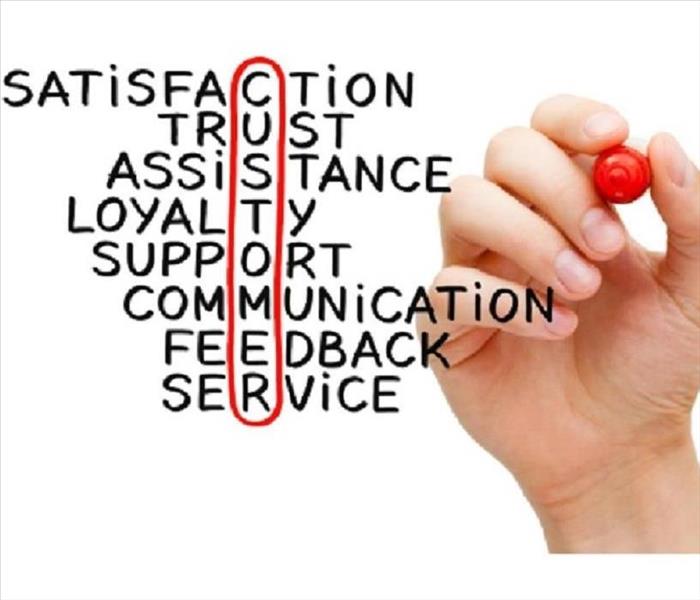 SERVPRO of Cherry Hill/ Haddonfield Strives for Customer Satisfaction on All Jobs
SERVPRO of Cherry Hill/ Haddonfield Strives for Customer Satisfaction on All Jobs
We strive every day to ensure that our quality of work is up to the highest standards and we are always happy to get positive feedback from our customers.
Here are some recent quotes from real customers:
"The team rendered excellent customer service and I would recommend their service to others." - Kevin F.
"In spite of the mold work the crew was doing on the hot temperatures of my house they always had a smile and were very consistent." - Rochelle
If mold damage threatens your home or office contact SERVPRO of Cherry Hill/Haddonfield. We are here to help and care for not only your home or office, but for you as an individual.
Happy Customer
6/13/2018 (Permalink)
We love sharing letter and testimonials from our satisfied customers. Here is one we received from an individual who suffered storm damage.
"Keep screening to get good personal like the team that worked our problem. The team has done an excellent job and communicated very effectively to help us understand the process and timing of tear out and cleanup. Really happy with the job done and appreciate SERVPRO very much. Will recommend to anyone who has similar flooding or clean up requirements."
Thank you Eric P. We appreciate such a wonderful testimonial and we are extremely happy to have great customers such as yourself.
Barbecue Safety Tips
6/13/2018 (Permalink)
It happens every year. The weather gets warmer, more people use outdoor grill - and incidents of grill-caused fires go up. Here are BBQ safety tips that will keep you and your home safe for your summer 2018 barbecuing season:
1. Grill outside and away from any structures.
2. Make sure your gill is stable.
3. Keep your grill clean.
4. Check for propane leaks on your gas grill.
5. If the flame goes out, wait to relight it.
6. Take care around the grill.
7. Be careful with charcoal starter fluid.
8. Wear the right clothing.
9. be ready to put out the fire.
However, if you find yourself facing fire damage from your recent barbecuing session contact SERVPRO of Cherry Hill/Haddonfield. Our franchise professionals have the training and experience to make your fire damage "Like it never even happened."
SERVPRO of Cherry Hill/Haddonfield Satisfied Commercial Damage Customers
6/13/2018 (Permalink)
 SERVPRO of Cherry Hill/Haddonfield Strives for Customer Satisfaction on All Jobs
SERVPRO of Cherry Hill/Haddonfield Strives for Customer Satisfaction on All Jobs
We strive every day to ensure that our quality of work is up to the highest standards and we are always happy to get positive feedback from our customers.
Here are some recent quotes from real customers:
"They were very helpful in guiding me through this process." - Bob F.
"Thank you!!!" Bob T.
"I was able to keep my business open during the whole process - which was so helpful." - Sydney
"They explained the whole process in detail!!" - Anthony S.
If Commercial damage threatens your office call SERVPRO of Cherry Hill/Haddonfield. We are here to care not only for your office, but for you as an individual.
Cherry Hill/Haddonfield 24 Hour Emergency Water Damage Service
6/13/2018 (Permalink)
SERVPRO of Cherry Hill/Haddonfield is available 24 hours a day for water emergencies, large or small. When you are dealing with water damage, immediate action is crucial. A delay of just a few hours can greatly increase the severity of the water damage.
We answer the phones ready to help. We understand that when you call us, you may be feeling confused, stressed, and vulnerable. You need an expert to guide you through this crisis. SERVPRO of Cherry Hill/Haddonfield has the specific water damage training and experience to help you through this tough time. We specialize in water damage restoration - in fact, it's the cornerstone of our business.
When you call, we will ask several questions regarding your water damage emergency. These questions will help us determine what equipment and resources to bring, including how many trained SERVPRO Professionals may be needed.
Our SERVPRO Representatives will ask several questions:
- Your name and contact information
- Your insurance information (if applicable)
- The street address of the water-damaged home or business
- When did the flooding or water damage occur?
- What caused the water damage (if known)?
Got Mold? SERVPRO of Cherry Hill/Haddonfield is Here to Help!
6/6/2018 (Permalink)
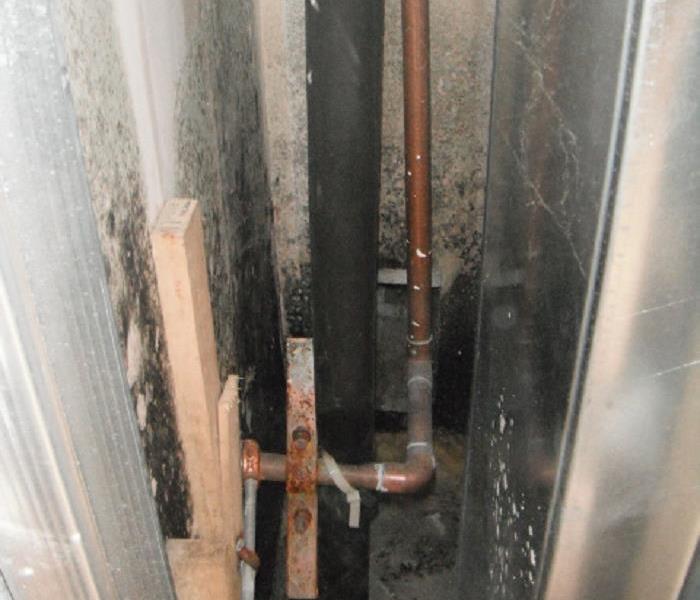 Mold was caused by a leak in the walls.
Mold was caused by a leak in the walls.
Business found mold due to a leak in their walls. SERVPRO of Cherry Hill/Haddonfield was able to help.They restored the business "Like it never even happened."
Commercial Water Loss in Cherryhill/Haddonfield NJ
5/16/2018 (Permalink)
SERVPRO of Cherry Hill was called to clean up after this sewer loss. This Business chose SERVPRO because they knew we would make it "Like it never even happened."
Apartment fire in Cherry hill/Haddonfield NJ
5/15/2018 (Permalink)
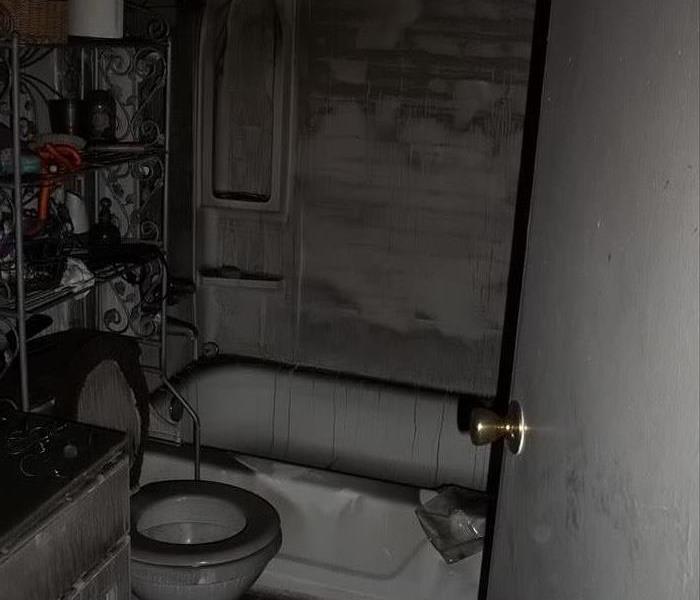 Apartment fire in Cherry hill/Haddonfield NJ
Apartment fire in Cherry hill/Haddonfield NJ
Many renter's don't realize that the fire may not happen in your apartment, but that doesn't mean you won't be affected by it.
Whether you had the fire, or not
SERVPRO of Cherry Hill/Haddonfield is here to help and make it "Like it never even happened."
Plugging a space heater into a power strip can be disastrous here's why
12/1/2017 (Permalink)
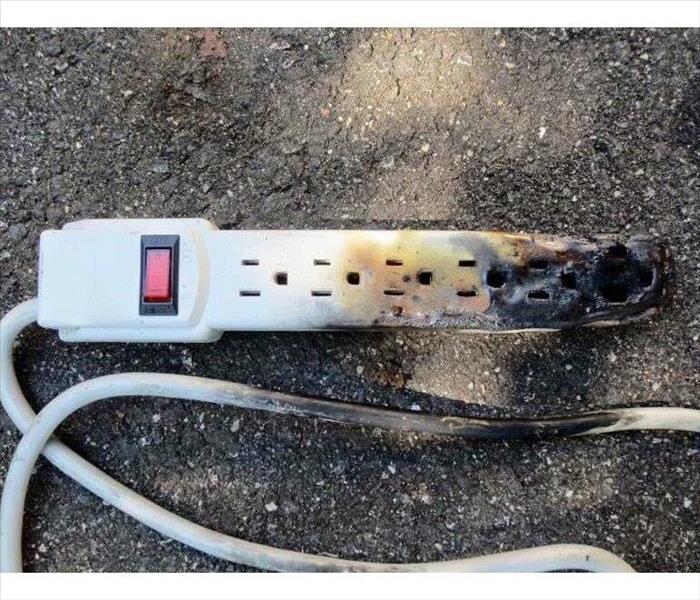 Plugging a space heater into a power strip can be disastrous here's why
Plugging a space heater into a power strip can be disastrous here's why
As temperatures begin to dip across the country, millions of people are pulling space heaters out of storage to help warm their homes.
You should never plug a heater into a power strip.
These units are not designed to handle the high current flow needed for a space heater and can overheat or even catch fire due to the added energy flow.
Most people do not realize that power strips are not the same thing as surge protectors.
You should definitely not use an extension cord or power strip, which could easily overheat. And you really shouldn't plug any other electrical devices into the same outlet as the heater for safety reasons.
The U.S. Consumer Product Safety Commission warns against using extension cords or power strips with space heaters to reduce fire risks. The agency says that portable electric heaters cause 1,100 fires per year, resulting in about 50 deaths, dozens of injuries and millions of dollars in property loss.
According to the National Fire Protection Association, 32 percent of home-heating fires involve space heaters, resulting in 79 percent of home-heating fire deaths in the United States.
Fire And Water Damage Restoration Companies, Have Standards
11/30/2017 (Permalink)
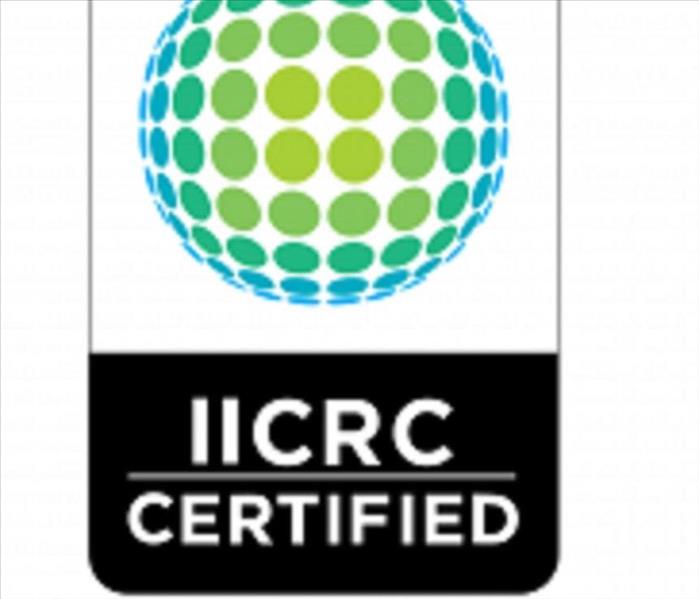 Fire And Water Damage Restoration Companies, Have Standards
Fire And Water Damage Restoration Companies, Have Standards
Fire and water damage restoration are essential services that protect families and their homes from severe issues. Whether it’s bad wiring, a flood, or a burst pipe, these professionals are capable of making the home safe to live in again. But getting it back to that state takes some real expertise and manpower, and it’s the kind of expertise that a certified firm can provide the best. There are serious health implications involved as well, so a homeowner wouldn’t want anyone else handling the job.
Why should a homeowner only consider a certified firm for fire and water damage restoration?
Floods and flames produce an immediate threat, and of course families are going to be pressed by the imminent danger, but these disasters can cause long-term problems as well. Pools of contaminated water, like those left behind by a storm or sewage backflow, are infested with a variety of pathogens and are also catalysts for explosive microbial growth. Molds, in particular, are common organisms found in the wake of contaminated moisture, and can take root in the home in as little as 48 hours if the problem is not dealt with by then. Mold is a significant concern, especially for families with young children, as it can cause lingering respiratory and behavioral complications. Mold can also spread quickly if it is given the chance to release airborne spores.
Flames leave behind a different kind of pest. Ash is a copious byproduct of burned out material, and it is both light and acidic. This means it can easily be swept up by air currents in the home and settle on a variety of items it can damage. If it is not cleaned up right away, it will begin etching glass, corroding metal, and discoloring drywall and porcelain. Ash can also irritate the throat, nose and lungs, inflaming conditions like asthma and allergies. This will happen over a matter of days, so a prompt response is required to stop it in its tracks.
Fire and water damage restoration firms are qualified to halt and reverse the spread of molds, ash, and other hazards. Given the time-sensitive nature of their work, reputable crews are normally available around the clock and can begin work immediately. A certified firm, one that has been trained by an organization like the Institute of Inspection, Cleaning and Restoration Certification (IICRC), will have the tools and methods needed to make the home safe to live in again. With proper training, professionals will be able to quickly establish a workspace inside the home, drain the excess water, and eliminate debris caused by the disaster. Over the next several days, they can set up equipment to expedite the drying process, saving any materials they can that have been exposed to water, or wash away ash residue, which has a tendency to get everywhere. These professionals can also inspect the building thoroughly for common trouble areas and confirm that there is no lingering moisture or ash hiding in wait.
By the time a certified firm has completed their work, the building will be transformed back to its original state, waiting for the family to settle back in and continue their lives.
Energy Saving Tips for Winter
11/28/2017 (Permalink)
 Energy Saving Tips for Winter
Energy Saving Tips for Winter
The strategies below will help you save energy, save money, and stay comfortable during the cold winter months. Some of the tips below are free and can be used on a daily basis to increase your savings; others are simple and inexpensive actions you can take to ensure maximum savings through the winter.
If you haven't already, conduct an energy audit to find out where you can save the most, and consider making a larger investment for long-term energy savings.
Take Advantage of Heat from the Sun
- Open curtains on your south-facing windows during the day to allow sunlight to naturally heat your home, and close them at night to reduce the chill you may feel from cold windows.
Cover Drafty Windows
- Use a heavy-duty, clear plastic sheet on a frame or tape clear plastic film to the inside of your window frames during the cold winter months. Make sure the plastic is sealed tightly to the frame to help reduce infiltration.
- Install tight-fitting, insulating drapes or shades on windows that feel drafty after weatherizing.
- Find out about other window treatments and coverings that can improve energy efficiency.
Adjust the Temperature
- When you are home and awake, set your thermostat as low as is comfortable.
- When you are asleep or out of the house, turn your thermostat back 10° to 15° for eight hours and save around 10% a year on your heating and cooling bills. A smart or programmable thermostat can make it easy to set back your temperature.
- If you have a heat pump, maintain a moderate setting or use a programmable thermostat specially designed for use with heat pumps.
Find and Seal Leaks
- Seal the air leaks around utility cut-throughs for pipes ("plumbing penetrations"), gaps around chimneys and recessed lights in insulated ceilings, and unfinished spaces behind cupboards and closets.
- Find out how to detect air leaks.
- Learn more about air sealing new and existing homes.
- Add caulk or weatherstripping to seal air leaks around leaky doors and windows.
- Find out how to select and apply the appropriate caulk and weatherstripping.
Maintain Your Heating Systems
- Schedule service for your heating system.
- Furnaces and heat pumps: Replace your filter once a month or as needed. Find out more about maintaining furnaces or boilers and heat pumps.
- Wood- and Pellet-Burning Heaters: Clean the flue vent regularly and clean the inside of the appliance with a wire brush periodically to ensure that your home is heated efficiently. Find other maintenance recommendations for wood- and pellet-burning appliances.
Reduce Heat Loss from the Fireplace
- Keep your fireplace damper closed unless a fire is burning. Keeping the damper open is like keeping a window wide open during the winter; it allows warm air to go right up the chimney.
- When you use the fireplace, reduce heat loss by opening dampers in the bottom of the firebox (if provided) or open the nearest window slightly--approximately 1 inch--and close doors leading into the room. Lower the thermostat setting to between 50° and 55°F.
- If you never use your fireplace, plug and seal the chimney flue.
- If you do use the fireplace, install tempered glass doors and a heat-air exchange system that blows warmed air back into the room.
- Check the seal on the fireplace flue damper and make it as snug as possible.
- Purchase grates made of C-shaped metal tubes to draw cool room air into the fireplace and circulate warm air back into the room.
- Add caulking around the fireplace hearth. Find out more techniques to improve your fireplace or wood-burning appliance's efficiency. Learn tips for safe and efficient fireplace installation and wood burning.
Lower Your Water Heating Costs
- Turn down the temperature of your water heater to the warm setting (120°F). You'll not only save energy, you'll avoid scalding your hands.
- Find other strategies for energy-efficient water heating.
Lower Your Holiday Lighting Costs
- Use light-emitting diode -- or "LED" -- holiday light strings to reduce the cost of decorating your home for the winter holidays.
- Learn about the advantages and potential cost savings of LED holiday light strings.
- Find manufacturers and brands of ENERGY STAR® certified decorative light strings.
Tax Credits, Rebates & Savings Website:
https://energy.gov/savings/search
11 Tips to Protect and Prevent Pipes from Freezing
11/24/2017 (Permalink)
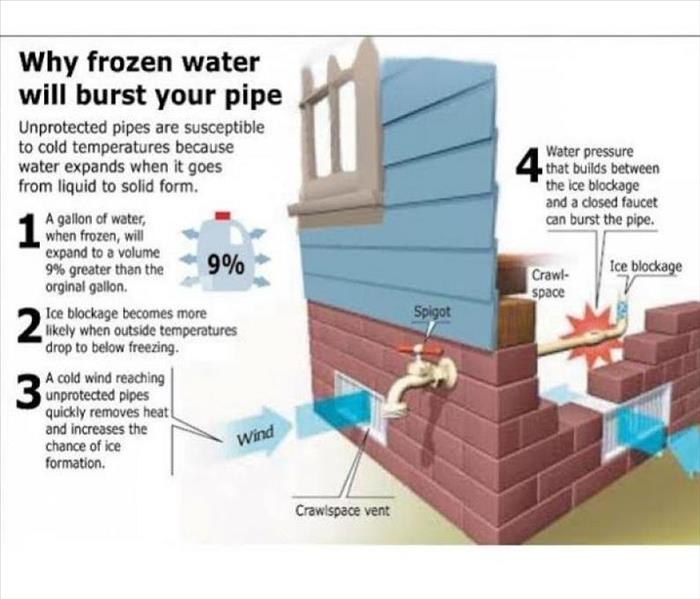 11 Tips to Protect and Prevent Pipes from Freezing
11 Tips to Protect and Prevent Pipes from Freezing
Why Pipe Freezing is a Problem
Water has a unique property in that it expands as it freezes. This expansion puts tremendous pressure on whatever is containing it, including metal or plastic pipes. No matter the strength of a container, expanding water can cause pipes to break.
Pipes that freeze most frequently are:
Pipes that are exposed to severe cold, like outdoor hose bibs, swimming pool supply lines, and water sprinkler lines.
Water supply pipes in unheated interior areas like basements and crawl spaces, attics, garages, or kitchen cabinets.
Pipes that run against exterior walls that have little or no insulation.
How to Protect Pipes From Freezing
Before the onset of cold weather, protect your pipes from freezing by following these recommendations:
Drain water from swimming pool and water sprinkler supply lines following manufacturer's or installer's directions. Do not put antifreeze in these lines unless directed. Antifreeze is environmentally harmful, and is dangerous to humans, pets, wildlife, and landscaping.
Remove, drain, and store hoses used outdoors. Close inside valves supplying outdoor hose bibs. Open the outside hose bibs to allow water to drain. Keep the outside valve open so that any water remaining in the pipe can expand without causing the pipe to break.
Add insulation to attics, basements and crawl spaces. Insulation will maintain higher temperatures in these areas.
Check around the home for other areas where water supply lines are located in unheated areas. Look in the garage, and under kitchen and bathroom cabinets. Both hot and cold water pipes in these areas should be insulated.
Consider installing specific products made to insulate water pipes like a "pipe sleeve" or installing UL-listed "heat tape," "heat cable," or similar materials on exposed water pipes.
Consider relocating exposed pipes to provide increased protection from freezing.
How to Prevent Frozen Pipes
Keep garage doors closed if there are water supply lines in the garage.
Open kitchen and bathroom cabinet doors to allow warmer air to circulate around the plumbing. Be sure to move any harmful cleaners and household chemicals up out of the reach of children.
When the weather is very cold outside, let the cold water drip from the faucet served by exposed pipes. Running water through the pipe - even at a trickle - helps prevent pipes from freezing.
Keep the thermostat set to the same temperature both during the day and at night. By temporarily suspending the use of lower nighttime temperatures, you may incur a higher heating bill, but you can prevent a much more costly repair job if pipes freeze and burst.
If you will be going away during cold weather, leave the heat on in your home, set to a temperature no lower than 55° F.
Do You Have an Evacuation Plan and Procedure
11/21/2017 (Permalink)
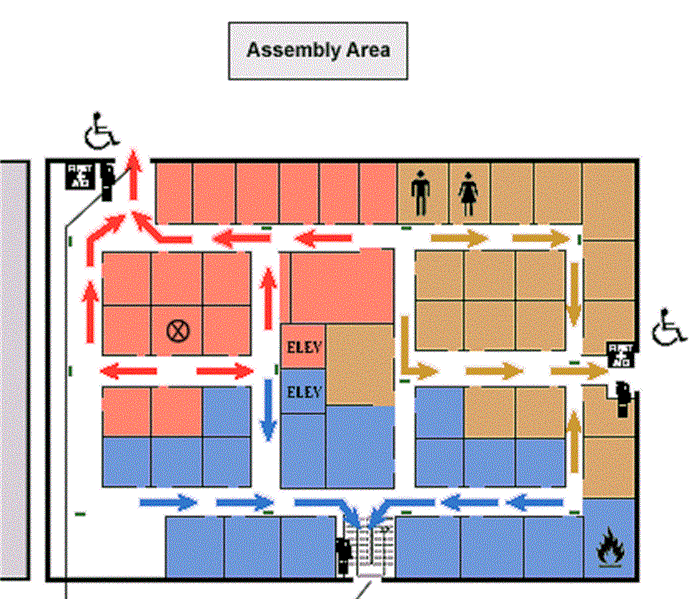 Do You Have an Evacuation Plan and Procedure
Do You Have an Evacuation Plan and Procedure
For smaller organizations, the plan does not need to be written and may be communicated orally if there are 10 or fewer employees. [29 CFR 1910.38(b)]
At a minimum, the plan must include but is not limited to the following elements [29 CFR 1910.38(c)]:
- Means of reporting fires and other emergencies
- Evacuation procedures and emergency escape route assignments
- Procedures for employees who remain to operate critical plant operations before they evacuate
- Accounting for all employees after an emergency evacuation has been completed
- Rescue and Medical Duties for Employees Performing Them
- Names or job titles of persons who can be contacted
Although they are not specifically required by OSHA, you may find it helpful to include the following in your plan:
- A description of the alarm system to be used to notify employees (including disabled employees) to evacuate and/or take other actions. The alarms used for different actions should be distinctive and might include horn blasts, sirens, or even public address systems.
- The site of an alternative communications center to be used in the event of a fire or explosion.
- A secure on- or offsite location to store originals or duplicate copies of accounting records, legal documents, your employees' emergency contact lists, and other essential records.
A floor plan shows the possible evacuation routes in the building. It is color coded and uses arrows to indicate the designated exit. A room containing hazardous materials is indicated in the lower right hand corner of the building by the flame symbol. The assembly area is indicated outside the primary exit at the top of the building.
An evacuation floor plan with three exits, has the primary exit designated in the upper left by red arrows, with two main flows coming toward it indicated by bent arrows, the red rooms, and red elevator. Persons in the upper left half of the building are directed toward this exit.
The secondary exit is located centrally on the adjacent outer wall on the right side of the building. Persons in the top hallway and second hallway are directed with tan arrows from the tan colored rooms toward this exit. A male and female figure (representing restrooms) are indicated in the first tan colored rooms in the upper hallway. The individuals should exit along the hallway toward the secondary exit at the right side of the building. Both the primary and secondary exits are marked with handicapped signs.
There is a third exit in the last hallway, centrally located in the outer wall opposite the outer wall with the primary exit and adjacent to the outer wall with the secondary exit. Persons in the third hallway are directed by blue arrows from the blue colored rooms and blue elevator to exit out this doorway. This exit is not designated for handicapped persons as stairs are indicated.
Colored boxes indicate a row of rooms along the outer walls, with hallways parallel to the rows of outer rooms on three sides of the building. The outer wall on the left side of the building has a hallway along the outer wall. Four sets of six colored rooms are along the internal corridors and there are three large rooms centrally located with internal hallways connecting the top and bottom of the building.
The Primary Exit is marked with an arrow from the text below the map, as is the Secondary Exit. An X inscribed in a circle marks the position of the employee, indicated in the legend, in text "You are here". On the floor plan, the employee is located in the upper left hand corner in the internal set of six red colored rooms, in the central room in the second hallway. The employee may exit the red colored room, either to the left or right (indicated by red arrows), and then proceed toward the outer wall and the upper left primary exit.
For more details visit the OSHA website:
https://www.osha.gov/SLTC/etools/evacuation/min_requirements.htm
Crime Scene cleaning, Victim Benefits and Compensation
11/20/2017 (Permalink)
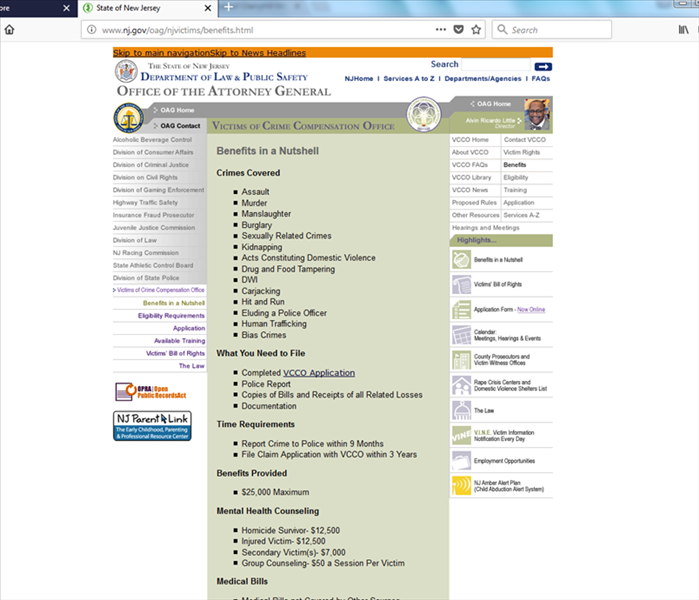 Crime Scene cleaning, Victim Benefits and Compensation
Crime Scene cleaning, Victim Benefits and Compensation
Crime scene cleanup is a term applied to cleanup of blood, bodily fluids, and other potentially infectious materials (OPIM). It is also referred to as biohazardremediation, because crime scenes are only a portion of the situations in which biohazard cleaning is needed. Such incidents may include accidents, suicides, homicides, and decomposition after unattended death. It could also include mass trauma, industrial accidents, infectious disease contamination, animal biohazards (e.g. feces or blood) or regulated waste transport, treatment, and disposal.
Attached are Compensation and Benefits for Victims in NJ:
Benefits in a Nutshell Crimes Covered
Assault
- Murder
- Manslaughter
- Burglary
- Sexually Related Crimes
- Kidnapping
- Acts Constituting Domestic Violence
- Drug and Food Tampering
- DWI
- Carjacking
- Hit and Run
- Eluding a Police Officer
- Human Trafficking
- Bias Crimes
What You Need to File
- Completed VCCO Application
- Police Report
- Copies of Bills and Receipts of all Related Losses
- Documentation
Time Requirements
- Report Crime to Police within 9 Months
- File Claim Application with VCCO within 3 Years
Benefits Provided
Mental Health Counseling
- Homicide Survivor- $12,500
- Injured Victim- $12,500
- Secondary Victim(s)- $7,000
- Group Counseling- $50 a Session Per Victim
Medical Bills
- Medical Bills not Covered by Other Sources
- Chiropractic/Physical Therapy
- Medical Supplies and/or Other Prescription Drugs
- Medical Related Transportation
Loss of Earnings or Financial Support
- Maximum Amount-$600/Week
- Loss of Support- 48 Months
- Loss of Earnings- Direct Victim-104 Weeks
- Permanent Disability- Direct Victim-60 Months
- Loss of Earnings- Secondary Victim-$7,000 to Care for
- Primary Victim
Others
- Funeral Cost-$5000
- Transportation to Funeral-200/Person or $1,000 Total
- Crime Scene Cleanup- $4,000
- Relocation Expenses- $2,500
- Domestic Help- $6,500 Total
- Child Care/Day Care Services- $6,500
- Victims’ Rights Attorney Fees (Criminal Matter)- $125/Hr with a $3,000 Maximum
- Attorney Fees for Representing Victims in VCCO Claim
- (Up to 15% of the Award)
Catastrophic Injuries
- Supplemental $35,000 for Rehabilitative Services Only
Here is the web link:
http://www.nj.gov/oag/njvictims/home.html
Here are the 8 most common fire hazards in the home
11/17/2017 (Permalink)
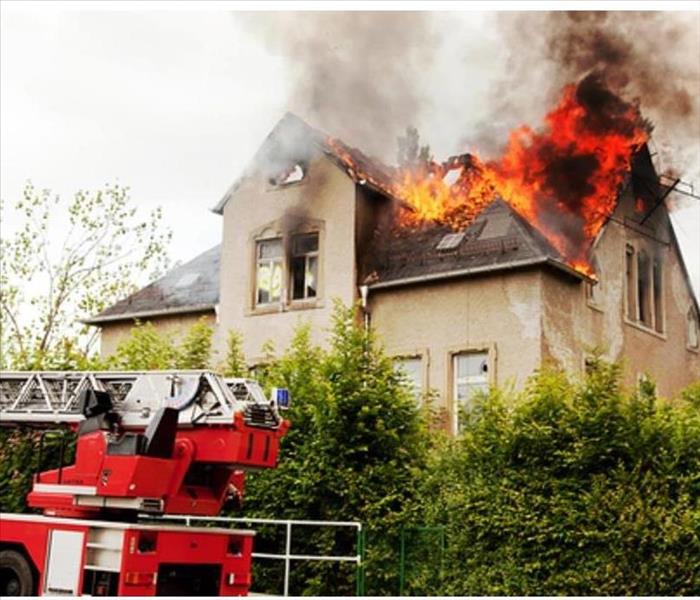 Here are the 8 most common fire hazards in the home
Here are the 8 most common fire hazards in the home
A recent fire at a 16,000 square foot mansion on the waterfront in Anne Arundel County, Maryland, took the lives of six people including two grandparents and their four grandchildren. The cause of the fire, according to investigators, was a 16-foot tall Christmas tree that the owners left lit most of the time in the great room of the house. An electrical failure ignited the two-month-old tree, which swiftly fueled the fire in the rest of the house.
The lack of a sprinkler system inside the house or fire hydrants and other water sources near the home made it extremely challenging for fire fighters who responded to the call.
1. Candles
Who doesn’t love the romantic glow of candlelight? But, even if you enjoy their fragrance and ambiance, you might want to think twice before lighting a candle and leaving the room. From 2007-2011, the NFPA says there were an average of 10,630 fires in the U.S. that were started by candles, causing 115 deaths, 903 injuries and approximately $418 million in property damage. That is an average of 29 candle fires per day.
About one-third of these fires started in bedrooms, causing 39% of the associated deaths and 45% of the associated injuries. More than half of all candle fires start because of candles that were left too close to flammable items. They should always be kept at least 12 inches away from anything that can burn.
2. Smoking
While the number of fires caused by smoking is trending downward, the NFPA found that there were still an average of 17,600 related fires per year resulting in 490 deaths and more than $516 million in property damage.
3. Electrical & Lighting
Electrical fires can have a number of different origins. They can be caused by an equipment malfunction, from an overloaded circuit or extension cord, or from an overheated light bulb, space heater, washer, dryer or other appliance.
According to the NFPA, in 2011 approximately 47,700 home structure fires were caused by some sort of electrical failure or malfunction. These resulted in 418 deaths, 1,570 injuries and $1.4 billion in property damage.
4. Dryers and washing machines
Clothes dryer fires happen more often than one might think, accounting for 16,800 home structure fires in 2010 and doing more than $236 million in property damage. The most frequent causes of fires in dryers are lint/dust (29%) and clothing (28%). In washers, they are wire or cable insulation (26%), the appliance housing (21%) or the drive belt (15%).
5. Lightning
Unlike other types of house fires, which occur more frequently in the winter months, those caused by lightning are more likely to happen in June, July and August in the late afternoon or early evening. From 2007-2011, NFPA says there were an average of 22,600 fires per year caused by lightning strikes.
6. Children playing with fire
The NFPA says that children start an average of 7,100 home fires per year, causing approximately $172 million in property damage. July is the most active month for these fires, and males start the majority (83%) of them. Younger children under the age of six are more likely to start fires inside, using matches or a lighter as the ignition source. The most frequent sites for fires are the bedroom (39%), kitchen (8%) and living room/family room/den (6%). Older children are more likely to start fires outside.
7. Christmas trees
Like candle fires, Christmas tree fires are more common during the holidays, with 43% occurring in December and 39% in January. The NFPA says an average of 230 fires are attributed to Christmas trees each year and they are more likely to be serious because of the factors that can contribute to the fire: a dry tree, electrical lights and a fuel supply (gifts) under the tree. Christmas tree fires cause an average of $18.3 million in property damage each year.
8. Cooking
The number one source of house fires is cooking – usually leaving pots or pans unattended on the stove while you run away to do something for “just a minute.” The NFPA says that 40% of all house fires, or an average of 156,600 per year, start this way, causing approximately $853 million in property damage. Two-thirds of the fires started because the food or other materials caught fire.
Fires are more likely to start on a range (57%) as compared to the oven (16%), mainly due to frying. Most injuries occur when the cook tried to put out the fire.
Several years ago in Florida, investigators saw a pattern of fraudulent house fires that started in the kitchen when the owners left food cooking on the stove while they ran to the store for a missing ingredient. Grease would catch on fire and the flames spread from there.
Contact a Fire and Smoke damage Restoration contractor, for any Fire Damage and Smoke damage to your property.
Basement Water issues, Sump Pump, Water Damage in Haddonfield NJ, Detect and Prevent, Water damage in Mt. Laurel NJ,
10/6/2017 (Permalink)
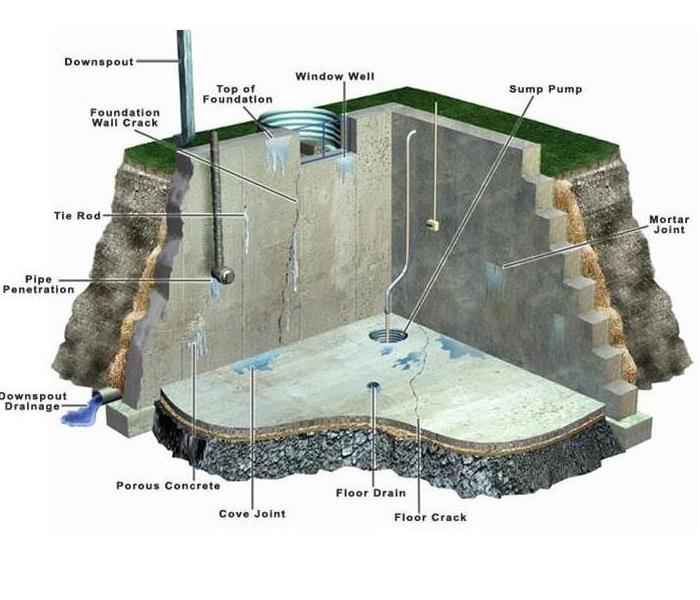 Basement Water issues, Sump Pump, Water Damage in Haddonfield NJ, Detect and Prevent, Water damage in Mt. Laurel NJ,
Basement Water issues, Sump Pump, Water Damage in Haddonfield NJ, Detect and Prevent, Water damage in Mt. Laurel NJ,
Standing water on the floor is easy to see. Less obvious signs of problems include:
Unexpected increases in your water bill
- Stains on walls, floors or ceilings
- Damaged or warped flooring
- Warped bottom panels in under-sink cabinets
- Peeling paint or wallpaper
- Corrosion on plumbing valves and fittings
Deal with problems as you find them. Clean up any water or moisture, locate the source and make repairs. Tracking down a leak isn't always straightforward — water can travel along components in the building structure, so the indications of the leak may be in a different part of the home than the leak itself. If necessary, contact a professional roofing contractor, plumber or water damage restoration specialist to help with identification and repair.
In addition to the damage that water causes, it can encourage the growth of mold on walls and floors — where it's readily visible — and in ductwork, attics and crawl spaces — where you might not notice it. A musty odor is a sign that mold may be present.
Mold can cause damage and lead to health problems — deal with it quickly. If the affected area is larger than 3 feet by 3 feet, the Environmental Protection Agency recommends you find a professional mold remediation contractor. For smaller areas, you can clean nonporous surfaces with commercial cleaning products, soap and water or a solution of a cup of bleach to each gallon of water. Follow the instructions and safety precautions for the cleaning product you use and wear appropriate safety gear. Porous surfaces such as drywall need to be replaced. For more information on mold in the home and how to clean it up, see A Brief Guide to Mold, Moisture, and Your Home on the EPA's web site.
Inspecting common sources of water leaks and taking some simple preventative measures can be an effective way to reduce the risk of water damage and mold.
Plumbing
- Every 6 to 12 months, inspect water lines, shut-off valves and fittings for fixtures such as sinks, toilets and tubs and for appliances such as washing machines, dishwashers and ice makers. Check for cracks, loose connections, kinks and corrosion. If you find a leak, turn off the water to the fixture or appliance until you can make repairs.
- Check around toilets to make sure water is not leaking at the base — an indication that the wax ring between the toilet and floor might need replacing or that there might be a crack in the base.
- If the temperature drops near the 20°F mark, allow faucets connected to vulnerable pipes — those not protected in insulated spaces — to drip. This helps minimize the risk of burst pipes by relieving pressure if the pipes freeze.
Appliances
- Replace washing machine supply hoses at least every five years. Consider using stainless-steel mesh hoses. Keep the machine properly balanced — over time, an unbalanced machine can move, pulling free the hose connections. Read Maintain Your Washer and Dryer for instructions on replacing hoses and balancing the washing machine.
- Consider turning off the water to the washing machine when it's not in use.
- Don't operate a dishwasher or washing machine while your house is unoccupied.
- Follow the manufacturer-specified maintenance for your appliances, including your water heater. Have the water heater inspected every couple of years.
Roof and Gutters
- Have your roof inspected every three years by a professional, but also check routinely for damage you can see from the ground — such as broken and missing shingles or damaged flashing. A poorly maintained roof can lead to leaks in the home and additional damage to the roof itself.
- If your roof doesn't have a drip edge or drip cap, consider having one added. This component helps keep water away from the roof deck and directs runoff into gutters.
- Keep gutters clear and well-maintained. Gutters that overflow, leak or don't drain properly allow water to seep into your roof and into your foundation, crawlspace or basement. See Gutter Cleaning and Repair for steps to keep your gutters working correctly.
- Make sure gutter downspouts direct rainwater away from the home's foundation. Use extensions to carry water at least 6 feet from the house.
Exterior Walls and Foundation
- Inspect the exterior of your home. Caulk around gaps at plumbing and ventilation entry and exit points. See How to Caulk for instructions. Repair cracked mortar joints.
- Check to see if roots from shrubs near your home have caused damage that can allow water to enter the foundation. You may need to remove shrubs that are close to the house to prevent problems. Roots can also damage and block in-ground pipes, causing leaks near the foundation and sewer backups in the home.
- Keep shrubbery beds and other landscape features sloped to direct water away from the home.
- Look for evidence of erosion or settling at the foundation that can indicate water problems.
Additional Tips to Avoid Water Damage
- Have your attic ventilation and insulation inspected annually and seal gaps that allow warm air into the attic — such as those around access doors and light fixtures. When warm air collects in the attic, it can lead to the formation of an ice dam — ice around the eaves that causes water from melting snow and ice to back up under the shingles and leak into your home.
- If you have a sump pump, test it several times during the year. Follow the manufacturer's maintenance instructions.
- Check your water pressure with a pressure gauge; typically these screw onto a hose bib. The pressure in an average home is around 50 to 70 pounds per square inch (psi). Higher pressure causes extra stress on pipes and fittings and can lead to leaks.
- Inspect tile and grout around showers and tubs. Make any necessary repairs. Read Replace a Broken Ceramic Tile and Repair Tile Grout for step-by-step instructions.
- Check for leaks around windows during rains and seal any you find.
- Use exhaust fans in the kitchen and bathroom to move excess moisture out of the house. Moisture in the air can condense on cool surfaces and cause problems. Read Controlling Moisture and Humidity in the Home for more ways to reduce indoor moisture.
- Locate your water shut-off valve so you can quickly turn off water to the home in an emergency. See Shut Off Your Home Water Supply for instructions on locating the valve.
Biohazard cleaning in Mt. Laurel NJ, Biohazard cleaning in Haddonfield NJ,
10/3/2017 (Permalink)
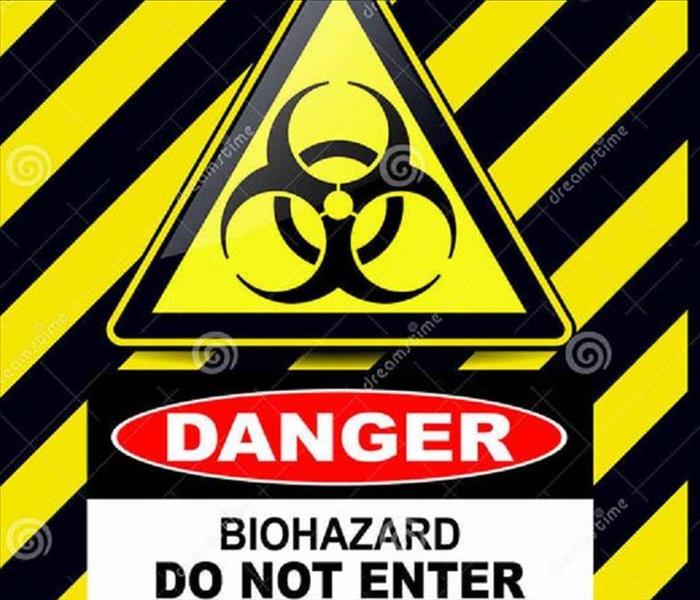 Biohazard cleaning in Mt. Laurel NJ, Biohazard cleaning in Haddonfield NJ,
Biohazard cleaning in Mt. Laurel NJ, Biohazard cleaning in Haddonfield NJ,
Biohazard and Crime scene cleanup is a term applied to cleanup of blood, bodily fluids, and other potentially infectious materials (OPIM). It is also referred to as biohazard remediation, because crime scenes are only a portion of the situations in which biohazard cleaning is needed. Such incidents may include accidents, suicides, homicides, and decomposition after unattended death. It could also include mass trauma, industrial accidents, infectious disease contamination, animal biohazards (e.g. feces or blood) or regulated waste transport, treatment, and disposal.
Television productions like CSI: Crime Scene Investigationhave added to the popularity of the term "crime scene cleanup". Australia, Canada and England have added it to their professional cleaning terminology. As a profession, it is growing in popularity because of media exposure and the growth of training programs worldwide.The generic terms for "crime scene cleanup" include trauma cleaning, crime and trauma scene decontamination ("CTS Decon"), biohazard remediation, biohazardremoval, blood cleanup and crime scene cleanup. The state of California refers to individuals who practice this profession as "Valid Trauma Scene Waste Management Practitioners".
Types of cleanups
Crime scene cleanup includes blood spills following an assault, homicide or suicide. There are many different sub-segments, named primarily after additional collateral, contingency, or preconditions, regarding the presence of non-blood borne organics, toxic irritants
(e.g.,tear gas) or disease vectors.
However, it is the legality of charging a fee for mitigating potentially harmful biohazard situations that differentiates a registered crime or trauma practitioner from any general restoration, carpet cleaning, janitorial or housekeeping service.
Business
Crime scene cleanup began primarily as a local or regional small business activity but maturity and consolidation has created some larger entities in the industry; only a few nationwide companies exist, although some national carpet cleaning and restorationcompanies franchises have added crime scene cleanup and biohazard removal to their services. Due to the legal and ethical complications crime scene cleanup is often its own business entity or a separate division.
Regulatory requirements
While the field of crime scene cleanup is not specifically regulated as a class, most if not all of the activities performed by biohazard cleanup teams in the United States are regulated or fall under best practice guidelines from governing and advisory bodies such as OSHA, NIOSH, DOT, and EPA.
Those who hire a crime scene cleanup company should make sure that they are properly trained in applicable federal and state regulations and can provide documentation of proper biohazardous waste disposal from licensed medical waste transportation and disposal companies. If in California or Florida the client should confirm that the company is registered with the state Department of Health. A few states such as California, New York and Florida are the only states that explicitly require registration or licensing for crime scene cleanup. Other states may require biohazardous waste transport permits from the DOT.
In the US, OSHA requires that exposure to blood-borne pathogens be limited as much as possible due to the assumption that the blood and biological material is infectious. Most actions taken to limit exposure fall under cross-contamination protocols, which provide that certain actions be taken to avoid further spreading the contamination throughout otherwise clean areas. CTS De-con companies should have in place, an exposure control plan before beginning work on any trauma scene. Under employee safety and cross-contamination protocols, the following OSHA regulations may pertain to bioremediation.
- OSHA29 CFR 1910.1030(g)(2)(ii)- Initial Assessment of Work: Must assess work site for potential hazards to employee safety. OSHA 29 CFR 1910.1200, et seq.- Hazard Communication Protocol: Required to establish what chemicals are used and that they are properly labeled.
- OSHA 29 CFR 1910.1030(d)(2)(i);29 CFR 1910.1030(e)(2)(iii); 29 CFR 1910.1030(d)(1); and 29, CFR 1926.1053 – Work Practice & Engineering Controls and Safety: Having done the initial assessment, must determine damage, potential hazards, equipment needs, egresses, work routes, possible complicating factors, ladder/scaffolding safety protocols, availability for hand-washing/sanitization wipes.
- OSHA 29 CFR 1910.1030(d)(1) – Method of Compliance: Ensure employees are following all OSHA-mandated engineering and work practice controls through proper supervision, written documentation and photographs.
- OSHA 29 CFR 1910.1030(c)(2) – Exposure Determination: Determine employee safety concerns due to exposure to biological materials.
- OSHA 29 CFR 1910.1030(g)(1) – Hazard Signs and Labels: Hazardous areas must be demarcated; use of biohazard tape and establishment of zones separates and identifies hazardous areas.
In the UK, biohazards are regulated in part by HSE. Canada has published Canadian Biosafety Standards and Guidelines.
Methods
The crime scene cleaners' work begins when the coroner's office or other official, government body releases the "scene" to the owner or other responsible parties. Only when the investigation has completely terminated on the contaminated scene may the cleaning companies begin their task.
Standard operating procedures for the crime scene cleanup field often include military-like methods for the decontamination of internal and external environments. Universal precautions recognized worldwide are the cautionary rule-of-thumb for this field of professional cleaning.
Cleaning methods for removing and sanitizing biohazards vary from practitioner to practitioner. Some organizations are working to create a "Standard of Clean" such as ISSA's K12 Standard, Which includes use of quantifiable testing methods such as ATP testing.
Organizations
The first specialty trade organization for this field of cleaning was the American Bio-Recovery Association (ABRA). The largest association dedicated to the crime scene cleanup industry is the National Crime Scene Cleanup Association (NCSCA). Among other tasks, they organized cleanup procedures for Ebola decontamination in 2014.
Clean Trust (aka IICRC) is a certifying body for the cleaning trade in general. International Sanitary Supply Association (ISSA) is a global standards body and trade organization of professional janitorial and cleaning professionals.
In popular culture and the media
Crime scene cleanup as a profession has been featured sporadically in popular culture and the media. It first showed up in films when Quentin Tarantino produced Curdled, then after an eleven-year hiatus in the Samuel L. Jackson film Cleaner, and more recently when Amy Adams and Emily Blunt teamed up for Sunshine Cleaning. On television it has been featured in a smattering of documentaries aired on the National Geographic Channel and the Discovery Channel, as well as reality series such as Grim Sweepers.
In video games and visual media, crime scene cleanup takes center focus as the main objective in the game, Viscera Cleanup Detail. Viscera Cleanup Detail is a PC game distributed through Steam that enables players to clean up blood and body remains after a Sci-Fi battle has occurred on a space station. Another example of crime scene cleanup in video games is Safeguard. Safeguard takes a more realistic and educational approach, enabling users to learn about the hazards of crime scene cleanup, as well as the equipment and tools used. Safeguard also uses virtual reality to immerse users in the crime scene environment.
ANSI/IICRC S540 Trauma and Crime Scene Cleanup
Standard for Trauma and Crime Scene Cleanup
IICRC announces the publication of a new ANSI/IICRC S540 Standard for Trauma and Crime Scene Cleanup (1st edition, 2017).
ANSI/IICRC S540 Standard defines criteria and methodology used by the technician for inspecting and investigating blood and other potentially infectious material (OPIM) contamination and for establishing work plans and procedures. The Standard describes the procedures to be followed and the precautions to be taken when performing trauma and crime scene cleanup regardless of surface, item, or location. This standard assumes that all scenes have been released by law enforcement or regulatory agencies.
9 Affordable Ways to Dry Up Your Wet Basement For Good, Water damage in Hadonfield NJ, Water damage in Mt. Laurel NJ,
10/2/2017 (Permalink)
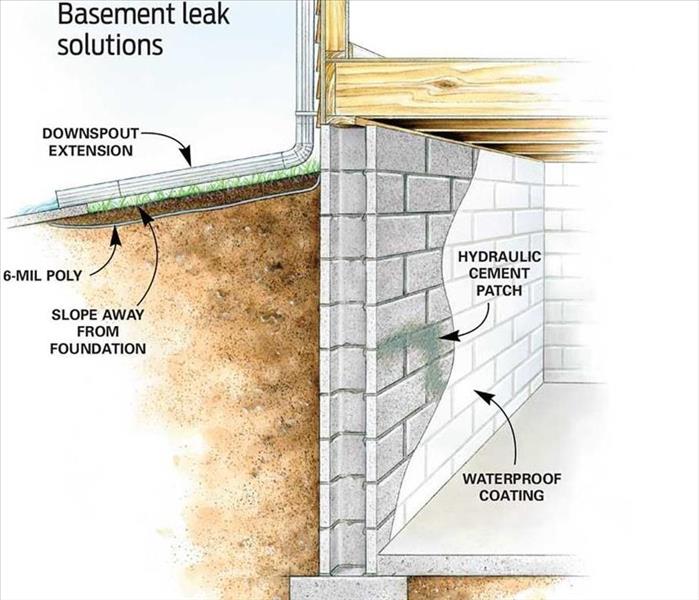 9 Affordable Ways to Dry Up Your Wet Basement For Good, Water damage in Hadonfield NJ, Water damage in Mt. Laurel NJ,
9 Affordable Ways to Dry Up Your Wet Basement For Good, Water damage in Hadonfield NJ, Water damage in Mt. Laurel NJ,
Diagnose the Water Problem
Water or moisture in basements comes from two sources. One source is indoor humidity that condenses on cold surfaces, much like water droplets form on a cold drink on a humid day. The other is water—or water vapor—that comes from outside. Rainwater, melting snow or groundwater can saturate the soil around your foundation and leak in. Water can leak through cracks, or it can penetrate porous concrete or masonry walls in the form of water vapor. To figure out what's causing the problem, tape aluminum foil to your basement wall and inspect it a few days later. Moisture on the outside surface of the foil indicates high indoor humidity. Moisture behind the foil means moisture is leaking through the walls.
Get Rid of Excess Humidity
Eliminating the sources of humid air will help dry out your basement. Seal leaky dryer vents with foil tape to prevent unwanted humid air from entering your basement. Don't just use duct tape; it'll eventually fall off. Add a vent fan to your basement bathroom and make sure your family turns it on during showers. Keep your basement windows closed during humid weather. And if you're still getting condensation on cool surfaces, run a dehumidifier to lower the indoor humidity.
Insulate Pipes
Condensation dripping from cold pipes can contribute to basement water problems. Cover cold water pipes with foam pipe insulation to stop condensation. The foam insulation is inexpensive and easy to cut with scissors.
Insulate Walls
Insulate exterior walls to prevent condensation. In cold climates, insulating basement walls also saves energy and reduces your heating bill. But don't cover the walls with insulation if water is leaking in from outside; you'll just create a potential mold problem.
Keep Water Away From the Foundation
If your basement leaks after heavy rains or after snow melts, making sure water is diverted away from your foundation may solve the problem. It's common for the soil alongside your house to settle over time, creating a moat that collects runoff and directs it down your foundation wall and into the basement. Lawn edging and gravel along the foundation can make things worse. Solve the problem by creating a 6-ft.-wide slope that drops about 4 in. away from the foundation. For extra insurance, cover the sloping soil with a layer of 6-mil poly. Then hide the poly with mulch, gravel or a layer of soil covered with grass. This will keep water from soaking in near the foundation.
Add Gutters and Extend Downspouts
If your basement leaks after it rains and you don't have gutters, consider adding them. Gutters catch the rain and channel it to the downspouts, which direct it away from the house. Whether you're installing new gutters or already have them, be sure the downspouts have 4- to 6-ft. horizontal extensions to move the water away from the house.
Plug Holes and Cracks in the Foundation
Holes and cracks in your foundation can let moisture and water seep into your basement. Plugging them probably won't solve basement leaks, but it'll help. Hydraulic cement works great for patching holes in a foundation because it can set up even under water, and it expands as it sets to seal the hole and lock the plug in place. Use a cold chisel or an angle grinder fitted with a masonry-cutting disc or diamond blade to enlarge the hole or crack into an inverted “V,” with the narrow part of the “V” on the surface of the wall. Then follow the package instructions for mixing and using the hydraulic cement.
Waterproof the Walls
Waterproofing materials that go on like paint fill the pores in the concrete or masonry walls and prevent water from leaking in. To be effective, these coatings must be applied to bare concrete or masonry walls. Start by removing loose material with a wire brush. Then clean off any white powdery “efflorescence” with masonry cleaner. Follow the safety and application instructions carefully. A common mistake when using masonry waterproofing products is to spread them too thin. The goal is to fill every pinhole to create a continuous waterproofing membrane. Brush the coating in all directions to completely fill every pinhole. Add a second coat after the first dries.
Install a Drainage System
The best permanent fix for chronic basement leaks is to install drainage tubing below the basement floor that's connected to a sump basket and pump. You can install a system like this yourself, but breaking out the concrete floor, burying the tubing, and patching the floor is a lot of backbreaking work. Materials to do an average basement will cost $600 to $1,000. Expect to spend $3,000 to $8,000 for a professionally installed system in a standard-size basement.
When to Replace Your Hot Water Heater, Water damage in Mt. Laurell NJ, Water Damage in Haddonfield NJ,
9/29/2017 (Permalink)
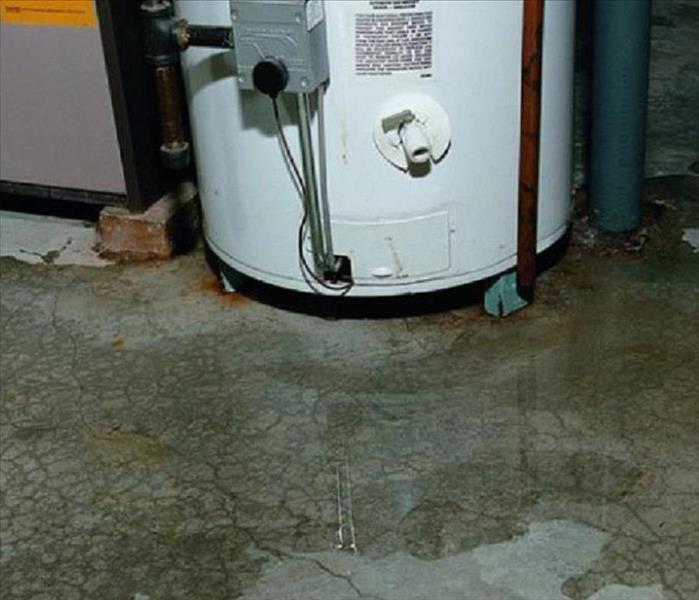 When to Replace Your Hot Water Heater, Water damage in Mt. Laurell NJ, Water Damage in Haddonfield NJ,
When to Replace Your Hot Water Heater, Water damage in Mt. Laurell NJ, Water Damage in Haddonfield NJ,
If your water heater is leaking or not heating up, you may be able to repair it rather than replace it. Regular maintenance will extend the life of your water heater. Some repairs, such as replacing a pressure-relief valve or heating element are pretty simple. Follow our tips to troubleshoot your gas or electric water heater issues and learn how long a water heater should last.
Safety First
Some water heater repairs are simple. However, if you aren't comfortable working with gas or electricity, always call a professional.
Repair or Replace
Based on the manufacturer's suggested service life, the life expectancy of a water heater is about 8 to 12 years. That varies with the location and design of the unit, quality of installation, maintenance schedule and water quality.
If your water heater is more than 10 years old, leaks around the base of the tank, and / or works erratically or not at all, it's probably time for replacement. However, before you begin the replacement process, make sure that an electrical problem, such as a blown fuse or tripped breaker, is not the reason for the unit's failure.
Troubleshooting Common Issues
Perhaps the most common problem connected with a water heater is water that isn't as hot as you want it to be. This is usually caused by a faulty thermostat or a defective heating element. Check the following when your water is not hot enough:
Electric water heater
- Make sure that the power is connected. Reset the thermostat.
- Flush the heater to remove sediment from the tank.
- Insulate the hot water pipes.
- Replace the heating element or thermostat.
- Raise the temperature setting on the thermostat.
Gas water heater
- Make sure that the gas is connected and the pilot light is lit.
- Flush the heater to remove sediment from the tank.
- Insulate the hot water pipes.
- Clean the gas burner and replace the thermocoupler (a safety device that shuts off the gas automatically if the pilot flame goes out).
- Raise the temperature setting on the thermostat.
Other common problems and possible solutions
- Hissing or sizzling noises: Sediment may have collected in the tank. Drain the tank until the water clears. Remove and soak elements in a pan filled with white vinegar for up to an hour and scrape off the collected scale.
- Leaking pressure-relief valve: Replace valve.
- Leaking water supply pipes: Tighten the fittings. If that doesn't work, shut off the water and replace the fittings.
Water Heater Maintenance
Today’s water heaters are manufactured to require little or no maintenance, but these maintenance tips could prolong the life of your water heater:
- Drain the water heater twice a year to rid it of collected sediment that causes corrosion. This also increases efficiency.
- Test the pressure-relief valve by lifting the valve’s handle and letting it snap back. This should release a burst of water into the overflow drainpipe. If it doesn’t, install a new valve.
- Lower the temperature setting on the thermostat to 120 degrees Fahrenheit. This reduces damage to the tank caused by overheating.
When Replacement Is Necessary
If you're replacing a water heater, you can replace it with the same type of unit. However, upgrade possibilities should be considered. For example, you may choose to increase or decrease the unit's holding capacity to accommodate a changing family. Or, you may opt to go tankless.
When looking for a water heater, consider these features:
- Gallon capacity (40-gallon and 50-gallon heaters are the most common)
- Recovery rate (the number of gallons the heater will heat in an hour)
- Dimensions (width and height — physical space may limit your ability to upgrade your unit's capacity; will the heater fit in the space you have for it?)
- Energy efficiency ratings (a sticker on the side should list the estimated annual cost of operation for the unit)
Before making repairs or purchasing a new water heater, check the nameplate on the side of your current unit. Here you will find helpful information including the tank capacity, insulation R-value, installation guidelines, working pressure, model and serial number. If you have an electric water heater, the nameplate will also list the wattage capacity and voltage of the heating elements.
- How will you dispose of your old water heater? Check local codes governing disposal of such appliances.
- Will you be able to physically handle the unit? Water heaters are bulky and heavy. You will need assistance.
- Do you have the tools necessary to do the job? Water heater installation requires adjustable wrenches, screwdrivers, a hacksaw and pliers. You may also need a propane torch if your installation uses copper pipe.
- Do you have time to do the job? Once you start replacing a water heater, you have to finish.
Caution
If you intend to convert from electric to gas or vice-versa, or if you don't feel comfortable doing the repair or maintenance work, hire a professional.
Caution
Make sure your home is equipped with carbon monoxide detectors when gas-powered appliances are present.
Does Homeowner’s Insurance Cover Tenant Vandalism? Property damage in Mt. Laurel NJ, Property damage in Moorestown NJ,
9/26/2017 (Permalink)
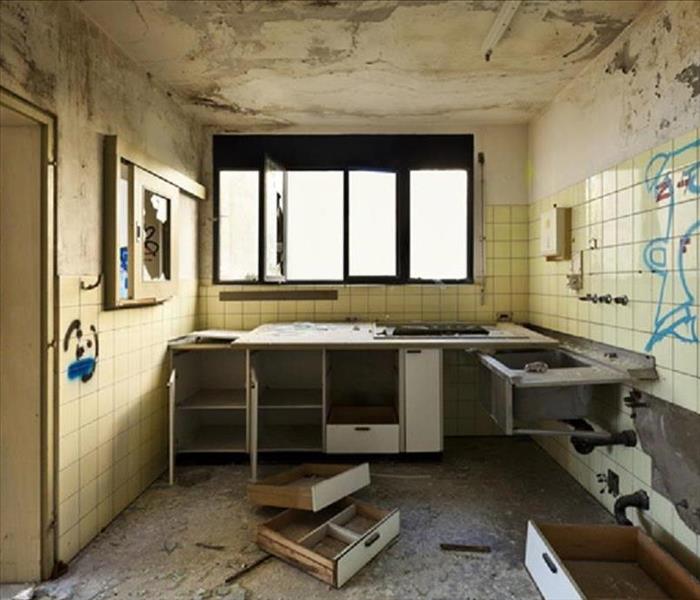 Does Homeowner’s Insurance Cover Tenant Vandalism? Property damage in Mt. Laurel NJ, Property damage in Moorestown NJ,
Does Homeowner’s Insurance Cover Tenant Vandalism? Property damage in Mt. Laurel NJ, Property damage in Moorestown NJ,
A tenant of a property stripped down the home to the bare drywall and inflicted $1.5 million worth of damage. The tenant took fireplaces, railings, lights, windows, doors and every other fixture imaginable! What are homeowners and landlords to do in such a situation? We see many predicaments such as this (fortunately most are not as severe as the one we depicted), and our clients always wonder: Does homeowner’s insurance cover acts of vandalism and theft?
The answer is that standard homeowners insurance policies will generally not cover any damages inflicted by tenants; Homeowners insurance policies only cover residences lived by the actual homeowner, or to put it simply, covers only the property in which a homeowner lives. Rental properties require a different policy under a rental homeowner’s policy known as a “dwelling fire policy”. Under the dwelling fire policy, normal wear and tear damage is not covered, but preempted vandalism is. However, in order to claim vandalism, homeowners must file a police report and press charges against the offender.
All homeowners and landlords to check with their insurance companies to review their policies and get a better understanding of what is and isn’t covered under their premium.
Tenant vandalism cases are tricky because homeowners will need to present proof to back their claim in order to get compensation from their insurance company. Of course this is not always possible and insurance companies might not honor the claim without proof. Alternatively, landlords could take this issue to court and sue tenants in a small claims court for damages, but even so monetary collection is still complicated and difficult to obtain. All landlords or homeowners who are renting their properties to enforce strict security deposit regulations, which will offer ample protection for the landlord and cover any damages caused by the tenant.
Again, remember to check with your insurance companies to see what liabilities your policy covers and doesn’t cover.
Most insurers, including, offer vandalism insurance as part of a homeowners policy. However, as specific coverages vary from insurer to insurer, it's best to contact your provider to verify that you're covered; don't just assume.
You'd hate to be counting on vandalism insurance, only to find out after an incident that you need to pay out of pocket. If a basic homeowners plan doesn't include coverage for vandalism, you may be able to add it as a named peril.
Are you protected against vandalism?
Keep in mind that vandalism coverage may not apply if your place is vacant for a significant amount of time, as could be the case with vacation homes or investment properties. Again, this varies from policy to policy, so be sure to speak with your own insurer about time-period restrictions when it comes to being away from home.
common types of vandalism
Graffiti is by far the most prevalent form of property vandalism, accounting for 35 percent of cases according to the Bureau of Justice Statistics. That being said, there's a lot more than just spray paint to worry about when it comes to your home. You may be glad to have protection against vandalism on your homeowners insurance policy in case:
- Your outdoor lights or windows are broken
- Your lawn is salted or garden dug up
- Your house is egged
- Your trees or bushes are cut
- Your home is burned
- Your plumbing is tampered with
- Your locks are glued
And those are just several examples. Because vandalism can come in seemingly endless forms, and is often the result of random rebellion or teen peer pressure (roughly 40 percent of vandalism arrests involve juveniles), it can be especially hard to anticipate. That's all the more reason to back up your home and hard-earned savings with homeowners insurance to help protect against a variety of hazards.
80 percent of Property Owners lack flood insurance, Flood damage in Mt. Laurel NJ, Flood damage in Moorestown NJ, Flood Insurance,
9/25/2017 (Permalink)
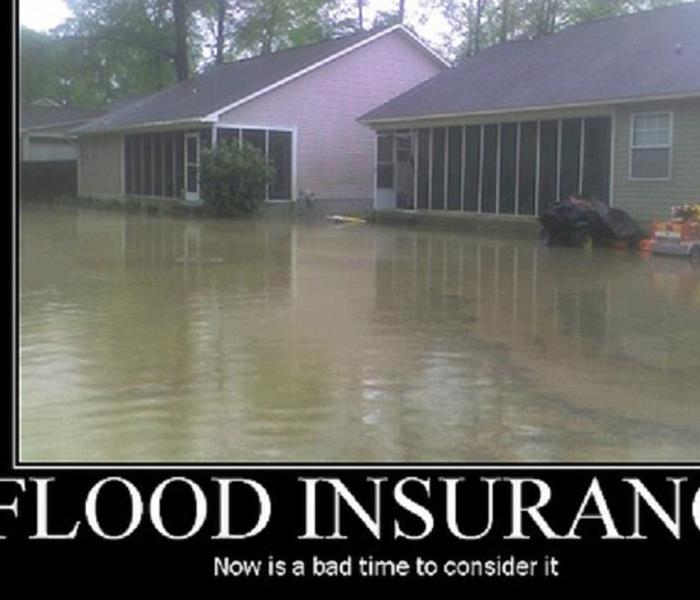 80 percent of Property Owners lack flood insurance, Flood damage in Mt. Laurel NJ, Flood damage in Moorestown NJ, Flood Insurance,
80 percent of Property Owners lack flood insurance, Flood damage in Mt. Laurel NJ, Flood damage in Moorestown NJ, Flood Insurance,
The vast majority of homeowners in the area devastated by Hurricane Harvey lack flood insurance, leaving many who escaped the storm with little financial help to rebuild their homes and lives.
“I wish I had flood insurance now,” lamented Leroy Moore, a 58-year-old whose home in Northeast Houston filled with water. He cancelled his flood policy when it grew too expensive. He and his wife were rescued from the rising waters on Sunday by National Guard troops and are now sleeping in a church. “When it's a choice to make between things and life, sometimes you've just got to let the things go and hang on to life.”
Regular home insurance covers wind damage but not flooding. Homeowners have to purchase separate flood insurance policies from the government-run National Flood Insurance Program, which will end in late September unless Congress renews it. In Texas, the average cost for a NFIP plan is $500 a year, but it can rise to more than $2,000 for homes inside a floodplain.
Only 17 percent of homeowners in the eight counties most directly affected by Harvey have flood insurance policies, according to a Washington Post analysis of Federal Emergency Management Agency data. When disaster hits, the policies cover up to $250,000 in rebuilding costs and $100,000 to replace personal belongings such as TVs and furniture.
Everyone else who loses their home to flooding will be dependent on private charity and government aid, especially grants from Federal Emergency Management Agency.
But FEMA's help is a poor substitute for flood insurance: The grants, intended to help residents rebuild homes and cover hotel stays until permanent housing is available, are capped at $33,300. Most receive significantly less. Funds will be even tighter if Congress doesn't provide additional emergency funding for Texas soon.
To get a grant, “FEMA has to believe your house is damaged so substantially that there’s no area in your house you can live in,” says Saundra Brown, a lawyer whose home in Houston was flooded. She spoke to The Washington Post while removing drywall to prevent mold. Her advice is to take photos of everything.
President Trump vowed “very rapid action” to help victims, but aid is usually slow to arrive, particularly in a large-scale disaster that strains FEMA's capacity to inspect and assess all the damaged homes.
Brown has seen firsthand just how long FEMA can take. She heads up Lone Star Legal Aid's disaster response unit, a group of lawyersthat assists low-income clients, including helping them to get FEMA money. Some of her clients were fighting with FEMA for months after the smaller storms that deluged Houston with rain in 2015 and 2016.
“It’s not like the government comes in with big buckets of cash and just hands it out,” says Robert Meyer, a professor and co-director of the University of Pennsylvania's Risk Management Center, which studies natural disaster response. “People who don't have insurance may have to abandon their homes.”
Moore and his wife were sitting in the First Baptist Church in North Houston trying to comprehend how quickly everything they worked for was ruined by a horrendous storm. The couple fled the home they'd owned for 32 years with just the clothes on their backs.
Moore, a forklift driver, used to buy flood insurance from the government when it cost $200 a year, but he says the premium rose above $300, so he stopped. His home had never flooded before Harvey until now.
“I've been in Houston all my life … I've never seen it like this,” Moore said, looking around the room at so many other families in the same situation.
Losing a home without insurance compensation is financially devastating. A home is the most valuable financial asset that many middle-class Americans have. The median home value in Harris County, where Houston is located, is $138,000, according to the U.S. Census. A total loss could delay retirement or force people into bankruptcy. Even if they can rebuild, it's unlikely the home will be worth as much if it is now marked as prone to flooding.
Legally, homeowners in places that FEMA designates as “high-risk” flood areas are supposed to have the insurance, but the rule isn't tightly enforced. Across the country, only 12 percent of homeowners have flood insurance, according to the Insurance Information Institute. The rate is a bit higher in Texas, Louisiana and Florida, but even in those coastal areas, only about 20 percent get it.
The best hope for those who don't get much FEMA aid is a low-interest government loan.“The largest vehicle for disaster recovery isn’t FEMA grants; it’s Small Business Administration disaster loans,” says Brown. Some businesses and charities in the Houston area are already offering aid and cheap loans up to about $10,000.
“Nothing like this has happened before in Houston. Individuals and businesses are all trying to help,” says Yuvette Chou, a 41-year-old who didn't have flood insurance and was trying to stay positive. She spent Sunday sitting with her husband on the stairs watching water seep into their home for the first time ever. Her employerhas already reached out to offer a low-cost loan. “I've learned my lesson.”
Houston, with 2.3 million residents, is America's fourth-largest city. It's the country's energy hub, and it has thrived thanks to the shale gas boom. In total, nearly 6 million people live in the eight counties most affected by the storm. One of the biggest concerns for the economy is whether people will leave after Harvey. Katrina demonstrated what such a storm can do to a major American city. New Orleans lost half its population in the year after Katrina struck.
Why Is My Air Conditioner Leaking Water Inside My House, Water damage restoration in Haddonfield NJ, Water damage restoration in Mt. Laurel NJ,
9/22/2017 (Permalink)
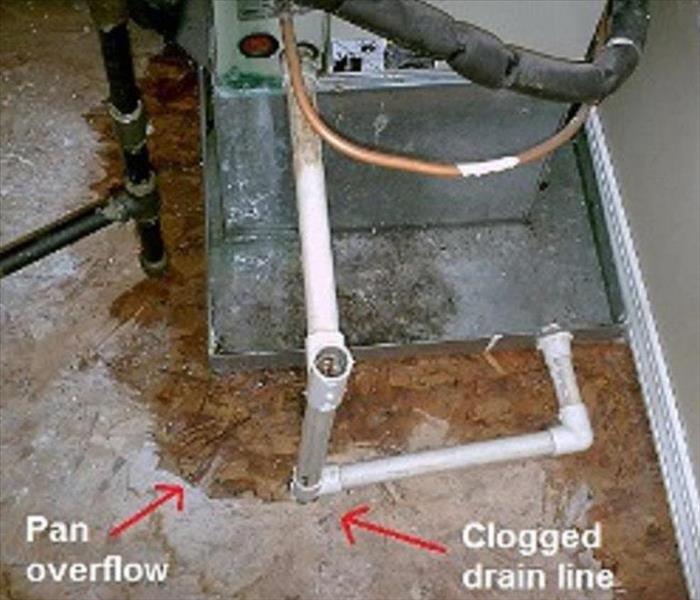 Why Is My Air Conditioner Leaking Water Inside My House, Water damage restoration in Cherry Hill NJ, Water damage restoration in Moorestown NJ,
Why Is My Air Conditioner Leaking Water Inside My House, Water damage restoration in Cherry Hill NJ, Water damage restoration in Moorestown NJ,
First, turn off your AC to prevent serious water damage and hazardous electrical issues. Next, we highly recommend calling a HVAC company for help.
Why water forms in an AC’s indoor unit
Condensation is a natural reaction that occurs inside all AC units.
You see, your AC’s job is to pull heat and humidity from the air inside your home. To do that, your system pulls in warm air through an indoor vent (called a return grille) and moves it across your inside unit’s cold evaporator coil to cool the air down.
When this happens, moisture forms on the evaporator coil. Just like the condensation that forms on a glass of ice cold water on a hot summer day.
Normally, the condensation on the coil drips into a drain pan and down a condensate drain pipe that leads it outside of your home (or into your plumbing system).
Now that you know why the condensation happens and the parts involved, here are a few common problems that can cause water to leak inside your house.
Clogged condensate drain line or rusted pan
If your drain line is clogged–commonly by dirt, algae, insects or a dirty evaporator coil–water drainage is limited; causing a buildup of water with nowhere to go other than your home.
And because it is so hot and humid, your AC runs more often so it doesn’t take long for large amounts of water to build up.
Also, the drain pan may be rusted through, allowing the water to fall through the pan and cause disastrous leaks and dangerous electrical issues inside your home. So, you’ll definitely need to replace the pan.
Improperly installed condensate trap
If your AC is fairly new, the problem could be with the way your system’s condensate trap was installed. An improperly designed condensate trap can block drainage and cause the drain pan to overflow with water.
What to do: You’ll need a professional to know what to look for in a condensate trap design and to see if it needs to be reinstalled.
Frozen evaporator coil
Condensation on your cold evaporator coil can also freeze. If it does, there’s a clear problem with your AC. It can even freeze all the way down the refrigerant lines to the outside unit.
And when it melts, there can be a lot of unwanted water in unwanted places throughout your home.
Common causes of a frozen coil include:
- Dirty air filter
- Low refrigerant
- An airflow problem
Other issues...
There are a number of problems that cause water leakage from your AC but these are a few of the most common. We understand this stuff can get pretty complicated.
Note: Depending on where the inside unit is and what specifically is causing water to leak inside your home, the damage could be pretty significant and extremely dangerous. Many, if not all, of these problems require a professional to ensure safety and proper resolution.
Contact a Certified Water Damage and Mold remediation company, to resolve any Microbial issues,
What to Do When Your Refrigerator Water Line Leaks, Water damage in Haddonfield NJ, Water damage in Mt. Laurel NJ,
9/21/2017 (Permalink)
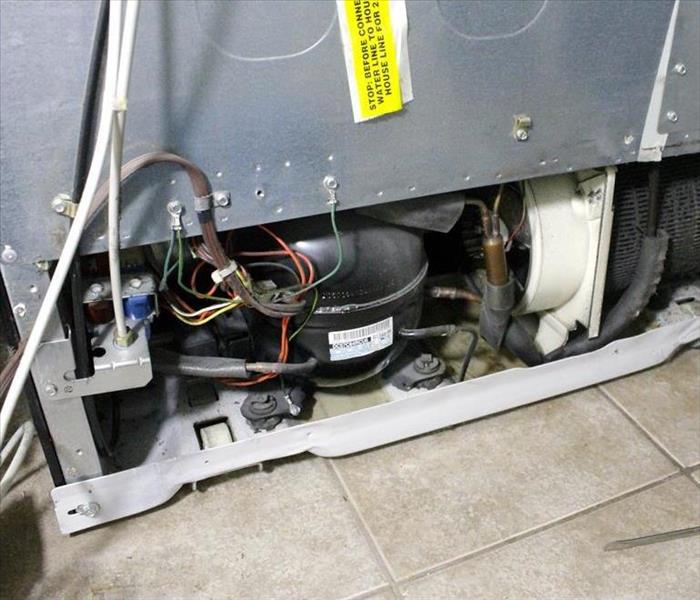 What to Do When Your Refrigerator Water Line Leaks, Water damage in Haddonfield NJ, Water damage in Mt. Laurel NJ,
What to Do When Your Refrigerator Water Line Leaks, Water damage in Haddonfield NJ, Water damage in Mt. Laurel NJ,
The refrigerator is one of the hardest working appliances around the home, so when one breaks down or suffers a leak, the experience can have consequences. If you find that your fridge’s water line has a leak, there are a few simple steps you can follow to troubleshoot the problem and have it running again in no time.
What To Do When Your Refrigerator Water Line Leaks
The first step is to identify the leak. The refrigerator water line connects the household water supply to a refrigerator with an ice maker or water dispenser. The water line typically runs at the back of the fridge. Once the leak has been identified, here is what you can do to fix the problem.
- Turn off the valve that supplies water to the refrigerator and then unplug the refrigerator to turn off the appliance. You will likely find the water shut off valve located beneath the kitchen sink or in some cases, behind the refrigerator itself.
- If the valve is located behind the fridge, carefully pull the appliance away from the wall and turn off the valve.
- You will now have to loosen the compression nut that secures the supply line to the water intake valve. This can be done with the assistance of an adjustable wrench by turning the nut counter clockwise and then disconnecting the supply line.
- Once loosened, remove the compression nut to disconnect the supply line from the valve.
- If the supply line is broken or torn in places, replace the old line with a new one making sure that its length and dimensions are the same as the original water line. Material choices range between copper, plastic and stainless steel water lines.
- To fix the new water line in place, thread one end of the supply line to the shut off valve under the sink and tighten until it is snug in place. When using a copper or plastic line, make sure to first slide on a compression nut secured with a compression sleeve or ring onto the end of the line. A stainless steel water line comes with a built in rubber gasket that stops the connection from leaking.
- Thread the other end of the supply line to the water intake valve and tighten it until snug.
- Turn on water and check for any leaks. If there is still a drip, tighten the nuts a bit more.
Purchasing a new water line
When the line is badly damaged and needs replacement there are a few things to keep in mind. For instance, one of the factors at this point would be to choose a line material that will offer durability and long lasting utility. Another is the price tag attached to the new purchase.
Plastic water lines
In terms of materials, plastic lines are the most cost effective but also least durable. The biggest threat lies in these lines cracking, clogging or leaking, causing water damage. While plastic lines may seem to work well in terms of flexibility, especially where space behind the fridge is tight, many people do not prefer this type of line material.
Copper water lines
Another option is to go with copper water lines that yield superior sturdiness but are also more prone to kinkiness. A more flexible version of copper lines is available to allow pushing the tubing into position giving it some flexibility to work well in cramped spaces.
Stainless steel water lines
As an alternative stainless steel braided lines can be considered. Braided steel is a tough, non-kinking option to the more pliable plastic and the ¼ in flexible copper lines. Stainless steel also happens to be the most durable option but will tend to be the most expensive as well.
Whether the leak in your refrigerator water line is caused by a plastic, copper or stainless steel water line, remember that you can always access the professional service of our experts at Tidal Wave in Atlanta to come and resolve all water damage concerns at your home.
Contact a Certified Water Damage Remediation company, for your Refrigerator Line Leaks, and water damage clean up,
Water Damage Restoration in Haddonfield NJ, Water damage restoration in Mt. Laurel NJ, Emergency Tips,
9/19/2017 (Permalink)
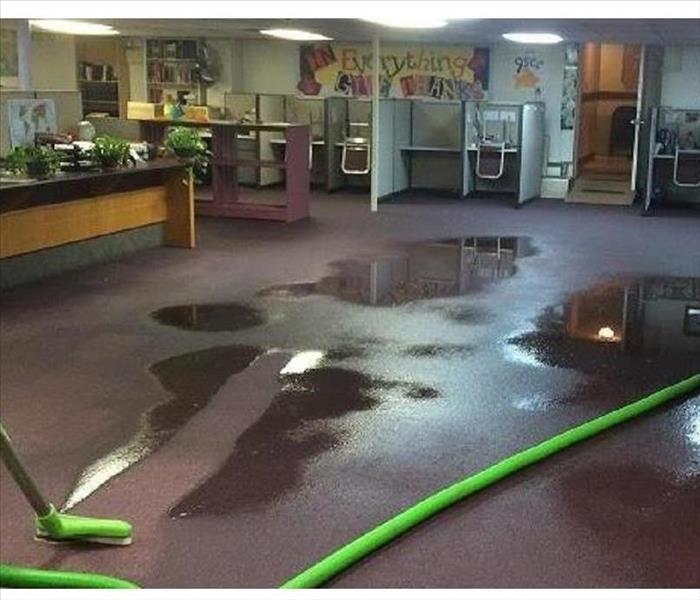 Water Damage Restoration in Haddonfield NJ, Water damage restoration in Mt. Laurel NJ, Emergency Tips,
Water Damage Restoration in Haddonfield NJ, Water damage restoration in Mt. Laurel NJ, Emergency Tips,
After any water damage situation, your primary focus should be safety:
- Is it safe to stay in the house?
- Electrical and "slip and fall" hazards are some of the most prevalent concerns.
- Only do activities that are safe for you to perform.
- Wet materials can be VERY heavy. Be careful!
What To Do After Flooding
- Remove excess water by mopping and blotting.
- Wipe excess water from wood furniture after removal of lamps and tabletop items.
- Remove and prop wet upholstery and cushions.
- Place aluminum foil or wood blocks between furniture legs and wet carpeting.
- Turn air conditioning on for maximum drying in summer.
- Remove colored rugs from wet carpeting.
- Remove art objects to a safe, dry place.
- Gather loose items from floors.
What NOT To Do After Flooding
- Don't leave wet fabrics in place. Hang furs and leather goods.
- Don't leave books, magazines or other colored items on wet carpet or floors.
- Don't use your household vacuum to remove water.
- Don't use television or other household appliances.
- Don't turn on ceiling fixtures if ceiling is wet, and keep out of rooms where ceilings are sagging.
Then Call a Certified Water Damage Restoration Contractor, for Proper Drying, Dehumidifying, Possible Demolition and Clean Up!
Wind damage in Cherry Hill NJ, Wind Damage in Moorestown NJ,
9/18/2017 (Permalink)
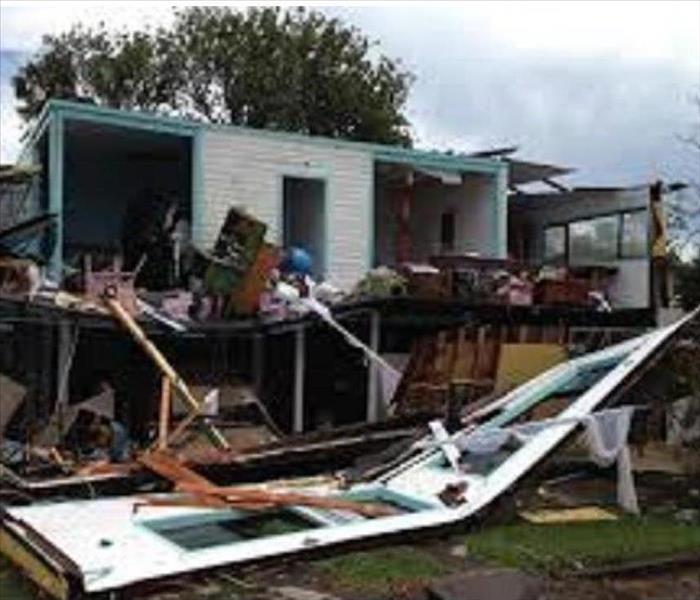 Wind damage in Cherry Hill NJ, Wind Damage in Moorestown NJ,
Wind damage in Cherry Hill NJ, Wind Damage in Moorestown NJ,
Q: Am I required to have homeowners insurance?
A: It is always smart to have a good homeowners insurance policy, even if you don't owe any money on your home. If you have a mortgage, home equity loan, or use your home as collateral, your lender will require you to maintain insurance.
Q: Are all homeowners insurance policies the same?
A: There are many different types of insurance policies. Levels of coverage, exclusions and limits of liability vary greatly. Some policies provide basic coverage, while others offer broad coverage and high levels of protection.
Q: Does my homeowners insurance cover all types of storm damage?
A: It depends on your policy. Most homeowners insurance policies cover storms including hail, tornado and wind damage. But, floods and earthquakes usually require additional coverage. It is always smart to check your policy to see exactly what is covered.
Q: Is replacement cost the same as the sale price of my home?
A: Not necessarily. The replacement cost is the actual cost to rebuild your home in the event it is completely destroyed, which may be more or less than the market value, or sale price.
Q: What does a homeowners insurance policy cover?
A: Homeowners insurance covers the repair or replacement of your home and its contents up to defined limits. Your policy may also include a liability policy, which protects you in the event someone is injured on your property due to your negligence.
Q: What are the various types of coverage included in a homeowners policy?
A: To determine the types of coverage you have, check the declarations page of your insurance policy. Types of coverage are as follows:
- Coverage A - Damage to your home
- Coverage B - Damage to other structures including garage, deck or swimming pool
- Coverage C - Loss or damage to the contents of your home
- Coverage D - Loss of use in case your home is not inhabitable
- Coverage E - Personal liability to third parties
- Coverage F - Medical payments to third parties
Q: Who pays for living expenses when my home is being repaired after a storm?
A: Your insurance company will pay for loss of use, in the case that your home is uninhabitable after it has been damaged by a storm, up to applicable limits.
Q: Does my policy cover tornado, wind and hail damage?
A: Most standard homeowners insurance policies cover damage done by tornado, windstorms and hailstorms. Check your policy for limits and details.
Q: What is not covered by homeowners insurance?
A: Earthquakes, floods and other named exclusions and usually require separate coverage. Normal wear and tear and poor maintenance is not covered by insurance.
Q: Will my insurance cover the cost of tree removal after a severe storm?
A: Most policies cover the cost of tree removal after a storm, however, you should check your policy. Some insurance companies require a separate tree removal policy.
Q: Will my homeowners insurance cover damage to cars on my property?
A: No. Damage to your car is not covered by your homeowners policy, even if a tree on your property falls and damages your car. Damage to your car is covered by your comprehensive auto insurance policy.
Q: If I file a storm damage claim, will my premiums go up?
A: Most states prohibit insurance companies canceling your coverage or singling you out for a rate increase due to an Act of God damage claim.
Q: Will my homeowners policy cover earthquake damage?
A: Not unless your policy specifically includes coverage for earthquakes. In most cases you'll need a separate insurance policy to cover earthquake and flood damage.
What are damaging winds?
Damaging winds are often called “straight-line” winds to differentiate the damage they cause from tornado damage. Strong thunderstorm winds can come from a number of different processes. Most thunderstorm winds that cause damage at the ground are a result of outflow generated by a thunderstorm downdraft. Damaging winds are classified as those exceeding 50-60 mph.
Are damaging winds really a big deal?
Damage from severe thunderstorm winds account for half of all severe reports in the lower 48 states and is more common than damage from tornadoes. Wind speeds can reach up to 100 mph and can produce a damage path extending for hundreds of miles.
Who is at risk from damaging winds?
Since most thunderstorms produce some straight-line winds as a result of outflow generated by the thunderstorm downdraft, anyone living in thunderstorm-prone areas of the world is at risk for experiencing this hazard.
People living in mobile homes are especially at risk for injury and death. Even anchored mobile homes can be seriously damaged when winds gust over 80 mph.
Types of Damaging Winds
Straight-line wind is a term used to define any thunderstorm wind that is not associated with rotation, and is used mainly to differentiate from tornadic winds.
A downdraft is a small-scale column of air that rapidly sinks toward the ground.
A downburst is a result of a strong downdraft. A downburst is a strong downdraft with horizontal dimensions larger than 4 km (2.5 mi) resulting in an outward burst of damaging winds on or near the ground. (Imagine the way water comes out of a faucet and hits the bottom of the sink.) Downburst winds may begin as a microburst and spread out over a wider area, sometimes producing damage similar to a strong tornado. Although usually associated with thunderstorms, downbursts can occur with showers too weak to produce thunder.
A microburst is a small concentrated downburst that produces an outward burst of damaging winds at the surface. Microbursts are generally small (less than 4km across) and short-lived, lasting only 5-10 minutes, with maximum windspeeds up to 168 mph. There are two kinds of microbursts: wet and dry. A wet microburst is accompanied by heavy precipitation at the surface. Dry microbursts, common in places like the high plains and the intermountain west, occur with little or no precipitation reaching the ground.
A gust front is the leading edge of rain-cooled air that clashes with warmer thunderstorm inflow. Gust fronts are characterized by a wind shift, temperature drop, and gusty winds out ahead of a thunderstorm. Sometimes the winds push up air above them, forming a shelf cloud or detached roll cloud.
A derecho is a widespread, long-lived wind storm that is associated with a band of rapidly moving showers or thunderstorms. A typical derecho consists of numerous microbursts, downbursts, and downburst clusters. By definition, if the wind damage swath extends more than 240 miles (about 400 kilometers) and includes wind gusts of at least 58 mph (93 km/h) or greater along most of its length, then the event may be classified as a derecho.
Storm damage in Cherry Hill NJ, Storm Damage in Moorestown NJ,
9/15/2017 (Permalink)
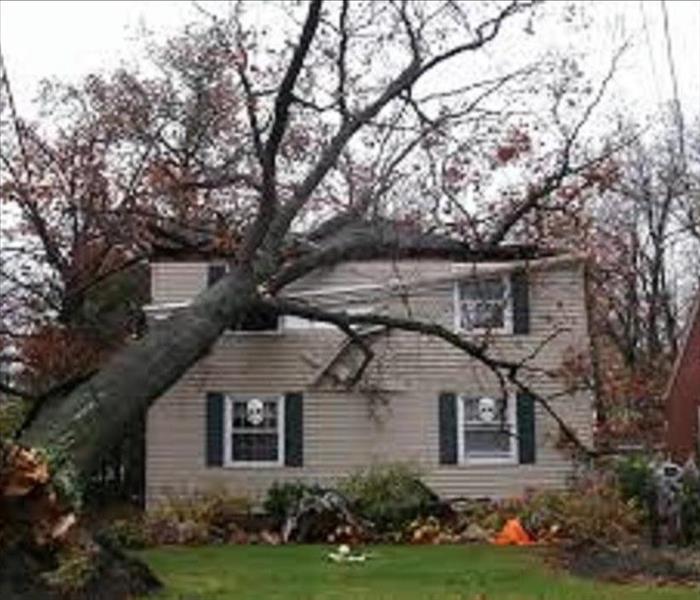 Storm damage in Cherry Hill NJ, Storm Damage in Moorestown NJ,
Storm damage in Cherry Hill NJ, Storm Damage in Moorestown NJ,
Storm damage in Cherry Hill NJ, Storm Damage in Moorestown NJ,
A storm is any disturbed state of an environment or astronomical body's atmosphereespecially affecting its surface, and strongly implying severe weather. It may be marked by significant disruptions to normal conditions such as strong wind, tornadoes, hail, thunder and lightning (a thunderstorm), heavy precipitation (snowstorm, rainstorm), heavy freezing rain (ice storm), strong winds (tropical cyclone, windstorm), or wind transporting some substance through the atmosphere as in a dust storm, blizzard, sandstorm, etc.
Storms have the potential to harm lives and property via storm surge, heavy rain or snow causing flooding or road impassibility, lightning, wildfires, and vertical wind shear; however, systems with significant rainfall and duration help alleviate drought in places they move through. Heavy snowfall can allow special recreational activities to take place which would not be possible otherwise, such as skiing and snowmobiling.
Types
Classic storm of summer, in Sierras de Córdoba, Argentina.
There are many varieties and names for storms:
- Ice storm — Ice storms are one of the most dangerous forms of winter storms. When surface temperatures are below freezing, but a thick layer of above-freezing air remains aloft, rain can fall into the freezing layer and freeze upon impact into a glaze of ice. In general, 8 millimetres (0.31 in) of accumulation is all that is required, especially in combination with breezy conditions, to start downing power lines as well as tree limbs.[3] Ice storms also make unheated road surfaces too slick to drive upon. Ice storms can vary in time range from hours to days and can cripple small towns and large urban centers alike.
- Blizzard — There are varying definitions for blizzards, both over time and by location. In general, a blizzard is accompanied by gale-force winds, heavy snow (accumulating at a rate of at least 5 centimeters (2 in) per hour), and very cold conditions (below approximately -10 degrees Celsius or 14 F). Lately, the temperature criterion has fallen out of the definition across the United States[4]
- Snowstorm — A heavy fall of snow accumulating at a rate of more than 5 centimeters (2 in) per hour that lasts several hours. Snow storms, especially ones with a high liquid equivalent and breezy conditions, can down tree limbs, cut off power, and paralyze travel over a large region.
- Coastal Storm — large wind waves and/or storm surge that strike the coastal zone. Their impacts include coastal erosion and coastal flooding[5]
- Ocean Storm — Storm conditions out at sea are defined as having sustained winds of 48 knots (55 mph or 90 km/h) or greater.[6] Usually just referred to as a storm, these systems can sink vessels of all types and sizes.
- Firestorm — Firestorms are conflagrations which attain such intensity that they create and sustain their own wind systems. It is most commonly a natural phenomenon, created during some of the largest bushfires, forest fires, and wildfires. The Peshtigo Fire is one example of a firestorm. Firestorms can also be deliberate effects of targeted explosives such as occurred as a result of the aerial bombings of Dresden. Nuclear detonations generate firestorms if high winds are not present.
- Dust devil — a small, localized updraft of rising air.
- Wind storm— A storm marked by high wind with little or no precipitation.[7]Windstorm damage often opens the door for massive amounts of water and debris to cause further damage to a structure.[8] European windstorms and derechos are two type of windstorms.[9] High wind is also the cause of sandstorms in dry climates.
- Squall — sudden onset of wind increase of at least 16 knots (30 km/h) or greater sustained for at least one minute.
- Gale — An extratropical storm with sustained winds between 34-48 knots (39-55 mph or 63–90 km/h).[6]
- Thunderstorm — A thunderstorm is a type of storm that generates lightning and the attendant thunder. It is normally accompanied by heavy precipitation. Thunderstorms occur throughout the world, with the highest frequency in tropicalrainforest regions where there are conditions of high humidity and temperature along with atmospheric instability. These storms occur when high levels of condensation form in a volume of unstable air that generates deep, rapid, upward motion in the atmosphere. The heat energy creates powerful rising air currents that swirl upwards to the tropopause. Cool descending air currents produce strong downdraughts below the storm. After the storm has spent its energy, the rising currents die away and downdraughts break up the cloud. Individual storm clouds can measure 2–10 km across.
- Tropical cyclone — A tropical cyclone is a storm system with a closed circulation around a centre of low pressure, fueled by the heat released when moist air rises and condenses. The name underscores its origin in the tropics and their cyclonic nature. Tropical cyclones are distinguished from other cyclonic storms such as nor'eastersand polar lows by the heat mechanism that fuels them, which makes them "warm core" storm systems.
Tropical cyclones form in the oceans if the conditions in the area are favorable, and depending on their strength and location, there are various terms by which they are called, such as tropical depression, tropical storm, hurricane and typhoon.[10]
- Hailstorm — a type of storm that precipitates round chunks of ice. Hailstorms usually occur during regular thunder storms. While most of the hail that precipitates from the clouds is fairly small and virtually harmless, there are occasional occurrences of hail greater than 2 inches (5 cm) in diameter that can cause much damage and injuries.
A tornado in Binger, Oklahoma during the 1981 outbreak.
- Tornado — A tornado is a violent, destructive wind storm occurring on land. Usually its appearance is that of a dark, funnel-shaped cloud. Often tornadoes are preceded by thunderstorms and a wall cloud. They are often called the most destructive of storms, and while they form all over the world, the interior of the United States is the most prone area, especially throughout Tornado Alley.
Classification
A strict meteorological definition of a terrestrial storm is a wind measuring 10 or higher on the Beaufort scale, meaning a wind speed of 24.5 m/s (89 km/h, 55 mph) or more; however, popular usage is not so restrictive. Storms can last anywhere from 12 to 200 hours, depending on season and geography. In North America, the east and northeast storms are noted for the most frequent repeatability and duration, especially during the cold period. Big terrestrial storms alter the oceanographic conditions that in turn may affect food abundance and distribution: strong currents, strong tides, increased siltation, change in water temperatures, overturn in the water column, etc.
Over-flowing Toilets in Moorestown NJ, Sewage backup Haddonfield NJ,
9/14/2017 (Permalink)
Watching water rise to the top edge of a toilet bowl is disconcerting to say the least. But in most cases the water will stop running before overflowing. Many toilet bowls are designed in such a way that they will usually hold the entire contents of the tank without overflowing. However, that's not true for all toilets. If you have a toilet that overflows the rim when the bowl is clogged there are a few things you can do to minimize the problem and save some water. You can't just lower the water level in the tank; you need to displace some of the water in the tank instead while still maintaining the height of the water level at the mark on the back wall of the tank.
Take a plastic bottle and add an inch or so of marbles or gravel before you fill the jar with water and replace the cap; a square two or three liter olive oil jug works great for an old toilet. Flush the toilet a few times to determine whether or not the toilet still flushes waste away. If not, try a smaller bottle or jug. This should work IF the water level in the bowl was at its normal height before the toilet was flushed, and the ballcock and flapper are working properly and shut off when the tank is full.
Another step you can take is to adjust the amount of water that refills the bowl. The bowl is filled with the water that goes into the overflow pipe. The water runs as long as the ballcock is on and running. With a "Fill Cycle Diverter" you can adjust the amount of water going into the bowl and save some more water. This little diverter has four tubes so that you can cut the amount of water in half or three-forths. You need at least one tube going into the overflow pipe. The excess water will go into the tank and the tank will fill faster.
Unfortunately, when a toilet bowl is clogged and the water level rises and doesn't flush the contents away, some people are too hasty and will flush the toilet again hoping the additional water will 'push' the contents of the bowl down. This only causes a toilet bowl to overflow. SO, warn all members of your household, that when the water level in a toilet bowl is higher than normal - DO NOT FLUSH IT AGAIN. You must wait until the water level drops to normal. If it doesn't drop to normal, then you need to find out what is blocking the bowl. But under no circumstances should you flush again.
An overflowing toilet bowl can result in widespread and rather serious consequences. For example, not long ago, the McPherson Square Metro Station in Washington, D.C. lost power for much of the morning after a toilet overflowed in the nearby Lafayette Building, flooding a pair of Potomac Electric Power Co. feeder boxes that provide service to the subway stop, the building above and the U.S. Treasury Annex.
Treat ALL Toilet overflows as Biohazards. Contact a Certified Biohazard cleaning company for the clean up.
Water Damage in Haddonfield NJ, Water Damage in Cherry Hill NJ, and The SERVPRO Emergency READY Profile Advantage, FREE SAMPLE PROFILE, PDF Document,
9/13/2017 (Permalink)
As many as 50% of businesses close down following a disaster, according to the latest research. Of the businesses that survive, the overwhelming majority of them had a preparedness plan in place. Pre-planning can serve as an insurance policy aimed at peace of mind. And knowing you are "Ready for whatever happens" speaks trust to your clients and employees that in the event your business is affected by a disaster, they don’t necessarily have to be.
By developing a SERVPRO Emergency READY Profile for your business, you minimize business interruption by having an immediate plan of action. Knowing what to do and what to expect in advance is the key to timely mitigation and can help minimize how water and fire damage can affect your business.
- A no cost assessment of your facility.
- This means there is no need to allocate funds, giving you a great value at no cost.
- A concise Profile Document that contains only the critical information needed in the event of an emergency.
- It will only take a little time to complete and will not take you away from current projects. But it will save a lot of time if ever needed.
- A guide to help you get back into your building following a disaster.
- This can help minimize the amount of time your business is inactive by having an immediate plan of action.
- Establishes your local SERVPRO Franchise Professional as your disaster mitigation and restoration provider.
- You have a provider that is recognized as an industry leader and close by.
- Identification of the line of command for authorizing work to begin.
- This saves time so we can begin the work of mitigating the damage which can save you time and money.
- Provides facility details such as shut-off valve locations, priority areas and priority contact information.
- Having a quick reference of what to do, how to do it and who to call provides solutions in advance of an emergency so that during the emergency you are "Ready for whatever happens."
Our SERVPRO location can Email you a Sample Copy, of an Emergency Ready Profile!
Post Hurricane Clean Up Tips, Hurricane Irma, Mitigation, SERVPRO,
9/12/2017 (Permalink)
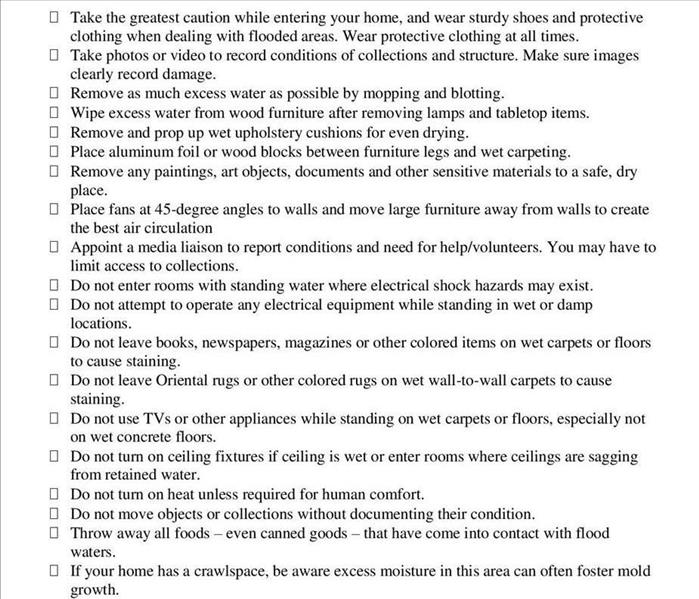 Post Hurricane Clean Up Tips, Hurricane Irma, Mitigation, SERVPRO,
Post Hurricane Clean Up Tips, Hurricane Irma, Mitigation, SERVPRO,
Post Hurricane Clean Up Tips, Hurricane Irma, Mitigation, SERVPRO,
Another Satisfied SERVPRO customer, Awesome Thank you Email, in attached pictures,
9/8/2017 (Permalink)
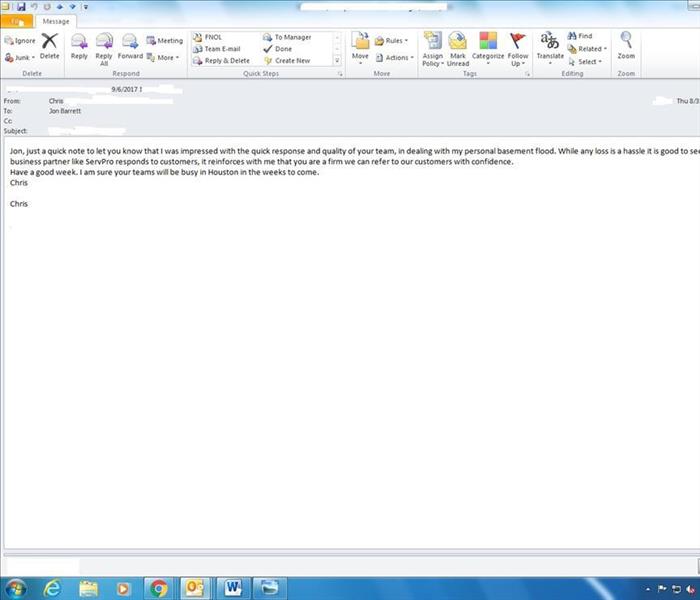 Another Satisfied SERVPRO customer, Awesome Thank you Email, in attached pictures,
Another Satisfied SERVPRO customer, Awesome Thank you Email, in attached pictures,
Another Satisfied SERVPRO customer, Awesome Thank you Email, in attached pictures,
Water Damage in Haddonfield NJ, Commercial Water damage in Mt. Laurel NJ, Water damage in Haddonfield NJ, SERVPRO Checklist,
9/7/2017 (Permalink)
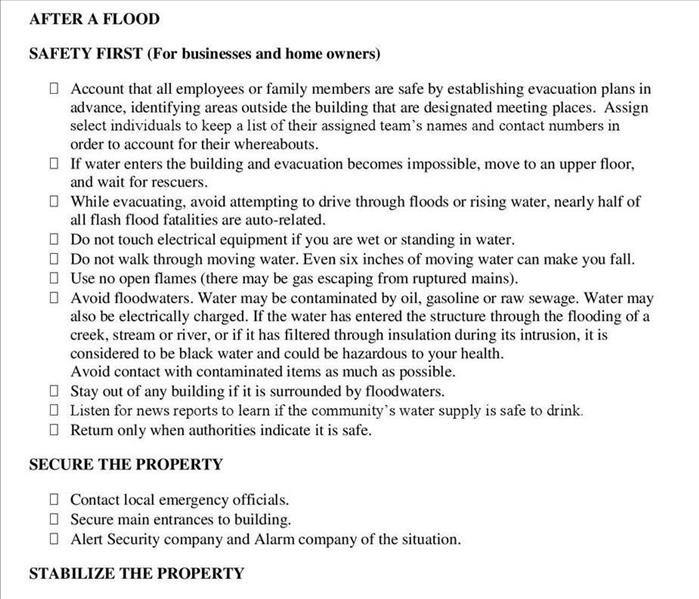 Water Damage in Haddonfield NJ, Commercial Water damage in Mt. Laurel NJ, Water damage in Haddonfield NJ, SERVPRO Checklist,
Water Damage in Haddonfield NJ, Commercial Water damage in Mt. Laurel NJ, Water damage in Haddonfield NJ, SERVPRO Checklist,
Water Damage in Haddonfield NJ, Commercial Water damage in Mt. Laurel NJ, Water damage in Haddonfield NJ, SERVPRO Checklist,
A Fast Response Is Crucial
In many cleaning and restoration situations, immediate action is needed. With over 1,700 U.S. and Canadian Franchise locations, SERVPRO is strategically positioned to be faster to any size emergency.
An immediate response helps to minimize the damage and the cleaning and restoration costs.
Water is particularly invasive, quickly spreading throughout your property and being absorbed into floors, walls, furniture, etc. SERVPRO Franchise Professionals arrive quickly and start the water extraction process almost immediately.
Water Damage Timeline
Within Minutes:
- Water quickly spreads throughout your property, saturating everything in its path.
- Water is absorbed into walls, floors, upholstery, and belongings.
- Furniture finishes may bleed, causing permanent staining on carpets.
- Photographs, books, and other paper goods start to swell and warp.
Hours 1 - 24:
- Drywall begins to swell and break down.
- Metal surfaces begin to tarnish.
- Furniture begins to swell and crack.
- Dyes and inks from cloth and paper goods spread and stain.
- A musty odor appears.
48 Hours to 1 Week:
- Mold and mildew may grow and spread.
- Doors, windows, and studs swell and warp.
- Metal begins to rust and corrode.
- Furniture warps and shows signs of mold.
- Paint begins to blister.
- Wood flooring swells and warps.
- Serious biohazard contamination is possible.
More Than 1 Week:
- Restoration time and cost increase dramatically; replacing contaminated materials and structural rebuilding may be extensive.
- Structural safety, mold growth, and biohazard contaminants pose serious risks to occupants.
Hurricane Checklist, Be Prepared, Stay Safe, SERVPRO, Cherry Hill NJ, water damage in Cherry Hill NJ, flood damage in cherry Hill nj,
9/6/2017 (Permalink)
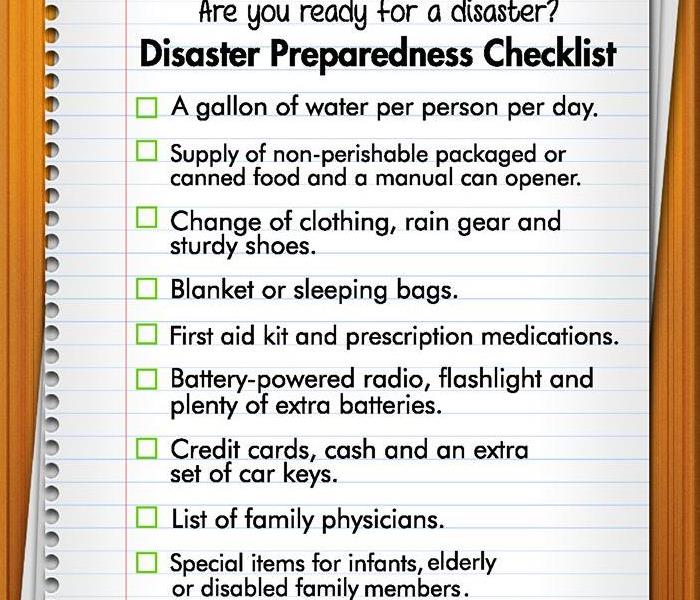 Hurricane Checklist, Be Prepared, Stay Safe, SERVPRO, Cherry Hill NJ, water damage in Cherry Hill NJ, flood damage in cherry Hill nj,
Hurricane Checklist, Be Prepared, Stay Safe, SERVPRO, Cherry Hill NJ, water damage in Cherry Hill NJ, flood damage in cherry Hill nj,
Hurricane Checklist, Be Prepared, Stay Safe, SERVPRO, Cherry Hill NJ, water damage in Cherry Hill NJ, flood damage in cherry Hill nj,
A Fast Response Is Crucial
In many cleaning and restoration situations, immediate action is needed. With over 1,700 U.S. and Canadian Franchise locations, SERVPRO is strategically positioned to be faster to any size emergency.
An immediate response helps to minimize the damage and the cleaning and restoration costs.
Water is particularly invasive, quickly spreading throughout your property and being absorbed into floors, walls, furniture, etc. SERVPRO Franchise Professionals arrive quickly and start the water extraction process almost immediately.
Water Damage Timeline
Within Minutes:
- Water quickly spreads throughout your property, saturating everything in its path.
- Water is absorbed into walls, floors, upholstery, and belongings.
- Furniture finishes may bleed, causing permanent staining on carpets.
- Photographs, books, and other paper goods start to swell and warp.
Hours 1 - 24:
- Drywall begins to swell and break down.
- Metal surfaces begin to tarnish.
- Furniture begins to swell and crack.
- Dyes and inks from cloth and paper goods spread and stain.
- A musty odor appears.
48 Hours to 1 Week:
- Mold and mildew may grow and spread.
- Doors, windows, and studs swell and warp.
- Metal begins to rust and corrode.
- Furniture warps and shows signs of mold.
- Paint begins to blister.
- Wood flooring swells and warps.
- Serious biohazard contamination is possible.
More Than 1 Week:
- Restoration time and cost increase dramatically; replacing contaminated materials and structural rebuilding may be extensive.
- Structural safety, mold growth, and biohazard contaminants pose serious risks to occupants.
What a Property Inspection Checks For, and What's Not Included, Water damage in Haddonfield NJ, Water damage in Mt. Laurel NJ,
8/30/2017 (Permalink)
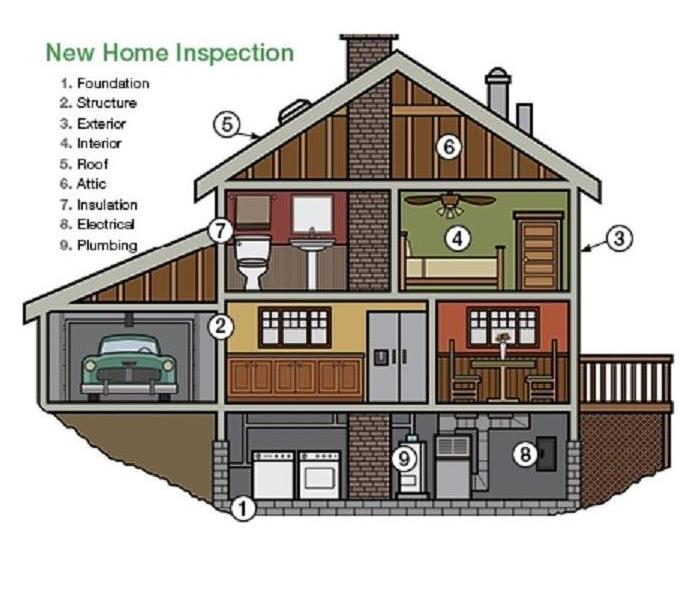 What a Property Inspection Checks For, and What's Not Included, Water damage in Haddonfield NJ, Water damage in Mt. Laurel NJ,
What a Property Inspection Checks For, and What's Not Included, Water damage in Haddonfield NJ, Water damage in Mt. Laurel NJ,
What a Property Inspection Checks For, and What's Not Included, Water damage in Haddonfield NJ, Water damage in Mt. Laurel NJ,
A Property is probably the biggest purchase you'll ever make, so when you buy a Property it's important to be sure your potential new Property has a proper inspection before you sign the papers. Getting a qualified home inspector can be an important first step.
A home inspector is a qualified professional who visually inspects the structure and components of a home and looks for any immediate or potential problems. They provide a written report to you with a description of problem areas and may also include recommendations for further evaluation.
You can go over the report with your real estate agent to decide how the results may affect the purchase of your potential home.
What they inspect
Home inspection requirements vary greatly from state to state, but the American Society of Home Inspectors (ASHI) has a Standards of Practice page that outlines minimum and uniform standards that you should expect from an inspection. They include the following:
- Structural elements: Construction of visible foundation, evidence of sagging or bowing of the structure, and window alignment
- Safety: Operating fire and carbon monoxide alarms, fire sprinklers, condition of stairs, hand and guardrails, and garage door openers.
- Grounds: Leaks from septic tank, proper drainage, and condition of the house's driveways, fences, and sidewalks
- Roof: Condition of shingles, any repairs/patches to flat roofs, clear vents, damage to chimneys, and properly working gutters
- Exterior surfaces: Correct clearance between ground and siding material, condition of exterior paint or siding, and properly working lights and electrical outlets
- Attic: Sufficient insulation, proper ventilation, and any sign of leaking or water damage
- Interior plumbing: No damaged or leaking pipes, proper hot water temperature, as well as functioning toilets, sinks, bathtubs, and showers
- Electrical system: Up-to-code condition and type of visible wiring, and proper function of circuit breakers, outlets, light fixtures, and fans
- Appliances: Proper function of stove, dishwasher, refrigerator, microwave, washer and dryer, and all other appliances
- Heating and cooling systems: Condition of furnace, air conditioning (temperature permitting), water heater, chimney, and fireplace
- Basement: Solid foundation, walls, and floors, with no signs of water intrusion or damage
- Garage: Solid foundation, windows, ceiling, framing, and roof; working garage door opener; up-to-code electrical system; and proper function of outlets
What they don't inspect
Again, while there is variation of what home inspectors look for, there are areas that are generally not covered by a home inspection. If you suspect any problems or concerns in the following areas, you may want to schedule an evaluation by a certified specialist:
- Pest control
- Swimming pools
- Asbestos
- Radon gas
- Lead paint
- Toxic mold
What will it cost?
The inspection fee for a typical one-family house varies geographically, as does the cost of housing. Similarly, within a given area, the inspection fee may vary depending on a number of factors such as the size of the house, its age and possible optional services such as septic, well or radon testing.
Do not let cost be a factor in deciding whether or not to have a home inspection or in the selection of your home inspector. The sense of security and knowledge gained from an inspection is well worth the cost, and the lowest-priced inspection is not necessarily a bargain. Use the inspector’s qualifications, including experience, training, compliance with your state’s regulations, if any, and professional affiliations as a guide.
Why can't I do it myself?
Even the most experienced homeowner lacks the knowledge and expertise of a professional home inspector. An inspector is familiar with the elements of home construction, proper installation, maintenance and home safety. He or she knows how the home’s systems and components are intended to function together, as well as why they fail.
Above all, most buyers find it difficult to remain completely objective and unemotional about the house they really want, and this may have an effect on their judgment. For accurate information, it is best to obtain an impartial, third-party opinion by a professional in the field of home inspection.
Finding a home inspector
Be sure you are comfortable with your choice of home inspector. They are extremely important and can help you detect and avoid major pitfalls in the home buying process.
- Talk to your real estate professional. They may be able to recommend a home inspector that they have worked with in the past and trust.
- Ask friends and family. If you know anyone who has recently gone through the home buying process, they may have a good recommendation.
- Look for accredited affiliations. Consumers should look for an inspector who has an affiliation with groups such as the National Institute of Building Inspectors, the American Society of Home Inspectors, and the International Society of Certified Home Inspectors. These are some of the most reputable inspector associations, and their Web sites have a 'find an inspector' service to locate a member in your area.
The National Flood Insurance Program, (NFIP), Flood Damage in Cherry Hill NJ, Water damage in Cherry Hill NJ, Flood damage in Haddonfield NJ,
8/29/2017 (Permalink)
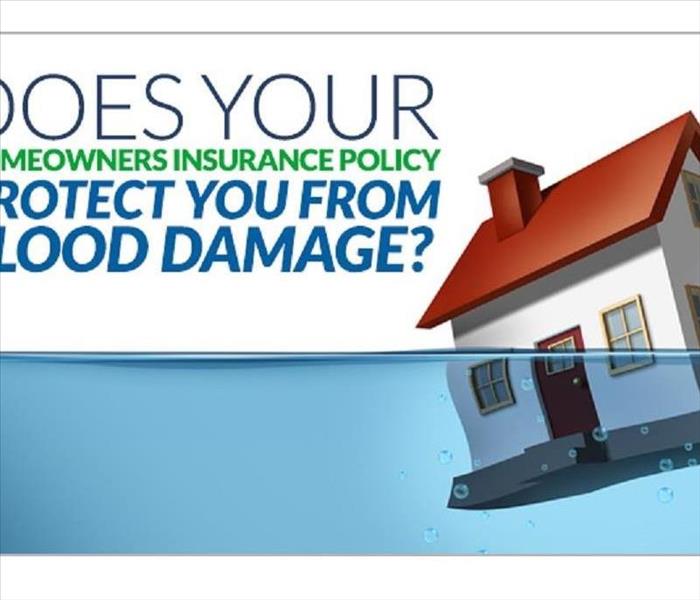 The National Flood Insurance Program, (NFIP), Flood Damage in Cherry Hill NJ, Water damage in Cherry Hill NJ, Flood damage in Haddonfield NJ,
The National Flood Insurance Program, (NFIP), Flood Damage in Cherry Hill NJ, Water damage in Cherry Hill NJ, Flood damage in Haddonfield NJ,
The National Flood Insurance Program aims to reduce the impact of flooding on private and public structures. It does so by providing affordable insurance to property owners and by encouraging communities to adopt and enforce floodplain management regulations. These efforts help mitigate the effects of flooding on new and improved structures. Overall, the program reduces the socio-economic impact of disasters by promoting the purchase and retention of general risk insurance, but also of flood insurance, specifically. Signup to receive email updates.
I don't have flood insurance--Why do I need it?
FACT: Floods are the nation’s most common and costly natural disaster and cause millions of dollars in damage every year.
FACT: Homeowners and renters insurance does not typically cover flood damage.
FACT: Floods can happen anywhere--More than 20 percent of flood claims come from properties outside the high risk flood zone.
FACT: Flood insurance can pay regardless of whether or not there is a Presidential Disaster Declaration.
FACT: Most federal disaster assistance comes in the form of low-interest disaster loans from U.S. Small Business Administration (SBA) and you have to pay them back. FEMA offers disaster grants that don't need to be paid back, but this amount is often much less than what is needed to recover. A claim against your flood insurance policy could and often does, provide more funds for recovery than those you could qualify for from FEMA or the SBA--and you don't have to pay it back.
FACT: You may be required to have flood insurance. Congress has mandated federally regulated or insured lenders to require flood insurance on mortgaged properties that are located in areas at high risk of flooding. But even if your property is not in a high risk flood area, your mortgage lender may still require you to have flood insurance.
Flood insurance helps more: Check out your state's flood history with FEMA's interactive data visualization tool. Roll your cursor over each county to see how many flooding events have happened. The tool allows you to compare how much FEMA and the U.S. Small Business Administration have provided in terms of federal disaster aid after Presidential Disaster Declarations to the amount the National Flood Insurance program has paid to its policyholders. It's easy to see that having flood insurance provides a lot more help for recovery.
If you are a renter or homeowner (residential policy); or business owner (non-residential policy) and your property is located in a NFIP-participating community, you can purchase a policy. Contact your insurance agent to find out if your community participates in the National Flood Insurance Program.
Flood insurance from the NFIP is only available in participating communities. Ask your agent if your state and community participate, or look it up online
Did you know? An elevated home, with a first floor elevated 3 feet above the base flood elevation, can expect to save 60 percent or more on annual flood insurance premiums.
Did you know? Elevating just one foot above the Base Flood Elevation often results in a 30% reduction in annual premiums.
9 Affordable Ways to Dry Up Your Wet Basement For Good, Water damage in Cherry Hill NJ, Water damage in Moorestown NJ,
8/28/2017 (Permalink)
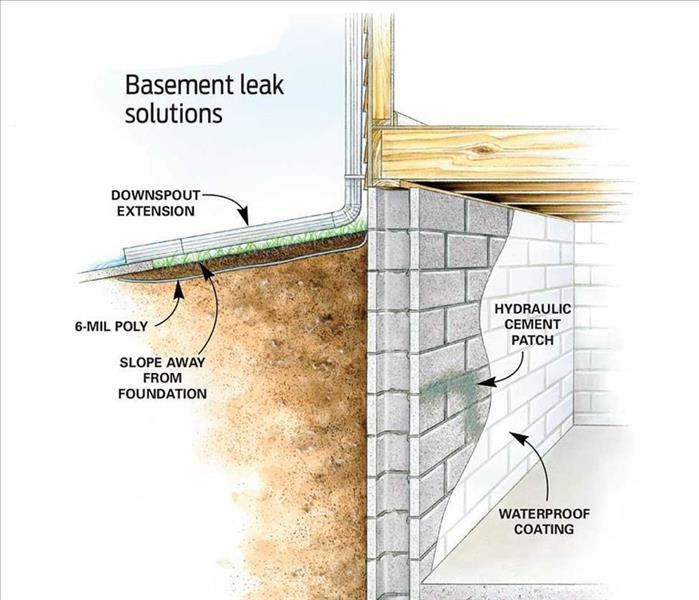 9 Affordable Ways to Dry Up Your Wet Basement For Good, Water damage in Cherry Hill NJ, Water damage in Moorestown NJ,
9 Affordable Ways to Dry Up Your Wet Basement For Good, Water damage in Cherry Hill NJ, Water damage in Moorestown NJ,
9 Affordable Ways to Dry Up Your Wet Basement For Good, Water damage in Cherry Hill NJ, Water damage in Moorestown NJ,
Diagnose the Water Problem
Water or moisture in basements comes from two sources. One source is indoor humidity that condenses on cold surfaces, much like water droplets form on a cold drink on a humid day. The other is water—or water vapor—that comes from outside. Rainwater, melting snow or groundwater can saturate the soil around your foundation and leak in. Water can leak through cracks, or it can penetrate porous concrete or masonry walls in the form of water vapor. To figure out what's causing the problem, tape aluminum foil to your basement wall and inspect it a few days later. Moisture on the outside surface of the foil indicates high indoor humidity. Moisture behind the foil means moisture is leaking through the walls.
Get Rid of Excess Humidity
Eliminating the sources of humid air will help dry out your basement. Seal leaky dryer vents with foil tape to prevent unwanted humid air from entering your basement. Don't just use duct tape; it'll eventually fall off. Add a vent fan to your basement bathroom and make sure your family turns it on during showers. Keep your basement windows closed during humid weather. And if you're still getting condensation on cool surfaces, run a dehumidifier to lower the indoor humidity.
Insulate Pipes
Condensation dripping from cold pipes can contribute to basement water problems. Cover cold water pipes with foam pipe insulation to stop condensation. The foam insulation is inexpensive and easy to cut with scissors.
Insulate Walls
Insulate exterior walls to prevent condensation. In cold climates, insulating basement walls also saves energy and reduces your heating bill. But don't cover the walls with insulation if water is leaking in from outside; you'll just create a potential mold problem.
Keep Water Away From the Foundation
If your basement leaks after heavy rains or after snow melts, making sure water is diverted away from your foundation may solve the problem. It's common for the soil alongside your house to settle over time, creating a moat that collects runoff and directs it down your foundation wall and into the basement. Lawn edging and gravel along the foundation can make things worse. Solve the problem by creating a 6-ft.-wide slope that drops about 4 in. away from the foundation. For extra insurance, cover the sloping soil with a layer of 6-mil poly. Then hide the poly with mulch, gravel or a layer of soil covered with grass. This will keep water from soaking in near the foundation.
Add Gutters and Extend Downspouts
If your basement leaks after it rains and you don't have gutters, consider adding them. Gutters catch the rain and channel it to the downspouts, which direct it away from the house. Whether you're installing new gutters or already have them, be sure the downspouts have 4- to 6-ft. horizontal extensions to move the water away from the house.
Plug Holes and Cracks in the Foundation
Holes and cracks in your foundation can let moisture and water seep into your basement. Plugging them probably won't solve basement leaks, but it'll help. Hydraulic cement works great for patching holes in a foundation because it can set up even under water, and it expands as it sets to seal the hole and lock the plug in place. Use a cold chisel or an angle grinder fitted with a masonry-cutting disc or diamond blade to enlarge the hole or crack into an inverted “V,” with the narrow part of the “V” on the surface of the wall. Then follow the package instructions for mixing and using the hydraulic cement.
Waterproof the Walls
Waterproofing materials that go on like paint fill the pores in the concrete or masonry walls and prevent water from leaking in. To be effective, these coatings must be applied to bare concrete or masonry walls. Start by removing loose material with a wire brush. Then clean off any white powdery “efflorescence” with masonry cleaner. Follow the safety and application instructions carefully. A common mistake when using masonry waterproofing products is to spread them too thin. The goal is to fill every pinhole to create a continuous waterproofing membrane. Brush the coating in all directions to completely fill every pinhole. Add a second coat after the first dries.
Install a Drainage System
The best permanent fix for chronic basement leaks is to install drainage tubing below the basement floor that's connected to a sump basket and pump. You can install a system like this yourself, but breaking out the concrete floor, burying the tubing, and patching the floor is a lot of backbreaking work. Materials to do an average basement will cost $600 to $1,000. Expect to spend $3,000 to $8,000 for a professionally installed system in a standard-size basement.
Essential Property-Selling Tips, Water damage in Cherry Hill NJ, Water damage in Moorestown NJ, Fire damage in Cherry Hill NJ,
8/25/2017 (Permalink)
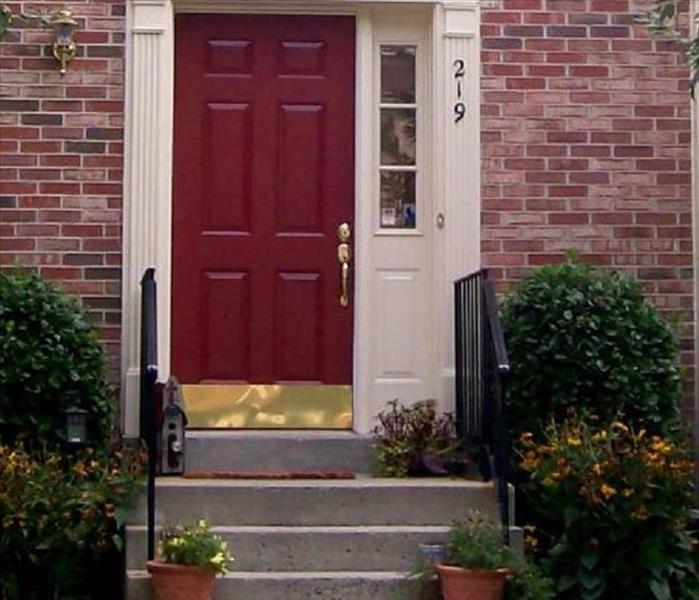 Essential Property-Selling Tips, Water damage in Cherry Hill NJ, Water damage in Moorestown NJ, Fire damage in Cherry Hill NJ,
Essential Property-Selling Tips, Water damage in Cherry Hill NJ, Water damage in Moorestown NJ, Fire damage in Cherry Hill NJ,
Essential Property-Selling Tips, Water damage in Cherry Hill NJ, Water damage in Moorestown NJ, Fire damage in Cherry Hill NJ,
Crank up the curb appeal
Pull weeds, rake leaves and trim overgrown shrubs, especially if they block windows or the path to your front door.
Paint
It's important to make your house generic. A fresh coat of neutral paint will make your home appear larger, brighter and more appealing to potential buyers.
A clean and uncluttered kitchen is a staple of home staging.
Make repairs
Fix things like leaky faucets and sticky cabinets, and replace old screens. They may seem insignificant, but minor repairs add up in the mind of a potential buyer. They tend to overestimate how much repairs cost. You don't want to give them any reason not to put in an offer.
Rearrange
Lighten up your home with natural tones and a neutral dose of style.
Make sure your furniture placement allows for easy traffic flow and shows the purpose of each room. If you have too much furniture, rent a portable storage device to hold things until you are ready to move into your new place. If you don't have enough furniture, borrow or rent.
Pack up
This includes personal photos and portraits. Less is always more. The less clutter and knickknacks you have lying around, the more potential buyers will be able to see your home and what it offers. Remember, you are selling your house, not your stuff. Plus, getting a head start on packing will eliminate some stress down the road.
Tip: Print out this checklist, and mark each item off as you get your house ready to sell.
1. Eliminate half of your belongings as clutter can cost a sale. Rent a storage unit or portable pod for extraneous pieces of furniture or knickknacks. Another idea is to ask a friend if you can borrow some space in his or her garage.
2. Use "home wash" (hose attachment available at home improvement stores) to clean the outside of the house.
3. Clean rain gutters as well as outside windows and screens.
4. Make sure the front door is inviting. Paint the door if needed. Also, replace any outdated outdoor lighting fixtures.
5. Buy new house numbers if the old ones are dated or faded. Be sure buyers can see the new ones from the curb.
6. Buy a new welcome mat.
7. Organize all closets and drawers. Buyers might look there.
8. Make any necessary repairs so that buyers don't have to add that to their list of expenses.
9. Rearrange furniture to make rooms appear as large as possible.
10. Make every surface shine, from ceiling fans to baseboards. Don't forget interior windows, mirrors and floors.
11. Scrub every inch of the kitchen and bathrooms.
12. Depersonalize each room, removing photo frames and posters or artwork.
13. Buy new linens and pillows if necessary. Be certain they are a neutral color.
14. Buy air neutralizer and spray it often.
15. Let go emotionally of you, and get ready for an offer!
What is Tenant, Renters Insurance? Water damage in Mt. Laurel NJ, Water damage in Moorestown NJ,
8/24/2017 (Permalink)
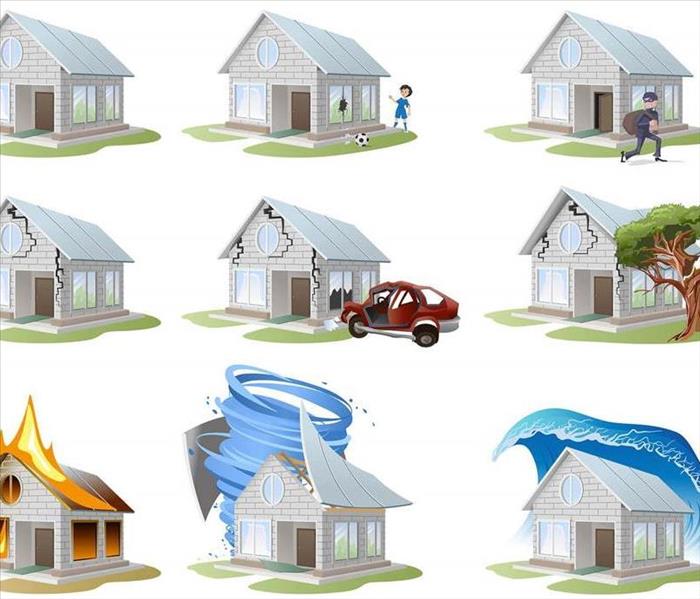 What is Tenant, Renters Insurance? Water damage in Mt. Laurel NJ, Water damage in Moorestown NJ,
What is Tenant, Renters Insurance? Water damage in Mt. Laurel NJ, Water damage in Moorestown NJ,
What is Tenant, Renters Insurance? Water damage in Mt. Laurel NJ, Water damage in Moorestown NJ,
Many renters are under the impression that their landlord’s insurance policy will cover their belongings, unfortunately that generally is not the case. Your landlord’s policy covers the building itself, but it may not include your personal belongings, and may not cover injuries sustained within the structure. That’s where renters insurance comes in.
Renters insurance protects your personal property in a rented apartment, condo or home from unexpected circumstances such as theft, a fire or sewer backup damage – and will pay you for lost or damaged possessions. It can also help protect you from liability if someone is injured on your property.
Renters insurance is similar in scope to homeowners insurance, with the exception that it does not provide coverage for the dwelling itself or other structures.
How does Tenant, renters insurance work?
If you experience a covered loss in your rented space, renters insurance can help to cover the associated costs. The amount covered will depend on the type of loss that occurred and the amount of coverage you have.
There are two types of coverage options under a typical renters policy: Actual Cash Value coverage and Replacement Cost coverage. Here’s the difference between the two:
- Actual Cash Value coverage will reimburse you for the value of the items at the time of the damage or loss.
- Replacement Cost coverage covers the cost it takes to replace the items lost or damaged.
What does Tenant, renters insurance cover?
A renters insurance policy offers you coverage for the loss or destruction of your personal belongings in the event of a covered peril such as:
- Fire
- Lightning
- Windstorm
- Hail
- A frozen plumbing system
- Theft
- Vandalism
- Impact by a vehicle
Renters insurance may also cover you if:
You are forced to temporarily move out of your home: In the event your home becomes unlivable due to damage caused by a covered instance such as a fire or vandalism, renters insurance can help cover the cost of alternative living arrangements while your home is repaired or rebuilt.
A person is injured on your property and requires medical attention: Personal liability coverage is designed to protect you, as well as other individuals who visit your home, if an accident were to occur. This type of coverage will help pay for medical costs and legal fees that you could end up incurring.
Items you keep inside your car are damaged or lost: Depending on your renters insurance policy, you may be covered for belongings that you keep inside your car. Note that this coverage does not include equipment or systems installed in the car.
What does Tenant, renters insurance not cover?
Now that you have a basic idea of what renters insurance covers, it’s important to understand what a basic renters insurance policy does not cover so that you’re prepared:
- Valuables. Expensive collectables and valuables such as jewelry may not be covered under a basic renters policy and may require additional coverage.
- Home business. Operating a small business out of your home doesn’t mean it will be covered by your renters insurance. For instance, if your business laptop is stolen from your apartment, there’s a chance it could be considered business property and therefore, won’t be completely covered by your renters insurance. Check with your provider to see if your policy covers a home business or if you need additional coverage.
- Motorized vehicles. Use or ownership of a motor vehicle will not be covered by your renters insurance even if it is parked on your property (this also applies to aircraft and specific watercraft). Personal belongings kept inside the vehicle, however, are typically covered.
Also, remember to always make sure to thoroughly read through your policy so that you have an understanding of what is and isn’t covered.
Overlooking Mitigating Water Leak Risks, Water Damage in Cherry Hill NJ, Flood Damage in Cherry Hill NJ,
8/23/2017 (Permalink)
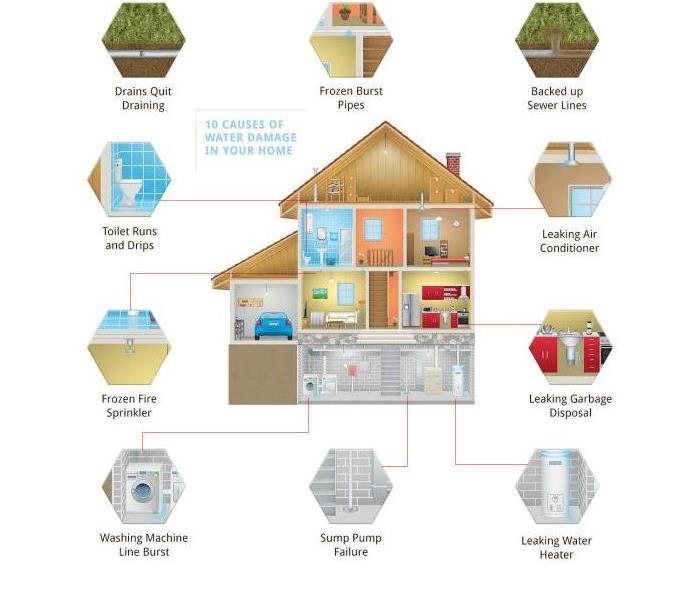 Overlooking Mitigating Water Leak Risks, Water Damage in Cherry Hill NJ, Flood Damage in Cherry Hill NJ,
Overlooking Mitigating Water Leak Risks, Water Damage in Cherry Hill NJ, Flood Damage in Cherry Hill NJ,
Overlooking Mitigating Water Leak Risks, Water Damage in Cherry Hill NJ, Flood Damage in Cherry Hill NJ,
The majority of homeowners do not view internal water leak damage as the most concerning home threat, despite the fact that water leaks are a more frequent risk than fire and theft.
Nearly 80 percent of homeowners overlook threat of costly water leaks while on vacation, the survey found.
Instances of water damage have been rising dramatically. In the past 10 years, the frequency of sudden pipe bursts has nearly doubled. In 2015, water damage accounted for nearly half of all property damage, according to the Insurance Information Institute. An online survey of 1,200 homeowners finds that just 8 percent of homeowners correctly identify August as the month with the most water leak events, and when subsequently heading out on a late-summer vacation, just 22 percent shut off the water main (despite 88 percent knowing where it is located within their home).
While homeowners are particularly vulnerable during the summer travel season, the study finds many face year-round water exposures. For instance, despite the fact that 91 percent of homeowners rate themselves as “vigilant” or “doing an okay job” at preventative home maintenance, and that close to half (45 percent) have or know someone who has experienced a water leak in the past two years, only 18 percent have installed a water leak detection device.
Of all homeowners, high-net-worth individuals are particularly at risk. When compared against other income segments, for instance, high-net-worth individuals are the most likely (55 percent) to report being “vigilant” about conducting preventative maintenance, yet are the least likely (26 percent) to rank internal water leaks as their top home-related concern. High-net-worth homeowners are also the income group least likely to periodically inspect appliance hoses (33 percent compared to 61 percent of middle class homeowners, the most of any income group), a frequent cause of internal water leaks. The adoption of certain preventative home maintenance devices, including fire, carbon monoxide and security systems, is standard practice among the majority of all homeowners, regardless of income, as they address what are perceived to be the most common property risks, But internal water leaks are a leading cause of property damage. With 57 percent of homeowners who have experienced a water leak claim in the past two years spending $5,000 or more on clean up and repair costs — and 15 percent spending $20,000 or more — many are overlooking their exposure at a significant cost.
- The majority of homeowners (63 percent) cite the threat of relocating for an extended period of time (between one month and a year) as their first or second most potentially concerning water damage-related event. With the window for a quick restoration closing just 72 hours after a leak, extended relocation is a real possibility homeowners must contend with.
- A quarter of all homeowners have never had their appliances inspected, despite being the surest way to prevent a leak from occurring.
- Many homeowners also cited the loss of irreplaceable items (59 percent) and repairing structural damage (46 percent) as the top most potentially concerning water damage-related events.
- The majority of homeowners are unfamiliar with the most common sources of internal water leaks, with close to half (49 percent) identifying the water heater as the most likely source (independent analyses indicate plumbing supply systems pose the greatest risk)
Best Property Improvement Investments, Water Damage in Mt. Laurel NJ, Fire Damage in Mt. Laurel NJ,
8/22/2017 (Permalink)
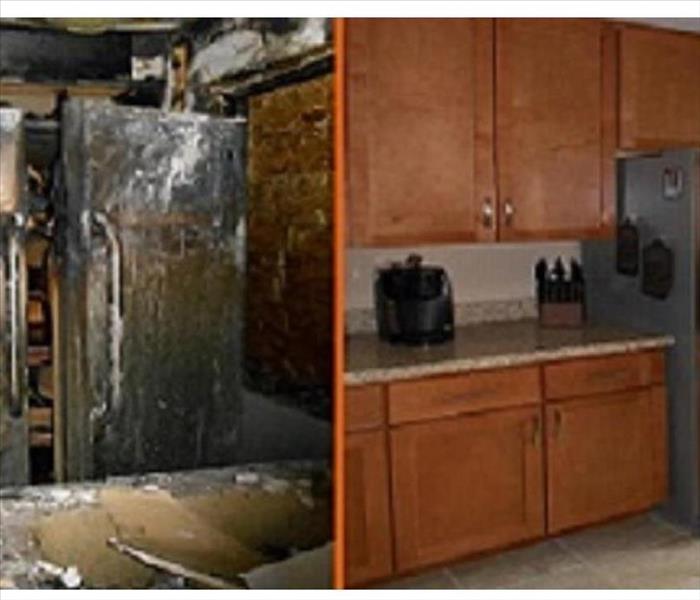 Best Property Improvement Investments, Water Damage in Mt. Laurel NJ, Fire Damage in Mt. Laurel NJ,
Best Property Improvement Investments, Water Damage in Mt. Laurel NJ, Fire Damage in Mt. Laurel NJ,
Best Property Improvement Investments, Water Damage in Mt. Laurel NJ, Fire Damage in Mt. Laurel NJ,
Renovating your Property is a numbers game. How much do you have to spend to fix up your Property and what will it get you in return? When is it worth it to spend more on high-end finishes to get a better return on investment (ROI)? What are the best renovation projects and features that will appeal to the widest range of buyers when you decide to sell?
Home buying and design style are intensely personal choices, and not everyone will love the changes you make.
By swapping out certain elements in your home, adding keywords to your listing, and playing up certain aspects of your house, you may be able to increase your resell value and sell your home faster.
Kitchen updates
The kitchen is one of the places that buyers look closely at when considering whether or not they will purchase your property. A full-gut kitchen renovation averages a 75 percent return rate (i.e., average cost: $30,000; resale value/ROI: $22,500). However, you may be able to get more or less value depending on what parts you choose to renovate and which you leave as-is. Let’s take a look at individual updates and keyword listings to see what may be more worth your time and money.
Bathroom updates
Bathrooms are also a big factor home buyers consider, especially when it comes to the master bathroom. A full bathroom renovation will set you back, on average $12,000, and the resale value can average around $10,440 or 87 percent. However you don’t have to do it all. Ditch the cracked porcelain sink for a classy stand-alone pedestal sink, or trade out your dribbling shower head for a luxurious massaging one.
Integrate granite or quartz counters
Cost Estimate: $50 to $150 per square foot (depending on material)
Keyword in Listing Description Granite: Overall sold for 4% above expected value and 38 days sooner
Keyword in Listing Description Quartz: Overall sold for 6% above expected value and 50 days sooner
General home upgrades
There are a lot of other areas in your home that can be updated with a well-planned swap that could give you additional cash when it comes time to sell. Exchange dated brassy light fixtures for modern can lights and hanging pendants. Replace dead plants and finicky trees with vibrant flowers and shrubs in your front yard for a potential ROI of up to150 percent. From house-wide changes, like new windows to specific appliances, like the water heater, sometimes it’s the “boring” swaps that will make your home that much more appealing to potential buyers.
Install efficient windows
Cost Estimate: $400 to $600 per window (including installation)
Potential ROI: $460 to $690 per window
Water Damage in Moorestown NJ, Water damage can be deceptive, Flood Damage in Haddonfield NJ,
8/21/2017 (Permalink)
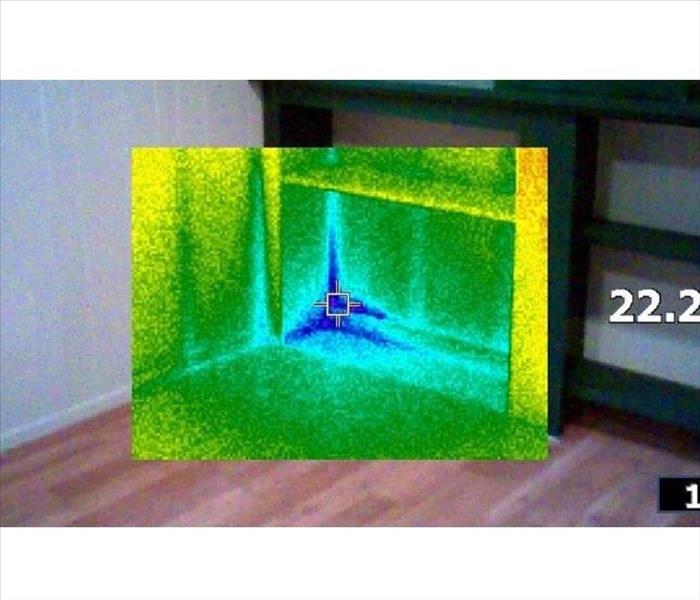 Water Damage in Moorestown NJ, Water damage can be deceptive, Flood Damage in Haddonfield NJ,
Water Damage in Moorestown NJ, Water damage can be deceptive, Flood Damage in Haddonfield NJ,
Water Damage in Moorestown NJ, Water damage can be deceptive, Flood Damage in Haddonfield NJ,
Water damage can be deceptive. Water penetrates into structural cavities creating trapped pockets of saturation. The detection of water in these areas can often only be discovered with sophisticated moisture detection meters.
Undetected moisture will continue to cause damage. This damage, at a minimum, will cause odors. Greater damage will surface when materials delaminate, shrink, split and further deteriorate to where costly repairs are required.
More than just removing excess water, IICRC-certified restorers have the knowledge and equipment to further dry a home or facility (including substructure materials) completely back to preloss conditions. Through timely response and the careful monitoring of water damage, mold and other health issues can be prevented. If water damage has been present too long, mold will occur.
All IICRC-certified professionals have the training and experience to identify moisture sources, evaluate mold growth (visible or suspected), contain damage, remove contamination and dry materials to ensure that mold will not return.
While there are many methods for drying structural components and contents, the “in-place” drying system has been taught in the industry and used by drying contractors since the early ’80s. In those days, this method of drying components, without significant removal of furnishings or fixtures, was somewhat restricted, due to limitations imposed by extraction, evaporation and dehumidification equipment. In recent years, however, drying technology (extraction, evaporation, dehumidification), along with better understanding of psychrometry, has advanced in major ways so that in-place drying has, in some cases, become far more safe and practical.
Sewage Cleaning in Haddonfield NJ, Sewage Backup in Moorestown NJ, and Prevention Tips..
8/17/2017 (Permalink)
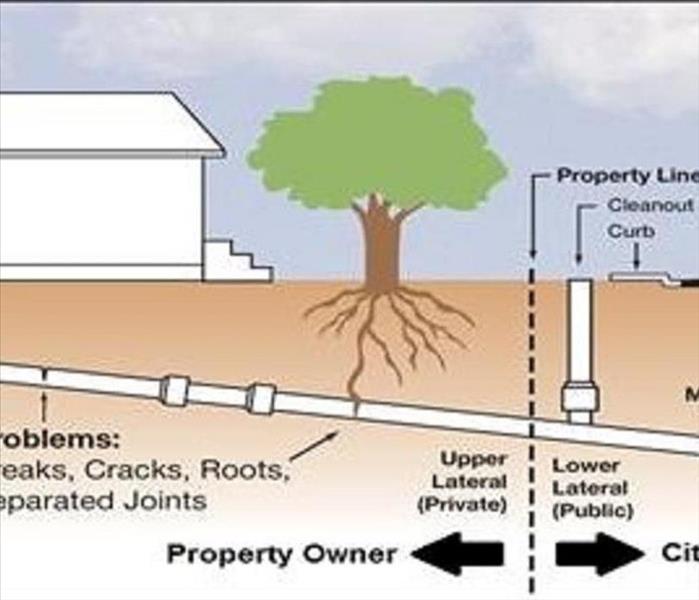 Sewage Cleaning in Moorestownl NJ, Sewage Backup in Moorestown NJ, and Prevention Tips..
Sewage Cleaning in Moorestownl NJ, Sewage Backup in Moorestown NJ, and Prevention Tips..
Backed up sewers can wreak havoc on a home, causing thousands of dollars in damage to floors, walls, furniture and electrical systems. Sewer backup coverage is available from most insurers for a nominal cost—usually an additional annual premium of $40-$50.
For homes that have been severely damaged and are uninhabitable, homeowners policies may provide Loss of Use coverage, which provides reimbursement for lodging, food and other living expenses you may incur as a result of having to live outside of your home. Loss of Use coverage also reimburses you for the lost rental income if you rent out part of the house.
Causes of Sewer Backup
Aging Sewer Systems: The Civil Engineering Research Foundation reports that the number of backed up sewers is increasing at an alarming rate of about 3 percent annually. In addition, a recent report from the American Society of Civil Engineers indicates that the nation's 500,000-plus miles of sewer lines are on average over thirty years old. The increase in the number of homes connected to already aging sewage systems has also contributed to rapid increases in sanitary sewer backups, flooded basements and overflows.
Combined Pipelines: Problems also arise in systems that combine storm water and raw sewage into the same pipeline. During many rain storms, the systems are exposed to more volume than they can handle, and the result is a sewage backup situation that allows sewage to spew out into basements and other low lying drains.
Blockages Due to Tree Roots: Shrubs and trees seeking moisture will make their way into sewer line cracks. These roots can cause extensive damage. They may start out small, getting into a small crack in the pipe; but as the tree or shrub continues to grow, so does the root. Tree roots can enter the service pipe at joints and cause blockages. Tree roots can travel a long way, and roots from different types of trees act differently. If city trees are suspected, your plumber can contact the city, and samples of the roots will be used to help identify the trees and who is responsible for cleanup. Sometimes the blockage is a result of a combination of city and private trees. In this case costs are split between the city and the property owner.
Sanitary Main: A blockage can occur in a city sanitary main. If the blockage is not detected in time, sewage from the main can back up into homes and businesses through floor drains. Usually this happens slowly, giving the owner time to call a licensed plumber to assess the damage. If water is entering into your basement at a rapid rate, call the city public works office and report the problem immediately.
Water in Basement: Most basement flooding is not related to the sanitary sewer system. In many cases, soil settles adjacent to the building and, if not corrected, leads to rainwater flowing towards the building and down the outside of the foundation wall. This is particularly true in older buildings, where cracks may have developed in the foundation or floor slab that allow water to enter the basement. The cement floor and basement walls of these structures may have deteriorated to the point that they are no longer waterproof. In these cases, water can show up in a basement that has never had a water problem. This will usually happen after a number of rain storms, when the ground is saturated. Drainage can be improved by making sure that water drains away from the building. Owners may also be able to prevent flooding by water sealing the basement.
Most homeowners may not realize that they are responsible for the maintenance and repair of their house or sewer lateral—the pipeline between the city sanitary sewer main, usually located in the street—and the building. The sewer lateral is owned and maintained by the property owner including any part that extends into the street or public right of way. A cracked or deteriorated lateral or one filled with tree roots can allow groundwater to seep into the system, contributing to the problem.
How to File a Claim
For insurance purposes, take before and after photos of the affected areas and itemize any property losses. Save all receipts related to repair, cleaning or damages and contact your insurance agent or company representative as soon as possible.
How to Prevent Backups In Your Lateral and in the City Main
Dispose of Grease Properly: Cooking oil should be poured into a heat-resistant container and disposed of properly, after it cools off, not in the drain. Washing grease down the drain with hot water is unsatisfactory. As the grease cools off, it will solidify either in the drain, the property owner's line, or in the main sewer causing the line to constrict and eventually clog.
Dispose of Paper Products Properly: Paper towels, disposable (and cloth) diapers and feminine products can cause a great deal of trouble in the property owner's lateral as well as in the city main. These products do not deteriorate quickly, as bathroom tissue does, so do not put them down the drain or toilet.
Replace Your Line with New Plastic Pipe: One way to prevent tree roots from entering your line is to replace your line and tap with new plastic pipe. If you have continuing problems with tree roots in your lateral, you may have to have the roots cut periodically.
Correct Illegal Plumbing Connections: Do not connect French drains, sump pumps and other flood control systems to your sanitary sewer. It is illegal, and debris and silt will clog your line. Consult a plumber to correct any pre-existing illegal connections. French drains are common drainage systems, primarily used to prevent ground and surface water from penetrating or damaging building foundations.
Install a Backwater Prevention Valve: A backwater valve is a fixture installed into a sewer line, and sometimes into a drain line, in the basement of your home or business to prevent sewer backflows. A properly installed and maintained backwater valve allows sewage to go out, but not to come back in. Property owners are responsible for the installation and maintenance of backwater valves. The cost to install one depends on the type of plumbing in the building and the difficulty of installation. Check with a qualified plumber.
What to Do If You Experience a Sewer Backup
A sewer backup can lead to disease, destruction of your valuables, damage to your house or business, and can even result in electrical malfunctions. Prompt cleanup of affected property can help minimize the inconvenience and prevent mold or further damage. If you experience a sewer backup situation, immediately arrange for the cleanup of your property. This should include:
- Wet-vacuuming or removal of spillage
- Mopping floors and wiping walls with soap and disinfectant
- Flushing out and disinfecting plumbing fixtures
- Steam cleaning or removing wet carpets or drapes
- Repairing or removing damaged wallboard or wall covering
- Cleanup of ductwork
Water Damage in Moorestown NJ, Flood Damage in Haddonfield NJ, Detect and Prevent Water damage,
8/14/2017 (Permalink)
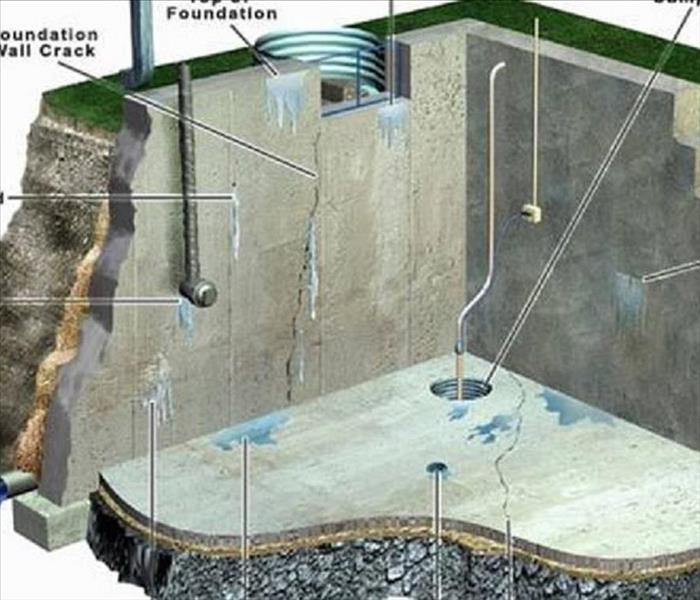 Water Damage in Moorestown NJ, Flood Damage in Haddonfield NJ, Detect and Prevent Water damage,
Water Damage in Moorestown NJ, Flood Damage in Haddonfield NJ, Detect and Prevent Water damage,
Water Damage in Moorestown NJ, Flood Damage in Haddonfield NJ, Detect and Prevent Water damage,
Standing water on the floor is easy to see. Less obvious signs of problems include:
- Unexpected increases in your water bill
- Stains on walls, floors or ceilings
- Damaged or warped flooring
- Warped bottom panels in under-sink cabinets
- Peeling paint or wallpaper
- Corrosion on plumbing valves and fittings
Deal with problems as you find them. Clean up any water or moisture, locate the source and make repairs. Tracking down a leak isn't always straightforward — water can travel along components in the building structure, so the indications of the leak may be in a different part of the home than the leak itself. If necessary, contact a professional roofing contractor, plumber or water damage restoration specialist to help with identification and repair.
In addition to the damage that water causes, it can encourage the growth of mold on walls and floors — where it's readily visible — and in ductwork, attics and crawl spaces — where you might not notice it. A musty odor is a sign that mold may be present.
Mold can cause damage and lead to health problems — deal with it quickly. If the affected area is larger than 3 feet by 3 feet, the Environmental Protection Agency recommends you find a professional mold remediation contractor. For smaller areas, you can clean nonporous surfaces with commercial cleaning products, soap and water or a solution of a cup of bleach to each gallon of water. Follow the instructions and safety precautions for the cleaning product you use and wear appropriate safety gear. Porous surfaces such as drywall need to be replaced. For more information on mold in the home and how to clean it up, see A Brief Guide to Mold, Moisture, and Your Home on the EPA's web site.
Inspecting common sources of water leaks and taking some simple preventative measures can be an effective way to reduce the risk of water damage and mold.
Plumbing
- Every 6 to 12 months, inspect water lines, shut-off valves and fittings for fixtures such as sinks, toilets and tubs and for appliances such as washing machines, dishwashers and ice makers. Check for cracks, loose connections, kinks and corrosion. If you find a leak, turn off the water to the fixture or appliance until you can make repairs.
- Check around toilets to make sure water is not leaking at the base — an indication that the wax ring between the toilet and floor might need replacing or that there might be a crack in the base.
- If the temperature drops near the 20°F mark, allow faucets connected to vulnerable pipes — those not protected in insulated spaces — to drip. This helps minimize the risk of burst pipes by relieving pressure if the pipes freeze.
Appliances
- Replace washing machine supply hoses at least every five years. Consider using stainless-steel mesh hoses. Keep the machine properly balanced — over time, an unbalanced machine can move, pulling free the hose connections. Read Maintain Your Washer and Dryer for instructions on replacing hoses and balancing the washing machine.
- Consider turning off the water to the washing machine when it's not in use.
- Don't operate a dishwasher or washing machine while your house is unoccupied.
- Follow the manufacturer-specified maintenance for your appliances, including your water heater. Have the water heater inspected every couple of years.
Roof and Gutters
- Have your roof inspected every three years by a professional, but also check routinely for damage you can see from the ground — such as broken and missing shingles or damaged flashing. A poorly maintained roof can lead to leaks in the home and additional damage to the roof itself.
- If your roof doesn't have a drip edge or drip cap, consider having one added. This component helps keep water away from the roof deck and directs runoff into gutters.
- Keep gutters clear and well-maintained. Gutters that overflow, leak or don't drain properly allow water to seep into your roof and into your foundation, crawlspace or basement. See Gutter Cleaning and Repair for steps to keep your gutters working correctly.
- Make sure gutter downspouts direct rainwater away from the home's foundation. Use extensions to carry water at least 6 feet from the house.
Exterior Walls and Foundation
- Inspect the exterior of your home. Caulk around gaps at plumbing and ventilation entry and exit points. See How to Caulk for instructions. Repair cracked mortar joints.
- Check to see if roots from shrubs near your home have caused damage that can allow water to enter the foundation. You may need to remove shrubs that are close to the house to prevent problems. Roots can also damage and block in-ground pipes, causing leaks near the foundation and sewer backups in the home.
- Keep shrubbery beds and other landscape features sloped to direct water away from the home.
- Look for evidence of erosion or settling at the foundation that can indicate water problems.
Additional Tips to Avoid Water Damage
- Have your attic ventilation and insulation inspected annually and seal gaps that allow warm air into the attic — such as those around access doors and light fixtures. When warm air collects in the attic, it can lead to the formation of an ice dam — ice around the eaves that causes water from melting snow and ice to back up under the shingles and leak into your home.
- If you have a sump pump, test it several times during the year. Follow the manufacturer's maintenance instructions.
- Check your water pressure with a pressure gauge; typically these screw onto a hose bib. The pressure in an average home is around 50 to 70 pounds per square inch (psi). Higher pressure causes extra stress on pipes and fittings and can lead to leaks.
- Inspect tile and grout around showers and tubs. Make any necessary repairs. Read Replace a Broken Ceramic Tile and Repair Tile Grout for step-by-step instructions.
- Check for leaks around windows during rains and seal any you find.
- Use exhaust fans in the kitchen and bathroom to move excess moisture out of the house. Moisture in the air can condense on cool surfaces and cause problems. Read Controlling Moisture and Humidity in the Home for more ways to reduce indoor moisture.
- Locate your water shut-off valve so you can quickly turn off water to the home in an emergency. See Shut Off Your Home Water Supply for instructions on locating the valve.
Investigating and Diagnosing Moisture Problems in Your Property, Water damage in Haddonfield NJ, Water damage in Mt. Laurel NJ,
8/11/2017 (Permalink)
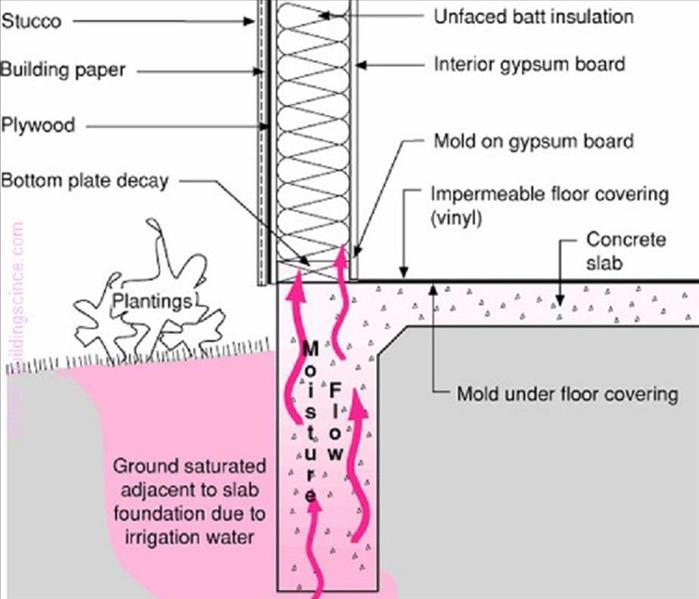 Investigating and Diagnosing Moisture Problems in Your Property, Water damage in Haddonfield NJ, Water damage in Mt. Laurel NJ,
Investigating and Diagnosing Moisture Problems in Your Property, Water damage in Haddonfield NJ, Water damage in Mt. Laurel NJ,
Investigating and Diagnosing Moisture Problems in Your Property, Water damage in Haddonfield NJ, Water damage in Mt. Laurel NJ,
Water comes in four forms: solid, liquid, vapor and adsorbed. All four forms can cause grief to building owners, designers and contractors. When water causes building problems investigating and diagnosing the problem can be challenging because water constantly changes its form inside a building and within its materials. The investigator must hunt down the water thinking like water.
Introduction
Water is supposed to be easy to understand. It only comes in four forms or states. And the rules governing water movement are straightforward:
- Water runs downhill due to gravity.
- Air carrying water vapor goes from areas of higher air pressure to areas of lower air pressure.
- Water in the vapor form diffuses from warm to cold driven by the thermal gradient.
- Water in the vapor form diffuses from more to less driven by the concentration gradient.
- Ok, not always straightforward:
- Water in a porous material diffuses on pore surfaces from more to less along the concentration gradient in the form of adsorbed water. When there is a lot of it and it fills the pores it is sometimes referred to as capillary water. In this way it can move upwards against the force of gravity – or sideways long distances. Just remember that porous materials “suck” and you’ll be ok.
Water always changes its behavior, because its form is never constant. Evaporation, condensation, capillary suction, gravitational flow, vapor diffusion and mass flow of moist air are all happening at the same time inside building cavities and inside materials.
Water plays clever tricks on us by changing forms and methods of movement along its flow path. It’s devious and treacherous and laughs at us simple-minded humans whenever it can get away with it. We have to fight it by knowing its tricks. We’ll begin with some simple stuff – diagnosing and finding rain leaks. Then we’ll get into some clever tricks water can play on us.
Rain, Rain Go Away…
Rain falls out of the sky, mostly straight down. Sometimes the wind smacks it against the walls. Diagnosing rainwater leaks is not that complicated. If things get wet after a rain, it’s probably the rain. Start at the wet spot and work backwards and upwards. This gravity thing is pretty predictable. Now, there is a catch – water likes to stick to things and it can run horizontally quite a long ways because nothing is ever completely flat. And that pesky wind can blow it uphill a ways – sometimes over things that are an inch or two high – like sills, flashings and ledges.
The best time to diagnose rainwater leaks is when it is raining. Duh. And unless you are superman and can see into walls, you should be prepared to make lots of holes to see inside of assemblies. Now, it doesn’t always rain when you are asked to look. So you can make your own rain when you need to. A garden hose works real well. Consultants get embarrassed when they charge lots of money while using a garden hose so they use a spray rack instead to make it seem more “technical” and “scientific.” But a leak is a leak whether the water comes from a hose or a calibrated spray rack spraying calibrated water at a calibrated air pressure. In fairness to consultants, standardized tests can come in real handy once you know the flow path and you want to know if the leaking windowyou found meets industry standards. Just remember to be “gentle” when you use a hose – you don’t want the momentum of the water spray forcing water into the building. The secret is misting the surface and letting gravity do the dirty deed. So fire hoses are out.
Sometimes a building only leaks rainwater when it is windy. And there isn’t always wind around when you need it – like when you are on-site looking for the leak. So make your own wind. Instead of blowing against the building from the outside, suck air out of the building from the inside to simulate wind driven rain. Turn off the supply air, and crank up the exhaust. You should probably only do this with adult supervision, but you get the picture.
Most of the time rainwater leaks are straightforward to diagnose, but sometimes finding moisture due to rainfall is not such an obvious process.
Clever Water Tricks I – The Old Rain on the Brick Sun Trick
Up to now, the story has been pretty simple. Let’s complicate it by splashing rainwater on a brick veneer. Brick is a sponge. Brick wicks water into itself because it is porous. The mortar in the joints between bricks is also a sponge. Mortar wicks water into itself because it is porous. There are also cracks between the brick and the mortar. These cracks are also “pores” and they also wick water. Remember, porous materials suck. Think of a brick veneer as a moisture reservoir that is filled during a rainstorm. So now we have this wet sponge on the outside of your building. The sun comes out. The sun beats down on the wet brick on the southwest side and makes the water in the brick hot. How hot? Probably 120 degrees F? Let’s go to the psychometric chart. Find where 120 degrees F crosses the saturation curve (100 percent RH). Hey, we’re off the chart. We have to go to the steam tables. Wow. Any guesses what direction the water in the brick wants to go? Did I mention the building this brick veneer is enclosing is air-conditioned?
The brick is wetter than the rest of the wall and wetter than the inside. The brick is hotter than the rest of the wall and hotter than the inside. The water in the brick is driven inwards out of the brick into the airspace where it turns into a vapor. Some of the water also goes to the outside, because the brick is also wetter and hotter than the outside. But let’s go back to the airspace behind the brick. It’s not likely that the airspace is free from mortar droppings and vented at the bottom and at the top so that ventilation air can flush the water vapor driven into the airspace out of the brick to the outside. Even if the cavity is clean it’s rarely vented. It may be drained, but it is seldom vented – at least not by design – although it should always be. It may be vented accidentally – and this accidental venting saves a lot of buildings. It seems that we are more often lucky rather than smart.
So inwards goes the water vapor, traveling along the temperature gradient and along the concentration gradient. How far it travels depends on what’s in its way. If it runs into something impermeable like foam sheathing or a rubber membrane on the backside of the cavity behind the brick veneer, the vapor won’t travel far. If it hits foam sheathing or a rubber membrane the vapor condenses, turns back into a liquid and runs down the back side of the airspace, hopefully to a flashing where it is directed out of the wall to the outside.
But what happens if it runs into a building paper or a housewrap that breathes? The heat driven vapor blows through it like a hot knife through butter. What is the building paper or housewrap installed over? Probably a gypsum sheathing – highly permeable to vapor. So vapor diffuses right through it. Next comes fiberglass cavity insulation, which can’t stop the vapor – it’s permeable too. The vapor goes all the way in until it hits the plastic vapor barrier. Not a good idea to put a plastic vapor barrier on the inside of a brick veneer wall that sees rain and sun. The vapor condenses on the plastic vapor barrier and runs down the wall to sit in the bottom plate track. Now we have a full range of problems to choose from: corrosion, mold, odors or staining. You can get the same effect by installing a vinyl wall covering rather than the plastic vapor barrier. Just ask the hotel industry about this practice.
Biohazard cleaning in Cherry Hill NJ, Biohazard cleaning in Haddonfield NJ,
8/10/2017 (Permalink)
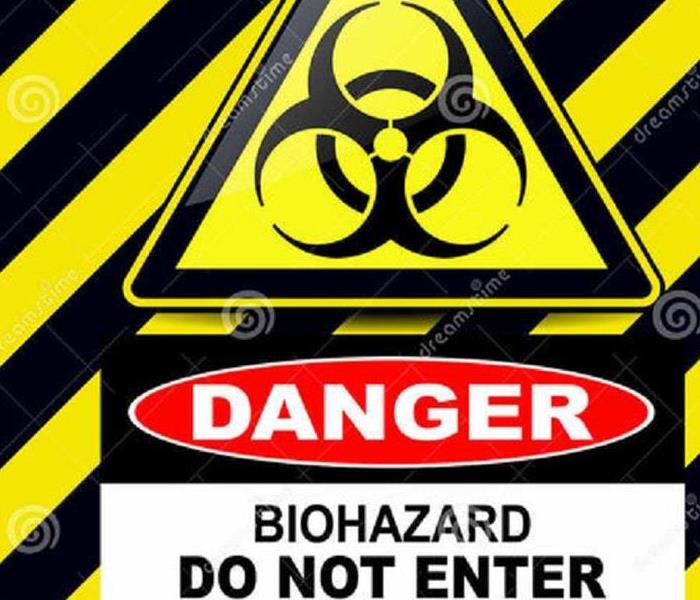 Biohazard cleaning in Cherry Hill NJ, Biohazard cleaning in Haddonfield NJ,
Biohazard cleaning in Cherry Hill NJ, Biohazard cleaning in Haddonfield NJ,
Biohazard cleaning in Cherry Hill NJ, Biohazard cleaning in Haddonfield NJ,
Crime scene cleanup is a term applied to cleanup of blood, bodily fluids, and other potentially infectious materials (OPIM). It is also referred to as biohazard remediation, because crime scenes are only a portion of the situations in which biohazard cleaning is needed. Such incidents may include accidents, suicides, homicides, and decompositionafter unattended death. It could also include mass trauma, industrial accidents, infectious disease contamination, animal biohazards (e.g. feces or blood) or regulated waste transport, treatment, and disposal.
Television productions like CSI: Crime Scene Investigation
have added to the popularity of the term "crime scene cleanup".
Australia, Canada and England have added it to their professional
cleaning terminology. As a profession, it is growing in popularity
because of media exposure and the growth of training programs
worldwide.The generic terms for "crime scene cleanup" include trauma cleaning, crime and trauma scene decontamination ("CTS Decon"), biohazard remediation, biohazardremoval, blood
cleanup and crime scene cleanup. The state of California refers to
individuals who practice this profession as "Valid Trauma Scene Waste
Management Practitioners".
Types of cleanups
Crime scene cleanup includes blood spills following an assault,
homicide or suicide. There are many different sub-segments, named
primarily after additional collateral, contingency, or preconditions,
regarding the presence of non-blood borne organics, toxic irritants
(e.g.,tear gas) or disease vectors.
However, it is the legality of charging a fee for mitigating
potentially harmful biohazard situations that differentiates a
registered crime or trauma practitioner from any general restoration,
carpet cleaning, janitorial or housekeeping service.
Business
Crime scene cleanup began primarily as a local or regional small business
activity but maturity and consolidation has created some larger
entities in the industry; only a few nationwide companies exist,
although some national carpet cleaning and restoration
companies franchises have added crime scene cleanup and biohazard
removal to their services. Due to the legal and ethical complications
crime scene cleanup is often its own business entity or a separate
division.
Regulatory requirements
While the field of crime scene cleanup is not specifically regulated
as a class, most if not all of the activities performed by biohazard
cleanup teams in the United States are regulated or fall under best
practice guidelines from governing and advisory bodies such as OSHA, NIOSH, DOT, and EPA.
Those who hire a crime scene cleanup company should make sure that they
are properly trained in applicable federal and state regulations and
can provide documentation of proper biohazardous waste disposal from
licensed medical waste transportation and disposal companies. If in California or
Florida the client should confirm that the company is registered with the state
Department of Health. A few states such as California, New York and
Florida are the only states that explicitly require registration or
licensing for crime scene cleanup. Other states may require biohazardous
waste transport permits from the DOT.
In the US, OSHA requires that exposure to blood-borne pathogens be
limited as much as possible due to the assumption that the blood and
biological material is infectious. Most actions taken to limit exposure
fall under cross-contamination protocols, which provide that certain
actions be taken to avoid further spreading the contamination throughout
otherwise clean areas. CTS De-con companies should have in place, an
exposure control plan before beginning work on any trauma scene. Under
employee safety and cross-contamination protocols, the following OSHA regulations may pertain to bioremediation.
- OSHA29 CFR 1910.1030(g)(2)(ii)- Initial Assessment of Work: Must assess work site for potential hazards to employee safety. OSHA 29 CFR 1910.1200, et seq.- Hazard Communication Protocol: Required to establish what chemicals are used and that they are properly labeled.
- OSHA 29 CFR 1910.1030(d)(2)(i);29 CFR 1910.1030(e)(2)(iii); 29 CFR 1910.1030(d)(1); and 29, CFR 1926.1053 – Work Practice & Engineering Controls and Safety: Having done the initial assessment, must determine damage, potential hazards, equipment needs, egresses, work routes, possible complicating factors, ladder/scaffolding safety protocols, availability for hand-washing/sanitization wipes.
- OSHA 29 CFR 1910.1030(d)(1) – Method of Compliance: Ensure employees are following all OSHA-mandated engineering and work practice controls through proper supervision, written documentation and photographs.
- OSHA 29 CFR 1910.1030(c)(2) – Exposure Determination: Determine employee safety concerns due to exposure to biological materials.
- OSHA 29 CFR 1910.1030(g)(1) – Hazard Signs and Labels: Hazardous areas must be demarcated; use of biohazard tape and establishment of zones separates and identifies hazardous areas.
In the UK, biohazards are regulated in part by HSE. Canada has published Canadian Biosafety Standards and Guidelines.
Methods
The crime scene cleaners' work begins when the coroner's
office or other official, government body releases the "scene" to the
owner or other responsible parties. Only when the investigation has
completely terminated on the contaminated scene may the cleaning companies begin their task.
Standard operating procedures for the crime scene cleanup field often include military-like methods for the decontamination of internal and external environments. Universal precautions recognized worldwide are the cautionary rule-of-thumb for this field of professional cleaning.
Cleaning methods for removing and sanitizing biohazards vary from
practitioner to practitioner. Some organizations are working to create a
"Standard of Clean" such as ISSA's K12 Standard, Which includes use of
quantifiable testing methods such as ATP testing.
Organizations
The first specialty trade organization for this field of cleaning was the American Bio-Recovery Association (ABRA). The largest association dedicated to the crime scene cleanup industry is the National Crime Scene Cleanup Association (NCSCA). Among other tasks, they organized cleanup procedures for Ebola decontamination in 2014.
Clean Trust (aka IICRC) is a certifying body for the cleaning trade in general. International Sanitary Supply Association (ISSA) is a global standards body and trade organization of professional janitorial and cleaning professionals.
In popular culture and the media
Crime scene cleanup as a profession has been featured sporadically in
popular culture and the media. It first showed up in films when Quentin Tarantinoproduced Curdled, then after an eleven-year hiatus in the Samuel L. Jackson film Cleaner, and more recently when Amy Adams and Emily Blunt teamed up for Sunshine Cleaning. On television it has been featured in a smattering of documentaries aired on the National Geographic Channel and the Discovery Channel, as well as reality series such as Grim Sweepers.
In video games and visual media, crime scene cleanup takes center
focus as the main objective in the game, Viscera Cleanup Detail. Viscera Cleanup Detail is a PC game distributed through Steam that enables players to clean up blood and body remains after a Sci-Fi battle has occurred on a space station. Another example of crime scene cleanup in video games is Safeguard.
Safeguard takes a more realistic and educational approach, enabling
users to learn about the hazards of crime scene cleanup, as well as the
equipment and tools used. Safeguard also uses virtual reality to immerse users in the crime scene environment.
Water Removal and Water Extraction, Water damage in Cherry Hill NJ, Water damage in Moorestown NJ,
8/9/2017 (Permalink)
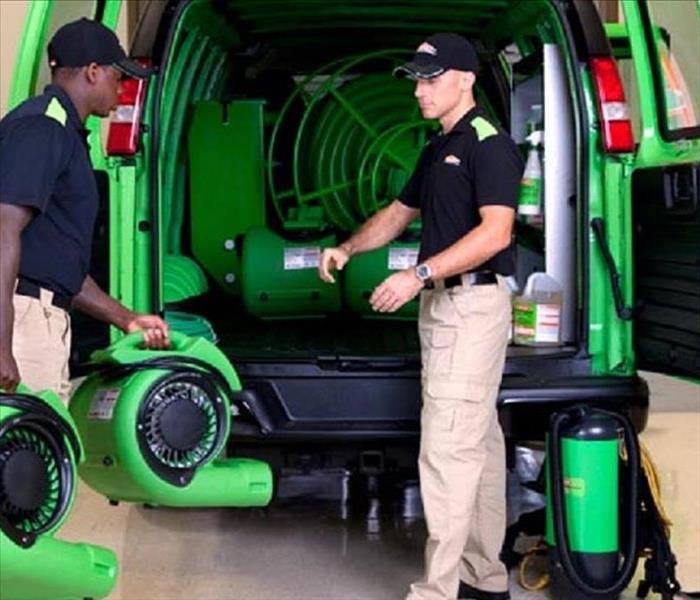 Water Removal and Water Extraction, Water damage in Cherry Hill NJ, Water damage in Moorestown NJ,
Water Removal and Water Extraction, Water damage in Cherry Hill NJ, Water damage in Moorestown NJ,
The water damage restoration process begins with a detailed inspection of your property, including a damage assessment. The SERVPRO Franchise Professional is determining the scope of the damage so he or she can develop an appropriate plan of action. Being careful and cautious is also a Priority. Also, Making sure electrical items, Appliances, and Outlets are Not a Hazard.
They Identify and Stop the Water Source
They check for the source of water in your home and business and stop it. The water source must be stopped before the drying process can begin.
- Stop the Source
- Check for Contaminated Water
They Identify the Type of Water
SERVPRO Franchise Professionals must identify the category and classification of water to restore your property safely to industry specifications. The type of water contamination will affect the specific restoration processes used to restore your property.
- White / Category 1 Water
- Gray / Category 2 Water
- Black / Category 3 Water
They Survey the Extent of the Water Damage and Inspect the Premises
They inspect and test your home to discover the extent of the damage. Additionally, they will look for safety concerns and explain them to you. If you are aware of any safety issues, such as asbestos or lead, please share them.
- Survey Damage
- Complete Safety Inspection
They Move or Block Furniture
They move furniture and property contents and block items to help prevent rust or furniture stains on wet carpet.
The water extraction step removes the majority of the water from your home or property. By performing a thorough water extraction, SERVPRO Franchise Professionals help reduce the drying time and help to prevent mold and secondary water damage. They use powerful pumps and truck-mounted vacuum units to quickly remove hundreds or thousands of gallons of water from your property.
Move-Out / Pack-Out
If your home requires extensive restoration or cleaning, SERVPRO Franchise Professionals can conduct an organized, efficient move-out to protect your belongings from further damage.
Emergency Water Removal
Highly trained technicians will begin the water removal process almost immediately. Depending on the amount of water, they may use powerful submersible pumps in addition to industrial strength, wet/dry vacuums. This step helps to reduce drying time and helps to prevent mold and secondary water damage.
- Remove Excess Water
- Use Submersible Pumps and Industrial Wet/Dry Vacuums
Inspect the Carpet Pad and Carpet
SERVPRO Franchise Professionals inspect the carpet and pad and determine if it should be removed to protect the subfloor.
- Inspect Carpet Pad and Remove If Needed
- Inspect Carpet and Remove If Needed
Water Removal Equipment
- Moisture detectors, hygrometers, and other meters measure the extent of moisture saturation.
- Infrared cameras may be used to find “hidden” water behind walls and ceilings.
- Submersible and gas-powered pumps are used for continuous pumping of high-level water.
- Truck-mounted and portable extraction units perform efficient water removal.
Hospitals turn to new textile cleaning technology to remove contaminates, Biohazard cleaning in Cherry Hill NJ, Biohazard cleaning in Moorestown NJ,
8/3/2017 (Permalink)
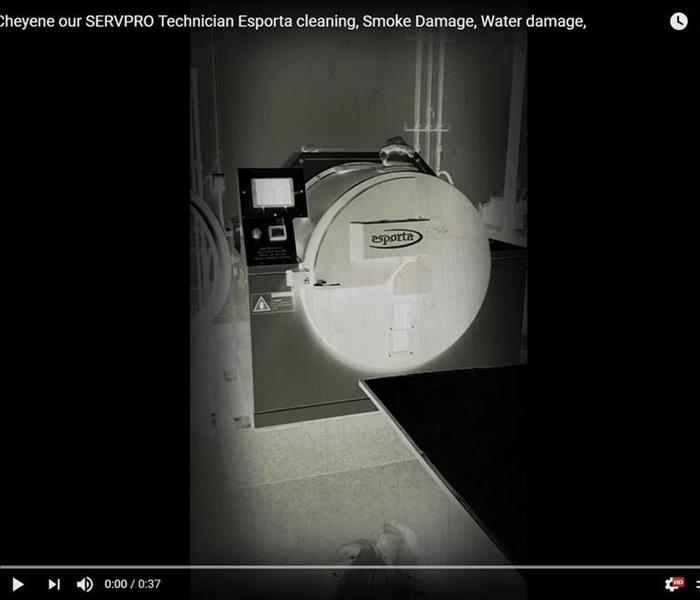 Hospitals turn to new textile cleaning technology to remove contaminates, Biohazard cleaning in Cherry Hill NJ, Biohazard cleaning in Moorestown NJ,
Hospitals turn to new textile cleaning technology to remove contaminates, Biohazard cleaning in Cherry Hill NJ, Biohazard cleaning in Moorestown NJ,
Hospitals turn to new textile cleaning technology to remove contaminates, Biohazard cleaning in Cherry Hill NJ, Biohazard cleaning in Moorestown NJ,
Hospital personnel know that hard, non-porous surfaces are fairly easy and inexpensive to clean. Soft, porous textiles, however, require more than a wipe down with liquid disinfectant. In most cases, even the most rigorous cleaning methods fall short, and that creates an expensive problem for medical facilities.
A constant concern for hospital executives is staying within budget while maintaining high standards of cleanliness to protect their patients. Failing to do so can also be a liability issue, so many hospitals exercise an abundance of caution.
Take, for instance, privacy curtains in hospital rooms. After a 2011 CBS News report called attention to test results showing the presence of infectious bacteria on the majority of curtains tested, hospital administrators took notice.
You’d think most people would naturally assume that bacteria and viruses can be found on most hospital surfaces. It’s hard to imagine that it could be avoided. So, how could that even be the issue? Perhaps the real issue isn’t the mere presence of pathogens, but the level of contamination.
The medical community has searched for an acceptable solution. Professional dry cleaning was one option they tried, but the results were disappointing. That wouldn’t surprise most cleaning experts. After all, most professional launderers still use traditional washing machines, similar to the one you might use at home.
Those traditional, agitating machines are fine for typical household laundry; but when it comes to getting items clean enough for hospitals, there’s a glaring problem: Items washed in traditional machines spend the entire wash cycle immersed in increasingly dirty water until the rinse cycle replaces it. The items may appear clean when they emerge from the wash, but they’re often still contaminated beyond acceptable levels.
Fundamentally, washing in traditional machines isn’t much different from the way it was done over a 100 years ago when people cleaned clothes in river water on a wash board. Given today’s technology, there’s simply no excuse for that.
Until recently, the only option for concerned hospitals, besides traditional laundering, was periodic replacement of privacy curtains, and some hospitals were doing just that. However, this presented another problem when hospital administrators had to confront the cost of replacement. Depending on the size, replacement curtains can cost anywhere from $200 to $500 apiece. That really adds up for hospitals with hundreds of curtains.
Recently, however, some in the medical community found one more option, and it appears to be a perfect solution. A new wash system developed by the Esporta company is guaranteed to get textiles food-grade clean or better; a claim that is backed up by testing done with ATP meters, the same instruments used by health department inspectors.
Instead of agitation (which incidentally wears out fabrics sooner), this machine has compartments that hold the items stationary while the larger cylinder containing the compartments rotates them in and out of detergent-laden water. The water and proprietary detergents pass through the items repeatedly and forcefully. The machine then passes the items through fresh water, which rinses out the detergents. The key concept is the force with which the water and detergents are passed through the items.
A recent test that cleaning experts did for one hospital proved this technology’s effectiveness. Before being washed, curtains were tested with an ATP meter, which showed a contamination level over 400 RLU (relative light units). To give you some perspective, health department standards require surfaces to test at 30 RLU or below to qualify as food-grade clean. A reading of 11 RLU or better is considered medical grade clean.
After the tested curtains were washed using the Esporta system, the final test result was 0 RLU, no pathogens at all. According to one hospital source, the best result that old, traditional machines were able to achieve was in the 200 - 250 RLU range.
Also, the Esporta doesn’t only remove germs and odors. Fire departments that are concerned about toxic, chemical-filled soot are now having their firefighting gear decontaminated using this technology.
Textile cleaning technology gets more exciting every day. There isn’t much now that can’t be cleaned. Today’s advancements make it easy and effective, and it sure beats a wash board by the river.
Check out our YouTube Channel, for Esporta Cleaning videos:
https://youtu.be/IuOCxz33kVw
7 Summer Energy-Saving Tips to Lower Your Electric Bill, fire damage in Cherry Hill NJ, smoke damage in Moorestown NJ,
8/2/2017 (Permalink)
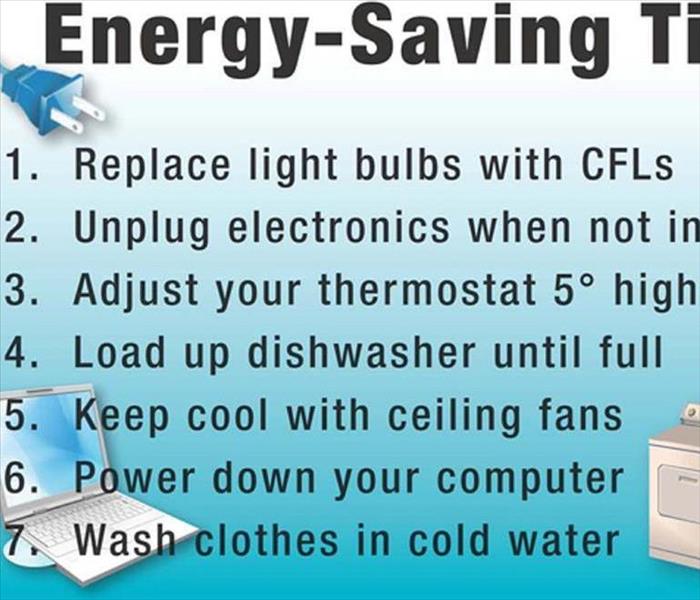 7 Summer Energy-Saving Tips to Lower Your Electric Bill, fire damage in Cherry Hill NJ, smoke damage in Moorestown NJ,
7 Summer Energy-Saving Tips to Lower Your Electric Bill, fire damage in Cherry Hill NJ, smoke damage in Moorestown NJ,
Figuring out how to lower electric bills in the summer can be difficult, especially when temperatures are at their hottest. Luckily, there are some steps you can take to save on your electric bill during the summer months. Try these 7 summer energy-saving tips so you can focus less on your electric bill and more on the pleasures of summer.
How to lower electric bills in the summer
1. Be smart about peak-time summer utility rates.
Plan to run your washer, dryer and dishwasher before 11 a.m. or after 7 p.m. to avoid peak usage times and potentially higher rates. Utility companies often raise gas and electricity rates during the hottest time of the day, according to Energy Upgrade California. You can still load the dishwasher after meals, but waiting a bit to run it can help lower summer electric bills.
2. Look for the Energy Star symbol.
Planning to replace your washer, dryer or refrigerator? Shop with energy savings in mind. The U.S. government’s Energy Star program certifies products that meet strict energy-saving specifications. According to Energystar.gov, washers built before 2003 are significantly less efficient than newer models. Energy Star washing machines use about 25% less energy and 40% less water compared with regular washers. Similar money and energy savings can be found in newer dryers, refrigerators and other appliances that are Energy Star-certified.
3. Think outside the oven.
Running your oven on hot days makes your air conditioner run more to keep the house cool. Firing up the backyard grill for a barbecue instead can help you save on your electric bills in the summer.
4. Make cooling off a breeze.
Install ceiling fans, which can help everyone in the room feel cooler without the need to run the A/C as much – or at all. While the fans don’t actually lower the temperature in the room, they create a wind-chill effect and make you feel cooler by accelerating the evaporation of perspiration on the skin. Another summer energy-saving tip: Ceiling fans are of no use when no one is in the room, so turn them off when you leave.
5. Insulate your home.
Heating and cooling account for 50% to 70% of the energy used in the average American home, according to the U.S. Department of Energy (DOE). Reducing the energy spent on cooling by improving insulation is a great way to lower your summer electric bills. Newer homes generally are better insulated than older, unimproved homes because building energy codes have become progressively stricter over the years, says the DOE. If you have an older home, consider adding better insulation. Unless your newer home was constructed with special attention to energy efficiency, your utility bills will still probably benefit from improving your home’s insulation.
6. Check for air conditioner efficiency.
The DOE recommends having a professional check and clean your air conditioner (and your heater) once a year. If the unit is more than 15 years old, you may want to consider replacing it with a newer, more energy-efficient unit. A new system can greatly reduce your energy costs, says the DOE, especially if the existing equipment is in poor condition. On your current system, check your ductwork for dirt streaks, especially near seams. These indicate air leaks, and they should be sealed with a duct mastic sealant. Keep yard debris away from the outside compressor of your air-conditioning unit and keep nearby bushes trimmed.
7. Create your own shade.
Keep draperies and blinds closed on the sunny side of the house. Adding awnings can help, too. Looking for a longer-term solution that will add to the beauty of your property? Plant trees. “This Old House” recommends particular trees for fast-growing (1½ to 2 feet per year) shade options.
Water damage in Collingswood NJ, Types of Moisture Meters, to Understand Moisture Content in Substrates, Water damage in Audubon NJ,
8/1/2017 (Permalink)
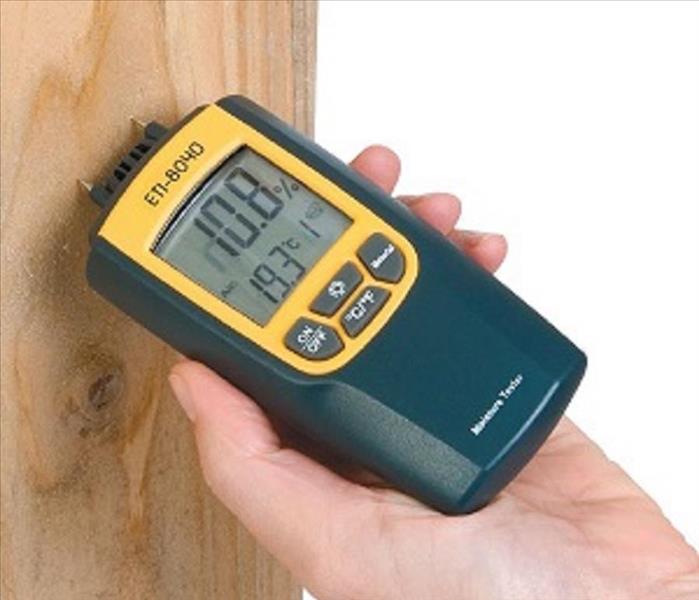 Water damage in Collingswood NJ, Types of Moisture Meters, to Understand Moisture Content in Substrates, Water damage in Audubon NJ,
Water damage in Collingswood NJ, Types of Moisture Meters, to Understand Moisture Content in Substrates, Water damage in Audubon NJ,
A moisture meter is an essential instrument used in many industries to detect moisture content in materials. Home and building inspectors rely on moisture meters to identify potential problems and damage to structures from moisture buildup. Woodworking industries, such as furniture makers, use wood moisture meters to insure a quality product. Flooring contractors use moisture meters to determine ideal conditions when installing a floor over a concrete slab or subfloor.
Indicator scales on moisture meters can vary in appearance, but all will indicate moisture content in percent (%MC). While some moisture meters offer an analog scale, others read %MC digitally. The accuracy of the %MC readings, as well as the appropriate substrate scales, vary per meter and can vary by brand and type.
Most moisture meters are calibrated to wood, which provides a relatively accurate reading in wood moisture content. Typically, this scale ranges in the 5 to 40% range. When testing the moisture content in non-wood materials, such as concrete, a relative scale of 0 to 100 is often used, where 0 is bone dry and 100 is saturated. This is a relative scale. Moisture meters include visual LED indicators related to the percent reading on the scale for dry, moderate and saturated or wet readings. Additionally, some meters also offer a third scale for readings of gypsum. These scale readings can range from 0.2 to 50% moisture content. When selecting a moisture meter for sheetrock, it is advised that a moisture meter that offers a scale reading for gypsum be used.
Color indicators on moisture meters are helpful in determining whether the material being tested is considered dry or if there is a potential problem with moisture. The green (dry), yellow (moderate) and red (high) indicators typically identify where on the scale of %MC the readings occur. This can clear up confusion where one interprets a %MC as dry versus one that is moderate and may require more thorough investigation to determine if a problem with moisture in the material exists, especially if a visible sign of moisture does not exist.
Types of Moisture Meters
There are three common types of moisture meters used for the inspection of building and structure materials: pin-type, pinless and pin/pinless/all-in-one. All three types of moisture meters offer specialized purpose and are unique to the end user's application in determining %MC in materials.
Pin-Type Moisture Meter
The first of the three types of moisture meters is the pin type. Pin-type moisture meters measure %MC at the depth of the head of the contact pins. Pin-type moisture meters have two pins on the instrument, which are used to penetrate into the test surface at a desired depth. The reading of %MC is determined by measuring the electrical resistance between the tips of the two pins. This method of inserting pins into a surface is often viewed as an invasive process for measuring %MC. Typically these moisture meters will read up to 5/16" depth.
Pin-type moisture meters use the principle of electrical resistance to measure the moisture content in materials by measuring the conductivity between the pins. The tips of the pins are relatively sharp, uninsulated and penetrate into the surface for a sub-surface reading. With pin-type meters, you can also obtain a reading by touching the pins to the surface for testing. Most pin-type moisture meters use a scale calibrated to wood, however this does not mean that the meter cannot be used to measure moisture in other substrates and materials. This type of moisture meter can also be used for, but is not limited to, concrete, drywall, ceiling tiles and painted surfaces. When using the wood scale on a pin-type moisture meter, the %MC reading can range from 5% to 40% in moisture content. Generally, the low end of this reading falls into the 5 to 12% range, the moderate range will be 15 to 17%, and the high or saturated range will read above 17%. Scales for MC% ranges are provided in the instrument instructions and should be consulted concerning measuring ranges for particular surface materials.
Pin-type moisture meters are useful in measuring %MC in wood flooring, drywall, painted surfaces (such as the exterior of the home), carpeting, ceiling tile and cement. A pin-type moisture meter is the best way to identify the exact location of moisture buildup. A pin-type meter uses two pins that penetrate into the test surface at the users desired depth. When insulated contact pins are used, only the uncoated tips are exposed, providing an accurate reading of moisture content at various levels of penetration. Pin-type meters are the only instruments that allow the inspector to identify exact location of moisture at a given point. Using a pin-type meter is an effective way to determine the difference between shell and core moisture content. In some cases, the depth of the reading exceeds the length of the pin on the meter. If this is the case, many meters are equipped with a connection option to add accessory probes that can be inserted further into a substrate for more accurate core or depth detection. An example would be for Exterior Insulated Finish Systems (EIFS) testing.
Pinless Moisture Meter
Pinless or noninvasive moisture meters operate on the principle of electrical impedance.
This meter provides a nondestructive measurement of moisture in wood and other substrates, such as concrete and gypsum. A noninvasive moisture meter may also be called a nondestructive or a pinless moisture meter. Scales on these meters are similar to that of pin-type meters, where the wood scale reads %MC at 5 to 30%, and nonwood materials' %MC is read on a relative scale of 0 to 100%.
Pinless moisture meters are commonly used to determine moisture content on a relative scale of 0-100% in concrete subfloors and flooring prior to laying a wood floor or other decorative flooring surface. Other common uses for a pinless moisture meter for identifying possible moisture buildup behind bathroom/shower tiles, under vinyl flooring and other finished surfaces, as well as to determine if water-borne finishes are adequately dry prior to second application.
Pinless moisture meters are capable of reading up to a typical depth of 3/4" or 1" into a subsurface. These are useful for detecting problem moisture buildup where visual indicators are nonexistent.
Pin/Pinless/All-in-One Moisture Meter
A third and possibly more useful moisture meter would be a pin/pinless/all-in-one moisture meter. This type of moisture meter utilizes both methods for measuring %MC in surfaces. Because this type of meter offers the option to measure moisture content in substrates using both methods of reading moisture, one meter may be able to identify problem areas and then also be used to pinpoint the exact location where moisture damage or buildup is occurring. Essentially, this type of meter would utilize the same scales of %MC for wood and nonwood substrates and allow the end user the versatility necessary for a full inspection in determining areas where moisture is an issue.
Ideally, due to its diversity, this type of meter could be utilized by the flooring specialist, IAQ specialist, general contractor and home/building inspector.
Accessories for Additional Monitoring Capability
Generally, pin-type and pinless moisture meters will provide moisture readings limited in depth. However, in some applications, readings of moisture deeper than 5/16" are necessary. In cases where depth measurements exceed that of a typical moisture meter, it is good to consider a meter that will accept an attachment for EIFS, deep penetration or remote testing.For deep penetration, long-insulated contact pins may be used to obtain a moisture content measurement taken at depth. Holes may need to be drilled into the surface for testing and then the extra-deep pins will be inserted into the pre-drilled holes and MC% measurement will be taken at the tip of the pins where they are not insulated. Insulating all but the tips of these pins will avoid a false moisture content reading and provide a more accurate reading just at the depth where the tips of the pins are exposed.
In order to obtain a depth without drilling holes into the surface, a hammer probe can be used to measure moisture content in wood at different levels of penetration by inserting a long pin into a wood surface for up to 1-1/2" depth readings. Hammer probes are ideal for shell and core tests to detect moisture gradients and to test lumber with wet surfaces.
Moisture problems in EIFS are typically found within stucco surfaces and stem from poor sealant application around window and door frames or are a result of faulty flashing installation. EIFS probes are used to test for %MC within these structures. An example of an insulated EIFS Probe for this specialized application is shown here:
EIFS Probe
Other applications may require measuring %MC on surfaces that are out of reach or in a relatively inaccessible area, such as under sinks or in ventilation areas. If this is the case, then using a pin-type moisture meter attachment may come in handy so the reading can still be obtained on the meter while the measurement is being taken at the source. Not all meters offer attachment ports for remote testing, EIFS testing or deep penetration. Typically this is an optional feature built into the model of moisture meter.
Water damage in Collingswood NJ, Water damage in Audubon NJ, Why Is Water Leaking From My Central Air Conditioners Inside,
7/31/2017 (Permalink)
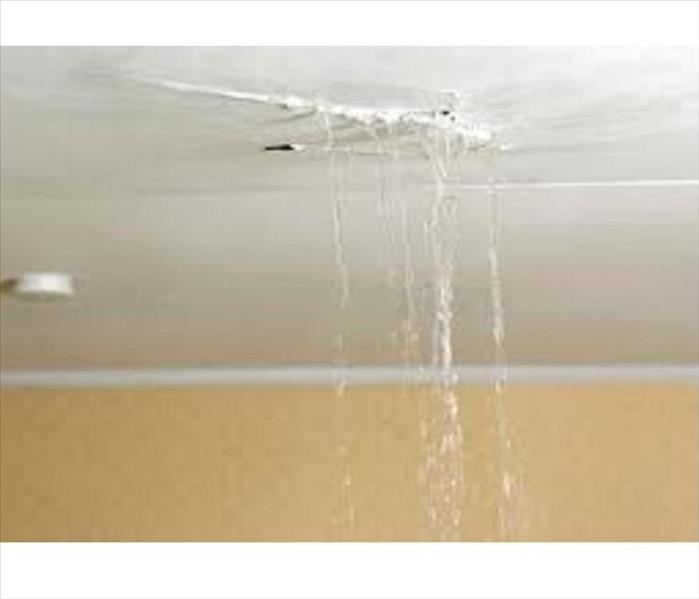 Water damage in Collingswood NJ, Water damage in Audubon NJ, Why Is Water Leaking From My Central Air Conditioners Inside,
Water damage in Collingswood NJ, Water damage in Audubon NJ, Why Is Water Leaking From My Central Air Conditioners Inside,
Water has started to pool around your central air conditioner’s inside unit and you have no idea why.
First, you should turn off your air conditioner because this water could harm the electronic parts of your AC and cause water damage to your home. Then you should contact a professional AC repair person for help.
If you want to understand the cause of this problem before calling a professional, read this article.
We’ll talk about:
- Why water forms in the inside AC unit
- Why there’s water all over the floor
- What needs to be done to fix it
Why water forms in a central air conditioner indoor unit
Part of your air conditioner’s job is to pull humidity from the air. The inside unit’s blower pulls in hot, humid air through the return grille and over the inside unit’s cold evaporator coil (pictured above) to cool the air down.
When that happens, condensation/droplets form on the evaporator coil. It’s just like when water droplets bead up on a glass of ice cold water on a hot summer day in Georgia.
That water on the evaporator coil falls into a sloped drain pan and down a condensate drain line like a slip n’slide. That drain line (usually a PVC pipe) either exits out the home (usually near the outside unit) or into your plumbing.
OK, so now you have a general idea of how the water forms and the parts involved. If there’s an issue with any of these parts, that’s why the water is forming around the inside unit.
Here are a few common problems that are causing the issue you’re having.
Clogged condensate drain line or rusted condensate drain pan
If the drain line gets clogged by dirt, insects, mold, or anything else, the water has nowhere to go but back into the home. (Some home’s have a secondary drain line but that may also be become clogged.)
Use wet-dry vacuum to suck out the obstruction from the outdoor PVC condensate pipe.
Also the root of the problem may be a dirty evaporator coil. The dirt will mix with the water and fall down into the pan, clogging the drain. Have a professional clean this coil annually as part of an annual AC maintenance visit.
Also, the drain pan may be rusted through and is falling onto the floor and causing damage to your home. So you’ll need to replace that.
Note: Your air conditioner may have a secondary drain pan to catch the water. This pan has a float switchthat turns off your air conditioner to prevent water damage.
Installation issues
If you have a newer air conditioner, the problem may be installation related. An improperly designed condensate trap will stop the condensate from draining. So all that water builds up in the drain pan and overflows into your home, causing water damage.
You’ll need a professional to examine the condensate trap to see if it has been designed properly and fix it if necessary.
Frozen evaporator coil
Open the blower door of your inside AC unit. Is the evaporator coil covered in ice? When that frozen evaporator coil melts there may be so much water that it flows over the drain pan and then onto the floor.
There are 2 common causes of a frozen evaporator coil:
- Dirty air filter—A dirty air filter blocks airflow over the evaporator coil, causing the temperature to drop below freezing and ice up. Check the air filter and change it if it’s dirty.
- Low refrigerant— Low refrigerant causes the evaporator coil to become much colder than normal, causing it to freeze up.
To defrost the evaporator coil, turn the air conditioner off. Then turn the blower from “auto” to “on.” The fan should melt the ice slowly enough for the drain pan to handle all the water.
In the meantime, you should call a professional AC repairmanto check your air conditioner to make sure it’s is working properly and ensure nothing was damaged.
Just a few of many issues…
There are other causes of water pooling around an inside air conditioning unit, but these are some of the most common.
Sump Pump Failure in Moorestown NJ, Flood Damage in Haddonfield NJ, 7 Causes of Sump Pump Failure and What to Do,
7/28/2017 (Permalink)
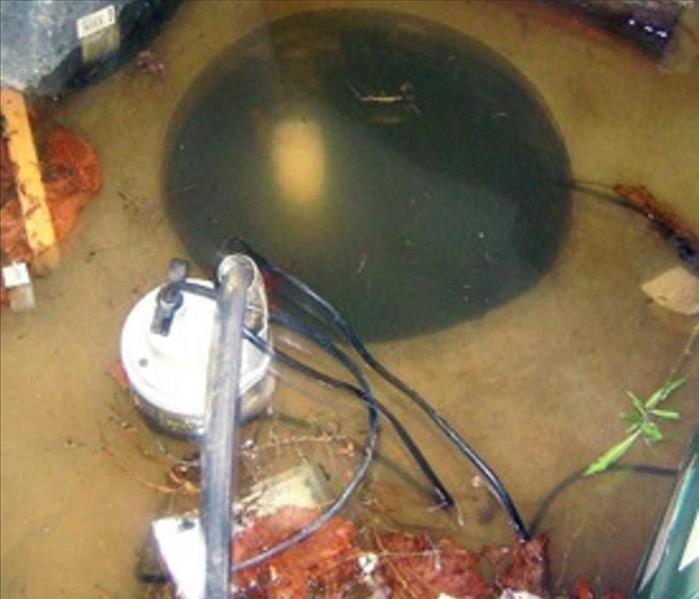 Sump Pump Failure in Moorestown NJ, Flood Damage in Haddonfield NJ, 7 Causes of Sump Pump Failure and What to Do,
Sump Pump Failure in Moorestown NJ, Flood Damage in Haddonfield NJ, 7 Causes of Sump Pump Failure and What to Do,
The problem is that Sump Pumps fail all the time. While it’s not to say that we have a fool-proof method for preventing 100% of failures, there are certainly some tips you can follow to better your chances of a properly working sump pump.
For years, sump pumps have been a pretty common fixture in homes, especially in lower-level areas of the country or in places where the rapid melting of heavy snow can cause flooded basements. The popularity of sump pumps have grown exponentially in the past couple decades, largely in part to a legal amendment to the US Federal Clean Water Act in 1987 that requires certain homes to have a sump pump, even if they are not necessarily high-risk for floods.
The American Society of Home Inspectors actually did a study that showed more than 60% of American homes suffer from underground wetness or water damage. And there’s a liklihood that an ever large percentage will deal with a flooded basement at some point. Something we often talk about with roofing in terms of moisture also applies here. It doesn’t always take a large amount of water to create a large amount of issues. In roofing, we talk about roof leaks going into the home which aren’t uncommon for a faulty roof after a big rain storm. But just as problematic – or sometimes even worse – are the small leaks that get into the attic and aren’t noticed until well after a huge mold problem has been created. Same goes for moisture in the lower levels of your home. It doesn’t take a huge flood to cause thousands of dollars in damage. It takes very little standing water and very little time for mold and mildew to take over and create problems.
Proper maintenance is the key. Ugh, more maintenance! Here we are telling you to maintain your roof, now we’re telling you about your sump pump. Really, though, maintenance is a great thing. It’s much cheaper than a huge repair and it drastically increases the life of your equipment.
There is no definitive “lifetime” of a sump pump. Most last anywhere from 3-20 years. That’s a pretty big window. The UD Dept of housing estimates the average life expectancy at 10 years. In my opinion, 10-15 years is pretty reasonable for a pump that goes through regular maintenance.
First, let’s talk about how a sump pump works.
The basics are pretty simple. A hole is dug in the lowest part of your basement or crawlspace where a sump pump sits and filters out water. As the pit fills up, the pump turns on and moves the liquid out of the pit through pipes that run away from the foundation of your home into an area where it can drain, such as a municipal storm drain or a dry well. A one-way valve (check valve) keeps water from entering back into the home.
The pump is generally powered with no special wiring; just your main household current. But being near water, or in water (in case of a failure), it’s a good idea to have some type of circuit interrupter to prevent electrocution.
The majority of residential sump pumps will turn on automatically from a pressure sensor or float activator. The pressure sensor activates as water builds up and creates more pressure than air which prompts the pump to turn on. The float activator has a ball that floats on top of the water, moving the arm as the water level rises – similar to the one in your toilet tank.
When the motor activates, the impeller (a fan-like device) will turn. Using centrifugal force, the spinning impeller will force the water towards the sides of the pipe, creating a low-pressure center where water from the pit rushes to while the spinning action pushes it through the pipe.
All of these things work together to keep your home dry. And for the most part, everything tends to go smoothly. But there’s a lot of parts working together and if one thing quits working, or some type of outside force comes in and causes disruption, things can get back quickly.
7 Things that Cause Sump Pump Failure
1. Power Failure
The most common cause for sump pump failure is an electrical power outage. To prevent this, have a backup generator that can be manually activated. In the case that your primary pump mechanically fails, though, a generator cannot help in this situation. But in the event of a storm where the power is knocked out for any length of time, a backup generator can be a lifesaver.
On the same topic of power, some components of the sump pump may be vulnerable to damage from power surges. To prevent this, protect the entire electrical system from power surges with a service entrance surge protection device.
2. The Sump Pump is the Wrong Size
If you have an incorrectly sized pump, or if the pump is not installed properly, there will most likely be a problem. A small sump pump is often just as effective as a big one. When a sump pump is too big, the pump is forced to work harder, resulting in a shorter product lifespan. But if it’s too small, it may not be able to adequately pump out the water – again resulting in a shorter lifespan.
3. Improper Installation
Installing a sump pump must be done exactly right. Manufacturer’s instructions must be followed carefully for the installation in order to avoid severe water damage down the road. Most manufacturers recommend or require a check valve to be installed on the discharge line. If not installed, the back-flow of water can cause the pump impeller to rotate backwards and unscrew off the motor shaft. In this scenario, you will still hear the pump motor running, but it would not be pumping any water.
Most manufacturers require the drilling of a small air relief hole in the discharge line between the pump and the check valve which is intended to prevent the pump from having to overcome the air pressure in the discharge pipe. The discharge pipe must be of the required diameter.
Lastly, the sump pump pit should not be set in dirt or gravel. This causes debris to enter into your pump and can result in interference with the pump’s on/off switch or float arm.
4. Switch Problems
The leading mechanical cause of sump pump problems is a switch problem. This occurs when the pump shifts from its position inside the basin, rendering the float ineffective. Float is responsible for the smooth operation of the on/off switch. Your sump pump relies on both the switch and the float arm mechanisms to operate effectively.
5. Lack of Maintenance
Some pump manufacturers recommend the pump to be run every 2-3 months. Some recommend a yearly program completed just before the rainy season hits.
Here are some additional manufacturer recommendations:
- If there is a back-up pump, unplug the primary pump and run the back-up pump to make sure it works properly
- When testing your sump pump, go outside to make sure it is discharging water
- Sometimes the pump can run but not pump any water. This means the impeller has disengaged from the pump shaft or the check valve is installed backwards.
- Check the operation of the float to make sure it is not restricted
- Clean out the air hole in the discharge line
- Listen for any unusual noises when the motor is running
- Replace the battery on the back-up sump pump every 2 or 3 years
6. Frozen or Clogged Discharge Lines
If water cannot exit your home through the discharge line, your system will not work. It is important to keep the discharge pipe protected from freezing and free of sticks, dirt, rocks and other debris. Protecting the water’s exit point of the discharge pipe will keep debris and animals out of the system, making it optimal for your sump pump.
Grated covering will not stop the lines from freezing or becoming blocked by ice and snow. A special grated discharge line attachment should help; it is placed near your home on the discharge line. It includes openings that give water a way to flow out of the pipe if the line is blocked further down.
7. Product Defect
Though rare, product defect is always a possibility and does happen. It is wise to test the pump when it is initially installed to make sure the pump operates properly.
It’s All About the Maintenance
Don’t get me wrong, you cannot avoid all of these problems with maintenance. Let’s be honest – it’s a mechanical piece of equipment and mechanical pieces of equipment fail. It happens. But there’s no doubt that you can avoid many of these issues, and give a longer lifespan to the equipment by performing regular maintenance.
At the very least, follow these maintenance tips once per year. Some experts will even recommend that you do this every 2 months. Quarterly maintenance is probably the norm. It takes just a few minutes and can avoid some serious pains in the future.
- A vinegar solution can be run through the sump pump in order to clean it
- The pump will become free from tiny particles and debris which will allow the pump to run much cleaner
- This can be done by the homeowner and unless there is a serious problem, then you may need to call a professional.
- Make sure the sump pump’s float switch is not restricted in any way. If it is, it will cause the sump pump to not automatically kick on in case of a flood
- Lastly, clean all vents and air holes for maximum effectiveness
That’s it. Maintenance is super easy and keeps your home protected from water damage. Make this a part of your regular home improvement plan and you’ll surely save some money in your pocket by either putting off the purchase of a replacement sump pump for several years, or by avoiding a costly water damage project.
Severe Weather In NJ Expected For Next 3 Days, Storm damage in Collingswood NJ, Flood damage in Audubon NJ,
7/27/2017 (Permalink)
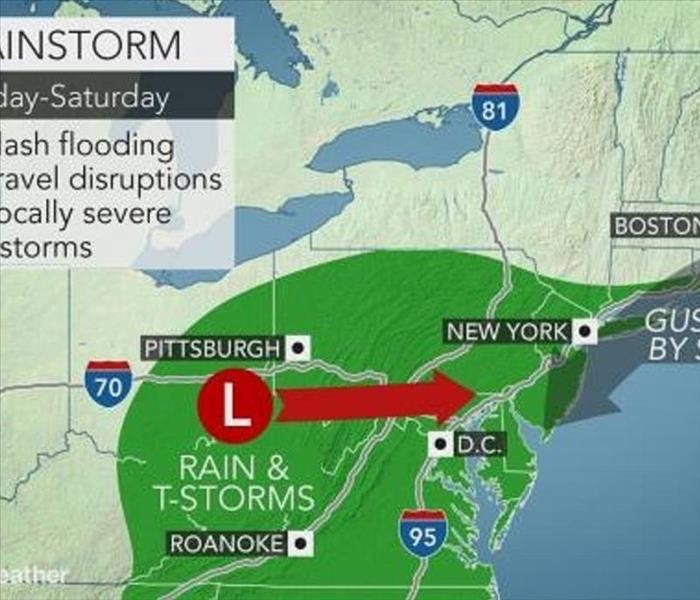 Severe Weather In NJ Expected For Next 3 Days, Storm damage in Collingswood NJ, Flood damage in Audubon NJ,
Severe Weather In NJ Expected For Next 3 Days, Storm damage in Collingswood NJ, Flood damage in Audubon NJ,
Severe Weather In NJ Expected For Next 3 Days, Storm damage in Collingswood NJ, Flood damage in Audubon NJ,
You'd better plan that outdoor party for Sunday. Or maybe some other weekend. Severe, stormy weather is expected to hit New Jersey beginning Thursday night and bring gusty thunderstorms and drenching downpours on Friday and Saturday, according to forecasters.
The National Weather Service has issued a hazardous weather outlook, saying showers and thunderstorms may produce locally heavy rainfall Thursday night.
There is the potential for heavy rainfall Friday afternoon through Saturday morning. Areas that were impacted by heavy rainfall earlier this week will be particularly vulnerable to another round of flash flooding.
The rare storm for late July will deliver drenching rain and miserable conditions to a large part of the mid-Atlantic and southern coast of New England to end the week and start the weekend.
The rainstorm will be unusual since it will unleash steady rain for 12 hours or more in many locations as it moves slowly across the region. Typically in the summer, rainfall is limited to a few hours in the absence of a tropical rainstorm, according.
Motorists from Ohio, Pennsylvania, New Jersey, southeastern New York state, West Virginia, Maryland, Virginia and Delaware are likely to face difficult travel due to persistent downpours, excess water on the road and poor visibility.
Beachgoers already have run into problems in New Jersey.
Enough rain can fall to cause flash and urban flooding. Small stream flooding is also possible as several inches of rain may fall on some locations.
Water damage in Haddonfield NJ, top 10 causes of Water damage in your Property, water damage in Mt. Laurel NJ,
7/26/2017 (Permalink)
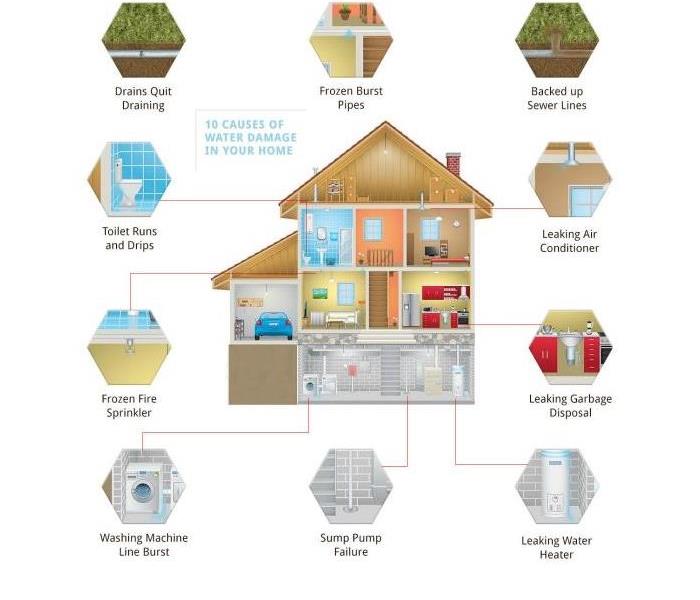 Water damage in Haddonfield NJ, top 10 causes of Water damage in your Property, water damage in Mt. Laurel NJ,
Water damage in Haddonfield NJ, top 10 causes of Water damage in your Property, water damage in Mt. Laurel NJ,
TOP 10 CAUSES OF WATER DAMAGE IN YOUR PROPERTY!
Sewage Damage, Water damage, Fire Damage, Smoke Damage, Water damage, Crime Scene Cleaning, Soot Damage, Biohazard cleaning, Camden, NJ, Woodbury, NJ, Deptford, NJ, Cherry Hill NJ, SERVPRO, Esporta Cleaning, sewage cleaning, fire damage, fire cleaning,
Old plumbing and leaky appliances around the house aren’t out to get you, but sometimes it seems that way. The weather plays a part too with winter freezes that burst pipes and spring rains that flood basements.Our cleanup and restoration teams have seen it all here in Chicago and the surrounding suburbs. In our experience, these are the 10 most common causes of residential water damage that can affect your home. Our list also includes helpful links and tips on how to handle each type of wet disaster.
1. The Toilet Runs and Drips
When it constantly runs, it’s annoying and expensive. When it springs a bad leak, it can ruin floors and walls. The trick to fixing a leaky toilet is figuring out why it’s turned into a water hazard. Once you pinpoint the problem, repairs are usually simple and inexpensive.
2. Pressure Gets to the Washing Machine
Your washing machine quickly fills with water because its supply lines are under constant pressure. Older rubber or PVC lines wear out and rupture, and that failure turns the laundry room into a flood zone. Avoid this potential mess by replacing old lines with braided stainless steel.
3. Your Garbage Disposal Floods Cabinets
Most disposal leaks are DIY fixable, but when this appliance stops working, it can go out with a splash. As the body of the unit gets old, it springs leaks around the bottom housing and floods cabinets with a dirty mix of food garbage and water. When this happens, you need to replace the disposal.
4. Your AC Soaks the Ceiling
The AC pulls humidity out of the air and condenses moisture into the unit’s overflow pan so that water travels outside through the condensate line. This drainage system quits working if the pan is damaged or the line is clogged. The results are soggy insulation and soaked ceilings.
5. The Water Heater Develops Leaks
This appliance is often located in basements, and that can make cleanup even more challenging after a bad leak. Sometimes, a water heater problem is due to condensation, but it’s more likely a faulty water outlet or drain valve. Older units can develop leaks in the bottom of the tank and flood the entire basement.
6. Frigid Temperatures Burst Pipes
This water emergency is confined to cold months, but you have to be prepared. Pipes can freeze and rupture in just a few hours, and the flooding can soak the house from ceiling to basement. Always check and insulate your plumbing before the Chicago winter settles in.
7. Fire Sprinkler Systems Freeze Too
High-rises, condos and newer homes feature these life-saving systems, but residential fire sprinklers are prone to freezing without proper winter maintenance. Cold-weather sprinkler routines keep the family safe and help avoid water damage from ruptured pipes.
8. The Sump Pump Stops Pumping
Whether it’s caused by heavy rain or appliance failure, water in the basement is a disaster when the sump pump stops working. You have to deal with water removal, thoroughly dry everything and address mold and mildew growth. It’s often best to let professionals handle basement flooding.
9. Drains Quit Draining
This simple outlet can complicate an ordinary day by leaving standing water in a tub, the kitchen sink or the basement. A stopped-up tub or sink is a big nuisance, but a clogged floor drain can result in a basement filled with water. Your DIY solutions range from drain snakes to air blasters.
10. Sewer Lines Back Up
Don’t try to handle this problem by yourself. Backed-up sewer lines are caused by blockage or heavy rainfall, and they quickly spread dangerous contaminants that create a very unhealthy environment. Sewage backup and flooding should always be taken care of by certified professionals.
Storm Damage in Cherry Hill NJ, Saharan Air Layer, Water damage in Haddonfield NJ, Roof Damage in Cherry Hill NJ,
7/25/2017 (Permalink)
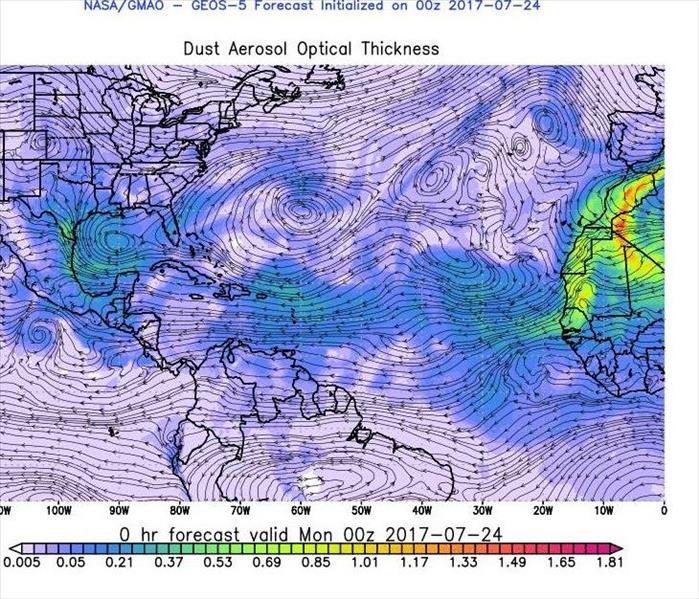 Storm Damage in Cherry Hill NJ, Saharan Air Layer, Water damage in Haddonfield NJ, Roof Damage in Cherry Hill NJ,
Storm Damage in Cherry Hill NJ, Saharan Air Layer, Water damage in Haddonfield NJ, Roof Damage in Cherry Hill NJ,
The Saharan Air Layer (SAL) is an extremely hot, dry and sometimes dust-laden layer of the atmosphere that often overlies the cooler, more-humid surface air of the Atlantic Ocean. In the Sahara Desert region of North Africa, where it originates, it is the prevalent atmosphere, extending from the surface upwards several kilometers. As it drives, or is driven, out over the ocean, it is lifted above the denser marine air. This arrangement is an inversion where the temperature increases with height. The boundary between the SAL and the marine layer suppresses or "caps" any convection originating in the marine layer. Since it is dry air, the lapse rate within the SAL itself is steep, that is, the temperature falls rapidly with height.
Disturbances such as large thunderstorm complexes over North Africa periodically result in vast dust and sand storms, some of which extend as high as 6,000 meters. These can be driven out to sea within the SAL as far west as North America.
In the case of Africa, winds blow twenty percent of dust from a Saharan storm out over the Atlantic Ocean, and twenty percent of that, or four percent of a single storm's dust, reaches all the way to the western Atlantic. The remainder settles out into the ocean or washes out of the air with rainfall. Scientists think that the July 2000 measurements made in Puerto Rico, nearly 8 million tonnes, equaled about one-fifth of the total year's dust deposits.
The SAL passes over the Canary Islands where the phenomenon is named "Calima" and manifests as a fog that reduces visibility and deposits a layer of dust over everything.
These clouds of dust are visible in satellite photos as a milky white to gray shade, similar to haze.
Findings to date indicate that the iron-rich dust particles that often occur within the SAL reflect solar radiation, thus cooling the atmosphere. The particles also reduce the amount of sunlight reaching the ocean, thus reducing the amount of heating of the ocean. They also tend to increase condensation as they drift into the marine layer below, but not precipitation as the drops formed are too small to fall and tend not to readily coelesce. These tiny drops are subsequently more easily evaporated as they move into drier air laterally or dry air mixes down from the SAL aloft. Research on aerosols also shows that the presence of small particles in air tends to suppress winds. The SAL has also been observed to suppress the development and intensifying of tropical cyclones, which may be related directly to these factors.
Water damage in Collingswood NJ, Flood damage in Audubon NJ, 5 dangers to be aware of after a flood strikes,
7/14/2017 (Permalink)
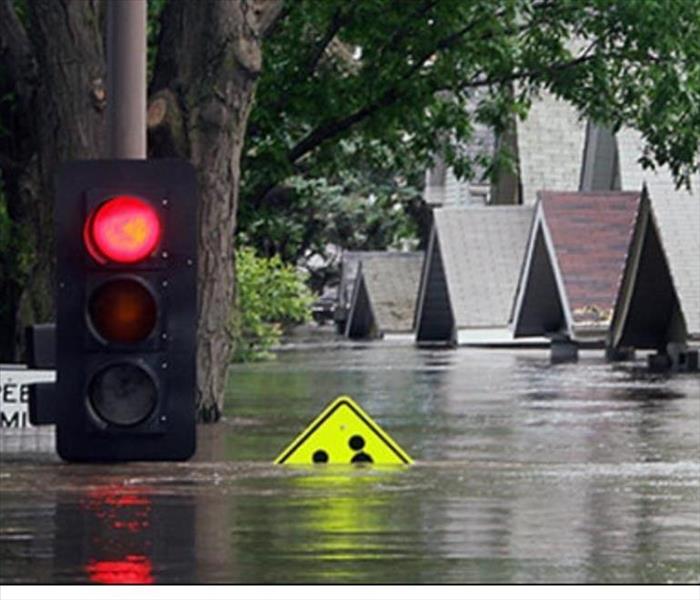 Water damage in Collingswood NJ, Flood damage in Audubon NJ, 5 dangers to be aware of after a flood strikes,
Water damage in Collingswood NJ, Flood damage in Audubon NJ, 5 dangers to be aware of after a flood strikes,
Water damage in Collingswood NJ, Flood damage in Audubon NJ, 5 dangers to be aware of after a flood strikes,
Among all weather-related natural disasters, floods have been both the most common and most costly in the United States, according to the U.S. Geological Survey. They can create billions of dollars in damage a year and kill hundreds of people.
Their widespread impact is part of the reason people should understand the threats floods can pose.
Every community should at least be aware of flood dangers and be prepared for them because you never know when flooding may occur.
Additionally, the dangers of floods do not disappear after water levels stop rising. Here are five factors to remember when recovering from a flood.
1. Be wary of damaged utilities
Water may have damaged electrical power and natural gas or propane, the Centers for Disease Control (CDC) reports. Minimize any fire hazards by turning off these utilities, especially if an odor, fraying wiring or sparks are present. Only turn the power on or off if you can do so from a dry location. Otherwise, call an electrician.
Contact the proper authorities, such as the gas or electric company, the police department or the fire department to help determine when turning utilities back on is safe.
2. Protect yourself against carbon monoxide
More than 400 Americans die from unintentional carbon monoxide (CO) poisoning a year, the CDC reported, and this risk can increase after a flood.
Generators, pressure washers, charcoal grills and other fuel-burning tools can release CO, which can collect in dangerous concentrations when used indoors or near open doors, windows or air vents.
The CDC recommends avoiding use of these in enclosed or partially enclosed areas, and encourages people to buy battery-powered carbon monoxide detectors. These should be placed outside all sleeping areas and, for added protection, near a home's heat source.
3. Minimize contact with dirty water
Remaining floodwater can also pose various hazards. It may be mixed with sewage or other hazardous substances, like chemicals, or it could be hiding downed power lines or sharp objects.
The CDC reports "outbreaks of communicable diseases after floods are unusual," but ingesting or exposing an open wound to the floodwater increase the risk of diarrheal diseases or infection.
Dry out homes as soon as possible and thoroughly wash and disinfect clothes, linens and hard surfaces. Discard anything that cannot be cleaned -- this includes contaminated drywall and insulation.
4. Control Mold
Mold can also be a major issue if it is not addressed after a flood.
People who are sensitive to molds or who have chronic lung illnesses can have reactions varying in severity from eye irritation to lung infections.
Mold can dry out, but the dried spores can still pose a risk if they enter the air. Proper cleanup is essential after a flood.
5. Avoid traveling through flood water
Never enter swiftly flowing water, and do not try to drive or walk through standing water because underneath the road could be compromised or blocked by debris.
When it comes to moving water, obviously you should try to get to high ground and get away from flooding whenever possible. Don't put yourself into moving water. If you have standing water, you certainly don't want to drive or walk through that either if you can't see to the bottom of it.
The CDC also reports that driving through floodwaters can be deadly because "as little as 6 inches of water may cause one to lose control of a motor vehicle, and 2 feet of water can carry most cars away."
Smoke damage in Mt Laurel NJ, Why Professionals Should Clean Smoke Damage From A Fire, Smoke damage in Mt. Laurel NJ,
7/13/2017 (Permalink)
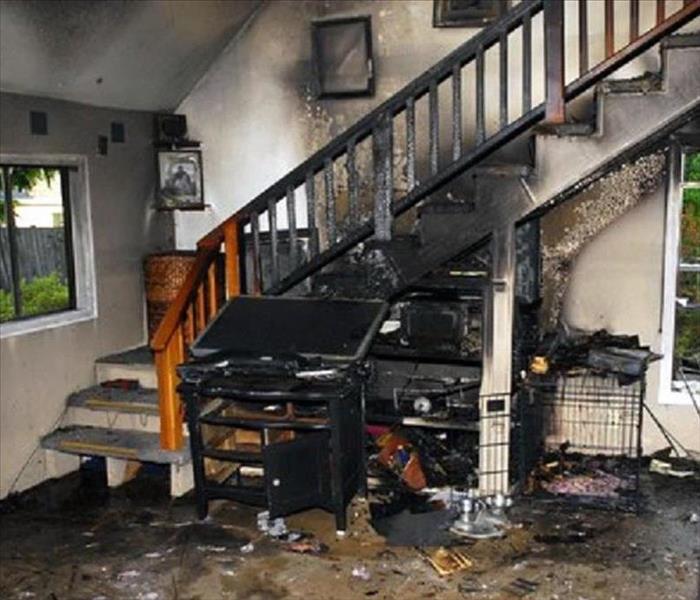 Smoke damage in Mt Laurel NJ, Why Professionals Should Clean Smoke Damage From A Fire, Smoke damage in Mt. Laurel NJ,
Smoke damage in Mt Laurel NJ, Why Professionals Should Clean Smoke Damage From A Fire, Smoke damage in Mt. Laurel NJ,
Smoke damage in Mt Laurel NJ, Why Professionals Should Clean Smoke Damage From A Fire, Smoke damage in Mt. Laurel NJ,
When the firefighters leave, it may seem like the danger has passed and the home is safe from further destruction, but without professionals to help clean the smoke damage, the building will never return to normal. While the principles behind fire restoration are fairly simple, it requires a lot of experience and manpower to perform adequately, and this means that it shouldn’t be attempted by a homeowner on his or her own.
While fire is always the immediate danger, once it is gone, what it leaves behind will continue to affect the house. Ash and smoke, if left unhindered, will cause extensive corrosion, etching and discoloration, not to mention lingering powerful odors. Professionals that clean fire and smoke damage can stop this before it becomes a major problem, assuming they are contacted soon enough. There are many companies out there that advertise their ability to restore areas affected by fire, but only those with proper training and certification should be considered. The Institute of Inspection Cleaning and Restoration Certification (IICRC) is the main oversight agency in this industry. The IICRC requires its registrants to take extensive coursework before earning their certification. This is a symbol of excellence, and those that uphold the standards that have been set can be contacted through the IICRC.
These professionals can clean smoke damage and restore items affected by a fire, but they must be brought to the site as soon as possible to halt the ongoing issues that ash residue can cause. The first thing that ash does to the home is discolor most surfaces. Anything that is made of plastic or was close to the fire will start discoloring within minutes, and within several hours, fiberglass and finishes on appliances will begin to yellow. Metals may also tarnish. After a few days pass, the ash will cause walls to discolor permanently, along with clothing and upholstery. Wood and vinyl will need to be refinished or replaced, and metal will start corroding.
If a professional isn’t hired to clean smoke and fire damage, the costs for restoration will skyrocket after a few weeks. Metals may need to be replaced, carpet will permanently discolor and glass may be severely etched, which will necessitate replacement. It will also become apparent that the odors caused by the disaster may still be present and intense enough to be distracting. Because ash is acidic, the longer it takes to hire experts, the more destruction it will cause.
The first thing a trained, certified, professional company will do when on site is to identify all affected materials and the source of any odors. The only way to properly clean smoke and fire damage is to be extremely thorough. Ash residue is easily disturbed and can spread through the building with ease, causing nearly everything to need restoration. The experts will identify what can and cannot be salvaged, and will remove any built-up ash residue that is coating surfaces. Over time, ash builds up in layers, and may eventually form into a lacquer-like consistency. Once this is done, the restorers will locate the source of the odor, and treat it with specialized detergents that are formulated for neutralizing this kind of odor. Once materials are treated, they may be sealed off to prevent any further odor from permeating the air in the future.
This entire process is very detailed, and hiring a professional that can be trusted to do the job right is imperative.
Humidity, Water Damage in Mt. Laurel NJ, Condensation, Mold, and Indoor Air Quality, in Mt. Laurel NJ,
7/12/2017 (Permalink)
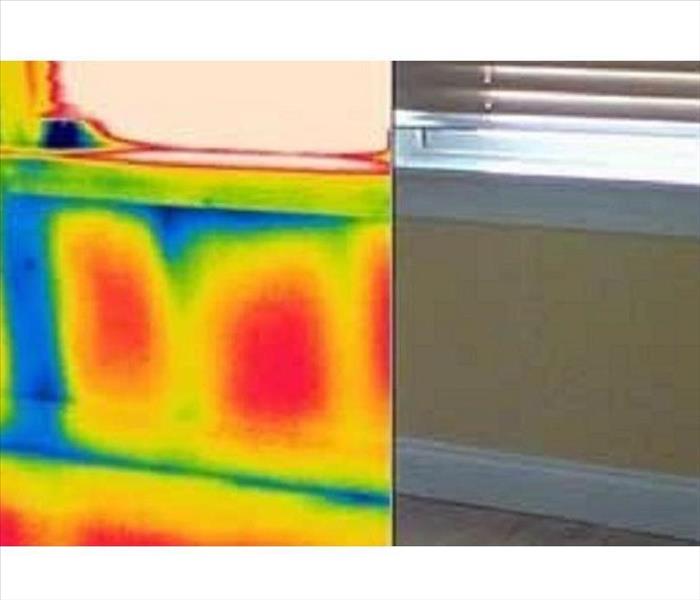 Humidity, Water Damage in Mt. Laurel NJ, Condensation, Mold, and Indoor Air Quality, in Mt. Laurel NJ,
Humidity, Water Damage in Mt. Laurel NJ, Condensation, Mold, and Indoor Air Quality, in Mt. Laurel NJ,
Humidity, Water Damage in Mt. Laurel NJ, Condensation, Mold, and Indoor Air Quality, in Mt. Laurel NJ,
Moisture rides on air currents, and warm air carries more moisture than cool air
To control air flows, make sure the air barrier is continuous
An air barrier helps control airflow both through and within the building enclosure. By controlling airflow, you also control moisture.
If moist indoor air contacts a cold surface — for example, exterior sheathing in cold weather — condensation can result. An air barrier prevents those cold surfaces from being connected with humid indoor air.
Air has a maximum storage capacity for water vapor which depends on temperature. Warm air can store lots of moisture, while cold air can store very little.
As the temperature falls from 90°F down to 20°F, the amount of moisture that can be stored in the air changes by a factor of ten.
Leaky homes didn’t have condensation problems
Older buildings rarely had condensation problems in cold weather because they were so well ventilated — meaning leaky. The relative humidity in an old home would rarely rise above 25%. As we have built tighter houses (and in some cases failed to provide mechanical ventilation), the indoor relative humidity has gone up.
In a heated, tight, unventilated house, the amount of moisture in the air and the amount of condensation that can occur are dramatically different than in an old leaky house. Condensation can occur wherever water vapor can find a cold spot — on roof or wall sheathing, on the inside faces of the windows, and inside the walls.
Let's say it’s 40°F outside and the outdoor relative humidity is 50%. If you allow that outdoor air to enter a building and heat it up to 70°F, the amount of moisture in the air stays exactly the same, but the “tank” gets bigger because the storage capacity of the air increases with the temperature. As a result, the relative humidity initially drops. Then, as moisture is added to the air, the relative humidity rises, and the absolute moisture content rises as well. How do you add moisture to the air? You breathe, sweat, boil water for spaghetti, take hot showers, grow houseplants — and all of those activities generate moisture.
When does indoor humidity become a problem?
Let’s say that air leaks out of a house through holes in the enclosure. As it reaches surfaces colder than 52°F or 53°F, the air will cool. Once it reaches its full capacity to store moisture, condensation occurs.
If the temperature of the outdoor air is around 30°F, the indoor air will drop all of the moisture that it gained on the way out, dumping it on the cold sheathing surface. That’s a typical example of the air leakage condensation cycle. Since condensation in walls can cause puddles — and in extreme cases, rot the framing — condensation is something you want to avoid. Installing an air barrier is one way to help prevent condensation.
Air conditioning can also create condensing surfaces
The same phenomenon can happen in reverse in the summertime. Let’s say the outdoor air is 85°F and the relative humidity is 75%. When outdoor air leaking inward contacts a surface below about 76°F, the moisture in the air will condense. So if you have an exhaust fan in your home, the air leaking in may cause condensation on the air-conditioned surfaces — for example, on the back side of vinyl wallpaper.
If moist air leaks into a house through gaps in the wall or roof, you can have problems. But in a tight house with a good air barrier and a supply-only ventilation system, most of the air that’s drawn inside is drawn in through the air conditioner, so the first cold surfaces it sees are the cooling coils.
If you have air leaks in your building envelope, you usually can’t see the condensation —Unless you have an Infrared Camera with a Visual Inspection. However, condensation is sometimes visible in the attic; all you have to do is look for frost or dampness forming on the underside of the OSB or plywood roof sheathing.
Water Damage in Cherry Hill NJ, Flood Damage in Cherry Hill NJ, Detect and Prevent
7/11/2017 (Permalink)
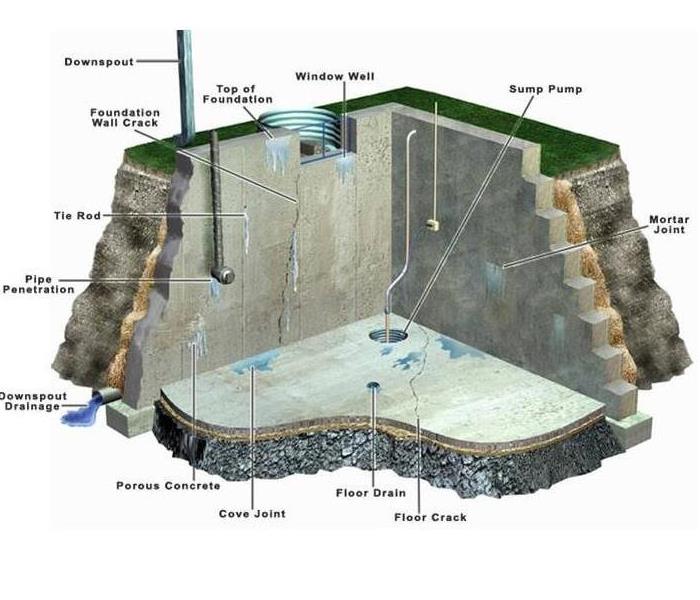 Water Damage in Cherry Hill NJ, Flood Damage in Cherry Hill NJ, Detect and Prevent
Water Damage in Cherry Hill NJ, Flood Damage in Cherry Hill NJ, Detect and Prevent
Water Damage in Cherry Hill NJ, Flood Damage in Cherry Hill NJ, Detect and Prevent
Standing water on the floor is easy to see. Less obvious signs of problems include:
- Unexpected increases in your water bill
- Stains on walls, floors or ceilings
- Damaged or warped flooring
- Warped bottom panels in under-sink cabinets
- Peeling paint or wallpaper
- Corrosion on plumbing valves and fittings
Deal with problems as you find them. Clean up any water or moisture, locate the source and make repairs. Tracking down a leak isn't always straightforward — water can travel along components in the building structure, so the indications of the leak may be in a different part of the home than the leak itself. If necessary, contact a professional roofing contractor, plumber or water damage restoration specialist to help with identification and repair.
In addition to the damage that water causes, it can encourage the growth of mold on walls and floors — where it's readily visible — and in ductwork, attics and crawl spaces — where you might not notice it. A musty odor is a sign that mold may be present.
Mold can cause damage and lead to health problems — deal with it quickly. If the affected area is larger than 3 feet by 3 feet, the Environmental Protection Agency recommends you find a professional mold remediation contractor. For smaller areas, you can clean nonporous surfaces with commercial cleaning products, soap and water or a solution of a cup of bleach to each gallon of water. Follow the instructions and safety precautions for the cleaning product you use and wear appropriate safety gear. Porous surfaces such as drywall need to be replaced. For more information on mold in the home and how to clean it up, see A Brief Guide to Mold, Moisture, and Your Home on the EPA's web site.
Inspecting common sources of water leaks and taking some simple preventative measures can be an effective way to reduce the risk of water damage and mold.
Plumbing
- Every 6 to 12 months, inspect water lines, shut-off valves and fittings for fixtures such as sinks, toilets and tubs and for appliances such as washing machines, dishwashers and ice makers. Check for cracks, loose connections, kinks and corrosion. If you find a leak, turn off the water to the fixture or appliance until you can make repairs.
- Check around toilets to make sure water is not leaking at the base — an indication that the wax ring between the toilet and floor might need replacing or that there might be a crack in the base.
- If the temperature drops near the 20°F mark, allow faucets connected to vulnerable pipes — those not protected in insulated spaces — to drip. This helps minimize the risk of burst pipes by relieving pressure if the pipes freeze.
Appliances
- Replace washing machine supply hoses at least every five years. Consider using stainless-steel mesh hoses. Keep the machine properly balanced — over time, an unbalanced machine can move, pulling free the hose connections. Read Maintain Your Washer and Dryer for instructions on replacing hoses and balancing the washing machine.
- Consider turning off the water to the washing machine when it's not in use.
- Don't operate a dishwasher or washing machine while your house is unoccupied.
- Follow the manufacturer-specified maintenance for your appliances, including your water heater. Have the water heater inspected every couple of years.
Roof and Gutters
- Have your roof inspected every three years by a professional, but also check routinely for damage you can see from the ground — such as broken and missing shingles or damaged flashing. A poorly maintained roof can lead to leaks in the home and additional damage to the roof itself.
- If your roof doesn't have a drip edge or drip cap, consider having one added. This component helps keep water away from the roof deck and directs runoff into gutters.
- Keep gutters clear and well-maintained. Gutters that overflow, leak or don't drain properly allow water to seep into your roof and into your foundation, crawlspace or basement. See Gutter Cleaning and Repair for steps to keep your gutters working correctly.
- Make sure gutter downspouts direct rainwater away from the home's foundation. Use extensions to carry water at least 6 feet from the house.
Exterior Walls and Foundation
- Inspect the exterior of your home. Caulk around gaps at plumbing and ventilation entry and exit points. See How to Caulk for instructions. Repair cracked mortar joints.
- Check to see if roots from shrubs near your home have caused damage that can allow water to enter the foundation. You may need to remove shrubs that are close to the house to prevent problems. Roots can also damage and block in-ground pipes, causing leaks near the foundation and sewer backups in the home.
- Keep shrubbery beds and other landscape features sloped to direct water away from the home.
- Look for evidence of erosion or settling at the foundation that can indicate water problems.
Additional Tips to Avoid Water Damage
- Have your attic ventilation and insulation inspected annually and seal gaps that allow warm air into the attic — such as those around access doors and light fixtures. When warm air collects in the attic, it can lead to the formation of an ice dam — ice around the eaves that causes water from melting snow and ice to back up under the shingles and leak into your home.
- If you have a sump pump, test it several times during the year. Follow the manufacturer's maintenance instructions.
- Check your water pressure with a pressure gauge; typically these screw onto a hose bib. The pressure in an average home is around 50 to 70 pounds per square inch (psi). Higher pressure causes extra stress on pipes and fittings and can lead to leaks.
- Inspect tile and grout around showers and tubs. Make any necessary repairs. Read Replace a Broken Ceramic Tile and Repair Tile Grout for step-by-step instructions.
- Check for leaks around windows during rains and seal any you find.
- Use exhaust fans in the kitchen and bathroom to move excess moisture out of the house. Moisture in the air can condense on cool surfaces and cause problems. Read Controlling Moisture and Humidity in the Home for more ways to reduce indoor moisture.
- Locate your water shut-off valve so you can quickly turn off water to the home in an emergency. See Shut Off Your Home Water Supply for instructions on locating the valve.
Fire damage in Cherry Hill NJ, Smoke damage in Cherry Hill NJ, Fire safety in Cherry Hill NJ,
7/7/2017 (Permalink)
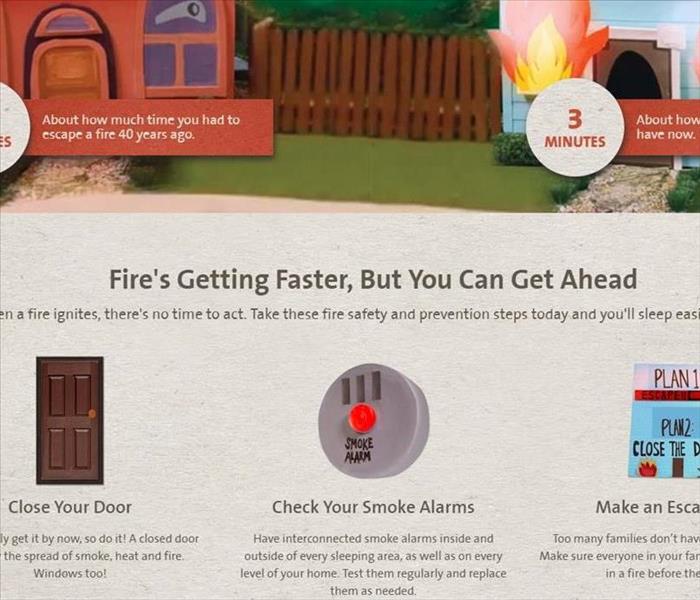 Fire damage in Cherry Hill NJ, Smoke damage in Cherry Hill NJ, Fire safety in Cherry Hill NJ,
Fire damage in Cherry Hill NJ, Smoke damage in Cherry Hill NJ, Fire safety in Cherry Hill NJ,
Fire damage in Cherry Hill NJ, Smoke damage in Cherry Hill NJ, Fire safety in Cherry Hill NJ,
Why is the Close Your Door message so important now? Because fires have become more dangerous than ever.
Modern synthetic construction materials, home furnishings, and contemporary layouts allow fire to spread and become toxic much faster – like three-minutes-or-less-to-get-out faster.
But a closed door can slow the spread, reduce toxic smoke levels, improve oxygen levels and decrease temperatures dramatically – and that could make a life-saving difference in your home.
Fires can be especially devastating to your home or business. After the fire trucks leave, your property will likely suffer from not only fire and smoke damage, but also widespread water damage and flooding from firefighting efforts. SERVPRO Franchise Professionals have specialized fire and water damage restoration training and experience to quickly clean up and restore your home to pre-fire condition. They also can remove the pervasive smoke odor and deep-clean soot from upholstery and carpet.
Sewage Cleaning in Cherry Hill NJ, Sewage Backup in Cherry Hill NJ, and Prevention Tips..
7/6/2017 (Permalink)
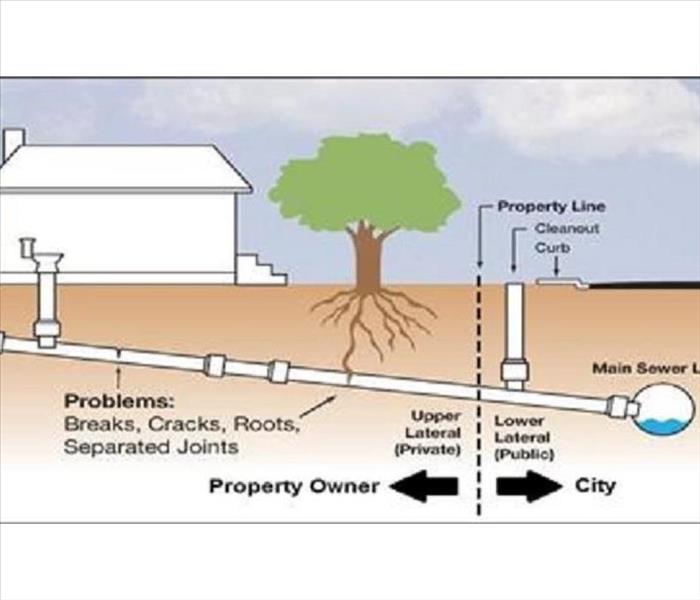 Sewage Cleaning in Cherry Hill NJ, Sewage Backup in Cherry Hill NJ, and Prevention Tips..
Sewage Cleaning in Cherry Hill NJ, Sewage Backup in Cherry Hill NJ, and Prevention Tips..
Sewage Cleaning in Cherry Hill NJ, Sewage Backup in Cherry Hill NJ, and Prevention Tips..
Backed up sewers can wreak havoc on a home, causing thousands of dollars in damage to floors, walls, furniture and electrical systems. Sewer backup coverage is available from most insurers for a nominal cost—usually an additional annual premium of $40-$50.
For homes that have been severely damaged and are uninhabitable, homeowners policies may provide Loss of Use coverage, which provides reimbursement for lodging, food and other living expenses you may incur as a result of having to live outside of your home. Loss of Use coverage also reimburses you for the lost rental income if you rent out part of the house.
Causes of Sewer Backup
Aging Sewer Systems: The Civil Engineering Research Foundation reports that the number of backed up sewers is increasing at an alarming rate of about 3 percent annually. In addition, a recent report from the American Society of Civil Engineers indicates that the nation's 500,000-plus miles of sewer lines are on average over thirty years old. The increase in the number of homes connected to already aging sewage systems has also contributed to rapid increases in sanitary sewer backups, flooded basements and overflows.
Combined Pipelines: Problems also arise in systems that combine storm water and raw sewage into the same pipeline. During many rain storms, the systems are exposed to more volume than they can handle, and the result is a sewage backup situation that allows sewage to spew out into basements and other low lying drains.
Blockages Due to Tree Roots: Shrubs and trees seeking moisture will make their way into sewer line cracks. These roots can cause extensive damage. They may start out small, getting into a small crack in the pipe; but as the tree or shrub continues to grow, so does the root. Tree roots can enter the service pipe at joints and cause blockages. Tree roots can travel a long way, and roots from different types of trees act differently. If city trees are suspected, your plumber can contact the city, and samples of the roots will be used to help identify the trees and who is responsible for cleanup. Sometimes the blockage is a result of a combination of city and private trees. In this case costs are split between the city and the property owner.
Sanitary Main: A blockage can occur in a city sanitary main. If the blockage is not detected in time, sewage from the main can back up into homes and businesses through floor drains. Usually this happens slowly, giving the owner time to call a licensed plumber to assess the damage. If water is entering into your basement at a rapid rate, call the city public works office and report the problem immediately.
Water in Basement: Most basement flooding is not related to the sanitary sewer system. In many cases, soil settles adjacent to the building and, if not corrected, leads to rainwater flowing towards the building and down the outside of the foundation wall. This is particularly true in older buildings, where cracks may have developed in the foundation or floor slab that allow water to enter the basement. The cement floor and basement walls of these structures may have deteriorated to the point that they are no longer waterproof. In these cases, water can show up in a basement that has never had a water problem. This will usually happen after a number of rain storms, when the ground is saturated. Drainage can be improved by making sure that water drains away from the building. Owners may also be able to prevent flooding by water sealing the basement.
Most homeowners may not realize that they are responsible for the maintenance and repair of their house or sewer lateral—the pipeline between the city sanitary sewer main, usually located in the street—and the building. The sewer lateral is owned and maintained by the property owner including any part that extends into the street or public right of way. A cracked or deteriorated lateral or one filled with tree roots can allow groundwater to seep into the system, contributing to the problem.
How to File a Claim
For insurance purposes, take before and after photos of the affected areas and itemize any property losses. Save all receipts related to repair, cleaning or damages and contact your insurance agent or company representative as soon as possible.
How to Prevent Backups In Your Lateral and in the City Main
Dispose of Grease Properly: Cooking oil should be poured into a heat-resistant container and disposed of properly, after it cools off, not in the drain. Washing grease down the drain with hot water is unsatisfactory. As the grease cools off, it will solidify either in the drain, the property owner's line, or in the main sewer causing the line to constrict and eventually clog.
Dispose of Paper Products Properly: Paper towels, disposable (and cloth) diapers and feminine products can cause a great deal of trouble in the property owner's lateral as well as in the city main. These products do not deteriorate quickly, as bathroom tissue does, so do not put them down the drain or toilet.
Replace Your Line with New Plastic Pipe: One way to prevent tree roots from entering your line is to replace your line and tap with new plastic pipe. If you have continuing problems with tree roots in your lateral, you may have to have the roots cut periodically.
Correct Illegal Plumbing Connections: Do not connect French drains, sump pumps and other flood control systems to your sanitary sewer. It is illegal, and debris and silt will clog your line. Consult a plumber to correct any pre-existing illegal connections. French drains are common drainage systems, primarily used to prevent ground and surface water from penetrating or damaging building foundations.
Install a Backwater Prevention Valve: A backwater valve is a fixture installed into a sewer line, and sometimes into a drain line, in the basement of your home or business to prevent sewer backflows. A properly installed and maintained backwater valve allows sewage to go out, but not to come back in. Property owners are responsible for the installation and maintenance of backwater valves. The cost to install one depends on the type of plumbing in the building and the difficulty of installation. Check with a qualified plumber.
What to Do If You Experience a Sewer Backup
A sewer backup can lead to disease, destruction of your valuables, damage to your house or business, and can even result in electrical malfunctions. Prompt cleanup of affected property can help minimize the inconvenience and prevent mold or further damage. If you experience a sewer backup situation, immediately arrange for the cleanup of your property. This should include:
- Wet-vacuuming or removal of spillage
- Mopping floors and wiping walls with soap and disinfectant
- Flushing out and disinfecting plumbing fixtures
- Steam cleaning or removing wet carpets or drapes
- Repairing or removing damaged wallboard or wall covering
- Cleanup of ductwork
Water Damage in Cherry Hill NJ, Flood Damage in Cherry Hill NJ,
7/5/2017 (Permalink)
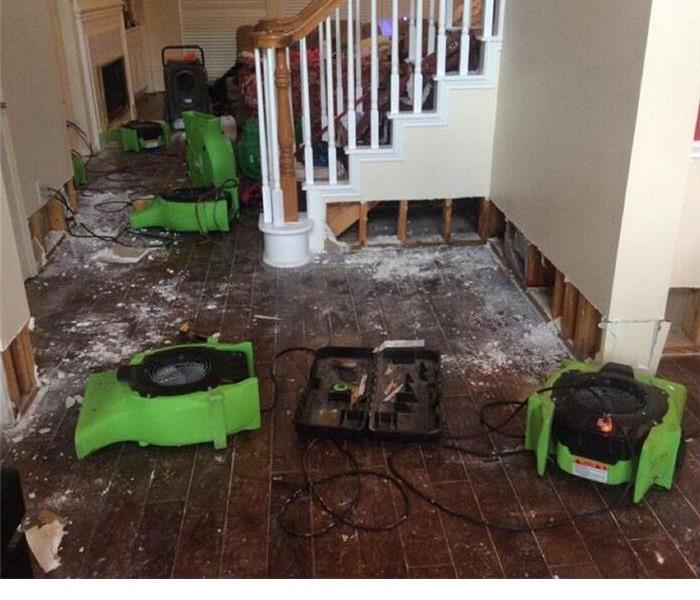 Water Damage in Cherry Hill NJ, Flood Damage in Cherry Hill NJ,
Water Damage in Cherry Hill NJ, Flood Damage in Cherry Hill NJ,
Water Damage in Cherry Hill NJ, Flood Damage in Cherry Hill NJ,
Water damage describes a large number of possible losses caused by water intruding where it will enable attack of a material or steel by destructive processes such as rotting of wood, growth, rusting of steel, de-laminating of materials such as plywood, and many others.
The damage may be imperceptibly slow and minor such as water spots that could eventually mar a surface, or it may be instantaneous and catastrophic such as flooding. However fast it occurs, water damage is a major contributor to loss of property.
An insurance policy may or may not cover the costs associated with water damage and the process of water damage restoration. While a common cause of residential water damage is often the failure of a sump pump, many homeowner's insurance policies do not cover the associated costs without an addendum which adds to the monthly premium of the policy. Often the verbiage of this addendum is similar to "Sewer and Drain Coverage".
Those individuals who are affected by wide scale flooding may have the ability to apply for government and FEMA grants through the Individual Assistance program. On a larger level, businesses, cities, and communities can apply to the FEMA Public Assistance program for funds to assist after a large flood. For example, the city of Fond du Lac Wisconsin received $1.2 million FEMA grant after flooding in June 2008. The program allows the city to purchase the water damaged properties, demolish the structures, and turn the properties into public green space.
Causes
Water damage can originate by different sources such as a broken dishwasher hose, a washing machine overflow, a dishwasher leakage, broken/leaking pipes, and clogged toilets. According to the Environmental Protection Agency, 13.7% of all water used in the home today can be attributed to plumbing leaks. On average that is approximately 10,000 gallons of water per year wasted by leaks for each US home. A tiny, 1/8-inch crack in a pipe can release up to 250 gallons of water a day. According to Claims Magazine in August 2000, broken water pipes ranked second to hurricanes in terms of both the number of homes damaged and the amount of claims (on average $50,000 per insurance claim costs in the US. Experts suggest that homeowners inspect and replace worn pipe fittings and hose connections to all household appliances that use water at least once a year. This includes washing machines, dishwashers, kitchen sinks and bathroom lavatories, refrigerator ice makers, water softeners and humidifiers. A few US companies offer whole-house leak protection systems utilizing flow-based technologies. A number of insurance companies offer policy holders reduced rates for installing a whole-house leak protection system.
As far as insurance coverage is concerned, most damage caused by bad weather is considered flood damage and normally is not covered under homeowners insurance. Coverage for bad weather would usually require flood insurance.
Categories
Category 1 Water - Refers to a source of water that does not pose substantial threat to humans and classified as "clean water". Examples are broken water supply lines, tub or sink overflows or appliance malfunctions that involves water supply lines.
Category 2 Water - Refers to a source of water that contains a significant degree of chemical, biological or physical contaminants and causes discomfort or sickness when consumed or even exposed to. Known as "grey water". This type carries micro organisms and nutrients of micro organisms. Examples are toilet bowls with urine (no feces), sump pump failures, seepage due to hydrostatic failure and water discharge from dishwashers or washing machines.
Category 3 Water - Known as "black water" and is grossly unsanitary. This water contains unsanitary agents, harmful bacteria and fungi, causing severe discomfort or sickness. Type 3 category are contaminated water sources that affects the indoor environment. This category includes water sources from sewage, seawater, rising water from rivers or streams, ground surface water or standing water. Category 2 Water or Grey Water that is not promptly removed from the structure and or have remained stagnant may be re classified as Category 3 Water. Toilet back flows that originates from beyond the toilet trap is considered black water contamination regardless of visible content or color.
Classes
Class of water damage is determined by the probable rate of evaporation based on the type of materials affected, or wet, in the room or space that was flooded. Determining the class of water damage is an important first step, and will determine the amount and type of equipment utilized to dry-down the structure.
Class 1 - Slow Rate of Evaporation. Affects only a portion of a room. Materials have a low permeance/porosity. Minimum moisture is absorbed by the materials.
Class 2 - Fast Rate of Evaporation. Water affects the entire room of carpet and cushion. May have wicked up the walls, but not more than 24 inches.
Class 3 - Fastest Rate of Evaporation. Water generally comes from overhead, affecting the entire area; walls, ceilings, insulation, carpet, cushion, etc.
Class 4 - Specialty Drying Situations. Involves materials with a very low permeance/porosity, such as hardwood floors, concrete, crawlspaces, plaster, etc. Drying generally requires very low specific humidity to accomplish drying.
Restoration
See also: Convectant drying
Different removal methods and measures are used depending on the category of water. Due to the destructive nature of water, chosen restoration methods also depend heavily on the amount of water, and on the amount of time the water has remained stagnant. For example, as long as carpet has not been wet for longer than 48 hours, and the water involved was not sewage based, a carpet can usually be saved; however, if the water has soaked for longer, then the carpet is probably irreparable and will have to be replaced. Water damage restoration can be performed by property management teams, building maintenance personnel, or by the homeowners themselves; however, contacting a certified professional water damage restoration specialist is often regarded as the safest way to restore water damaged property.
Standards and regulation
While there are currently no government regulations in the United States dictating procedures, two certifying bodies, the Institute of Inspection Cleaning and Restoration Certification (IICRC) and the RIA, do recommend standards of care. The IICRC-recommended standard is IICRC S500.
Fire and Water Restoration companies are regulated by the appropriate state's Department of Consumer Affairs - usually the state contractors license board. In California, all Fire and Water Restoration companies must register with the California Contractors State License Board. Presently, the California Contractors State License Board has no specific classification for "water and fire damage restoration."
Procedures
Water damage restoration is often prefaced by a loss assessment and evaluation of affected materials. The damaged area is inspected with water sensing equipment such as probes and other infrared tools in order to determine the source of the damage and possible extent of area affected. Restoration services would then be rendered to the residence in order to dry the structure, sanitize any affected or cross contaminated areas, and deodorize all affected areas and materials. After the labor is completed, water damage equipment including air movers, air scrubbers, dehumidifiers, wood floor drying systems, and sub floor drying equipment is left in the residence. Industry standards state that drying vendors should return at regular time intervals, preferably every twenty-four hours, to monitor the equipment, temperature, humidity, and moisture content of the affected walls and contents.
Mold Remediation in Haddonfield NJ, Mold Remediation in Cherry Hill NJ,
7/3/2017 (Permalink)
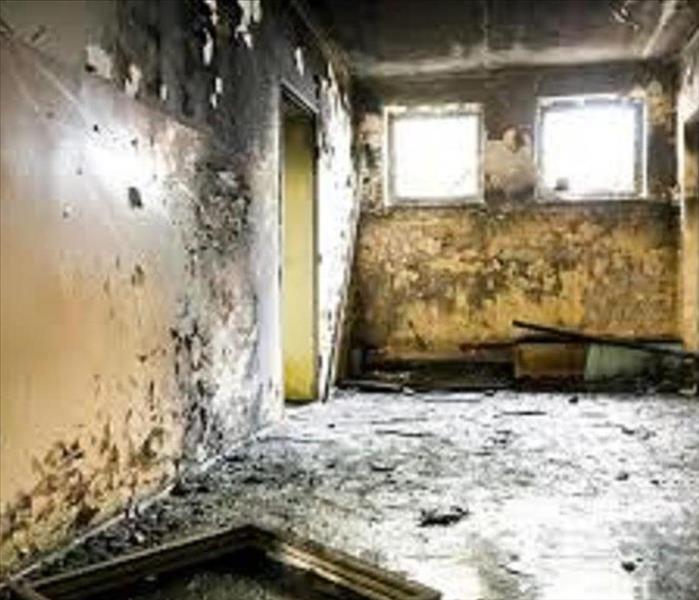 Mold Remediation in Haddonfield NJ, Mold Remediation in Cherry Hill NJ,
Mold Remediation in Haddonfield NJ, Mold Remediation in Cherry Hill NJ,
Mold Remediation in Haddonfield NJ, Mold Remediation in Cherry Hill NJ,
While residential property owners should be aware of conditions that could impact their home, learning about a mold infestation is particularly important. By getting a clear understanding of what mold is and how to prevent it, you can preclude your property from being subjected to structural damage and health hazards with mold remediation from SERVPRO. Learn more about mold and how to keep your property safe by reviewing this short outline:
Mold: A Brief Overview
Mold is a fungus. Positive factors for mold growth are moist, wet environments, a food source of cellulose or other organics and poor ventilation. Homeowners who suffer water damage often find that mold starts to proliferate in their residential property. If mold growth is not identified and treated, it can cause health effects. Additionally, mold can adversely impact your indoor air quality giving off a musty odor and cause discoloration of walls, ceilings and furniture.
Why You Should Hire A Professional Mold Remediation Specialist
Often, homeowners are interested in completing the mold removal process on their own. However, completing a do-it-yourself project in this instance is not very advisable. A small patch or a bit of mold on tile grout can be cleaned and controlled by a homeowner. Most homeowners do not possess the specialized equipment and safety gear and clothing required to execute the mold remediation services. Additionally, hiring a team of professional remediation specialists from SERVPRO can shorten significantly the unhealthy home air quality. Finally, most homeowners do not possess the knowledge and experience necessary to complete the mold removal process safely. When done incorrectly, DIY projects can cause you to spread the mold infestation in previously uncontaminated living areas thereby increasing susceptibility to health risks, structural damage, and costs.
Benefits Of Securing a Professional Mold Remediation Service
• Assessing the dangers of mold.
• Locating the source of the problem
•Containing affected regions of the home to prevent mold spore proliferation, including HVAC ductwork
• Eliminating the mold colonies, reducing mold spores to normal levels
•Cleaning, drying and disinfecting all surfaces affected by mold
Deodorizing the musty odor with ULV foggers
As an IICRC-certified company, the SERVPRO professionals are experts in Applied Microbial Remediation. Additionally, we are highly skilled in working directly with industrial hygienists, insurance adjusters, and residential property owners to offer full-service mold remediation service.
Having a company that can coordinate the whole process from start to finish to make your life easier, and gets you back in your home or business faster. “Like it never even happened.”
Termites Love Water Damaged Wood, Storm damage in Haddonfield NJ,
6/29/2017 (Permalink)
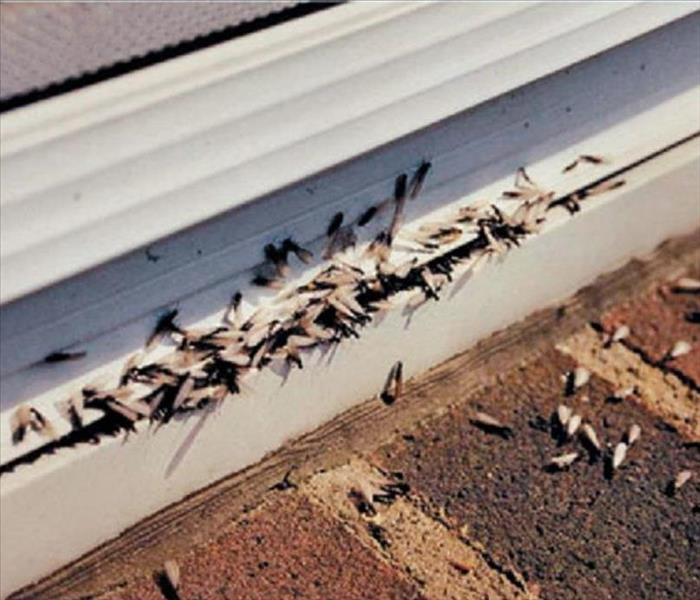 Termites Love Water Damaged Wood, Storm damage in Haddonfield NJ,
Termites Love Water Damaged Wood, Storm damage in Haddonfield NJ,
Termites Love Water Damaged Wood, Storm damage in Haddonfield NJ,
The American Dream of most people has always included owning their own home. While renting is sometimes the more practical approach, there is just something special about being able to call the place you live your very own. There are so many things one can do when they own their home…remodel, add on a room, investing in the upkeep and improvements of your dream home.
With that being said, the most important thing one can do involves preserving the value and structure of their house. This is much more important than all the decorating and beautifying of the home. At the top of the list of things that cause damage is moisture. Moisture causes multiple problems that include mildew, mold, rotting and decaying of wood and damaging painted surfaces. This list of moisture problems creates unsightly appearances, health issues and structural damage. Excessive water or moisture in the home also allows the potential of another scary problem—termites! Termites love water-damaged wood.
Termites are one of the homeowner’s greatest enemies. They are often referred to as Silent Destroyers. You may think this risk or threat does not affect you because you purchased your home not long ago and it was considered to be free of termites. The structure of your home may still be compromised because termites do their damage from the inside out and go undetected until the damage is extensive.
Many homeowners fail to recognize all the water and moisture problems that exist in their house. It does not require a mass flood or standing water for water damage to occur. In fact, you may be causing water damage to your home every time you take a shower or use the toilet. Of course the answer to this is not to stop showering or using the bathroom! However, you should periodically check the caulking around the shower stall or tub. Cracked or missing caulking can cause the wooden structure to be exposed to water and cause wet, decaying wood.
Another common, slow water leak is under the toilet where it connects to the floor. A slow leak may occur over a period of time allowing the subfloor under the toilet to stay wet. Again, this will cause the wood to always be wet and decay and attract those destructive termites.
Termites constantly need to be surrounded by moisture. They live several feet under the surface of the ground, thriving in the damp, cool dirt. They even build tunnels through which they travel as they make their way into your house foraging for their food; damp, water-damaged wood!
Keep your home dry and free of excess moisture and decaying wood. Repair any leaks, replace cracked or missing caulking, keep taking those showers and you will be able to enjoy your American dream home for many years!
Fire Damage in Haddonfield NJ, Smoke Damage in Haddonfield NJ, and Restoration, and the Process of Fire Restoration,
6/28/2017 (Permalink)
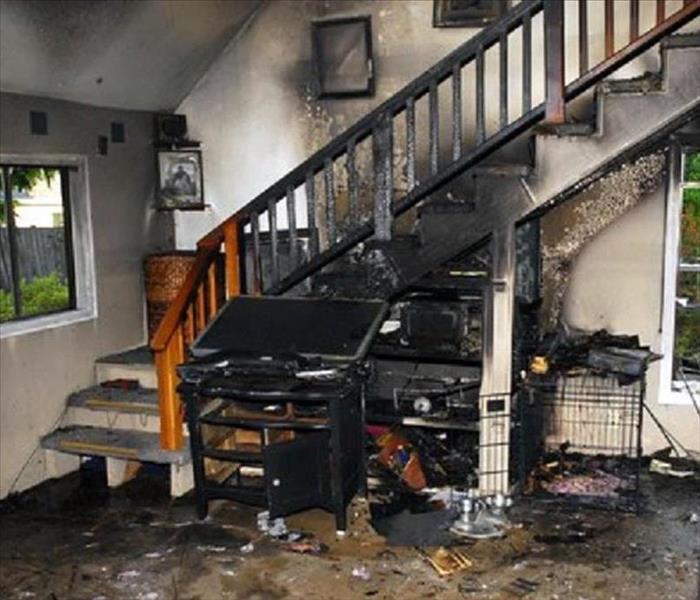 Fire Damage in Haddonfield NJ, Smoke Damage in Haddonfield NJ, and Restoration, and the Process of Fire Restoration,
Fire Damage in Haddonfield NJ, Smoke Damage in Haddonfield NJ, and Restoration, and the Process of Fire Restoration,
Fire Damage in Haddonfield NJ, Smoke Damage in Haddonfield NJ, and Restoration, and the Process of Fire Restoration,
The process of fire restoration can be very involved. Private homeowners and companies can oftentimes be devastated by the damage caused by this kind of event. One aspect that gives peace of mind involves knowing when the right professional has been hired. That is one of the reasons why it is important to hire a firm that is associated with the Institute of Inspection Cleaning and Restoration Certification.
Homeowners and business owners may be in shock from the initial devastation. It is important to try and follow the proper steps to achieve a complete fire restoration. Service providers that are associated with the Institute will have the following distinctions: current training, safety and health certifications, vast amounts of experience in restoration projects and the proper licenses and insurance information. Customers should also check all references and obtain price quotes prior to hiring anyone. Any contracts that are presented should be reviewed closely.
The first step in the process is to clean up as much of the existing area as possible. If the area is not immediately cleaned, soot residue and permanent damage can be left behind. If the homeowner or business owner does the initial cleaning, it is important to follow these steps. When cleaning, always use dust masks and open the area for proper ventilation. Clean from the ceilings to the floors and vacuum all floors and upholstery. Wash any items that are able to be laundered. Clean the outside with a pressure washer if available.
If immediate clean up is not done, it can lead to devastating effects. Within minutes of fire and smoke damage, appliances and many items will discolor to a yellow hue. After a few hours, acid will stain bathrooms and many other areas of the home or business. Within days, walls will discolor permanently and items will begin to rust due to the acid residue. Finally, after weeks the cost of clean-up will become substantially more expensive. The building and furnishings can be permanently damaged by the acid left behind. Soot residue will be layered throughout the home or business. For these reasons, it is vital to contact a professional associated with the Institute of Inspection Cleaning and Restoration Certification to utilize fire restoration techniques in an effort to return the home or business to a preloss state. One company or service provider should be able to handle the damage. The seal of Certification by the Institute should be shown on any provider’s website. This shows the customer the reliability and the expertise of the service provider.
Residue and smoky odors need to be removed immediately. Professionals will use the process of fire restoration to achieve satisfactory results. These providers will remove the source of the odor, clean any items that can be salvaged, get rid of any lingering odor with an odor counteractant and deodorizing fog. Finally, the provider will seal salvageable items to encapsulate odor and prevent further recontamination.
Homeowners and businesses that are educated in the fire restoration process are able to minimize the cost of repair. Professionals can be contacted in a timely manner to return the area to a preloss state. By hiring the right professionals the victims can have some peace of mind during a very stressful time.
Sewage Backup in Moorestown NJ, and Prevention Tips..
6/27/2017 (Permalink)
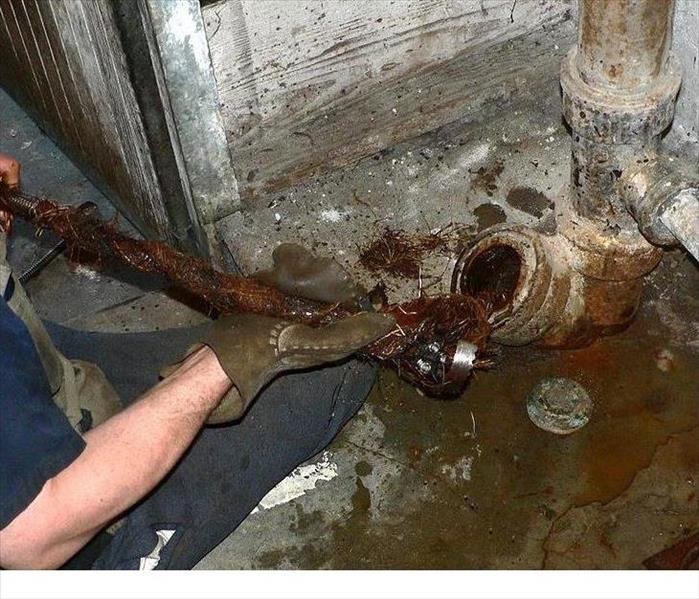 Sewage Backup in Moorestown NJ, and Prevention Tips..
Sewage Backup in Moorestown NJ, and Prevention Tips..
Sewage Backup in Moorestown NJ, and Prevention Tips..
Backed up sewers can wreak havoc on a home, causing thousands of dollars in damage to floors, walls, furniture and electrical systems. Sewer backup coverage is available from most insurers for a nominal cost—usually an additional annual premium of $40-$50.
For homes that have been severely damaged and are uninhabitable, homeowners policies may provide Loss of Use coverage, which provides reimbursement for lodging, food and other living expenses you may incur as a result of having to live outside of your home. Loss of Use coverage also reimburses you for the lost rental income if you rent out part of the house.
Causes of Sewer Backup
Aging Sewer Systems: The Civil Engineering Research Foundation reports that the number of backed up sewers is increasing at an alarming rate of about 3 percent annually. In addition, a recent report from the American Society of Civil Engineers indicates that the nation's 500,000-plus miles of sewer lines are on average over thirty years old. The increase in the number of homes connected to already aging sewage systems has also contributed to rapid increases in sanitary sewer backups, flooded basements and overflows.
Combined Pipelines: Problems also arise in systems that combine storm water and raw sewage into the same pipeline. During many rain storms, the systems are exposed to more volume than they can handle, and the result is a sewage backup situation that allows sewage to spew out into basements and other low lying drains.
Blockages Due to Tree Roots: Shrubs and trees seeking moisture will make their way into sewer line cracks. These roots can cause extensive damage. They may start out small, getting into a small crack in the pipe; but as the tree or shrub continues to grow, so does the root. Tree roots can enter the service pipe at joints and cause blockages. Tree roots can travel a long way, and roots from different types of trees act differently. If city trees are suspected, your plumber can contact the city, and samples of the roots will be used to help identify the trees and who is responsible for cleanup. Sometimes the blockage is a result of a combination of city and private trees. In this case costs are split between the city and the property owner.
Sanitary Main: A blockage can occur in a city sanitary main. If the blockage is not detected in time, sewage from the main can back up into homes and businesses through floor drains. Usually this happens slowly, giving the owner time to call a licensed plumber to assess the damage. If water is entering into your basement at a rapid rate, call the city public works office and report the problem immediately.
Water in Basement: Most basement flooding is not related to the sanitary sewer system. In many cases, soil settles adjacent to the building and, if not corrected, leads to rainwater flowing towards the building and down the outside of the foundation wall. This is particularly true in older buildings, where cracks may have developed in the foundation or floor slab that allow water to enter the basement. The cement floor and basement walls of these structures may have deteriorated to the point that they are no longer waterproof. In these cases, water can show up in a basement that has never had a water problem. This will usually happen after a number of rain storms, when the ground is saturated. Drainage can be improved by making sure that water drains away from the building. Owners may also be able to prevent flooding by water sealing the basement.
Most homeowners may not realize that they are responsible for the maintenance and repair of their house or sewer lateral—the pipeline between the city sanitary sewer main, usually located in the street—and the building. The sewer lateral is owned and maintained by the property owner including any part that extends into the street or public right of way. A cracked or deteriorated lateral or one filled with tree roots can allow groundwater to seep into the system, contributing to the problem.
How to File a Claim
For insurance purposes, take before and after photos of the affected areas and itemize any property losses. Save all receipts related to repair, cleaning or damages and contact your insurance agent or company representative as soon as possible.
How to Prevent Backups In Your Lateral and in the City Main
Dispose of Grease Properly: Cooking oil should be poured into a heat-resistant container and disposed of properly, after it cools off, not in the drain. Washing grease down the drain with hot water is unsatisfactory. As the grease cools off, it will solidify either in the drain, the property owner's line, or in the main sewer causing the line to constrict and eventually clog.
Dispose of Paper Products Properly: Paper towels, disposable (and cloth) diapers and feminine products can cause a great deal of trouble in the property owner's lateral as well as in the city main. These products do not deteriorate quickly, as bathroom tissue does, so do not put them down the drain or toilet.
Replace Your Line with New Plastic Pipe: One way to prevent tree roots from entering your line is to replace your line and tap with new plastic pipe. If you have continuing problems with tree roots in your lateral, you may have to have the roots cut periodically.
Correct Illegal Plumbing Connections: Do not connect French drains, sump pumps and other flood control systems to your sanitary sewer. It is illegal, and debris and silt will clog your line. Consult a plumber to correct any pre-existing illegal connections. French drains are common drainage systems, primarily used to prevent ground and surface water from penetrating or damaging building foundations.
Install a Backwater Prevention Valve: A backwater valve is a fixture installed into a sewer line, and sometimes into a drain line, in the basement of your home or business to prevent sewer backflows. A properly installed and maintained backwater valve allows sewage to go out, but not to come back in. Property owners are responsible for the installation and maintenance of backwater valves. The cost to install one depends on the type of plumbing in the building and the difficulty of installation. Check with a qualified plumber.
What to Do If You Experience a Sewer Backup
A sewer backup can lead to disease, destruction of your valuables, damage to your house or business, and can even result in electrical malfunctions. Prompt cleanup of affected property can help minimize the inconvenience and prevent mold or further damage. If you experience a sewer backup situation, immediately arrange for the cleanup of your property. This should include:
- Wet-vacuuming or removal of spillage
- Mopping floors and wiping walls with soap and disinfectant
- Flushing out and disinfecting plumbing fixtures
- Steam cleaning or removing wet carpets or drapes
- Repairing or removing damaged wallboard or wall covering
- Cleanup of ductwork
Commercial Water damage in Mt. Laurel NJ,
6/23/2017 (Permalink)
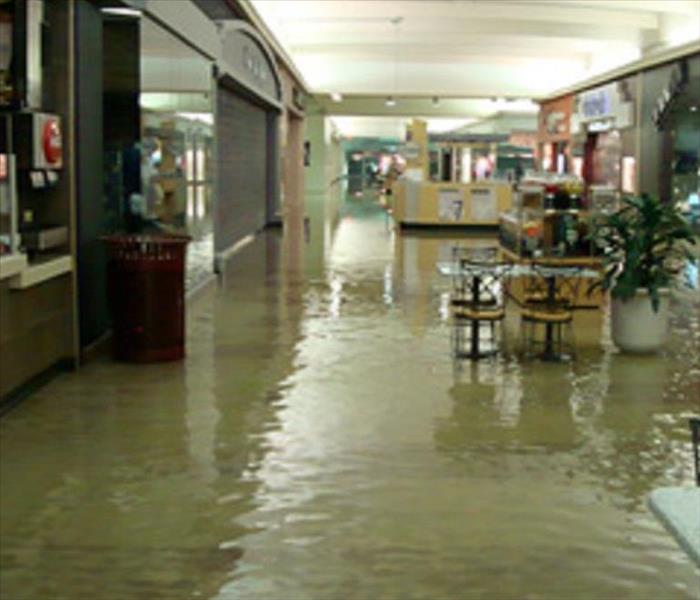 Commercial Water damage in Mt. Laurel NJ,
Commercial Water damage in Mt. Laurel NJ,
Commercial Water damage in Mt. Laurel NJ,
Flooding and water emergencies don’t wait for regular business hours and neither do we. SERVPRO Franchise Professionals provide emergency water restoration services 24 hours a day, 7 days a week—including all holidays. You can expect an immediate response time, day or night.
Within Minutes:
- Water quickly spreads throughout your property, saturating everything in its path.
- Water is absorbed into walls, floors, upholstery, and belongings.
- Furniture finishes may bleed, causing permanent staining on carpets.
- Photographs, books, and other paper goods start to swell and warp.
Hours 1 - 24:
- Drywall begins to swell and break down.
- Metal surfaces begin to tarnish.
- Furniture begins to swell and crack.
- Dyes and inks from cloth and paper goods spread and stain.
- A musty odor appears.
Water Damage in Haddonfield NJ, Flood Damage in Haddonfield NJ, Water Damage in Haddonfield NJ,
6/22/2017 (Permalink)
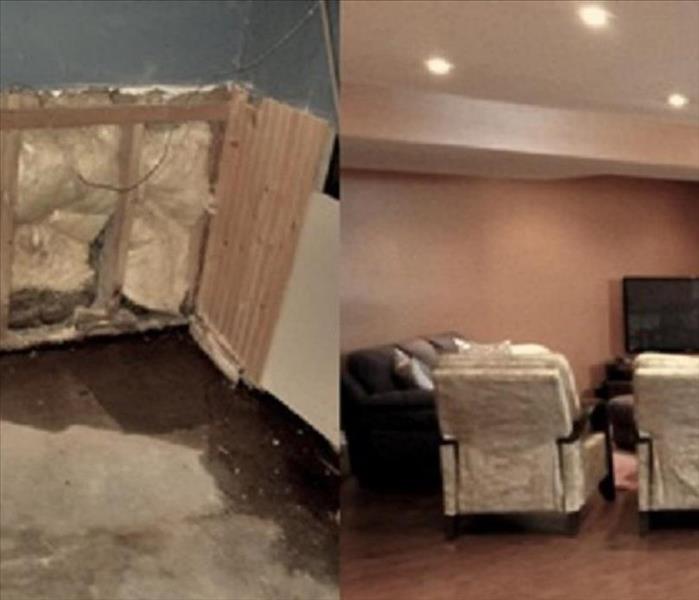 Water Damage in Haddonfield NJ, Flood Damage in Haddonfield NJ,
Water Damage in Haddonfield NJ, Flood Damage in Haddonfield NJ,
Water Damage in Haddonfield NJ, Flood Damage in Haddonfield NJ, Water Damage in Haddonfield NJ,
Water damage describes a large number of possible losses caused by water intruding where it will enable attack of a material or system by destructive processes such as rotting of wood, growth, rusting of steel, de-laminating of materials such as plywood, and many others.
The damage may be imperceptibly slow and minor such as water spots that could eventually mar a surface, or it may be instantaneous and catastrophic such as flooding. However fast it occurs, water damage is a major contributor to loss of property.
An insurance policy may or may not cover the costs associated with water damage and the process of water damage restoration. While a common cause of residential water damage is often the failure of a sump pump, many homeowner's insurance policies do not cover the associated costs without an addendum which adds to the monthly premium of the policy. Often the verbiage of this addendum is similar to "Sewer and Drain Coverage".
Those individuals who are affected by wide scale flooding may have the ability to apply for government and FEMA grants through the Individual Assistance program. On a larger level, businesses, cities, and communities can apply to the FEMA Public Assistance program for funds to assist after a large flood. For example, the city of Fond du Lac Wisconsin received $1.2 million FEMA grant after flooding in June 2008. The program allows the city to purchase the water damaged properties, demolish the structures, and turn the properties into public green space.
Causes
Water damage can originate by different sources such as a broken dishwasher hose, a washing machine overflow, a dishwasher leakage, broken/leaking pipes, and clogged toilets. According to the Environmental Protection Agency, 13.7% of all water used in the home today can be attributed to plumbing leaks.[3] On average that is approximately 10,000 gallons of water per year wasted by leaks for each US home. A tiny, 1/8-inch crack in a pipe can release up to 250 gallons of water a day.[4]According to Claims Magazine in August 2000, broken water pipes ranked second to hurricanes in terms of both the number of homes damaged and the amount of claims (on average $50,000 per insurance claim costs in the US. Experts suggest that homeowners inspect and replace worn pipe fittings and hose connections to all household appliances that use water at least once a year. This includes washing machines, dishwashers, kitchen sinks and bathroom lavatories, refrigerator ice makers, water softeners and humidifiers. A few US companies offer whole-house leak protection systems utilizing flow-based technologies. A number of insurance companies offer policy holders reduced rates for installing a whole-house leak protection system.
As far as insurance coverage is concerned, most damage caused by bad weather is considered flood damage and normally is not covered under homeowners insurance. Coverage for bad weather would usually require flood insurance.
Categories
Category 1 Water - Refers to a source of water that does not pose substantial threat to humans and classified as "clean water". Examples are broken water supply lines, tub or sink overflows or appliance malfunctions that involves water supply lines.
Category 2 Water - Refers to a source of water that contains a significant degree of chemical, biological or physical contaminants and causes discomfort or sickness when consumed or even exposed to. Known as "grey water". This type carries micro organisms and nutrients of micro organisms. Examples are toilet bowls with urine (no feces), sump pump failures, seepage due to hydrostatic failure and water discharge from dishwashers or washing machines.
Category 3 Water - Known as "black water" and is grossly unsanitary. This water contains unsanitary agents, harmful bacteria and fungi, causing severe discomfort or sickness. Type 3 category are contaminated water sources that affects the indoor environment. This category includes water sources from sewage, seawater, rising water from rivers or streams, ground surface water or standing water. Category 2 Water or Grey Water that is not promptly removed from the structure and or have remained stagnant may be re classified as Category 3 Water. Toilet back flows that originates from beyond the toilet trap is considered black water contamination regardless of visible content or color.
Classes
Class of water damage is determined by the probable rate of evaporation based on the type of materials affected, or wet, in the room or space that was flooded. Determining the class of water damage is an important first step, and will determine the amount and type of equipment utilized to dry-down the structure.[7]
Class 1 - Slow Rate of Evaporation. Affects only a portion of a room. Materials have a low permeance/porosity. Minimum moisture is absorbed by the materials.
Class 2 - Fast Rate of Evaporation. Water affects the entire room of carpet and cushion. May have wicked up the walls, but not more than 24 inches.
Class 3 - Fastest Rate of Evaporation. Water generally comes from overhead, affecting the entire area; walls, ceilings, insulation, carpet, cushion, etc.
Class 4 - Specialty Drying Situations. Involves materials with a very low permeance/porosity, such as hardwood floors, concrete, crawlspaces, plaster, etc. Drying generally requires very low specific humidity to accomplish drying.
Restoration
See also: Convectant drying
Different removal methods and measures are used depending on the category of water. Due to the destructive nature of water, chosen restoration methods also depend heavily on the amount of water, and on the amount of time the water has remained stagnant. For example, as long as carpet has not been wet for longer than 48 hours, and the water involved was not sewage based, a carpet can usually be saved; however, if the water has soaked for longer, then the carpet is probably irreparable and will have to be replaced.[8] Water damage restoration can be performed by property management teams, building maintenance personnel, or by the homeowners themselves; however, contacting a certified professional water damage restoration specialist is often regarded as the safest way to restore water damaged property.
Standards and regulation
While there are currently no government regulations in the United States dictating procedures, two certifying bodies, the Institute of Inspection Cleaning and Restoration Certification (IICRC) and the RIA, do recommend standards of care. The IICRC-recommended standard is IICRC S500.
Fire and Water Restoration companies are regulated by the appropriate state's Department of Consumer Affairs - usually the state contractors license board. In California, all Fire and Water Restoration companies must register with the California Contractors State License Board.[10] Presently, the California Contractors State License Board has no specific classification for "water and fire damage restoration."
Procedures
Water damage restoration is often prefaced by a loss assessment and evaluation of affected materials. The damaged area is inspected with water sensing equipment such as probes and other infrared tools in order to determine the source of the damage and possible extent of area affected. Restoration services would then be rendered to the residence in order to dry the structure, sanitize any affected or cross contaminated areas, and deodorize all affected areas and materials. After the labor is completed, water damage equipment including air movers, air scrubbers, dehumidifiers, wood floor drying systems, and sub floor drying equipment is left in the residence. Industry standards state that drying vendors should return at regular time intervals, preferably every twenty-four hours, to monitor the equipment, temperature, humidity, and moisture content of the affected walls and contents.
Water Damage in Haddonfield NJ, Water damage can be deceptive, Flood Damage in Haddonfield NJ,
6/21/2017 (Permalink)
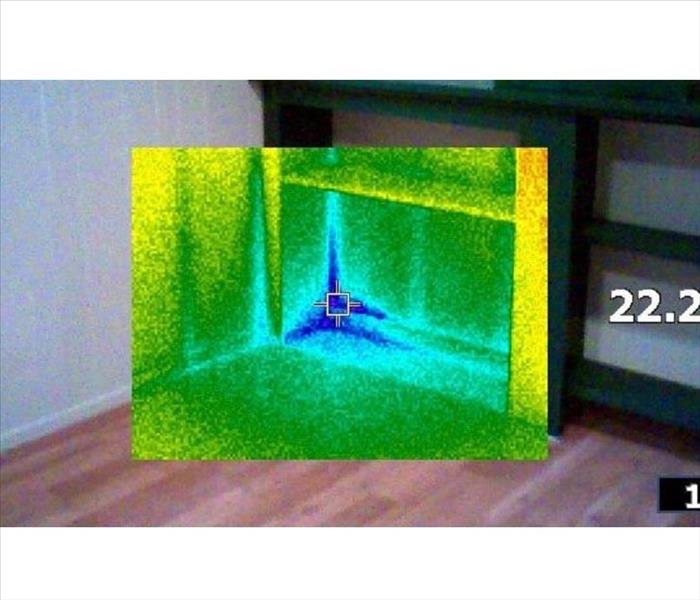 Water Damage in Haddonfield NJ, Water damage can be deceptive, Flood Damage in Haddonfield NJ,
Water Damage in Haddonfield NJ, Water damage can be deceptive, Flood Damage in Haddonfield NJ,
Water Damage in Haddonfield NJ, Water damage can be deceptive, Flood Damage in Haddonfield NJ,
Water damage can be deceptive. Water penetrates into structural cavities creating trapped pockets of saturation. The detection of water in these areas can often only be discovered with sophisticated moisture detection meters.
Undetected moisture will continue to cause damage. This damage, at a minimum, will cause odors. Greater damage will surface when materials delaminate, shrink, split and further deteriorate to where costly repairs are required.
More than just removing excess water, IICRC-certified restorers have the knowledge and equipment to further dry a home or facility (including substructure materials) completely back to preloss conditions. Through timely response and the careful monitoring of water damage, mold and other health issues can be prevented. If water damage has been present too long, mold will occur.
All IICRC-certified professionals have the training and experience to identify moisture sources, evaluate mold growth (visible or suspected), contain damage, remove contamination and dry materials to ensure that mold will not return.
While there are many methods for drying structural components and contents, the “in-place” drying system has been taught in the industry and used by drying contractors since the early ’80s. In those days, this method of drying components, without significant removal of furnishings or fixtures, was somewhat restricted, due to limitations imposed by extraction, evaporation and dehumidification equipment. In recent years, however, drying technology (extraction, evaporation, dehumidification), along with better understanding of psychrometry, has advanced in major ways so that in-place drying has, in some cases, become far more safe and practical.
Sump Pump Failure in Haddonfield NJ, Flood Damage in Haddonfield NJ, 7 Causes of Sump Pump Failure and What to Do
6/19/2017 (Permalink)
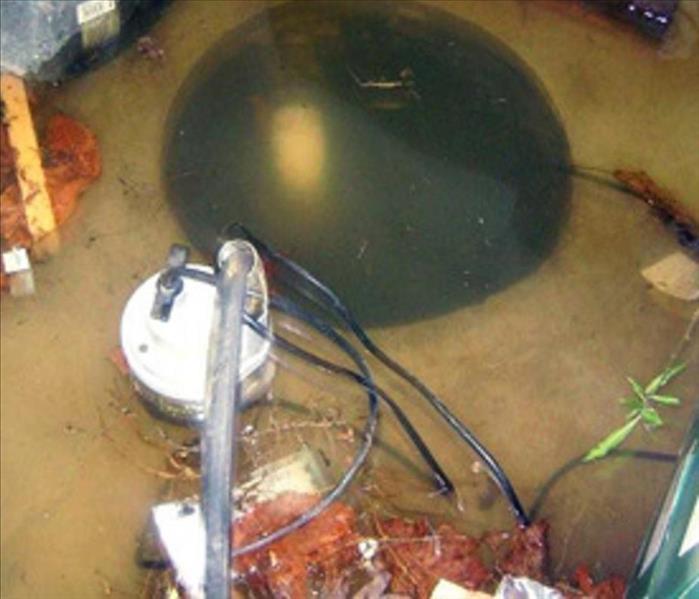 Sump Pump Failure in Haddonfield NJ, Flood Damage in Haddonfield NJ, 7 Causes of Sump Pump Failure and What to Do
Sump Pump Failure in Haddonfield NJ, Flood Damage in Haddonfield NJ, 7 Causes of Sump Pump Failure and What to Do
The problem is that Sump Pumps fail all the time. While it’s not to say that we have a fool-proof method for preventing 100% of failures, there are certainly some tips you can follow to better your chances of a properly working sump pump.
For years, sump pumps have been a pretty common fixture in homes, especially in lower-level areas of the country or in places where the rapid melting of heavy snow can cause flooded basements. The popularity of sump pumps have grown exponentially in the past couple decades, largely in part to a legal amendment to the US Federal Clean Water Act in 1987 that requires certain homes to have a sump pump, even if they are not necessarily high-risk for floods.
The American Society of Home Inspectors actually did a study that showed more than 60% of American homes suffer from underground wetness or water damage. And there’s a liklihood that an ever large percentage will deal with a flooded basement at some point. Something we often talk about with roofing in terms of moisture also applies here. It doesn’t always take a large amount of water to create a large amount of issues. In roofing, we talk about roof leaks going into the home which aren’t uncommon for a faulty roof after a big rain storm. But just as problematic – or sometimes even worse – are the small leaks that get into the attic and aren’t noticed until well after a huge mold problem has been created. Same goes for moisture in the lower levels of your home. It doesn’t take a huge flood to cause thousands of dollars in damage. It takes very little standing water and very little time for mold and mildew to take over and create problems.
Proper maintenance is the key. Ugh, more maintenance! Here we are telling you to maintenance your roof, now we’re telling you about your sump pump. Really, though, maintenance is a great thing. It’s much cheaper than a huge repair and it drastically increases the life of your equipment.
There is no definitive “lifetime” of a sump pump. Most last anywhere from 3-20 years. That’s a pretty big window. The US Department of Housing and Development estimates the average life expectancy at 10 years. In my opinion, 10-15 years is pretty reasonable for a pump that goes through regular maintenance.
First, let’s talk about how a sump pump works.
The basics are pretty simple. A hole is dug in the lowest part of your basement or crawlspace where a sump pump sits and filters out water. As the pit fills up, the pump turns on and moves the liquid out of the pit through pipes that run away from the foundation of your home into an area where it can drain, such as a municipal storm drain or a dry well. A one-way valve (check valve) keeps water from entering back into the home.
The pump is generally powered with no special wiring; just your main household current. But being near water, or in water (in case of a failure), it’s a good idea to have some type of circuit interrupter to prevent electrocution.
The majority of residential sump pumps will turn on automatically from a pressure sensor or float activator. The pressure sensor activates as water builds up and creates more pressure than air which prompts the pump to turn on. The float activator has a ball that floats on top of the water, moving the arm as the water level rises – similar to the one in your toilet tank.
When the motor activates, the impeller (a fan-like device) will turn. Using centrifugal force, the spinning impeller will force the water towards the sides of the pipe, creating a low-pressure center where water from the pit rushes to while the spinning action pushes it through the pipe.
All of these things work together to keep your home dry. And for the most part, everything tends to go smoothly. But there’s a lot of parts working together and if one thing quits working, or some type of outside force comes in and causes disruption, things can get back quickly.
7 Things that Cause Sump Pump Failure
1. Power Failure
The most common cause for sump pump failure is an electrical power outage. To prevent this, have a backup generator that can be manually activated. In the case that your primary pump mechanically fails, though, a generator cannot help in this situation. But in the event of a storm where the power is knocked out for any length of time, a backup generator can be a lifesaver.
On the same topic of power, some components of the sump pump may be vulnerable to damage from power surges. To prevent this, protect the entire electrical system from power surges with a service entrance surge protection device.
2. The Sump Pump is the Wrong Size
If you have an incorrectly sized pump, or if the pump is not installed properly, there will most likely be a problem. A small sump pump is often just as effective as a big one. When a sump pump is too big, the pump is forced to work harder, resulting in a shorter product lifespan. But if it’s too small, it may not be able to adequately pump out the water – again resulting in a shorter lifespan.
3. Improper Installation
Installing a sump pump must be done exactly right. Manufacturer’s instructions must be followed carefully for the installation in order to avoid severe water damage down the road. Most manufacturers recommend or require a check valve to be installed on the discharge line. If not installed, the back-flow of water can cause the pump impeller to rotate backwards and unscrew off the motor shaft. In this scenario, you will still hear the pump motor running, but it would not be pumping any water.
Most manufacturers require the drilling of a small air relief hole in the discharge line between the pump and the check valve which is intended to prevent the pump from having to overcome the air pressure in the discharge pipe. The discharge pipe must be of the required diameter.
Lastly, the sump pump pit should not be set in dirt or gravel. This causes debris to enter into your pump and can result in interference with the pump’s on/off switch or float arm.
4. Switch Problems
The leading mechanical cause of sump pump problems is a switch problem. This occurs when the pump shifts from its position inside the basin, rendering the float ineffective. Float is responsible for the smooth operation of the on/off switch. Your sump pump relies on both the switch and the float arm mechanisms to operate effectively.
5. Lack of Maintenance
Some pump manufacturers recommend the pump to be run every 2-3 months. Some recommend a yearly program completed just before the rainy season hits.
Here are some additional manufacturer recommendations:
- If there is a back-up pump, unplug the primary pump and run the back-up pump to make sure it works properly
- When testing your sump pump, go outside to make sure it is discharging water
- Sometimes the pump can run but not pump any water. This means the impeller has disengaged from the pump shaft or the check valve is installed backwards.
- Check the operation of the float to make sure it is not restricted
- Clean out the air hole in the discharge line
- Listen for any unusual noises when the motor is running
- Replace the battery on the back-up sump pump every 2 or 3 years
6. Frozen or Clogged Discharge Lines
If water cannot exit your home through the discharge line, your system will not work. It is important to keep the discharge pipe protected from freezing and free of sticks, dirt, rocks and other debris. Protecting the water’s exit point of the discharge pipe will keep debris and animals out of the system, making it optimal for your sump pump.
Grated covering will not stop the lines from freezing or becoming blocked by ice and snow. A special grated discharge line attachment should help; it is placed near your home on the discharge line. It includes openings that give water a way to flow out of the pipe if the line is blocked further down.
7. Product Defect
Though rare, product defect is always a possibility and does happen. It is wise to test the pump when it is initially installed to make sure the pump operates properly.
It’s All About the Maintenance
Don’t get me wrong, you cannot avoid all of these problems with maintenance. Let’s be honest – it’s a mechanical piece of equipment and mechanical pieces of equipment fail. It happens. But there’s no doubt that you can avoid many of these issues, and give a longer lifespan to the equipment by performing regular maintenance.
At the very least, follow these maintenance tips once per year. Some experts will even recommend that you do this every 2 months. Quarterly maintenance is probably the norm. It takes just a few minutes and can avoid some serious pains in the future.
- A vinegar solution can be run through the sump pump in order to clean it
- The pump will become free from tiny particles and debris which will allow the pump to run much cleaner
- This can be done by the homeowner and unless there is a serious problem, then you may need to call a professional.
- Make sure the sump pump’s float switch is not restricted in any way. If it is, it will cause the sump pump to not automatically kick on in case of a flood
- Lastly, clean all vents and air holes for maximum effectiveness
That’s it. Maintenance is super easy and keeps your home protected from water damage. Make this a part of your regular home improvement plan and you’ll surely save some money in your pocket by either putting off the purchase of a replacement sump pump for several years, or by avoiding a costly water damage project.
Flood Damage in Haddonfield NJ, What to Do in the First 24 Hours After a Flood,
6/16/2017 (Permalink)
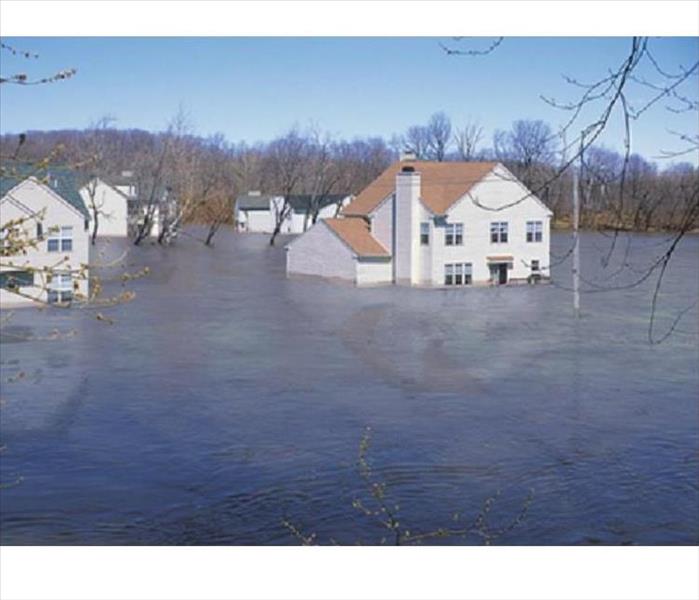 Flood Damage in Haddonfield NJ, What to Do in the First 24 Hours After a Flood,
Flood Damage in Haddonfield NJ, What to Do in the First 24 Hours After a Flood,
Flood Damage in Haddonfield NJ, What to Do in the First 24 Hours After a Flood,
After flood waters subside, document, work with your insurer, and clean up safely!
Whether a flood is caused by ground water, falling water, or home water system malfunction, there are some best practices you’ll need to employ within the first 24 hours after the flood to ensure the safety of your home and family and give you the best outcome possible with your insurance company.
If the flood was serious enough for you to leave your home, be sure you stay safe upon your return. The Federal Emergency Management Agency warns that you should check for any visible structural damage, such as warping, loosened or cracked foundation elements, cracks, and holes before entering the home and contact utility companies if you suspect damage to water, gas, electric, and sewer lines.
In addition, it’s important to have a working flashlight and turn off all water and electrical sources within the home, Even if the power isn’t operational, it’s a good idea to go to your fuse box and turn off the main, plus all of the individual fuse connections. That way, if the power is reactivated, you’re not at risk for mixing standing water and electricity.
Take Pictures: Before you remove any water or make any repairs, fully document the damage for your insurer by taking photos or video. Digital versions are best, says Ramirez, because they can be stored electronically and easily copied. If you start removing water or making repairs before you photograph the damage, you could potentially decrease the extent of your coverage, he says.
Even if the water in your home is clear, it could be contaminated by sewage or household chemicals. Be sure to throw out any food that may have come into contact with flood waters. FEMA recommends boiling water until authorities declare the water supply is safe.
Find Out if You're in a Disaster Area: Once a region has been officially declared a “disaster area” by government authorities, property owners have access to increased resources, including public services to protect and remediate the area. In addition, you may have access to financial assistance. Your insurance company will have additional information on this or you can contact FEMA directly.
Call Your Insurance Company: Since you should notify your insurer soon as possible after the flood, it’s a good idea to keep your insurance company and local agent’s phone number in your always-ready emergency bag. (Note that the NFIP works through private insurance companies, so you contact your insurer just as you would for any other type of claim). In cases where a flood has affected a region or community, your agent may be busy handling his or her own flood issues. In that case, contact the insurance company’s headquarters.
Since groundwater flood damage typically isn’t covered by conventional homeowners insurance policies, you’ll need to work with your insurer to determine the cause of the flood and the extent of your coverage.
Advise your insurance representative of the state of your home and any repairs you intend to do immediately. Be sure to follow the insurance company’s direction about whether or not to wait for an adjuster to inspect the property before making repairs. Document the damage and conversations at every stage of the process.
What can you expect in terms of time to get back to normal? It could be as little as one week if the claim and clean up is minimal to five to six months if you’re working with an insurance adjuster and contractor to complete extensive repairs.
Remove Water: Once you get the OK from your insurer to remove the water, use a sump pump, available from most hardware or home supply stores for $150 to $500, and a wet vac ($40 to $130) Be careful not to injure yourself, especially if you’re carrying buckets of water up and down stairs. Open doors and windows to allow fresh air to circulate so long as that won’t allow in more water.
Mitigate Mold Damage: Mold can develop within 24 to 48 hours of a flood, says Ashley Small of FEMA, so remove wet contents, including carpeting and bedding, as soon as possible. If an item has been wet for less than 48 hours, it may be salvageable. However, you’ll need to decide whether it holds enough monetary or sentimental value to try to do so. And notify your insurance company before removing items to ensure that you’re not affecting coverage. Always photograph the flood-soaked items.
Rugs, for example, may be dried and then cleaned professionally, which could cost $100 to $500 or more, depending on the size and number. Large pieces of furniture that are saturated will likely be difficult to dry effectively, and should often be discarded.
You may also wish to hire a flood restoration service—Look for those with Institute of Inspection, Cleaning, and Restoration Certification.
Secure the Property: As the homeowner, it’s your responsibility to secure the property so that no additional damage occurs. Put boards over broken windows and secure a tarp as protection if the roof has been damaged. Again, take photographs to prove to the insurance company that you have done everything possible to protect your home against further damage.
If the home is habitable, take precautions to keep yourself and your family safe from injury. Use flashlights to move around dark rooms, for example. If the home isn’t habitable, don’t try to stay there. Move to a shelter or alternate location. Consult your insurer to find out what provisions the company will make for temporary housing while your home is being repaired.
Water Damage in Haddonfield NJ, and The SERVPRO Emergency READY Profile Advantage, FREE SAMPLE PROFILE,
6/15/2017 (Permalink)
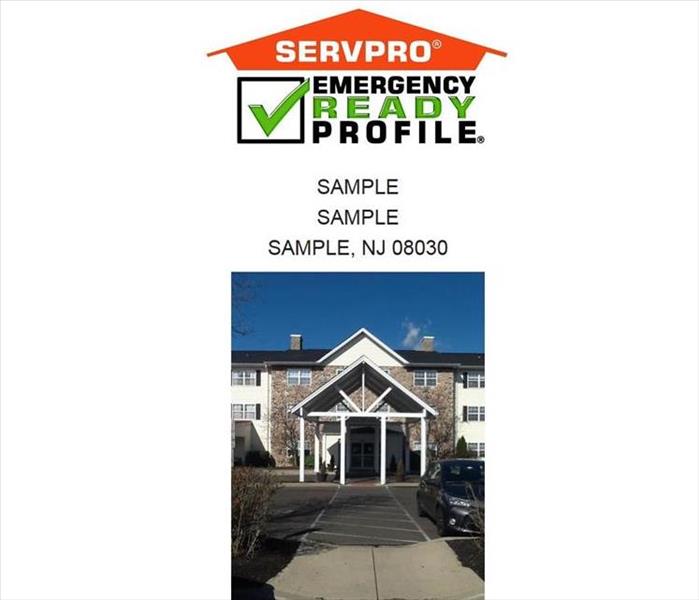 Water Damage in Haddonfield NJ, and The SERVPRO Emergency READY Profile Advantage, FREE SAMPLE PROFILE,
Water Damage in Haddonfield NJ, and The SERVPRO Emergency READY Profile Advantage, FREE SAMPLE PROFILE,
Water Damage in Haddonfield NJ, and The SERVPRO Emergency READY Profile Advantage, FREE SAMPLE PROFILE,
As many as 50% of businesses close down following a disaster, according to the latest research. Of the businesses that survive, the overwhelming majority of them had a preparedness plan in place. Pre-planning can serve as an insurance policy aimed at peace of mind. And knowing you are "Ready for whatever happens" speaks trust to your clients and employees that in the event your business is affected by a disaster, they don’t necessarily have to be.
By developing a SERVPRO Emergency READY Profile for your business, you minimize business interruption by having an immediate plan of action. Knowing what to do and what to expect in advance is the key to timely mitigation and can help minimize how water and fire damage can affect your business.
- A no cost assessment of your facility.
- This means there is no need to allocate funds, giving you a great value at no cost.
- A concise Profile Document that contains only the critical information needed in the event of an emergency.
- It will only take a little time to complete and will not take you away from current projects. But it will save a lot of time if ever needed.
- A guide to help you get back into your building following a disaster.
- This can help minimize the amount of time your business is inactive by having an immediate plan of action.
- Establishes your local SERVPRO Franchise Professional as your disaster mitigation and restoration provider.
- You have a provider that is recognized as an industry leader and close by.
- Identification of the line of command for authorizing work to begin.
- This saves time so we can begin the work of mitigating the damage which can save you time and money.
- Provides facility details such as shut-off valve locations, priority areas and priority contact information.
- Having a quick reference of what to do, how to do it and who to call provides solutions in advance of an emergency so that during the emergency you are "Ready for whatever happens."
Our SERVPRO location can Email you a Sample Copy, of an Emergency Ready Profile!
Washing Machine Hoses: A Disaster Waiting to Happen, Water Damage in Cherry Hill NJ,
6/14/2017 (Permalink)
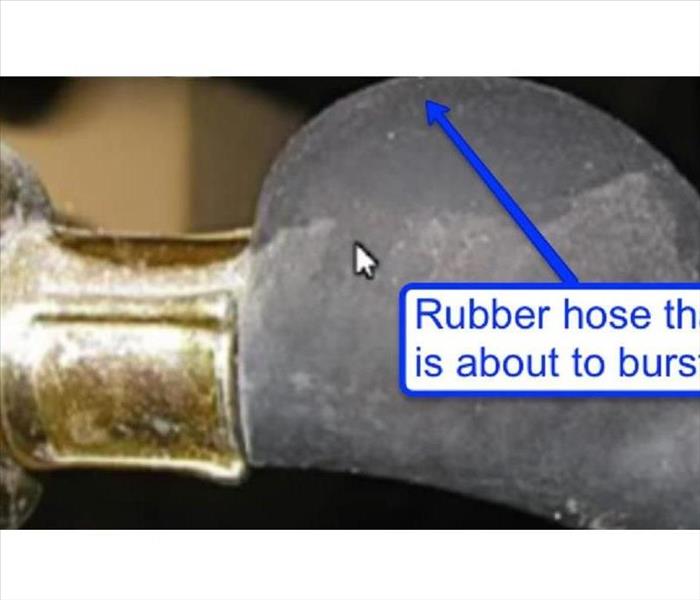 Washing Machine Hoses: A Disaster Waiting to Happen, Water Damage in Cherry Hill NJ,
Washing Machine Hoses: A Disaster Waiting to Happen, Water Damage in Cherry Hill NJ,
Washing Machine Hoses: A Disaster Waiting to Happen, Water Damage in Cherry Hill NJ, Though most property owners are careful to protect their buildings and possessions against fire, burglary, storms, and other dangerous conditions, they often overlook a situation that insurers know to be one of the most potentially destructive and costly: water damage caused by leaking or malfunctioning home appliances, especially washing machines. Unlikely as it may seem, water damage from washing machines is one of the top five causes of claims to home insurers, according to the Institute for Business and Home Safety, which analyzed 525 washing machine claims from multiple insurance companies.
Of all water damage claims related to washing machines, more than half – nearly 55% – are from water supply hoses that leaked or burst. And these claims are costly, with the average claim running to more than $6,000.
Why and How Do Washing Machine Hoses Fail? Over time, most washing machine hoses, even those that are installed properly, will eventually fail, leading to leaks or catastrophic floods caused when the hoses burst. Failure may be caused any of several factors, including age, installation error, poor-quality materials, and poor design. Under normal conditions, water in the hoses is under the same pressure as in other faucets in the building. When the hose becomes weakened, or when the connection is faulty, the water pressure will break the hose or coupling, sending water flooding out. In a typical residential plumbing system, water will spill out of a single burst hose at a rate of about 650 gallons per hour (that’s six gallons per minute, or 2½ tons per hour).
Because the supply lines to the washing machines are always “on,” water will flood from a broken hose until someone notices it and turns off the main supply line. If the hose breaks at night or when a building is unoccupied, thousands of gallons of water might flood the building before the problem is discovered. If the line breaks on a washing machine situated on an upper floor, the damage will be extensive as the water pours through the floors. Most traditional washing machine hoses are made of reinforced rubber or polymer.
These materials lose resiliency as they age, making them subject to cracks, leaks, and bursting. The IBHS study showed that failure rates increase dramatically in hoses that are more than five years old; the average age of failed hoses was 8.7 years. More than half of all failures occurred by the time the machine and its hoses were eight years old, and nearly 80% occurred before ten years. Improper installation can also damage the hose, leading to premature failure. The most common installation error is failure to leave sufficient room between the machine and the wall connection to prevent kinking or bending of the hose, particularly near the valve connections, as described below. Cracks, crimps, or blockages in the line will cause damage and lead to leaks or total failure.
Poor design (including fabrication from poor-quality materials) is probably the most significant factor in the failure of both kinds of hose commonly in use – the standard black rubber hose and the braided steel variety – though these products usually fail for different reasons, as described below. Standard black washer hoses are made of rubber tubing with a polyester reinforcement lining. The metal inserts at the coupling end are rolled and stamped from thin sheets of copper alloy. Most failures occur at the end of the hose, where the metal insert comes into contact with the tubing.
Failures generally occur for one of the following reasons: Razoring — The metal insert has a very sharp edge which is in direct contact with the rubber tube. This edge becomes progressively thinner and sharper as it is worn away by the movements of the water and by the effects of electrolysis. In a process called “razoring,” the motion of the washing machine causes the metal edge to rub repeatedly against the inside of the hose, cutting it gradually from the inside out. Stress Fractures — The metal insert is attached to the hose by a ferrule, or ring, which is crimped tightly to hold the pieces together. The crimping can cause a stress fracture in the hose, which is then subject to failure, especially as the rubber ages and begins to deteriorate.
Rusting — Corrosion (rusting) of the metal fitting can cause failure in two ways. First, as the thin metal fitting corrodes, it becomes jagged and rough and cuts into the hose as the washing machine operates. Water can leak between the hose and its outer covering, forming a bubble, a critical warning sign of imminent failure. Though a bubble may appear anywhere along the line, most breaks occur at the point where the metal fitting meets the rubber tube. Second, as the fitting continues to corrode, it can become so weak that it may eventually break apart. Braided stainless steel hoses (sometimes called “steel-clad” hoses) were designed as a reliable replacement for standard black hoses, but they, too, have been problematic. They have proven to be not much stronger than standard rubber hoses, and they are also subject to failures related to the to failures related to the materials from which they are fabricated.
Crimping — A braided stainless steel hose consists of a plastic or rubber tube covered with a braided steel sheath, which is sometimes protected with a thin nylon coating. Because of the variety of materials used, a very tight crimp is required to fasten the metal fitting securely to the hose. During the manufacturing process, this tight crimping can damage the hose by cutting into the rubber. Once the product is installed on a washing machine, the action of the water and the movements of the machine can make the cuts worse, leading to eventual failure. Corrosion — The stainless steel braided cover can oxidize when exposed to chloramine, a chemical increasingly popular in water treatment. Under these conditions, the stainless steel braided cover can weaken, fray, and even break, so that it can no longer provide strength to the hose.
Inspect Washing Machine Hoses Regularly In many cases, the hoses and fittings that connect the washing machine to the water source are visible and easy to inspect every time the machine is used. If your machine’s hoses are not visible, find out how to gain access to them in order to inspect them once a month or so. Inspect both hot and cold water lines. Most failures occur near the connection, where the hose typically bends. Here’s what to look for: Signs of Imminent Failure. Look for obvious signs of deterioration or imminent failure, such as blisters, bulges, bubbles, cracks, unraveling, discoloration, crimps, or kinks, especially near the connections and turns in the hose. Leaks. Check for moisture, drips, rust, discoloration, or leaks in, on, or around the hoses and connections or in the catch pan (if present). Check the connections to be sure that they are tightened properly, as described below. Even a small leak may indicate an imminent failure. Proper Positioning. Be sure that the washing machine is located at least four inches from the connections (usually at the wall) so that the hose is not bent or kinked. Check to see that the machine is properly balanced so that it does not “walk” during use. The motion of a “walking” machine will place added stress on the hoses and connections.
Replace Defective or Aging Hoses Immediately!
Humidity, Water Damage, Condensation, Mold, and Indoor Air Quality, in Cherry Hill NJ,
6/13/2017 (Permalink)
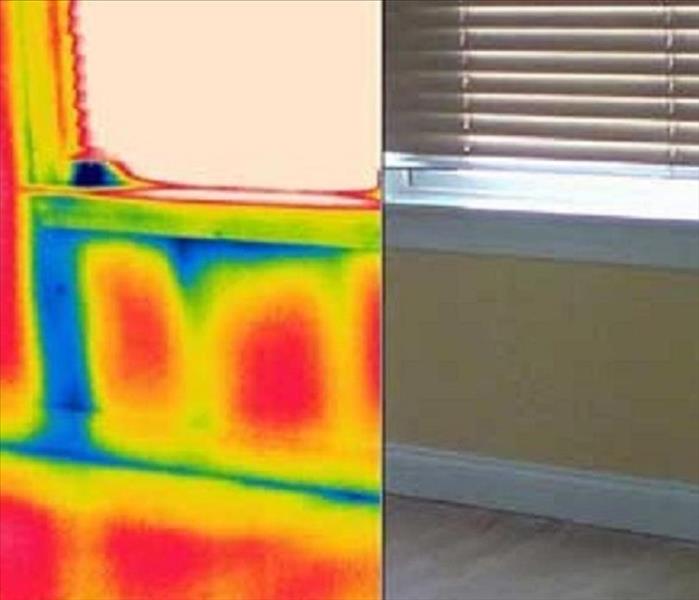 Humidity, Water Damage, Condensation, Mold, and Indoor Air Quality, in Moorestown NJ,
Humidity, Water Damage, Condensation, Mold, and Indoor Air Quality, in Moorestown NJ,
Humidity, Water Damage, Condensation, Mold, and Indoor Air Quality, in Moorestown NJ,
Moisture rides on air currents, and warm air carries more moisture than cool air
To control air flows, make sure the air barrier is continuous
An air barrier helps control airflow both through and within the building enclosure. By controlling airflow, you also control moisture.
If moist indoor air contacts a cold surface — for example, exterior sheathing in cold weather — condensation can result. An air barrier prevents those cold surfaces from being connected with humid indoor air.
Air has a maximum storage capacity for water vapor which depends on temperature. Warm air can store lots of moisture, while cold air can store very little.
As the temperature falls from 90°F down to 20°F, the amount of moisture that can be stored in the air changes by a factor of ten.
Leaky homes didn’t have condensation problems
Older buildings rarely had condensation problems in cold weather because they were so well ventilated — meaning leaky. The relative humidity in an old home would rarely rise above 25%. As we have built tighter houses (and in some cases failed to provide mechanical ventilation), the indoor relative humidity has gone up.
In a heated, tight, unventilated house, the amount of moisture in the air and the amount of condensation that can occur are dramatically different than in an old leaky house. Condensation can occur wherever water vapor can find a cold spot — on roof or wall sheathing, on the inside faces of the windows, and inside the walls.
Let's say it’s 40°F outside and the outdoor relative humidity is 50%. If you allow that outdoor air to enter a building and heat it up to 70°F, the amount of moisture in the air stays exactly the same, but the “tank” gets bigger because the storage capacity of the air increases with the temperature. As a result, the relative humidity initially drops. Then, as moisture is added to the air, the relative humidity rises, and the absolute moisture content rises as well. How do you add moisture to the air? You breathe, sweat, boil water for spaghetti, take hot showers, grow houseplants — and all of those activities generate moisture.
When does indoor humidity become a problem?
Let’s say that air leaks out of a house through holes in the enclosure. As it reaches surfaces colder than 52°F or 53°F, the air will cool. Once it reaches its full capacity to store moisture, condensation occurs.
If the temperature of the outdoor air is around 30°F, the indoor air will drop all of the moisture that it gained on the way out, dumping it on the cold sheathing surface. That’s a typical example of the air leakage condensation cycle. Since condensation in walls can cause puddles — and in extreme cases, rot the framing — condensation is something you want to avoid. Installing an air barrier is one way to help prevent condensation.
Air conditioning can also create condensing surfaces
The same phenomenon can happen in reverse in the summertime. Let’s say the outdoor air is 85°F and the relative humidity is 75%. When outdoor air leaking inward contacts a surface below about 76°F, the moisture in the air will condense. So if you have an exhaust fan in your home, the air leaking in may cause condensation on the air-conditioned surfaces — for example, on the back side of vinyl wallpaper.
If moist air leaks into a house through gaps in the wall or roof, you can have problems. But in a tight house with a good air barrier and a supply-only ventilation system, most of the air that’s drawn inside is drawn in through the air conditioner, so the first cold surfaces it sees are the cooling coils.
If you have air leaks in your building envelope, you usually can’t see the condensation —Unless you have an Infrared Camera with a Visual Inspection. However, condensation is sometimes visible in the attic; all you have to do is look for frost or dampness forming on the underside of the OSB or plywood roof sheathing.
Water damage in Cherry Hill NJ, But Commercial Properties Need Fire Sprinkler Systems, for Safety
6/9/2017 (Permalink)
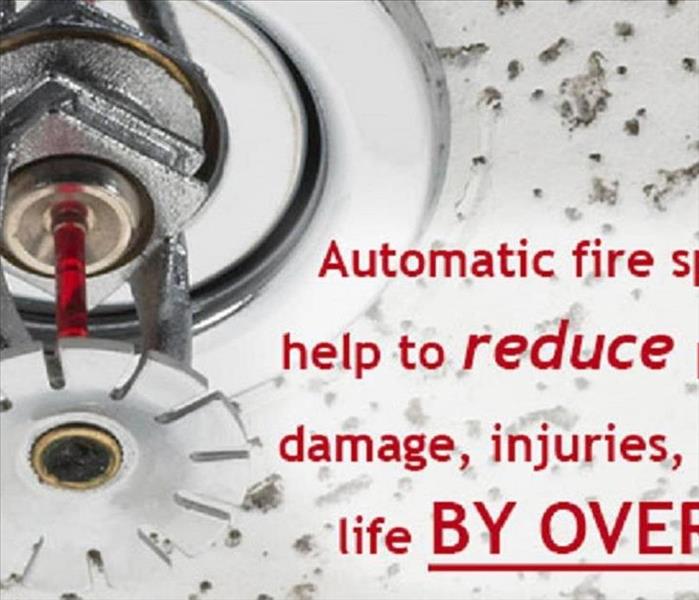 Water damage in Cherry Hill NJ, But Commercial Properties Need Fire Sprinkler Systems, for Safety
Water damage in Cherry Hill NJ, But Commercial Properties Need Fire Sprinkler Systems, for Safety
Water damage in Cherry Hill NJ. It is common knowledge that most commercial buildings have fire sprinkler systems that work to prevent fire damage. However, many do not realize how important these fixtures are in the case of fire. In fact, mounting evidence shows that this form of fire protection is more effective than many give it credit for.
If you are thinking about investing in new fire sprinkler systems, consider the ways that commercial sprinkler systems can benefit your building in case of fire:
Sprinkler Systems Are Virtually Fault-Free
In a recent study conducted on fires, the researchers discovered that fire sprinkler systems operated during 91% of all reported structure fires large enough to activate the systems. Ultimately, nine times out of 10, the sprinkler systems worked. Typically, the reason sprinkler systems stop working due to a lack of maintenance. This fact drives home the importance of regularly repairing your commercial fire sprinkler systems and replacing them if necessary.
Fire Sprinklers are Capable of Cutting Potential Losses in Half
It’s no secret that fires can result in devastating damage to both the structure of the building and the people that are trapped inside. Another recent study found that when paired with early warning systems, automatic fire sprinklers help to reduce property damage, injuries, and loss of life by over 50%. Those are numbers you just can’t ignore!
Fire Sprinklers Help Save Lives
Perhaps one of the most important things that fire sprinklers do is help to lower the risk of death and injury during devastating structure fires. According to a study from the National Fire Protection Association, there has been no record of more than two lives lost inside of a building with a full sprinkler protection that was well maintained and fully functioning.
As you can see, having a full system sprinkler system is a crucial part of fire protection for commercial buildings. If you already have a sprinkler system in place, make sure your fire alarm inspections are up to date and your fire protection equipment is functioning properly. Fire alarm inspections can mean life or death — make sure your equipment is working when it counts.
Lightning and Thunderstorms in Cherry Hill NJ, and Helping Your Pets Overcome the Fear of Them,
6/8/2017 (Permalink)
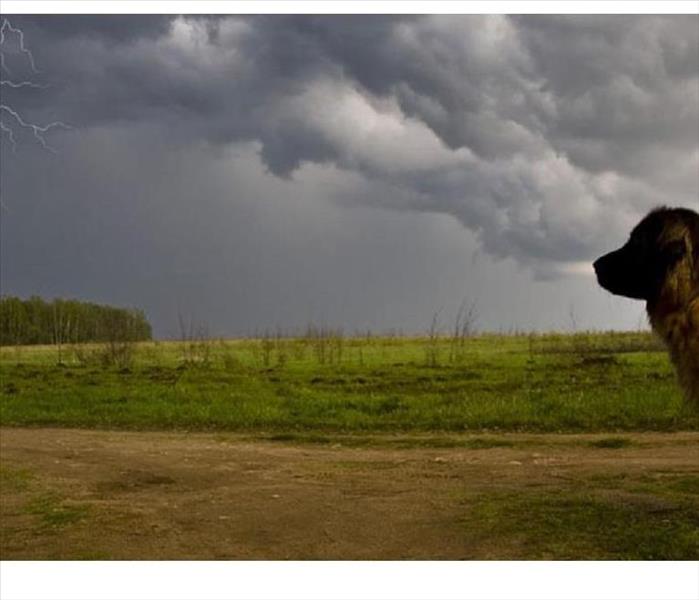 Lightning and Thunderstorms in Cherry Hill NJ, and Helping Your Pets Overcome the Fear of Them,
Lightning and Thunderstorms in Cherry Hill NJ, and Helping Your Pets Overcome the Fear of Them,
Storm phobia. You call it your worst nightmare. Either way, we all want the same thing: A calmer dog who doesn’t have to suffer the psychological damage done by booming thunder, wicked lightning and plummeting barometric pressures.
And it’s not just their psyche at risk. We all know that dogs are capable of doing serious damage to themselves during stormy times of the year. Fractured claws, lacerations, broken teeth and bruises are but a few consequences. I’ve even seen broken limbs and witnessed one dramatic case of deadly hit-by-car when a neighbor’s dog ran wildly into the street (so you know, they do this...thinking they’re fleeing the storm).
So how do you handle thunderstorm phobia?
Here are tips:
1. Handle it early on in your dog’s life
Does your dog merely quake and quiver under the bed when it storms outside? Just because he doesn’t absolutely freak, doesn’t mean he’s not suffering. Since storm phobia is considered a progressive behavioral disease, signs like this should not be ignored. Each successive thunderstorm season is likely to bring out ever-worsening signs of fear. It’s time to take action...NOW!
2. Don’t heed advice to let her “sweat it out” or not to “baby” her
I’ve heard many pet owners explain that they don’t offer any consolation to their pets because they don’t want to reinforce the “negative behavior” brought on by a thunderstorm. But a severe thunderstorm is no time to tell your dog to “buck up and get strong.” Fears like this are irrational (after all, she’s safe indoors). Your dog won’t get it when you punish her for freaking out. Indeed, it’ll likely make her anxiety worse. Providing a positive or distracting stimulus is more likely to calm her down.
3. Offer treats, cuddlings and other good stuff when storms happen
This method is best employed before the phobia sets in––as pups. Associating loud booms with treats is never a bad thing, right?
4. Let him hide...in a crate
Hiding (as in a cave) is a natural psychological defense for dogs. Getting them used to a crate as pups has a tremendous influence on how comfortable they are when things scare them. Having a go-to place for relaxing or hiding away is an excellent approach, no matter what the fear. Another approach to try, whether he’s a pup or not.
5. Get him away from the noise...and compete with it
Creating a comfy place (for the crate or elsewhere) in a room that’s enclosed (like a closet or bathroom) may help a great deal. Adding in a loud radio or white noise machine can help, too. Or how about soothing, dog-calming music? Not only does this approach muffle sounds, it also means pets can avoid the...
5. Electromagnetism
Though it may sound like Voo-doo, your dog can also become sensitized to the electromagnetic radiation caused by lightning strikes. One great way to shield your dog from these potentially fear-provoking waves is to cover her crate with a double layer of heavy-duty aluminum foil. Another method involves clothing her in a commercially available “Storm Defender” cape that does the same work. If she hides under the bed, consider slipping a layer of aluminum fold between the box-spring and mattress.
6. Desensitize him
Sometimes it’s possible to allay the fears by using thunderstorm sound CDs when it’s not raging outside. Play it at a low volume while plying him with positive stimuli (like treats and pettings). Increase the volume all the while, getting to those uncomfortable booming sounds over a period of weeks. It works well for some.
7. Ask your veterinarian about drugs
Sure, there’s nothing so unsavory as the need for drugs to relieve dogs of their fears, but recognize that some fears will not be amenable to any of these other ministrations without drugs. If that’s the case, talk to your vet about it––please.
8. Natural therapies can work
For severe sufferers there’s no doubt it’ll be hard to ask a simple flower essence to do all the heavy lifting, but for milder cases, Bach flower extracts (as in Rescue Remedy), lavender oil (in a diffuser is best) and/or “Dog Appeasing Pheromone” (marketed as D.A.P. in a diffuser, spray or collar) can help.
9. Consider seeing a board certified veterinary behaviorist
If nothing else works, your dog should not have to suffer. Seek out the advice of your veterinarian and, if you’ve gone as far as you have with him/her, consider someone with unique training in these areas––perhaps a board certified veterinary behaviorist.
Fire Damage, and Restoration, and the Process of Fire Restoration, Fire Damage in Cherry Hill NJ,
6/6/2017 (Permalink)
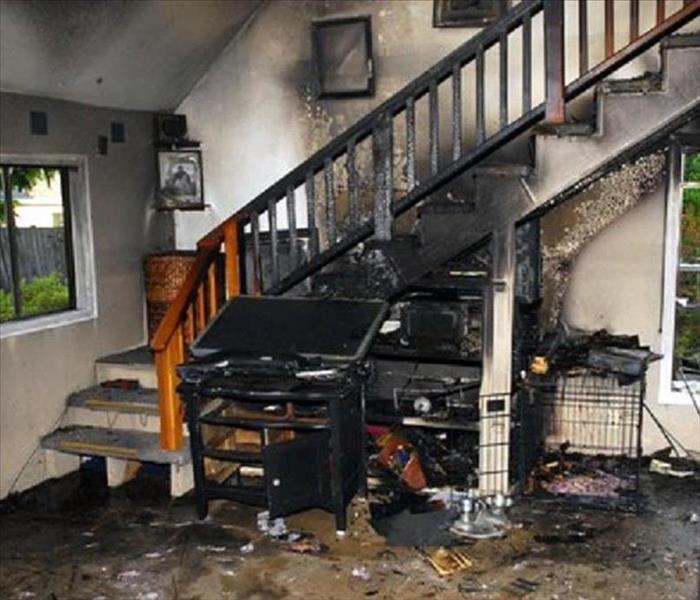 Fire Damage, and Restoration, and the Process of Fire Restoration, Fire Damage in Cherry Hill NJ,
Fire Damage, and Restoration, and the Process of Fire Restoration, Fire Damage in Cherry Hill NJ,
The process of fire restoration can be very involved. Private homeowners and companies can oftentimes be devastated by the damage caused by this kind of event. One aspect that gives peace of mind involves knowing when the right professional has been hired. That is one of the reasons why it is important to hire a firm that is associated with the Institute of Inspection Cleaning and Restoration Certification.
Homeowners and business owners may be in shock from the initial devastation. It is important to try and follow the proper steps to achieve a complete fire restoration. Service providers that are associated with the Institute will have the following distinctions: current training, safety and health certifications, vast amounts of experience in restoration projects and the proper licenses and insurance information. Customers should also check all references and obtain price quotes prior to hiring anyone. Any contracts that are presented should be reviewed closely.
The first step in the process is to clean up as much of the existing area as possible. If the area is not immediately cleaned, soot residue and permanent damage can be left behind. If the homeowner or business owner does the initial cleaning, it is important to follow these steps. When cleaning, always use dust masks and open the area for proper ventilation. Clean from the ceilings to the floors and vacuum all floors and upholstery. Wash any items that are able to be laundered. Clean the outside with a pressure washer if available.
If immediate clean up is not done, it can lead to devastating effects. Within minutes of fire and smoke damage, appliances and many items will discolor to a yellow hue. After a few hours, acid will stain bathrooms and many other areas of the home or business. Within days, walls will discolor permanently and items will begin to rust due to the acid residue. Finally, after weeks the cost of clean-up will become substantially more expensive. The building and furnishings can be permanently damaged by the acid left behind. Soot residue will be layered throughout the home or business. For these reasons, it is vital to contact a professional associated with the Institute of Inspection Cleaning and Restoration Certification to utilize fire restoration techniques in an effort to return the home or business to a preloss state. One company or service provider should be able to handle the damage. The seal of Certification by the Institute should be shown on any provider’s website. This shows the customer the reliability and the expertise of the service provider.
Residue and smoky odors need to be removed immediately. Professionals will use the process of fire restoration to achieve satisfactory results. These providers will remove the source of the odor, clean any items that can be salvaged, get rid of any lingering odor with an odor counteractant and deodorizing fog. Finally, the provider will seal salvageable items to encapsulate odor and prevent further recontamination.
Homeowners and businesses that are educated in the fire restoration process are able to minimize the cost of repair. Professionals can be contacted in a timely manner to return the area to a preloss state. By hiring the right professionals the victims can have some peace of mind during a very stressful time.
Water damage can be deceptive, Water Damage in Cherry Hill NJ,
6/5/2017 (Permalink)
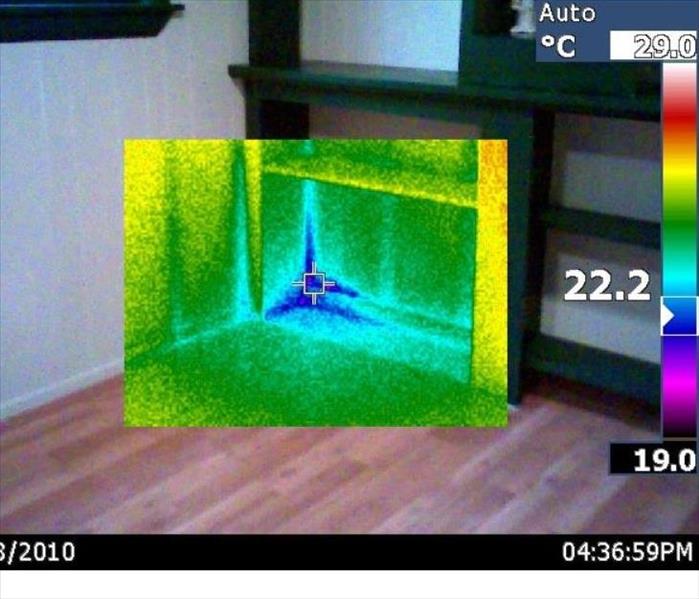 Water damage can be deceptive, Water Damage in Cherry Hill NJ,
Water damage can be deceptive, Water Damage in Cherry Hill NJ,
Water damage can be deceptive. Water penetrates into structural cavities creating trapped pockets of saturation. The detection of water in these areas can often only be discovered with sophisticated moisture detection meters. Undetected moisture will continue to cause damage. This damage, at a minimum, will cause odors. Greater damage will surface when materials delaminate, shrink, split and further deteriorate to where costly repairs are required.
More than just removing excess water, IICRC-certified restorers have the knowledge and equipment to further dry a home or facility (including substructure materials) completely back to preloss conditions. Through timely response and the careful monitoring of water damage, mold and other health issues can be prevented. If water damage has been present too long, mold will occur.
All IICRC-certified professionals have the training and experience to identify moisture sources, evaluate mold growth (visible or suspected), contain damage, remove contamination and dry materials to ensure that mold will not return.
While there are many methods for drying structural components and contents, the “in-place” drying system has been taught in the industry and used by drying contractors since the early ’80s. In those days, this method of drying components, without significant removal of furnishings or fixtures, was somewhat restricted, due to limitations imposed by extraction, evaporation and dehumidification equipment. In recent years, however, drying technology (extraction, evaporation, dehumidification), along with better understanding of psychrometry, has advanced in major ways so that in-place drying has, in some cases, become far more safe and practical.
Sewage Water Clean Up in Cherry Hill NJ,
6/2/2017 (Permalink)
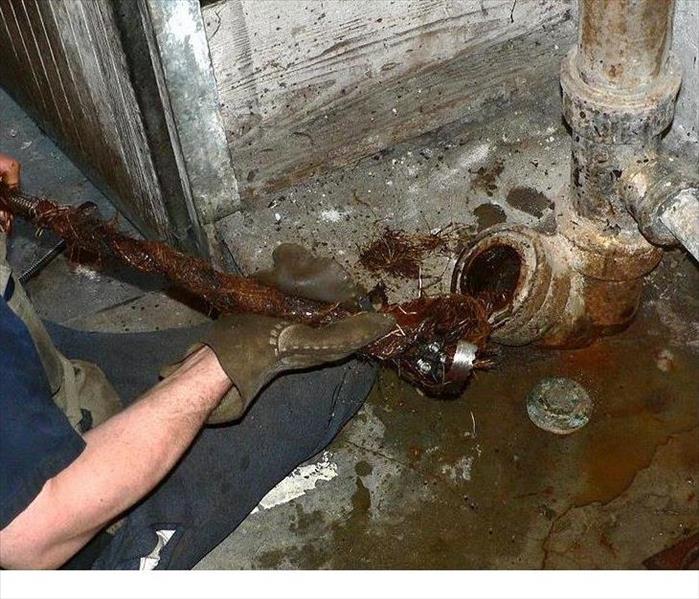 Sewage Water Clean Up in Cherry Hill NJ,
Sewage Water Clean Up in Cherry Hill NJ,
Sewage damage is the most dangerous form of water cleanup. The possibility of blood-borne pathogens and other contaminants is high. The following are basic instructions for handling a sewage water loss. It is strongly encouraged that a technician take a certification course such as Water Restoration Technician, BEFORE attempting this kind of water damage cleanup.
Recommendations:
- Advise any occupants that they should leave/evacuate the space.
- Inspect and identify any possible hazards that might be in the environment. Identify if electricity is going to be a hazard and/or if there are any safety or health hazards in the affected area.
- Technicians must use proper personal protective equipment (PPE). Each person should be working with proper skin protection (Tyvek coveralls), hand protection (exam gloves and/or leather gloves), goggles, and respirators. Rubber boots should also be worn over the top of coveralls.
- Identify, repair, and/or eliminate the source of the sewage and water.
- Containment may need to be set up to limit the risk of secondary damage to unaffected areas of the location.
- Pump out the water and sewage. Check with local municipalities to identify if there are any restrictions concerning the disposal of these materials.
- Determine if materials can be decontaminated or if they must be removed and replaced.
- Check other systems (HVAC) for damage and determine what cleaning and repairs will need to be done to those systems.
- Using a pump-up sprayer or ULV fogger, apply the Safe, and Appropriate Cleaning Agent, to all affected areas. This will help treat any dangerous bacteria that might have entered the environment.
- Remove all unsalvageable materials from the space, including the carpet, pad, affected drywall, and other items that have been contaminated. Use caution when removing contaminated materials to ensure that cross contamination is not taking place.
- Dry the area as per requirements (See Drying Category 3 Water Losses for more information).
- After drying, treat all salvageable items that will remain with a complete and thorough cleaning followed by a Safe, and Appropriate Cleaning Agent,
- Hard surface items, such as sub flooring, joists and studs, should be treated with a preventative coating.
- Repair and reinstall items and areas that have been cleaned and sealed.
Crime Scene Cleaning in Cherry Hill NJ, Crime Scene cleaning, Tips and Safety Information
6/1/2017 (Permalink)
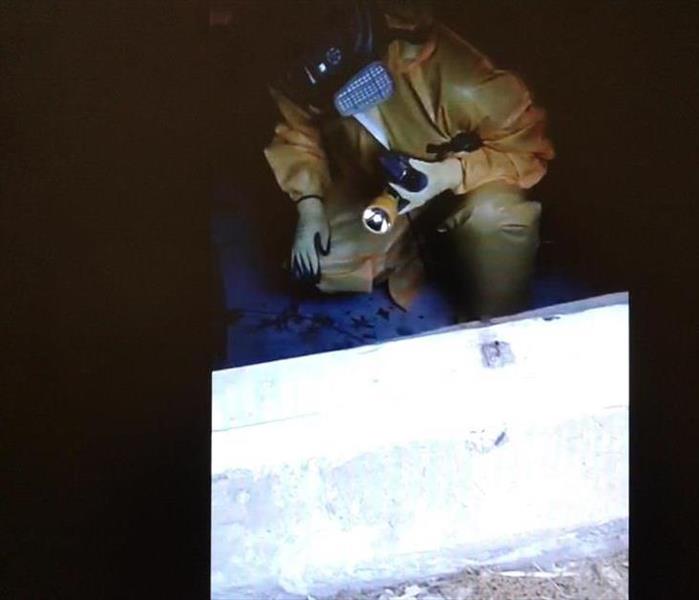 Crime Scene Cleaning in Cherry Hill NJ, Crime Scene cleaning, Tips and Safety Information
Crime Scene Cleaning in Cherry Hill NJ, Crime Scene cleaning, Tips and Safety Information
Crime scene cleanup is a term applied to cleanup of blood, bodily fluids, and other potentially infectious materials (OPIM). It is also referred to as biohazard remediation, because crime scenes are only a portion of the situations in which biohazard cleaning is needed. Such incidents may include accidents, suicides, homicides, and decomposition after unattended death. It could also include mass trauma, industrial accidents, infectious disease contamination, animal biohazards (e.g. feces or blood) or regulated waste transport, treatment, and disposal.
Television productions like CSI: Crime Scene Investigation have added to the popularity of the term "crime scene cleanup". Australia, Canada and England have added it to their professional cleaning terminology. As a profession, it is growing in popularity because of media exposure and the growth of training programs worldwide.
The generic terms for "crime scene cleanup" include trauma cleaning, crime and trauma scene decontamination ("CTS Decon"), biohazard remediation, biohazard removal, blood cleanup and crime scene cleanup. The state of California refers to individuals who practice this profession as "Valid Trauma Scene Waste Management Practitioners".
Types of cleanups
Crime scene cleanup includes blood spills following an assault, homicide or suicide. There are many different sub-segments, named primarily after additional collateral, contingency, or preconditions, regarding the presence of non-blood borne organics, toxic irritants (e.g.,tear gas) or disease vectors. However, it is the legality of charging a fee for mitigating potentially harmful biohazard situations that differentiates a registered crime or trauma practitioner from any general restoration, carpet cleaning, janitorial or housekeeping service.
With concerns about Ebola contamination in the United States, crime scene cleanup companies like Cleaning Guys of Texas and Bio Recovery Corporation of New York have been contracted by government to clean more than just crime scenes.
Business
Crime scene cleanup began primarily as a local or regional small business activity but maturity and consolidation has created some larger entities in the industry; only a few nationwide companies exist, although some national carpet cleaning and restoration companies franchises have added crime scene cleanup and biohazard removal to their services. Due to the legal and ethical complications crime scene cleanup is often its own business entity or a separate division.
Regulatory requirements
While the field of crime scene cleanup is not specifically regulated as a class, most if not all of the activities performed by biohazard cleanup teams in the United States are regulated or fall under best practice guidelines from governing and advisory bodies such as OSHA, NIOSH, DOT, and EPA. Those who hire a crime scene cleanup company should make sure that they are properly trained in applicable federal and state regulations and can provide documentation of proper biohazardous waste disposal from licensed medical waste transportation and disposal companies. If in California or Florida the client should confirm that the company is registered with the state Department of Health. A few states such as California, New York and Florida are the only states that explicitly require registration or licensing for crime scene cleanup. Other states may require biohazardous waste transport permits from the DOT.
In the US, OSHA requires that exposure to blood-borne pathogens be limited as much as possible due to the assumption that the blood and biological material is infectious. Most actions taken to limit exposure fall under cross-contamination protocols, which provide that certain actions be taken to avoid further spreading the contamination throughout otherwise clean areas. CTS De-con companies should have in place, an exposure control plan before beginning work on any trauma scene. Under employee safety and cross-contamination protocols, the following OSHA regulations may pertain to bioremediation.
- OSHA29 CFR 1910.1030(g)(2)(ii)- Initial Assessment of Work: Must assess work site for potential hazards to employee safety. OSHA 29 CFR 1910.1200, et seq.- Hazard Communication Protocol: Required to establish what chemicals are used and that they are properly labeled.
- OSHA 29 CFR 1910.1030(d)(2)(i);29 CFR 1910.1030(e)(2)(iii); 29 CFR 1910.1030(d)(1); and 29, CFR 1926.1053 – Work Practice & Engineering Controls and Safety: Having done the initial assessment, must determine damage, potential hazards, equipment needs, egresses, work routes, possible complicating factors, ladder/scaffolding safety protocols, availability for hand-washing/sanitization wipes.
- OSHA 29 CFR 1910.1030(d)(1) – Method of Compliance: Ensure employees are following all OSHA-mandated engineering and work practice controls through proper supervision, written documentation and photographs.
- OSHA 29 CFR 1910.1030(c)(2) – Exposure Determination: Determine employee safety concerns due to exposure to biological materials.
- OSHA 29 CFR 1910.1030(g)(1) – Hazard Signs and Labels: Hazardous areas must be demarcated; use of biohazard tape and establishment of zones separates and identifies hazardous areas.
In the UK, biohazards are regulated in part by HSE. Canada has published Canadian Biosafety Standards and Guidelines.
Methods
The crime scene cleaners' work begins when the coroner's office or other official, government body releases the "scene" to the owner or other responsible parties. Only when the investigation has completely terminated on the contaminated scene may the cleaning companies begin their task.
Standard operating procedures for the crime scene cleanup field often include military-like methods for the decontamination of internal and external environments. Universal precautions recognized worldwide are the cautionary rule-of-thumb for this field of professional cleaning.
Cleaning methods for removing and sanitizing biohazards vary from practitioner to practitioner. Some organizations are working to create a "Standard of Clean" such as ISSA's K12 Standard, Which includes use of quantifiable testing methods such as ATP testing.
Organizations
The first specialty trade organization for this field of cleaning was the American Bio-Recovery Association (ABRA). The largest association dedicated to the crime scene cleanup industry is the National Crime Scene Cleanup Association (NCSCA). Among other tasks, they organized cleanup procedures for Ebola decontamination in 2014. Clean Trust (aka IICRC) is a certifying body for the cleaning trade in general. International Sanitary Supply Association (ISSA) is a global standards body and trade organization of professional janitorial and cleaning professionals.
Water Damage in Cherry Hill NJ, Detect and Prevent
5/31/2017 (Permalink)
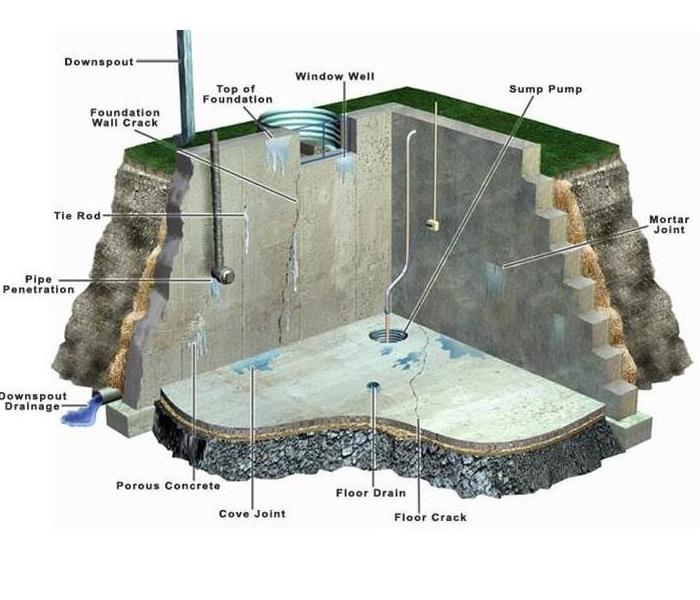 Water Damage in Cherry Hill NJ, Detect and Prevent
Water Damage in Cherry Hill NJ, Detect and Prevent
Standing water on the floor is easy to see. Less obvious signs of problems include:
- Unexpected increases in your water bill
- Stains on walls, floors or ceilings
- Damaged or warped flooring
- Warped bottom panels in under-sink cabinets
- Peeling paint or wallpaper
- Corrosion on plumbing valves and fittings
Deal with problems as you find them. Clean up any water or moisture, locate the source and make repairs. Tracking down a leak isn't always straightforward — water can travel along components in the building structure, so the indications of the leak may be in a different part of the home than the leak itself. If necessary, contact a professional roofing contractor, plumber or water damage restoration specialist to help with identification and repair.
In addition to the damage that water causes, it can encourage the growth of mold on walls and floors — where it's readily visible — and in ductwork, attics and crawl spaces — where you might not notice it. A musty odor is a sign that mold may be present.
Mold can cause damage and lead to health problems — deal with it quickly. If the affected area is larger than 3 feet by 3 feet, the Environmental Protection Agency recommends you find a professional mold remediation contractor. For smaller areas, you can clean nonporous surfaces with commercial cleaning products, soap and water or a solution of a cup of bleach to each gallon of water. Follow the instructions and safety precautions for the cleaning product you use and wear appropriate safety gear. Porous surfaces such as drywall need to be replaced. For more information on mold in the home and how to clean it up, see A Brief Guide to Mold, Moisture, and Your Home on the EPA's web site.
Inspecting common sources of water leaks and taking some simple preventative measures can be an effective way to reduce the risk of water damage and mold.
Plumbing
- Every 6 to 12 months, inspect water lines, shut-off valves and fittings for fixtures such as sinks, toilets and tubs and for appliances such as washing machines, dishwashers and ice makers. Check for cracks, loose connections, kinks and corrosion. If you find a leak, turn off the water to the fixture or appliance until you can make repairs.
- Check around toilets to make sure water is not leaking at the base — an indication that the wax ring between the toilet and floor might need replacing or that there might be a crack in the base.
- If the temperature drops near the 20°F mark, allow faucets connected to vulnerable pipes — those not protected in insulated spaces — to drip. This helps minimize the risk of burst pipes by relieving pressure if the pipes freeze.
Appliances
- Replace washing machine supply hoses at least every five years. Consider using stainless-steel mesh hoses. Keep the machine properly balanced — over time, an unbalanced machine can move, pulling free the hose connections. Read Maintain Your Washer and Dryer for instructions on replacing hoses and balancing the washing machine.
- Consider turning off the water to the washing machine when it's not in use.
- Don't operate a dishwasher or washing machine while your house is unoccupied.
- Follow the manufacturer-specified maintenance for your appliances, including your water heater. Have the water heater inspected every couple of years.
Roof and Gutters
- Have your roof inspected every three years by a professional, but also check routinely for damage you can see from the ground — such as broken and missing shingles or damaged flashing. A poorly maintained roof can lead to leaks in the home and additional damage to the roof itself.
- If your roof doesn't have a drip edge or drip cap, consider having one added. This component helps keep water away from the roof deck and directs runoff into gutters.
- Keep gutters clear and well-maintained. Gutters that overflow, leak or don't drain properly allow water to seep into your roof and into your foundation, crawlspace or basement. See Gutter Cleaning and Repair for steps to keep your gutters working correctly.
- Make sure gutter downspouts direct rainwater away from the home's foundation. Use extensions to carry water at least 6 feet from the house.
Exterior Walls and Foundation
- Inspect the exterior of your home. Caulk around gaps at plumbing and ventilation entry and exit points. See How to Caulk for instructions. Repair cracked mortar joints.
- Check to see if roots from shrubs near your home have caused damage that can allow water to enter the foundation. You may need to remove shrubs that are close to the house to prevent problems. Roots can also damage and block in-ground pipes, causing leaks near the foundation and sewer backups in the home.
- Keep shrubbery beds and other landscape features sloped to direct water away from the home.
- Look for evidence of erosion or settling at the foundation that can indicate water problems.
Additional Tips to Avoid Water Damage
- Have your attic ventilation and insulation inspected annually and seal gaps that allow warm air into the attic — such as those around access doors and light fixtures. When warm air collects in the attic, it can lead to the formation of an ice dam — ice around the eaves that causes water from melting snow and ice to back up under the shingles and leak into your home.
- If you have a sump pump, test it several times during the year. Follow the manufacturer's maintenance instructions.
- Check your water pressure with a pressure gauge; typically these screw onto a hose bib. The pressure in an average home is around 50 to 70 pounds per square inch (psi). Higher pressure causes extra stress on pipes and fittings and can lead to leaks.
- Inspect tile and grout around showers and tubs. Make any necessary repairs. Read Replace a Broken Ceramic Tile and Repair Tile Grout for step-by-step instructions.
- Check for leaks around windows during rains and seal any you find.
- Use exhaust fans in the kitchen and bathroom to move excess moisture out of the house. Moisture in the air can condense on cool surfaces and cause problems. Read Controlling Moisture and Humidity in the Home for more ways to reduce indoor moisture.
- Locate your water shut-off valve so you can quickly turn off water to the home in an emergency. See Shut Off Your Home Water Supply for instructions on locating the valve.
Roof Leaks in Cherry Hill, NJ, Shingle Damage in Cherry Hill, NJ, Chimney Leaks, and Tips for Preventing Leaks
5/24/2017 (Permalink)
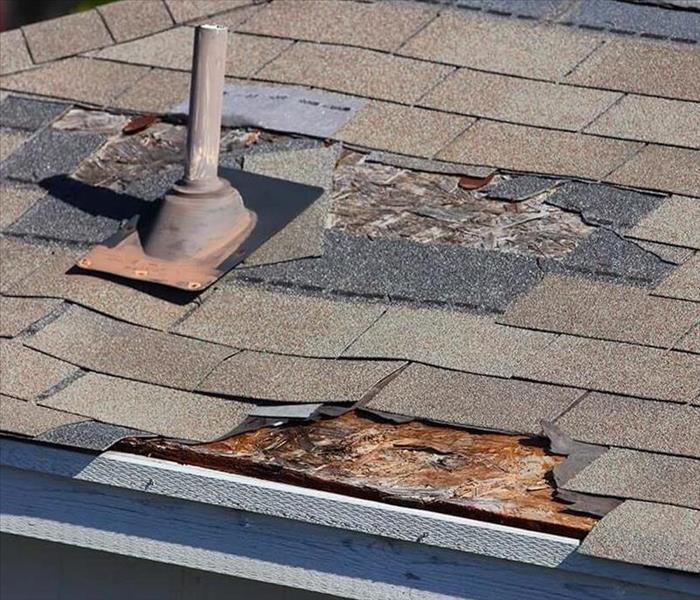 Roof Leaks in Cherry Hill, NJ, Shingle Damage in Cherry Hill, NJ, Chimney Leaks, and Tips for Preventing Leaks
Roof Leaks in Cherry Hill, NJ, Shingle Damage in Cherry Hill, NJ, Chimney Leaks, and Tips for Preventing Leaks
Check for damage in the roofing material directly above where the leak is coming in. This will likely be easier to find on a flat roof, but leaks can also come into the house a good distance from where the actual roof damage is located.If your roof is slanted, inspect areas on the roof that are higher than where the leak enters the home.
If you have an attic, inspect it with a flashlight for water stains, black marks or mold.
Run a hose along different sections of the roof and have a person inside alert you when leaking occurs.
Look for damaged, curled or missing shingles near where the leak is coming in. Look closely for exposed roofing tacks, too.
Straighten out shingles that are curled back. In colder weather, this might require that you soften the shingle edge with heat, such as an electric hair dryer. Using a torch or other open flame heat source isn't recommended since asphalt shingles may be flammable, and regardless of whether they are flame retardant or not, excess heat will ruin the shingle.
Reattach curled-back shingles after straightening with a generous amount of asphalt roof cement or compound around the exposed edges.
Replace damaged shingles. If the shingle lifts off the roof with little effort, breaks, or simply crumbles, it needs to be replaced.Remove the old shingle by lifting its edges and prying out the nail.
Scrape the area underneath it to remove any leftover roofing cement.
Use a sharp utility knife to round the back corners of the new shingle slightly.
Slide the new shingle into place and drive 1 1⁄4 inch (3.2 cm) galvanized roofing nails into each upper corner, then cover the nail heads with roof cement.
Inspect for cracks or blisters in the roofing material.
Mend the blisters. Cut a line through the middle of the blister with a utility knife, but do not cut the sound roofing felt {substrate) underneath.Squeeze out or soak up any water inside the blister. The area needs to be completely dry.
Spread a generous amount of roofing cement under the loose roofing material and press down.
Drive galvanized roofing nails along each side of the repaired blister.
Inspect areas where surfaces connect, such as a chimney or vent pipe.
Look for damage to the caulking, and reapply caulk where necessary.
Remove damaged or deteriorated caulking so the new application can bond to the roof or flashing surface.
Use a putty knife to remove the loosened old caulk.
Clean and dry the area.
Cut the tip off the caulk tube and spread a bead along the same line, working it into the crack with an applicator. Let it dry.
Larger-scale repairs will be necessary if there is damage to the flashing around the chimney or the boots around vents, as these features may need to be replaced.
Flood damage in Cherry Hill, NJ, and Insurance Property Damage Claims, What You May Need to Know
5/23/2017 (Permalink)
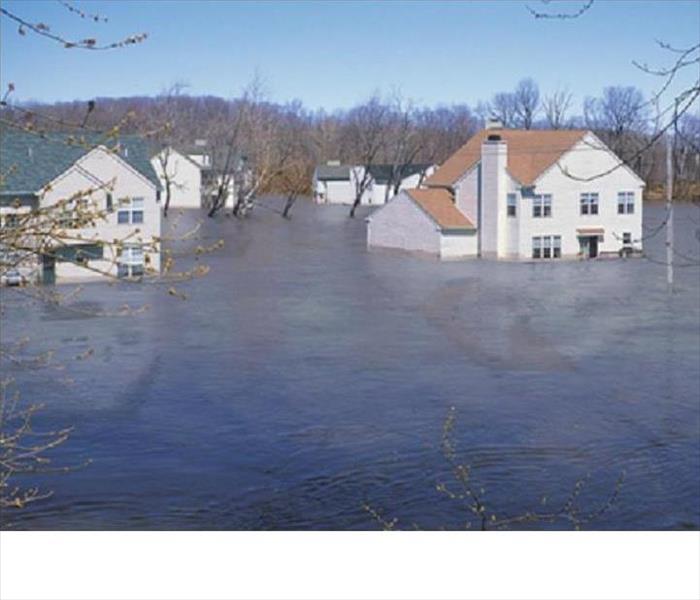 Flood damage in Cherry Hill, NJ, and Insurance Property Damage Claims, What You May Need to Know
Flood damage in Cherry Hill, NJ, and Insurance Property Damage Claims, What You May Need to Know
Rising waters and flood damage can cost tens of thousands of dollars to repair. Most homeowner, who has insurance, will want to make a claim. While all insurance companies don’t have flood coverage, usually a separate policy is purchased in areas where flood waters are a risk. While some insurance companies can take a claim over the phone, an insurance claim letter is always the best way to go. Sure you can call, but a letter can say much more and include valuable pictures. This letter needs to contain specific information about the incident, and when it occurred. All this is valuable and necessary to a claim.
Since this is a formal letter, make sure it is appropriately set up. A block style format should be observed. The name and address of the claimant, followed by the date and then the name and address of the insurance company should always be on the left hand side. A subject line would also be appropriate in this type of correspondence. Unless you know someone personally at the insurance company, you will probably need to address it with a general "To Whom It May Concern," or a “Dear Sir/Madam.”
Start the first paragraph by telling them why you are writing. As a matter of fact, make sure this is in the first sentence. You want to make sure your needs are specified loud and clear. You need to be very specific in your writing and make sure to not leave out any details. If the carpet in the basement is ruined, say so. Specify the date the incident happened and the event that triggered it. Are there other homes in the area directly affected? Make sure to put as much info as you can in the first paragraph.
Giving background information is always helpful to an adjuster. Did you call in an extraction company? Many people call in extraction services before they call the insurance company. These companies can remove the water and do their best to save furniture and carpet. Make sure to specify any methods used to try to save the items. Don't leave out problems with drywall, electric and other critical items. These are of the up-most importance. Just because you got the water out of an item, doesn't mean the problems will stop. Oftentimes, mold will set into areas that have had severe water damage.
Make sure the tone of the letter is friendly. Give information that is necessary to the claim, like account numbers, who the policy’s name is under etc. Also state what you believe your policy limits are, if known. Encourage the company to clear the matter up quickly. Give them an invitation to call or contact you as soon as possible. This letter, along with picture evidence, is a great way to get the ball rolling on your claim. The sooner you contact the insurance company, the sooner you can have your damages repaired. End your letter with a formal conclusion and contact information.
4 Fast Facts About Hail Damage To Your Property, in Cherry Hill, NJ,
5/22/2017 (Permalink)
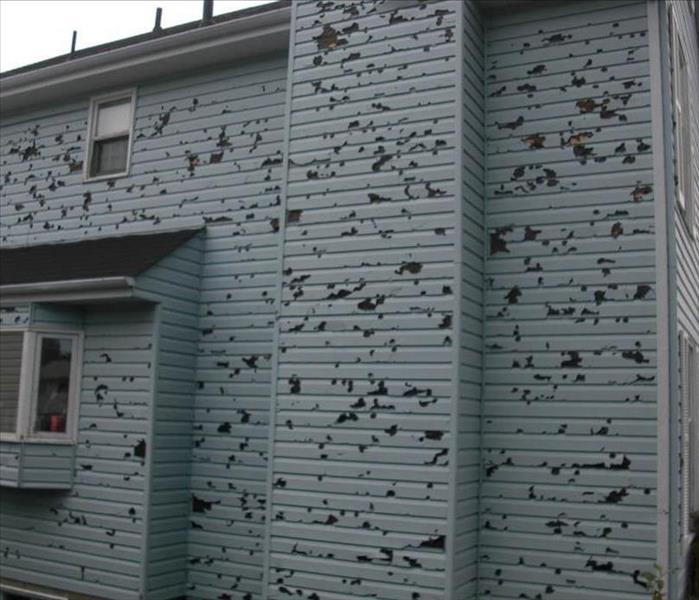 4 Fast Facts About Hail Damage To Your Property, in Cherry Hill, NJ,
4 Fast Facts About Hail Damage To Your Property, in Cherry Hill, NJ,
A powerful storm system blew through a large swath of the nation’s midsection, spawning deadly tornadoes, blowing cars off roads and causing property damage, including from hail.
Here are some hail facts, according to the National Weather Service:
HOW IT FORMS
Inside thunderstorms are warm updrafts and cold downdrafts. When a water drop is lifted, it can carry to temperatures below 32 degrees, freeze and then fall. As it falls it can thaw as it moves into warmer air, where it can get picked up again by another updraft, returning it to cold air where it refreezes. With each trip above and below freezing, it adds a layer of ice before it ultimately falls to earth as hail.
HAIL SIZES (diameter)
Pea: 1/4 inch
Marble: 1/2 inch
Penny: 3/4 inch
Nickel: 7/8 inch
Quarter: 1 inch (hail at least quarter size is considered severe)
Pingpong ball: 11/2 inch
Golf ball: 13/4 inch
Tennis ball: 21/2 inches
Baseball: 23/4 inches
Grapefruit: 4 inches
Softball: 41/2 inches
BIGGEST EVER
The largest recorded hailstone in the U.S. was nearly as big as a volleyball and fell on July 23, 2010, in Vivian, South Dakota. It was 8 inches in diameter and weighed almost 2 pounds.
DAMAGE DONE
Hail causes about $1 billion damage to crops and property annually. A hailstorm that hit Kansas City on April 10, 2001, was the costliest ever in the U.S., causing about $2 billion damage.
If a strong storm roars through, you may find your siding damaged by hail and shingles that the wind ripped off the roof. Homeowners insurance typically covers wind damage. Coverage also usually includes damage from hail, wind-driven rain or snow that gets inside the home when a roof or wall is damaged due to wind. Most policies also offer some coverage for fallen trees that damage your home, provided the tree broke because of a storm or wind.
Be Prepared
While homeowners insurance may help provide protection against the unexpected, it's a good idea to be prepared ahead of time. Taking measures to help prevent or minimize damage from bad weather or a harsh winter may save you a lot of time, energy and money.
Indoor Relative Humidity and Moisture issues, Inside Your Property, in Cherry Hill, NJ
5/19/2017 (Permalink)
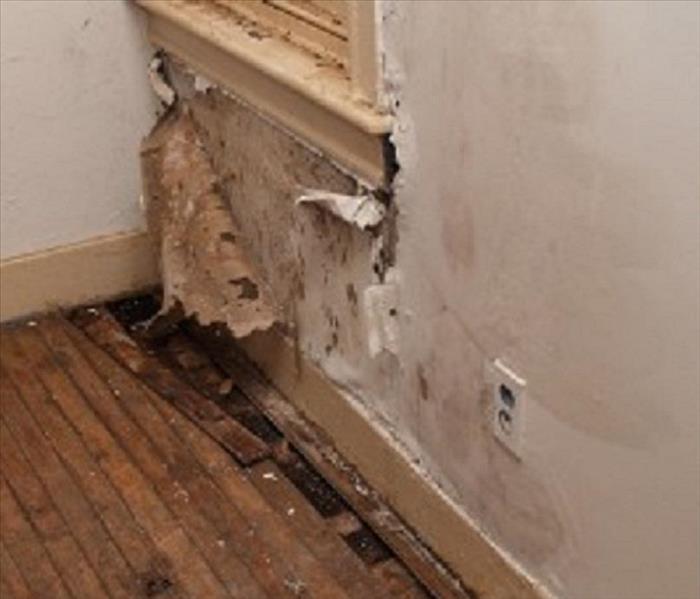 Indoor Relative Humidity and Moisture issues, Inside Your Property
Indoor Relative Humidity and Moisture issues, Inside Your Property
When indoor humidity levels are too high, condensation on windows and walls starts to cause structural damage. Damage to the house manifests in wood rot, molds, damp spots, and corroding furniture.
Costly damage caused by moisture that builds up can occur between the walls and ceilings, paint may start to peel as well as permanent wood warping/damage.Every time we cook, bathe, shower or breathe, we increase the amount of moisture in the air; when these activities occur indoors, we raise the humidity level inside our home. Humidity is the amount of water vapor in the air; it makes the air feel wet and clammy or smell musty. During a hot summer day, humidity makes the air feel even warmer, since it prevents sweat from evaporating from the skin, undermining the body's way of staying cool.
Relative humidity is the amount of water the air contains compared to the amount it could contain at a specific temperature. When the relative humidity is 100 percent, the air is retaining the most moisture possible at that temperature without precipitation. Most of us feel comfortable inside our home when the relative humidity remains between 30 and 60 percent. When the indoor humidity level is below 30 percent, the air is too dry, which can harm both a home's structural integrity and the homeowners' health. Conversely, when the level is above 60 percent, the air is too wet, which is also harmful to both the home and the homeowners. Excess humidity is a breeding ground for mold, pests and rot in homes and is more likely to cause heatstroke, heat exhaustion, headaches and dehydration than a less humid atmosphere.
To combat a high humidity level inside the home, many homeowners run the air conditioning unit. While air conditioning can reduce the humidity level, the result is high energy bills and a cold and uncomfortable living space. Rather than using air conditioning, homeowners and builders can have a whole-house dedicated dehumidification system installed. This type of system operates using the home's central air distribution system. A dehumidification system can be programmed to maintain specific humidity levels, giving homeowners the ability to customize the comfort level of their home.
Whole-house dehumidification systems can be installed in both new and existing homes. Here are a few points to keep in mind when considering installing dedicated dehumidification systems:
- Choose a dehumidification system that has built-in fan cycling. This feature will keep the humidity and temperature balance steady throughout the home instead of in just one room. It will also minimize hot and cold spots and improve the overall air quality.
- Look for a dehumidification system that has the capacity to remove up to 90 pints of moisture per day from the air. For builders, a high-capacity system will provide for the flexibility of using the system in a wide variety of homes.
Air Conditioner Problems, and Prevent AC Condensation leaking into your Property, Water damage in Cherry Hill, NJ
5/18/2017 (Permalink)
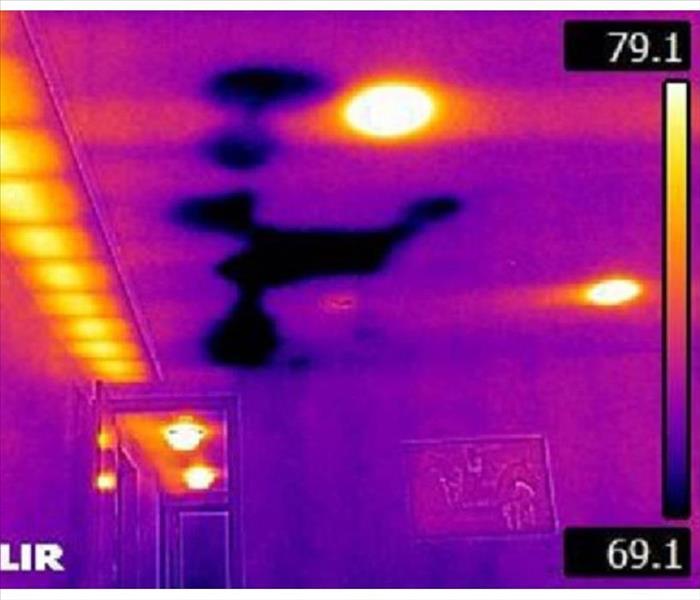 Air Conditioner Problems, and Prevent AC Condensation leaking into your Property, Water damage in Cherry Hill, NJ
Air Conditioner Problems, and Prevent AC Condensation leaking into your Property, Water damage in Cherry Hill, NJ
One of the most common air conditioning problems is improper operation. If your air conditioner is on, be sure to close your home's windows and outside doors. For room air conditioners, isolate the room or a group of connected rooms as much as possible from the rest of your home. For a list of common air conditioner problems and what to look for, check out our Energy Saver 101 infographic on home cooling.
Other common problems with existing air conditioners result from faulty installation, poor service procedures, and inadequate maintenance. Improper installation of a central air conditioner can result in leaky ducts and low airflow. Many times, the refrigerant charge (the amount of refrigerant in the system) does not match the manufacturer's specifications. If proper refrigerant charging is not performed during installation, the performance and efficiency of the unit is impaired. Unqualified service technicians often fail to find refrigerant charging problems or even worsen existing problems by adding refrigerant to a system that is already full. Learn what to ask for when hiring a technician to maintain your air conditioner.
Air conditioner manufacturers generally make rugged, high quality products. If your air conditioner fails, begin by checking any fuses or circuit breakers. Let the unit cool down for about five minutes before resetting any breakers. If a central air conditioner's compressor stops on a hot day, the high-pressure limit switch may have tripped; reset it by pushing the button, located in the compressor's access panel.
REFRIGERANT LEAKS
If your air conditioner is low on refrigerant, either it was undercharged at installation or it leaks. If it leaks, simply adding refrigerant is not a solution. A trained technician should fix any leak, test the repair, and then charge the system with the correct amount of refrigerant. Remember that the performance and efficiency of your air conditioner is greatest when the refrigerant charge exactly matches the manufacturer's specification, and is neither undercharged nor overcharged. Refrigerant leaks can also be harmful to the environment
INADEQUATE MAINTENANCE
If you allow filters and air conditioning coils to become dirty, the air conditioner will not work properly, and the compressor or fans are likely to fail prematurely.
ELECTRIC CONTROL FAILURE
The compressor and fan controls can wear out, especially when the air conditioner turns on and off frequently, as is common when a system is oversized. Because corrosion of wire and terminals is also a problem in many systems, electrical connections and contacts should be checked during a professional service call.
SENSOR PROBLEMS
Room air conditioners feature a thermostat sensor, located behind the control panel, which measures the temperature of air coming into the evaporative coil. If the sensor is knocked out of position, the air conditioner could cycle constantly or behave erratically. The sensor should be near the coil but not touching it; adjust its position by carefully bending the wire that holds it in place.
DRAINAGE PROBLEMS
When it's humid outside, check the condensate drain to make sure it isn't clogged and is draining properly. Room air conditioners may not drain properly if not mounted level.
Common Causes of AC Water Leakage
The following issues can cause water leaks in your central AC system:
Clogged Drain Line
A clogged condensate drain pipe can make your AC system’s drain pan overflow. This is probably the most frequent cause of water leakage from a central AC system, bringing many service calls to HVAC professionals as summer temperatures rise. Drain lines can become clogged with dirt, rust, algae and other debris.
Disconnected Drain Line
When AC systems are improperly installed drain pipe fittings may not be secure. Over time, they can loosen, causing the drain pipe to disconnect from the AC unit and allowing the condensate to drain through the ceiling or onto the floor. As with a clogged drain line, the location of the leak will depend on whether the primary or secondary drain pipe is the one affected and whether your central AC system is located in the attic or in your house.
Condensate Pump Problems
A malfunctioning or dirty condensate pump can also cause water leakage from your AC system, flooding your attic or basement. Due to the continual presence of water, mold and mildew can grow inside the unit, causing it to clog.
Other Potential Causes of AC Water Leakage
Water leaks can also be caused by the following issues:
- Clogged air filter
- Low refrigerant
- Cracked condensate drain pan
- No p-trap and air vent in the drain line to prevent water backup
- Condensate buildup in un-insulated ductwork
The first two issues in the list above can contribute to a frozen evaporator coil, which creates its own set of water leakage problems.
Ways to Avoid Damage from Water Leakage
Follow these tips to reduce the likelihood of water leakage issues:
- Make sure your central AC system has a secondary drain line — especially if your air handler is in the attic.
- Install a drain pan overflow shutoff switch, equipped with a float.
- Add a safety pan under your AC unit to catch drain pan overflow.
- Clean or change your HVAC air filter regularly.
- Make sure your ductwork is properly insulated.
- Have your AC refrigerant levels checked regularly.
- Make sure each drain line contains a p-trap and air vent.
- Keep your condensate pump free from mold and mildew by flushing it with a 50% bleach/water solution.
- Schedule annual HVAC maintenance to maximize performance and minimize furnace and AC repairs.
Storm Damage, Property Insurance Tips, Prevention, and Costs, in Cherry Hill, NJ
5/17/2017 (Permalink)
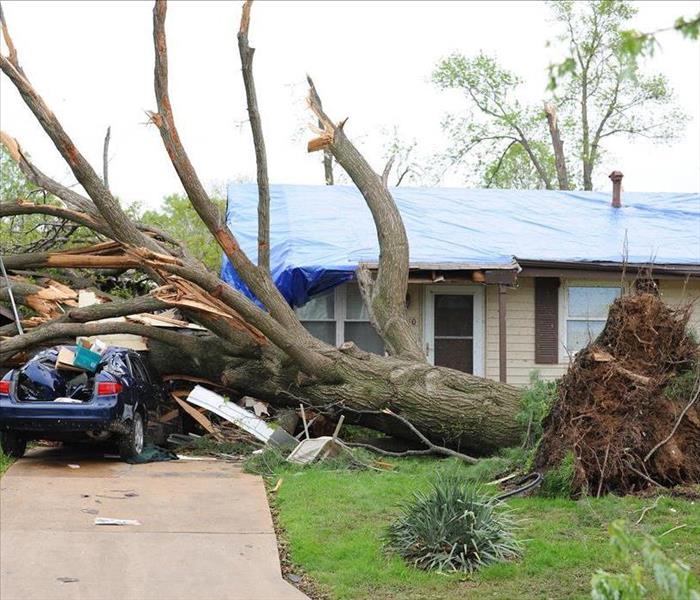 Storm Damage, Property Insurance Tips, Prevention, and Costs, in Cherry Hill, NJ
Storm Damage, Property Insurance Tips, Prevention, and Costs, in Cherry Hill, NJ
When buying homeowners insurance there are several factors to consider. In areas where severe storms are common, it is especially important to understand the type of insurance policy you have, the limitations of your policy, what it covers and the types of storms for which you may not be covered.
Storm Damage Insurance Overview
Many homeowners have already experienced a severe hailstorm and witnessed the damage hail can cause to homes, automobiles, businesses and other property. When a hailstorm hits, it does the greatest amount of damage to the exterior of your home or property. Common types of damage caused by hail are: roof damage, siding damage, shingle damage, window damage and automobile damage.
Thunderstorms
Most standard homeowners policies, also known as HO-3 policies, cover both your home and its contents. Typically, you are covered against storm damage, theft, pet damage and some major disasters, such as tornadoes, hurricanes and hail.
Earthquakes and floods are usually not covered under most standard insurance policies and require a separate policy. Remember, home insurance policies do not cover poor maintenance or normal wear and tear, so it is a good idea to make sure your home is always properly maintained.
What to Do Before You Talk to an Insurance Agent
Before buying homeowners insurance, the first thing you need to determine is the replacement cost of your home. The replacement cost reflects the total cost to replace the structures on your property. This is typically different than the market value, or sales price of your home, which takes into account other factors including the value of your lot.
An easy way to figure out your replacement cost is to multiply the building cost per square foot of your home, with the number of total square feet. If you don't have a good sense of building costs for your area, any local contractor should be able to give you a good idea of average building costs in your area.
Once you know your replacement cost, you'll have a good idea of what your insured liability limit should be. Liability limit is the amount of coverage you have if something, such as a tornado or other serious storm, destroys your home. Most experts recommend liability limits equal to the replacement cost, so if your home is totally destroyed your insurance will cover the costs to restore or rebuild your home, including living expenses if you are unable to inhabit your home.
If you live in an area prone to flooding, make sure you obtain flood insurance, which is typically a separate policy. If you have questions about your coverage, check with your insurance agent and make sure you have a solid understanding of your coverage, especially as it relates to serious storm damage or other catastrophic losses.
In states where a severe tornado not only threatens your home and its contents, it is important to understand the difference between actual cash value insurance and replacement value insurance. Actual cash value insurance compensates you for the actual, depreciated value of the items in your home. So, if you have a TV that originally cost $500, but is now worth $100, your insurance will pay you $100 if it is destroyed.
For homeowners with expensive electronics, art, and other furnishings, replacement value insurance is a smart way to go. Replacement value pays you the full amount it would cost to replace a broken, damaged or missing item. So, if a storm destroys a $4,000 plasma TV inside your home, your insurance will cover the full $4,000 replacement value of your TV, and whatever else is damaged inside your home, minus the cost of your deductible, up to the limits of your policy. If you own very expensive individual items, such as original art, or valuable jewelry, you might consider insuring those items individually, under a separate policy.
Whatever type of insurance you choose, it's always wise to take an inventory of the items in your home. If your home is completely destroyed, you will not be able to remember all of the items you own, unless you have a detailed inventory and pictures of what is inside. It is always a good idea to store your inventory list and pictures in a separate, secure location, such as a bank safety deposit box. If you have a digital camera, take pictures and email them to yourself, along with your inventory list.
A deductible is the amount you are required to pay out of pocket before your insurance kicks in. Typically homeowners insurance deductibles range from $250 to over $1,000. So, if your home is damaged by a hailstorm and incurs $10,000 in damages and you have a $500 deductible, the insurance company will pay $9,500 towards your repairs. The higher your deductible, the lower your premium will be.
When deciding on a deductible, make sure it's an amount you can come up with easily, that won't create a financial strain or hardship. Some companies are now offering policies with high deductibles, including deductibles that are calculated as a percentage of your home's value. For example, if your home is worth $200,000 and you have a 2% deductible, you will have to come up with $4,000 before your insurance pays anything. While these types of policies can offer a lower premium, make sure you are able to cover the cost of the deductible, in case a severe storm or disaster hits your area.
Shopping for Homeowners Insurance
When shopping for a homeowners policy, it is smart to check out several different insurance companies. Different insurance companies offer a wide range of coverage levels, discounts and prices. Don't just shop the companies you know best, but search for the policy that works best for your situation. If you come across a policy that looks good, but is offered by a company you haven't heard of, it's easy to check out their background. Here are three websites you can use to investigate the financial strength of an insurance company:
When selecting a policy, start by researching your area. You'll want to have a firm understanding of the storm damage history of your neighborhood related to:
- Hailstorms
- Tornadoes
- Wind Storms
- Flooding
- Earthquakes
- Natural Disasters
Make sure the insurance policy you select adequately covers storms and natural disasters in your area. Watch out for insurance companies known for unfairly denying claims. Every year, the American Justice Association publishes a list of the 10 Worst Insurance Companies. If your insurance company is on the list and your insurance claim has been denied, make sure you connect with a reputable contractor with the experience to fight for your rights.
Saving Money on Homeowners Insurance
There are many factors insurance companies take into account when determining the price of your insurance premium. Some factors that affect the cost of your premium may include:
- History of a severe storm or disaster in your area
- Neighborhood crime levels
- Quality of building materials in your home
- Building costs in your area
- Size and overall condition of your home
- Distance from a fire station
You may be eligible for a discount on your insurance premium by making certain improvements to your home, which can add up to significant savings. The following list of improvements will not just result in savings, but will make your home safer as well.
- Impact resistant roofing shingles
- Shatterproof windows
- Storm shutters
- Reinforced tile or slate roof
Most states prohibit insurance companies from canceling your insurance policy or singling you out for a rate increase for filing a storm damage claim. If you live in an area with a high propensity for severe storms or other natural disasters, you should expect premiums to be higher.
Insurance companies can raise rates for everyone living in a storm prone area. If this is the case, your rate will increase whether or not you file an insurance damage claim. So, if your home has been damaged by a tornado, hailstorm, severe wind, or other type of natural disaster, it is in your best interest to file an insurance claim to pay for the damage. If you fail to file a claim, your increase in premium will pay for everyone's repairs except for yours.
If you have storm damage to your home or commercial building, then you may need to file an insurance claim.
Causes of Property Sewer Backup and Prevention Tips, in Cherry Hill, NJ
5/16/2017 (Permalink)
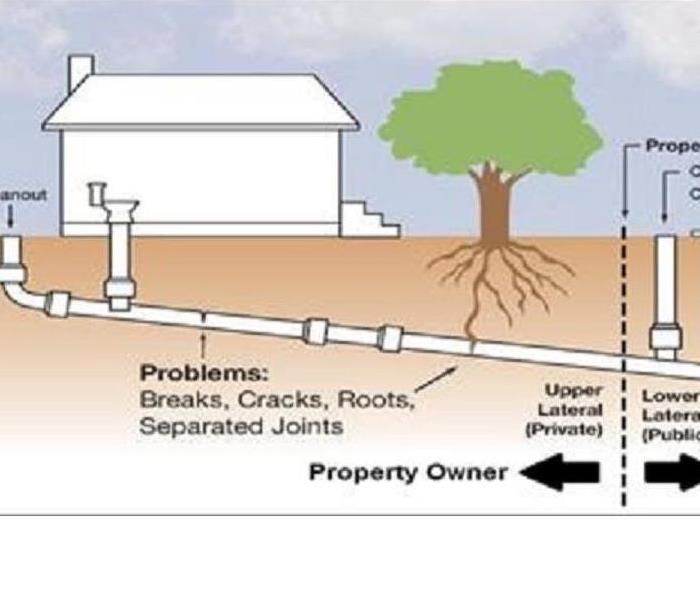 Causes of Property Sewer Backup and Prevention Tips, in Cherry Hill, NJ
Causes of Property Sewer Backup and Prevention Tips, in Cherry Hill, NJ
Backed up sewers can wreak havoc on a home, causing thousands of dollars in damage to floors, walls, furniture and electrical systems. Sewer backup coverage is available from most insurers for a nominal cost—usually an additional annual premium of $40-$50.
For homes that have been severely damaged and are uninhabitable, homeowners policies may provide Loss of Use coverage, which provides reimbursement for lodging, food and other living expenses you may incur as a result of having to live outside of your home. Loss of Use coverage also reimburses you for the lost rental income if you rent out part of the house.
Causes of Sewer Backup
Aging Sewer Systems: The Civil Engineering Research Foundation reports that the number of backed up sewers is increasing at an alarming rate of about 3 percent annually. In addition, a recent report from the American Society of Civil Engineers indicates that the nation's 500,000-plus miles of sewer lines are on average over thirty years old. The increase in the number of homes connected to already aging sewage systems has also contributed to rapid increases in sanitary sewer backups, flooded basements and overflows.
Combined Pipelines: Problems also arise in systems that combine storm water and raw sewage into the same pipeline. During many rain storms, the systems are exposed to more volume than they can handle, and the result is a sewage backup situation that allows sewage to spew out into basements and other low lying drains.
Blockages Due to Tree Roots: Shrubs and trees seeking moisture will make their way into sewer line cracks. These roots can cause extensive damage. They may start out small, getting into a small crack in the pipe; but as the tree or shrub continues to grow, so does the root. Tree roots can enter the service pipe at joints and cause blockages. Tree roots can travel a long way, and roots from different types of trees act differently. If city trees are suspected, your plumber can contact the city, and samples of the roots will be used to help identify the trees and who is responsible for cleanup. Sometimes the blockage is a result of a combination of city and private trees. In this case costs are split between the city and the property owner.
Sanitary Main: A blockage can occur in a city sanitary main. If the blockage is not detected in time, sewage from the main can back up into homes and businesses through floor drains. Usually this happens slowly, giving the owner time to call a licensed plumber to assess the damage. If water is entering into your basement at a rapid rate, call the city public works office and report the problem immediately.
Water in Basement: Most basement flooding is not related to the sanitary sewer system. In many cases, soil settles adjacent to the building and, if not corrected, leads to rainwater flowing towards the building and down the outside of the foundation wall. This is particularly true in older buildings, where cracks may have developed in the foundation or floor slab that allow water to enter the basement. The cement floor and basement walls of these structures may have deteriorated to the point that they are no longer waterproof. In these cases, water can show up in a basement that has never had a water problem. This will usually happen after a number of rain storms, when the ground is saturated. Drainage can be improved by making sure that water drains away from the building. Owners may also be able to prevent flooding by water sealing the basement.
Most homeowners may not realize that they are responsible for the maintenance and repair of their house or sewer lateral—the pipeline between the city sanitary sewer main, usually located in the street—and the building. The sewer lateral is owned and maintained by the property owner including any part that extends into the street or public right of way. A cracked or deteriorated lateral or one filled with tree roots can allow groundwater to seep into the system, contributing to the problem.
How to File a Claim
For insurance purposes, take before and after photos of the affected areas and itemize any property losses. Save all receipts related to repair, cleaning or damages and contact your insurance agent or company representative as soon as possible.
How to Prevent Backups In Your Lateral and in the City Main
Dispose of Grease Properly: Cooking oil should be poured into a heat-resistant container and disposed of properly, after it cools off, not in the drain. Washing grease down the drain with hot water is unsatisfactory. As the grease cools off, it will solidify either in the drain, the property owner's line, or in the main sewer causing the line to constrict and eventually clog.
Dispose of Paper Products Properly: Paper towels, disposable (and cloth) diapers and feminine products can cause a great deal of trouble in the property owner's lateral as well as in the city main. These products do not deteriorate quickly, as bathroom tissue does, so do not put them down the drain or toilet.
Replace Your Line with New Plastic Pipe: One way to prevent tree roots from entering your line is to replace your line and tap with new plastic pipe. If you have continuing problems with tree roots in your lateral, you may have to have the roots cut periodically.
Correct Illegal Plumbing Connections: Do not connect French drains, sump pumps and other flood control systems to your sanitary sewer. It is illegal, and debris and silt will clog your line. Consult a plumber to correct any pre-existing illegal connections. French drains are common drainage systems, primarily used to prevent ground and surface water from penetrating or damaging building foundations.
Install a Backwater Prevention Valve: A backwater valve is a fixture installed into a sewer line, and sometimes into a drain line, in the basement of your home or business to prevent sewer backflows. A properly installed and maintained backwater valve allows sewage to go out, but not to come back in. Property owners are responsible for the installation and maintenance of backwater valves. The cost to install one depends on the type of plumbing in the building and the difficulty of installation. Check with a qualified plumber.
What to Do If You Experience a Sewer Backup
A sewer backup can lead to disease, destruction of your valuables, damage to your house or business, and can even result in electrical malfunctions. Prompt cleanup of affected property can help minimize the inconvenience and prevent mold or further damage. If you experience a sewer backup situation, immediately arrange for the cleanup of your property. This should include:
- Wet-vacuuming or removal of spillage
- Mopping floors and wiping walls with soap and disinfectant
- Flushing out and disinfecting plumbing fixtures
- Steam cleaning or removing wet carpets or drapes
- Repairing or removing damaged wallboard or wall covering
- Cleanup of ductwork
Fire Safety for Kids, Protecting and Educating your children
5/11/2017 (Permalink)
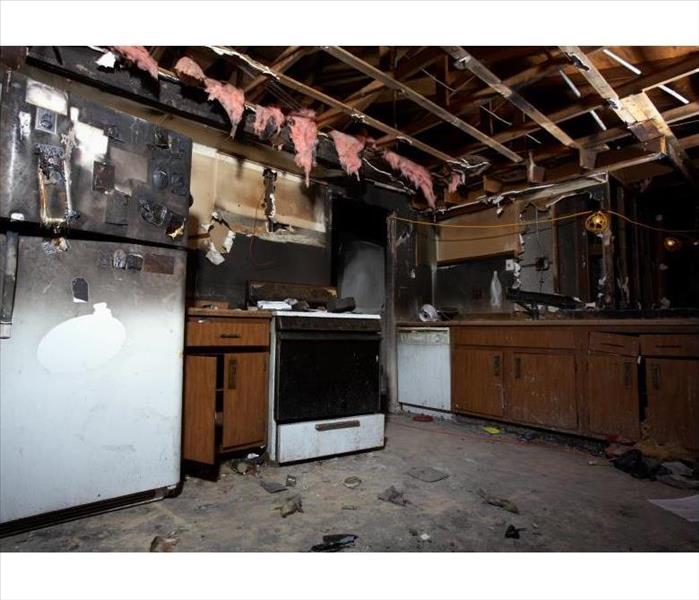 Fire Safety for Kids, Protecting and Educating your children
Fire Safety for Kids, Protecting and Educating your children
A home fire is a devastating event, and one that you never count on happening. Your children are most at risk when this disaster occurs. In fact, children under five are twice as likely as other people to die in a home fire. Tragically, many home fires are started by children playing with dangerous household items – especially lighters and matches. Taking sensible precautions in the home and teaching your child how to escape from a fire can help your family avoid this type of heartbreak.
Prevent Your Child from Starting FiresThe U.S. Fire Administration estimates that 300 people are killed and $280 million in property is destroyed each year as the result of children playing with fire.
Keep matches, lighters and other ignitable substances in a secured location out of your child’s reach. Only use lighters with child-resistant features.
Invest in flameless candles. These candles contain a light bulb rather than an open flame, and take the danger out of your child knocking over a candle.
Help Your Child Survive a FireInstall smoke alarms on every level of your home, inside bedrooms and outside sleeping areas. Once a month check whether each alarm in the home is working properly by pushing the test button. Replace batteries in smoke alarms at least once a year. Immediately install a new battery if an alarm chirps, warning the battery is low.
Teach your children what smoke alarms sound like and what to do when they hear one.
Ensure that all household members know two ways to escape from every room of your home, and where to meet up outside.
Practice your fire escape plan at least twice a year and at different times of the day. Practice waking up to smoke alarms, low crawling and meeting outside. Make sure everyone knows how to call 9-1-1.
Emphasize “get out, stay out.” Only professional firefighters should enter a building that is on fire—even if other family members, pets or prized possessions are inside.
Use quick-release devices on barred windows and doors. Security bars without release devices can trap you in a deadly fire. If you have security bars on your windows, be sure one window in each sleeping room has a release device.
Consider getting escape ladders for sleeping areas on the second or third floor. Learn how to use them, and store them near the windows.
Teach household members to STOP, DROP and ROLL if their clothes should catch on fire.
TOP 10 CAUSES OF WATER DAMAGE IN YOUR HOME AND PROPERTY!
5/11/2017 (Permalink)
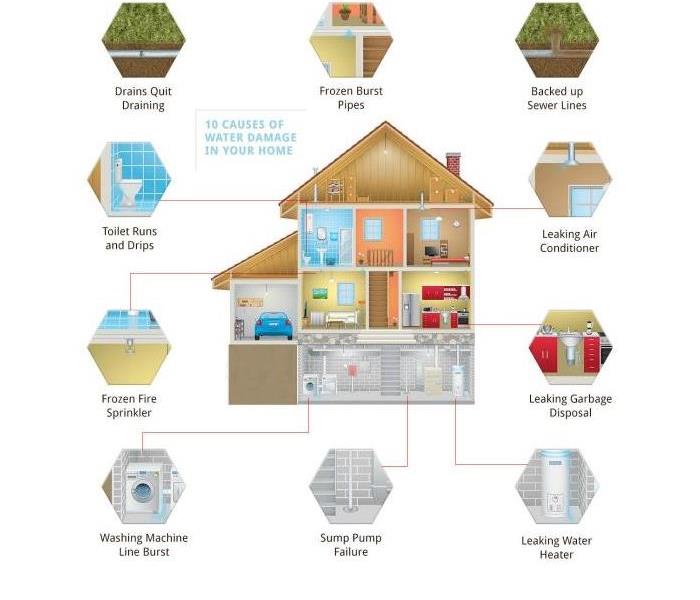 TOP 10 CAUSES OF WATER DAMAGE IN YOUR HOME AND PROPERTY!
TOP 10 CAUSES OF WATER DAMAGE IN YOUR HOME AND PROPERTY!
Old plumbing and leaky appliances around the house aren’t out to get you, but sometimes it seems that way. The weather plays a part too with winter freezes that burst pipes and spring rains that flood basements.Our cleanup and restoration teams have seen it all here in Chicago and the surrounding suburbs. In our experience, these are the 10 most common causes of residential water damage that can affect your home. Our list also includes helpful links and tips on how to handle each type of wet disaster.
1. The Toilet Runs and Drips
When it constantly runs, it’s annoying and expensive. When it springs a bad leak, it can ruin floors and walls. The trick to fixing a leaky toilet is figuring out why it’s turned into a water hazard. Once you pinpoint the problem, repairs are usually simple and inexpensive.
2. Pressure Gets to the Washing Machine
Your washing machine quickly fills with water because its supply lines are under constant pressure. Older rubber or PVC lines wear out and rupture, and that failure turns the laundry room into a flood zone. Avoid this potential mess by replacing old lines with braided stainless steel.
3. Your Garbage Disposal Floods Cabinets
Most disposal leaks are DIY fixable, but when this appliance stops working, it can go out with a splash. As the body of the unit gets old, it springs leaks around the bottom housing and floods cabinets with a dirty mix of food garbage and water. When this happens, you need to replace the disposal.
4. Your AC Soaks the Ceiling
The AC pulls humidity out of the air and condenses moisture into the unit’s overflow pan so that water travels outside through the condensate line. This drainage system quits working if the pan is damaged or the line is clogged. The results are soggy insulation and soaked ceilings.
5. The Water Heater Develops Leaks
This appliance is often located in basements, and that can make cleanup even more challenging after a bad leak. Sometimes, a water heater problem is due to condensation, but it’s more likely a faulty water outlet or drain valve. Older units can develop leaks in the bottom of the tank and flood the entire basement.
6. Frigid Temperatures Burst Pipes
This water emergency is confined to cold months, but you have to be prepared. Pipes can freeze and rupture in just a few hours, and the flooding can soak the house from ceiling to basement. Always check and insulate your plumbing before the Chicago winter settles in.
7. Fire Sprinkler Systems Freeze Too
High-rises, condos and newer homes feature these life-saving systems, but residential fire sprinklers are prone to freezing without proper winter maintenance. Cold-weather sprinkler routines keep the family safe and help avoid water damage from ruptured pipes.
8. The Sump Pump Stops Pumping
Whether it’s caused by heavy rain or appliance failure, water in the basement is a disaster when the sump pump stops working. You have to deal with water removal, thoroughly dry everything and address mold and mildew growth. It’s often best to let professionals handle basement flooding.
9. Drains Quit Draining
This simple outlet can complicate an ordinary day by leaving standing water in a tub, the kitchen sink or the basement. A stopped-up tub or sink is a big nuisance, but a clogged floor drain can result in a basement filled with water. Your DIY solutions range from drain snakes to air blasters.
10. Sewer Lines Back Up
Don’t try to handle this problem by yourself. Backed-up sewer lines are caused by blockage or heavy rainfall, and they quickly spread dangerous contaminants that create a very unhealthy environment. Sewage backup and flooding should always be taken care of by certified professionals.
6 Disasters, Home/Property Insurance Won’t Cover!
5/9/2017 (Permalink)
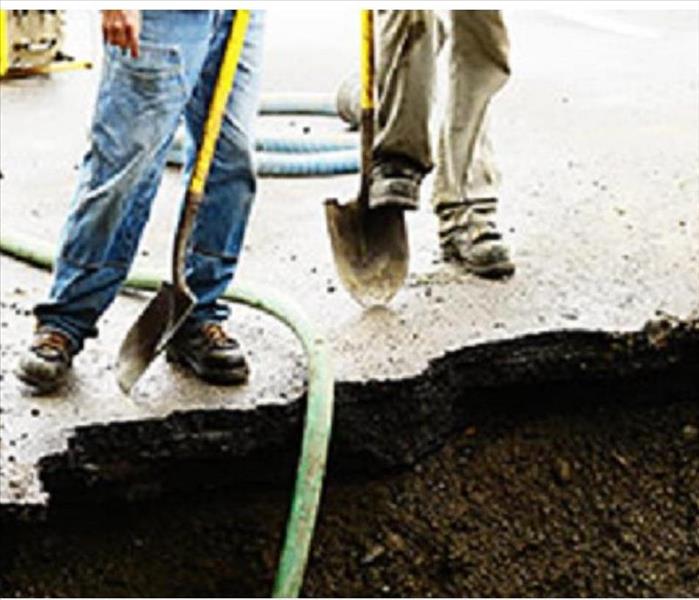 6 Disasters, Home/Property Insurance Won’t Cover!
6 Disasters, Home/Property Insurance Won’t Cover!
When disaster strikes your home, Property Insurance, is supposed to be there to help you pick up the pieces. Most of the time, it does.
A Bankrate survey found that 81 percent were aware flooding is not covered by regular homeowners insurance. You may have heard earthquakes also require special coverage. Yet you may not know that there are other types of damage that are excluded from most policies as well:
Mold
At least 1,000 species of mold are common to the United States, according to the New York-based trade group the Insurance Information Institute.
Despite the threat, a standard homeowners insurance policy generally either limits coverage for mold damage or outright excludes it.
Some insurers offer an endorsement to expand coverage limits for mold claims but only if you are willing to pay more for your insurance, she says.
The best cure for mold is to prevent it from growing in the first place. If the basement floods after a rainstorm or a pipe is leaking, eliminate the moisture promptly.
Sewer backup
America’s sewer lines are rapidly aging, with some more than 100 years old. As more homes have been connected to these out-of-date lines, sewage backups have followed.
Other sources of backups include pipelines that handle both stormwater and raw sewage — and become overwhelmed in rainstorms — and blockages from tree roots that work their way into sewer-line cracks.
When a sewer backs up into a home, it can damage floors, walls, furniture and electrical systems. Standard homeowners insurance does not cover sewer backups.
The Insurance Information Institute says sewer-backup damage often can be covered for an additional premium of just $40 to $50 per year.
Sinkholes
Sinkholes can seem like something out of a horror movie. For example, there was the Florida man who was swallowed up in early 2013 when a sinkhole opened without warning beneath his bedroom.
Sinkholes are sudden gaps in the earth’s surface that occur after groundwater gradually dissolves rock such as limestone and carries bits of it away, creating large pores and cracks in bedrock. Once large cavities form underground, the land above it may suddenly settle or collapse, creating the sinkhole.
In the United States, sinkholes tend to cause the most problems in Florida, Texas, Alabama, Missouri, Kentucky, Tennessee and Pennsylvania, according to the U.S. Geological Survey.
Most home insurance policies will not cover damage associated with “earth movement,” such as an earthquake or sinkhole.
Florida is the only state in which insurers are required to provide coverage for sinkhole damage
Florida insurers must include insurance for “catastrophic ground cover collapse” — which refers to damage so severe, the home is uninhabitable — as part of standard homeowners insurance.
In every other state, earth movement is excluded from the insurance policy.
Termite infestation
Colonies of anywhere from a few hundred to several million termites can quietly and methodically devastate your home.
Wood, paper and dead plant material that is in contact with soil near the house provides termites with a ready source of food and an entry. And moisture accumulated around foundations and in poorly ventilated crawl spaces gives termites a source of water they need to survive.
Over time, termites can damage or destroy support beams and other wood features in a house. The National Pest Management Association estimates that termites cause $5 billion in damage in the U.S. each year.
If these unwanted guests cause wear and tear to your home, do not expect your insurer to bail you out.
Homeowners policies do not pay for termite damage.
Homeowners can avoid structural damage with early intervention.
Nuclear plant accidents
The Federal Emergency Management Agency, or FEMA, says nearly 3 million Americans live within 10 miles of an active nuclear power plant. If an accident at a nearby reactor leaves your home uninhabitable, standard homeowners insurance will not cover the claim. But that does not mean you will be unprotected.
A 1957 federal law called the Price-Anderson Act compensates people in the United States for any damage or injuries resulting from a commercial nuclear accident.
The law was called upon after the nation’s worst nuclear accident, at the Three Mile Island plant near Harrisburg, Pa., in 1979.
The insurance paid for the living expenses of families who decided to evacuate.
The Nuclear Regulatory Commission says an insurance pool of more than $12 billion is available to pay out claims.
Claims covered under Price-Anderson include:
- Bodily injury.
- Sickness.
- Disease resulting in death.
- Property damage and loss.
In addition, individuals evacuated from an affected area can expect reimbursement for reasonable living expenses beyond what you ordinarily pay. The coverage does not pay your mortgage, does not pay for your normal food bills.
Some acts of terrorism
The recent Boston Marathon bombings were a reminder that terror can strike at any moment.
The Insurance Information Institute says terrorist attacks using nuclear, biological, chemical or radioactive weapons are considered “acts of war” that are fundamentally uninsurable. Standard home insurance policies do not specifically reference terror attacks.
However, the policy does cover the homeowner for damage due to explosion, fire and smoke, these are the most likely types of damage a home would suffer in a terrorist incident.
If you own a condominium or co-op, the policy you carry on your individual unit will protect your structure and possessions from damage related to a terrorist attack.
However, damage to common areas — including the roof, basement, elevator, boiler and walkways — is not covered unless your board purchases separate terrorism coverage.
Crime scene cleanup and Biohazards....
5/3/2017 (Permalink)
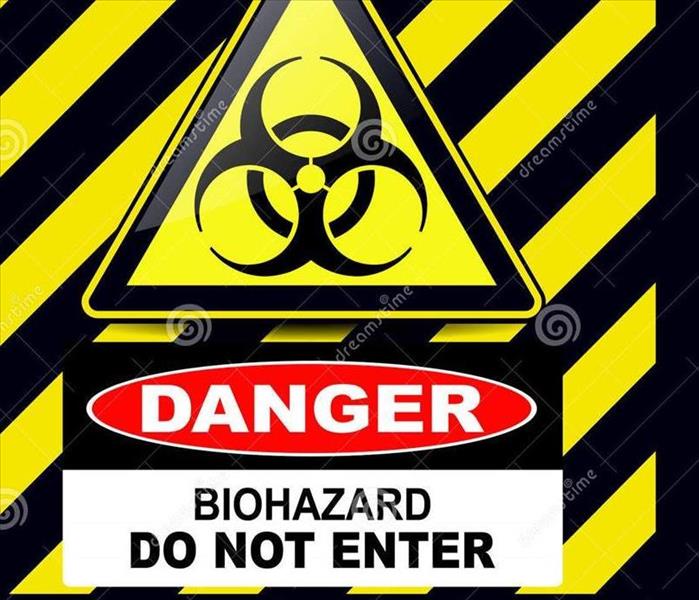 Crime scene cleanup and Biohazards....
Crime scene cleanup and Biohazards....
Crime scene cleanup is a term applied to cleanup of blood, bodily fluids, and other potentially infectious materials (OPIM). It is also referred to as biohazard remediation, because crime scenes are only a portion of the situations in which biohazard cleaning is needed. Such incidents may include accidents, suicides, homicides, and decomposition after unattended death. It could also include mass trauma, industrial accidents, infectious disease contamination, animal biohazards (e.g. feces or blood) or regulated waste transport, treatment, and disposal.
Television productions like CSI: Crime Scene Investigation have added to the popularity of the term "crime scene cleanup". Australia, Canada and England have added it to their professional cleaning terminology. As a profession, it is growing in popularity because of media exposure and the growth of training programs worldwide.The generic terms for "crime scene cleanup" include trauma cleaning, crime and trauma scene decontamination ("CTS Decon"), biohazard remediation, biohazard removal, blood cleanup and crime scene cleanup. The state of California refers to individuals who practice this profession as "Valid Trauma Scene Waste Management Practitioners".
Types of cleanups
Crime scene cleanup includes blood spills following an assault, homicide or suicide. There are many different sub-segments, named primarily after additional collateral, contingency, or preconditions, regarding the presence of non-blood borne organics, toxic irritants (e.g.,tear gas) or disease vectors. However, it is the legality of charging a fee for mitigating potentially harmful biohazard situations that differentiates a registered crime or trauma practitioner from any general restoration, carpet cleaning, janitorial or housekeeping service.
With concerns about Ebola contamination in the United States, crime scene cleanup companies like Cleaning Guys of Texas and Bio Recovery Corporation of New York have been contracted by government to clean more than just crime scenes.
Business
Crime scene cleanup began primarily as a local or regional small business activity but maturity and consolidation has created some larger entities in the industry; only a few nationwide companies exist, although some national carpet cleaning and restoration companies franchises have added crime scene cleanup and biohazard removal to their services. Due to the legal and ethical complications crime scene cleanup is often its own business entity or a separate division.
Regulatory requirements
While the field of crime scene cleanup is not specifically regulated as a class, most if not all of the activities performed by biohazard cleanup teams in the United States are regulated or fall under best practice guidelines from governing and advisory bodies such as OSHA, NIOSH, DOT, and EPA. Those who hire a crime scene cleanup company should make sure that they are properly trained in applicable federal and state regulations and can provide documentation of proper biohazardous waste disposal from licensed medical waste transportation and disposal companies. If in California or Florida the client should confirm that the company is registered with the state Department of Health. A few states such as California, New York and Florida are the only states that explicitly require registration or licensing for crime scene cleanup. Other states may require biohazardous waste transport permits from the DOT.
In the US, OSHA requires that exposure to blood-borne pathogens be limited as much as possible due to the assumption that the blood and biological material is infectious. Most actions taken to limit exposure fall under cross-contamination protocols, which provide that certain actions be taken to avoid further spreading the contamination throughout otherwise clean areas. CTS De-con companies should have in place, an exposure control plan before beginning work on any trauma scene. Under employee safety and cross-contamination protocols, the following OSHA regulations may pertain to bioremediation.
- OSHA29 CFR 1910.1030(g)(2)(ii)- Initial Assessment of Work: Must assess work site for potential hazards to employee safety. OSHA 29 CFR 1910.1200, et seq.- Hazard Communication Protocol: Required to establish what chemicals are used and that they are properly labeled.
- OSHA 29 CFR 1910.1030(d)(2)(i);29 CFR 1910.1030(e)(2)(iii); 29 CFR 1910.1030(d)(1); and 29, CFR 1926.1053 – Work Practice & Engineering Controls and Safety: Having done the initial assessment, must determine damage, potential hazards, equipment needs, egresses, work routes, possible complicating factors, ladder/scaffolding safety protocols, availability for hand-washing/sanitization wipes.
- OSHA 29 CFR 1910.1030(d)(1) – Method of Compliance: Ensure employees are following all OSHA-mandated engineering and work practice controls through proper supervision, written documentation and photographs.
- OSHA 29 CFR 1910.1030(c)(2) – Exposure Determination: Determine employee safety concerns due to exposure to biological materials.
- OSHA 29 CFR 1910.1030(g)(1) – Hazard Signs and Labels: Hazardous areas must be demarcated; use of biohazard tape and establishment of zones separates and identifies hazardous areas.
In the UK, biohazards are regulated in part by HSE. Canada has published Canadian Biosafety Standards and Guidelines.
Methods
The crime scene cleaners' work begins when the coroner's office or other official, government body releases the "scene" to the owner or other responsible parties. Only when the investigation has completely terminated on the contaminated scene may the cleaning companies begin their task.
Standard operating procedures for the crime scene cleanup field often include military-like methods for the decontamination of internal and external environments. Universal precautions recognized worldwide are the cautionary rule-of-thumb for this field of professional cleaning.
Cleaning methods for removing and sanitizing biohazards vary from practitioner to practitioner. Some organizations are working to create a "Standard of Clean" such as ISSA's K12 Standard, Which includes use of quantifiable testing methods such as ATP testing.
Organizations
The first specialty trade organization for this field of cleaning was the American Bio-Recovery Association (ABRA). The largest association dedicated to the crime scene cleanup industry is the National Crime Scene Cleanup Association (NCSCA). Among other tasks, they organized cleanup procedures for Ebola decontamination in 2014. Clean Trust (aka IICRC) is a certifying body for the cleaning trade in general. International Sanitary Supply Association (ISSA) is a global standards body and trade organization of professional janitorial and cleaning professionals.
In popular culture and the media
Crime scene cleanup as a profession has been featured sporadically in popular culture and the media. It first showed up in films when Quentin Tarantino produced Curdled, then after an eleven-year hiatus in the Samuel L. Jackson film Cleaner, and more recently when Amy Adams and Emily Blunt teamed up for Sunshine Cleaning. On television it has been featured in a smattering of documentaries aired on the National Geographic Channel and the Discovery Channel, as well as reality series such as Grim Sweepers.
In video games and visual media, crime scene cleanup takes center focus as the main objective in the game, Viscera Cleanup Detail.Viscera Cleanup Detail is a PC game distributed through Steam that enables players to clean up blood and body remains after a Sci-Fi battle has occurred on a space station. Another example of crime scene cleanup in video games is Safeguard. Safeguard takes a more realistic and educational approach, enabling users to learn about the hazards of crime scene cleanup, as well as the equipment and tools used. Safeguard also uses virtual reality to immerse users in the crime scene environment.
Do You Have a Fire or Smoke Damage in Your Property? Have A Professional Company Handle The Process Of Fire Restoration.
5/2/2017 (Permalink)
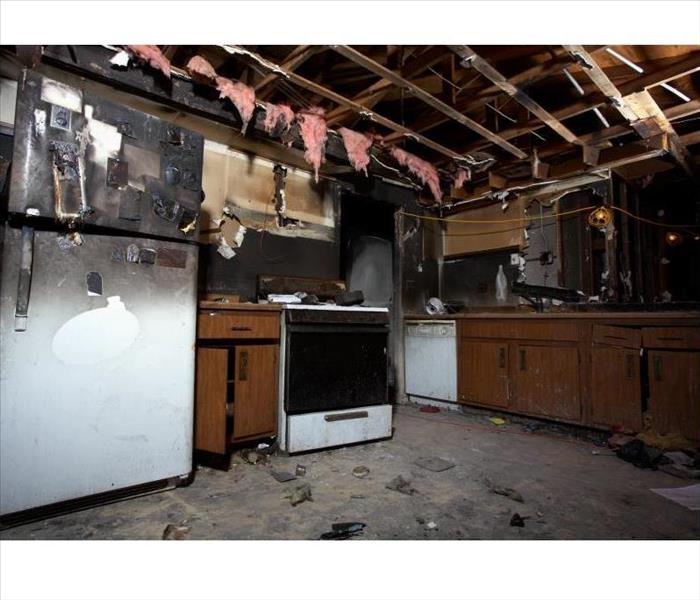 Do You Have a Fire or Smoke Damage in Your Property? Have A Professional Company Handle The Process Of Fire Restoration.
Do You Have a Fire or Smoke Damage in Your Property? Have A Professional Company Handle The Process Of Fire Restoration.
Do You Have a Fire or Smoke Damage in Your Property? Have A Professional Company Handle The Process Of Fire Restoration.
The process of fire restoration can be very involved. Private homeowners and companies can oftentimes be devastated by the damage caused by this kind of event. One aspect that gives peace of mind involves knowing when the right professional has been hired. That is one of the reasons why it is important to hire a firm that is associated with the Institute of Inspection Cleaning and Restoration Certification.
Homeowners and business owners may be in shock from the initial devastation. It is important to try and follow the proper steps to achieve a complete fire restoration. Service providers that are associated with the Institute will have the following distinctions: current training, safety and health certifications, vast amounts of experience in restoration projects and the proper licenses and insurance information. Customers should also check all references and obtain price quotes prior to hiring anyone. Any contracts that are presented should be reviewed closely.
The first step in the process is to clean up as much of the existing area as possible. If the area is not immediately cleaned, soot residue and permanent damage can be left behind. If the homeowner or business owner does the initial cleaning, it is important to follow these steps. When cleaning, always use dust masks and open the area for proper ventilation. Clean from the ceilings to the floors and vacuum all floors and upholstery. Wash any items that are able to be laundered. Clean the outside with a pressure washer if available.
If immediate clean up is not done, it can lead to devastating effects. Within minutes of fire and smoke damage, appliances and many items will discolor to a yellow hue. After a few hours, acid will stain bathrooms and many other areas of the home or business. Within days, walls will discolor permanently and items will begin to rust due to the acid residue. Finally, after weeks the cost of clean-up will become substantially more expensive. The building and furnishings can be permanently damaged by the acid left behind. Soot residue will be layered throughout the home or business. For these reasons, it is vital to contact a professional associated with the Institute of Inspection Cleaning and Restoration Certification to utilize fire restoration techniques in an effort to return the home or business to a preloss state. One company or service provider should be able to handle the damage. The seal of Certification by the Institute should be shown on any provider’s website. This shows the customer the reliability and the expertise of the service provider.
Residue and smoky odors need to be removed immediately. Professionals will use the process of fire restoration to achieve satisfactory results. These providers will remove the source of the odor, clean any items that can be salvaged, get rid of any lingering odor with an odor counteractant and deodorizing fog. Finally, the provider will seal salvageable items to encapsulate odor and prevent further recontamination.
Homeowners and businesses that are educated in the fire restoration process are able to minimize the cost of repair. Professionals can be contacted in a timely manner to return the area to a preloss state. By hiring the right professionals the victims can have some peace of mind during a very stressful time.
Property Damage claims Soft goods and Apparel...Yes, SERVPRO Can clean Both!
4/27/2017 (Permalink)
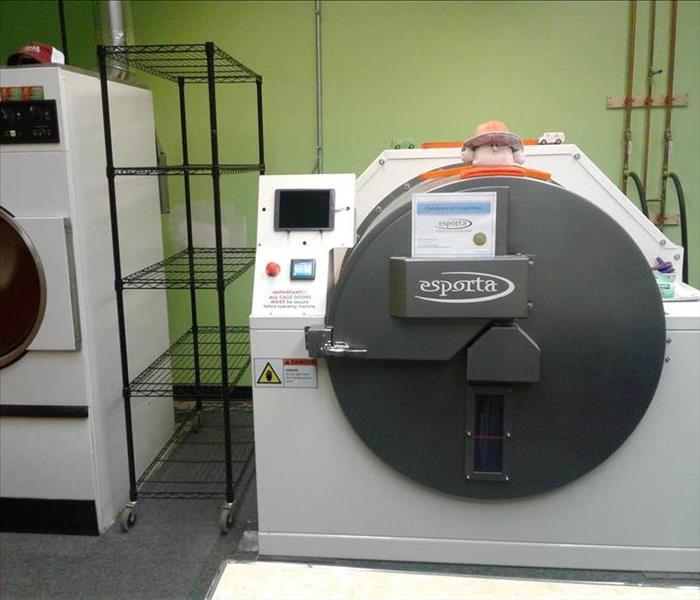 Property Damage claims Soft goods and Apparel...Yes, SERVPRO Can clean Both!
Property Damage claims Soft goods and Apparel...Yes, SERVPRO Can clean Both!
2016 Xactimate claim data shows that there are more soft contents and clothing than all other contents on property claims by a long shot. See the full video report here: https://lnkd.in/gAeVMhQ
The Esporta Certified Operator cleans twice as much as restoration dry cleaners. With our game-changing technology, you’ll never need to send soft contents to a dry cleaners again. Eliminate the competition from dry cleaners and make more money.
Esporta Certified Operators restore smoke, soot, and water impacted soft contents using the patented Esporta® Wash System. Traditional restoration companies and restoration dry cleaners typically consider much of these items non-restorable and they end up in a landfill.
The Esporta Certified Operators cleans twice as much as restoration dry cleaners. With our game-changing technology, you’ll never need to send soft contents to a dry cleaners again. Eliminate the competition from dry cleaners and make more money.
Esporta Certified Operators restore smoke, soot, and water impacted soft contents using the patented Esporta® Wash System. Traditional restoration companies and restoration dry cleaners typically consider much of these items non-restorable and they end up in a landfill. By choosing an Esporta Certified Operator, you can make a big difference. When textiles are sent to the landfill, it leaves the fabric dyes and chemicals to leach into the soil, contaminating both surface and groundwater.
The Esporta Certified Operators provide an unparalleled competitive advantage. Using washing technology & detergents more advanced than any other products in the market, our technology cleans 90% of soft contents that would be considered irrecoverable using any other cleaning method.
What makes the Esporta Certified Operators so unique is that it is the only process with scientific validation to support it's ability to remove the bacterial contamination found in flood affected goods. The use of standardized wash programs with proprietary detergents and disinfectants assure consistent decontamination. No other washing technology has been able to make this claim.
Water Damage in Your Property?
4/26/2017 (Permalink)
Water damage describes a large number of possible losses caused by water intruding where it will enable attack of a material or system by destructive processes such as rotting of wood, growth, rusting of steel, de-laminating of materials such as plywood, and many others.
The damage may be imperceptibly slow and minor such as water spots that could eventually mar a surface, or it may be instantaneous and catastrophic such as flooding. However fast it occurs, water damage is a major contributor to loss of property.
An insurance policy may or may not cover the costs associated with water damage and the process of water damage restoration. While a common cause of residential water damage is often the failure of a sump pump, many homeowner's insurance policies do not cover the associated costs without an addendum which adds to the monthly premium of the policy. Often the verbiage of this addendum is similar to "Sewer and Drain Coverage".
Those individuals who are affected by wide scale flooding may have the ability to apply for government and FEMA grants through the Individual Assistance program. On a larger level, businesses, cities, and communities can apply to the FEMA Public Assistance program for funds to assist after a large flood. For example, the city of Fond du Lac Wisconsin received $1.2 million FEMA grant after flooding in June 2008. The program allows the city to purchase the water damaged properties, demolish the structures, and turn the properties into public green space.
Causes
Water damage can originate by different sources such as a broken dishwasher hose, a washing machine overflow, a dishwasher leakage, broken/leaking pipes, and clogged toilets. According to the Environmental Protection Agency, 13.7% of all water used in the home today can be attributed to plumbing leaks.[3] On average that is approximately 10,000 gallons of water per year wasted by leaks for each US home. A tiny, 1/8-inch crack in a pipe can release up to 250 gallons of water a day.[4]According to Claims Magazine in August 2000, broken water pipes ranked second to hurricanes in terms of both the number of homes damaged and the amount of claims (on average $50,000 per insurance claim costs in the US. Experts suggest that homeowners inspect and replace worn pipe fittings and hose connections to all household appliances that use water at least once a year. This includes washing machines, dishwashers, kitchen sinks and bathroom lavatories, refrigerator ice makers, water softeners and humidifiers. A few US companies offer whole-house leak protection systems utilizing flow-based technologies. A number of insurance companies offer policy holders reduced rates for installing a whole-house leak protection system.
As far as insurance coverage is concerned, most damage caused by bad weather is considered flood damage and normally is not covered under homeowners insurance. Coverage for bad weather would usually require flood insurance.
Categories
Category 1 Water - Refers to a source of water that does not pose substantial threat to humans and classified as "clean water". Examples are broken water supply lines, tub or sink overflows or appliance malfunctions that involves water supply lines.
Category 2 Water - Refers to a source of water that contains a significant degree of chemical, biological or physical contaminants and causes discomfort or sickness when consumed or even exposed to. Known as "grey water". This type carries micro organisms and nutrients of micro organisms. Examples are toilet bowls with urine (no feces), sump pump failures, seepage due to hydrostatic failure and water discharge from dishwashers or washing machines.
Category 3 Water - Known as "black water" and is grossly unsanitary. This water contains unsanitary agents, harmful bacteria and fungi, causing severe discomfort or sickness. Type 3 category are contaminated water sources that affects the indoor environment. This category includes water sources from sewage, seawater, rising water from rivers or streams, ground surface water or standing water. Category 2 Water or Grey Water that is not promptly removed from the structure and or have remained stagnant may be re classified as Category 3 Water. Toilet back flows that originates from beyond the toilet trap is considered black water contamination regardless of visible content or color.
Classes
Class of water damage is determined by the probable rate of evaporation based on the type of materials affected, or wet, in the room or space that was flooded. Determining the class of water damage is an important first step, and will determine the amount and type of equipment utilized to dry-down the structure.[7]
Class 1 - Slow Rate of Evaporation. Affects only a portion of a room. Materials have a low permeance/porosity. Minimum moisture is absorbed by the materials.
Class 2 - Fast Rate of Evaporation. Water affects the entire room of carpet and cushion. May have wicked up the walls, but not more than 24 inches.
Class 3 - Fastest Rate of Evaporation. Water generally comes from overhead, affecting the entire area; walls, ceilings, insulation, carpet, cushion, etc.
Class 4 - Specialty Drying Situations. Involves materials with a very low permeance/porosity, such as hardwood floors, concrete, crawlspaces, plaster, etc. Drying generally requires very low specific humidity to accomplish drying.
Restoration
See also: Convectant drying
Different removal methods and measures are used depending on the category of water. Due to the destructive nature of water, chosen restoration methods also depend heavily on the amount of water, and on the amount of time the water has remained stagnant. For example, as long as carpet has not been wet for longer than 48 hours, and the water involved was not sewage based, a carpet can usually be saved; however, if the water has soaked for longer, then the carpet is probably irreparable and will have to be replaced.[8] Water damage restoration can be performed by property management teams, building maintenance personnel, or by the homeowners themselves; however, contacting a certified professional water damage restoration specialist is often regarded as the safest way to restore water damaged property.
Standards and regulation
While there are currently no government regulations in the United States dictating procedures, two certifying bodies, the Institute of Inspection Cleaning and Restoration Certification (IICRC) and the RIA, do recommend standards of care. The IICRC-recommended standard is IICRC S500.
Fire and Water Restoration companies are regulated by the appropriate state's Department of Consumer Affairs - usually the state contractors license board. In California, all Fire and Water Restoration companies must register with the California Contractors State License Board.[10] Presently, the California Contractors State License Board has no specific classification for "water and fire damage restoration."
Procedures
Water damage restoration is often prefaced by a loss assessment and evaluation of affected materials. The damaged area is inspected with water sensing equipment such as probes and other infrared tools in order to determine the source of the damage and possible extent of area affected. Restoration services would then be rendered to the residence in order to dry the structure, sanitize any affected or cross contaminated areas, and deodorize all affected areas and materials. After the labor is completed, water damage equipment including air movers, air scrubbers, dehumidifiers, wood floor drying systems, and sub floor drying equipment is left in the residence. Industry standards state that drying vendors should return at regular time intervals, preferably every twenty-four hours, to monitor the equipment, temperature, humidity, and moisture content of the affected walls and contents.
Termites can cause severe damage to Properties
4/25/2017 (Permalink)
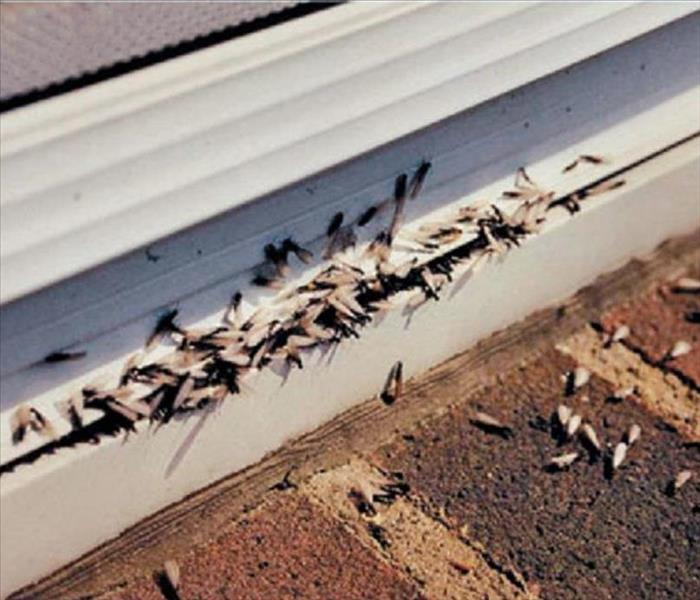 Termites can cause severe damage to Properties
Termites can cause severe damage to Properties
Termites can cause severe damage to Properties
Although termites are ecologically beneficial in that they break down detritus to add nutrients to soil, the same feeding behaviors that prove helpful to the ecosystem can cause severe damage to human homes. Because termites feed primarily on wood, they are capable of compromising the strength and safety of an infested structure. Termite damage can render structures unlivable until expensive repairs are conducted.
Structural property damage
Properties constructed primarily of wood are not the only structures threatened by termite activity. Properties made from other materials may also host termite infestations, as these insects are capable of traversing through plaster, metal siding and more. Termites then feed on cabinets, floors, ceilings and wooden furniture within these homes.
Because termites are often not identified before considerable damage has occurred, it is advised that homeowners experiencing a termite infestation contact a pest control professional before attempting to address the problem on their own. Professionals will conduct an inspection in order to correctly identify the problem and will then discuss possible avenues of treatment with homeowners.
Signs of subterranean termite damage
Subterranean termites dwell underground in loose, damp soil. Although subterranean termite species in Africa are famously aggressive and known for the obvious mounds above their colonies, signs of subterranean termite damage within the United States are much less obvious.
Interior damage may not become apparent until infestations are full-blown. Termite damage sometimes appears similar to water damage. Outward signs of termite damage include buckling wood, swollen floors and ceilings, areas that appear to be suffering from slight water damage and visible mazes within walls or furniture. Termite infestations also can exude a scent similar to mildew or mold.
Subterranean termites also access above-ground food sources through mud tunnels they create from saliva, mud and feces. These tunnels are located near the foundation of infested homes.
Signs of drywood termite damage
Drywood termites build their colonies within wooden structures on which they feed. They can be found inside of walls or furniture. Drywood termite infestations may only become apparent after a colony has burrowed so deeply into an infested item that the veneer cracks and the maze-like tunnels beneath become visible. Such damage is common in antique furniture pieces. Should this occur on new furniture or the floors or walls of your home, contact a professional to discuss the severity of your infestation, as well as prevention and treatment options.
- Get rid of dead trees and stumps around your yard. Decaying wood is top food source for termites and can attract a colony of hungry termites. [5]If you keep a lot of firewood or spare construction materials on hand, keep them as far away from your house as possible. If you bring this wood into your house, make sure to look for signs of termite presence like holes in the wood or hollowed feeling or sound.
Inspect common termite entry points. The most common way they get into your house is through wood to ground contact, such as a door frame, deck posts, or wood support beams. Address these spots by examining them for signs of termites regularly, get rid of any standing water in the area, and treat the wood with termite prevention like soil treatments that repel termites.
- Avoid spreading mulch too close to your home. You can have mulch in your home but you'll want to avoid putting it anywhere that it may touch your siding or foundation. Mulch creates moisture in the soil and prevents woods from growing, both conditions termites seek. This also includes your plants. Woody shrubs that touch the wood foundation or siding of your house can help attract termites and also help hide their presence.
Install termite shields. This can be especially helpful if you are currently constructing a home. These are metal shields put along the foundation of your home to deter termites. These should be made of a non-corroding metal with no gaps. This can prevent termites from getting access to the wood foundations or structures of your home.
Jon Barrett
Marketing and Sales Support
SERVPRO of Cherry Hill/Haddonfield
Phone: (856) 662-2772
Email: JBarrett@SP9157.com
Websites:
http://www.SERVPROcherryhillhaddonfield.com/
http://www.SERVPROmtlaurelmoorestown.com/
The Most Common Causes of House Fires
4/21/2017 (Permalink)
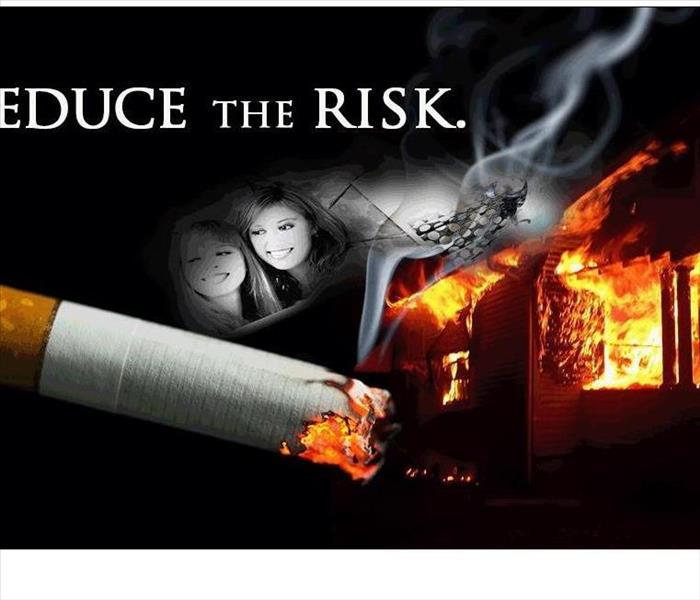 The Most Common Causes of House Fires
The Most Common Causes of House Fires
The Most Common Causes of House Fires
A house can easily catch fire from the misuse of appliances and heating equipment to smoking in bedrooms.
1. Cooking Equipment
Pots and pans can overheat and cause a fire very easily if the person cooking gets distracted and leaves cooking unattended. Always stay in the room, or ask someone to watch your food, when cooking on hotplates.
2. Heating
Keep portable heaters at least one metre away from anything that could easily catch fire such as furniture, curtains, laundry, clothes and even yourself. If you have a furnace, get it inspected once a year to make sure it is working to safety standards.
3. Smoking in bedrooms
Bedrooms are best to be kept off limits for smoking. A cigarette that is not put out properly can cause a flame, as the butt may stay alit for a few hours. It could burst into flames if it came into contact with flammable materials, such as furniture. Did you know that fires started in the bedroom or lounge make up 73% of all house fire fatalities?¹
4. Electrical Equipment
An electrical appliance, such as a toaster can start a fire if it is faulty or has a frayed cord. A power point that is overloaded with double adapter plugs can cause a fire from an overuse of electricity. A power point extension cord can also be a fire hazard if not used appropriately. Double check the appliances and power points in your home.
5. Candles
Candles look and smell pretty, but if left unattended they can cause a room to easily burst into flames. Keep candles away from any obviously flammable items such as books and tissue boxes. Always blow a candle out before leaving a room. Did you know that in Perth last year 34 house fires started as a result of candles?²
6. Curious Children
Kids can cause a fire out of curiosity, to see what would happen if they set fire to an object. Keep any matches or lighters out of reach of children, to avoid any curiosity turned disaster. Install a smoke alarm in your child’s room and practice a home escape plan with your children and family in case there was a fire. Teach kids understand the “stop, drop, cover and roll” drill as well as knowing their address if they needed to call 000.
7. Faulty Wiring
Homes with inadequate wiring can cause fires from electrical hazards. Some signs to see if you’ve bad wiring are: 1) Lights dim if you use another appliance; 2) For an appliance to work, you have to disconnect another; 3) Fuses blow or trip the circuit frequently. Have a licenced electrician come and inspect you house, or contact your landlord if you have any of the above occurrences.
8. Barbeques
Barbecues are great for an outdoor meal, but should always be used away from the home, tablecloths or any plants and tree branches. Keep BBQs regularly maintained and cleaned with soapy water and clean any removable parts. Check the gas bottle for any leaks before you use it each time.
9. Flammable Liquids
If you have any flammable liquids in the home or garage such as petrol, kerosene or methylated spirits, keep them away from heat sources and check the label before storing. Be careful when pouring these liquids.
10. Lighting
Lamp shades and light fittings can build up heat if they are very close to light globes. Check around the house to make sure. Lamp bases can become a hazard if they are able to be knocked over easily, and so should be removed if they are. Check that down lights are insulated from wood panelling or ceiling timbers.
The above tips are a good guide to avoiding a fire in your home. However it’s a good idea to protect yourself with adequate property insurance, cover to ensure you are covered in the unlikely event a fire were to happen.
Jon Barrett
Marketing and Sales Support
SERVPRO of Cherry Hill/Haddonfield
Phone: (856) 662-2772
Email: JBarrett@SP9157.com
Website:
http://www.SERVPROcherryhillhaddonfield.com/
Stucco Remediation – What You Should Know
4/20/2017 (Permalink)
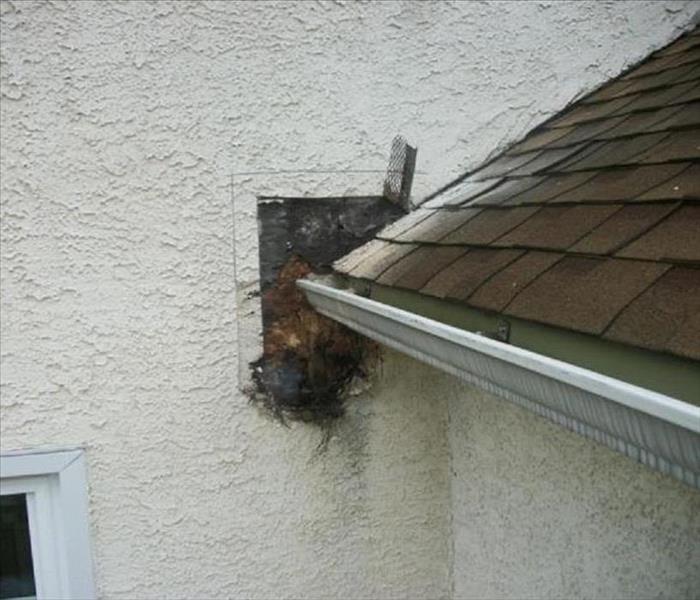 Stucco Remediation – What You Should Know
Stucco Remediation – What You Should Know
Stucco Remediation – What You Should Know
Every home, no matter when it was built or when you purchased it, can fall prey to stucco failure, mold and moisture contamination. Even the tiniest of cracks in the façade of your home can result in moisture coming in, which can then cause major problems. If that happens, it can threaten the very structure of your home as well as the health of your family. If it isn’t treated properly, mold can cause extensive and costly damage.
Signs that you need repairs include cracking or breaking in the façade of your home, or brown streaks below your windows or at intersection of the wall and roof. Inside, you’ll notice leaks in doors or windows, the bottoms of your windows may be discolored, your base trim can become warped and there may be wet carpet or a moldy smell in your home.
But did you know your stucco doesn’t even have to be cracked to have problems? Heller explains that it wasn’t until fairly recently that proper weep screens and break points in the stucco were required. That means walls may not breathe properly, which can allow moisture to build up and then be trapped.
That’s just one of the many reasons it is important to call your building contractor to inspect your home for damage. The contractor may be able to find problems that you never even knew existed and stop a problem before it becomes too big and costly.
The process of repairing the stucco is referred to as stucco remediation. Your first instinct may be to simply call a stucco company to repair the façade of your home, but that might not be the right thing to do.
Companies that are stucco only will have the know-how to remove and replace the existing façade of your home.
While this is important, it may simply cover up the effects caused by the moisture. The structural integrity of your home and the health of your family can still be in jeopardy if the underlying problems still exist.
Simply put, a stucco repair company could lack the knowledge and ability to identify and repair the problems that result from the water damage. And if they aren’t properly corrected, that can lead to even more damage and expense in the future.
Moisture intrusion most often affects stucco-clad homes, but can also affect homes made of brick, stone, wood or composite siding, and typically affects homes built between 1985 and 2003. Having the right person inspect your home for damage is crucial to find and repair problems to the home’s wood structure that aren’t visible to the eye. Rot and mold within the wall cavity can cause serious damage.
If you think your home may have fallen prey to moisture intrusion, then please give SERVPRO of Cherry Hill NJ a call...
Septic or Sewer System Backs Up Into Your Property or Building...Here are SAFETY Tips!
4/19/2017 (Permalink)
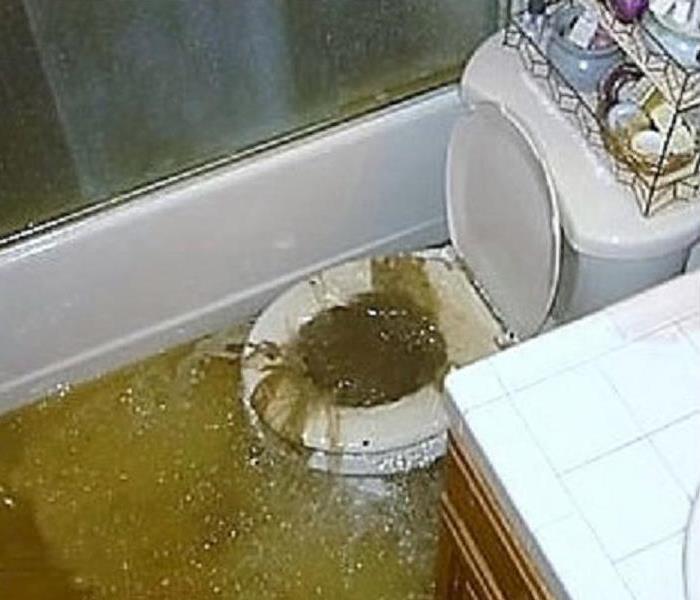 Septic or Sewer System Backs Up Into Your Property or Building...Here are SAFETY Tips!
Septic or Sewer System Backs Up Into Your Property or Building...Here are SAFETY Tips!
Watch out: sewage spills contain contaminants that can cause serious illness or disease. Disease causing agents in raw sewage include bacteria, fungi, parasites, and viruses and can cause serious illnesses including Hepatitis A.
If a building has been flooded by sewage or wastewater there may be unsafe electrical wiring, bacterial and pathogen hazards, mold hazards, even unsafe mechanical systems.
- Turn off electrical power in the area that has been flooded if there is any chance of electrical wires, extension cords, or electrical appliances or fixtures coming in contact with standing water or wet materials
- Vacate sewage-contaminated areas right away. Areas of sewage spill should not be occupied by people who are not wearing appropriate protective equipment as they are dangerous:
- Stop flushing toilets
- Turn off running water that is sending water into the drain system (clothes washer, sinks etc)
If the sewage or wastewater are being spread by water from a burst plumbing supply or hot water heating pipe, turn off the water to the building and if needed for safety or to stop further you may also need to turn off the (hot water or steam) heating system.
Items that have been soaked and are not salvageable may best be placed outdoors. By removing wet and contaminated materials from the building it may be easier to inspect, repair leaks, and clean the building itself.
Watch out: do not handle sewage-contaminated materials without proper personal safety protection: there are bacterial, pathogenic, respiratory and infection hazards.
- Act promptly.
- Watch out: The longer that sewage waters remain in a building or on its contents the greater the chance of spreading illness or disease and the greater the chance of causing a costly mold contamination problem in addition to the sewage problem. High indoor moisture caused by standing water can cause mold contamination to form on other building surfaces even if they were not directly wet by the sewage spill.
- Don't panic: while prompt action is needed as we just explained, don't be in such a rush that you do something dangerous. Also, if you sound terrified when calling a contractor for assistance the result may be the imposition of inappropriate or costly steps.
- Call a professional water damage restoration authority - For other than a trivial spill on a tiled bathroom floor you may need help from a professional water damage or restoration company.
- Notify your insurance company that there has been a sewage spill in the building
- Notify your municipal authority or sewer department if your home is connected to a public sewer
- Contact your local health department for advice if your home is connected to a private septic system
Jon Barrett
Marketing and Sales Support
SERVPRO of Cherry Hill/Haddonfield
Phone: (856) 662-2772
Email: JBarrett@SP9157.com
Websites:
http://www.SERVPROcherryhillhaddonfield.com/
http://www.SERVPROmtlaurelmoorestown.com/
Refrigerator Water Line and Drain Hose Leaks...Prevention Tips!
4/13/2017 (Permalink)
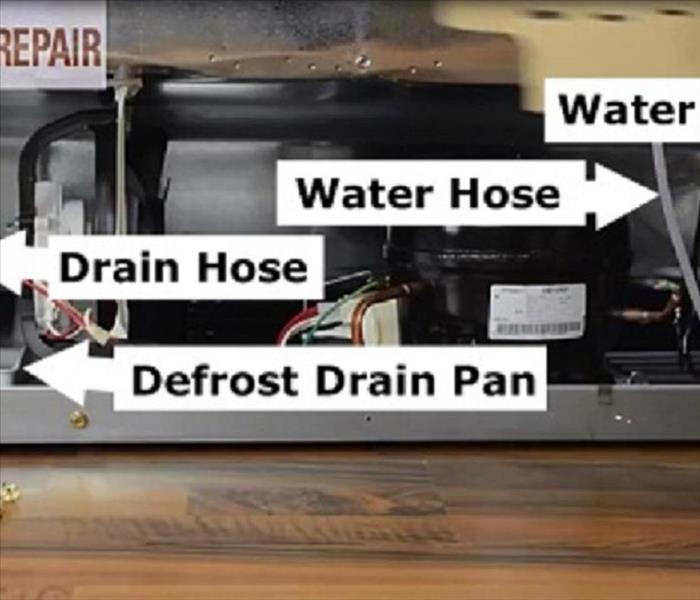 Refrigerator Water Line and Drain Hose Leaks...Prevention Tips!
Refrigerator Water Line and Drain Hose Leaks...Prevention Tips!
Refrigerator Water Line Leaks, Prevention Tips!
The refrigerator is one of the hardest working appliances around the home, so when one breaks down or suffers a leak, the experience can have consequences. If you find that your fridge’s water line has a leak, there are a few simple steps you can follow to troubleshoot the problem and have it running again in no time.
What To Do When Your Refrigerator Water Line Leaks
The first step is to identify the leak. The refrigerator water line connects the household water supply to a refrigerator with an ice maker or water dispenser. The water line typically runs at the back of the fridge. Once the leak has been identified, here is what you can do to fix the problem.
- Turn off the valve that supplies water to the refrigerator and then unplug the refrigerator to turn off the appliance. You will likely find the water shut off valve located beneath the kitchen sink or in some cases, behind the refrigerator itself.
If the valve is located behind the fridge, carefully pull the appliance away from the wall and turn off the valve.
You will now have to loosen the compression nut that secures the supply line to the water intake valve. This can be done with the assistance of an adjustable wrench by turning the nut counter clockwise and then disconnecting the supply line.
Once loosened, remove the compression nut to disconnect the supply line from the valve.
If the supply line is broken or torn in places, replace the old line with a new one making sure that its length and dimensions are the same as the original water line. Material choices range between copper, plastic and stainless steel water lines.
- To fix the new water line in place, thread one end of the supply line to the shut off valve under the sink and tighten until it is snug in place. When using a copper or plastic line, make sure to first slide on a compression nut secured with a compression sleeve or ring onto the end of the line. A stainless steel water line comes with a built in rubber gasket that stops the connection from leaking.
- Thread the other end of the supply line to the water intake valve and tighten it until snug.
- Turn on water and check for any leaks. If there is still a drip, tighten the nuts a bit more.
Purchasing a new water line
When the line is badly damaged and needs replacement there are a few things to keep in mind. For instance, one of the factors at this point would be to choose a line material that will offer durability and long lasting utility. Another is the price tag attached to the new purchase.
Plastic water lines
In terms of materials, plastic lines are the most cost effective but also least durable. The biggest threat lies in these lines cracking, clogging or leaking, causing water damage. While plastic lines may seem to work well in terms of flexibility, especially where space behind the fridge is tight, many people do not prefer this type of line material.
Copper water lines
Another option is to go with copper water lines that yield superior sturdiness but are also more prone to kinkiness. A more flexible version of copper lines is available to allow pushing the tubing into position giving it some flexibility to work well in cramped spaces.
Stainless steel water lines
As an alternative stainless steel braided lines can be considered. Braided steel is a tough, non-kinking option to the more pliable plastic and the ¼ in flexible copper lines. Stainless steel also happens to be the most durable option but will tend to be the most expensive as well.
Whether the leak in your refrigerator water line is caused by a plastic, copper or stainless steel water line, remember that you can always access the professional service of our experts at Tidal Wave in Atlanta to come and resolve all water damage concerns at your home.
Jon Barrett
Marketing and Sales Support
SERVPRO of Cherry Hill/Haddonfield
Phone: (856) 662-2772
Email: JBarrett@SP9157.com
Websites:
http://www.SERVPROcherryhillhaddonfield.com/
http://www.SERVPROmtlaurelmoorestown.com/
fire stats
1/24/2017 (Permalink)
 fire
fire
Fires in the U.S.
In 2015, there were 1,345,500 fires reported in the United States. These fires caused 3,280 civilian deaths, 15,700 civilian injuries, and $14.3 billion in property damage.
- 501,500 were structure fires, causing 2,685 civilian deaths, 13,000 civilian injuries, and $10.3 billion in property damage.
- 204,500 were vehicle fires, causing 500 civilian fire deaths, 1,875 civilian fire injuries, and $1.8 billion in property damage.
- 639,500 were outside and other fires, causing 95 civilian fire deaths, 825 civilian fire injuries, and $252 million in property damage.
The 2015 U.S. fire loss clock a fire department responded to a fire every 23 seconds. One structure fire was reported every 63 seconds.
- One home structure fire was reported every 86 seconds.
- One civilian fire injury was reported every 34 minutes.
- One civilian fire death occurred every 2 hours and 40 minutes.
- One outside and other fire was reported every 52 seconds.
- One highway vehicle fire was reported every 3 minutes 1 seconds.
fire stats
1/24/2017 (Permalink)
 house on fire
house on fire
Fires in the U.S.
In 2015, there were 1,345,500 fires reported in the United States. These fires caused 3,280 civilian deaths, 15,700 civilian injuries, and $14.3 billion in property damage.
- 501,500 were structure fires, causing 2,685 civilian deaths, 13,000 civilian injuries, and $10.3 billion in property damage.
- 204,500 were vehicle fires, causing 500 civilian fire deaths, 1,875 civilian fire injuries, and $1.8 billion in property damage.
- 639,500 were outside and other fires, causing 95 civilian fire deaths, 825 civilian fire injuries, and $252 million in property damage.
The 2015 U.S. fire loss clock a fire department responded to a fire every 23 seconds. One structure fire was reported every 63 seconds.
- One home structure fire was reported every 86 seconds.
- One civilian fire injury was reported every 34 minutes.
- One civilian fire death occurred every 2 hours and 40 minutes.
- One outside and other fire was reported every 52 seconds.
- One highway vehicle fire was reported every 3 minutes 1 seconds.
Fire clean up
1/23/2017 (Permalink)
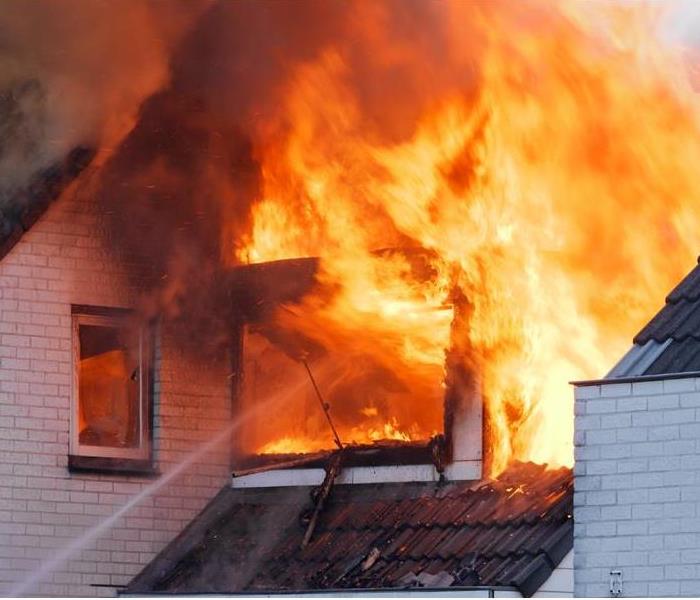 fire damge
fire damge
Fire can cause large amounts of damage on your property. However, there are other damages that can seriously affect the building as well. Smoke odor invades building materials and personal belongings of every kind. Smoke soot damages walls that have not been burned by flames. Experiencing a fire can be devastating, and SERVPRO understands that your cherished possessions and memories are at stake. As fire restoration experts, we specialize in soot and smoke damage as well.
If your home is damaged by fire, it is critical to contact a company that specializes in the fire and smoke restoration process as soon as possible to prevent additional damage. Your local SERVPRO is available 24/7 to help minimize the cost of fire and smoke damage to your home.
Our fire restoration process includes:
- 24/7 emergency services – onsite and assisting you within hours
- Prompt damage assessment, pretesting and estimates
- Emergency board-up and structural stabilization
- Environmentally friendly methods for cleaning soot and other residue from fire damage
- Smoke odor removal, sanitation and air purification
- Careful removal and securing of damaged household goods, personal possessions and other contents for cleaning and restoration
- Industrial grade water extractors, dehumidifiers, air movers and other equipment used to efficiently remove water resulting from fire extinguishing efforts
- Reconstruction of the affected areas
- Disinfectants and antimicrobials used to prevent mold and mildew
Why Trust SERVPRO
We will get your property back to normal faster. Our specialized training, cleaning methods and equipment combined with our experience means quicker clean up and lower smoke damage restoration costs. We can save your personal possessions using specialized equipment and cleaning methods, often being able to restore the contents of your home to their prior condition. We will assist with the insurance claims process to make it as painless as possible for you.
Mold in Basement
1/20/2017 (Permalink)
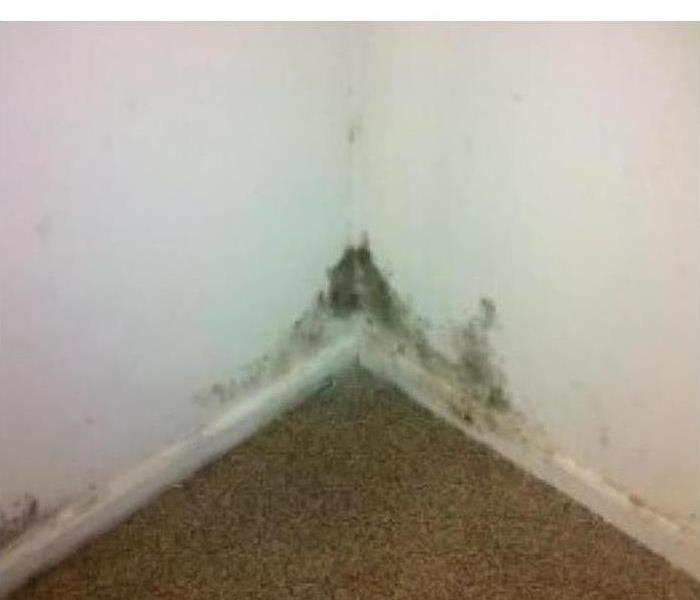 mold in corner
mold in corner
Mold and Your Health
Exposure to damp and moldy environments may cause a variety of health effects, or none at all. Areas that are likely to have mold, such as compost piles, cut grass, and wooded areas.
Molds are part of the natural environment. Outdoors, molds play a part in nature by breaking down dead organic matter such as fallen leaves and dead trees, but indoors, mold growth should be avoided. Molds reproduce by means of tiny spores; the spores are invisible to the naked eye and float through outdoor and indoor air. Mold may begin growing indoors when mold spores land on surfaces that are wet. There are many types of mold, and none of them will grow without water or moisture.
The key to mold control is moisture control. If mold is a problem in your home, you should clean up the mold promptly and fix the water problem.
It is important to dry water-damaged areas and items within 24-48 hours to prevent mold growth.
Molds gradually destroy the things they grow on. You can prevent damage to your home and furnishings, save money, and avoid potential health problems by controlling moisture and eliminating mold growth.
chimney fires
1/19/2017 (Permalink)
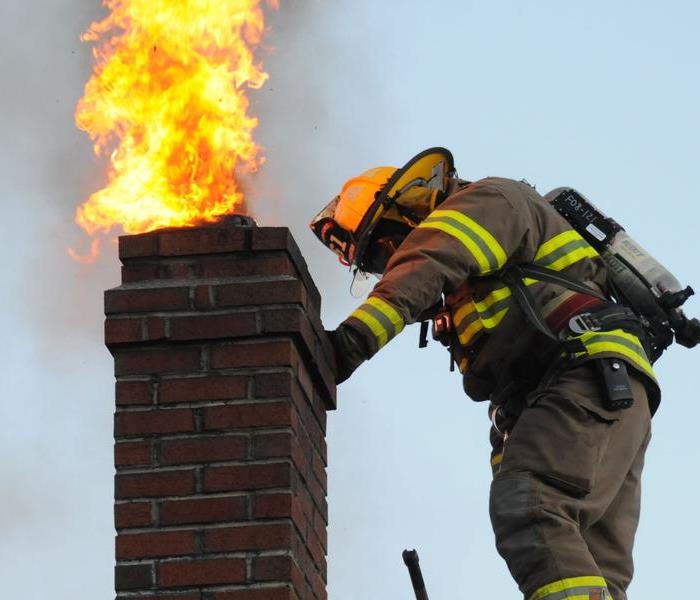 chimney fire
chimney fire
No One Welcomes a Chimney Fire
A chimney fire in action can be impressive. Indications of a chimney fire have been described as creating:
- loud cracking and popping noise
- a lot of dense smoke, and
- an intense, hot smell
Chimney fires can burn explosively – noisy and dramatic enough to be detected by neighbors or people passing by. Flames or dense smoke may shoot from the top of the chimney. Homeowners report being startled by a low rumbling sound that reminds them of a freight train or a low flying airplane. However, those are only the chimney fires you know about.
flood
1/18/2017 (Permalink)
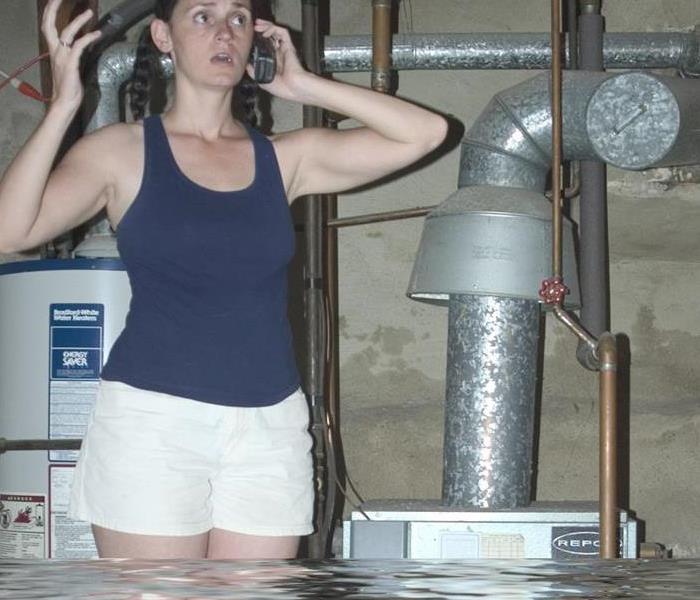 flood
flood
- Floods are the #1 natural disaster in the United States.
- From 2011 to 2015, the average flood claim amounted to more than $46,000.
- From 2006 through 2015, total flood insurance claims averaged more than $1.9 billion per year.
- In 2015, the average policy premium was nearly $700.
- Even though flood insurance isn't federally required, anyone can be financially vulnerable to floods. In fact, people outside of mapped high-risk flood areas file more than 20 percent of all National Flood Insurance Program flood insurance claims and receive one-third of Federal disaster assistance for flooding.
- The NFIP paid more than $839 million in flood insurance claims to all policyholders in 2015.
- 2015 CLAIM REPORT FOR THE TOP 10 STATES
Texas9,670
South Carolina3,715
Florida1,079
New Jersey 1,045
Kentucky 1,034
ICE storm facts
1/17/2017 (Permalink)
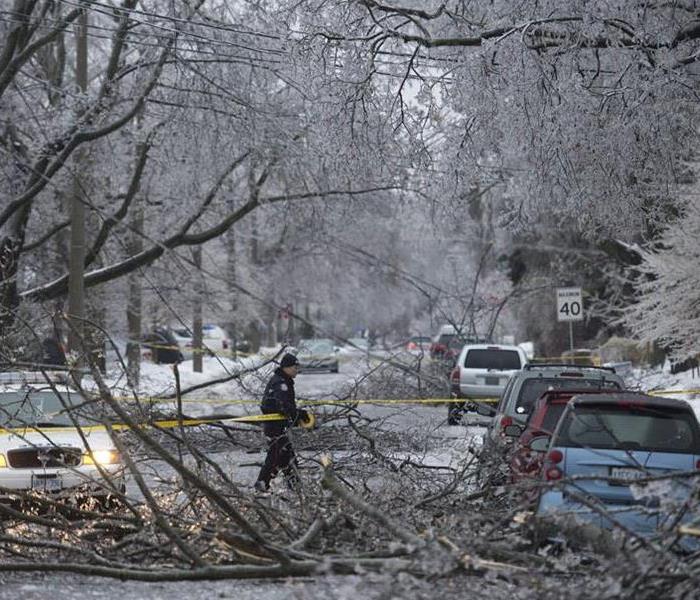 ice strom
ice strom
- Ice storms are caused by freezing rain. The raindrops move into a thin layer of below-freezing air right near the surface of the earth, allowing them to freeze on contact to the ground, trees, cars and other objects.
- Ice accumulates when super-cold rain freezes on contact with surfaces that are below freezing point. That can be dangerous, especially for older adults. You can walk a senior’s dog to keep them injury free! Sign up for Dog Days of Winter.
- Throughout the US, ice storms occur most often during the months of December and January.
- Ice storms have the bizarre effect of entombing everything in the landscape with a glaze of ice so heavy that it can split trees in half and turn roads and pavements into lethal sheets of smooth, thick ice.
- Ice can increase the weight of branches by 30 times.
- Urban areas tend to suffer more economic and physical damage than rural areas because of the concentration of utilities and transportation systems (aircraft, trains, vehicles) — all of which may be affected to a great degree by the ice storm.
- The Midwest and Northeast are prime areas for freezing rain. In the high frequency band in the Midwest, an average of 12 to 15 hours of freezing rain occurs annually.
- Driving during an ice storm is extremely hazardous, because ice can cause vehicles to skid out of control, leading to devastating car crashes.
- The National Weather Service refers to winter storms as the “deceptive killers” because most deaths are indirectly related to the storm. In addition to car crashes, people die from hypothermia which is prolonged exposure to cold.
- In 1998, an ice storm in northern New York and northern New England damaged millions of trees and caused $1.4 billion in damage. Accumulations were as much as three inches thick!
- The ice storm that struck the northeastern US in December 2008 left 1.25 million homes and businesses without power. Described as the worst storm of the decade, a state of emergency was declared in Massachusetts, New Hampshire, and parts of Maine.
Fire damge
1/16/2017 (Permalink)
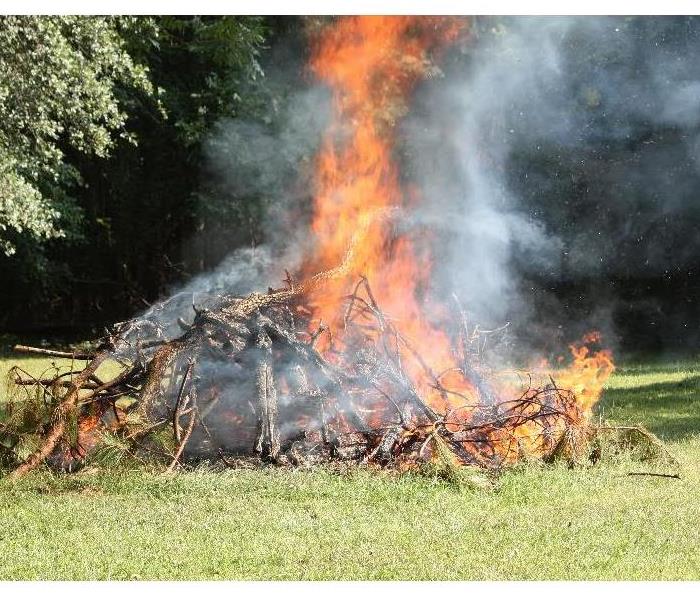 Fire
Fire
In 2015, there were 1,345,500 fires reported in the United States. These fires caused 3,280 civilian deaths, 15,700 civilian injuries, and $14.3 billion in property damage.
- 501,500 were structure fires, causing 2,685 civilian deaths, 13,000 civilian injuries, and $10.3 billion in property damage.
- 204,500 were vehicle fires, causing 500 civilian fire deaths, 1,875 civilian fire injuries, and $1.8 billion in property damage.
- 639,500 were outside and other fires, causing 95 civilian fire deaths, 825 civilian fire injuries, and $252 million in property damage.
The 2015 U.S. fire loss clock a fire department responded to a fire every 23 seconds. One structure fire was reported every 63 seconds.
- One home structure fire was reported every 86 seconds.
- One civilian fire injury was reported every 34 minutes.
- One civilian fire death occurred every 2 hours and 40 minutes.
- One outside and other fire was reported every 52 seconds.
- One highway vehicle fire was reported every 3 minutes 1 seconds.
Water damage
1/13/2017 (Permalink)
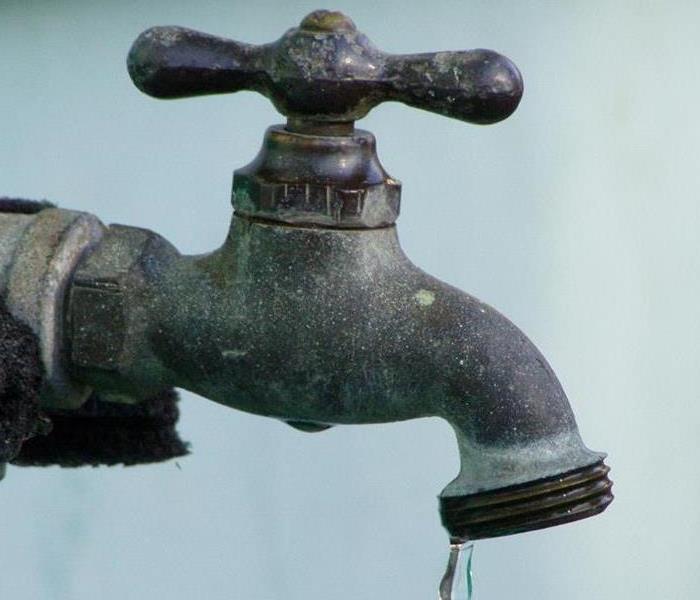 water dripping
water dripping
SERVPRO has the Answer for Property Owners Faced with Water Damage.
Water damage is one of the risks a homeowners face when they buy a home. Indoor plumbing will likely fail at some point, and when it does, it makes for a wet mess. The experienced professionals at SERVPRO can help you identify the source of the problem, correct it, and restore your home to a clean, dry condition. Rapid water extraction, after the source has been eliminated, and then moisture removal to reach standard household levels, will mitigate the dangers of contaminated water and mold growth. One of the first things that need to be determined when you have flooding caused by a plumbing failure is whether the water is clean, gray or black. These classifications indicate where the water is coming from and what sort of contaminants it may contain. Water damage occurs in many forms. Clean Water refers to water that is piped into your home. It has not yet been used for any household purpose, so it is clear and free of any hazardous substances. Drinking water. This water may be leaking from a burst pipe in the walls; it can also be the result of a failed pressure valve on your water heater tank, which allows the water to flood out. There is a large list of possible reasons for an unwanted water intrusion. Gray Water is more damaging. This is water that has flowed in sinks, showers, washing machines and all other plumbing including toilets tanks. Gray water does not contain harmful pathogens, but it does hold food waste, chemical products, and absorbed particulates from the surroundings that can harbor bacteria. Some soaps and other personal care products also contain ingredients that can be toxic if ingested. Black water is the most dangerous. It includes overflow water from a toilet, backed up septic tanks or sewer lines, and degraded gray water. This water contains hazardous bacteria that are linked with raw sewage. If you detect black water flooding, keep yourself and your family out of contact with the water. If you must enter the flooded area, you should wear rubber gloves, safety goggles, and protect your feet with rubber boots or plastic bags. Call the professionals from SERVPRO. Whenever your household plumbing fails, no matter what the source of the water is, we can help. Rapid and safe water removal from your property will mitigate health concerns, water damage to personal possessions, furnishings, and building materials. We can also save you money by repairing and restoring rather than replacing salvageable property. Our IICRC-certified and corporately trained technicians have the skills to return your water damaged home to pre-loss condition "Like it never even happened.
We Use Advanced Drying Equipment and Techniques
As leaders in the water damage industry, SERVPRO has advanced training and expertise, not to mention a tremendous amount of hands-on experience.
ice dams
1/11/2017 (Permalink)
ICE DAMS: Several quick fixes but only one cure.
An Ice Dam is a hump of ice that forms at the edge of a roof under certain wintertime conditions. An ice dam can damage both your roof and the inside of your home. It will put gutters and downspouts at risk too.
Ice Dams are a common sight in winter, and Home Partners has dealt with quite a few. There are several things you can do to avoid getting an ice dam or to reduce the risk of damage after one has formed, but there’s really only one cure: a combination of better sealing, insulation, and venting in the attic and eaves.
HOW DO ICE DAMS FORM?
An ice dam forms when the roof over the attic gets warm enough to melt the underside of the layer of snow on the roof. The water trickles down between the layer of snow and the shingles until it reaches the eave of the roof, which stays cold because it extends beyond the side of the house. There, the water freezes, gradually growing into a mound of ice.
The flatter the pitch of the roof, the easier it is for an ice dam to get a grip. Gutters at the eaves can also trap snow and ice. If snow and ice build up high enough in the gutter, it can provide a foundation for an ice dam.
WHAT DAMAGE DO ICE DAMS CAUSE?
When an ice dam gets big enough, melted water backs up behind it and seeps underneath the shingles. Eventually, it will drip into the insulation and down into the ceilings and exterior walls beneath the eave, ruining sheetrock and paint. If the ice dam breaks free, it can pull shingles and gutters off with it, and it will damage anything it falls on: shrubs, windowsills, cars, pets, and people. If the roof sheathing stays wet, it can form mildew and start to rot
DEALING WITH EXISTING ICE DAMS
1. Remove the ice dam by breaking it free in small chucks. Do NOT use an ax or other sharp tool! You’ll cut through the shingles. Instead, tap lightly with a blunt mallet. This is slow, dangerous work, so hire someone experienced at roofing. Even if you do it safely, the chunks of ice can take pieces of shingle with them.
2. Clear out gutters and downspouts. Again, this is ladder work and an easy way to damage either plastic or metal gutters and spouts.
3. Melt troughs through the ice dam with calcium chloride ice melter. Do NOT use rock salt! It will damage paint, metals, and plants beneath the eave and wherever the salty water drains.
A good trough-maker is a tube of cloth (a leg from an old pair of panty hose works well). Fill it with calcium chloride, tie off the top, and lay it vertically across the ice dam. It will slowly melt its way down through the dam, clearing a path for the underlying water to flow free.
black ice
1/10/2017 (Permalink)
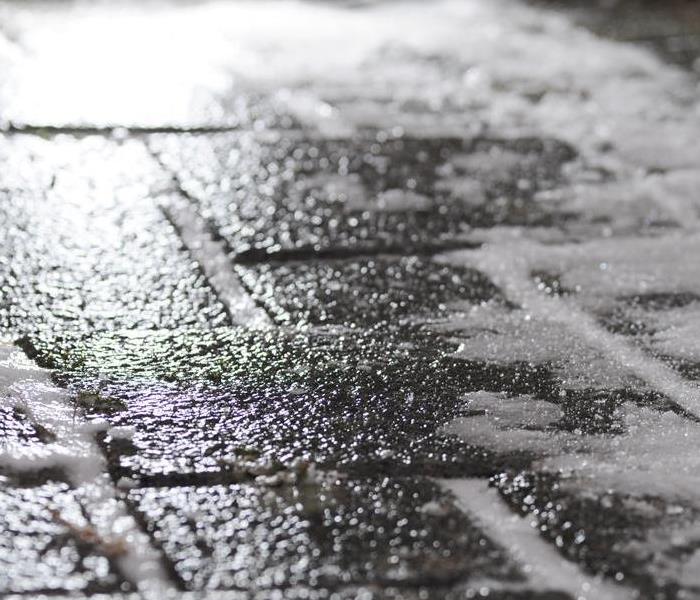 black ice
black ice
Watch out for black ice
What is black ice?
Black ice is actually invisible ice that is almost totally transparent. It can easily catch drivers off-guard and cause crashes.
How and where does black ice form?
Black ice forms when the air temperature is warmer than pavement, which causes moisture to rapidly freeze and creates a thin, transparent layer of ice on the roadway.
What can I do to be safer?
- Slow down on bridges, overpasses and tunnels, and in the early morning when the air temperature is rising faster than the pavement temperature
- Avoid applying brakes on ice as it may cause a vehicle to skid
- Do not use cruise control during winter driving conditions
- Use a safe speed for winter driving conditions, regardless of the posted speed limit
- Keep a safe stopping distance from the vehicle in front of you
- Do not use a cell phone while driving and remember that texting is prohibited while driving in Minnesota
- Keep both hands on the steering wheel, your eyes on the road and your attention on your driving
smoke and soot
1/5/2017 (Permalink)
Smoke and soot is very invasive and can penetrate various cavities within your home, causing hidden damage and odor. Our smoke damage expertise and experience allows us to inspect and accurately assess the extent of the damage to develop a comprehensive plan of action.
Smoke and soot facts:
- Hot smoke migrates to cooler areas and upper levels of a structure.
- Smoke flows around plumbing systems, seeping through the holes used by pipes to go from floor to floor.
- The type of smoke may greatly affect the restoration process.
Different Types of Smoke
There are two different types of smoke–wet and dry. As a result, there are different types of soot residue after a fire. Before restoration begins, SERVPRO of Cherry hill will test the soot to determine which type of smoke damage occurred. The cleaning procedures will then be based on the information identified during pretesting. Here is some additional information:
Wet Smoke – Plastic and Rubber
- Low heat, smoldering, pungent odor, sticky, smeary. Smoke webs are more difficult to clean.
Dry Smoke – Paper and Wood
- Fast burning, high temperatures, heat rises therefore smoke rises.
Protein Fire Residue – Produced by evaporation of material rather than from a fire
- Virtually invisible, discolors paints and varnishes, extreme pungent odor.
Our Fire Damage Restoration Services
Since each smoke and fire damage situation is a little different, each one requires a unique solution tailored for the specific conditions. We have the equipment, expertise, and experience to restore your fire and smoke damage. We will also treat your family with empathy and respect and your property with care.
Decorations in the home
1/4/2017 (Permalink)
This analysis of home fires beginning with decorations includes information on when these fires occur, area of origin, recent trends and causal factors.
Executive Summary
Decorations are a part of many celebrations and holiday observances. They are often seasonal or temporary. Unfortunately, fire safety is sometimes overlooked when putting up decorations.
National estimates of reported home structure fires derived from the U.S. Fire Administration’s National Fire Incident Reporting System (NFIRS) and NFPA’s annual fire department experience survey show that in 2009-2013, decorations, excluding Christmas trees, were the item first ignited in an estimated average of 860 reported home structure fires per year, resulting in an annual average of one civilian fire death, 41 civilian fire injuries, and $13.4 million in direct property damage.
Candles were the heat source in 38% of the fires. The decoration was too close to a heat source such as a candle or some type of equipment in almost half (45%) of these incidents. Decoration fires peak in December.
This fact sheet and accompanying table describe the common causes and circumstances of these fires. These findings identify issues that should be highlighted for decorating safety.
outdoor fires
1/4/2017 (Permalink)
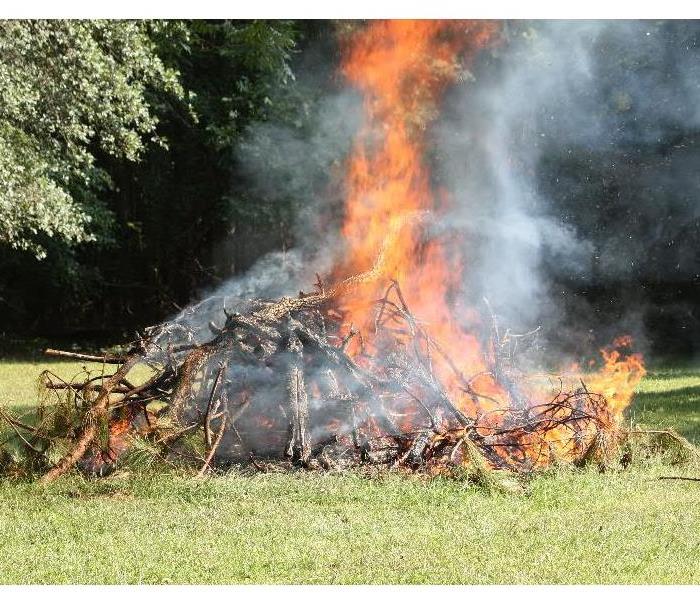 back yard fire
back yard fire
This report, based on 46 fire chief and senior line officer interviews, describes how some fire departments are addressing the wildfire peril and making the transition to becoming better prepared and ready to control and mitigate a wildfire incident in their communities. For some departments these conditions require only minor adjustments in their organization, procedures, and activities, while for other departments a major shift in outlook and approach may be required.
Key findings
- A number of departments made thoughtful choices about apparatus that could be used for a variety of purposes (for example, the Type 3 ‘hybrid’ engine), and about strategic dispatching to maximize the effectiveness of available resources.
- Several problems regarding Wildland and WUI Fire training were identified:
- The need to transition from traditional training practices which emphasized structural fire training.
- Inconsistent adoption of Wildland/WUI fire training, with local and regional variations in the level and adequacy of training.
- Firefighter fitness levels that may not always be adequate for the rigors of Wildland/WUI fire events.
- When communicating with the public, all departments reported to use traditional methods. Departments differed in their use of social media; this may be a missed opportunity for some.
- Nearly all of our interviewees spoke to the positive effect that community risk reduction efforts can have on mitigating the risks of major wildfire events and preventing the loss of homes and property should a fire occur.
Fire works
1/3/2017 (Permalink)
 Fire works
Fire works
Every year between the Fourth of July and new years eve/day fire works play a major roll in house damage as well as injury's NFPA’s Fireworks report provides estimates of fires and associated losses caused by fireworks through 2013. Information from the Consumer Product Safety Commission’s (CPSC’s) 2014 Fireworks Annual Report about the estimated number of injuries caused by fireworks that were seen in hospital emergency departments is also summarized. Additional details are provided about injuries seen in the month around July 4.
Report highlights
- In 2013, fireworks caused an estimated 15,600 reported fires in the U.S., including 1,400 structure fires, 200 vehicle fires, and 14,000 outside and other fires.
- More than one-quarter (28%) of fires started by fireworks in 2009-2013 were reported on Independence Day. Almost half (47%) of the reported fires on the Fourth of July were started by fireworks.
- According to the CPSC, more than one-third (35%) of the people seen in emergency rooms for fireworks injuries from June 20-July 20, 2014 were under 15; nine percent were under five.
- CPSC data show that sparklers alone accounted for more than one one-quarter (28%) of the emergency room fireworks injuries seen from June 20-July 20, 2014.
xmas trees
1/2/2017 (Permalink)
This report provides estimates of the causes and circumstances of home structure fires that began with the ignition of Christmas trees during the five-year period of 2010-2014. Trend data are also presented. Previously published descriptions of Christmas tree fires are also included to show how these fires can happen.
Report highlights
- U.S. fire departments responded to an estimated average of 210 home1 structure fires per year that began with Christmas trees in 2010-2014. These fires caused an annual average of six civilian deaths, 16 civilian injuries, and $16.2 million in direct property damage.
- On average, one of every 34 reported home Christmas tree fires resulted in a death, compared to an average of one death per 142 total reported home fires. Although Christmas tree fires are not common, when they do occur, they are much more likely to be deadly than most other fires.
- Four of every five Christmas tree fires occurred in December and January.
- In one-quarter (26%) of the Christmas tree fires and 80% of the deaths, some type of heat source, such as a candle or equipment, was too close to the tree.
1Homes include one- or two-family homes and apartments or other multi-family housing.
Lightning
12/30/2016 (Permalink)
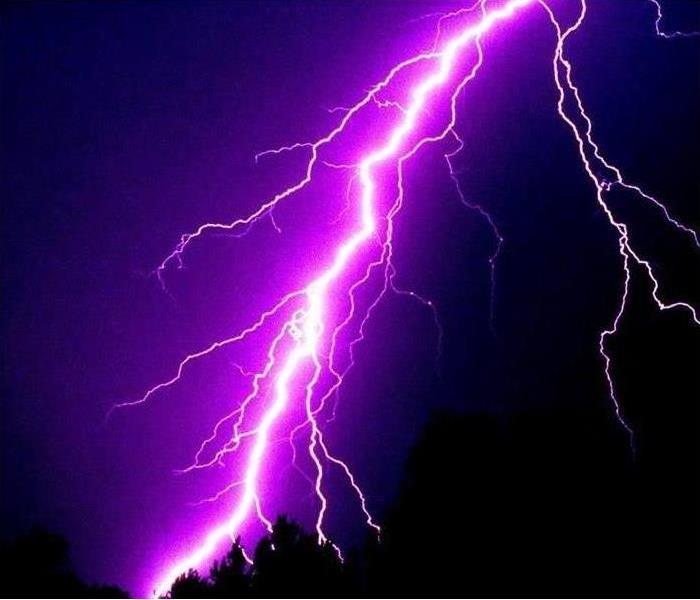 Lightning
Lightning
One of my favorite things about hot summer days is an afternoon thunderstorm to cool things down. It starts with the darkening of the sky as cumulus clouds block out the sun. Then the wind picks up and the air takes on the scent of wet grass. Finally, the skies open up and drop their deluge of rain on the dry earth below.
Thunderstorms are most likely in the spring and summer months and during the afternoon and evening hours, but they can occur year-round and at all hours. Many hazardous weather events are associated with thunderstorms. Under the right conditions, rainfall from thunderstorms causes flash flooding, killing more people each year than hurricanes, tornadoes or lightning. Lightning is responsible for many fires around the world each year, and causes fatalities. Hail up to the size of softballs damages cars and windows, and kills livestock caught out in the open. Strong (up to more than 120 mph) straight-line winds associated with thunderstorms knock down trees, power lines and mobile homes. Tornadoes (with winds up to about 300 mph) can destroy all but the best-built man-made structures.
As a child, we were usually permitted to play outside in a thunderstorm until we heard the rumbling sound of thunder. Then, with the threat of lightning close by, we were ushered inside by adults. We used to say that if you count how many seconds there were between the rumble of thunder and the flash of lightning (counting with “Mississippis” of course), you could tell how many miles away the storm was. If there were only a few seconds between thunder and lightning, it was time to get inside. It turns out that our game was partially true. You should count the seconds between the sound and the light and you should count using “One-Mississippi”, “Two-Mississippi”, etc. However, you should take this number and divide it by five. For every 5 seconds counted, the storm is 1 mile away.
What else should we know about lightning?
· Lying flat increases your chance of being affected by potentially deadly ground current. If you are caught outside in a thunderstorm, do NOT lay flat on the ground. Keep moving toward a safe shelter.
· Height, pointy shape, and isolation are the dominant factors controlling where a lightning bolt will strike. The presence of metal makes absolutely no difference on where lightning strikes. Mountains are made of stone but get struck by lightning many times a year. When lightning threatens, take proper protective action by seeking a safe shelter. While metal does not attract lightning, it does conduct it so stay away from metal fences, railings, bleachers, etc.
· Many lightning casualties occur because people do not seek shelter soon enough. If you consider my example above about playing outside, we never should have waited to count the seconds until the lightning flashed. Rather, we should have run for shelter at the first sound of thunder.
· Lightning often strikes the same place repeatedly, especially if it’s a tall, pointy, isolated object. The Empire State Building is hit nearly 100 times a year!
· Most cars are safe from lightning, but it is the metal roof and metal sides that protect you, NOT the rubber tires. Remember, convertibles, motorcycles, bicycles, open-shelled outdoor recreational vehicles and cars with fiberglass shells offer no protection from lightning. When lightning strikes a vehicle, it goes through the metal frame into the ground. Don’t lean on doors during a thunderstorm.
· The human body does not store electricity. It is perfectly safe to touch a lightning victim to give them first aid. This is the most chilling of lightning myths. Imagine if someone died because people were afraid to give CPR!
For more tips on Lightning Safety or safety from some of the other hazardous events produced by thunderstorms, visit the National Weather Service’s Lightning Safety website
When Winter Weather Strikes
12/23/2016 (Permalink)
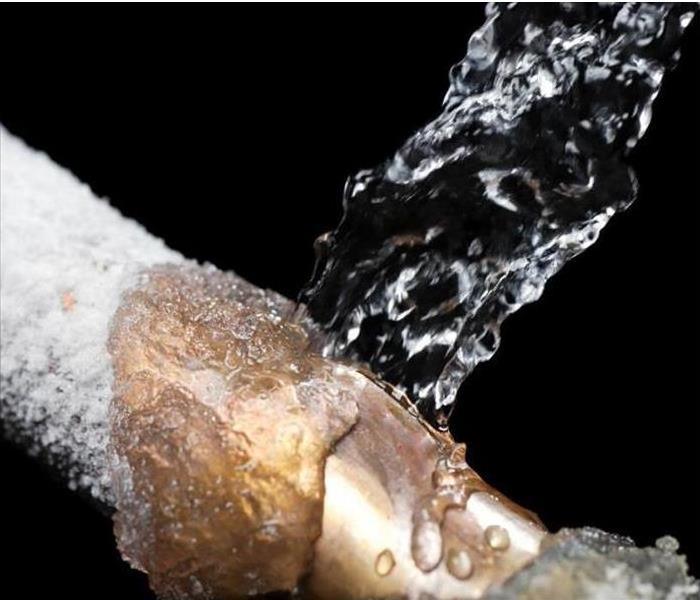 Strike Back at Winter Weather
Strike Back at Winter Weather
When winter weather strikes be ready to strike back. A burst pipe can cause significant water damage in your home or business. Water damage and the potential for mildew and mold taking hold if proper water mitigation is not instituted Faster to Your Disaster can be extremely expensive. Our experts can help coordinate your insurance claim with your home or business insurance carrier. Thankfully, SERVPRO of cherryhill, your local water cleanup and restoration experts are there to make your problem much more manageable.
Frozen pipes can burst at the point where the ice blockage is located. Usually, the rupture is caused by the backflow pressure between the water source and the blockage. A burst pipe can quickly cause considerable damage to your property if not addressed quickly. An inexperienced home or business owner that attempts to fix the problem themselves can easily make the problem worse.
Calling SERVPRO of Cherryhill to assess possible structural damage that is difficult to spot from leaky pipes is crucial in ensuring that even a small amount of water does not cause catastrophic results. The first step is finding the source of the water damage and stopping the flow of the water from continuing from entering. The more water, the bigger the water damage cleanup. If it is a broken pipe that has burst that can’t be seen, the first step is to turn off the water supply into your home or business as quickly as possible. The water main is usually in the garage or in the front yard under a cement plate marked “water”.
Certified professionals can quickly reverse the damage caused by a burst pipe and save as many items as possible through restoration techniques. The professionals will work through the structure and perform a thorough inspection with moisture meters to determine how much moisture is in your home or business. They will pump out any standing water and begin the drying process. If mold or other pathogens are present, they will eliminate them using the proper tools and procedures. Attempting cleanup efforts on your own can lead to injury or illness.
SERVPRO of Bordentown has a 1-4-8 response. Within 1 hour from the notice of loss, a SERVPRO professional will contact you to arrange for service. Within 4 hours, SERVPRO will be on-site and will start mitigation services. Within 8 hours of arriving on-site, a verbal briefing of the scope of the work needed will be communicated to you or your insurance professional. (*Exceptions may apply under certain conditions, such as a local catastrophic or storm situation). The experts know that time is of the essence and come prepared for nearly any situation.
In the aftermath of a winter weather striking a pipe it may feel like the catastrophe is impossible to fix. Contact us 24 hours a day, 365 days a year
If you have dirty ducts call SERVPRO of Cherry Hill/Haddonfield
12/22/2016 (Permalink)
Ventilation systems can often be the biggest culprit of poor indoor air quality because many people allow HVAC systems to operate for some time without much attention or upkeep. Your HVAC system could be circulating odors, dust, and other contaminants throughout your property.
A routine part of SERVPRO of Cherry Hill/Haddonfields service is inspecting the heating, ventilation and air conditioning unit (HVAC). Keeping the HVAC system and ductwork clean can potentially extend the life span of the equipment by allowing it to operate at peak condition, which can in turn save you money and give you cleaner air to breathe.
SERVPRO of Cherry Hill/Haddonfield will inspect your HVAC system and ductwork and make recommendations about the best way to address any indoor air quality concerns. This inspection can provide peace of mind on the health of your HVAC system and ductwork. Benefits of servicing your HVAC unit include:
- Helps to restore peak energy efficiency.
- May help to eliminate offensive odors.
- Helps reduce the potential for mold growth.
For more information on duct cleaning, or to set up an inspection and estimate, call SERVPRO of Cherry Hill/Haddonfield at 856.662.2772
How to Protect your Basement from Water Damage
12/21/2016 (Permalink)
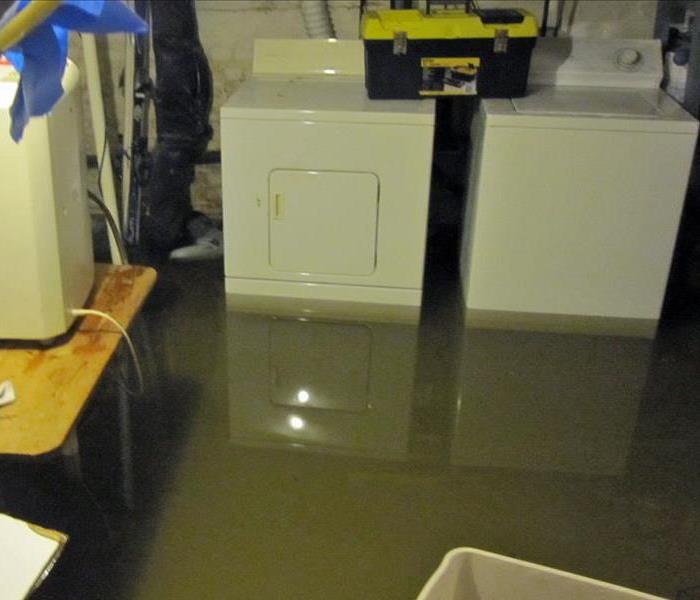 This basement had about a foot of water that needed to be extracted. The dry out process took 5 days
This basement had about a foot of water that needed to be extracted. The dry out process took 5 days
I just bought my first home. Unlike most homebuyers who are looking for an open floor plan or a gourmet kitchen, my first stop was always the basement! My favorite time to look at houses was in the rain, when I could determine if the basement was prone to flooding. Several times, I walked into a house's basement and watched as water ran down the walls.
Obviously, frequent water intrusion in your basement can cause issues with your foundation, and mold. But most people don't know what to look for or how to protect their basement until after they've experienced a water damage. What's obvious to me as someone who has worked in the restoration industry for 4 years may not be obvious to every homeowner, so here are some tips to help you stay dry!
- Get a sump pump. Get the sump pump rider on your insurance policy while you are at it. If you have a sump pump and it fails, your homeowners insurance will not cover the damage. Even if your home or business has never taken on water, it doesn't mean you are immune to it. Get the sump pump and check that it's functioning properly regularly.
- Consider a French drain or some other form of waterproofing. Have a professional do the work. Google the benefits. You may be surprised!
- Keep your gutters free of debris and position downspouts away from the foundation. The goal is to drain water at least three feet away, so if necessary, consider running extensions or troughs.
- If you haven't had your sewer inspected or your septic tank cleaned, now is a good time to do that. During periods of prolonged, heavy rainfall (think Hurricane season!), clogged sewers and over-taxed septics are disasters waiting to happen.
- If you have below-grade basement windows, install window covers that fasten securely to your foundation. Clear acrylic covers allow light to enter while keeping out water.
- Check the age on your hot water heater. They generally last about 10 years. If yours has made it longer, that's not necessarily a good thing! Don't wait for it to fail before you replace it.
- If you use your basement for storage, build shelves at least 6 inches from the ground. Store items in plastic bins. Photograph everything you store down there in case you need to replace it later.
- If you have a finished basement, get a good-quality dehumidifier. Consider tile floors or polished concrete over carpets.
Looking for a Great Holiday Gift Idea? Give Your Family a Fire Safety Plan
12/20/2016 (Permalink)
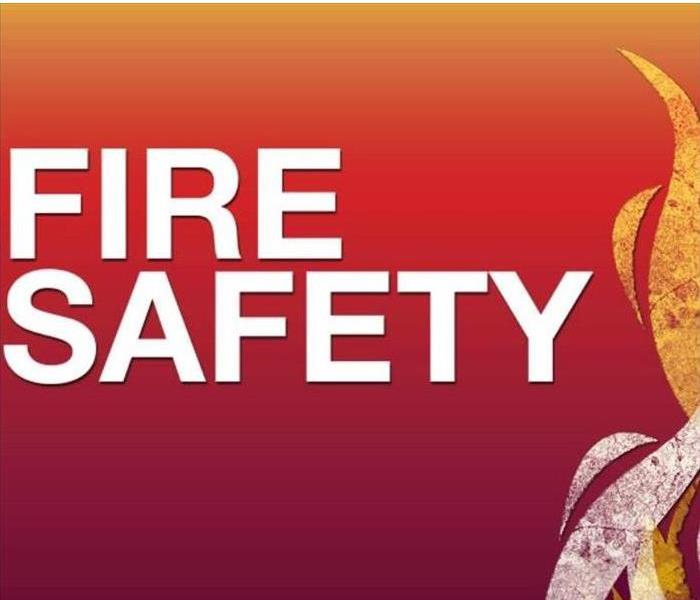 Have a Happy & Safe Holiday from SERVPRO of cherry hill
Have a Happy & Safe Holiday from SERVPRO of cherry hill
The holidays are approaching and many families are finalizing plans for elaborate meals, get-togethers with friends, and decorating with festive lights. Amidst all this planning, SERVPRO® of Cherry Hill reminds homeowners that they may be overlooking the most important plan they can make—a fire safety plan.
With the holidays fast approaching, many families are making plans for delicious meals, hosting get-togethers and decorating their homes with festive decorations. SERVPRO of Cherry Hill wants to remind homeowners not to overlook having a fire safety plan. Statistics show that cooking and candle fires during the holiday season peak during the holiday season1. Homeowners tend to focus on fire prevention precautions which is a great thing, but tend to forget about having a fire safety plan. Families need to develop a fire safety plan and practice it regularly to help prevent a house fire from turning into a devastating tragedy.
Homeowners should follow these fire safety guidelines, developed by the ARC through their Home Fire Preparedness Campaign, to help minimize injury or loss of life due to a residential fire.
- Install theright number of smoke alarms2. Test them once a month and replace the batteries at least once a year.
- Teach childrenwhat smoke alarms sound like3 and what to do when they hear one.
- Ensure that all household members knowtwo ways to escape4 from every room of your home and know the family meeting spot outside of your home.
- Establish a family emergency communications plan and ensure all household members know who to contact if they cannot find one another.
- Practice escaping from your home at least twice a year. Press the smoke alarm test button or yell “Fire” to alert everyone they must get out.
- Make sure everyone knows how to call 9-1-1.
- Teach household members to STOP, DROP and ROLL if their clothes should catch on fire.
SERVPRO of Cherry Hill wants to remind your family that fire prevention and fire safety planning are two very different things. Fire prevention planning helps control or eliminate the causes of a fire. Fire safety planning helps prevent injury and loss of life when a fire does break out. To protect your family and your property, you need both.
Smoke and Soot Clean Up
9/29/2016 (Permalink)
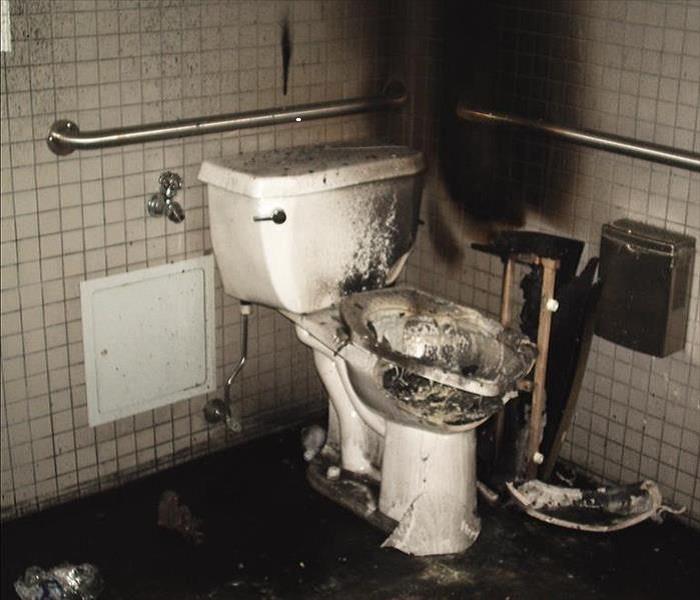 Smoke and Soot Damage Can Cause a Pervasive Odor in Home
Smoke and Soot Damage Can Cause a Pervasive Odor in Home
Smoke and soot is very invasive and can penetrate various cavities within your home, causing hidden damage and odor. Our smoke damage expertise and experience allows us to inspect and accurately assess the extent of the damage to develop a comprehensive plan of action.
Smoke and soot facts:
- Hot smoke migrates to cooler areas and upper levels of a structure.
- Smoke flows around plumbing systems, seeping through the holes used by pipes to go from floor to floor.
- The type of smoke may greatly affect the restoration process.
Different Types of Smoke
There are two different types of smoke–wet and dry. As a result, there are different types of soot residue after a fire. Before restoration begins, SERVPRO of Mt. Laurel / Moorestown will test the soot to determine which type of smoke damage occurred. The cleaning procedures will then be based on the information identified during pretesting. Here is some additional information:
Wet Smoke – Plastic and Rubber
- Low heat, smoldering, pungent odor, sticky, smeary. Smoke webs are more difficult to clean.
Dry Smoke – Paper and Wood
- Fast burning, high temperatures, heat rises therefore smoke rises.
Protein Fire Residue – Produced by evaporation of material rather than from a fire
- Virtually invisible, discolors paints and varnishes, extreme pungent odor.
Our Fire Damage Restoration Services
Since each smoke and fire damage situation is a little different, each one requires a unique solution tailored for the specific conditions. We have the equipment, expertise, and experience to restore your fire and smoke damage. We will also treat your family with empathy and respect and your property with care.
Have Questions about Fire, Smoke or Soot Damage?
Call Us Today – Cherry Hill/Haddonfield 856-662-2772
Protecting Your Documents
9/29/2016 (Permalink)
It's important to keep important papers, books and pictures up and away from any area that floods or gets damp. Protect your valuable documents.
Fire and Smoke Do's and Don'ts
9/23/2016 (Permalink)
Do:
* Limit movement in the home to prevent soot particles from being imbedded into upholstery and carpets.
* Keep hands clean. Soot on hands can further soil upholstery, walls and woodwork.
* Blow or brush vacuum loose soot particles from upholstery, drapes and carpets.
* Place clean towels or old linens on rugs, upholstery and carpet traffic areas.
* If electricity is off, empty freezer and refrigerator completely and prop doors open.
*Clean and protect chrome on kitchen and bathroom faucets, trim and appliances with light coating of Vaseline or oil.
* Wash house plants on both sides of leaves.
* Change HVAC filter.
* Tape double layers of cheesecloth over air registers.
Don’t:
* Attempt to wash any walls or painted surfaces without first contacting your SERVPRO Professional.
*Attempt to shampoo carpet or upholstered furniture without first consulting your SERVPRO Professional.
*Attempt to clean any electrical appliances, TV sets, radios, etc. that may have been close to fire, heat or water without first consulting an authorized repair service.
* Use any canned or packaged food or beverages that may have been stored close to fire, heat or water. (They may be contaminated.)
* Turn on ceiling fixtures if ceiling is wet. Wiring may be wet or damaged.
*Send garments to ordinary dry cleaner. Improper cleaning may set smoke odor.
SERVPRO of Cherry Hill/Haddonfield
Fire & Water – Cleanup & Restoration
24 Hour Emergency Service
856-662-2772
Vandalism Tips
9/23/2016 (Permalink)
Do:
- Hose or wash egg damage from building exterior as soon as possible.
- Blot freshly spilled food from carpets and fabrics with a dampened cloth or sponge (but don’t overwet). Scrape and blot (don’t rub: it may damage fibers).
- Vacuum glass particles from carpets and upholstery.
- Save containers, which reveal the composition of spilled inks, cosmetics and paints.
Don’t:
- Attempt to remove ink, paint or cosmetic stains.
- Operate damaged lamps or appliances.
- Discard wood chips, broken pieces from furniture, porcelain or other art objects.
Do:
- Stay out of affected areas.
- Call emergency service personnel if the situation is life-threatening.
- Treat all bodily fluids as if they are contaminated.
- Turn off the HVAC system if there is a sewage damage.
Don’t:
- Attempt cleanup of any kind.
- Touch or handle items that might be contaminated with bodily fluids.
- Eat, drink, smoke, apply cosmetics or handle contact lenses in affected areas.
- If exposed to harmful waste, OSHA recommends a post-exposure medical evaluation. Consult your local health department or physician.
FIRE & SMOKE DAMAGE: WATER DAMAGE: VANDALISM DAMAGE:
SERVPRO of Cherry Hill/Haddonfield
Fire & Water – Cleanup & Restoration
24 Hour Emergency Service
856-662-2772
Do's and Don'ts of Water Intrusion
9/23/2016 (Permalink)
Do:
* Remove as much excess water as possible by mopping and blotting.
* Wipe excess water from wood furniture after removal of lamps and table top items.
* Remove and prop wet upholstery and pillow cushions for even drying.
* Place aluminum foil or wood blocks between furniture legs and wet carpeting.
* Turn air conditioning on for maximum drying in summer.
* Remove Oriental rugs or other colored rugs from wet wall-to-wall carpeting.
* Remove valuable paintings and art objects to a safe, dry place.
* Open and place luggage, in sunlight to dry, if possible.
* Gather loose items, toys, etc. from floors.
Don’t:
* Leave wet fabrics in place; dry as soon as possible. Hang furs and leather goods to dry separately at room temperature.
* Leave books, magazines or other colored items on wet carpets or floors.
* Use your household vacuum to remove water.
* Use TVs or other household appliances while standing on wet carpets or floors, especially not on wet concrete floors.
* Turn on ceiling fixtures if ceiling is wet, and keep out
CALL SERVPRO 1-866-838-5200
Fire Evacuation
9/23/2016 (Permalink)
When the Fire Alarm sounds, act immediately to ensure your safety. The Fire Alarm System is designed to provide you with an early warning to allow you to safely exit the building during an emergency situation.
- NEVER ignore the alarm, assume the alarm is false, or assume it is only a fire alarm test.
- Everyone MUST evacuate the building by way of the safest and closest exit and/or stairway. NEVER use an elevator to exit during a fire alarm activation.
- Once outside the building, move away from the building. Assemble across the street or along the sidewalk of the adjacent building.
- The front of the building is where the fire fighters and fire trucks will be operating. Do not obstruct their access to the building.
- If there is an incident occurring on the upper floors and glass is being blown out of the windows, the area below is the hazard zone where serious personal injuries will happen. Stay away from this hazard zone.
- Once outside, never re-enter the building until you are told to do so by the fire department. SERVPRO of Mt.Laurel/Moorestown will be there to help 856-778-4055
Avoid Entering Your Home or Business after a Fire
9/23/2016 (Permalink)
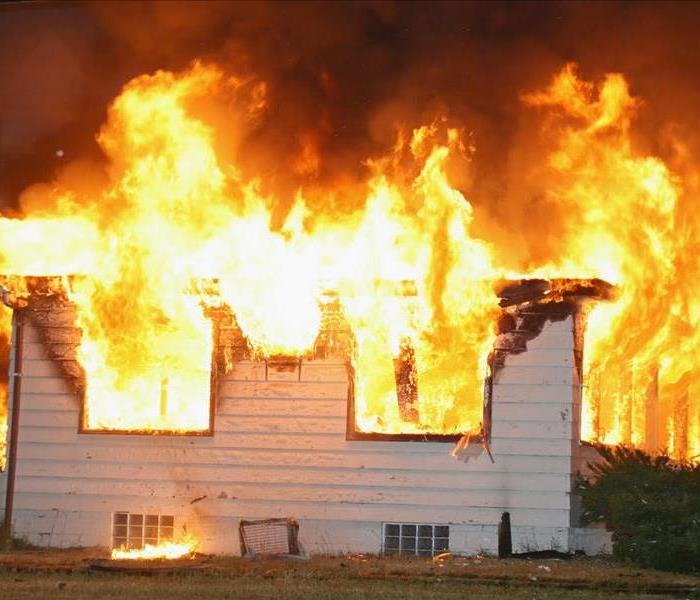 Structure on fire.
Structure on fire.
It is very important that you avoid reentering your home or business after a fire, as this can result in severe personal injury or further damage to the structure. Depending on the extent of the fire damage, it is likely that the fire has damaged your building structure, which means the boards are fragile and can easily break if you apply any pressure to them. In addition, if your structure has sustained water damage, this can also weaken its structure and create the possibility for electrocution if electricity is exposed to the excess water. Regardless of the extent of the damage to your home or business, you should always have a professional inspect your home or business before you try to enter it after a fire. SERVPRO of Cherry Hill/Haddonfield is here to help. Allow our certified staff to inspect your home or business. We can be reached at 856-662-2772 -24 hours a day every day.
Removing Odors
6/28/2016 (Permalink)
Do you want to get rid of unusual odors that linger in your kitchen sink? Freeze vinegar in ice cube trays before running them down the disposal. The ice will sharpen the disposal blades and the vinegar will kill odor-causing bacteria.
STRESS FREE CLAIMS
6/28/2016 (Permalink)
Emergency Preparedness & Safety Begins Before a Disaster.
SERVPRO of Cherry Hill/ Haddonfield is here to help you when a disaster happens.
For a stress-free claims process, SERVPRO can help manage the insurance paperwork and process. Call for details. We work with your insurance. For a stress-free claims process, SERVPRO can help manage the insurance paperwork and process. Call for details. (856) 662-2772
When the warmer weather hits, there’s nothing better than the smell of food on the grill.
6/15/2016 (Permalink)
Three out of five households own a gas grill, which translates to a lot of tasty meals. But it also means there’s an increased risk of home fires.
Each year an average of 8,900 home fires are caused by grilling, and close to half of all injuries involving grills are due to thermal burns. While nearly half of the people who grill do it year-round, July is the peak month for grill fires followed by May, June and August.






 24/7 Emergency Service
24/7 Emergency Service